
Potential, unleashed
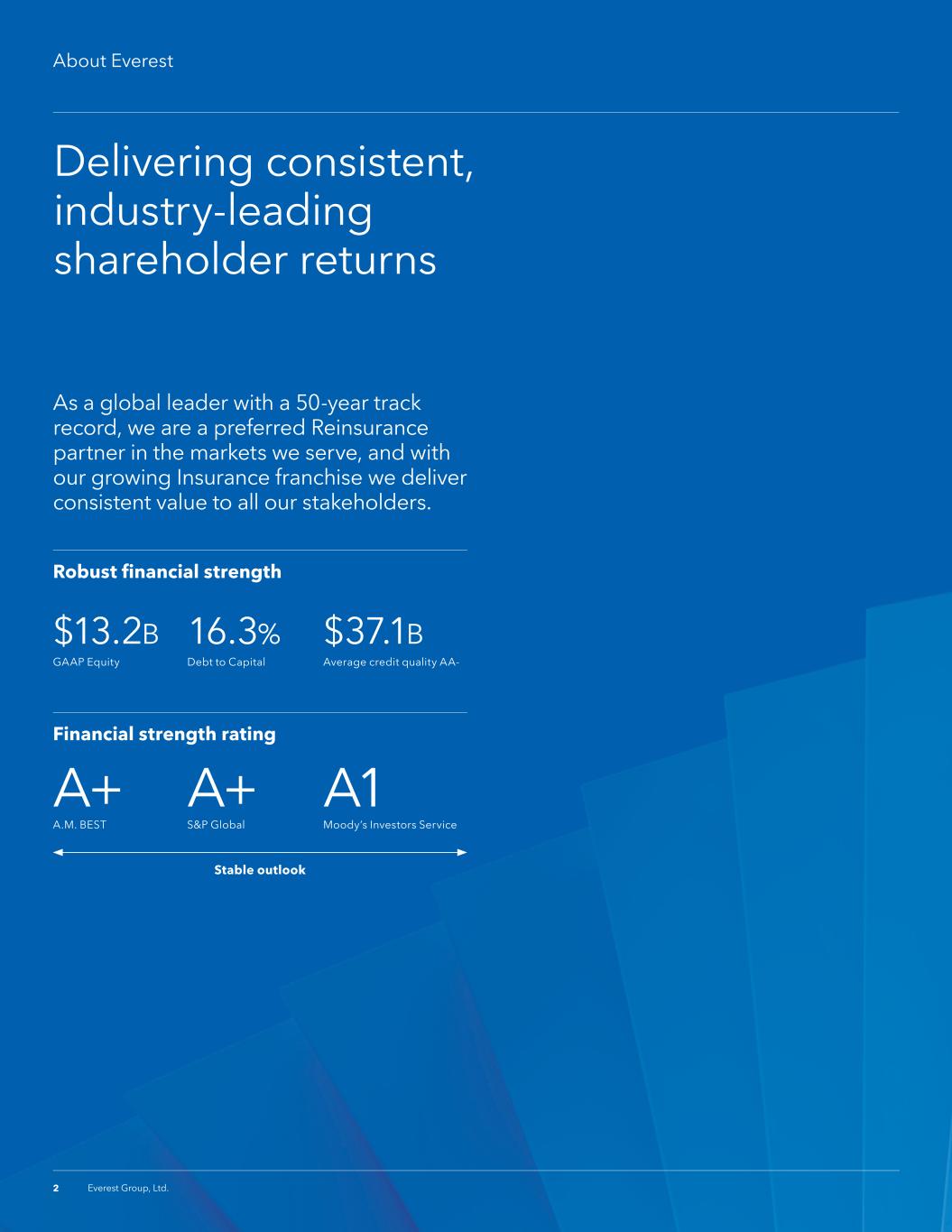
About Everest Delivering consistent, industry-leading shareholder returns As a global leader with a 50-year track record, we are a preferred Reinsurance partner in the markets we serve, and with our growing Insurance franchise we deliver consistent value to all our stakeholders. Robust financial strength Financial strength rating A1 Moody’s Investors Service A+ S&P Global A+ A.M. BEST Stable outlook 16.3% Debt to Capital $37.1B Average credit quality AA- $13.2B GAAP Equity Everest Group, Ltd.2
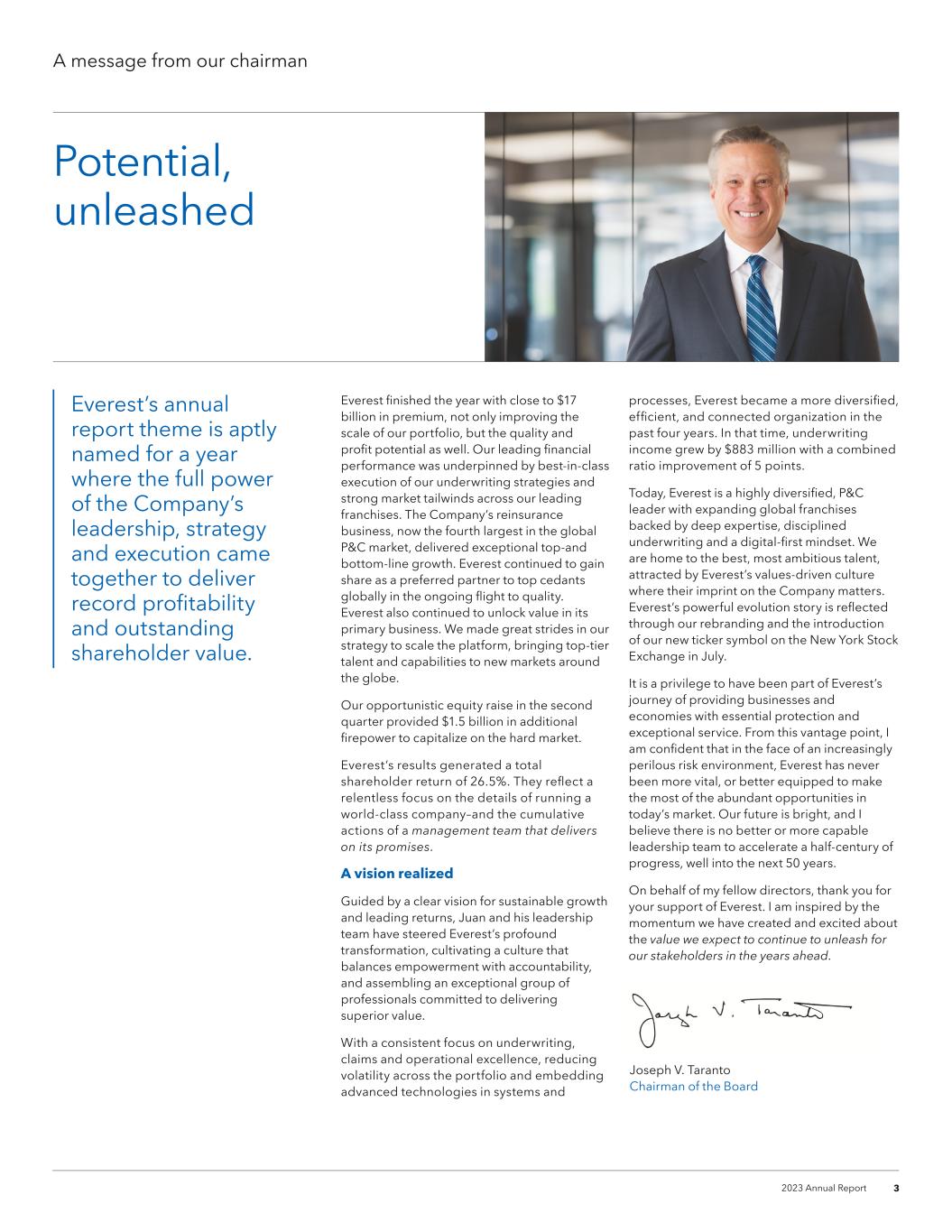
A message from our chairman Potential, unleashed Everest finished the year with close to $17 billion in premium, not only improving the scale of our portfolio, but the quality and profit potential as well. Our leading financial performance was underpinned by best-in-class execution of our underwriting strategies and strong market tailwinds across our leading franchises. The Company’s reinsurance business, now the fourth largest in the global P&C market, delivered exceptional top-and bottom-line growth. Everest continued to gain share as a preferred partner to top cedants globally in the ongoing flight to quality. Everest also continued to unlock value in its primary business. We made great strides in our strategy to scale the platform, bringing top-tier talent and capabilities to new markets around the globe. Our opportunistic equity raise in the second quarter provided $1.5 billion in additional firepower to capitalize on the hard market. Everest’s results generated a total shareholder return of 26.5%. They reflect a relentless focus on the details of running a world-class company–and the cumulative actions of a management team that delivers on its promises. A vision realized Guided by a clear vision for sustainable growth and leading returns, Juan and his leadership team have steered Everest’s profound transformation, cultivating a culture that balances empowerment with accountability, and assembling an exceptional group of professionals committed to delivering superior value. With a consistent focus on underwriting, claims and operational excellence, reducing volatility across the portfolio and embedding advanced technologies in systems and Everest’s annual report theme is aptly named for a year where the full power of the Company’s leadership, strategy and execution came together to deliver record profitability and outstanding shareholder value. processes, Everest became a more diversified, efficient, and connected organization in the past four years. In that time, underwriting income grew by $883 million with a combined ratio improvement of 5 points. Today, Everest is a highly diversified, P&C leader with expanding global franchises backed by deep expertise, disciplined underwriting and a digital-first mindset. We are home to the best, most ambitious talent, attracted by Everest’s values-driven culture where their imprint on the Company matters. Everest’s powerful evolution story is reflected through our rebranding and the introduction of our new ticker symbol on the New York Stock Exchange in July. It is a privilege to have been part of Everest’s journey of providing businesses and economies with essential protection and exceptional service. From this vantage point, I am confident that in the face of an increasingly perilous risk environment, Everest has never been more vital, or better equipped to make the most of the abundant opportunities in today’s market. Our future is bright, and I believe there is no better or more capable leadership team to accelerate a half-century of progress, well into the next 50 years. On behalf of my fellow directors, thank you for your support of Everest. I am inspired by the momentum we have created and excited about the value we expect to continue to unleash for our stakeholders in the years ahead. Joseph V. Taranto Chairman of the Board 2023 Annual Report 3

Executive leadership team Experienced industry leaders driving our strategy and delivering value Leadership built to deliver Juan C. Andrade President and Chief Executive Officer Mark Kociancic Executive Vice President, Group Chief Financial Officer Jim Williamson Executive Vice President, Group Chief Operating Officer and Head of Everest Reinsurance Mike Karmilowicz Executive Vice President, President and CEO of Everest Insurance® Ricardo Anzaldua Executive Vice President, Group General Counsel Gail Van Beveren Executive Vice President, Chief Human Resources Officer Mike Mulray Executive Vice President and President of North America Insurance Anne Rocco Senior Vice President, Group Chief Transformation and Shared Services Officer Chris Downey Senior Vice President, Chief Underwriting Officer, Everest Reinsurance Dawn Lauer Senior Vice President, Chief Communications Officer Jill Beggs Reinsurance Executive Vice President and Chief Operating Officer, Everest Reinsurance Everest Group, Ltd.4
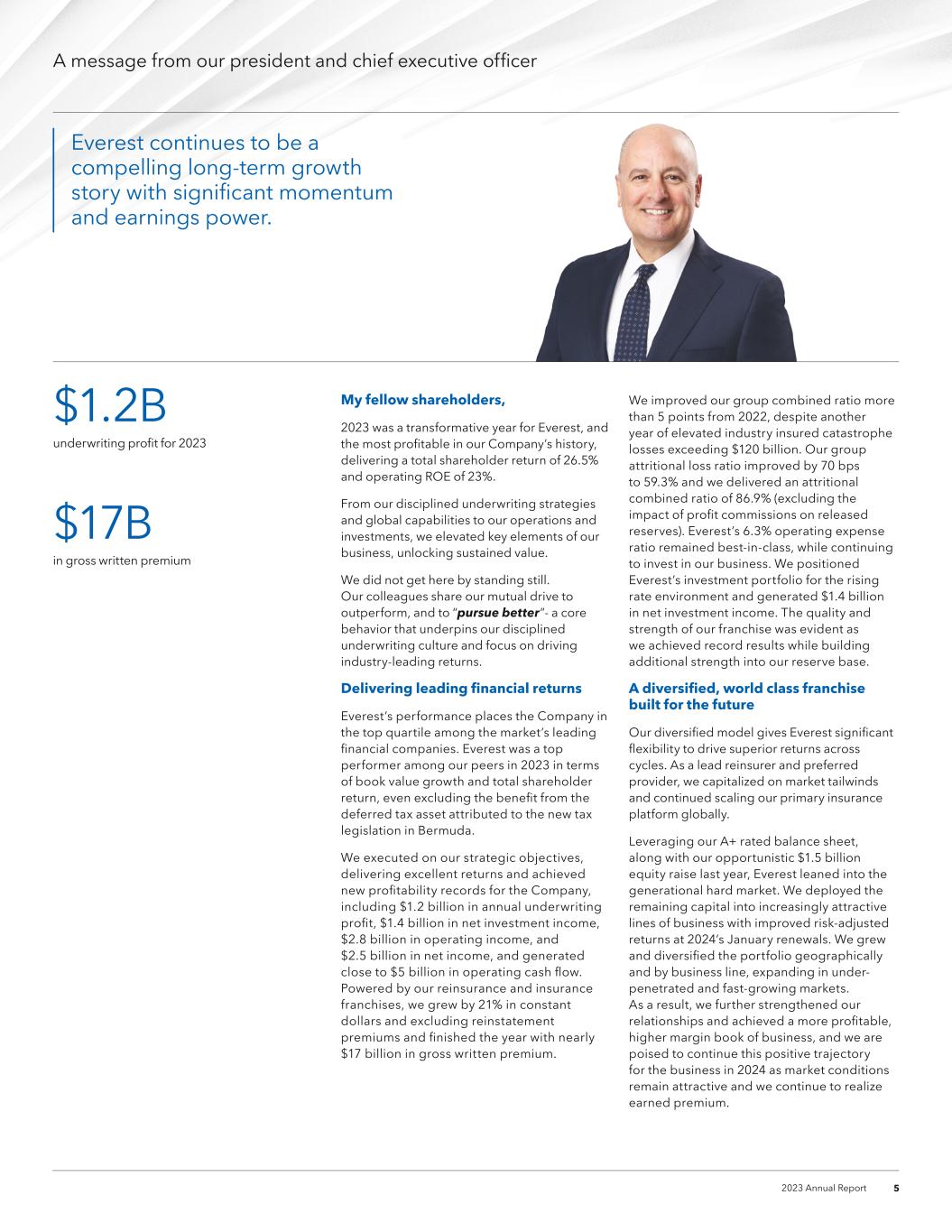
A message from our president and chief executive officer $1.2B underwriting profit for 2023 $17B in gross written premium My fellow shareholders, 2023 was a transformative year for Everest, and the most profitable in our Company’s history, delivering a total shareholder return of 26.5% and operating ROE of 23%. From our disciplined underwriting strategies and global capabilities to our operations and investments, we elevated key elements of our business, unlocking sustained value. We did not get here by standing still. Our colleagues share our mutual drive to outperform, and to “pursue better”- a core behavior that underpins our disciplined underwriting culture and focus on driving industry-leading returns. Delivering leading financial returns Everest’s performance places the Company in the top quartile among the market’s leading financial companies. Everest was a top performer among our peers in 2023 in terms of book value growth and total shareholder return, even excluding the benefit from the deferred tax asset attributed to the new tax legislation in Bermuda. We executed on our strategic objectives, delivering excellent returns and achieved new profitability records for the Company, including $1.2 billion in annual underwriting profit, $1.4 billion in net investment income, $2.8 billion in operating income, and $2.5 billion in net income, and generated close to $5 billion in operating cash flow. Powered by our reinsurance and insurance franchises, we grew by 21% in constant dollars and excluding reinstatement premiums and finished the year with nearly $17 billion in gross written premium. Everest continues to be a compelling long-term growth story with significant momentum and earnings power. We improved our group combined ratio more than 5 points from 2022, despite another year of elevated industry insured catastrophe losses exceeding $120 billion. Our group attritional loss ratio improved by 70 bps to 59.3% and we delivered an attritional combined ratio of 86.9% (excluding the impact of profit commissions on released reserves). Everest’s 6.3% operating expense ratio remained best-in-class, while continuing to invest in our business. We positioned Everest’s investment portfolio for the rising rate environment and generated $1.4 billion in net investment income. The quality and strength of our franchise was evident as we achieved record results while building additional strength into our reserve base. A diversified, world class franchise built for the future Our diversified model gives Everest significant flexibility to drive superior returns across cycles. As a lead reinsurer and preferred provider, we capitalized on market tailwinds and continued scaling our primary insurance platform globally. Leveraging our A+ rated balance sheet, along with our opportunistic $1.5 billion equity raise last year, Everest leaned into the generational hard market. We deployed the remaining capital into increasingly attractive lines of business with improved risk-adjusted returns at 2024’s January renewals. We grew and diversified the portfolio geographically and by business line, expanding in under- penetrated and fast-growing markets. As a result, we further strengthened our relationships and achieved a more profitable, higher margin book of business, and we are poised to continue this positive trajectory for the business in 2024 as market conditions remain attractive and we continue to realize earned premium. 2023 Annual Report 5
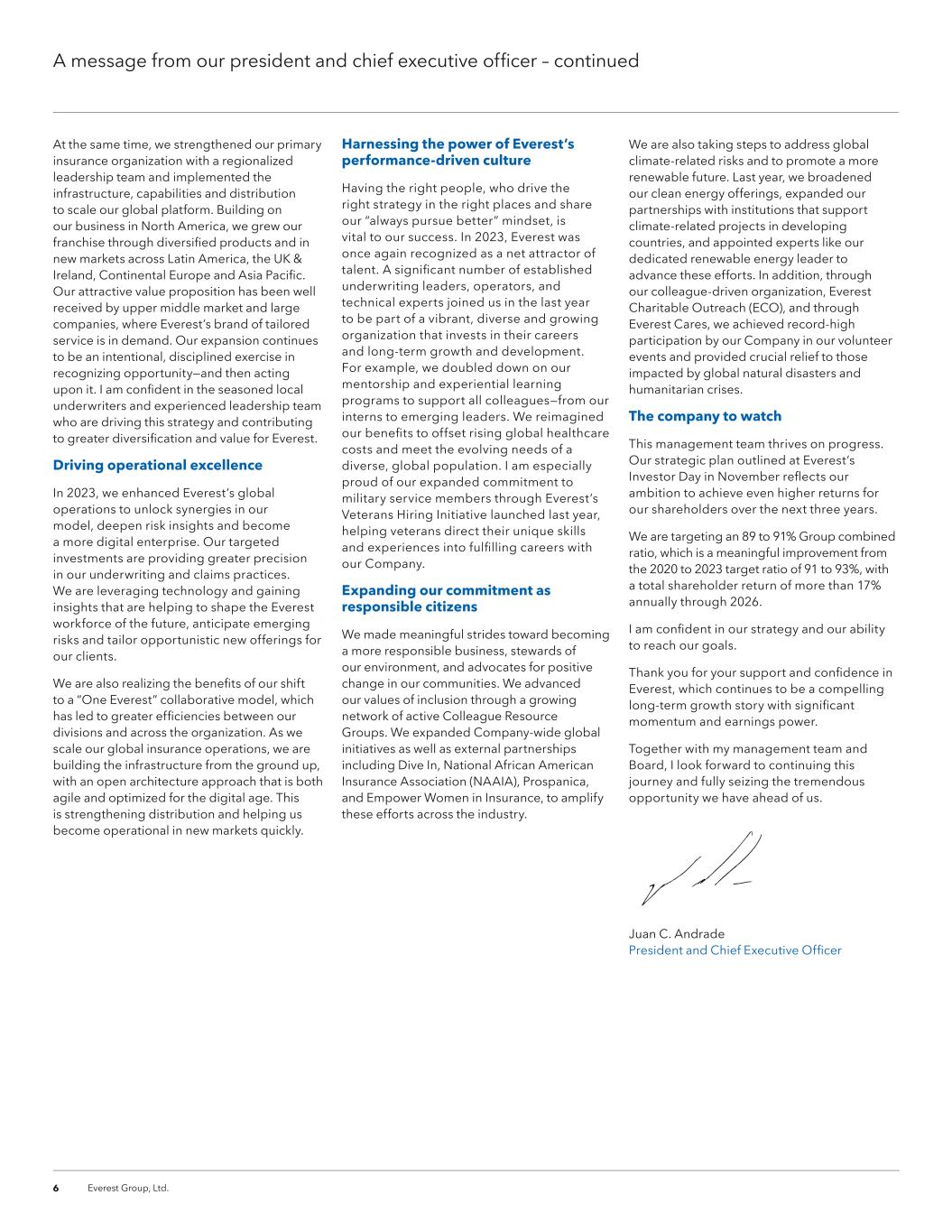
A message from our president and chief executive officer – continued At the same time, we strengthened our primary insurance organization with a regionalized leadership team and implemented the infrastructure, capabilities and distribution to scale our global platform. Building on our business in North America, we grew our franchise through diversified products and in new markets across Latin America, the UK & Ireland, Continental Europe and Asia Pacific. Our attractive value proposition has been well received by upper middle market and large companies, where Everest’s brand of tailored service is in demand. Our expansion continues to be an intentional, disciplined exercise in recognizing opportunity—and then acting upon it. I am confident in the seasoned local underwriters and experienced leadership team who are driving this strategy and contributing to greater diversification and value for Everest. Driving operational excellence In 2023, we enhanced Everest’s global operations to unlock synergies in our model, deepen risk insights and become a more digital enterprise. Our targeted investments are providing greater precision in our underwriting and claims practices. We are leveraging technology and gaining insights that are helping to shape the Everest workforce of the future, anticipate emerging risks and tailor opportunistic new offerings for our clients. We are also realizing the benefits of our shift to a “One Everest” collaborative model, which has led to greater efficiencies between our divisions and across the organization. As we scale our global insurance operations, we are building the infrastructure from the ground up, with an open architecture approach that is both agile and optimized for the digital age. This is strengthening distribution and helping us become operational in new markets quickly. Harnessing the power of Everest’s performance-driven culture Having the right people, who drive the right strategy in the right places and share our “always pursue better” mindset, is vital to our success. In 2023, Everest was once again recognized as a net attractor of talent. A significant number of established underwriting leaders, operators, and technical experts joined us in the last year to be part of a vibrant, diverse and growing organization that invests in their careers and long-term growth and development. For example, we doubled down on our mentorship and experiential learning programs to support all colleagues—from our interns to emerging leaders. We reimagined our benefits to offset rising global healthcare costs and meet the evolving needs of a diverse, global population. I am especially proud of our expanded commitment to military service members through Everest’s Veterans Hiring Initiative launched last year, helping veterans direct their unique skills and experiences into fulfilling careers with our Company. Expanding our commitment as responsible citizens We made meaningful strides toward becoming a more responsible business, stewards of our environment, and advocates for positive change in our communities. We advanced our values of inclusion through a growing network of active Colleague Resource Groups. We expanded Company-wide global initiatives as well as external partnerships including Dive In, National African American Insurance Association (NAAIA), Prospanica, and Empower Women in Insurance, to amplify these efforts across the industry. We are also taking steps to address global climate-related risks and to promote a more renewable future. Last year, we broadened our clean energy offerings, expanded our partnerships with institutions that support climate-related projects in developing countries, and appointed experts like our dedicated renewable energy leader to advance these efforts. In addition, through our colleague-driven organization, Everest Charitable Outreach (ECO), and through Everest Cares, we achieved record-high participation by our Company in our volunteer events and provided crucial relief to those impacted by global natural disasters and humanitarian crises. The company to watch This management team thrives on progress. Our strategic plan outlined at Everest’s Investor Day in November reflects our ambition to achieve even higher returns for our shareholders over the next three years. We are targeting an 89 to 91% Group combined ratio, which is a meaningful improvement from the 2020 to 2023 target ratio of 91 to 93%, with a total shareholder return of more than 17% annually through 2026. I am confident in our strategy and our ability to reach our goals. Thank you for your support and confidence in Everest, which continues to be a compelling long-term growth story with significant momentum and earnings power. Together with my management team and Board, I look forward to continuing this journey and fully seizing the tremendous opportunity we have ahead of us. Juan C. Andrade President and Chief Executive Officer Everest Group, Ltd.6
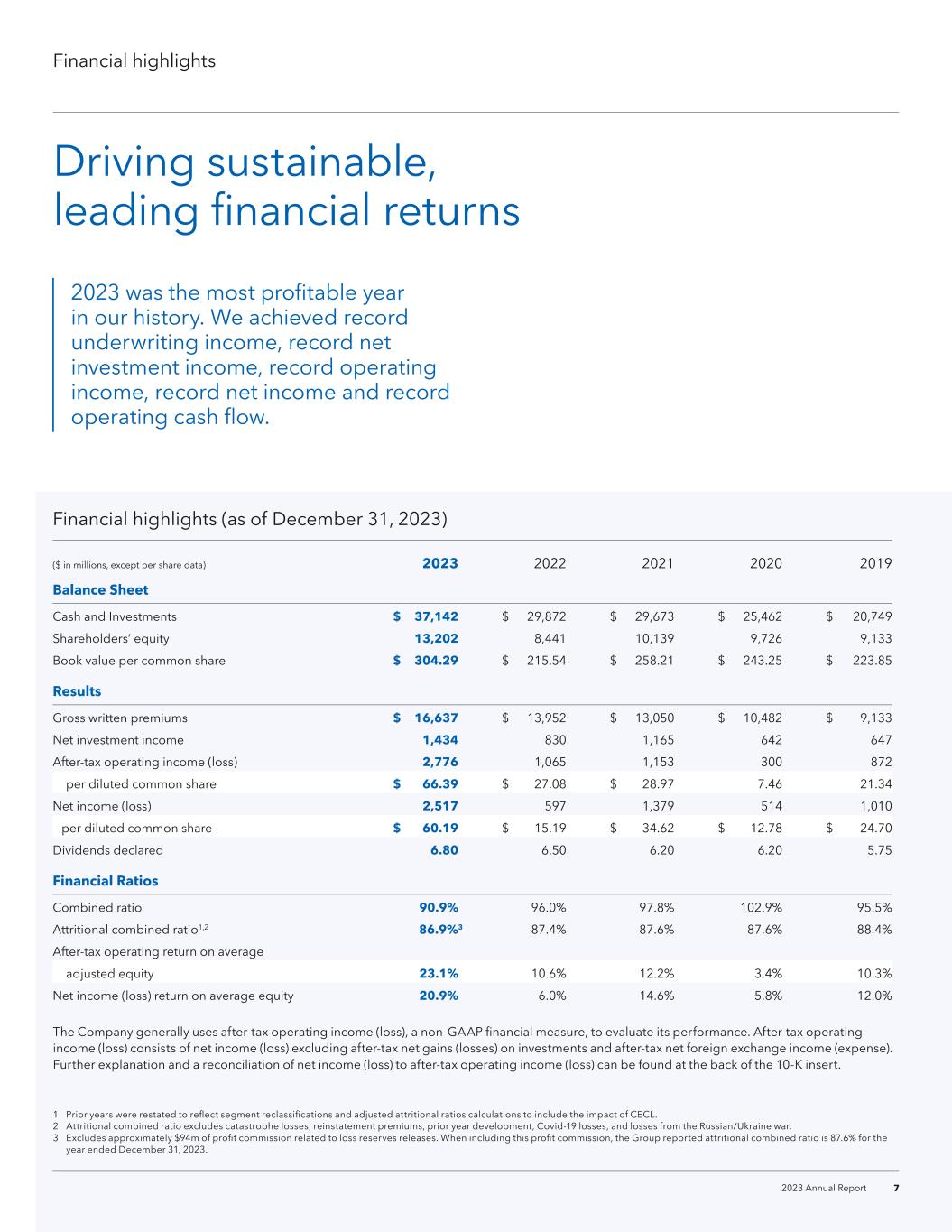
2023 was the most profitable year in our history. We achieved record underwriting income, record net investment income, record operating income, record net income and record operating cash flow. Financial highlights Driving sustainable, leading financial returns Financial highlights (as of December 31, 2023) ($ in millions, except per share data) 2023 2022 2021 2020 2019 Balance Sheet Cash and Investments $ 37,142 $ 29,872 $ 29,673 $ 25,462 $ 20,749 Shareholders’ equity 13,202 8,441 10,139 9,726 9,133 Book value per common share $ 304.29 $ 215.54 $ 258.21 $ 243.25 $ 223.85 Results Gross written premiums $ 16,637 $ 13,952 $ 13,050 $ 10,482 $ 9,133 Net investment income 1,434 830 1,165 642 647 After-tax operating income (loss) 2,776 1,065 1,153 300 872 per diluted common share $ 66.39 $ 27.08 $ 28.97 7.46 21.34 Net income (loss) 2,517 597 1,379 514 1,010 per diluted common share $ 60.19 $ 15.19 $ 34.62 $ 12.78 $ 24.70 Dividends declared 6.80 6.50 6.20 6.20 5.75 Financial Ratios Combined ratio 90.9% 96.0% 97.8% 102.9% 95.5% Attritional combined ratio1,2 86.9%3 87.4% 87.6% 87.6% 88.4% After-tax operating return on average adjusted equity 23.1% 10.6% 12.2% 3.4% 10.3% Net income (loss) return on average equity 20.9% 6.0% 14.6% 5.8% 12.0% 1 Prior years were restated to reflect segment reclassifications and adjusted attritional ratios calculations to include the impact of CECL. 2 Attritional combined ratio excludes catastrophe losses, reinstatement premiums, prior year development, Covid-19 losses, and losses from the Russian/Ukraine war. 3 Excludes approximately $94m of profit commission related to loss reserves releases. When including this profit commission, the Group reported attritional combined ratio is 87.6% for the year ended December 31, 2023. The Company generally uses after-tax operating income (loss), a non-GAAP financial measure, to evaluate its performance. After-tax operating income (loss) consists of net income (loss) excluding after-tax net gains (losses) on investments and after-tax net foreign exchange income (expense). Further explanation and a reconciliation of net income (loss) to after-tax operating income (loss) can be found at the back of the 10-K insert. 2023 Annual Report 7
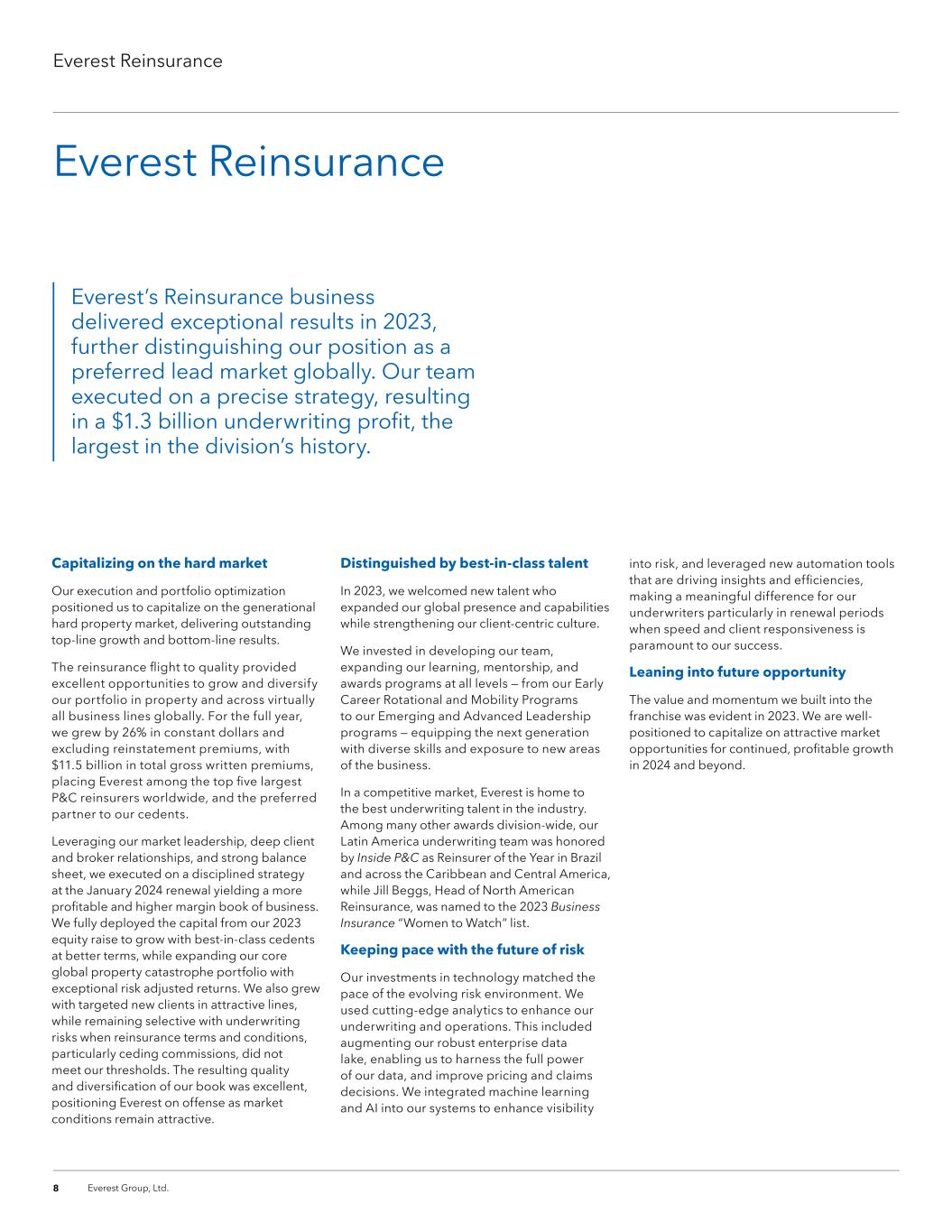
Everest Reinsurance Everest’s Reinsurance business delivered exceptional results in 2023, further distinguishing our position as a preferred lead market globally. Our team executed on a precise strategy, resulting in a $1.3 billion underwriting profit, the largest in the division’s history. Everest Reinsurance Capitalizing on the hard market Our execution and portfolio optimization positioned us to capitalize on the generational hard property market, delivering outstanding top-line growth and bottom-line results. The reinsurance flight to quality provided excellent opportunities to grow and diversify our portfolio in property and across virtually all business lines globally. For the full year, we grew by 26% in constant dollars and excluding reinstatement premiums, with $11.5 billion in total gross written premiums, placing Everest among the top five largest P&C reinsurers worldwide, and the preferred partner to our cedents. Leveraging our market leadership, deep client and broker relationships, and strong balance sheet, we executed on a disciplined strategy at the January 2024 renewal yielding a more profitable and higher margin book of business. We fully deployed the capital from our 2023 equity raise to grow with best-in-class cedents at better terms, while expanding our core global property catastrophe portfolio with exceptional risk adjusted returns. We also grew with targeted new clients in attractive lines, while remaining selective with underwriting risks when reinsurance terms and conditions, particularly ceding commissions, did not meet our thresholds. The resulting quality and diversification of our book was excellent, positioning Everest on offense as market conditions remain attractive. Distinguished by best-in-class talent In 2023, we welcomed new talent who expanded our global presence and capabilities while strengthening our client-centric culture. We invested in developing our team, expanding our learning, mentorship, and awards programs at all levels — from our Early Career Rotational and Mobility Programs to our Emerging and Advanced Leadership programs — equipping the next generation with diverse skills and exposure to new areas of the business. In a competitive market, Everest is home to the best underwriting talent in the industry. Among many other awards division-wide, our Latin America underwriting team was honored by Inside P&C as Reinsurer of the Year in Brazil and across the Caribbean and Central America, while Jill Beggs, Head of North American Reinsurance, was named to the 2023 Business Insurance “Women to Watch” list. Keeping pace with the future of risk Our investments in technology matched the pace of the evolving risk environment. We used cutting-edge analytics to enhance our underwriting and operations. This included augmenting our robust enterprise data lake, enabling us to harness the full power of our data, and improve pricing and claims decisions. We integrated machine learning and AI into our systems to enhance visibility into risk, and leveraged new automation tools that are driving insights and efficiencies, making a meaningful difference for our underwriters particularly in renewal periods when speed and client responsiveness is paramount to our success. Leaning into future opportunity The value and momentum we built into the franchise was evident in 2023. We are well- positioned to capitalize on attractive market opportunities for continued, profitable growth in 2024 and beyond. Everest Group, Ltd.8

30% Property Pro Rata 6% Property Non-Catastrophe XOL 15% Property Catastrophe XOL 27% Casualty Pro Rata 14% Casualty XOL 8% Financial Lines Tony Izzo Senior Vice President, Global Facultative and Distribution, Everest Reinsurance Jill Beggs Reinsurance Executive Vice President and Chief Operating Officer, Everest Reinsurance Artur Klinger Senior Vice President, Head of International, Everest Reinsurance Everest Reinsurance leadership team Everest is set apart by our people, and the nimble, entrepreneurial culture that supports them. It is maintained by a flat organizational structure that prioritizes engagement with our business partners, making Everest the standard for speed and responsiveness to our brokers and cedants. This focus on delivering superior service is a competitive advantage and it helped create the success we achieved in challenging January 1 renewals. Working together as one team, Everest delivered a clear, consistent message to the market. With local teams who are deeply connected to their markets and empowered to make decisions, we pivoted to respond to local conditions without the bureaucracy and complexity slowing our competitors. Importantly, we furthered our strategy to deepen Everest’s footprint, gaining share in new and underpenetrated markets with high margin opportunities. One of those expansion opportunities is Asia, where our team mobilized to build a healthy, high margin business in South Korea, Southeast Asia, India, Taiwan, and Australia. We also deepened our capabilities in specialty risk areas such as Engineering and Cyber, where we have grown our position alongside improving economics. Specifically, our Engineering portfolio experienced a robust 38% growth from 2022 to 2023 and our standalone Cyber contracts surged in 2023 to $304 million. We ended 2023 in a position of strength, achieving our objectives with renewals and executing with the same focus and discipline Everest has applied to the shaping and diversifying of our portfolio. We are poised to continue delivering value in 2024 and distinguishing ourselves as the preferred lead market platform. Spotlight Capitalizing on Everest’s nimble & responsive culture Gross Written Premium By Region Gross Written Premium By Line of Business 39% USA 6% Canada 4% Asia/Australia 13% Latin America 11% Worldwide (Bermuda) 4% Middle East/Africa 23% Europe/UK Jim Williamson Executive Vice President, Group Chief Operating Officer and Head of Everest Reinsurance Chris Downey Senior Vice President, Chief Underwriting Officer, Everest Reinsurance 2023 Annual Report 9
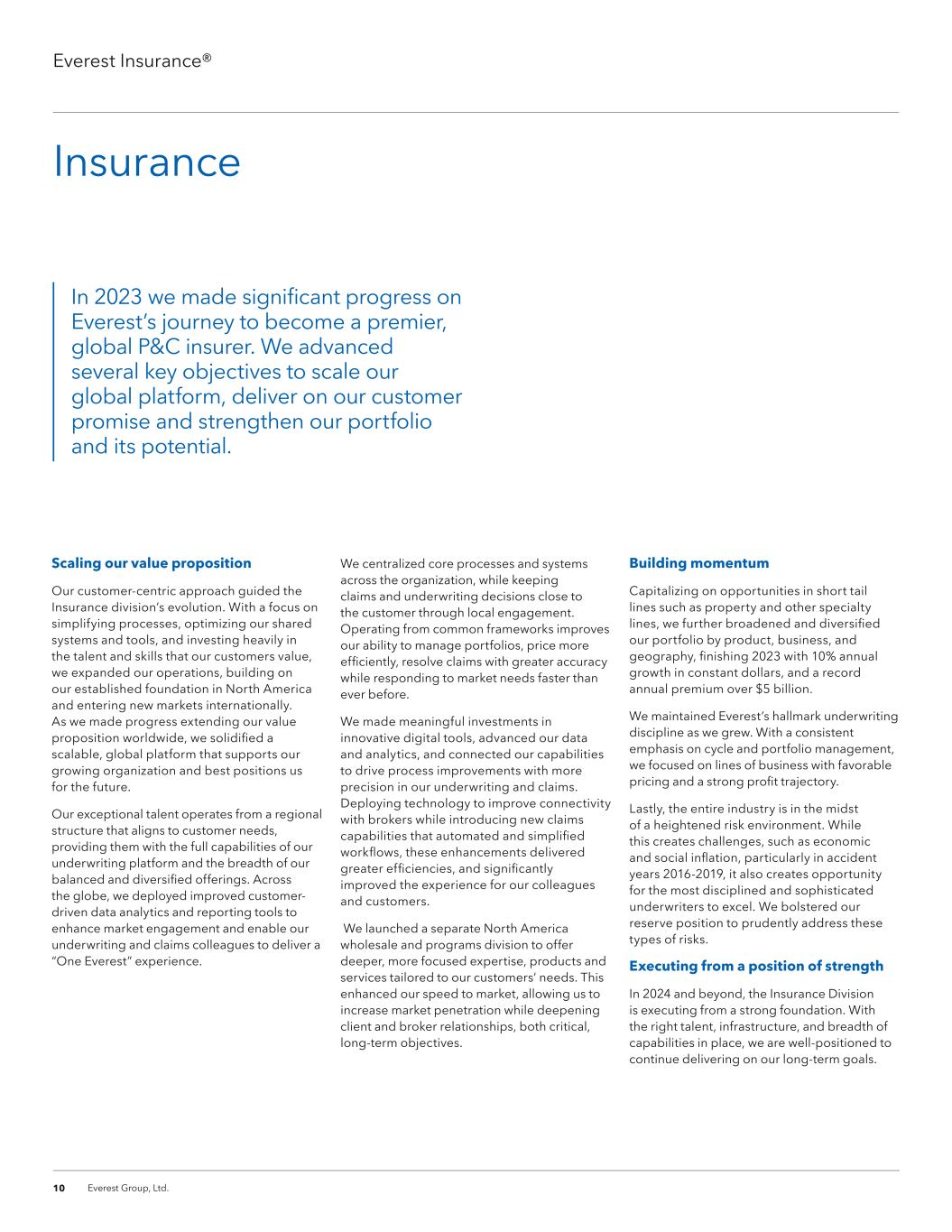
Everest Insurance® In 2023 we made significant progress on Everest’s journey to become a premier, global P&C insurer. We advanced several key objectives to scale our global platform, deliver on our customer promise and strengthen our portfolio and its potential. Insurance Scaling our value proposition Our customer-centric approach guided the Insurance division’s evolution. With a focus on simplifying processes, optimizing our shared systems and tools, and investing heavily in the talent and skills that our customers value, we expanded our operations, building on our established foundation in North America and entering new markets internationally. As we made progress extending our value proposition worldwide, we solidified a scalable, global platform that supports our growing organization and best positions us for the future. Our exceptional talent operates from a regional structure that aligns to customer needs, providing them with the full capabilities of our underwriting platform and the breadth of our balanced and diversified offerings. Across the globe, we deployed improved customer- driven data analytics and reporting tools to enhance market engagement and enable our underwriting and claims colleagues to deliver a “One Everest” experience. We centralized core processes and systems across the organization, while keeping claims and underwriting decisions close to the customer through local engagement. Operating from common frameworks improves our ability to manage portfolios, price more efficiently, resolve claims with greater accuracy while responding to market needs faster than ever before. We made meaningful investments in innovative digital tools, advanced our data and analytics, and connected our capabilities to drive process improvements with more precision in our underwriting and claims. Deploying technology to improve connectivity with brokers while introducing new claims capabilities that automated and simplified workflows, these enhancements delivered greater efficiencies, and significantly improved the experience for our colleagues and customers. We launched a separate North America wholesale and programs division to offer deeper, more focused expertise, products and services tailored to our customers’ needs. This enhanced our speed to market, allowing us to increase market penetration while deepening client and broker relationships, both critical, long-term objectives. Building momentum Capitalizing on opportunities in short tail lines such as property and other specialty lines, we further broadened and diversified our portfolio by product, business, and geography, finishing 2023 with 10% annual growth in constant dollars, and a record annual premium over $5 billion. We maintained Everest’s hallmark underwriting discipline as we grew. With a consistent emphasis on cycle and portfolio management, we focused on lines of business with favorable pricing and a strong profit trajectory. Lastly, the entire industry is in the midst of a heightened risk environment. While this creates challenges, such as economic and social inflation, particularly in accident years 2016-2019, it also creates opportunity for the most disciplined and sophisticated underwriters to excel. We bolstered our reserve position to prudently address these types of risks. Executing from a position of strength In 2024 and beyond, the Insurance Division is executing from a strong foundation. With the right talent, infrastructure, and breadth of capabilities in place, we are well-positioned to continue delivering on our long-term goals. Everest Group, Ltd.10
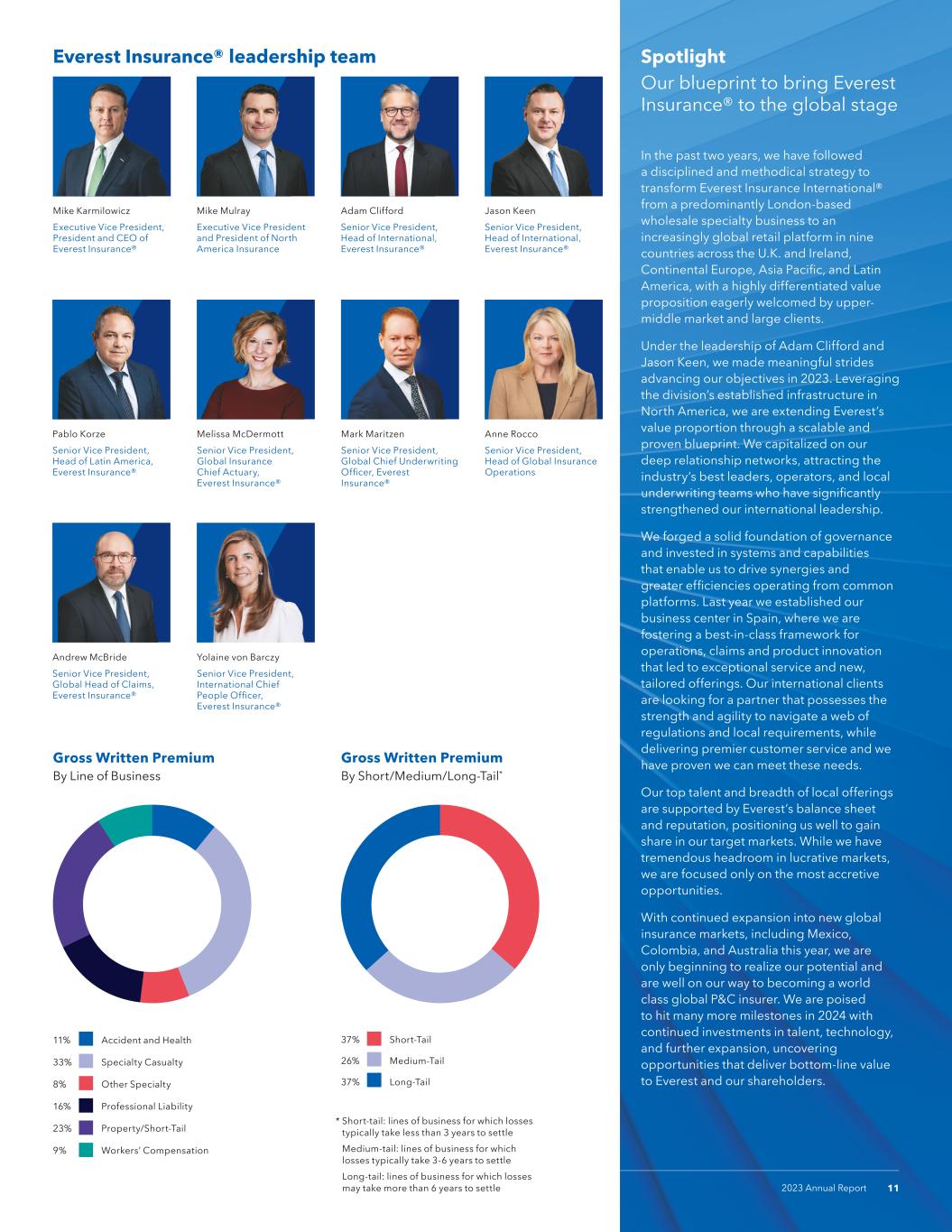
In the past two years, we have followed a disciplined and methodical strategy to transform Everest Insurance International® from a predominantly London-based wholesale specialty business to an increasingly global retail platform in nine countries across the U.K. and Ireland, Continental Europe, Asia Pacific, and Latin America, with a highly differentiated value proposition eagerly welcomed by upper- middle market and large clients. Under the leadership of Adam Clifford and Jason Keen, we made meaningful strides advancing our objectives in 2023. Leveraging the division’s established infrastructure in North America, we are extending Everest’s value proportion through a scalable and proven blueprint. We capitalized on our deep relationship networks, attracting the industry’s best leaders, operators, and local underwriting teams who have significantly strengthened our international leadership. We forged a solid foundation of governance and invested in systems and capabilities that enable us to drive synergies and greater efficiencies operating from common platforms. Last year we established our business center in Spain, where we are fostering a best-in-class framework for operations, claims and product innovation that led to exceptional service and new, tailored offerings. Our international clients are looking for a partner that possesses the strength and agility to navigate a web of regulations and local requirements, while delivering premier customer service and we have proven we can meet these needs. Our top talent and breadth of local offerings are supported by Everest’s balance sheet and reputation, positioning us well to gain share in our target markets. While we have tremendous headroom in lucrative markets, we are focused only on the most accretive opportunities. With continued expansion into new global insurance markets, including Mexico, Colombia, and Australia this year, we are only beginning to realize our potential and are well on our way to becoming a world class global P&C insurer. We are poised to hit many more milestones in 2024 with continued investments in talent, technology, and further expansion, uncovering opportunities that deliver bottom-line value to Everest and our shareholders. Spotlight Our blueprint to bring Everest Insurance® to the global stage Pablo Korze Senior Vice President, Head of Latin America, Everest Insurance® Andrew McBride Senior Vice President, Global Head of Claims, Everest Insurance® Mark Maritzen Senior Vice President, Global Chief Underwriting Officer, Everest Insurance® Melissa McDermott Senior Vice President, Global Insurance Chief Actuary, Everest Insurance® Yolaine von Barczy Senior Vice President, International Chief People Officer, Everest Insurance® Adam Clifford Senior Vice President, Head of International, Everest Insurance® Jason Keen Senior Vice President, Head of International, Everest Insurance® Everest Insurance® leadership team Gross Written Premium By Line of Business Gross Written Premium By Short/Medium/Long-Tail* * Short-tail: lines of business for which losses typically take less than 3 years to settle Medium-tail: lines of business for which losses typically take 3-6 years to settle Long-tail: lines of business for which losses may take more than 6 years to settle 37% Long-Tail 26% Medium-Tail 37% Short-Tail11% Accident and Health 33% Specialty Casualty 8% Other Specialty 16% Professional Liability 23% Property/Short-Tail 9% Workers’ Compensation Anne Rocco Senior Vice President, Head of Global Insurance Operations Mike Karmilowicz Executive Vice President, President and CEO of Everest Insurance® Mike Mulray Executive Vice President and President of North America Insurance 2023 Annual Report 11
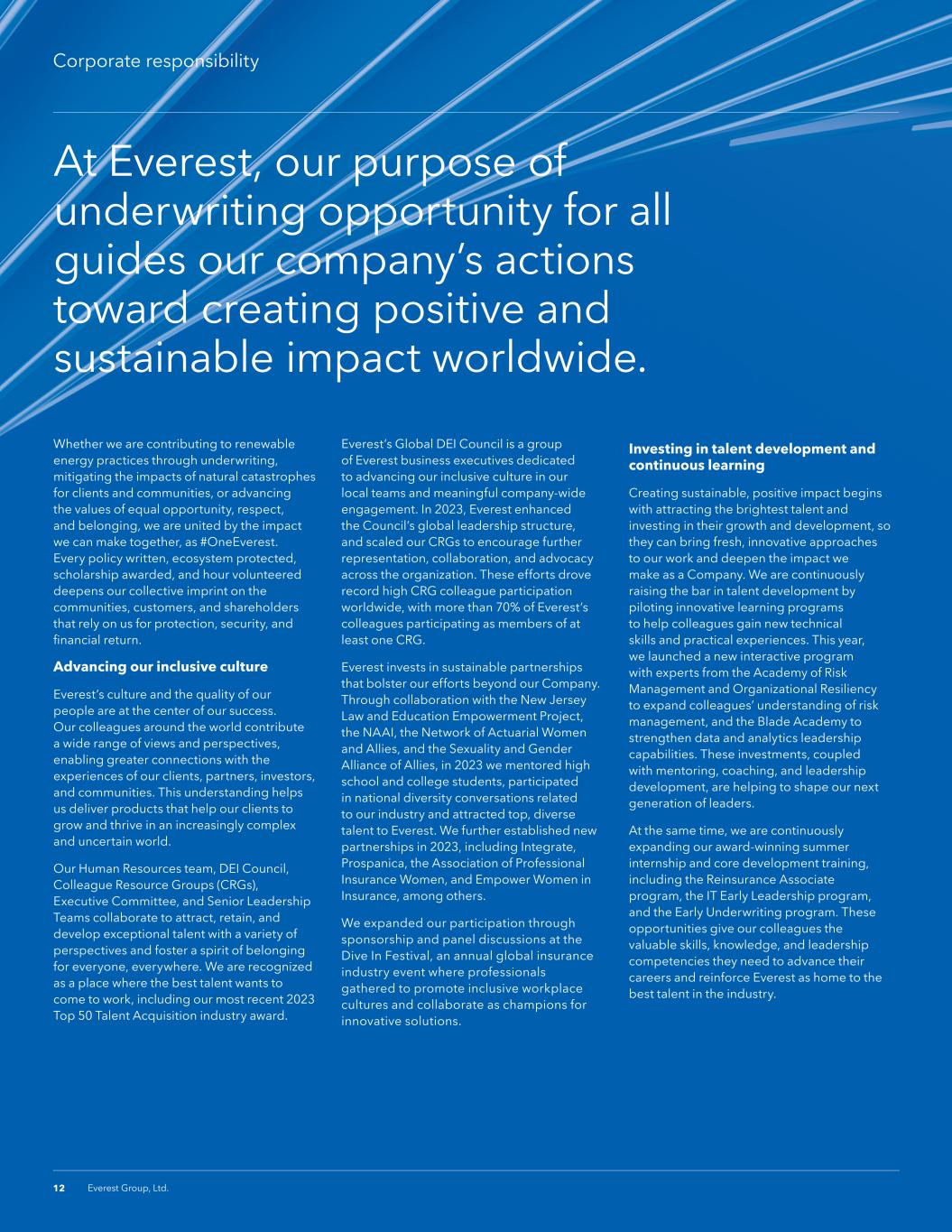
Corporate responsibility Whether we are contributing to renewable energy practices through underwriting, mitigating the impacts of natural catastrophes for clients and communities, or advancing the values of equal opportunity, respect, and belonging, we are united by the impact we can make together, as #OneEverest. Every policy written, ecosystem protected, scholarship awarded, and hour volunteered deepens our collective imprint on the communities, customers, and shareholders that rely on us for protection, security, and financial return. Advancing our inclusive culture Everest’s culture and the quality of our people are at the center of our success. Our colleagues around the world contribute a wide range of views and perspectives, enabling greater connections with the experiences of our clients, partners, investors, and communities. This understanding helps us deliver products that help our clients to grow and thrive in an increasingly complex and uncertain world. Our Human Resources team, DEI Council, Colleague Resource Groups (CRGs), Executive Committee, and Senior Leadership Teams collaborate to attract, retain, and develop exceptional talent with a variety of perspectives and foster a spirit of belonging for everyone, everywhere. We are recognized as a place where the best talent wants to come to work, including our most recent 2023 Top 50 Talent Acquisition industry award. Everest’s Global DEI Council is a group of Everest business executives dedicated to advancing our inclusive culture in our local teams and meaningful company-wide engagement. In 2023, Everest enhanced the Council’s global leadership structure, and scaled our CRGs to encourage further representation, collaboration, and advocacy across the organization. These efforts drove record high CRG colleague participation worldwide, with more than 70% of Everest’s colleagues participating as members of at least one CRG. Everest invests in sustainable partnerships that bolster our efforts beyond our Company. Through collaboration with the New Jersey Law and Education Empowerment Project, the NAAI, the Network of Actuarial Women and Allies, and the Sexuality and Gender Alliance of Allies, in 2023 we mentored high school and college students, participated in national diversity conversations related to our industry and attracted top, diverse talent to Everest. We further established new partnerships in 2023, including Integrate, Prospanica, the Association of Professional Insurance Women, and Empower Women in Insurance, among others. We expanded our participation through sponsorship and panel discussions at the Dive In Festival, an annual global insurance industry event where professionals gathered to promote inclusive workplace cultures and collaborate as champions for innovative solutions. Investing in talent development and continuous learning Creating sustainable, positive impact begins with attracting the brightest talent and investing in their growth and development, so they can bring fresh, innovative approaches to our work and deepen the impact we make as a Company. We are continuously raising the bar in talent development by piloting innovative learning programs to help colleagues gain new technical skills and practical experiences. This year, we launched a new interactive program with experts from the Academy of Risk Management and Organizational Resiliency to expand colleagues’ understanding of risk management, and the Blade Academy to strengthen data and analytics leadership capabilities. These investments, coupled with mentoring, coaching, and leadership development, are helping to shape our next generation of leaders. At the same time, we are continuously expanding our award-winning summer internship and core development training, including the Reinsurance Associate program, the IT Early Leadership program, and the Early Underwriting program. These opportunities give our colleagues the valuable skills, knowledge, and leadership competencies they need to advance their careers and reinforce Everest as home to the best talent in the industry. At Everest, our purpose of underwriting opportunity for all guides our company’s actions toward creating positive and sustainable impact worldwide. Everest Group, Ltd.12
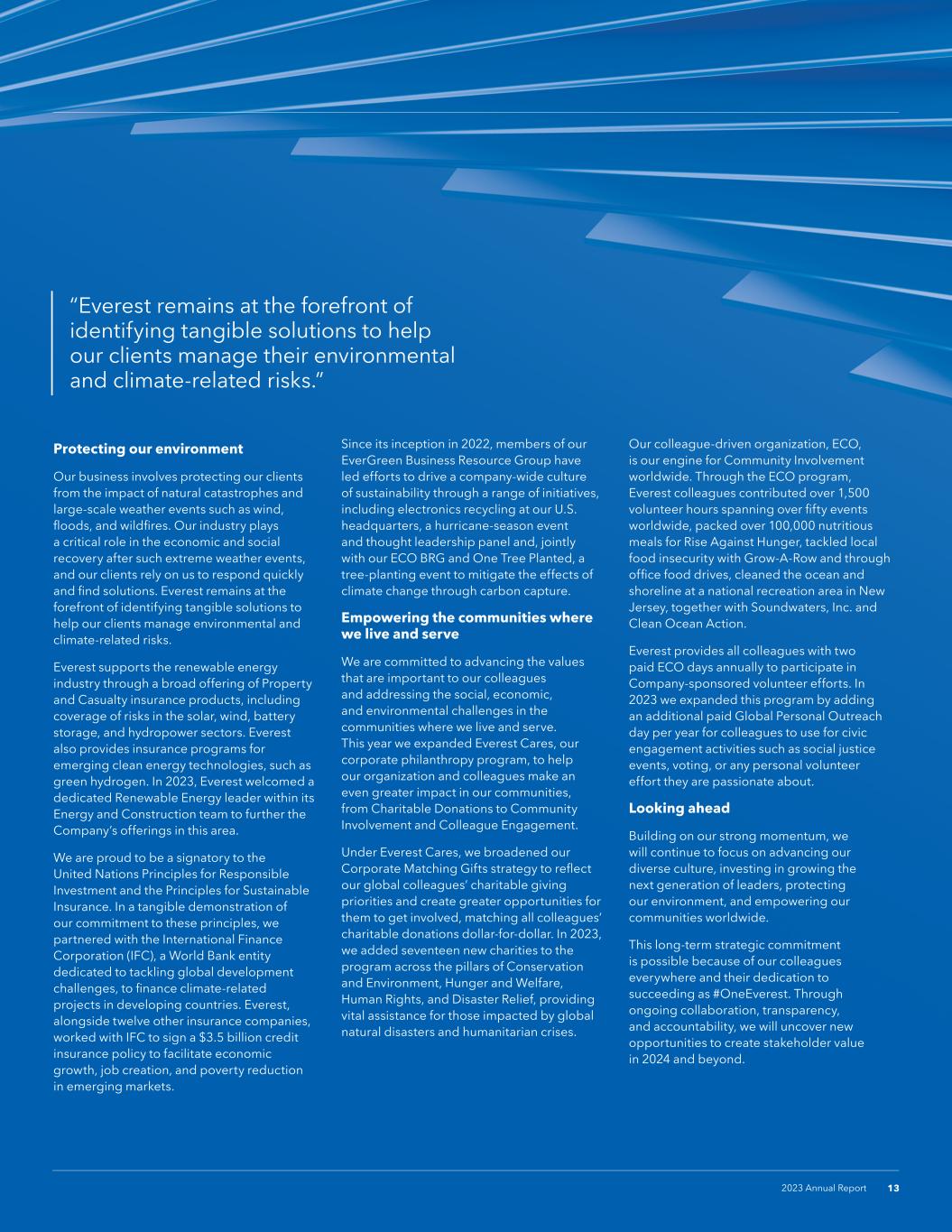
“Everest remains at the forefront of identifying tangible solutions to help our clients manage their environmental and climate-related risks.” Protecting our environment Our business involves protecting our clients from the impact of natural catastrophes and large-scale weather events such as wind, floods, and wildfires. Our industry plays a critical role in the economic and social recovery after such extreme weather events, and our clients rely on us to respond quickly and find solutions. Everest remains at the forefront of identifying tangible solutions to help our clients manage environmental and climate-related risks. Everest supports the renewable energy industry through a broad offering of Property and Casualty insurance products, including coverage of risks in the solar, wind, battery storage, and hydropower sectors. Everest also provides insurance programs for emerging clean energy technologies, such as green hydrogen. In 2023, Everest welcomed a dedicated Renewable Energy leader within its Energy and Construction team to further the Company’s offerings in this area. We are proud to be a signatory to the United Nations Principles for Responsible Investment and the Principles for Sustainable Insurance. In a tangible demonstration of our commitment to these principles, we partnered with the International Finance Corporation (IFC), a World Bank entity dedicated to tackling global development challenges, to finance climate-related projects in developing countries. Everest, alongside twelve other insurance companies, worked with IFC to sign a $3.5 billion credit insurance policy to facilitate economic growth, job creation, and poverty reduction in emerging markets. Since its inception in 2022, members of our EverGreen Business Resource Group have led efforts to drive a company-wide culture of sustainability through a range of initiatives, including electronics recycling at our U.S. headquarters, a hurricane-season event and thought leadership panel and, jointly with our ECO BRG and One Tree Planted, a tree-planting event to mitigate the effects of climate change through carbon capture. Empowering the communities where we live and serve We are committed to advancing the values that are important to our colleagues and addressing the social, economic, and environmental challenges in the communities where we live and serve. This year we expanded Everest Cares, our corporate philanthropy program, to help our organization and colleagues make an even greater impact in our communities, from Charitable Donations to Community Involvement and Colleague Engagement. Under Everest Cares, we broadened our Corporate Matching Gifts strategy to reflect our global colleagues’ charitable giving priorities and create greater opportunities for them to get involved, matching all colleagues’ charitable donations dollar-for-dollar. In 2023, we added seventeen new charities to the program across the pillars of Conservation and Environment, Hunger and Welfare, Human Rights, and Disaster Relief, providing vital assistance for those impacted by global natural disasters and humanitarian crises. Our colleague-driven organization, ECO, is our engine for Community Involvement worldwide. Through the ECO program, Everest colleagues contributed over 1,500 volunteer hours spanning over fifty events worldwide, packed over 100,000 nutritious meals for Rise Against Hunger, tackled local food insecurity with Grow-A-Row and through office food drives, cleaned the ocean and shoreline at a national recreation area in New Jersey, together with Soundwaters, Inc. and Clean Ocean Action. Everest provides all colleagues with two paid ECO days annually to participate in Company-sponsored volunteer efforts. In 2023 we expanded this program by adding an additional paid Global Personal Outreach day per year for colleagues to use for civic engagement activities such as social justice events, voting, or any personal volunteer effort they are passionate about. Looking ahead Building on our strong momentum, we will continue to focus on advancing our diverse culture, investing in growing the next generation of leaders, protecting our environment, and empowering our communities worldwide. This long-term strategic commitment is possible because of our colleagues everywhere and their dedication to succeeding as #OneEverest. Through ongoing collaboration, transparency, and accountability, we will uncover new opportunities to create stakeholder value in 2024 and beyond. 2023 Annual Report 13
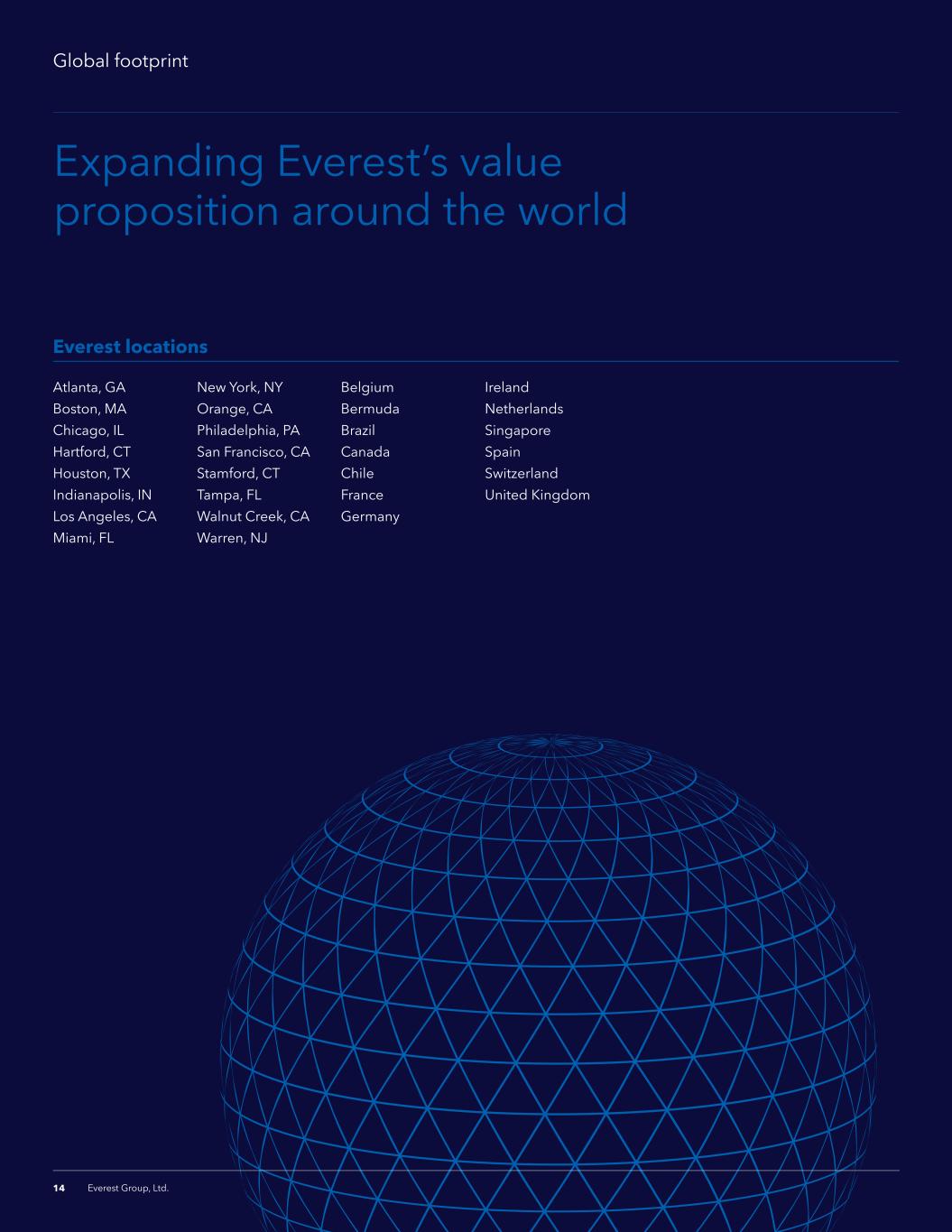
Global footprint Expanding Everest’s value proposition around the world Everest locations Atlanta, GA Boston, MA Chicago, IL Hartford, CT Houston, TX Indianapolis, IN Los Angeles, CA Miami, FL New York, NY Orange, CA Philadelphia, PA San Francisco, CA Stamford, CT Tampa, FL Walnut Creek, CA Warren, NJ Belgium Bermuda Brazil Canada Chile France Germany Ireland Netherlands Singapore Spain Switzerland United Kingdom Everest Group, Ltd.14
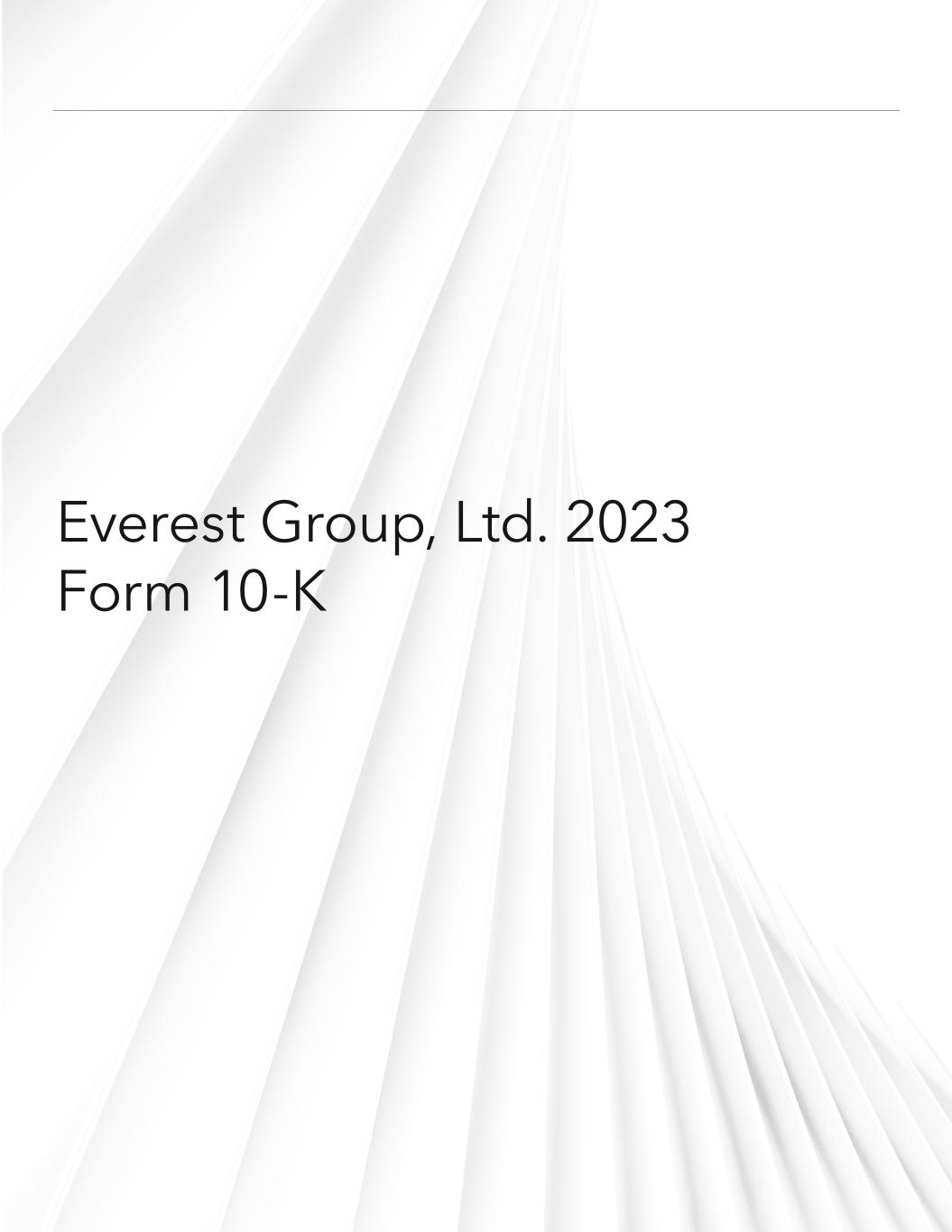
Everest Group, Ltd. 2023 Form 10-K
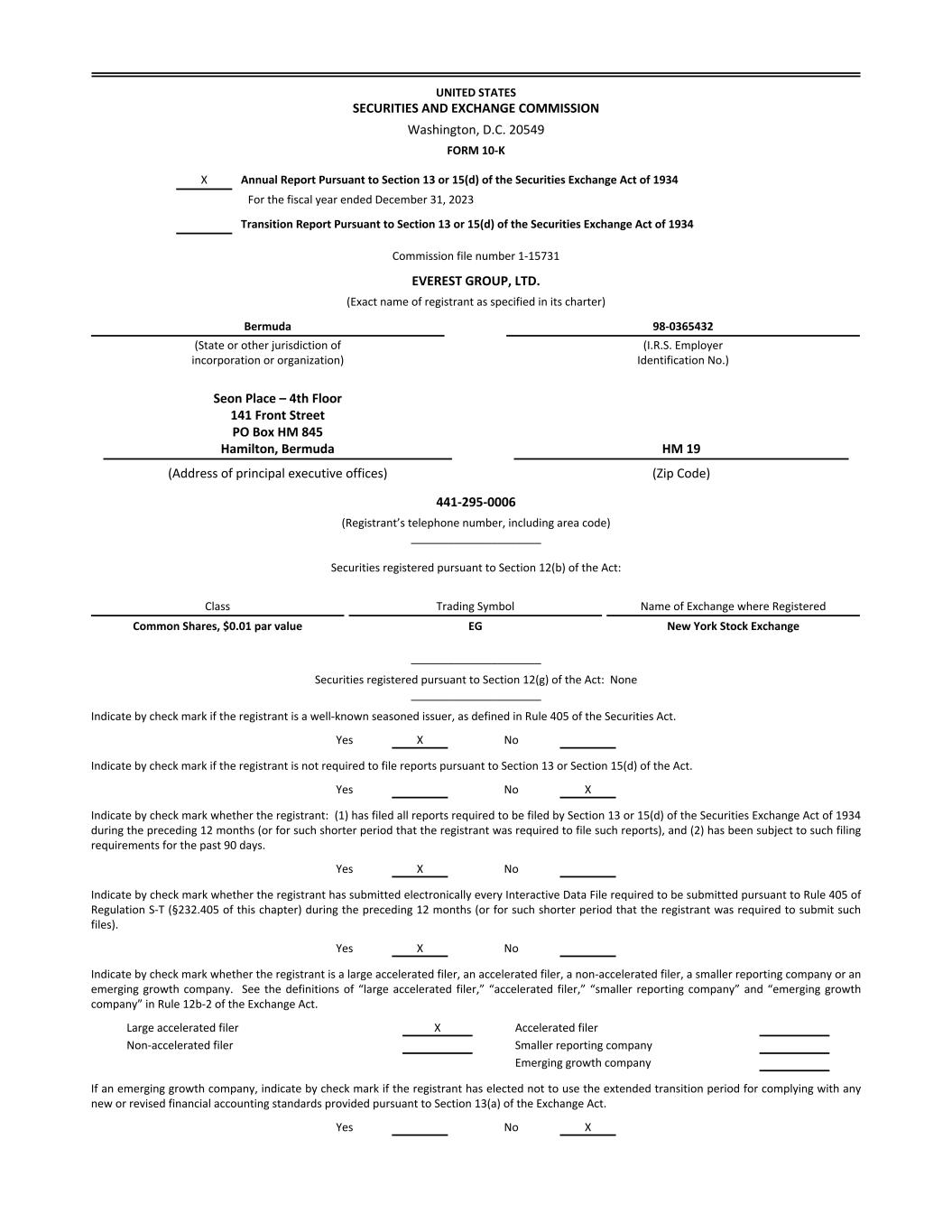
UNITED STATES SECURITIES AND EXCHANGE COMMISSION Washington, D.C. 20549 FORM 10-K X Annual Report Pursuant to Section 13 or 15(d) of the Securities Exchange Act of 1934 For the fiscal year ended December 31, 2023 Transition Report Pursuant to Section 13 or 15(d) of the Securities Exchange Act of 1934 Commission file number 1-15731 EVEREST GROUP, LTD. (Exact name of registrant as specified in its charter) Bermuda 98-0365432 (State or other jurisdiction of incorporation or organization) (I.R.S. Employer Identification No.) Seon Place – 4th Floor 141 Front Street PO Box HM 845 Hamilton, Bermuda HM 19 (Address of principal executive offices) (Zip Code) 441-295-0006 (Registrant’s telephone number, including area code) _____________________ Securities registered pursuant to Section 12(b) of the Act: Class Trading Symbol Name of Exchange where Registered Common Shares, $0.01 par value EG New York Stock Exchange _____________________ Securities registered pursuant to Section 12(g) of the Act: None _____________________ Indicate by check mark if the registrant is a well-known seasoned issuer, as defined in Rule 405 of the Securities Act. Yes X No Indicate by check mark if the registrant is not required to file reports pursuant to Section 13 or Section 15(d) of the Act. Yes No X Indicate by check mark whether the registrant: (1) has filed all reports required to be filed by Section 13 or 15(d) of the Securities Exchange Act of 1934 during the preceding 12 months (or for such shorter period that the registrant was required to file such reports), and (2) has been subject to such filing requirements for the past 90 days. Yes X No Indicate by check mark whether the registrant has submitted electronically every Interactive Data File required to be submitted pursuant to Rule 405 of Regulation S-T (§232.405 of this chapter) during the preceding 12 months (or for such shorter period that the registrant was required to submit such files). Yes X No Indicate by check mark whether the registrant is a large accelerated filer, an accelerated filer, a non-accelerated filer, a smaller reporting company or an emerging growth company. See the definitions of “large accelerated filer,” “accelerated filer,” “smaller reporting company” and “emerging growth company” in Rule 12b-2 of the Exchange Act. Large accelerated filer X Accelerated filer Non-accelerated filer Smaller reporting company Emerging growth company If an emerging growth company, indicate by check mark if the registrant has elected not to use the extended transition period for complying with any new or revised financial accounting standards provided pursuant to Section 13(a) of the Exchange Act. Yes No X

Indicate by check mark whether the registrant has filed a report on and attestation to its management’s assessment of the effectiveness of its internal control over financial reporting under Section 404(b) of the Sarbanes-Oxley Act (15 U.S.C. 7262(b)) by the registered public accounting firm that prepared or issued its audit report. Yes X No If securities are registered pursuant to Section 12(b) of the Act, indicate by check mark whether the financial statements of the registrant included in the filing reflect the correction of an error to previously issued financial statements. o Indicate by check mark whether any of those error corrections are restatements that required a recovery analysis of incentive-based compensation received by any of the registrant’s executive officers during the relevant recovery period pursuant to §240.10D-1(b). o Indicate by check mark whether the registrant is a shell company (as defined in Rule 12b-2 of the Exchange Act). Yes No X The aggregate market value as of June 30, 2023, the last business day of the registrant’s most recently completed second quarter, of the voting shares held by non-affiliates of the registrant was $14.8 billion. Securities registered pursuant to Section 12(b) of the Act: Class Number of Shares Outstanding At February 1, 2024 Common Shares, $0.01 par value 43,381,573 DOCUMENTS INCORPORATED BY REFERENCE Certain information required by Items 10, 11, 12, 13 and 14 of Form 10-K is incorporated by reference into Part III hereof from the registrant’s proxy statement for the 2024 Annual General Meeting of Shareholders, which will be filed with the Securities and Exchange Commission within 120 days of the close of the registrant’s fiscal year ended December 31, 2023.
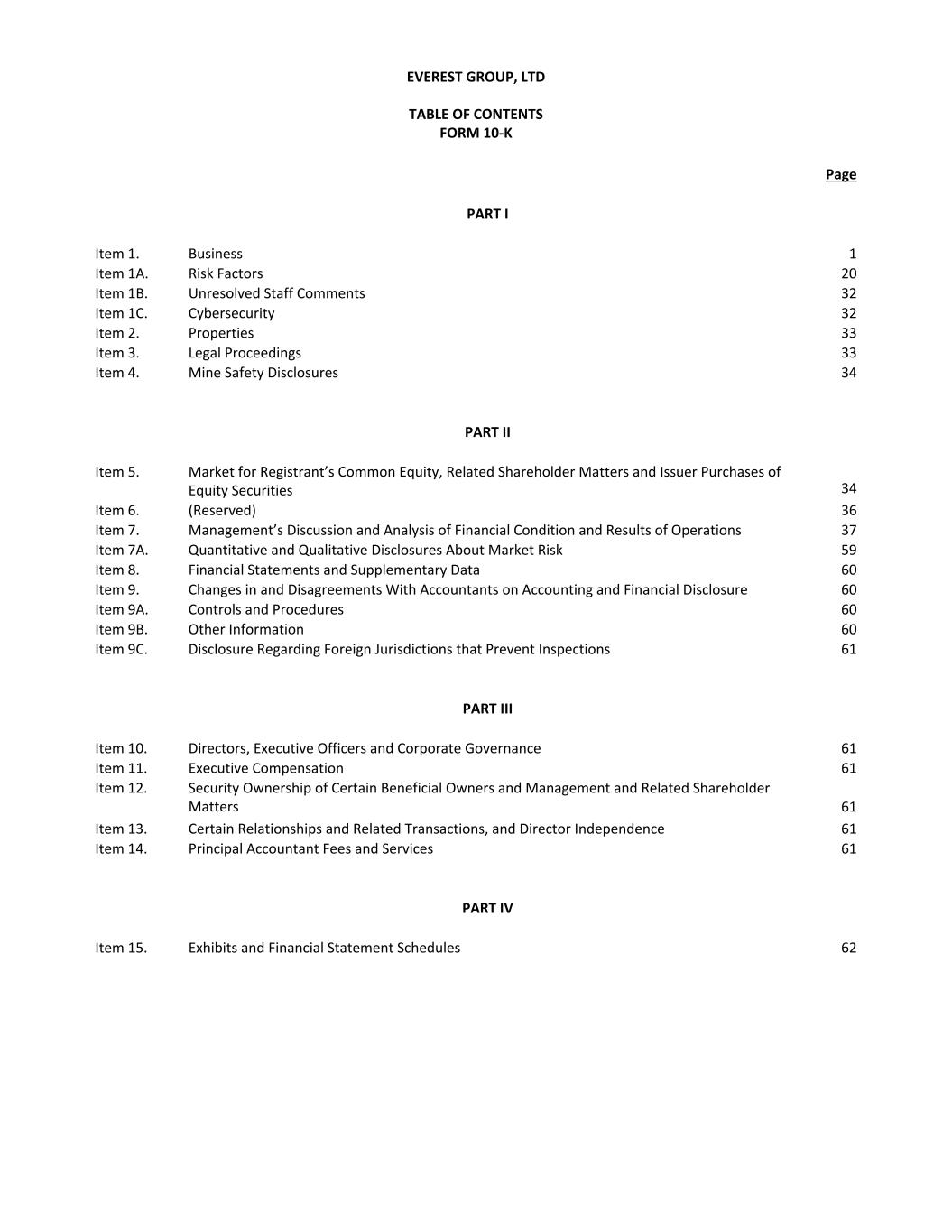
EVEREST GROUP, LTD TABLE OF CONTENTS FORM 10-K Page PART I Item 1. Business 1 Item 1A. Risk Factors 20 Item 1B. Unresolved Staff Comments 32 Item 1C. Cybersecurity 32 Item 2. Properties 33 Item 3. Legal Proceedings 33 Item 4. Mine Safety Disclosures 34 PART II Item 5. Market for Registrant’s Common Equity, Related Shareholder Matters and Issuer Purchases of Equity Securities 34 Item 6. (Reserved) 36 Item 7. Management’s Discussion and Analysis of Financial Condition and Results of Operations 37 Item 7A. Quantitative and Qualitative Disclosures About Market Risk 59 Item 8. Financial Statements and Supplementary Data 60 Item 9. Changes in and Disagreements With Accountants on Accounting and Financial Disclosure 60 Item 9A. Controls and Procedures 60 Item 9B. Other Information 60 Item 9C. Disclosure Regarding Foreign Jurisdictions that Prevent Inspections 61 PART III Item 10. Directors, Executive Officers and Corporate Governance 61 Item 11. Executive Compensation 61 Item 12. Security Ownership of Certain Beneficial Owners and Management and Related Shareholder Matters 61 Item 13. Certain Relationships and Related Transactions, and Director Independence 61 Item 14. Principal Accountant Fees and Services 61 PART IV Item 15. Exhibits and Financial Statement Schedules 62
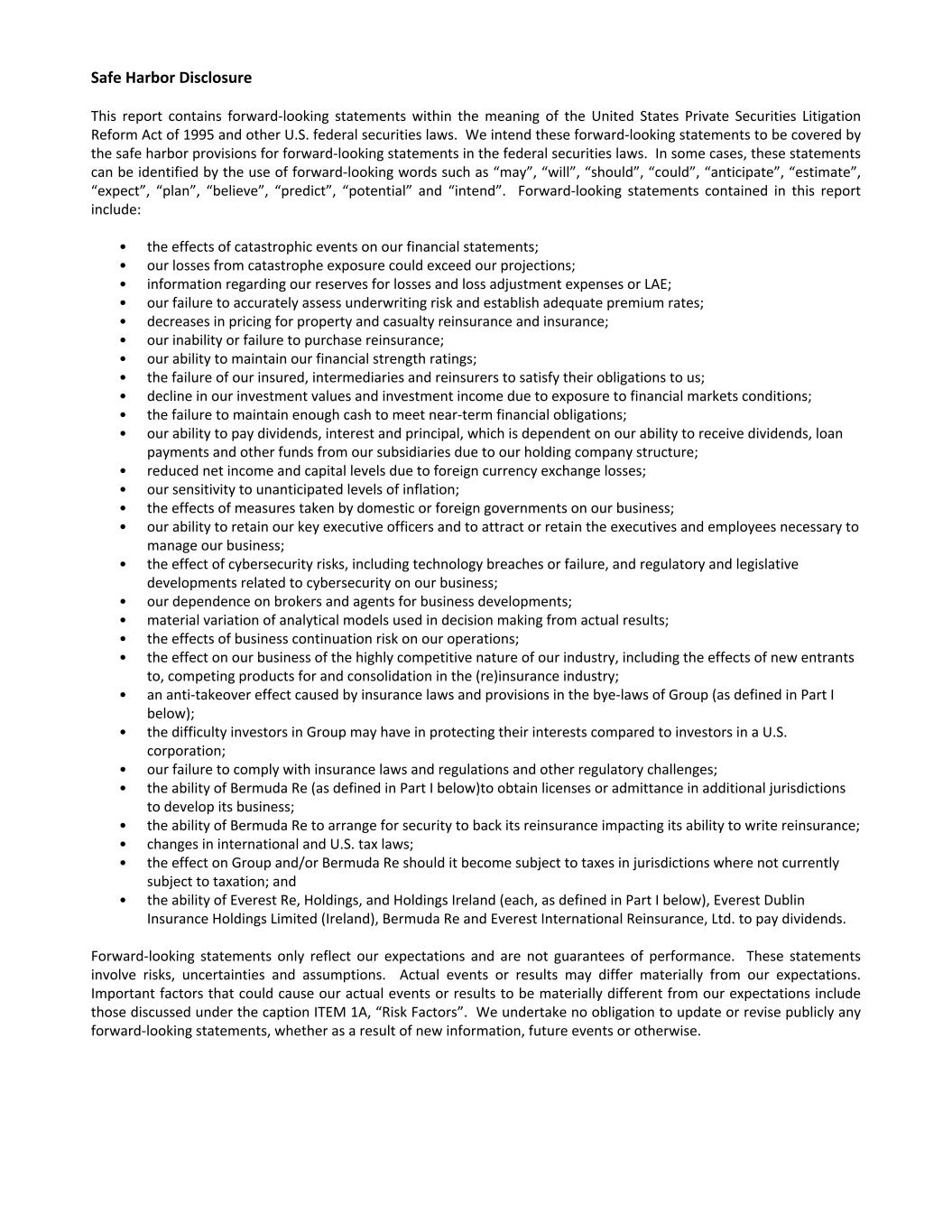
Safe Harbor Disclosure This report contains forward-looking statements within the meaning of the United States Private Securities Litigation Reform Act of 1995 and other U.S. federal securities laws. We intend these forward-looking statements to be covered by the safe harbor provisions for forward-looking statements in the federal securities laws. In some cases, these statements can be identified by the use of forward-looking words such as “may”, “will”, “should”, “could”, “anticipate”, “estimate”, “expect”, “plan”, “believe”, “predict”, “potential” and “intend”. Forward-looking statements contained in this report include: • the effects of catastrophic events on our financial statements; • our losses from catastrophe exposure could exceed our projections; • information regarding our reserves for losses and loss adjustment expenses or LAE; • our failure to accurately assess underwriting risk and establish adequate premium rates; • decreases in pricing for property and casualty reinsurance and insurance; • our inability or failure to purchase reinsurance; • our ability to maintain our financial strength ratings; • the failure of our insured, intermediaries and reinsurers to satisfy their obligations to us; • decline in our investment values and investment income due to exposure to financial markets conditions; • the failure to maintain enough cash to meet near-term financial obligations; • our ability to pay dividends, interest and principal, which is dependent on our ability to receive dividends, loan payments and other funds from our subsidiaries due to our holding company structure; • reduced net income and capital levels due to foreign currency exchange losses; • our sensitivity to unanticipated levels of inflation; • the effects of measures taken by domestic or foreign governments on our business; • our ability to retain our key executive officers and to attract or retain the executives and employees necessary to manage our business; • the effect of cybersecurity risks, including technology breaches or failure, and regulatory and legislative developments related to cybersecurity on our business; • our dependence on brokers and agents for business developments; • material variation of analytical models used in decision making from actual results; • the effects of business continuation risk on our operations; • the effect on our business of the highly competitive nature of our industry, including the effects of new entrants to, competing products for and consolidation in the (re)insurance industry; • an anti-takeover effect caused by insurance laws and provisions in the bye-laws of Group (as defined in Part I below); • the difficulty investors in Group may have in protecting their interests compared to investors in a U.S. corporation; • our failure to comply with insurance laws and regulations and other regulatory challenges; • the ability of Bermuda Re (as defined in Part I below)to obtain licenses or admittance in additional jurisdictions to develop its business; • the ability of Bermuda Re to arrange for security to back its reinsurance impacting its ability to write reinsurance; • changes in international and U.S. tax laws; • the effect on Group and/or Bermuda Re should it become subject to taxes in jurisdictions where not currently subject to taxation; and • the ability of Everest Re, Holdings, and Holdings Ireland (each, as defined in Part I below), Everest Dublin Insurance Holdings Limited (Ireland), Bermuda Re and Everest International Reinsurance, Ltd. to pay dividends. Forward-looking statements only reflect our expectations and are not guarantees of performance. These statements involve risks, uncertainties and assumptions. Actual events or results may differ materially from our expectations. Important factors that could cause our actual events or results to be materially different from our expectations include those discussed under the caption ITEM 1A, “Risk Factors”. We undertake no obligation to update or revise publicly any forward-looking statements, whether as a result of new information, future events or otherwise.

PART I Unless otherwise indicated, all financial data in this document have been prepared using accounting principles generally accepted in the United States of America (“GAAP”). As used in this document, “Group” means Everest Group, Ltd.; “Bermuda Re” means Everest Reinsurance (Bermuda), Ltd.; “Holdings Ireland” means Everest Underwriting Group (Ireland) Limited; “Ireland Re” means Everest Reinsurance Company (Ireland), Designated Activity Company or “dac”; “Ireland Insurance” means Everest Insurance (Ireland), dac; “Holdings” means Everest Reinsurance Holdings, Inc.; “Everest Re” means Everest Reinsurance Company and its subsidiaries (unless the context otherwise requires); and the “Company”, “Everest”, “we”, “us”, and “our” means Everest Group, Ltd. and its consolidated subsidiaries. Unless noted otherwise, all tabular dollar amounts are in millions of United States (“U.S.”) dollars (“U.S. dollars” or “$”). Some amounts may not reconcile due to rounding. ITEM 1. BUSINESS The Company. Everest is a Bermuda-based reinsurance and insurance organization. As part of the S&P 500 Index, we are a leading financial services institution focused on diversifying our portfolio and geographic presence. Through our direct and indirect subsidiaries operating in the U.S. and internationally, we serve a diverse group of clients worldwide, providing what we believe are extensive product and distribution capabilities, a strong balance sheet, an innovative culture and access to world-class talent. At December 31, 2023, we had shareholders’ equity of $13.2 billion and total assets of $49.4 billion. Our Operations. The Company’s principal business, conducted through its Reinsurance and Insurance operating segments, is the underwriting of reinsurance and insurance in the U.S., Bermuda and other international markets. Our global network of operations spans more than 100 countries across six continents. In 2023, the Company had gross written premiums of $16.6 billion with approximately 68.9% representing reinsurance and 31.1% representing insurance. The Company underwrites reinsurance both through brokers and directly with ceding companies, giving it the flexibility to pursue business based on the ceding company’s preferred reinsurance purchasing method. The Company underwrites insurance principally through brokers, including for surplus lines, and general agent relationships. Group’s active operating subsidiaries are each rated A+ (“Superior”) by A.M. Best Company (“A.M. Best”), a leading provider of insurer ratings that assigns financial strength ratings to insurance companies based on their ability to meet their obligations to policyholders. Following is a summary of the Company’s principal operating subsidiaries: • Bermuda Re, a Bermuda insurance company and a direct subsidiary of Group, is registered in Bermuda as a Class 4 insurer and long-term insurer and is authorized to write both reinsurance and insurance property and casualty. Bermuda Re’s UK branch writes property and casualty reinsurance to the United Kingdom, China and European markets. As of December 31, 2023, Bermuda Re had shareholder’s equity of $4.2 billion. • Everest International Reinsurance, Ltd. (“Everest International”), a Bermuda insurance company and a direct subsidiary of Group, is registered in Bermuda as a Class 4 insurer and is authorized to write property and casualty business. Everest International’s Singapore branch writes property and casualty reinsurance to the Singapore market. A majority of Everest International’s business is assumed reinsurance from its affiliates: Everest Re, Bermuda Re, Ireland Re and Ireland Insurance. As of December 31, 2023, Everest International had shareholder’s equity of $1.4 billion. • Ireland Re, an Ireland reinsurance company and an indirect subsidiary of Group, is licensed to write non-life reinsurance, both directly and through brokers, for the London and European markets through its Ireland office as well as through its Zurich branch. • Ireland Insurance, an Ireland insurance company and an indirect subsidiary of Group, is licensed to write insurance for the European markets through its Ireland office as well as through its branches in the United 1
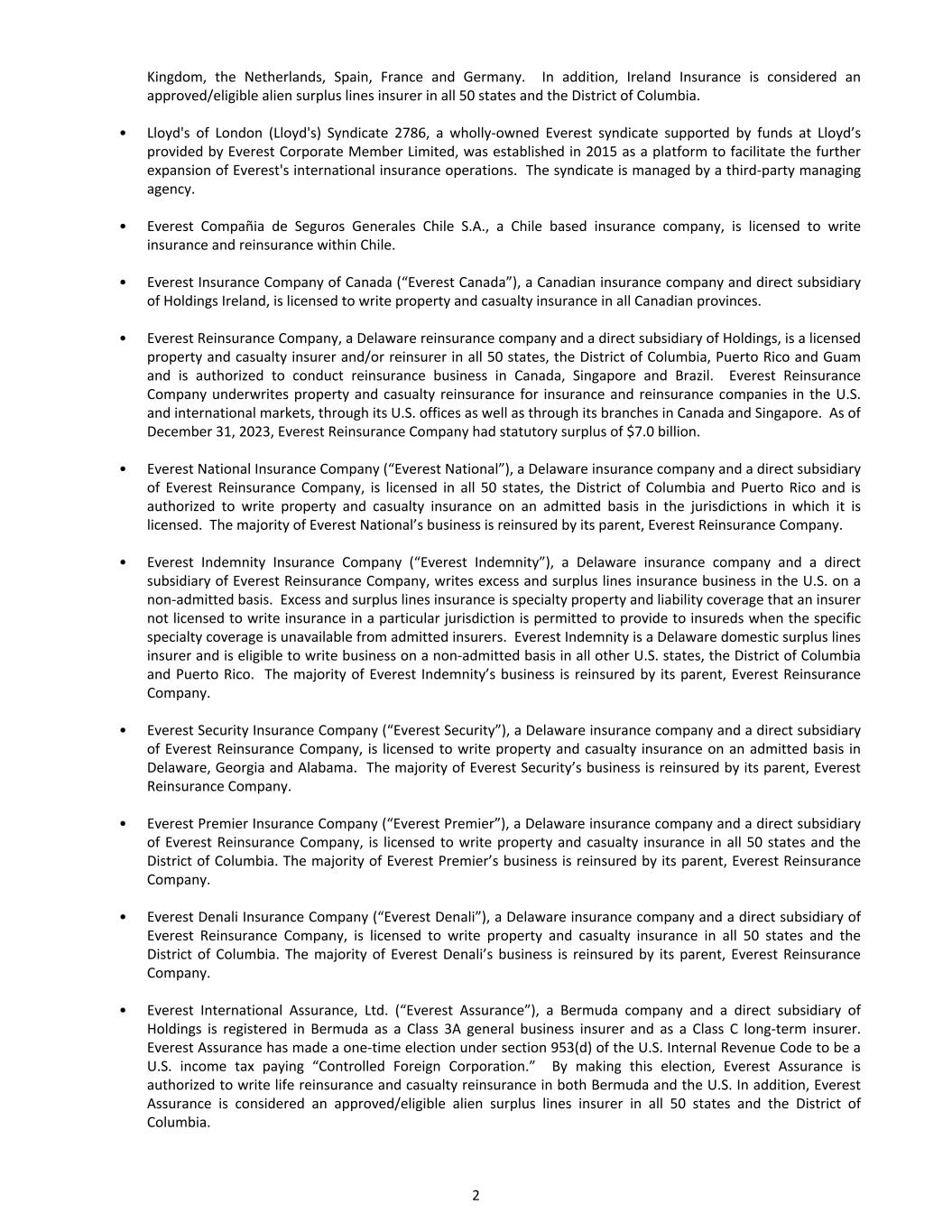
Kingdom, the Netherlands, Spain, France and Germany. In addition, Ireland Insurance is considered an approved/eligible alien surplus lines insurer in all 50 states and the District of Columbia. • Lloyd's of London (Lloyd's) Syndicate 2786, a wholly-owned Everest syndicate supported by funds at Lloyd’s provided by Everest Corporate Member Limited, was established in 2015 as a platform to facilitate the further expansion of Everest's international insurance operations. The syndicate is managed by a third-party managing agency. • Everest Compañia de Seguros Generales Chile S.A., a Chile based insurance company, is licensed to write insurance and reinsurance within Chile. • Everest Insurance Company of Canada (“Everest Canada”), a Canadian insurance company and direct subsidiary of Holdings Ireland, is licensed to write property and casualty insurance in all Canadian provinces. • Everest Reinsurance Company, a Delaware reinsurance company and a direct subsidiary of Holdings, is a licensed property and casualty insurer and/or reinsurer in all 50 states, the District of Columbia, Puerto Rico and Guam and is authorized to conduct reinsurance business in Canada, Singapore and Brazil. Everest Reinsurance Company underwrites property and casualty reinsurance for insurance and reinsurance companies in the U.S. and international markets, through its U.S. offices as well as through its branches in Canada and Singapore. As of December 31, 2023, Everest Reinsurance Company had statutory surplus of $7.0 billion. • Everest National Insurance Company (“Everest National”), a Delaware insurance company and a direct subsidiary of Everest Reinsurance Company, is licensed in all 50 states, the District of Columbia and Puerto Rico and is authorized to write property and casualty insurance on an admitted basis in the jurisdictions in which it is licensed. The majority of Everest National’s business is reinsured by its parent, Everest Reinsurance Company. • Everest Indemnity Insurance Company (“Everest Indemnity”), a Delaware insurance company and a direct subsidiary of Everest Reinsurance Company, writes excess and surplus lines insurance business in the U.S. on a non-admitted basis. Excess and surplus lines insurance is specialty property and liability coverage that an insurer not licensed to write insurance in a particular jurisdiction is permitted to provide to insureds when the specific specialty coverage is unavailable from admitted insurers. Everest Indemnity is a Delaware domestic surplus lines insurer and is eligible to write business on a non-admitted basis in all other U.S. states, the District of Columbia and Puerto Rico. The majority of Everest Indemnity’s business is reinsured by its parent, Everest Reinsurance Company. • Everest Security Insurance Company (“Everest Security”), a Delaware insurance company and a direct subsidiary of Everest Reinsurance Company, is licensed to write property and casualty insurance on an admitted basis in Delaware, Georgia and Alabama. The majority of Everest Security’s business is reinsured by its parent, Everest Reinsurance Company. • Everest Premier Insurance Company (“Everest Premier”), a Delaware insurance company and a direct subsidiary of Everest Reinsurance Company, is licensed to write property and casualty insurance in all 50 states and the District of Columbia. The majority of Everest Premier’s business is reinsured by its parent, Everest Reinsurance Company. • Everest Denali Insurance Company (“Everest Denali”), a Delaware insurance company and a direct subsidiary of Everest Reinsurance Company, is licensed to write property and casualty insurance in all 50 states and the District of Columbia. The majority of Everest Denali’s business is reinsured by its parent, Everest Reinsurance Company. • Everest International Assurance, Ltd. (“Everest Assurance”), a Bermuda company and a direct subsidiary of Holdings is registered in Bermuda as a Class 3A general business insurer and as a Class C long-term insurer. Everest Assurance has made a one-time election under section 953(d) of the U.S. Internal Revenue Code to be a U.S. income tax paying “Controlled Foreign Corporation.” By making this election, Everest Assurance is authorized to write life reinsurance and casualty reinsurance in both Bermuda and the U.S. In addition, Everest Assurance is considered an approved/eligible alien surplus lines insurer in all 50 states and the District of Columbia. 2
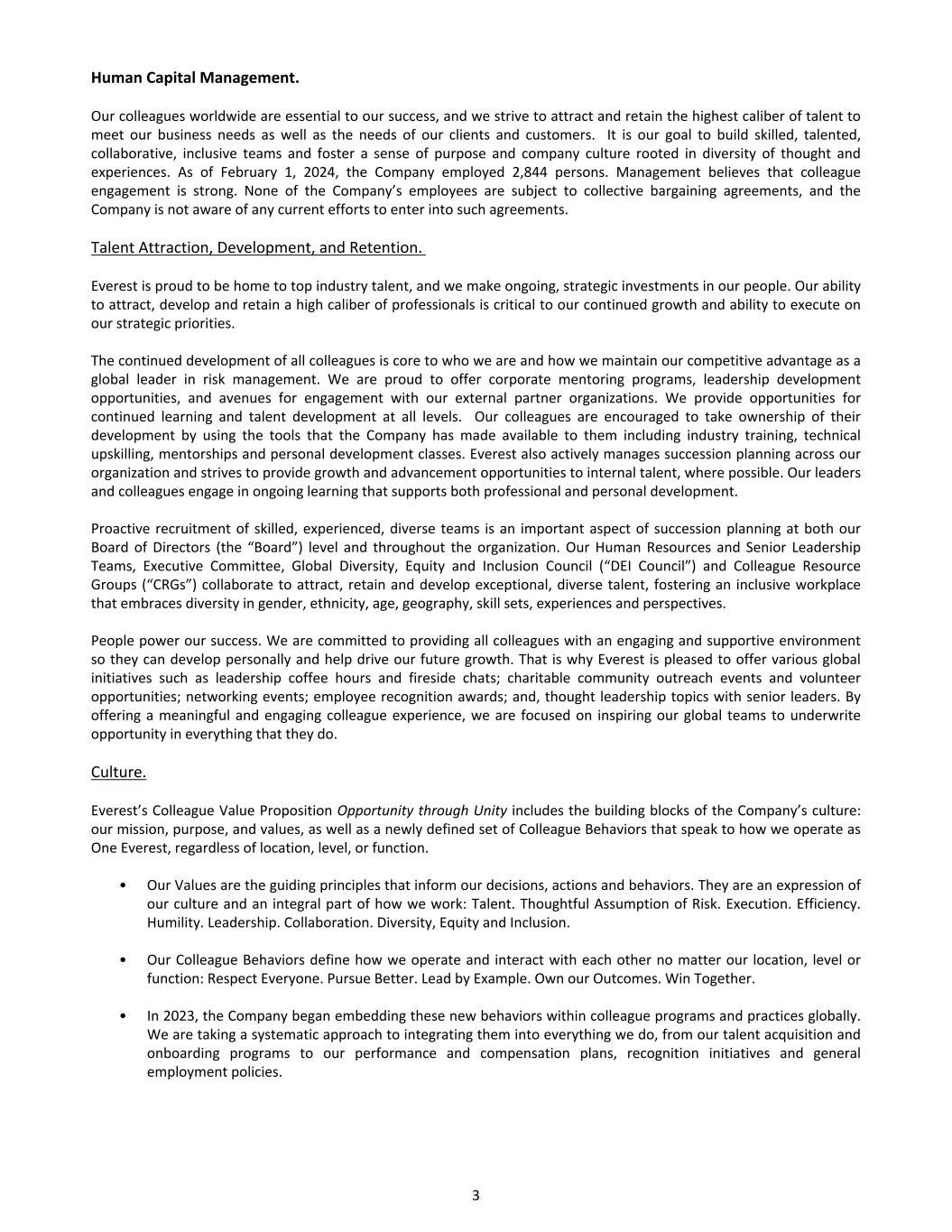
Human Capital Management. Our colleagues worldwide are essential to our success, and we strive to attract and retain the highest caliber of talent to meet our business needs as well as the needs of our clients and customers. It is our goal to build skilled, talented, collaborative, inclusive teams and foster a sense of purpose and company culture rooted in diversity of thought and experiences. As of February 1, 2024, the Company employed 2,844 persons. Management believes that colleague engagement is strong. None of the Company’s employees are subject to collective bargaining agreements, and the Company is not aware of any current efforts to enter into such agreements. Talent Attraction, Development, and Retention. Everest is proud to be home to top industry talent, and we make ongoing, strategic investments in our people. Our ability to attract, develop and retain a high caliber of professionals is critical to our continued growth and ability to execute on our strategic priorities. The continued development of all colleagues is core to who we are and how we maintain our competitive advantage as a global leader in risk management. We are proud to offer corporate mentoring programs, leadership development opportunities, and avenues for engagement with our external partner organizations. We provide opportunities for continued learning and talent development at all levels. Our colleagues are encouraged to take ownership of their development by using the tools that the Company has made available to them including industry training, technical upskilling, mentorships and personal development classes. Everest also actively manages succession planning across our organization and strives to provide growth and advancement opportunities to internal talent, where possible. Our leaders and colleagues engage in ongoing learning that supports both professional and personal development. Proactive recruitment of skilled, experienced, diverse teams is an important aspect of succession planning at both our Board of Directors (the “Board”) level and throughout the organization. Our Human Resources and Senior Leadership Teams, Executive Committee, Global Diversity, Equity and Inclusion Council (“DEI Council”) and Colleague Resource Groups (“CRGs”) collaborate to attract, retain and develop exceptional, diverse talent, fostering an inclusive workplace that embraces diversity in gender, ethnicity, age, geography, skill sets, experiences and perspectives. People power our success. We are committed to providing all colleagues with an engaging and supportive environment so they can develop personally and help drive our future growth. That is why Everest is pleased to offer various global initiatives such as leadership coffee hours and fireside chats; charitable community outreach events and volunteer opportunities; networking events; employee recognition awards; and, thought leadership topics with senior leaders. By offering a meaningful and engaging colleague experience, we are focused on inspiring our global teams to underwrite opportunity in everything that they do. Culture. Everest’s Colleague Value Proposition Opportunity through Unity includes the building blocks of the Company’s culture: our mission, purpose, and values, as well as a newly defined set of Colleague Behaviors that speak to how we operate as One Everest, regardless of location, level, or function. • Our Values are the guiding principles that inform our decisions, actions and behaviors. They are an expression of our culture and an integral part of how we work: Talent. Thoughtful Assumption of Risk. Execution. Efficiency. Humility. Leadership. Collaboration. Diversity, Equity and Inclusion. • Our Colleague Behaviors define how we operate and interact with each other no matter our location, level or function: Respect Everyone. Pursue Better. Lead by Example. Own our Outcomes. Win Together. • In 2023, the Company began embedding these new behaviors within colleague programs and practices globally. We are taking a systematic approach to integrating them into everything we do, from our talent acquisition and onboarding programs to our performance and compensation plans, recognition initiatives and general employment policies. 3
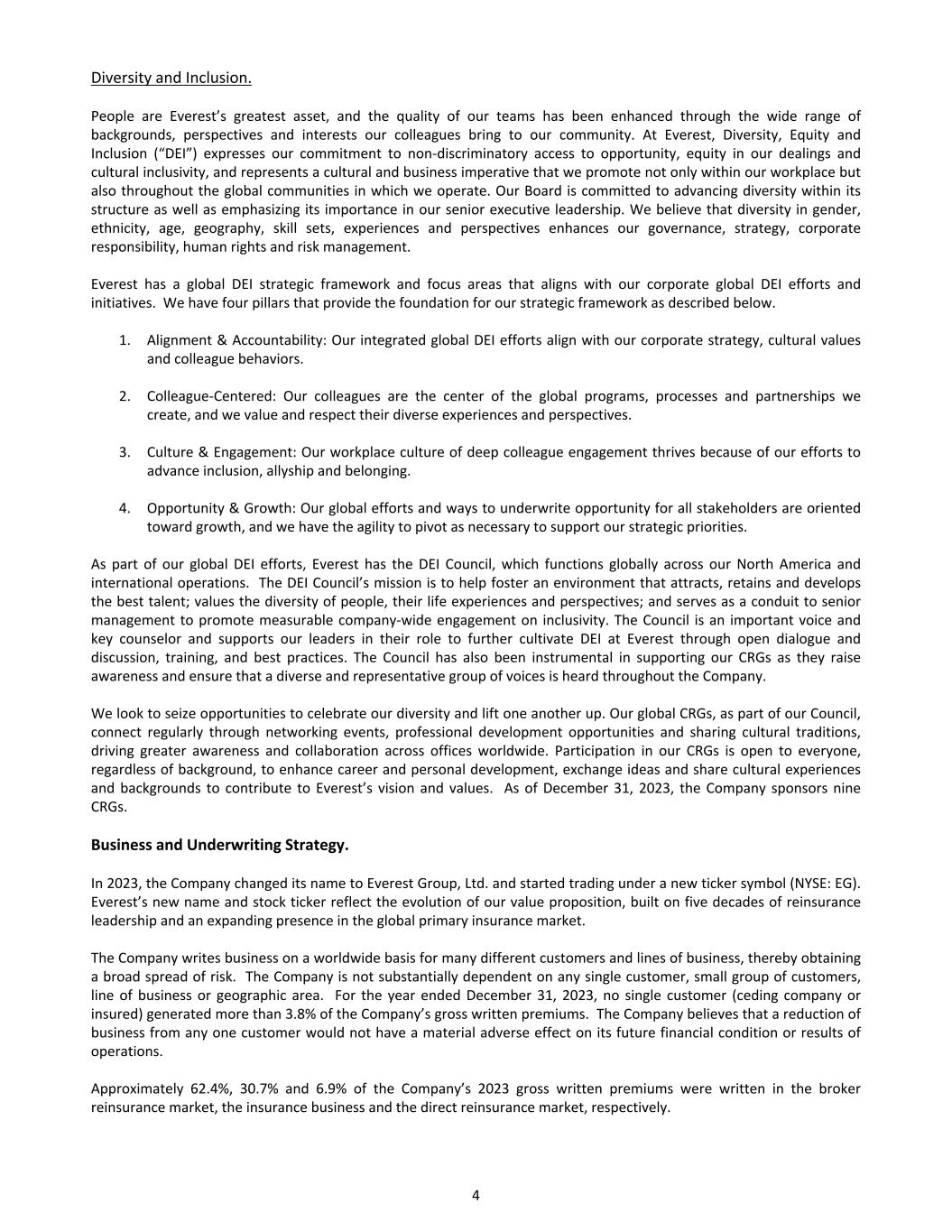
Diversity and Inclusion. People are Everest’s greatest asset, and the quality of our teams has been enhanced through the wide range of backgrounds, perspectives and interests our colleagues bring to our community. At Everest, Diversity, Equity and Inclusion (“DEI”) expresses our commitment to non-discriminatory access to opportunity, equity in our dealings and cultural inclusivity, and represents a cultural and business imperative that we promote not only within our workplace but also throughout the global communities in which we operate. Our Board is committed to advancing diversity within its structure as well as emphasizing its importance in our senior executive leadership. We believe that diversity in gender, ethnicity, age, geography, skill sets, experiences and perspectives enhances our governance, strategy, corporate responsibility, human rights and risk management. Everest has a global DEI strategic framework and focus areas that aligns with our corporate global DEI efforts and initiatives. We have four pillars that provide the foundation for our strategic framework as described below. 1. Alignment & Accountability: Our integrated global DEI efforts align with our corporate strategy, cultural values and colleague behaviors. 2. Colleague-Centered: Our colleagues are the center of the global programs, processes and partnerships we create, and we value and respect their diverse experiences and perspectives. 3. Culture & Engagement: Our workplace culture of deep colleague engagement thrives because of our efforts to advance inclusion, allyship and belonging. 4. Opportunity & Growth: Our global efforts and ways to underwrite opportunity for all stakeholders are oriented toward growth, and we have the agility to pivot as necessary to support our strategic priorities. As part of our global DEI efforts, Everest has the DEI Council, which functions globally across our North America and international operations. The DEI Council’s mission is to help foster an environment that attracts, retains and develops the best talent; values the diversity of people, their life experiences and perspectives; and serves as a conduit to senior management to promote measurable company-wide engagement on inclusivity. The Council is an important voice and key counselor and supports our leaders in their role to further cultivate DEI at Everest through open dialogue and discussion, training, and best practices. The Council has also been instrumental in supporting our CRGs as they raise awareness and ensure that a diverse and representative group of voices is heard throughout the Company. We look to seize opportunities to celebrate our diversity and lift one another up. Our global CRGs, as part of our Council, connect regularly through networking events, professional development opportunities and sharing cultural traditions, driving greater awareness and collaboration across offices worldwide. Participation in our CRGs is open to everyone, regardless of background, to enhance career and personal development, exchange ideas and share cultural experiences and backgrounds to contribute to Everest’s vision and values. As of December 31, 2023, the Company sponsors nine CRGs. Business and Underwriting Strategy. In 2023, the Company changed its name to Everest Group, Ltd. and started trading under a new ticker symbol (NYSE: EG). Everest’s new name and stock ticker reflect the evolution of our value proposition, built on five decades of reinsurance leadership and an expanding presence in the global primary insurance market. The Company writes business on a worldwide basis for many different customers and lines of business, thereby obtaining a broad spread of risk. The Company is not substantially dependent on any single customer, small group of customers, line of business or geographic area. For the year ended December 31, 2023, no single customer (ceding company or insured) generated more than 3.8% of the Company’s gross written premiums. The Company believes that a reduction of business from any one customer would not have a material adverse effect on its future financial condition or results of operations. Approximately 62.4%, 30.7% and 6.9% of the Company’s 2023 gross written premiums were written in the broker reinsurance market, the insurance business and the direct reinsurance market, respectively. 4
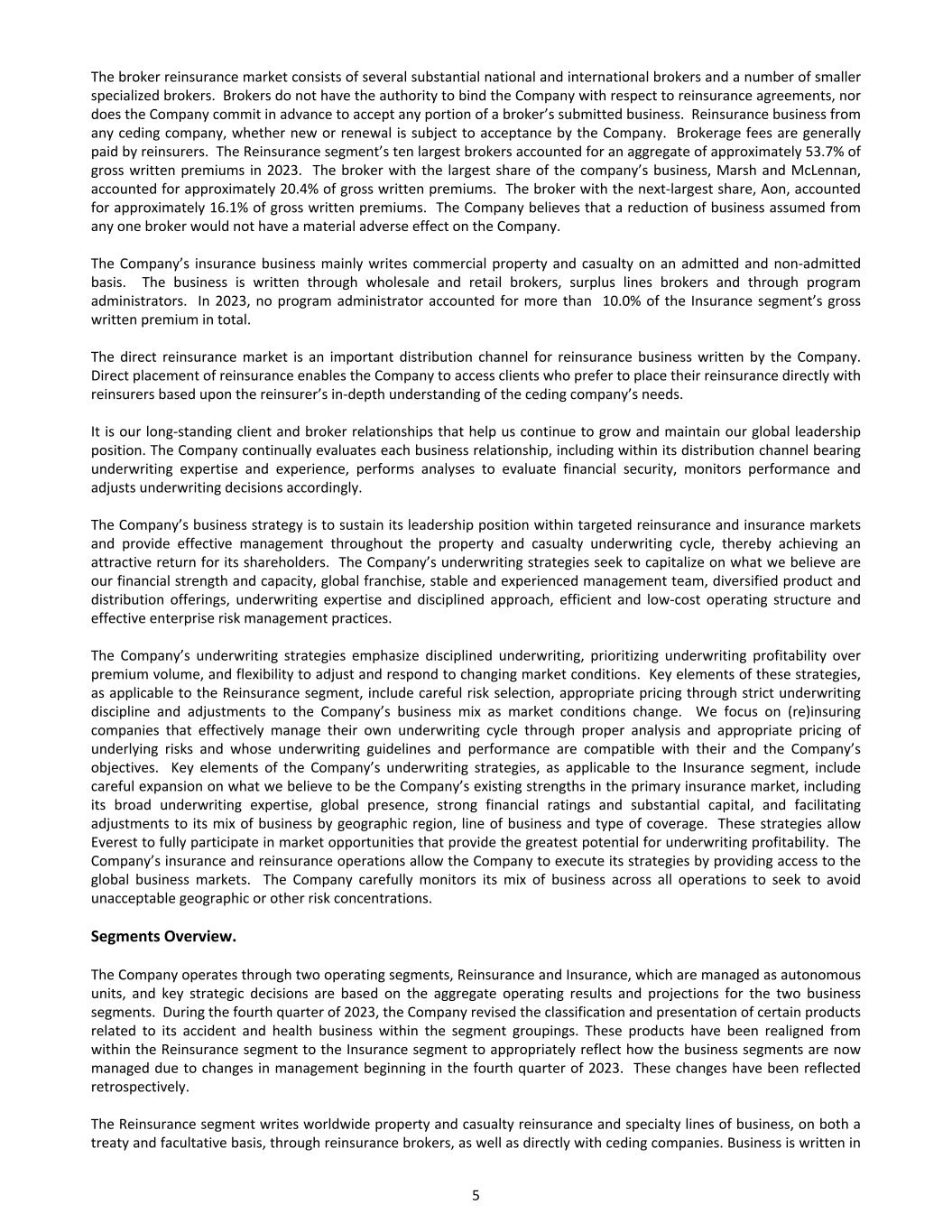
The broker reinsurance market consists of several substantial national and international brokers and a number of smaller specialized brokers. Brokers do not have the authority to bind the Company with respect to reinsurance agreements, nor does the Company commit in advance to accept any portion of a broker’s submitted business. Reinsurance business from any ceding company, whether new or renewal is subject to acceptance by the Company. Brokerage fees are generally paid by reinsurers. The Reinsurance segment’s ten largest brokers accounted for an aggregate of approximately 53.7% of gross written premiums in 2023. The broker with the largest share of the company’s business, Marsh and McLennan, accounted for approximately 20.4% of gross written premiums. The broker with the next-largest share, Aon, accounted for approximately 16.1% of gross written premiums. The Company believes that a reduction of business assumed from any one broker would not have a material adverse effect on the Company. The Company’s insurance business mainly writes commercial property and casualty on an admitted and non-admitted basis. The business is written through wholesale and retail brokers, surplus lines brokers and through program administrators. In 2023, no program administrator accounted for more than 10.0% of the Insurance segment’s gross written premium in total. The direct reinsurance market is an important distribution channel for reinsurance business written by the Company. Direct placement of reinsurance enables the Company to access clients who prefer to place their reinsurance directly with reinsurers based upon the reinsurer’s in-depth understanding of the ceding company’s needs. It is our long-standing client and broker relationships that help us continue to grow and maintain our global leadership position. The Company continually evaluates each business relationship, including within its distribution channel bearing underwriting expertise and experience, performs analyses to evaluate financial security, monitors performance and adjusts underwriting decisions accordingly. The Company’s business strategy is to sustain its leadership position within targeted reinsurance and insurance markets and provide effective management throughout the property and casualty underwriting cycle, thereby achieving an attractive return for its shareholders. The Company’s underwriting strategies seek to capitalize on what we believe are our financial strength and capacity, global franchise, stable and experienced management team, diversified product and distribution offerings, underwriting expertise and disciplined approach, efficient and low-cost operating structure and effective enterprise risk management practices. The Company’s underwriting strategies emphasize disciplined underwriting, prioritizing underwriting profitability over premium volume, and flexibility to adjust and respond to changing market conditions. Key elements of these strategies, as applicable to the Reinsurance segment, include careful risk selection, appropriate pricing through strict underwriting discipline and adjustments to the Company’s business mix as market conditions change. We focus on (re)insuring companies that effectively manage their own underwriting cycle through proper analysis and appropriate pricing of underlying risks and whose underwriting guidelines and performance are compatible with their and the Company’s objectives. Key elements of the Company’s underwriting strategies, as applicable to the Insurance segment, include careful expansion on what we believe to be the Company’s existing strengths in the primary insurance market, including its broad underwriting expertise, global presence, strong financial ratings and substantial capital, and facilitating adjustments to its mix of business by geographic region, line of business and type of coverage. These strategies allow Everest to fully participate in market opportunities that provide the greatest potential for underwriting profitability. The Company’s insurance and reinsurance operations allow the Company to execute its strategies by providing access to the global business markets. The Company carefully monitors its mix of business across all operations to seek to avoid unacceptable geographic or other risk concentrations. Segments Overview. The Company operates through two operating segments, Reinsurance and Insurance, which are managed as autonomous units, and key strategic decisions are based on the aggregate operating results and projections for the two business segments. During the fourth quarter of 2023, the Company revised the classification and presentation of certain products related to its accident and health business within the segment groupings. These products have been realigned from within the Reinsurance segment to the Insurance segment to appropriately reflect how the business segments are now managed due to changes in management beginning in the fourth quarter of 2023. These changes have been reflected retrospectively. The Reinsurance segment writes worldwide property and casualty reinsurance and specialty lines of business, on both a treaty and facultative basis, through reinsurance brokers, as well as directly with ceding companies. Business is written in 5
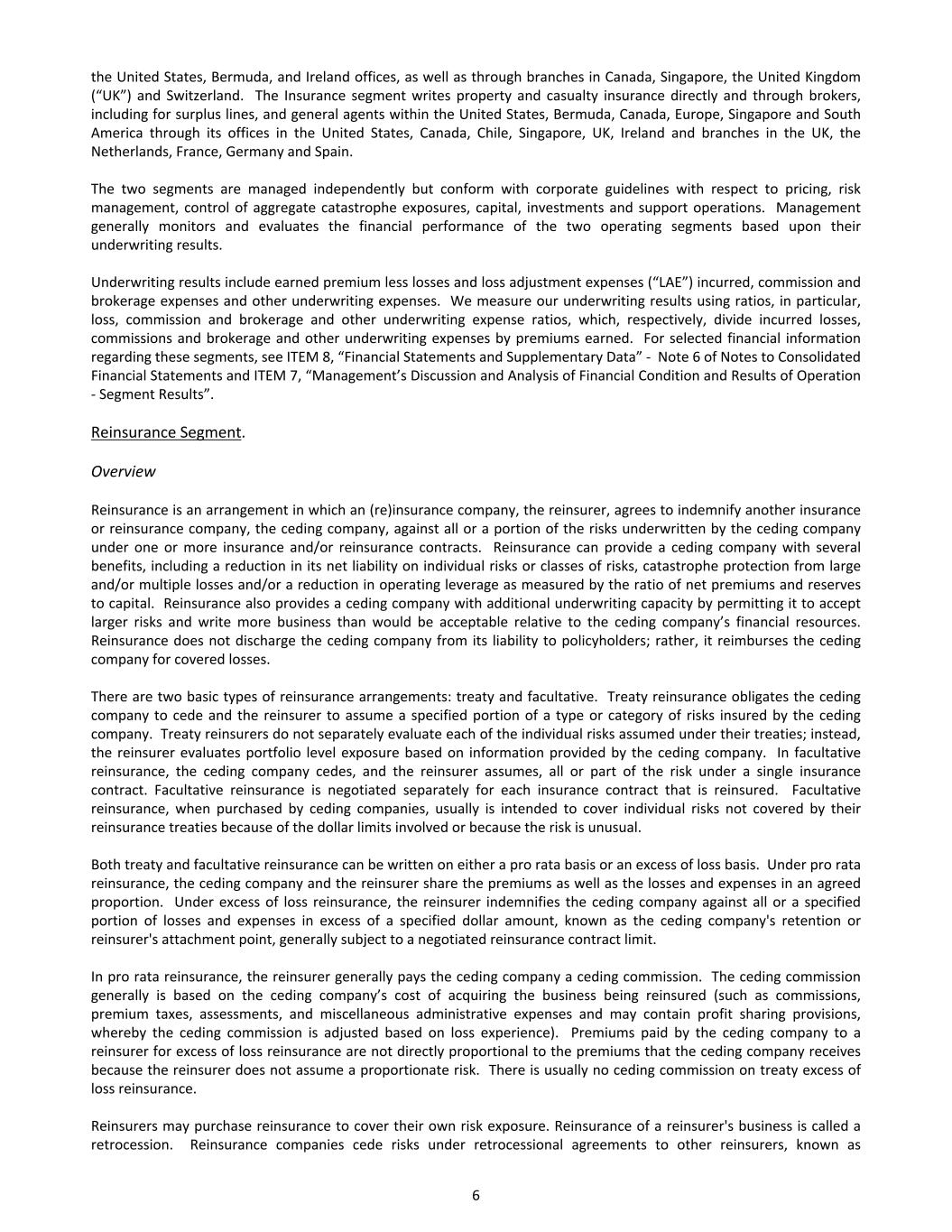
the United States, Bermuda, and Ireland offices, as well as through branches in Canada, Singapore, the United Kingdom (“UK”) and Switzerland. The Insurance segment writes property and casualty insurance directly and through brokers, including for surplus lines, and general agents within the United States, Bermuda, Canada, Europe, Singapore and South America through its offices in the United States, Canada, Chile, Singapore, UK, Ireland and branches in the UK, the Netherlands, France, Germany and Spain. The two segments are managed independently but conform with corporate guidelines with respect to pricing, risk management, control of aggregate catastrophe exposures, capital, investments and support operations. Management generally monitors and evaluates the financial performance of the two operating segments based upon their underwriting results. Underwriting results include earned premium less losses and loss adjustment expenses (“LAE”) incurred, commission and brokerage expenses and other underwriting expenses. We measure our underwriting results using ratios, in particular, loss, commission and brokerage and other underwriting expense ratios, which, respectively, divide incurred losses, commissions and brokerage and other underwriting expenses by premiums earned. For selected financial information regarding these segments, see ITEM 8, “Financial Statements and Supplementary Data” - Note 6 of Notes to Consolidated Financial Statements and ITEM 7, “Management’s Discussion and Analysis of Financial Condition and Results of Operation - Segment Results”. Reinsurance Segment. Overview Reinsurance is an arrangement in which an (re)insurance company, the reinsurer, agrees to indemnify another insurance or reinsurance company, the ceding company, against all or a portion of the risks underwritten by the ceding company under one or more insurance and/or reinsurance contracts. Reinsurance can provide a ceding company with several benefits, including a reduction in its net liability on individual risks or classes of risks, catastrophe protection from large and/or multiple losses and/or a reduction in operating leverage as measured by the ratio of net premiums and reserves to capital. Reinsurance also provides a ceding company with additional underwriting capacity by permitting it to accept larger risks and write more business than would be acceptable relative to the ceding company’s financial resources. Reinsurance does not discharge the ceding company from its liability to policyholders; rather, it reimburses the ceding company for covered losses. There are two basic types of reinsurance arrangements: treaty and facultative. Treaty reinsurance obligates the ceding company to cede and the reinsurer to assume a specified portion of a type or category of risks insured by the ceding company. Treaty reinsurers do not separately evaluate each of the individual risks assumed under their treaties; instead, the reinsurer evaluates portfolio level exposure based on information provided by the ceding company. In facultative reinsurance, the ceding company cedes, and the reinsurer assumes, all or part of the risk under a single insurance contract. Facultative reinsurance is negotiated separately for each insurance contract that is reinsured. Facultative reinsurance, when purchased by ceding companies, usually is intended to cover individual risks not covered by their reinsurance treaties because of the dollar limits involved or because the risk is unusual. Both treaty and facultative reinsurance can be written on either a pro rata basis or an excess of loss basis. Under pro rata reinsurance, the ceding company and the reinsurer share the premiums as well as the losses and expenses in an agreed proportion. Under excess of loss reinsurance, the reinsurer indemnifies the ceding company against all or a specified portion of losses and expenses in excess of a specified dollar amount, known as the ceding company's retention or reinsurer's attachment point, generally subject to a negotiated reinsurance contract limit. In pro rata reinsurance, the reinsurer generally pays the ceding company a ceding commission. The ceding commission generally is based on the ceding company’s cost of acquiring the business being reinsured (such as commissions, premium taxes, assessments, and miscellaneous administrative expenses and may contain profit sharing provisions, whereby the ceding commission is adjusted based on loss experience). Premiums paid by the ceding company to a reinsurer for excess of loss reinsurance are not directly proportional to the premiums that the ceding company receives because the reinsurer does not assume a proportionate risk. There is usually no ceding commission on treaty excess of loss reinsurance. Reinsurers may purchase reinsurance to cover their own risk exposure. Reinsurance of a reinsurer's business is called a retrocession. Reinsurance companies cede risks under retrocessional agreements to other reinsurers, known as 6
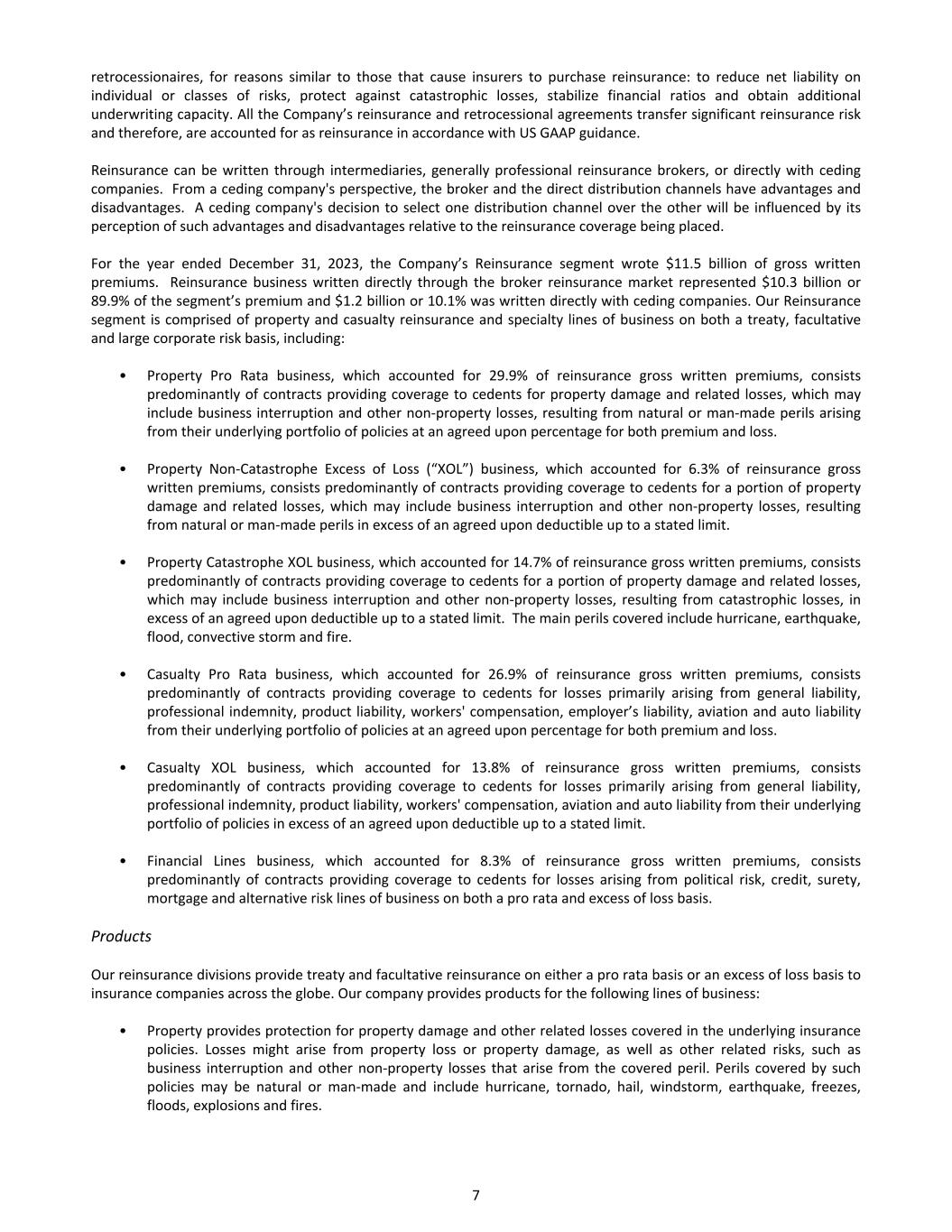
retrocessionaires, for reasons similar to those that cause insurers to purchase reinsurance: to reduce net liability on individual or classes of risks, protect against catastrophic losses, stabilize financial ratios and obtain additional underwriting capacity. All the Company’s reinsurance and retrocessional agreements transfer significant reinsurance risk and therefore, are accounted for as reinsurance in accordance with US GAAP guidance. Reinsurance can be written through intermediaries, generally professional reinsurance brokers, or directly with ceding companies. From a ceding company's perspective, the broker and the direct distribution channels have advantages and disadvantages. A ceding company's decision to select one distribution channel over the other will be influenced by its perception of such advantages and disadvantages relative to the reinsurance coverage being placed. For the year ended December 31, 2023, the Company’s Reinsurance segment wrote $11.5 billion of gross written premiums. Reinsurance business written directly through the broker reinsurance market represented $10.3 billion or 89.9% of the segment’s premium and $1.2 billion or 10.1% was written directly with ceding companies. Our Reinsurance segment is comprised of property and casualty reinsurance and specialty lines of business on both a treaty, facultative and large corporate risk basis, including: • Property Pro Rata business, which accounted for 29.9% of reinsurance gross written premiums, consists predominantly of contracts providing coverage to cedents for property damage and related losses, which may include business interruption and other non-property losses, resulting from natural or man-made perils arising from their underlying portfolio of policies at an agreed upon percentage for both premium and loss. • Property Non-Catastrophe Excess of Loss (“XOL”) business, which accounted for 6.3% of reinsurance gross written premiums, consists predominantly of contracts providing coverage to cedents for a portion of property damage and related losses, which may include business interruption and other non-property losses, resulting from natural or man-made perils in excess of an agreed upon deductible up to a stated limit. • Property Catastrophe XOL business, which accounted for 14.7% of reinsurance gross written premiums, consists predominantly of contracts providing coverage to cedents for a portion of property damage and related losses, which may include business interruption and other non-property losses, resulting from catastrophic losses, in excess of an agreed upon deductible up to a stated limit. The main perils covered include hurricane, earthquake, flood, convective storm and fire. • Casualty Pro Rata business, which accounted for 26.9% of reinsurance gross written premiums, consists predominantly of contracts providing coverage to cedents for losses primarily arising from general liability, professional indemnity, product liability, workers' compensation, employer’s liability, aviation and auto liability from their underlying portfolio of policies at an agreed upon percentage for both premium and loss. • Casualty XOL business, which accounted for 13.8% of reinsurance gross written premiums, consists predominantly of contracts providing coverage to cedents for losses primarily arising from general liability, professional indemnity, product liability, workers' compensation, aviation and auto liability from their underlying portfolio of policies in excess of an agreed upon deductible up to a stated limit. • Financial Lines business, which accounted for 8.3% of reinsurance gross written premiums, consists predominantly of contracts providing coverage to cedents for losses arising from political risk, credit, surety, mortgage and alternative risk lines of business on both a pro rata and excess of loss basis. Products Our reinsurance divisions provide treaty and facultative reinsurance on either a pro rata basis or an excess of loss basis to insurance companies across the globe. Our company provides products for the following lines of business: • Property provides protection for property damage and other related losses covered in the underlying insurance policies. Losses might arise from property loss or property damage, as well as other related risks, such as business interruption and other non-property losses that arise from the covered peril. Perils covered by such policies may be natural or man-made and include hurricane, tornado, hail, windstorm, earthquake, freezes, floods, explosions and fires. 7
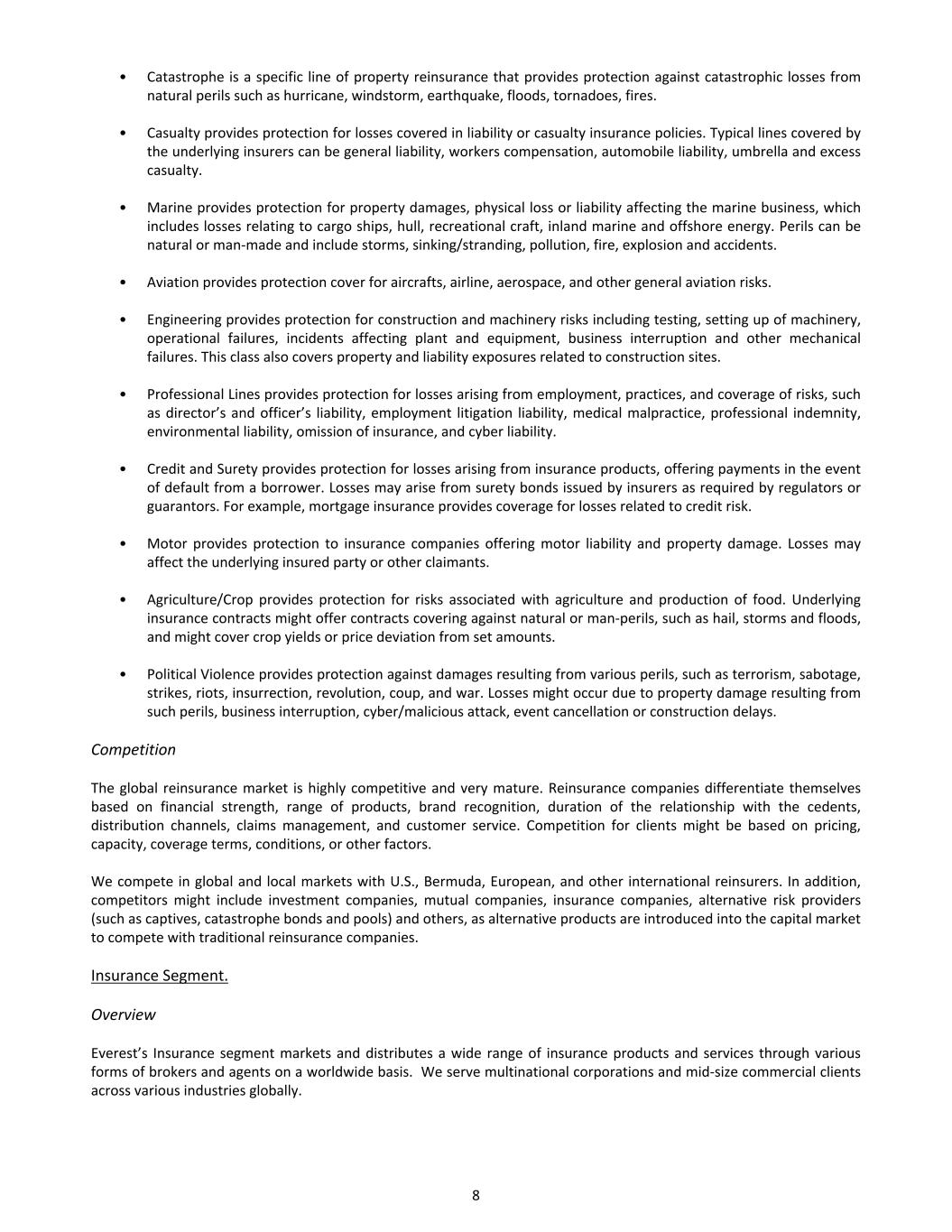
• Catastrophe is a specific line of property reinsurance that provides protection against catastrophic losses from natural perils such as hurricane, windstorm, earthquake, floods, tornadoes, fires. • Casualty provides protection for losses covered in liability or casualty insurance policies. Typical lines covered by the underlying insurers can be general liability, workers compensation, automobile liability, umbrella and excess casualty. • Marine provides protection for property damages, physical loss or liability affecting the marine business, which includes losses relating to cargo ships, hull, recreational craft, inland marine and offshore energy. Perils can be natural or man-made and include storms, sinking/stranding, pollution, fire, explosion and accidents. • Aviation provides protection cover for aircrafts, airline, aerospace, and other general aviation risks. • Engineering provides protection for construction and machinery risks including testing, setting up of machinery, operational failures, incidents affecting plant and equipment, business interruption and other mechanical failures. This class also covers property and liability exposures related to construction sites. • Professional Lines provides protection for losses arising from employment, practices, and coverage of risks, such as director’s and officer’s liability, employment litigation liability, medical malpractice, professional indemnity, environmental liability, omission of insurance, and cyber liability. • Credit and Surety provides protection for losses arising from insurance products, offering payments in the event of default from a borrower. Losses may arise from surety bonds issued by insurers as required by regulators or guarantors. For example, mortgage insurance provides coverage for losses related to credit risk. • Motor provides protection to insurance companies offering motor liability and property damage. Losses may affect the underlying insured party or other claimants. • Agriculture/Crop provides protection for risks associated with agriculture and production of food. Underlying insurance contracts might offer contracts covering against natural or man-perils, such as hail, storms and floods, and might cover crop yields or price deviation from set amounts. • Political Violence provides protection against damages resulting from various perils, such as terrorism, sabotage, strikes, riots, insurrection, revolution, coup, and war. Losses might occur due to property damage resulting from such perils, business interruption, cyber/malicious attack, event cancellation or construction delays. Competition The global reinsurance market is highly competitive and very mature. Reinsurance companies differentiate themselves based on financial strength, range of products, brand recognition, duration of the relationship with the cedents, distribution channels, claims management, and customer service. Competition for clients might be based on pricing, capacity, coverage terms, conditions, or other factors. We compete in global and local markets with U.S., Bermuda, European, and other international reinsurers. In addition, competitors might include investment companies, mutual companies, insurance companies, alternative risk providers (such as captives, catastrophe bonds and pools) and others, as alternative products are introduced into the capital market to compete with traditional reinsurance companies. Insurance Segment. Overview Everest’s Insurance segment markets and distributes a wide range of insurance products and services through various forms of brokers and agents on a worldwide basis. We serve multinational corporations and mid-size commercial clients across various industries globally. 8
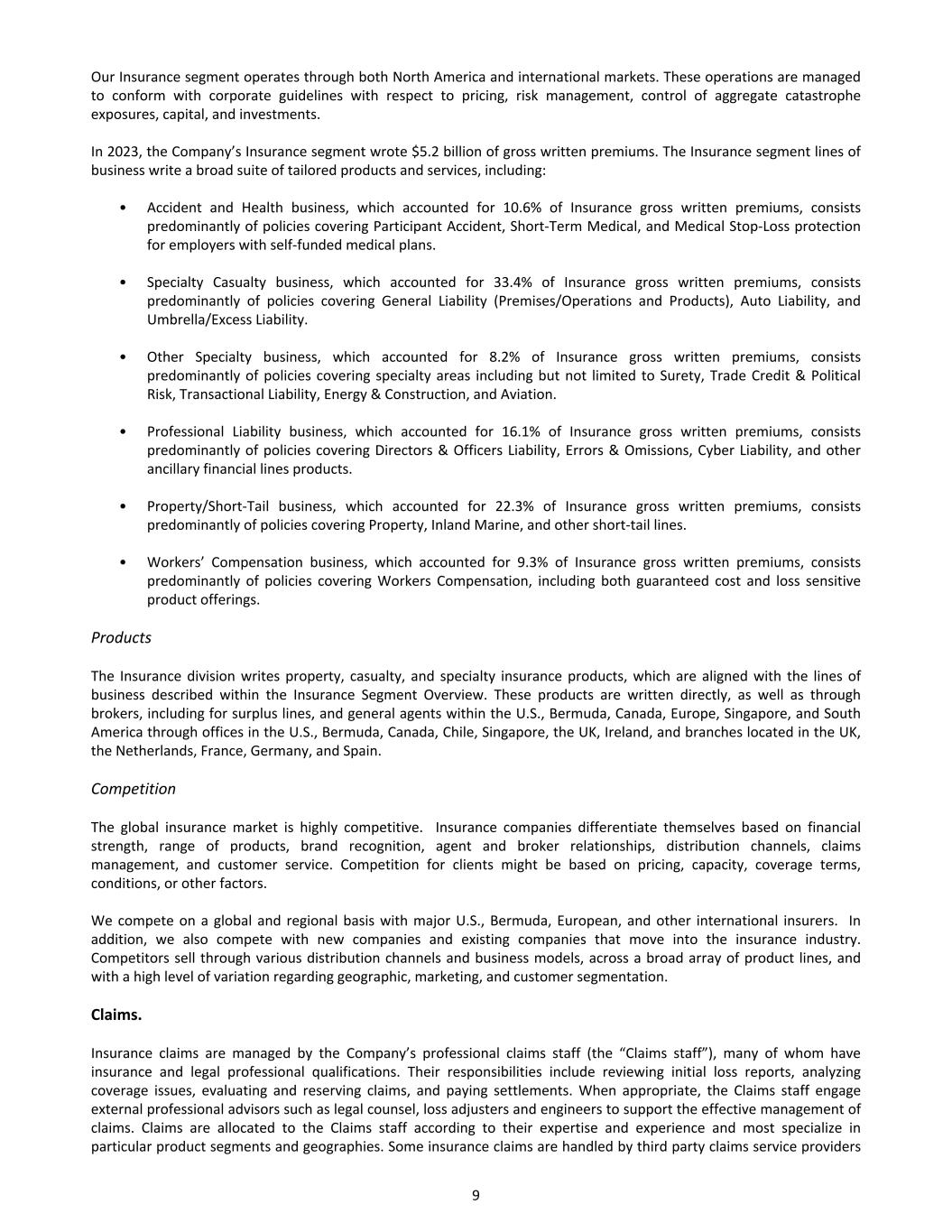
Our Insurance segment operates through both North America and international markets. These operations are managed to conform with corporate guidelines with respect to pricing, risk management, control of aggregate catastrophe exposures, capital, and investments. In 2023, the Company’s Insurance segment wrote $5.2 billion of gross written premiums. The Insurance segment lines of business write a broad suite of tailored products and services, including: • Accident and Health business, which accounted for 10.6% of Insurance gross written premiums, consists predominantly of policies covering Participant Accident, Short-Term Medical, and Medical Stop-Loss protection for employers with self-funded medical plans. • Specialty Casualty business, which accounted for 33.4% of Insurance gross written premiums, consists predominantly of policies covering General Liability (Premises/Operations and Products), Auto Liability, and Umbrella/Excess Liability. • Other Specialty business, which accounted for 8.2% of Insurance gross written premiums, consists predominantly of policies covering specialty areas including but not limited to Surety, Trade Credit & Political Risk, Transactional Liability, Energy & Construction, and Aviation. • Professional Liability business, which accounted for 16.1% of Insurance gross written premiums, consists predominantly of policies covering Directors & Officers Liability, Errors & Omissions, Cyber Liability, and other ancillary financial lines products. • Property/Short-Tail business, which accounted for 22.3% of Insurance gross written premiums, consists predominantly of policies covering Property, Inland Marine, and other short-tail lines. • Workers’ Compensation business, which accounted for 9.3% of Insurance gross written premiums, consists predominantly of policies covering Workers Compensation, including both guaranteed cost and loss sensitive product offerings. Products The Insurance division writes property, casualty, and specialty insurance products, which are aligned with the lines of business described within the Insurance Segment Overview. These products are written directly, as well as through brokers, including for surplus lines, and general agents within the U.S., Bermuda, Canada, Europe, Singapore, and South America through offices in the U.S., Bermuda, Canada, Chile, Singapore, the UK, Ireland, and branches located in the UK, the Netherlands, France, Germany, and Spain. Competition The global insurance market is highly competitive. Insurance companies differentiate themselves based on financial strength, range of products, brand recognition, agent and broker relationships, distribution channels, claims management, and customer service. Competition for clients might be based on pricing, capacity, coverage terms, conditions, or other factors. We compete on a global and regional basis with major U.S., Bermuda, European, and other international insurers. In addition, we also compete with new companies and existing companies that move into the insurance industry. Competitors sell through various distribution channels and business models, across a broad array of product lines, and with a high level of variation regarding geographic, marketing, and customer segmentation. Claims. Insurance claims are managed by the Company’s professional claims staff (the “Claims staff”), many of whom have insurance and legal professional qualifications. Their responsibilities include reviewing initial loss reports, analyzing coverage issues, evaluating and reserving claims, and paying settlements. When appropriate, the Claims staff engage external professional advisors such as legal counsel, loss adjusters and engineers to support the effective management of claims. Claims are allocated to the Claims staff according to their expertise and experience and most specialize in particular product segments and geographies. Some insurance claims are handled by third party claims service providers 9
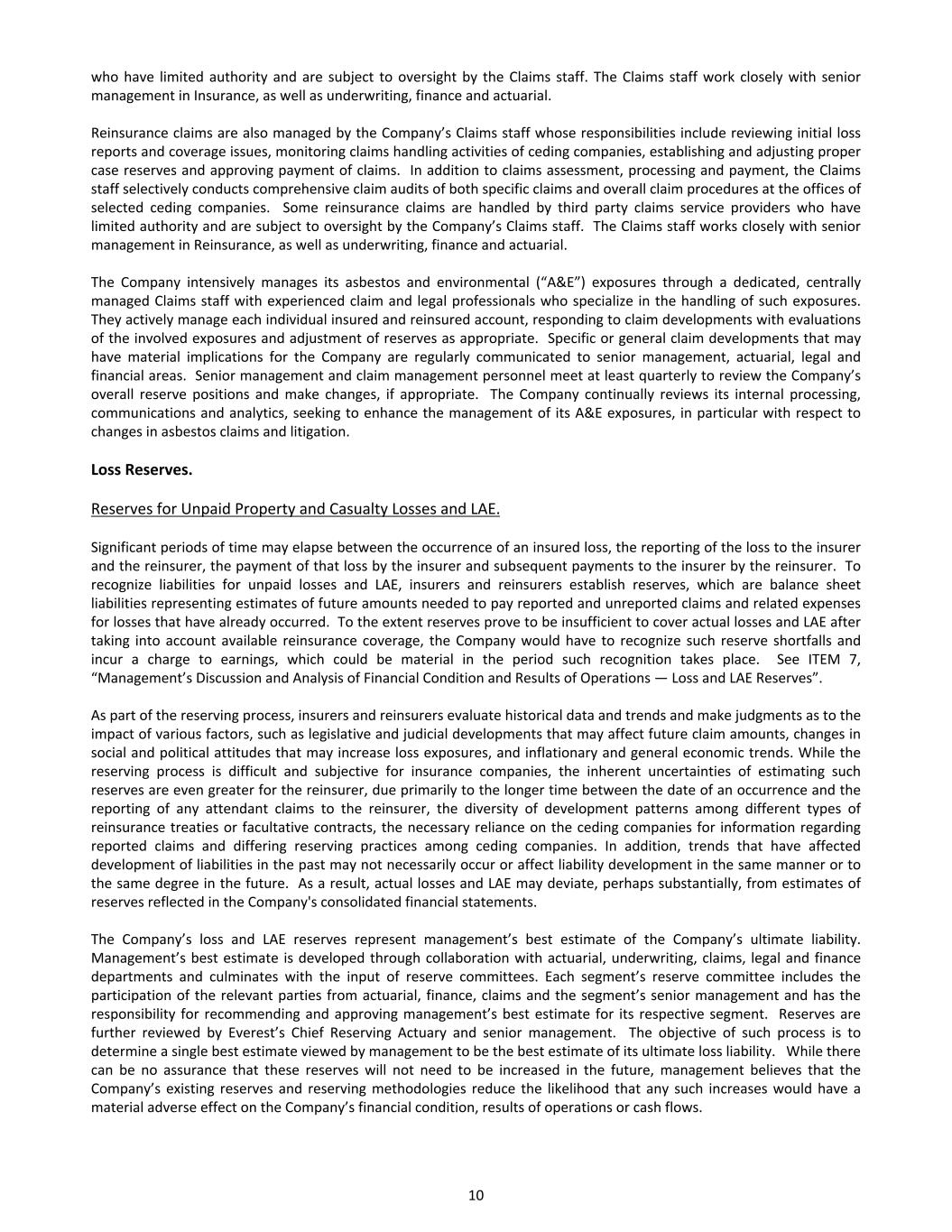
who have limited authority and are subject to oversight by the Claims staff. The Claims staff work closely with senior management in Insurance, as well as underwriting, finance and actuarial. Reinsurance claims are also managed by the Company’s Claims staff whose responsibilities include reviewing initial loss reports and coverage issues, monitoring claims handling activities of ceding companies, establishing and adjusting proper case reserves and approving payment of claims. In addition to claims assessment, processing and payment, the Claims staff selectively conducts comprehensive claim audits of both specific claims and overall claim procedures at the offices of selected ceding companies. Some reinsurance claims are handled by third party claims service providers who have limited authority and are subject to oversight by the Company’s Claims staff. The Claims staff works closely with senior management in Reinsurance, as well as underwriting, finance and actuarial. The Company intensively manages its asbestos and environmental (“A&E”) exposures through a dedicated, centrally managed Claims staff with experienced claim and legal professionals who specialize in the handling of such exposures. They actively manage each individual insured and reinsured account, responding to claim developments with evaluations of the involved exposures and adjustment of reserves as appropriate. Specific or general claim developments that may have material implications for the Company are regularly communicated to senior management, actuarial, legal and financial areas. Senior management and claim management personnel meet at least quarterly to review the Company’s overall reserve positions and make changes, if appropriate. The Company continually reviews its internal processing, communications and analytics, seeking to enhance the management of its A&E exposures, in particular with respect to changes in asbestos claims and litigation. Loss Reserves. Reserves for Unpaid Property and Casualty Losses and LAE. Significant periods of time may elapse between the occurrence of an insured loss, the reporting of the loss to the insurer and the reinsurer, the payment of that loss by the insurer and subsequent payments to the insurer by the reinsurer. To recognize liabilities for unpaid losses and LAE, insurers and reinsurers establish reserves, which are balance sheet liabilities representing estimates of future amounts needed to pay reported and unreported claims and related expenses for losses that have already occurred. To the extent reserves prove to be insufficient to cover actual losses and LAE after taking into account available reinsurance coverage, the Company would have to recognize such reserve shortfalls and incur a charge to earnings, which could be material in the period such recognition takes place. See ITEM 7, “Management’s Discussion and Analysis of Financial Condition and Results of Operations — Loss and LAE Reserves”. As part of the reserving process, insurers and reinsurers evaluate historical data and trends and make judgments as to the impact of various factors, such as legislative and judicial developments that may affect future claim amounts, changes in social and political attitudes that may increase loss exposures, and inflationary and general economic trends. While the reserving process is difficult and subjective for insurance companies, the inherent uncertainties of estimating such reserves are even greater for the reinsurer, due primarily to the longer time between the date of an occurrence and the reporting of any attendant claims to the reinsurer, the diversity of development patterns among different types of reinsurance treaties or facultative contracts, the necessary reliance on the ceding companies for information regarding reported claims and differing reserving practices among ceding companies. In addition, trends that have affected development of liabilities in the past may not necessarily occur or affect liability development in the same manner or to the same degree in the future. As a result, actual losses and LAE may deviate, perhaps substantially, from estimates of reserves reflected in the Company's consolidated financial statements. The Company’s loss and LAE reserves represent management’s best estimate of the Company’s ultimate liability. Management’s best estimate is developed through collaboration with actuarial, underwriting, claims, legal and finance departments and culminates with the input of reserve committees. Each segment’s reserve committee includes the participation of the relevant parties from actuarial, finance, claims and the segment’s senior management and has the responsibility for recommending and approving management’s best estimate for its respective segment. Reserves are further reviewed by Everest’s Chief Reserving Actuary and senior management. The objective of such process is to determine a single best estimate viewed by management to be the best estimate of its ultimate loss liability. While there can be no assurance that these reserves will not need to be increased in the future, management believes that the Company’s existing reserves and reserving methodologies reduce the likelihood that any such increases would have a material adverse effect on the Company’s financial condition, results of operations or cash flows. 10
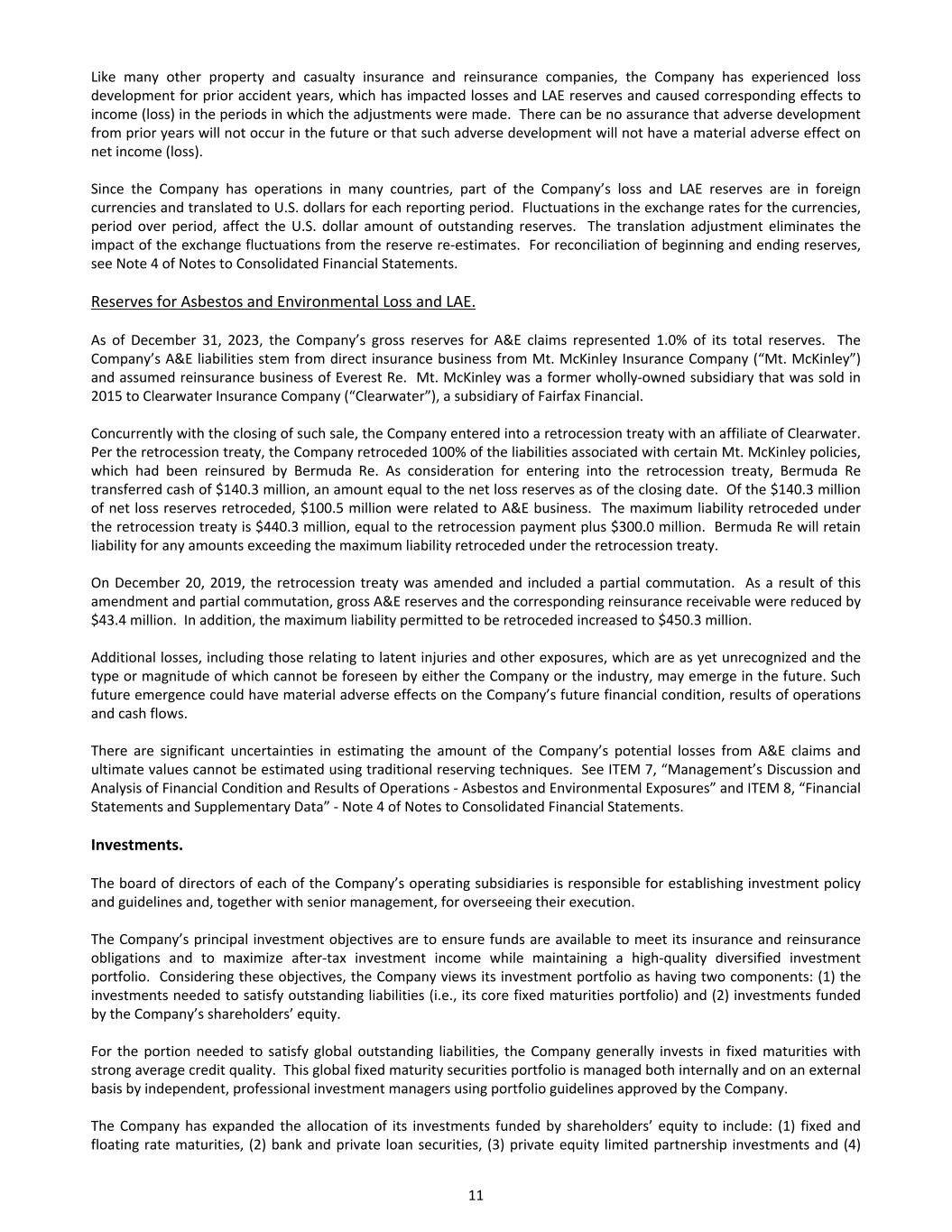
Like many other property and casualty insurance and reinsurance companies, the Company has experienced loss development for prior accident years, which has impacted losses and LAE reserves and caused corresponding effects to income (loss) in the periods in which the adjustments were made. There can be no assurance that adverse development from prior years will not occur in the future or that such adverse development will not have a material adverse effect on net income (loss). Since the Company has operations in many countries, part of the Company’s loss and LAE reserves are in foreign currencies and translated to U.S. dollars for each reporting period. Fluctuations in the exchange rates for the currencies, period over period, affect the U.S. dollar amount of outstanding reserves. The translation adjustment eliminates the impact of the exchange fluctuations from the reserve re-estimates. For reconciliation of beginning and ending reserves, see Note 4 of Notes to Consolidated Financial Statements. Reserves for Asbestos and Environmental Loss and LAE. As of December 31, 2023, the Company’s gross reserves for A&E claims represented 1.0% of its total reserves. The Company’s A&E liabilities stem from direct insurance business from Mt. McKinley Insurance Company (“Mt. McKinley”) and assumed reinsurance business of Everest Re. Mt. McKinley was a former wholly-owned subsidiary that was sold in 2015 to Clearwater Insurance Company (“Clearwater”), a subsidiary of Fairfax Financial. Concurrently with the closing of such sale, the Company entered into a retrocession treaty with an affiliate of Clearwater. Per the retrocession treaty, the Company retroceded 100% of the liabilities associated with certain Mt. McKinley policies, which had been reinsured by Bermuda Re. As consideration for entering into the retrocession treaty, Bermuda Re transferred cash of $140.3 million, an amount equal to the net loss reserves as of the closing date. Of the $140.3 million of net loss reserves retroceded, $100.5 million were related to A&E business. The maximum liability retroceded under the retrocession treaty is $440.3 million, equal to the retrocession payment plus $300.0 million. Bermuda Re will retain liability for any amounts exceeding the maximum liability retroceded under the retrocession treaty. On December 20, 2019, the retrocession treaty was amended and included a partial commutation. As a result of this amendment and partial commutation, gross A&E reserves and the corresponding reinsurance receivable were reduced by $43.4 million. In addition, the maximum liability permitted to be retroceded increased to $450.3 million. Additional losses, including those relating to latent injuries and other exposures, which are as yet unrecognized and the type or magnitude of which cannot be foreseen by either the Company or the industry, may emerge in the future. Such future emergence could have material adverse effects on the Company’s future financial condition, results of operations and cash flows. There are significant uncertainties in estimating the amount of the Company’s potential losses from A&E claims and ultimate values cannot be estimated using traditional reserving techniques. See ITEM 7, “Management’s Discussion and Analysis of Financial Condition and Results of Operations - Asbestos and Environmental Exposures” and ITEM 8, “Financial Statements and Supplementary Data” - Note 4 of Notes to Consolidated Financial Statements. Investments. The board of directors of each of the Company’s operating subsidiaries is responsible for establishing investment policy and guidelines and, together with senior management, for overseeing their execution. The Company’s principal investment objectives are to ensure funds are available to meet its insurance and reinsurance obligations and to maximize after-tax investment income while maintaining a high-quality diversified investment portfolio. Considering these objectives, the Company views its investment portfolio as having two components: (1) the investments needed to satisfy outstanding liabilities (i.e., its core fixed maturities portfolio) and (2) investments funded by the Company’s shareholders’ equity. For the portion needed to satisfy global outstanding liabilities, the Company generally invests in fixed maturities with strong average credit quality. This global fixed maturity securities portfolio is managed both internally and on an external basis by independent, professional investment managers using portfolio guidelines approved by the Company. The Company has expanded the allocation of its investments funded by shareholders’ equity to include: (1) fixed and floating rate maturities, (2) bank and private loan securities, (3) private equity limited partnership investments and (4) 11
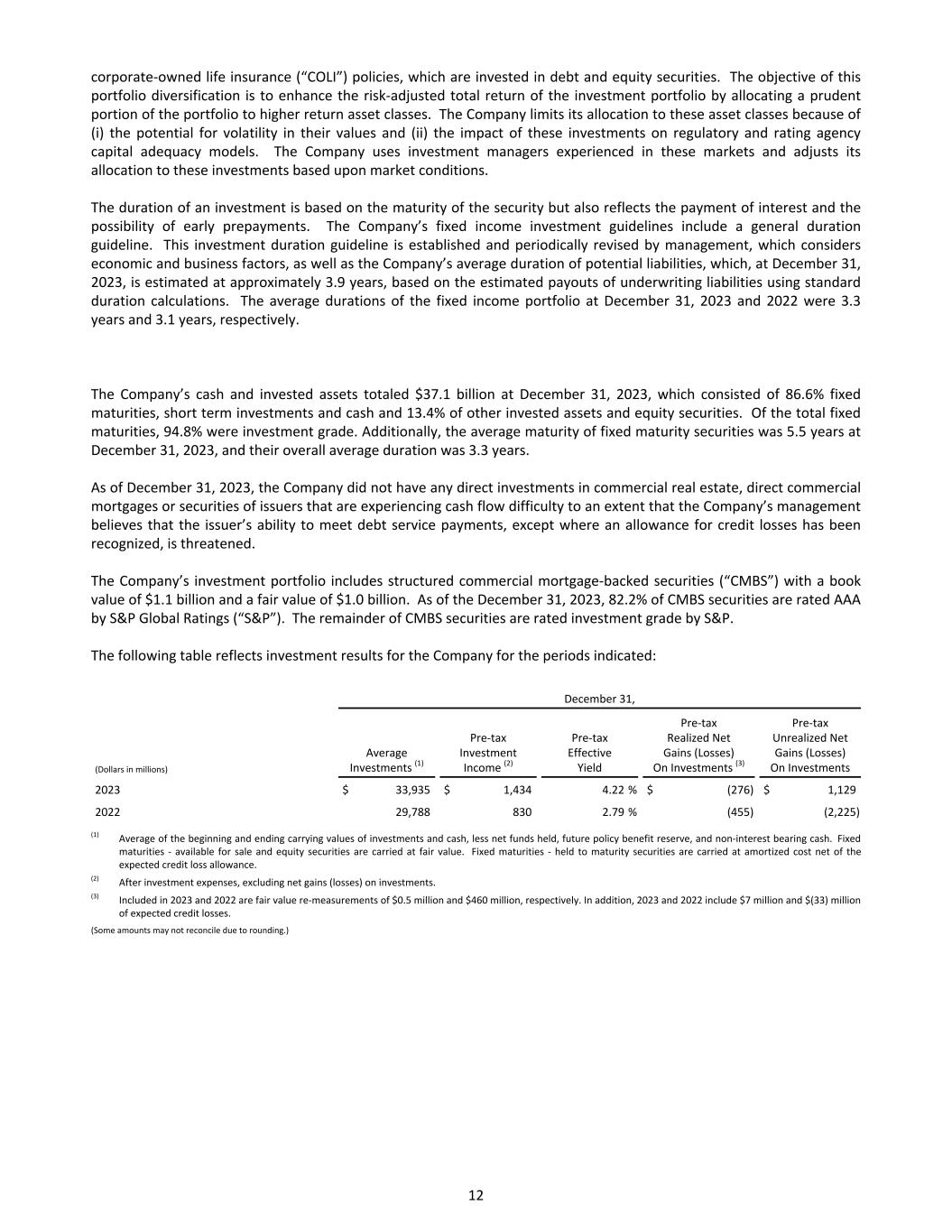
corporate-owned life insurance (“COLI”) policies, which are invested in debt and equity securities. The objective of this portfolio diversification is to enhance the risk-adjusted total return of the investment portfolio by allocating a prudent portion of the portfolio to higher return asset classes. The Company limits its allocation to these asset classes because of (i) the potential for volatility in their values and (ii) the impact of these investments on regulatory and rating agency capital adequacy models. The Company uses investment managers experienced in these markets and adjusts its allocation to these investments based upon market conditions. The duration of an investment is based on the maturity of the security but also reflects the payment of interest and the possibility of early prepayments. The Company’s fixed income investment guidelines include a general duration guideline. This investment duration guideline is established and periodically revised by management, which considers economic and business factors, as well as the Company’s average duration of potential liabilities, which, at December 31, 2023, is estimated at approximately 3.9 years, based on the estimated payouts of underwriting liabilities using standard duration calculations. The average durations of the fixed income portfolio at December 31, 2023 and 2022 were 3.3 years and 3.1 years, respectively. The Company’s cash and invested assets totaled $37.1 billion at December 31, 2023, which consisted of 86.6% fixed maturities, short term investments and cash and 13.4% of other invested assets and equity securities. Of the total fixed maturities, 94.8% were investment grade. Additionally, the average maturity of fixed maturity securities was 5.5 years at December 31, 2023, and their overall average duration was 3.3 years. As of December 31, 2023, the Company did not have any direct investments in commercial real estate, direct commercial mortgages or securities of issuers that are experiencing cash flow difficulty to an extent that the Company’s management believes that the issuer’s ability to meet debt service payments, except where an allowance for credit losses has been recognized, is threatened. The Company’s investment portfolio includes structured commercial mortgage-backed securities (“CMBS”) with a book value of $1.1 billion and a fair value of $1.0 billion. As of the December 31, 2023, 82.2% of CMBS securities are rated AAA by S&P Global Ratings (“S&P”). The remainder of CMBS securities are rated investment grade by S&P. The following table reflects investment results for the Company for the periods indicated: December 31, (Dollars in millions) Average Investments (1) Pre-tax Investment Income (2) Pre-tax Effective Yield Pre-tax Realized Net Gains (Losses) On Investments (3) Pre-tax Unrealized Net Gains (Losses) On Investments 2023 $ 33,935 $ 1,434 4.22 % $ (276) $ 1,129 2022 29,788 830 2.79 % (455) (2,225) (1) Average of the beginning and ending carrying values of investments and cash, less net funds held, future policy benefit reserve, and non-interest bearing cash. Fixed maturities - available for sale and equity securities are carried at fair value. Fixed maturities - held to maturity securities are carried at amortized cost net of the expected credit loss allowance. (2) After investment expenses, excluding net gains (losses) on investments. (3) Included in 2023 and 2022 are fair value re-measurements of $0.5 million and $460 million, respectively. In addition, 2023 and 2022 include $7 million and $(33) million of expected credit losses. (Some amounts may not reconcile due to rounding.) 12
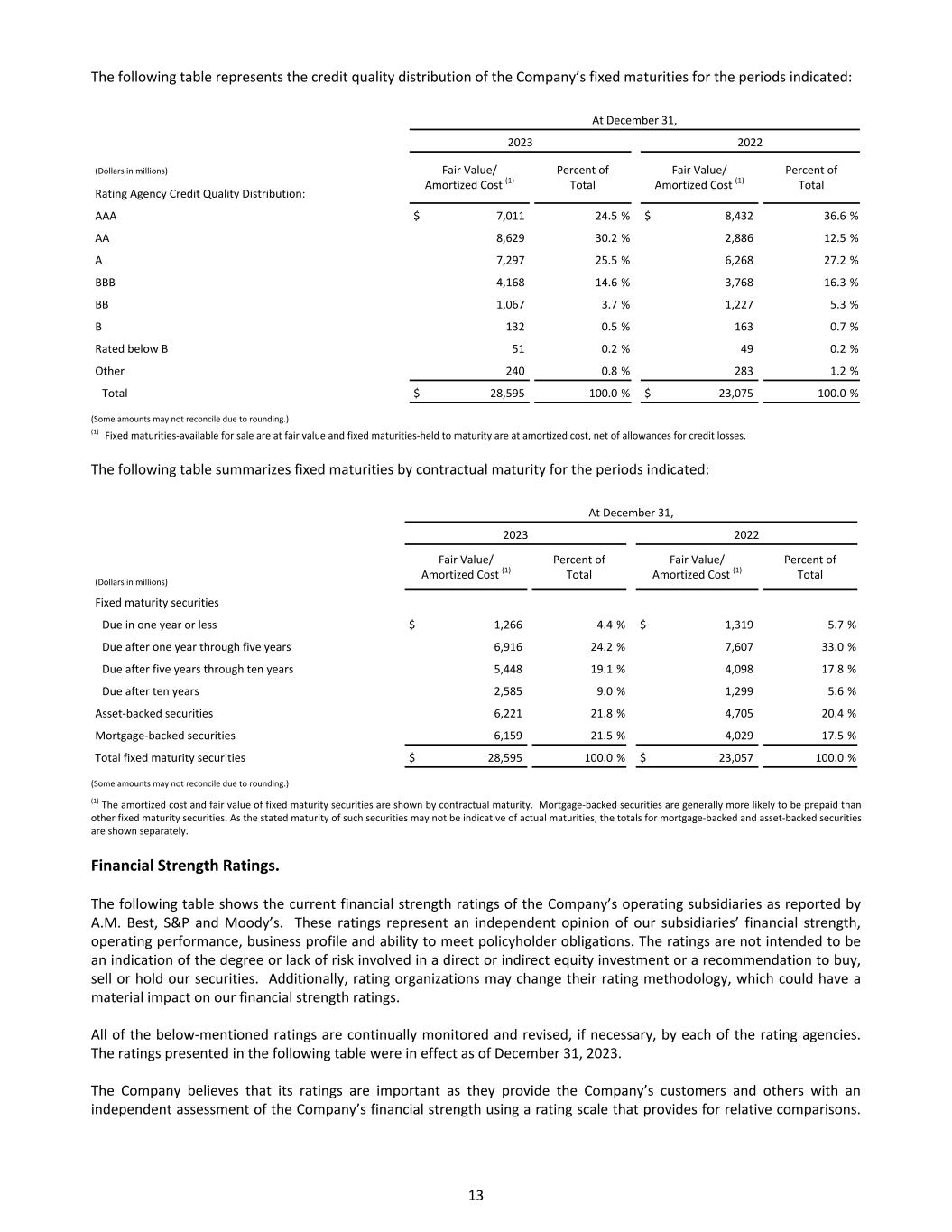
The following table represents the credit quality distribution of the Company’s fixed maturities for the periods indicated: At December 31, 2023 2022 (Dollars in millions) Fair Value/ Amortized Cost (1) Percent of Total Fair Value/ Amortized Cost (1) Percent of Total Rating Agency Credit Quality Distribution: AAA $ 7,011 24.5 % $ 8,432 36.6 % AA 8,629 30.2 % 2,886 12.5 % A 7,297 25.5 % 6,268 27.2 % BBB 4,168 14.6 % 3,768 16.3 % BB 1,067 3.7 % 1,227 5.3 % B 132 0.5 % 163 0.7 % Rated below B 51 0.2 % 49 0.2 % Other 240 0.8 % 283 1.2 % Total $ 28,595 100.0 % $ 23,075 100.0 % (Some amounts may not reconcile due to rounding.) (1) Fixed maturities-available for sale are at fair value and fixed maturities-held to maturity are at amortized cost, net of allowances for credit losses. The following table summarizes fixed maturities by contractual maturity for the periods indicated: At December 31, 2023 2022 (Dollars in millions) Fair Value/ Amortized Cost (1) Percent of Total Fair Value/ Amortized Cost (1) Percent of Total Fixed maturity securities Due in one year or less $ 1,266 4.4 % $ 1,319 5.7 % Due after one year through five years 6,916 24.2 % 7,607 33.0 % Due after five years through ten years 5,448 19.1 % 4,098 17.8 % Due after ten years 2,585 9.0 % 1,299 5.6 % Asset-backed securities 6,221 21.8 % 4,705 20.4 % Mortgage-backed securities 6,159 21.5 % 4,029 17.5 % Total fixed maturity securities $ 28,595 100.0 % $ 23,057 100.0 % (Some amounts may not reconcile due to rounding.) (1) The amortized cost and fair value of fixed maturity securities are shown by contractual maturity. Mortgage-backed securities are generally more likely to be prepaid than other fixed maturity securities. As the stated maturity of such securities may not be indicative of actual maturities, the totals for mortgage-backed and asset-backed securities are shown separately. Financial Strength Ratings. The following table shows the current financial strength ratings of the Company’s operating subsidiaries as reported by A.M. Best, S&P and Moody’s. These ratings represent an independent opinion of our subsidiaries’ financial strength, operating performance, business profile and ability to meet policyholder obligations. The ratings are not intended to be an indication of the degree or lack of risk involved in a direct or indirect equity investment or a recommendation to buy, sell or hold our securities. Additionally, rating organizations may change their rating methodology, which could have a material impact on our financial strength ratings. All of the below-mentioned ratings are continually monitored and revised, if necessary, by each of the rating agencies. The ratings presented in the following table were in effect as of December 31, 2023. The Company believes that its ratings are important as they provide the Company’s customers and others with an independent assessment of the Company’s financial strength using a rating scale that provides for relative comparisons. 13
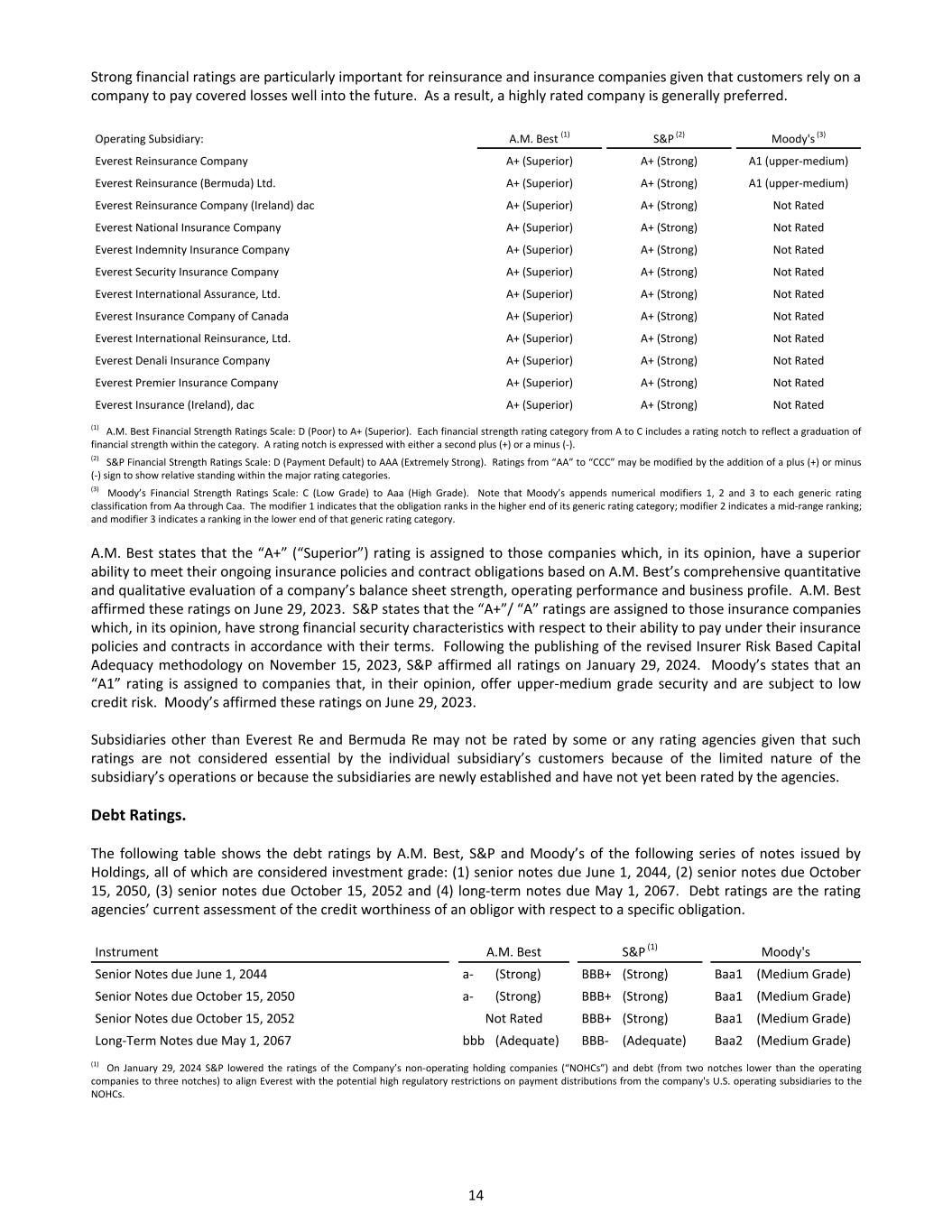
Strong financial ratings are particularly important for reinsurance and insurance companies given that customers rely on a company to pay covered losses well into the future. As a result, a highly rated company is generally preferred. Operating Subsidiary: A.M. Best (1) S&P (2) Moody's (3) Everest Reinsurance Company A+ (Superior) A+ (Strong) A1 (upper-medium) Everest Reinsurance (Bermuda) Ltd. A+ (Superior) A+ (Strong) A1 (upper-medium) Everest Reinsurance Company (Ireland) dac A+ (Superior) A+ (Strong) Not Rated Everest National Insurance Company A+ (Superior) A+ (Strong) Not Rated Everest Indemnity Insurance Company A+ (Superior) A+ (Strong) Not Rated Everest Security Insurance Company A+ (Superior) A+ (Strong) Not Rated Everest International Assurance, Ltd. A+ (Superior) A+ (Strong) Not Rated Everest Insurance Company of Canada A+ (Superior) A+ (Strong) Not Rated Everest International Reinsurance, Ltd. A+ (Superior) A+ (Strong) Not Rated Everest Denali Insurance Company A+ (Superior) A+ (Strong) Not Rated Everest Premier Insurance Company A+ (Superior) A+ (Strong) Not Rated Everest Insurance (Ireland), dac A+ (Superior) A+ (Strong) Not Rated (1) A.M. Best Financial Strength Ratings Scale: D (Poor) to A+ (Superior). Each financial strength rating category from A to C includes a rating notch to reflect a graduation of financial strength within the category. A rating notch is expressed with either a second plus (+) or a minus (-). (2) S&P Financial Strength Ratings Scale: D (Payment Default) to AAA (Extremely Strong). Ratings from “AA” to “CCC” may be modified by the addition of a plus (+) or minus (-) sign to show relative standing within the major rating categories. (3) Moody’s Financial Strength Ratings Scale: C (Low Grade) to Aaa (High Grade). Note that Moody’s appends numerical modifiers 1, 2 and 3 to each generic rating classification from Aa through Caa. The modifier 1 indicates that the obligation ranks in the higher end of its generic rating category; modifier 2 indicates a mid-range ranking; and modifier 3 indicates a ranking in the lower end of that generic rating category. A.M. Best states that the “A+” (“Superior”) rating is assigned to those companies which, in its opinion, have a superior ability to meet their ongoing insurance policies and contract obligations based on A.M. Best’s comprehensive quantitative and qualitative evaluation of a company’s balance sheet strength, operating performance and business profile. A.M. Best affirmed these ratings on June 29, 2023. S&P states that the “A+”/ “A” ratings are assigned to those insurance companies which, in its opinion, have strong financial security characteristics with respect to their ability to pay under their insurance policies and contracts in accordance with their terms. Following the publishing of the revised Insurer Risk Based Capital Adequacy methodology on November 15, 2023, S&P affirmed all ratings on January 29, 2024. Moody’s states that an “A1” rating is assigned to companies that, in their opinion, offer upper-medium grade security and are subject to low credit risk. Moody’s affirmed these ratings on June 29, 2023. Subsidiaries other than Everest Re and Bermuda Re may not be rated by some or any rating agencies given that such ratings are not considered essential by the individual subsidiary’s customers because of the limited nature of the subsidiary’s operations or because the subsidiaries are newly established and have not yet been rated by the agencies. Debt Ratings. The following table shows the debt ratings by A.M. Best, S&P and Moody’s of the following series of notes issued by Holdings, all of which are considered investment grade: (1) senior notes due June 1, 2044, (2) senior notes due October 15, 2050, (3) senior notes due October 15, 2052 and (4) long-term notes due May 1, 2067. Debt ratings are the rating agencies’ current assessment of the credit worthiness of an obligor with respect to a specific obligation. Instrument A.M. Best S&P (1) Moody's Senior Notes due June 1, 2044 a- (Strong) BBB+ (Strong) Baa1 (Medium Grade) Senior Notes due October 15, 2050 a- (Strong) BBB+ (Strong) Baa1 (Medium Grade) Senior Notes due October 15, 2052 Not Rated BBB+ (Strong) Baa1 (Medium Grade) Long-Term Notes due May 1, 2067 bbb (Adequate) BBB- (Adequate) Baa2 (Medium Grade) (1) On January 29, 2024 S&P lowered the ratings of the Company’s non-operating holding companies (“NOHCs”) and debt (from two notches lower than the operating companies to three notches) to align Everest with the potential high regulatory restrictions on payment distributions from the company's U.S. operating subsidiaries to the NOHCs. 14
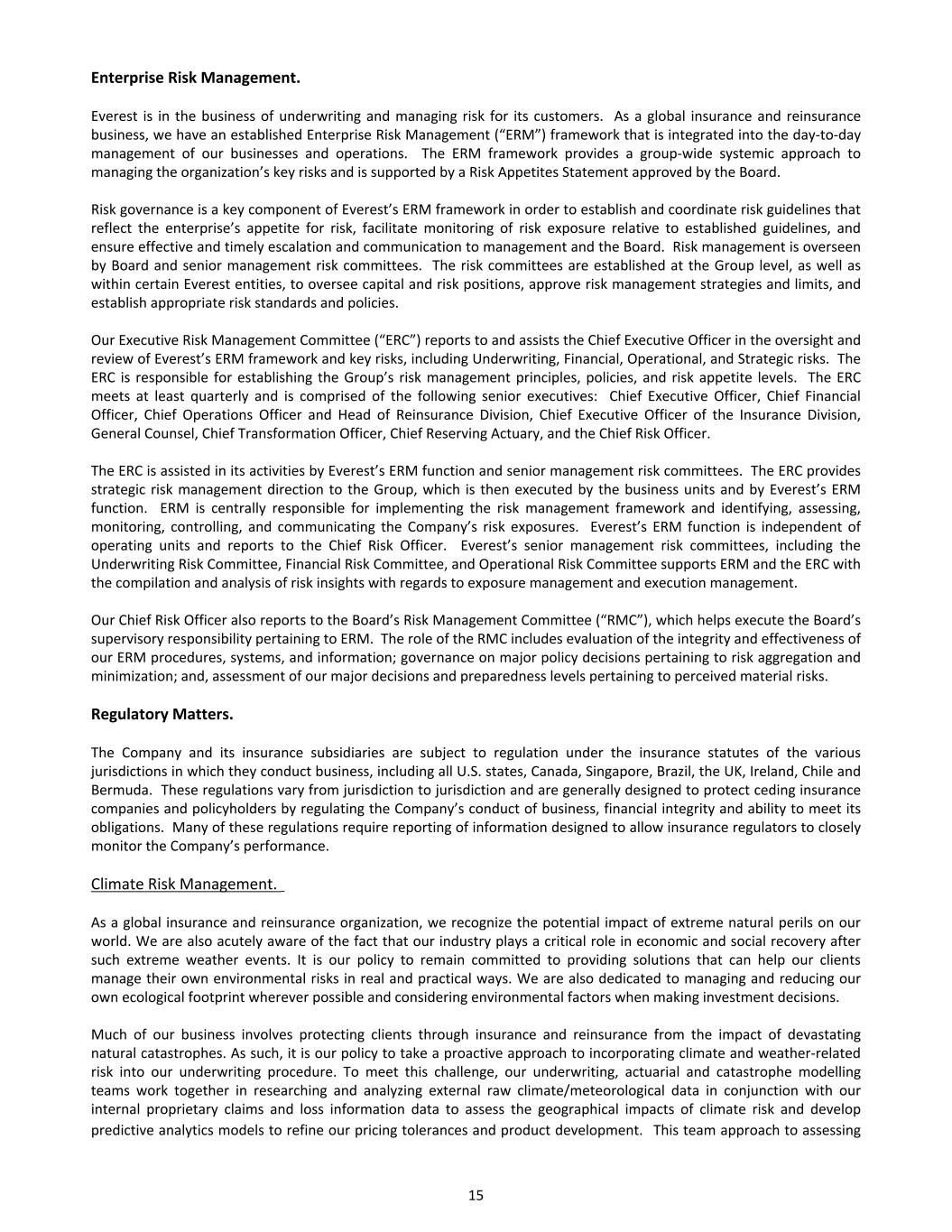
Enterprise Risk Management. Everest is in the business of underwriting and managing risk for its customers. As a global insurance and reinsurance business, we have an established Enterprise Risk Management (“ERM”) framework that is integrated into the day-to-day management of our businesses and operations. The ERM framework provides a group-wide systemic approach to managing the organization’s key risks and is supported by a Risk Appetites Statement approved by the Board. Risk governance is a key component of Everest’s ERM framework in order to establish and coordinate risk guidelines that reflect the enterprise’s appetite for risk, facilitate monitoring of risk exposure relative to established guidelines, and ensure effective and timely escalation and communication to management and the Board. Risk management is overseen by Board and senior management risk committees. The risk committees are established at the Group level, as well as within certain Everest entities, to oversee capital and risk positions, approve risk management strategies and limits, and establish appropriate risk standards and policies. Our Executive Risk Management Committee (“ERC”) reports to and assists the Chief Executive Officer in the oversight and review of Everest’s ERM framework and key risks, including Underwriting, Financial, Operational, and Strategic risks. The ERC is responsible for establishing the Group’s risk management principles, policies, and risk appetite levels. The ERC meets at least quarterly and is comprised of the following senior executives: Chief Executive Officer, Chief Financial Officer, Chief Operations Officer and Head of Reinsurance Division, Chief Executive Officer of the Insurance Division, General Counsel, Chief Transformation Officer, Chief Reserving Actuary, and the Chief Risk Officer. The ERC is assisted in its activities by Everest’s ERM function and senior management risk committees. The ERC provides strategic risk management direction to the Group, which is then executed by the business units and by Everest’s ERM function. ERM is centrally responsible for implementing the risk management framework and identifying, assessing, monitoring, controlling, and communicating the Company’s risk exposures. Everest’s ERM function is independent of operating units and reports to the Chief Risk Officer. Everest’s senior management risk committees, including the Underwriting Risk Committee, Financial Risk Committee, and Operational Risk Committee supports ERM and the ERC with the compilation and analysis of risk insights with regards to exposure management and execution management. Our Chief Risk Officer also reports to the Board’s Risk Management Committee (“RMC”), which helps execute the Board’s supervisory responsibility pertaining to ERM. The role of the RMC includes evaluation of the integrity and effectiveness of our ERM procedures, systems, and information; governance on major policy decisions pertaining to risk aggregation and minimization; and, assessment of our major decisions and preparedness levels pertaining to perceived material risks. Regulatory Matters. The Company and its insurance subsidiaries are subject to regulation under the insurance statutes of the various jurisdictions in which they conduct business, including all U.S. states, Canada, Singapore, Brazil, the UK, Ireland, Chile and Bermuda. These regulations vary from jurisdiction to jurisdiction and are generally designed to protect ceding insurance companies and policyholders by regulating the Company’s conduct of business, financial integrity and ability to meet its obligations. Many of these regulations require reporting of information designed to allow insurance regulators to closely monitor the Company’s performance. Climate Risk Management. As a global insurance and reinsurance organization, we recognize the potential impact of extreme natural perils on our world. We are also acutely aware of the fact that our industry plays a critical role in economic and social recovery after such extreme weather events. It is our policy to remain committed to providing solutions that can help our clients manage their own environmental risks in real and practical ways. We are also dedicated to managing and reducing our own ecological footprint wherever possible and considering environmental factors when making investment decisions. Much of our business involves protecting clients through insurance and reinsurance from the impact of devastating natural catastrophes. As such, it is our policy to take a proactive approach to incorporating climate and weather-related risk into our underwriting procedure. To meet this challenge, our underwriting, actuarial and catastrophe modelling teams work together in researching and analyzing external raw climate/meteorological data in conjunction with our internal proprietary claims and loss information data to assess the geographical impacts of climate risk and develop predictive analytics models to refine our pricing tolerances and product development. This team approach to assessing 15
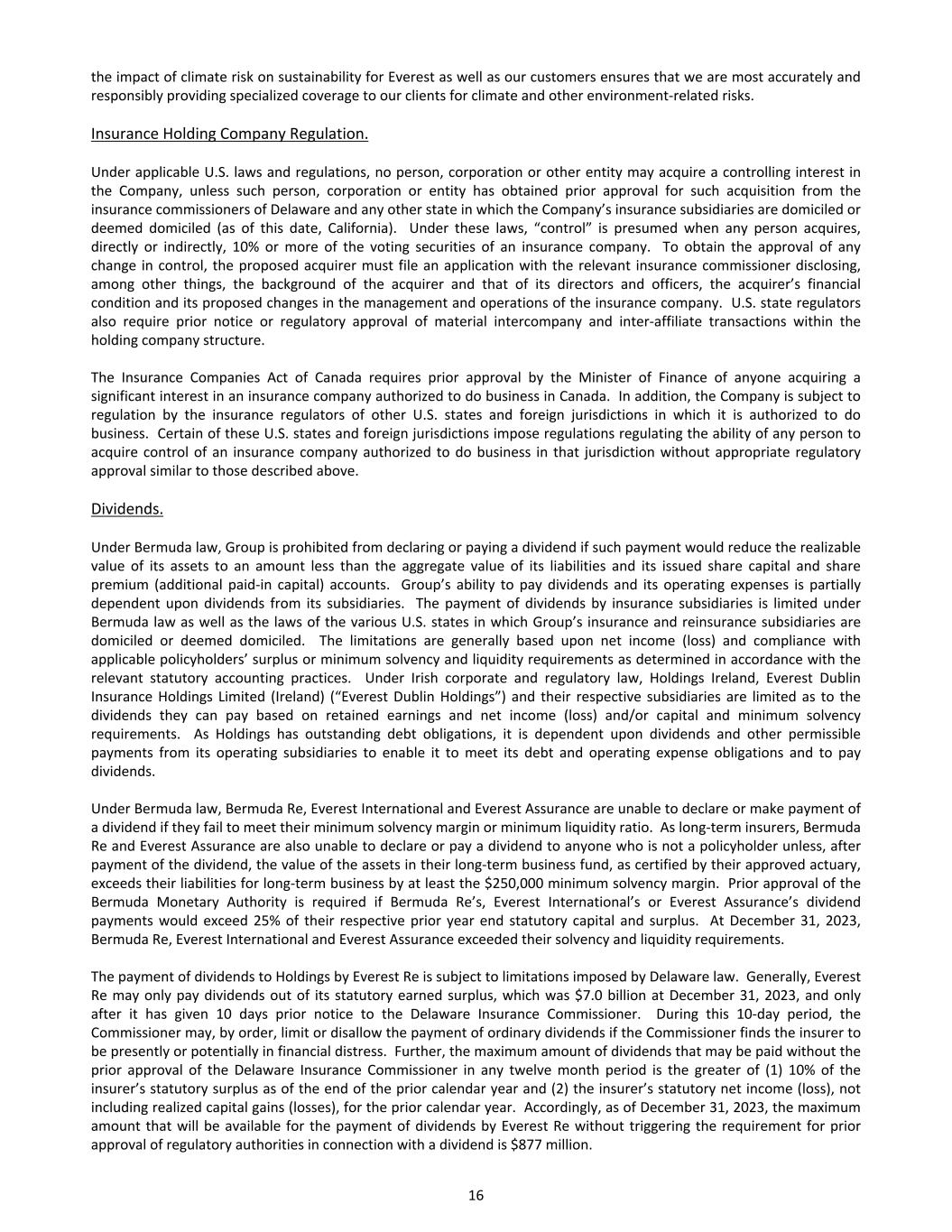
the impact of climate risk on sustainability for Everest as well as our customers ensures that we are most accurately and responsibly providing specialized coverage to our clients for climate and other environment-related risks. Insurance Holding Company Regulation. Under applicable U.S. laws and regulations, no person, corporation or other entity may acquire a controlling interest in the Company, unless such person, corporation or entity has obtained prior approval for such acquisition from the insurance commissioners of Delaware and any other state in which the Company’s insurance subsidiaries are domiciled or deemed domiciled (as of this date, California). Under these laws, “control” is presumed when any person acquires, directly or indirectly, 10% or more of the voting securities of an insurance company. To obtain the approval of any change in control, the proposed acquirer must file an application with the relevant insurance commissioner disclosing, among other things, the background of the acquirer and that of its directors and officers, the acquirer’s financial condition and its proposed changes in the management and operations of the insurance company. U.S. state regulators also require prior notice or regulatory approval of material intercompany and inter-affiliate transactions within the holding company structure. The Insurance Companies Act of Canada requires prior approval by the Minister of Finance of anyone acquiring a significant interest in an insurance company authorized to do business in Canada. In addition, the Company is subject to regulation by the insurance regulators of other U.S. states and foreign jurisdictions in which it is authorized to do business. Certain of these U.S. states and foreign jurisdictions impose regulations regulating the ability of any person to acquire control of an insurance company authorized to do business in that jurisdiction without appropriate regulatory approval similar to those described above. Dividends. Under Bermuda law, Group is prohibited from declaring or paying a dividend if such payment would reduce the realizable value of its assets to an amount less than the aggregate value of its liabilities and its issued share capital and share premium (additional paid-in capital) accounts. Group’s ability to pay dividends and its operating expenses is partially dependent upon dividends from its subsidiaries. The payment of dividends by insurance subsidiaries is limited under Bermuda law as well as the laws of the various U.S. states in which Group’s insurance and reinsurance subsidiaries are domiciled or deemed domiciled. The limitations are generally based upon net income (loss) and compliance with applicable policyholders’ surplus or minimum solvency and liquidity requirements as determined in accordance with the relevant statutory accounting practices. Under Irish corporate and regulatory law, Holdings Ireland, Everest Dublin Insurance Holdings Limited (Ireland) (“Everest Dublin Holdings”) and their respective subsidiaries are limited as to the dividends they can pay based on retained earnings and net income (loss) and/or capital and minimum solvency requirements. As Holdings has outstanding debt obligations, it is dependent upon dividends and other permissible payments from its operating subsidiaries to enable it to meet its debt and operating expense obligations and to pay dividends. Under Bermuda law, Bermuda Re, Everest International and Everest Assurance are unable to declare or make payment of a dividend if they fail to meet their minimum solvency margin or minimum liquidity ratio. As long-term insurers, Bermuda Re and Everest Assurance are also unable to declare or pay a dividend to anyone who is not a policyholder unless, after payment of the dividend, the value of the assets in their long-term business fund, as certified by their approved actuary, exceeds their liabilities for long-term business by at least the $250,000 minimum solvency margin. Prior approval of the Bermuda Monetary Authority is required if Bermuda Re’s, Everest International’s or Everest Assurance’s dividend payments would exceed 25% of their respective prior year end statutory capital and surplus. At December 31, 2023, Bermuda Re, Everest International and Everest Assurance exceeded their solvency and liquidity requirements. The payment of dividends to Holdings by Everest Re is subject to limitations imposed by Delaware law. Generally, Everest Re may only pay dividends out of its statutory earned surplus, which was $7.0 billion at December 31, 2023, and only after it has given 10 days prior notice to the Delaware Insurance Commissioner. During this 10-day period, the Commissioner may, by order, limit or disallow the payment of ordinary dividends if the Commissioner finds the insurer to be presently or potentially in financial distress. Further, the maximum amount of dividends that may be paid without the prior approval of the Delaware Insurance Commissioner in any twelve month period is the greater of (1) 10% of the insurer’s statutory surplus as of the end of the prior calendar year and (2) the insurer’s statutory net income (loss), not including realized capital gains (losses), for the prior calendar year. Accordingly, as of December 31, 2023, the maximum amount that will be available for the payment of dividends by Everest Re without triggering the requirement for prior approval of regulatory authorities in connection with a dividend is $877 million. 16
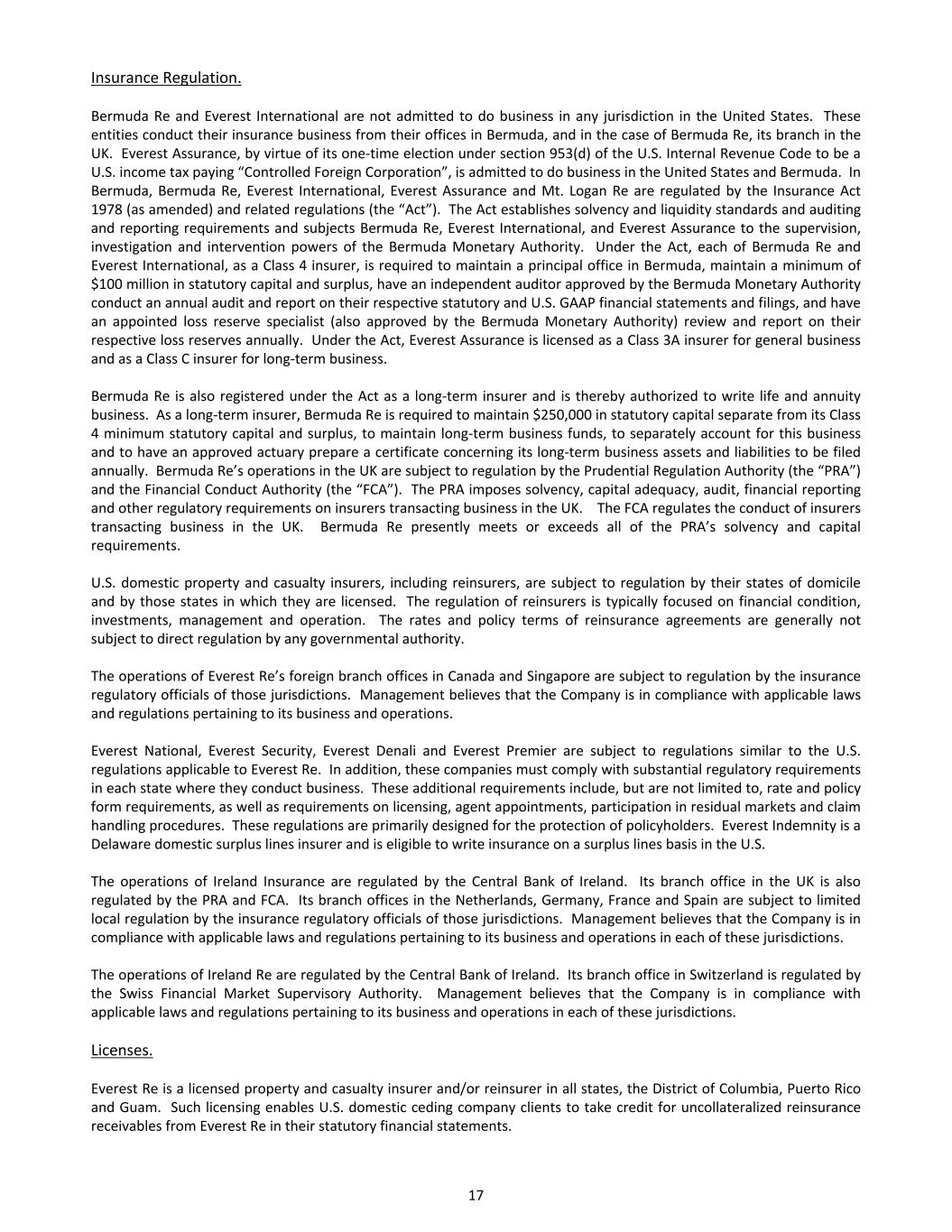
Insurance Regulation. Bermuda Re and Everest International are not admitted to do business in any jurisdiction in the United States. These entities conduct their insurance business from their offices in Bermuda, and in the case of Bermuda Re, its branch in the UK. Everest Assurance, by virtue of its one-time election under section 953(d) of the U.S. Internal Revenue Code to be a U.S. income tax paying “Controlled Foreign Corporation”, is admitted to do business in the United States and Bermuda. In Bermuda, Bermuda Re, Everest International, Everest Assurance and Mt. Logan Re are regulated by the Insurance Act 1978 (as amended) and related regulations (the “Act”). The Act establishes solvency and liquidity standards and auditing and reporting requirements and subjects Bermuda Re, Everest International, and Everest Assurance to the supervision, investigation and intervention powers of the Bermuda Monetary Authority. Under the Act, each of Bermuda Re and Everest International, as a Class 4 insurer, is required to maintain a principal office in Bermuda, maintain a minimum of $100 million in statutory capital and surplus, have an independent auditor approved by the Bermuda Monetary Authority conduct an annual audit and report on their respective statutory and U.S. GAAP financial statements and filings, and have an appointed loss reserve specialist (also approved by the Bermuda Monetary Authority) review and report on their respective loss reserves annually. Under the Act, Everest Assurance is licensed as a Class 3A insurer for general business and as a Class C insurer for long-term business. Bermuda Re is also registered under the Act as a long-term insurer and is thereby authorized to write life and annuity business. As a long-term insurer, Bermuda Re is required to maintain $250,000 in statutory capital separate from its Class 4 minimum statutory capital and surplus, to maintain long-term business funds, to separately account for this business and to have an approved actuary prepare a certificate concerning its long-term business assets and liabilities to be filed annually. Bermuda Re’s operations in the UK are subject to regulation by the Prudential Regulation Authority (the “PRA”) and the Financial Conduct Authority (the “FCA”). The PRA imposes solvency, capital adequacy, audit, financial reporting and other regulatory requirements on insurers transacting business in the UK. The FCA regulates the conduct of insurers transacting business in the UK. Bermuda Re presently meets or exceeds all of the PRA’s solvency and capital requirements. U.S. domestic property and casualty insurers, including reinsurers, are subject to regulation by their states of domicile and by those states in which they are licensed. The regulation of reinsurers is typically focused on financial condition, investments, management and operation. The rates and policy terms of reinsurance agreements are generally not subject to direct regulation by any governmental authority. The operations of Everest Re’s foreign branch offices in Canada and Singapore are subject to regulation by the insurance regulatory officials of those jurisdictions. Management believes that the Company is in compliance with applicable laws and regulations pertaining to its business and operations. Everest National, Everest Security, Everest Denali and Everest Premier are subject to regulations similar to the U.S. regulations applicable to Everest Re. In addition, these companies must comply with substantial regulatory requirements in each state where they conduct business. These additional requirements include, but are not limited to, rate and policy form requirements, as well as requirements on licensing, agent appointments, participation in residual markets and claim handling procedures. These regulations are primarily designed for the protection of policyholders. Everest Indemnity is a Delaware domestic surplus lines insurer and is eligible to write insurance on a surplus lines basis in the U.S. The operations of Ireland Insurance are regulated by the Central Bank of Ireland. Its branch office in the UK is also regulated by the PRA and FCA. Its branch offices in the Netherlands, Germany, France and Spain are subject to limited local regulation by the insurance regulatory officials of those jurisdictions. Management believes that the Company is in compliance with applicable laws and regulations pertaining to its business and operations in each of these jurisdictions. The operations of Ireland Re are regulated by the Central Bank of Ireland. Its branch office in Switzerland is regulated by the Swiss Financial Market Supervisory Authority. Management believes that the Company is in compliance with applicable laws and regulations pertaining to its business and operations in each of these jurisdictions. Licenses. Everest Re is a licensed property and casualty insurer and/or reinsurer in all states, the District of Columbia, Puerto Rico and Guam. Such licensing enables U.S. domestic ceding company clients to take credit for uncollateralized reinsurance receivables from Everest Re in their statutory financial statements. 17
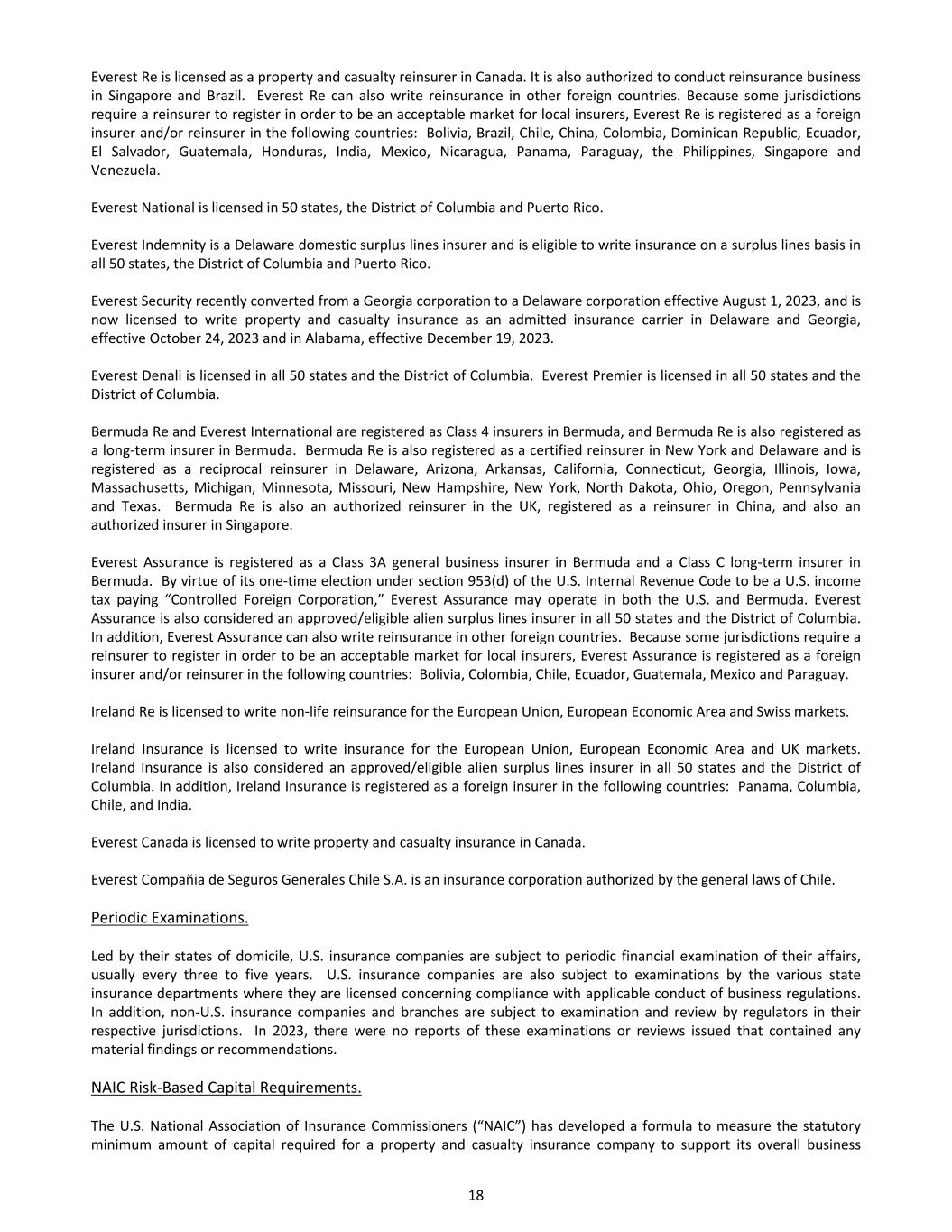
Everest Re is licensed as a property and casualty reinsurer in Canada. It is also authorized to conduct reinsurance business in Singapore and Brazil. Everest Re can also write reinsurance in other foreign countries. Because some jurisdictions require a reinsurer to register in order to be an acceptable market for local insurers, Everest Re is registered as a foreign insurer and/or reinsurer in the following countries: Bolivia, Brazil, Chile, China, Colombia, Dominican Republic, Ecuador, El Salvador, Guatemala, Honduras, India, Mexico, Nicaragua, Panama, Paraguay, the Philippines, Singapore and Venezuela. Everest National is licensed in 50 states, the District of Columbia and Puerto Rico. Everest Indemnity is a Delaware domestic surplus lines insurer and is eligible to write insurance on a surplus lines basis in all 50 states, the District of Columbia and Puerto Rico. Everest Security recently converted from a Georgia corporation to a Delaware corporation effective August 1, 2023, and is now licensed to write property and casualty insurance as an admitted insurance carrier in Delaware and Georgia, effective October 24, 2023 and in Alabama, effective December 19, 2023. Everest Denali is licensed in all 50 states and the District of Columbia. Everest Premier is licensed in all 50 states and the District of Columbia. Bermuda Re and Everest International are registered as Class 4 insurers in Bermuda, and Bermuda Re is also registered as a long-term insurer in Bermuda. Bermuda Re is also registered as a certified reinsurer in New York and Delaware and is registered as a reciprocal reinsurer in Delaware, Arizona, Arkansas, California, Connecticut, Georgia, Illinois, Iowa, Massachusetts, Michigan, Minnesota, Missouri, New Hampshire, New York, North Dakota, Ohio, Oregon, Pennsylvania and Texas. Bermuda Re is also an authorized reinsurer in the UK, registered as a reinsurer in China, and also an authorized insurer in Singapore. Everest Assurance is registered as a Class 3A general business insurer in Bermuda and a Class C long-term insurer in Bermuda. By virtue of its one-time election under section 953(d) of the U.S. Internal Revenue Code to be a U.S. income tax paying “Controlled Foreign Corporation,” Everest Assurance may operate in both the U.S. and Bermuda. Everest Assurance is also considered an approved/eligible alien surplus lines insurer in all 50 states and the District of Columbia. In addition, Everest Assurance can also write reinsurance in other foreign countries. Because some jurisdictions require a reinsurer to register in order to be an acceptable market for local insurers, Everest Assurance is registered as a foreign insurer and/or reinsurer in the following countries: Bolivia, Colombia, Chile, Ecuador, Guatemala, Mexico and Paraguay. Ireland Re is licensed to write non-life reinsurance for the European Union, European Economic Area and Swiss markets. Ireland Insurance is licensed to write insurance for the European Union, European Economic Area and UK markets. Ireland Insurance is also considered an approved/eligible alien surplus lines insurer in all 50 states and the District of Columbia. In addition, Ireland Insurance is registered as a foreign insurer in the following countries: Panama, Columbia, Chile, and India. Everest Canada is licensed to write property and casualty insurance in Canada. Everest Compañia de Seguros Generales Chile S.A. is an insurance corporation authorized by the general laws of Chile. Periodic Examinations. Led by their states of domicile, U.S. insurance companies are subject to periodic financial examination of their affairs, usually every three to five years. U.S. insurance companies are also subject to examinations by the various state insurance departments where they are licensed concerning compliance with applicable conduct of business regulations. In addition, non-U.S. insurance companies and branches are subject to examination and review by regulators in their respective jurisdictions. In 2023, there were no reports of these examinations or reviews issued that contained any material findings or recommendations. NAIC Risk-Based Capital Requirements. The U.S. National Association of Insurance Commissioners (“NAIC”) has developed a formula to measure the statutory minimum amount of capital required for a property and casualty insurance company to support its overall business 18
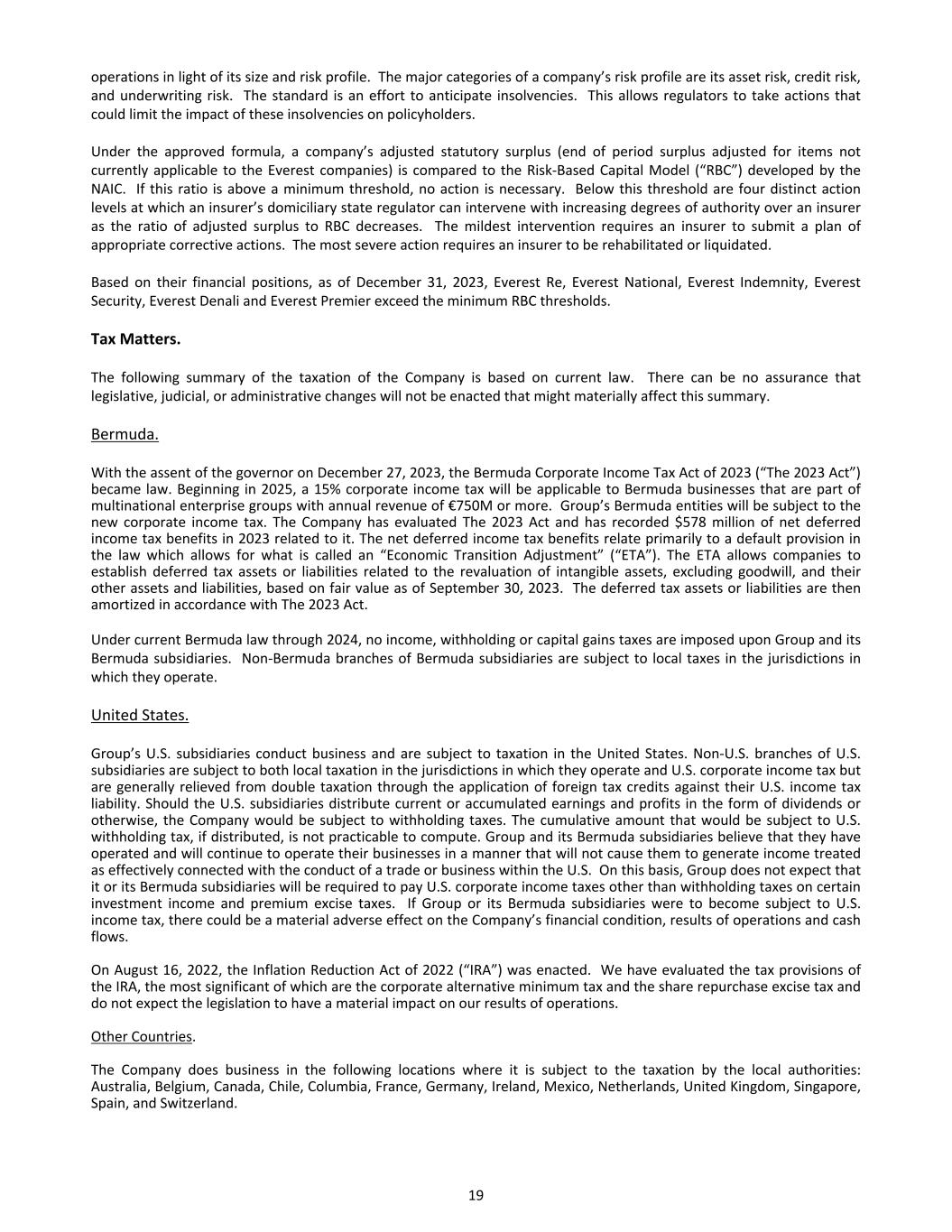
operations in light of its size and risk profile. The major categories of a company’s risk profile are its asset risk, credit risk, and underwriting risk. The standard is an effort to anticipate insolvencies. This allows regulators to take actions that could limit the impact of these insolvencies on policyholders. Under the approved formula, a company’s adjusted statutory surplus (end of period surplus adjusted for items not currently applicable to the Everest companies) is compared to the Risk-Based Capital Model (“RBC”) developed by the NAIC. If this ratio is above a minimum threshold, no action is necessary. Below this threshold are four distinct action levels at which an insurer’s domiciliary state regulator can intervene with increasing degrees of authority over an insurer as the ratio of adjusted surplus to RBC decreases. The mildest intervention requires an insurer to submit a plan of appropriate corrective actions. The most severe action requires an insurer to be rehabilitated or liquidated. Based on their financial positions, as of December 31, 2023, Everest Re, Everest National, Everest Indemnity, Everest Security, Everest Denali and Everest Premier exceed the minimum RBC thresholds. Tax Matters. The following summary of the taxation of the Company is based on current law. There can be no assurance that legislative, judicial, or administrative changes will not be enacted that might materially affect this summary. Bermuda. With the assent of the governor on December 27, 2023, the Bermuda Corporate Income Tax Act of 2023 (“The 2023 Act”) became law. Beginning in 2025, a 15% corporate income tax will be applicable to Bermuda businesses that are part of multinational enterprise groups with annual revenue of €750M or more. Group’s Bermuda entities will be subject to the new corporate income tax. The Company has evaluated The 2023 Act and has recorded $578 million of net deferred income tax benefits in 2023 related to it. The net deferred income tax benefits relate primarily to a default provision in the law which allows for what is called an “Economic Transition Adjustment” (“ETA”). The ETA allows companies to establish deferred tax assets or liabilities related to the revaluation of intangible assets, excluding goodwill, and their other assets and liabilities, based on fair value as of September 30, 2023. The deferred tax assets or liabilities are then amortized in accordance with The 2023 Act. Under current Bermuda law through 2024, no income, withholding or capital gains taxes are imposed upon Group and its Bermuda subsidiaries. Non-Bermuda branches of Bermuda subsidiaries are subject to local taxes in the jurisdictions in which they operate. United States. Group’s U.S. subsidiaries conduct business and are subject to taxation in the United States. Non-U.S. branches of U.S. subsidiaries are subject to both local taxation in the jurisdictions in which they operate and U.S. corporate income tax but are generally relieved from double taxation through the application of foreign tax credits against their U.S. income tax liability. Should the U.S. subsidiaries distribute current or accumulated earnings and profits in the form of dividends or otherwise, the Company would be subject to withholding taxes. The cumulative amount that would be subject to U.S. withholding tax, if distributed, is not practicable to compute. Group and its Bermuda subsidiaries believe that they have operated and will continue to operate their businesses in a manner that will not cause them to generate income treated as effectively connected with the conduct of a trade or business within the U.S. On this basis, Group does not expect that it or its Bermuda subsidiaries will be required to pay U.S. corporate income taxes other than withholding taxes on certain investment income and premium excise taxes. If Group or its Bermuda subsidiaries were to become subject to U.S. income tax, there could be a material adverse effect on the Company’s financial condition, results of operations and cash flows. On August 16, 2022, the Inflation Reduction Act of 2022 (“IRA”) was enacted. We have evaluated the tax provisions of the IRA, the most significant of which are the corporate alternative minimum tax and the share repurchase excise tax and do not expect the legislation to have a material impact on our results of operations. Other Countries. The Company does business in the following locations where it is subject to the taxation by the local authorities: Australia, Belgium, Canada, Chile, Columbia, France, Germany, Ireland, Mexico, Netherlands, United Kingdom, Singapore, Spain, and Switzerland. 19
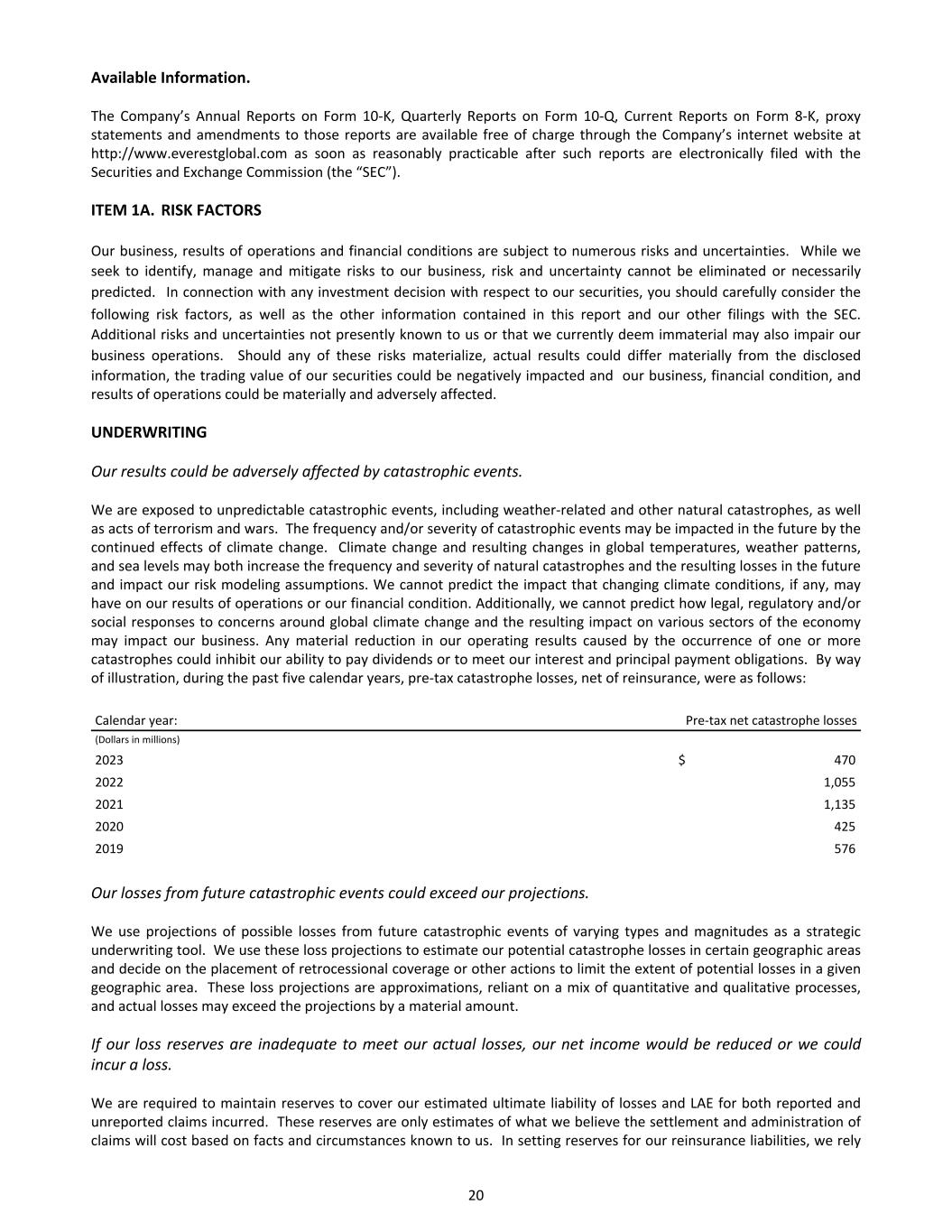
Available Information. The Company’s Annual Reports on Form 10-K, Quarterly Reports on Form 10-Q, Current Reports on Form 8-K, proxy statements and amendments to those reports are available free of charge through the Company’s internet website at http://www.everestglobal.com as soon as reasonably practicable after such reports are electronically filed with the Securities and Exchange Commission (the “SEC”). ITEM 1A. RISK FACTORS Our business, results of operations and financial conditions are subject to numerous risks and uncertainties. While we seek to identify, manage and mitigate risks to our business, risk and uncertainty cannot be eliminated or necessarily predicted. In connection with any investment decision with respect to our securities, you should carefully consider the following risk factors, as well as the other information contained in this report and our other filings with the SEC. Additional risks and uncertainties not presently known to us or that we currently deem immaterial may also impair our business operations. Should any of these risks materialize, actual results could differ materially from the disclosed information, the trading value of our securities could be negatively impacted and our business, financial condition, and results of operations could be materially and adversely affected. UNDERWRITING Our results could be adversely affected by catastrophic events. We are exposed to unpredictable catastrophic events, including weather-related and other natural catastrophes, as well as acts of terrorism and wars. The frequency and/or severity of catastrophic events may be impacted in the future by the continued effects of climate change. Climate change and resulting changes in global temperatures, weather patterns, and sea levels may both increase the frequency and severity of natural catastrophes and the resulting losses in the future and impact our risk modeling assumptions. We cannot predict the impact that changing climate conditions, if any, may have on our results of operations or our financial condition. Additionally, we cannot predict how legal, regulatory and/or social responses to concerns around global climate change and the resulting impact on various sectors of the economy may impact our business. Any material reduction in our operating results caused by the occurrence of one or more catastrophes could inhibit our ability to pay dividends or to meet our interest and principal payment obligations. By way of illustration, during the past five calendar years, pre-tax catastrophe losses, net of reinsurance, were as follows: Calendar year: Pre-tax net catastrophe losses (Dollars in millions) 2023 $ 470 2022 1,055 2021 1,135 2020 425 2019 576 Our losses from future catastrophic events could exceed our projections. We use projections of possible losses from future catastrophic events of varying types and magnitudes as a strategic underwriting tool. We use these loss projections to estimate our potential catastrophe losses in certain geographic areas and decide on the placement of retrocessional coverage or other actions to limit the extent of potential losses in a given geographic area. These loss projections are approximations, reliant on a mix of quantitative and qualitative processes, and actual losses may exceed the projections by a material amount. If our loss reserves are inadequate to meet our actual losses, our net income would be reduced or we could incur a loss. We are required to maintain reserves to cover our estimated ultimate liability of losses and LAE for both reported and unreported claims incurred. These reserves are only estimates of what we believe the settlement and administration of claims will cost based on facts and circumstances known to us. In setting reserves for our reinsurance liabilities, we rely 20
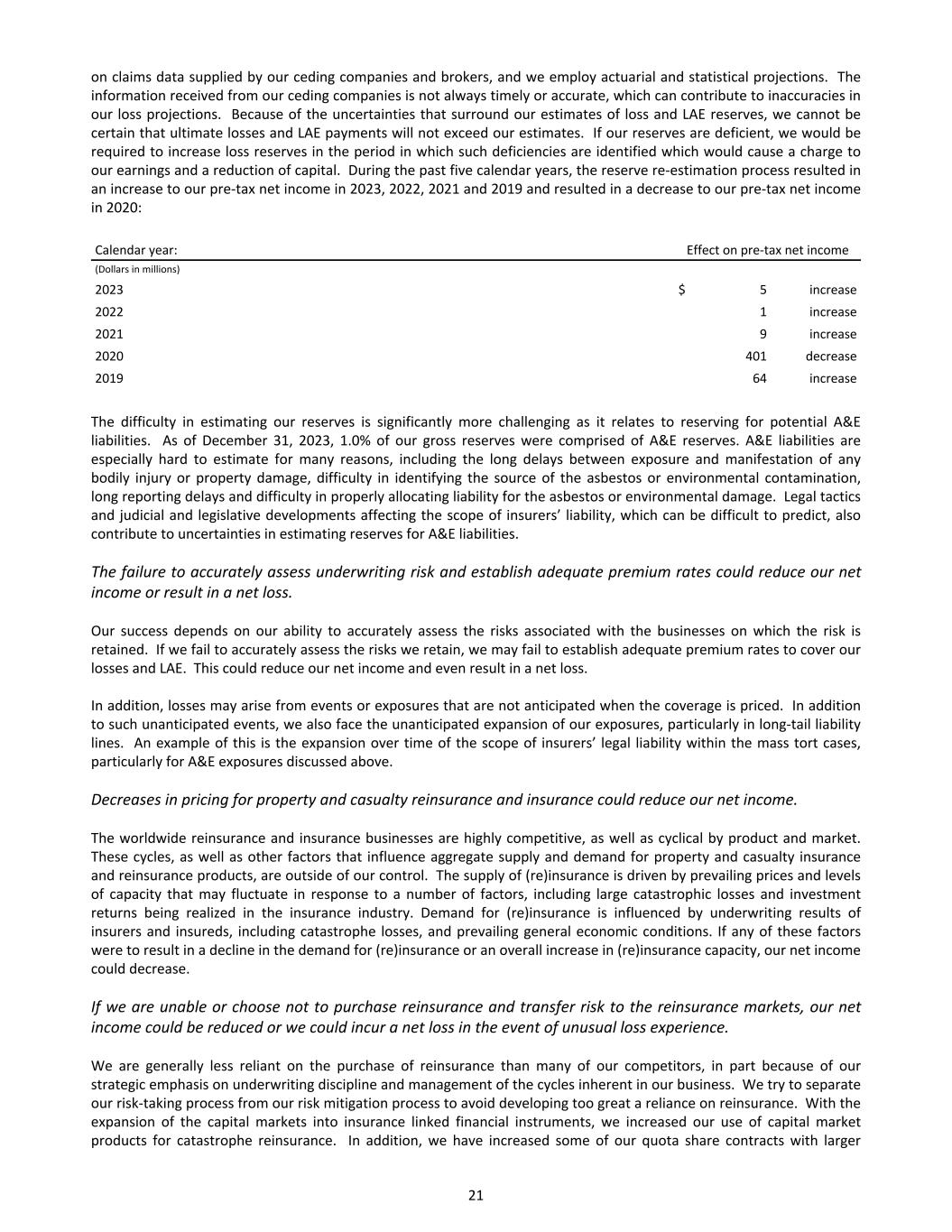
on claims data supplied by our ceding companies and brokers, and we employ actuarial and statistical projections. The information received from our ceding companies is not always timely or accurate, which can contribute to inaccuracies in our loss projections. Because of the uncertainties that surround our estimates of loss and LAE reserves, we cannot be certain that ultimate losses and LAE payments will not exceed our estimates. If our reserves are deficient, we would be required to increase loss reserves in the period in which such deficiencies are identified which would cause a charge to our earnings and a reduction of capital. During the past five calendar years, the reserve re-estimation process resulted in an increase to our pre-tax net income in 2023, 2022, 2021 and 2019 and resulted in a decrease to our pre-tax net income in 2020: Calendar year: Effect on pre-tax net income (Dollars in millions) 2023 $ 5 increase 2022 1 increase 2021 9 increase 2020 401 decrease 2019 64 increase The difficulty in estimating our reserves is significantly more challenging as it relates to reserving for potential A&E liabilities. As of December 31, 2023, 1.0% of our gross reserves were comprised of A&E reserves. A&E liabilities are especially hard to estimate for many reasons, including the long delays between exposure and manifestation of any bodily injury or property damage, difficulty in identifying the source of the asbestos or environmental contamination, long reporting delays and difficulty in properly allocating liability for the asbestos or environmental damage. Legal tactics and judicial and legislative developments affecting the scope of insurers’ liability, which can be difficult to predict, also contribute to uncertainties in estimating reserves for A&E liabilities. The failure to accurately assess underwriting risk and establish adequate premium rates could reduce our net income or result in a net loss. Our success depends on our ability to accurately assess the risks associated with the businesses on which the risk is retained. If we fail to accurately assess the risks we retain, we may fail to establish adequate premium rates to cover our losses and LAE. This could reduce our net income and even result in a net loss. In addition, losses may arise from events or exposures that are not anticipated when the coverage is priced. In addition to such unanticipated events, we also face the unanticipated expansion of our exposures, particularly in long-tail liability lines. An example of this is the expansion over time of the scope of insurers’ legal liability within the mass tort cases, particularly for A&E exposures discussed above. Decreases in pricing for property and casualty reinsurance and insurance could reduce our net income. The worldwide reinsurance and insurance businesses are highly competitive, as well as cyclical by product and market. These cycles, as well as other factors that influence aggregate supply and demand for property and casualty insurance and reinsurance products, are outside of our control. The supply of (re)insurance is driven by prevailing prices and levels of capacity that may fluctuate in response to a number of factors, including large catastrophic losses and investment returns being realized in the insurance industry. Demand for (re)insurance is influenced by underwriting results of insurers and insureds, including catastrophe losses, and prevailing general economic conditions. If any of these factors were to result in a decline in the demand for (re)insurance or an overall increase in (re)insurance capacity, our net income could decrease. If we are unable or choose not to purchase reinsurance and transfer risk to the reinsurance markets, our net income could be reduced or we could incur a net loss in the event of unusual loss experience. We are generally less reliant on the purchase of reinsurance than many of our competitors, in part because of our strategic emphasis on underwriting discipline and management of the cycles inherent in our business. We try to separate our risk-taking process from our risk mitigation process to avoid developing too great a reliance on reinsurance. With the expansion of the capital markets into insurance linked financial instruments, we increased our use of capital market products for catastrophe reinsurance. In addition, we have increased some of our quota share contracts with larger 21
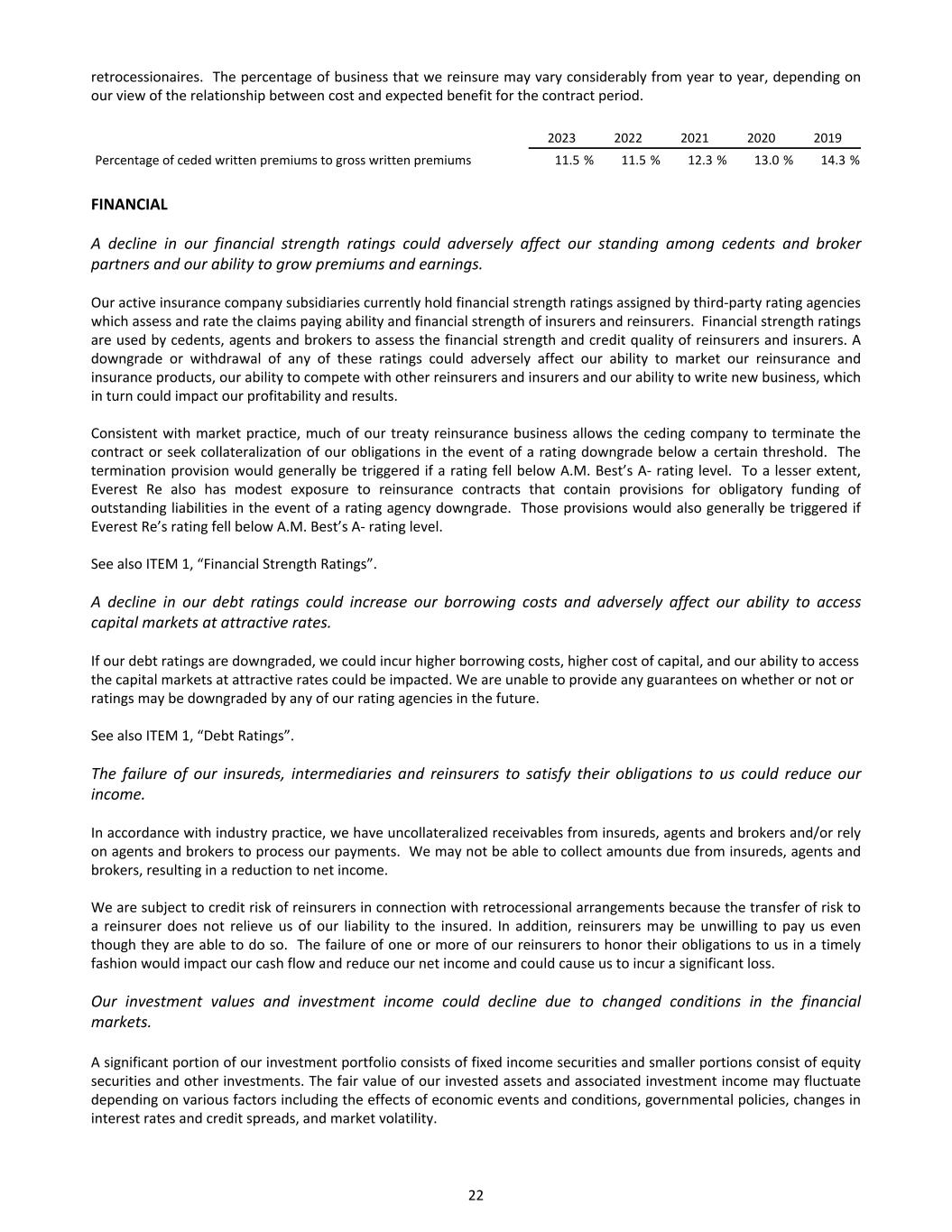
retrocessionaires. The percentage of business that we reinsure may vary considerably from year to year, depending on our view of the relationship between cost and expected benefit for the contract period. 2023 2022 2021 2020 2019 Percentage of ceded written premiums to gross written premiums 11.5 % 11.5 % 12.3 % 13.0 % 14.3 % FINANCIAL A decline in our financial strength ratings could adversely affect our standing among cedents and broker partners and our ability to grow premiums and earnings. Our active insurance company subsidiaries currently hold financial strength ratings assigned by third-party rating agencies which assess and rate the claims paying ability and financial strength of insurers and reinsurers. Financial strength ratings are used by cedents, agents and brokers to assess the financial strength and credit quality of reinsurers and insurers. A downgrade or withdrawal of any of these ratings could adversely affect our ability to market our reinsurance and insurance products, our ability to compete with other reinsurers and insurers and our ability to write new business, which in turn could impact our profitability and results. Consistent with market practice, much of our treaty reinsurance business allows the ceding company to terminate the contract or seek collateralization of our obligations in the event of a rating downgrade below a certain threshold. The termination provision would generally be triggered if a rating fell below A.M. Best’s A- rating level. To a lesser extent, Everest Re also has modest exposure to reinsurance contracts that contain provisions for obligatory funding of outstanding liabilities in the event of a rating agency downgrade. Those provisions would also generally be triggered if Everest Re’s rating fell below A.M. Best’s A- rating level. See also ITEM 1, “Financial Strength Ratings”. A decline in our debt ratings could increase our borrowing costs and adversely affect our ability to access capital markets at attractive rates. If our debt ratings are downgraded, we could incur higher borrowing costs, higher cost of capital, and our ability to access the capital markets at attractive rates could be impacted. We are unable to provide any guarantees on whether or not or ratings may be downgraded by any of our rating agencies in the future. See also ITEM 1, “Debt Ratings”. The failure of our insureds, intermediaries and reinsurers to satisfy their obligations to us could reduce our income. In accordance with industry practice, we have uncollateralized receivables from insureds, agents and brokers and/or rely on agents and brokers to process our payments. We may not be able to collect amounts due from insureds, agents and brokers, resulting in a reduction to net income. We are subject to credit risk of reinsurers in connection with retrocessional arrangements because the transfer of risk to a reinsurer does not relieve us of our liability to the insured. In addition, reinsurers may be unwilling to pay us even though they are able to do so. The failure of one or more of our reinsurers to honor their obligations to us in a timely fashion would impact our cash flow and reduce our net income and could cause us to incur a significant loss. Our investment values and investment income could decline due to changed conditions in the financial markets. A significant portion of our investment portfolio consists of fixed income securities and smaller portions consist of equity securities and other investments. The fair value of our invested assets and associated investment income may fluctuate depending on various factors including the effects of economic events and conditions, governmental policies, changes in interest rates and credit spreads, and market volatility. 22
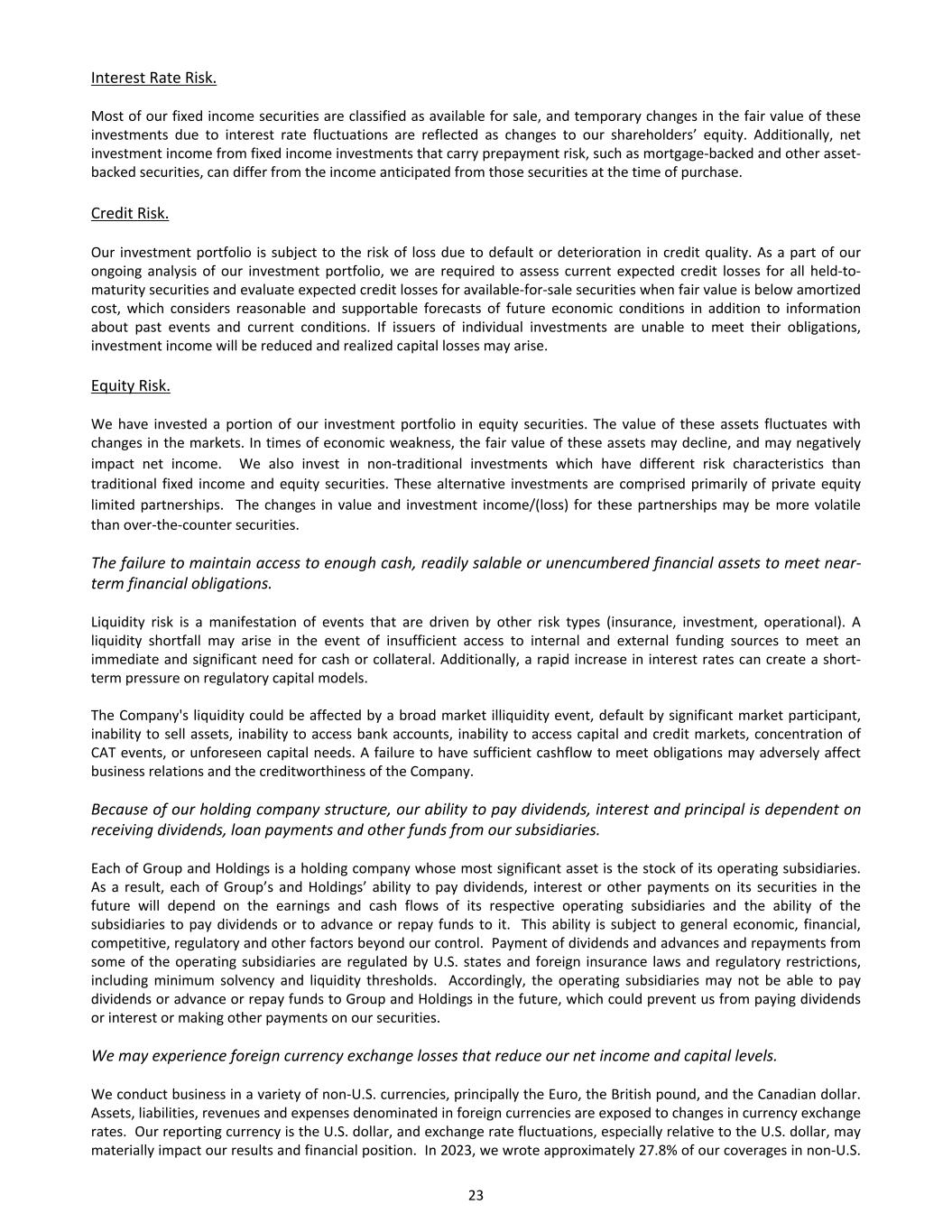
Interest Rate Risk. Most of our fixed income securities are classified as available for sale, and temporary changes in the fair value of these investments due to interest rate fluctuations are reflected as changes to our shareholders’ equity. Additionally, net investment income from fixed income investments that carry prepayment risk, such as mortgage-backed and other asset- backed securities, can differ from the income anticipated from those securities at the time of purchase. Credit Risk. Our investment portfolio is subject to the risk of loss due to default or deterioration in credit quality. As a part of our ongoing analysis of our investment portfolio, we are required to assess current expected credit losses for all held-to- maturity securities and evaluate expected credit losses for available-for-sale securities when fair value is below amortized cost, which considers reasonable and supportable forecasts of future economic conditions in addition to information about past events and current conditions. If issuers of individual investments are unable to meet their obligations, investment income will be reduced and realized capital losses may arise. Equity Risk. We have invested a portion of our investment portfolio in equity securities. The value of these assets fluctuates with changes in the markets. In times of economic weakness, the fair value of these assets may decline, and may negatively impact net income. We also invest in non-traditional investments which have different risk characteristics than traditional fixed income and equity securities. These alternative investments are comprised primarily of private equity limited partnerships. The changes in value and investment income/(loss) for these partnerships may be more volatile than over-the-counter securities. The failure to maintain access to enough cash, readily salable or unencumbered financial assets to meet near- term financial obligations. Liquidity risk is a manifestation of events that are driven by other risk types (insurance, investment, operational). A liquidity shortfall may arise in the event of insufficient access to internal and external funding sources to meet an immediate and significant need for cash or collateral. Additionally, a rapid increase in interest rates can create a short- term pressure on regulatory capital models. The Company's liquidity could be affected by a broad market illiquidity event, default by significant market participant, inability to sell assets, inability to access bank accounts, inability to access capital and credit markets, concentration of CAT events, or unforeseen capital needs. A failure to have sufficient cashflow to meet obligations may adversely affect business relations and the creditworthiness of the Company. Because of our holding company structure, our ability to pay dividends, interest and principal is dependent on receiving dividends, loan payments and other funds from our subsidiaries. Each of Group and Holdings is a holding company whose most significant asset is the stock of its operating subsidiaries. As a result, each of Group’s and Holdings’ ability to pay dividends, interest or other payments on its securities in the future will depend on the earnings and cash flows of its respective operating subsidiaries and the ability of the subsidiaries to pay dividends or to advance or repay funds to it. This ability is subject to general economic, financial, competitive, regulatory and other factors beyond our control. Payment of dividends and advances and repayments from some of the operating subsidiaries are regulated by U.S. states and foreign insurance laws and regulatory restrictions, including minimum solvency and liquidity thresholds. Accordingly, the operating subsidiaries may not be able to pay dividends or advance or repay funds to Group and Holdings in the future, which could prevent us from paying dividends or interest or making other payments on our securities. We may experience foreign currency exchange losses that reduce our net income and capital levels. We conduct business in a variety of non-U.S. currencies, principally the Euro, the British pound, and the Canadian dollar. Assets, liabilities, revenues and expenses denominated in foreign currencies are exposed to changes in currency exchange rates. Our reporting currency is the U.S. dollar, and exchange rate fluctuations, especially relative to the U.S. dollar, may materially impact our results and financial position. In 2023, we wrote approximately 27.8% of our coverages in non-U.S. 23
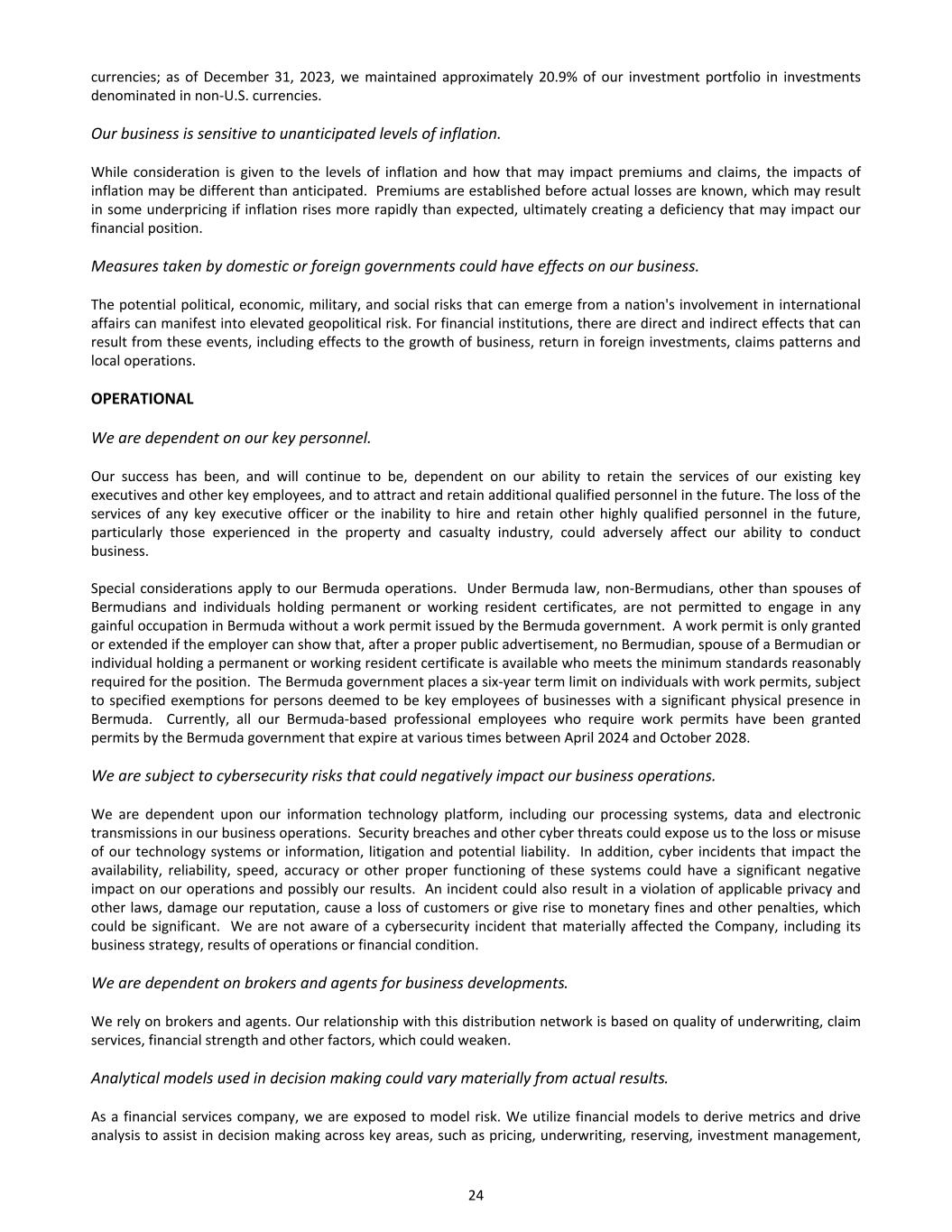
currencies; as of December 31, 2023, we maintained approximately 20.9% of our investment portfolio in investments denominated in non-U.S. currencies. Our business is sensitive to unanticipated levels of inflation. While consideration is given to the levels of inflation and how that may impact premiums and claims, the impacts of inflation may be different than anticipated. Premiums are established before actual losses are known, which may result in some underpricing if inflation rises more rapidly than expected, ultimately creating a deficiency that may impact our financial position. Measures taken by domestic or foreign governments could have effects on our business. The potential political, economic, military, and social risks that can emerge from a nation's involvement in international affairs can manifest into elevated geopolitical risk. For financial institutions, there are direct and indirect effects that can result from these events, including effects to the growth of business, return in foreign investments, claims patterns and local operations. OPERATIONAL We are dependent on our key personnel. Our success has been, and will continue to be, dependent on our ability to retain the services of our existing key executives and other key employees, and to attract and retain additional qualified personnel in the future. The loss of the services of any key executive officer or the inability to hire and retain other highly qualified personnel in the future, particularly those experienced in the property and casualty industry, could adversely affect our ability to conduct business. Special considerations apply to our Bermuda operations. Under Bermuda law, non-Bermudians, other than spouses of Bermudians and individuals holding permanent or working resident certificates, are not permitted to engage in any gainful occupation in Bermuda without a work permit issued by the Bermuda government. A work permit is only granted or extended if the employer can show that, after a proper public advertisement, no Bermudian, spouse of a Bermudian or individual holding a permanent or working resident certificate is available who meets the minimum standards reasonably required for the position. The Bermuda government places a six-year term limit on individuals with work permits, subject to specified exemptions for persons deemed to be key employees of businesses with a significant physical presence in Bermuda. Currently, all our Bermuda-based professional employees who require work permits have been granted permits by the Bermuda government that expire at various times between April 2024 and October 2028. We are subject to cybersecurity risks that could negatively impact our business operations. We are dependent upon our information technology platform, including our processing systems, data and electronic transmissions in our business operations. Security breaches and other cyber threats could expose us to the loss or misuse of our technology systems or information, litigation and potential liability. In addition, cyber incidents that impact the availability, reliability, speed, accuracy or other proper functioning of these systems could have a significant negative impact on our operations and possibly our results. An incident could also result in a violation of applicable privacy and other laws, damage our reputation, cause a loss of customers or give rise to monetary fines and other penalties, which could be significant. We are not aware of a cybersecurity incident that materially affected the Company, including its business strategy, results of operations or financial condition. We are dependent on brokers and agents for business developments. We rely on brokers and agents. Our relationship with this distribution network is based on quality of underwriting, claim services, financial strength and other factors, which could weaken. Analytical models used in decision making could vary materially from actual results. As a financial services company, we are exposed to model risk. We utilize financial models to derive metrics and drive analysis to assist in decision making across key areas, such as pricing, underwriting, reserving, investment management, 24
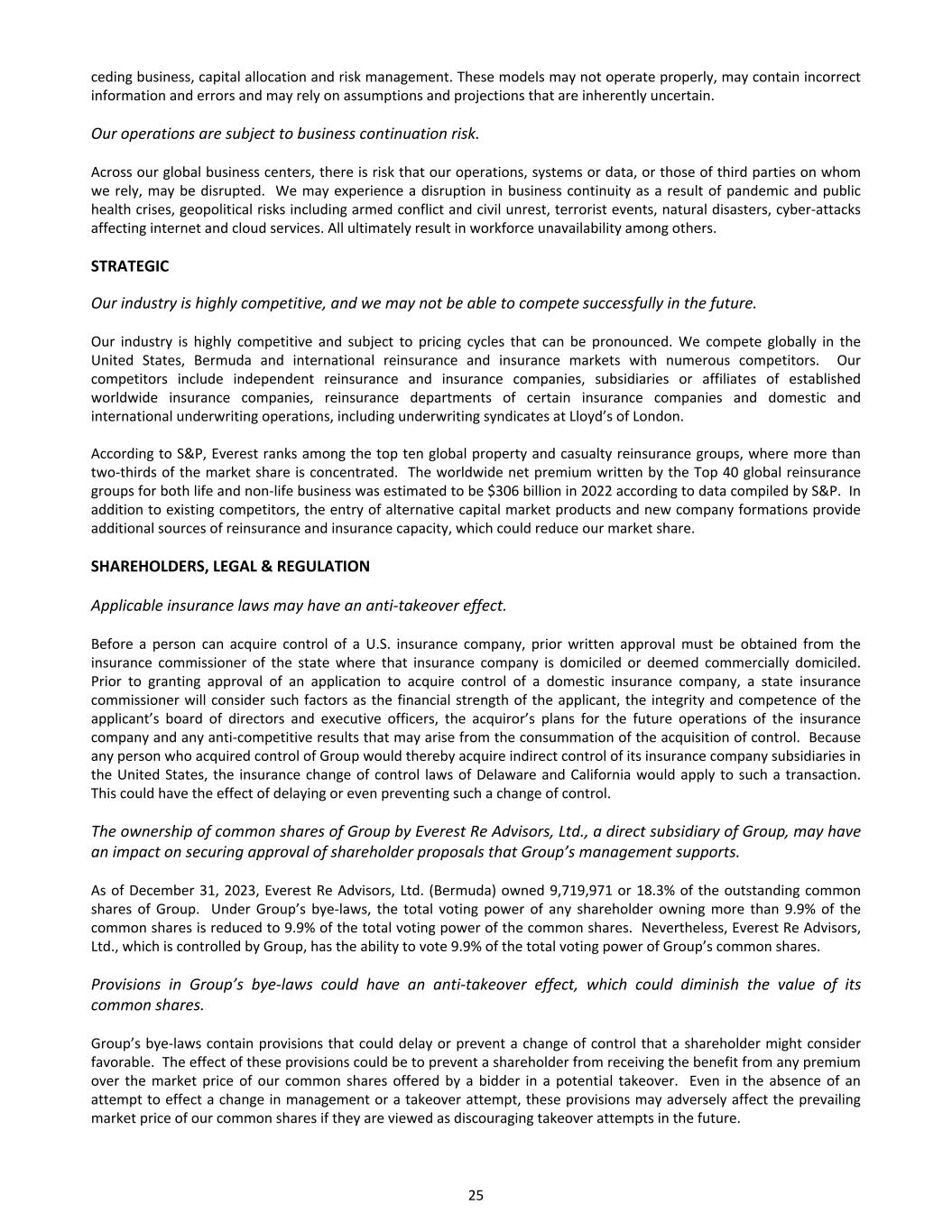
ceding business, capital allocation and risk management. These models may not operate properly, may contain incorrect information and errors and may rely on assumptions and projections that are inherently uncertain. Our operations are subject to business continuation risk. Across our global business centers, there is risk that our operations, systems or data, or those of third parties on whom we rely, may be disrupted. We may experience a disruption in business continuity as a result of pandemic and public health crises, geopolitical risks including armed conflict and civil unrest, terrorist events, natural disasters, cyber-attacks affecting internet and cloud services. All ultimately result in workforce unavailability among others. STRATEGIC Our industry is highly competitive, and we may not be able to compete successfully in the future. Our industry is highly competitive and subject to pricing cycles that can be pronounced. We compete globally in the United States, Bermuda and international reinsurance and insurance markets with numerous competitors. Our competitors include independent reinsurance and insurance companies, subsidiaries or affiliates of established worldwide insurance companies, reinsurance departments of certain insurance companies and domestic and international underwriting operations, including underwriting syndicates at Lloyd’s of London. According to S&P, Everest ranks among the top ten global property and casualty reinsurance groups, where more than two-thirds of the market share is concentrated. The worldwide net premium written by the Top 40 global reinsurance groups for both life and non-life business was estimated to be $306 billion in 2022 according to data compiled by S&P. In addition to existing competitors, the entry of alternative capital market products and new company formations provide additional sources of reinsurance and insurance capacity, which could reduce our market share. SHAREHOLDERS, LEGAL & REGULATION Applicable insurance laws may have an anti-takeover effect. Before a person can acquire control of a U.S. insurance company, prior written approval must be obtained from the insurance commissioner of the state where that insurance company is domiciled or deemed commercially domiciled. Prior to granting approval of an application to acquire control of a domestic insurance company, a state insurance commissioner will consider such factors as the financial strength of the applicant, the integrity and competence of the applicant’s board of directors and executive officers, the acquiror’s plans for the future operations of the insurance company and any anti-competitive results that may arise from the consummation of the acquisition of control. Because any person who acquired control of Group would thereby acquire indirect control of its insurance company subsidiaries in the United States, the insurance change of control laws of Delaware and California would apply to such a transaction. This could have the effect of delaying or even preventing such a change of control. The ownership of common shares of Group by Everest Re Advisors, Ltd., a direct subsidiary of Group, may have an impact on securing approval of shareholder proposals that Group’s management supports. As of December 31, 2023, Everest Re Advisors, Ltd. (Bermuda) owned 9,719,971 or 18.3% of the outstanding common shares of Group. Under Group’s bye-laws, the total voting power of any shareholder owning more than 9.9% of the common shares is reduced to 9.9% of the total voting power of the common shares. Nevertheless, Everest Re Advisors, Ltd., which is controlled by Group, has the ability to vote 9.9% of the total voting power of Group’s common shares. Provisions in Group’s bye-laws could have an anti-takeover effect, which could diminish the value of its common shares. Group’s bye-laws contain provisions that could delay or prevent a change of control that a shareholder might consider favorable. The effect of these provisions could be to prevent a shareholder from receiving the benefit from any premium over the market price of our common shares offered by a bidder in a potential takeover. Even in the absence of an attempt to effect a change in management or a takeover attempt, these provisions may adversely affect the prevailing market price of our common shares if they are viewed as discouraging takeover attempts in the future. 25
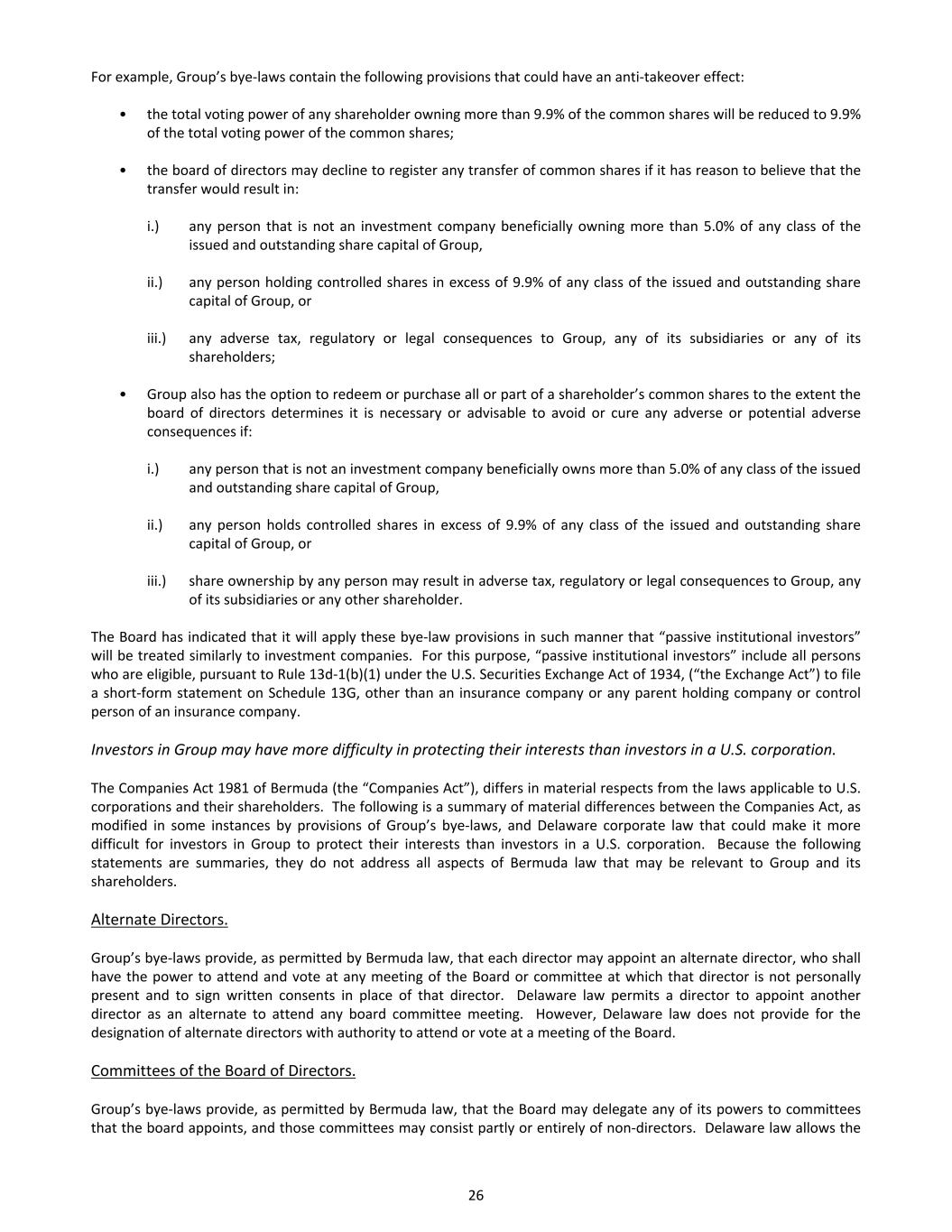
For example, Group’s bye-laws contain the following provisions that could have an anti-takeover effect: • the total voting power of any shareholder owning more than 9.9% of the common shares will be reduced to 9.9% of the total voting power of the common shares; • the board of directors may decline to register any transfer of common shares if it has reason to believe that the transfer would result in: i.) any person that is not an investment company beneficially owning more than 5.0% of any class of the issued and outstanding share capital of Group, ii.) any person holding controlled shares in excess of 9.9% of any class of the issued and outstanding share capital of Group, or iii.) any adverse tax, regulatory or legal consequences to Group, any of its subsidiaries or any of its shareholders; • Group also has the option to redeem or purchase all or part of a shareholder’s common shares to the extent the board of directors determines it is necessary or advisable to avoid or cure any adverse or potential adverse consequences if: i.) any person that is not an investment company beneficially owns more than 5.0% of any class of the issued and outstanding share capital of Group, ii.) any person holds controlled shares in excess of 9.9% of any class of the issued and outstanding share capital of Group, or iii.) share ownership by any person may result in adverse tax, regulatory or legal consequences to Group, any of its subsidiaries or any other shareholder. The Board has indicated that it will apply these bye-law provisions in such manner that “passive institutional investors” will be treated similarly to investment companies. For this purpose, “passive institutional investors” include all persons who are eligible, pursuant to Rule 13d-1(b)(1) under the U.S. Securities Exchange Act of 1934, (“the Exchange Act”) to file a short-form statement on Schedule 13G, other than an insurance company or any parent holding company or control person of an insurance company. Investors in Group may have more difficulty in protecting their interests than investors in a U.S. corporation. The Companies Act 1981 of Bermuda (the “Companies Act”), differs in material respects from the laws applicable to U.S. corporations and their shareholders. The following is a summary of material differences between the Companies Act, as modified in some instances by provisions of Group’s bye-laws, and Delaware corporate law that could make it more difficult for investors in Group to protect their interests than investors in a U.S. corporation. Because the following statements are summaries, they do not address all aspects of Bermuda law that may be relevant to Group and its shareholders. Alternate Directors. Group’s bye-laws provide, as permitted by Bermuda law, that each director may appoint an alternate director, who shall have the power to attend and vote at any meeting of the Board or committee at which that director is not personally present and to sign written consents in place of that director. Delaware law permits a director to appoint another director as an alternate to attend any board committee meeting. However, Delaware law does not provide for the designation of alternate directors with authority to attend or vote at a meeting of the Board. Committees of the Board of Directors. Group’s bye-laws provide, as permitted by Bermuda law, that the Board may delegate any of its powers to committees that the board appoints, and those committees may consist partly or entirely of non-directors. Delaware law allows the 26
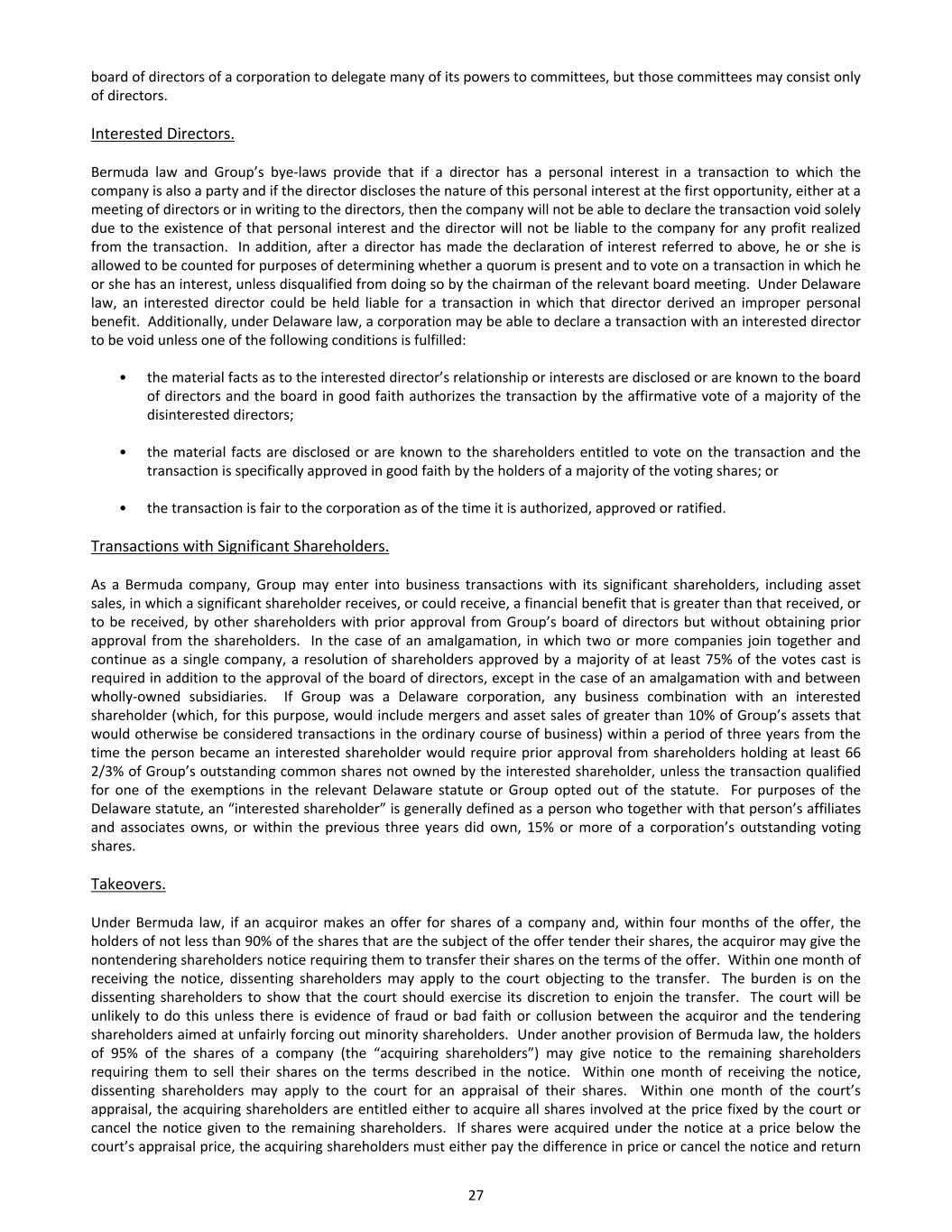
board of directors of a corporation to delegate many of its powers to committees, but those committees may consist only of directors. Interested Directors. Bermuda law and Group’s bye-laws provide that if a director has a personal interest in a transaction to which the company is also a party and if the director discloses the nature of this personal interest at the first opportunity, either at a meeting of directors or in writing to the directors, then the company will not be able to declare the transaction void solely due to the existence of that personal interest and the director will not be liable to the company for any profit realized from the transaction. In addition, after a director has made the declaration of interest referred to above, he or she is allowed to be counted for purposes of determining whether a quorum is present and to vote on a transaction in which he or she has an interest, unless disqualified from doing so by the chairman of the relevant board meeting. Under Delaware law, an interested director could be held liable for a transaction in which that director derived an improper personal benefit. Additionally, under Delaware law, a corporation may be able to declare a transaction with an interested director to be void unless one of the following conditions is fulfilled: • the material facts as to the interested director’s relationship or interests are disclosed or are known to the board of directors and the board in good faith authorizes the transaction by the affirmative vote of a majority of the disinterested directors; • the material facts are disclosed or are known to the shareholders entitled to vote on the transaction and the transaction is specifically approved in good faith by the holders of a majority of the voting shares; or • the transaction is fair to the corporation as of the time it is authorized, approved or ratified. Transactions with Significant Shareholders. As a Bermuda company, Group may enter into business transactions with its significant shareholders, including asset sales, in which a significant shareholder receives, or could receive, a financial benefit that is greater than that received, or to be received, by other shareholders with prior approval from Group’s board of directors but without obtaining prior approval from the shareholders. In the case of an amalgamation, in which two or more companies join together and continue as a single company, a resolution of shareholders approved by a majority of at least 75% of the votes cast is required in addition to the approval of the board of directors, except in the case of an amalgamation with and between wholly-owned subsidiaries. If Group was a Delaware corporation, any business combination with an interested shareholder (which, for this purpose, would include mergers and asset sales of greater than 10% of Group’s assets that would otherwise be considered transactions in the ordinary course of business) within a period of three years from the time the person became an interested shareholder would require prior approval from shareholders holding at least 66 2/3% of Group’s outstanding common shares not owned by the interested shareholder, unless the transaction qualified for one of the exemptions in the relevant Delaware statute or Group opted out of the statute. For purposes of the Delaware statute, an “interested shareholder” is generally defined as a person who together with that person’s affiliates and associates owns, or within the previous three years did own, 15% or more of a corporation’s outstanding voting shares. Takeovers. Under Bermuda law, if an acquiror makes an offer for shares of a company and, within four months of the offer, the holders of not less than 90% of the shares that are the subject of the offer tender their shares, the acquiror may give the nontendering shareholders notice requiring them to transfer their shares on the terms of the offer. Within one month of receiving the notice, dissenting shareholders may apply to the court objecting to the transfer. The burden is on the dissenting shareholders to show that the court should exercise its discretion to enjoin the transfer. The court will be unlikely to do this unless there is evidence of fraud or bad faith or collusion between the acquiror and the tendering shareholders aimed at unfairly forcing out minority shareholders. Under another provision of Bermuda law, the holders of 95% of the shares of a company (the “acquiring shareholders”) may give notice to the remaining shareholders requiring them to sell their shares on the terms described in the notice. Within one month of receiving the notice, dissenting shareholders may apply to the court for an appraisal of their shares. Within one month of the court’s appraisal, the acquiring shareholders are entitled either to acquire all shares involved at the price fixed by the court or cancel the notice given to the remaining shareholders. If shares were acquired under the notice at a price below the court’s appraisal price, the acquiring shareholders must either pay the difference in price or cancel the notice and return 27
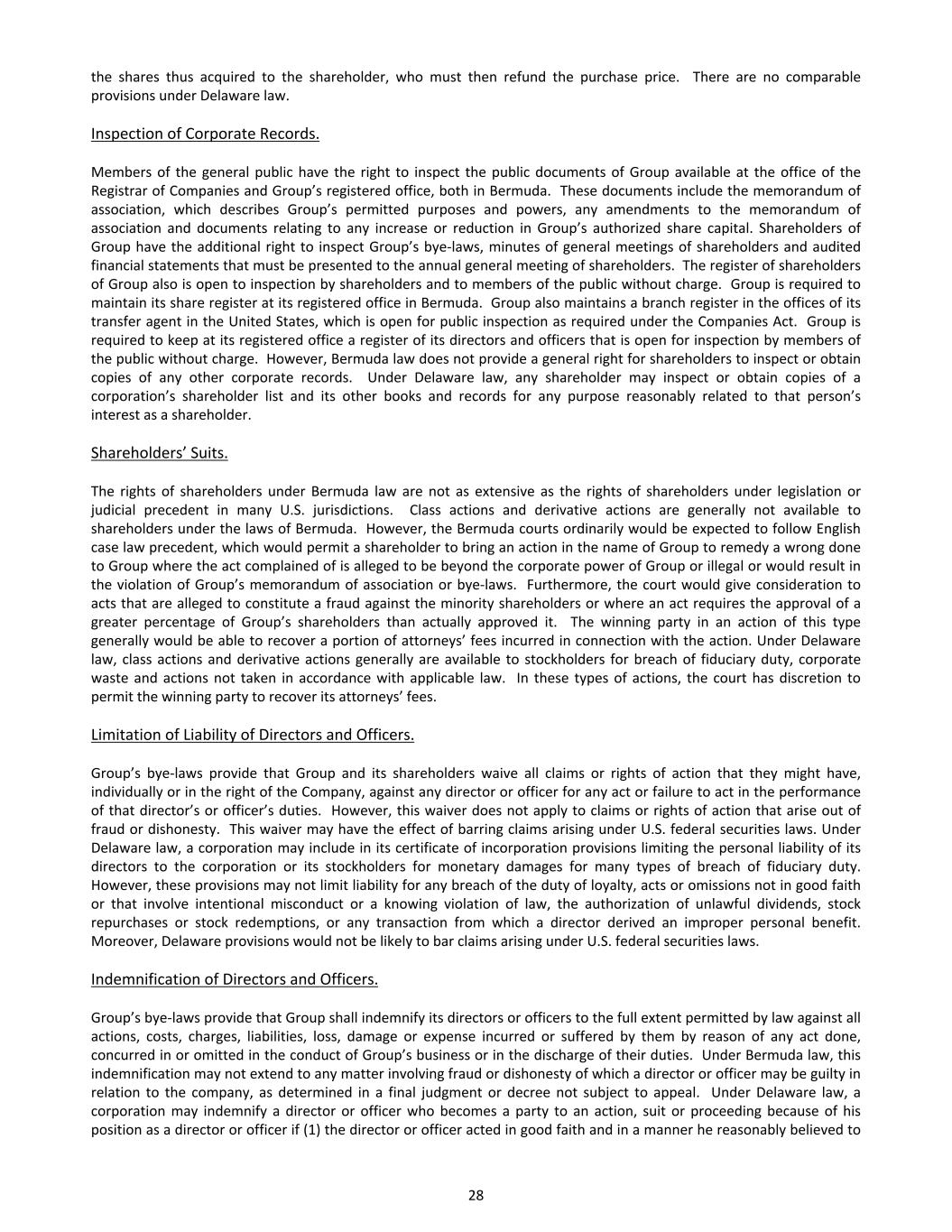
the shares thus acquired to the shareholder, who must then refund the purchase price. There are no comparable provisions under Delaware law. Inspection of Corporate Records. Members of the general public have the right to inspect the public documents of Group available at the office of the Registrar of Companies and Group’s registered office, both in Bermuda. These documents include the memorandum of association, which describes Group’s permitted purposes and powers, any amendments to the memorandum of association and documents relating to any increase or reduction in Group’s authorized share capital. Shareholders of Group have the additional right to inspect Group’s bye-laws, minutes of general meetings of shareholders and audited financial statements that must be presented to the annual general meeting of shareholders. The register of shareholders of Group also is open to inspection by shareholders and to members of the public without charge. Group is required to maintain its share register at its registered office in Bermuda. Group also maintains a branch register in the offices of its transfer agent in the United States, which is open for public inspection as required under the Companies Act. Group is required to keep at its registered office a register of its directors and officers that is open for inspection by members of the public without charge. However, Bermuda law does not provide a general right for shareholders to inspect or obtain copies of any other corporate records. Under Delaware law, any shareholder may inspect or obtain copies of a corporation’s shareholder list and its other books and records for any purpose reasonably related to that person’s interest as a shareholder. Shareholders’ Suits. The rights of shareholders under Bermuda law are not as extensive as the rights of shareholders under legislation or judicial precedent in many U.S. jurisdictions. Class actions and derivative actions are generally not available to shareholders under the laws of Bermuda. However, the Bermuda courts ordinarily would be expected to follow English case law precedent, which would permit a shareholder to bring an action in the name of Group to remedy a wrong done to Group where the act complained of is alleged to be beyond the corporate power of Group or illegal or would result in the violation of Group’s memorandum of association or bye-laws. Furthermore, the court would give consideration to acts that are alleged to constitute a fraud against the minority shareholders or where an act requires the approval of a greater percentage of Group’s shareholders than actually approved it. The winning party in an action of this type generally would be able to recover a portion of attorneys’ fees incurred in connection with the action. Under Delaware law, class actions and derivative actions generally are available to stockholders for breach of fiduciary duty, corporate waste and actions not taken in accordance with applicable law. In these types of actions, the court has discretion to permit the winning party to recover its attorneys’ fees. Limitation of Liability of Directors and Officers. Group’s bye-laws provide that Group and its shareholders waive all claims or rights of action that they might have, individually or in the right of the Company, against any director or officer for any act or failure to act in the performance of that director’s or officer’s duties. However, this waiver does not apply to claims or rights of action that arise out of fraud or dishonesty. This waiver may have the effect of barring claims arising under U.S. federal securities laws. Under Delaware law, a corporation may include in its certificate of incorporation provisions limiting the personal liability of its directors to the corporation or its stockholders for monetary damages for many types of breach of fiduciary duty. However, these provisions may not limit liability for any breach of the duty of loyalty, acts or omissions not in good faith or that involve intentional misconduct or a knowing violation of law, the authorization of unlawful dividends, stock repurchases or stock redemptions, or any transaction from which a director derived an improper personal benefit. Moreover, Delaware provisions would not be likely to bar claims arising under U.S. federal securities laws. Indemnification of Directors and Officers. Group’s bye-laws provide that Group shall indemnify its directors or officers to the full extent permitted by law against all actions, costs, charges, liabilities, loss, damage or expense incurred or suffered by them by reason of any act done, concurred in or omitted in the conduct of Group’s business or in the discharge of their duties. Under Bermuda law, this indemnification may not extend to any matter involving fraud or dishonesty of which a director or officer may be guilty in relation to the company, as determined in a final judgment or decree not subject to appeal. Under Delaware law, a corporation may indemnify a director or officer who becomes a party to an action, suit or proceeding because of his position as a director or officer if (1) the director or officer acted in good faith and in a manner he reasonably believed to 28
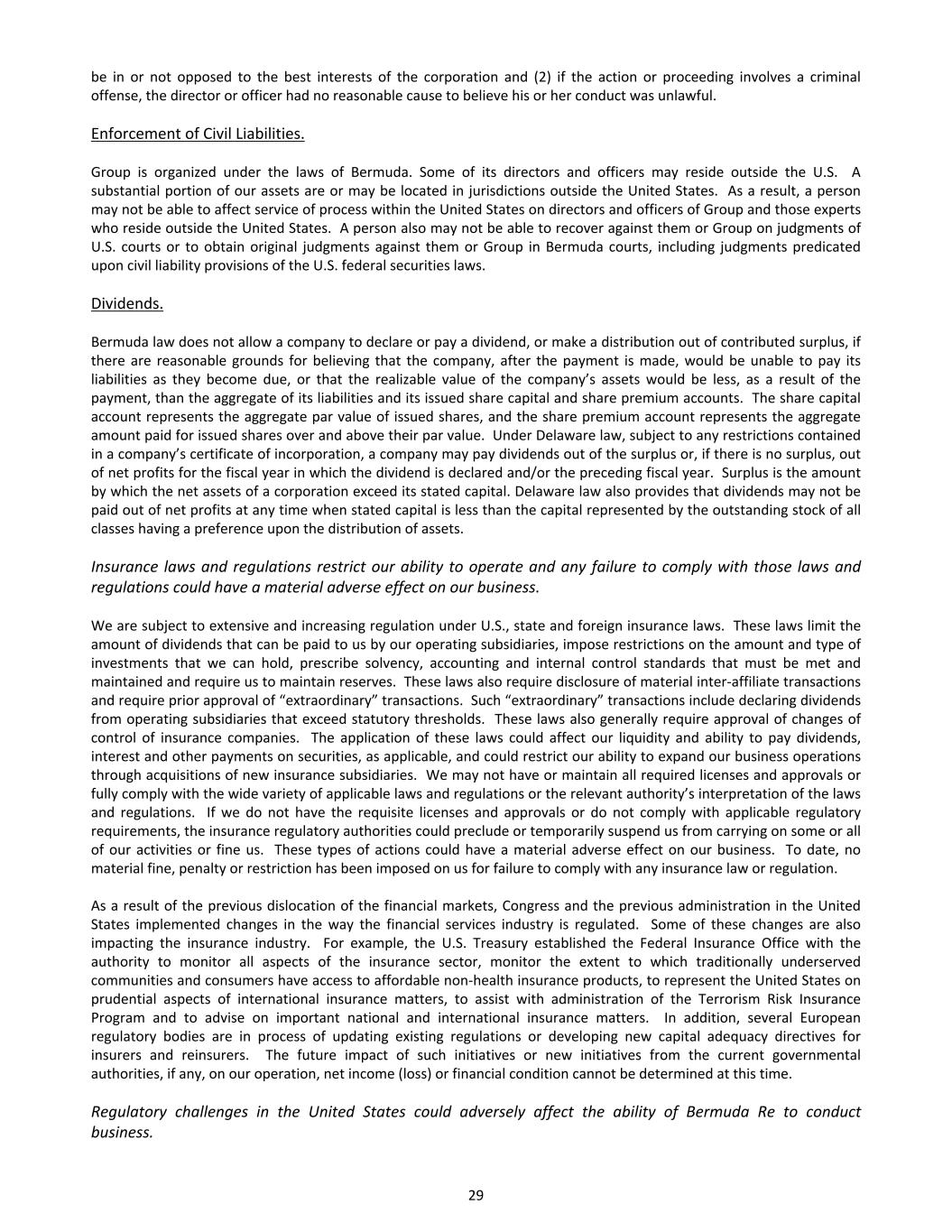
be in or not opposed to the best interests of the corporation and (2) if the action or proceeding involves a criminal offense, the director or officer had no reasonable cause to believe his or her conduct was unlawful. Enforcement of Civil Liabilities. Group is organized under the laws of Bermuda. Some of its directors and officers may reside outside the U.S. A substantial portion of our assets are or may be located in jurisdictions outside the United States. As a result, a person may not be able to affect service of process within the United States on directors and officers of Group and those experts who reside outside the United States. A person also may not be able to recover against them or Group on judgments of U.S. courts or to obtain original judgments against them or Group in Bermuda courts, including judgments predicated upon civil liability provisions of the U.S. federal securities laws. Dividends. Bermuda law does not allow a company to declare or pay a dividend, or make a distribution out of contributed surplus, if there are reasonable grounds for believing that the company, after the payment is made, would be unable to pay its liabilities as they become due, or that the realizable value of the company’s assets would be less, as a result of the payment, than the aggregate of its liabilities and its issued share capital and share premium accounts. The share capital account represents the aggregate par value of issued shares, and the share premium account represents the aggregate amount paid for issued shares over and above their par value. Under Delaware law, subject to any restrictions contained in a company’s certificate of incorporation, a company may pay dividends out of the surplus or, if there is no surplus, out of net profits for the fiscal year in which the dividend is declared and/or the preceding fiscal year. Surplus is the amount by which the net assets of a corporation exceed its stated capital. Delaware law also provides that dividends may not be paid out of net profits at any time when stated capital is less than the capital represented by the outstanding stock of all classes having a preference upon the distribution of assets. Insurance laws and regulations restrict our ability to operate and any failure to comply with those laws and regulations could have a material adverse effect on our business. We are subject to extensive and increasing regulation under U.S., state and foreign insurance laws. These laws limit the amount of dividends that can be paid to us by our operating subsidiaries, impose restrictions on the amount and type of investments that we can hold, prescribe solvency, accounting and internal control standards that must be met and maintained and require us to maintain reserves. These laws also require disclosure of material inter-affiliate transactions and require prior approval of “extraordinary” transactions. Such “extraordinary” transactions include declaring dividends from operating subsidiaries that exceed statutory thresholds. These laws also generally require approval of changes of control of insurance companies. The application of these laws could affect our liquidity and ability to pay dividends, interest and other payments on securities, as applicable, and could restrict our ability to expand our business operations through acquisitions of new insurance subsidiaries. We may not have or maintain all required licenses and approvals or fully comply with the wide variety of applicable laws and regulations or the relevant authority’s interpretation of the laws and regulations. If we do not have the requisite licenses and approvals or do not comply with applicable regulatory requirements, the insurance regulatory authorities could preclude or temporarily suspend us from carrying on some or all of our activities or fine us. These types of actions could have a material adverse effect on our business. To date, no material fine, penalty or restriction has been imposed on us for failure to comply with any insurance law or regulation. As a result of the previous dislocation of the financial markets, Congress and the previous administration in the United States implemented changes in the way the financial services industry is regulated. Some of these changes are also impacting the insurance industry. For example, the U.S. Treasury established the Federal Insurance Office with the authority to monitor all aspects of the insurance sector, monitor the extent to which traditionally underserved communities and consumers have access to affordable non-health insurance products, to represent the United States on prudential aspects of international insurance matters, to assist with administration of the Terrorism Risk Insurance Program and to advise on important national and international insurance matters. In addition, several European regulatory bodies are in process of updating existing regulations or developing new capital adequacy directives for insurers and reinsurers. The future impact of such initiatives or new initiatives from the current governmental authorities, if any, on our operation, net income (loss) or financial condition cannot be determined at this time. Regulatory challenges in the United States could adversely affect the ability of Bermuda Re to conduct business. 29
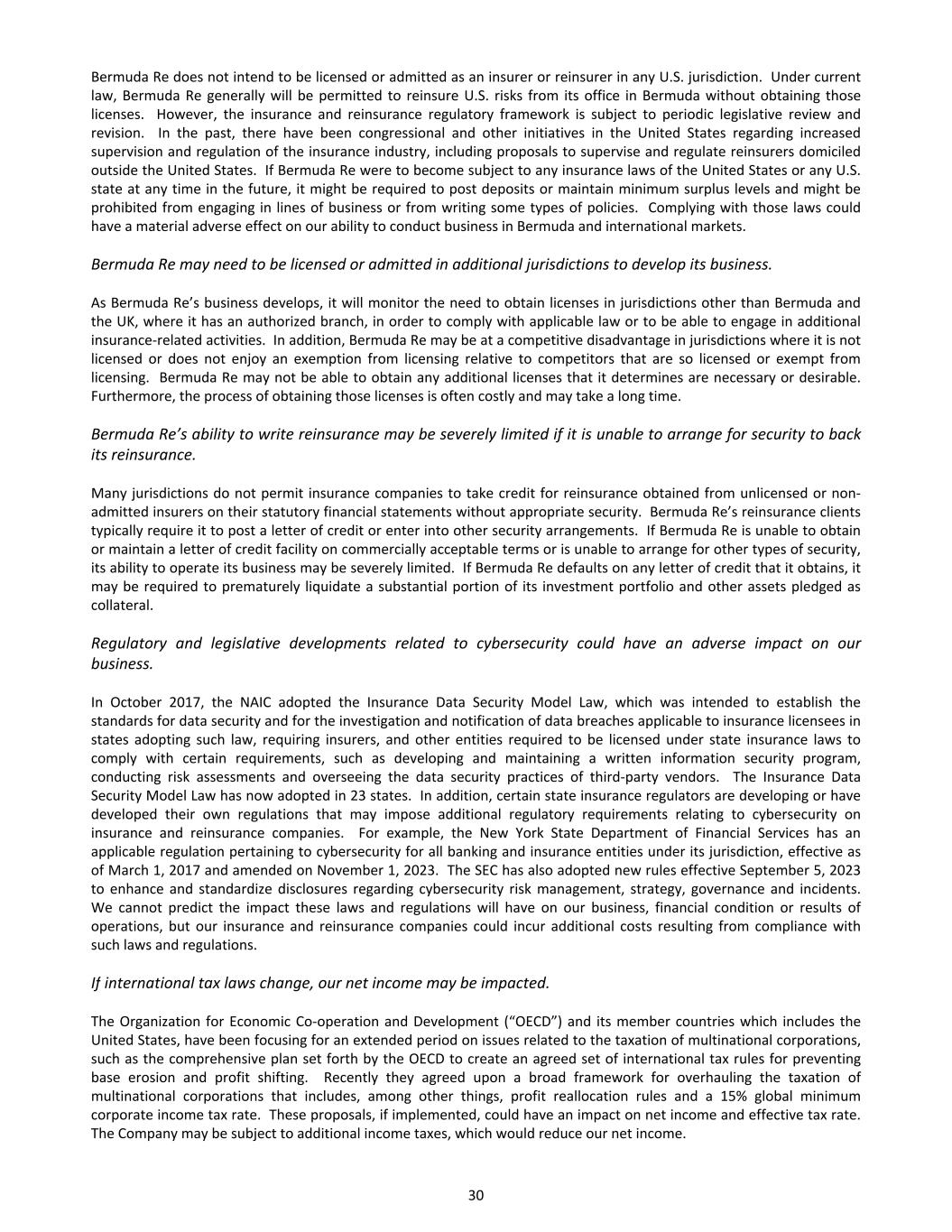
Bermuda Re does not intend to be licensed or admitted as an insurer or reinsurer in any U.S. jurisdiction. Under current law, Bermuda Re generally will be permitted to reinsure U.S. risks from its office in Bermuda without obtaining those licenses. However, the insurance and reinsurance regulatory framework is subject to periodic legislative review and revision. In the past, there have been congressional and other initiatives in the United States regarding increased supervision and regulation of the insurance industry, including proposals to supervise and regulate reinsurers domiciled outside the United States. If Bermuda Re were to become subject to any insurance laws of the United States or any U.S. state at any time in the future, it might be required to post deposits or maintain minimum surplus levels and might be prohibited from engaging in lines of business or from writing some types of policies. Complying with those laws could have a material adverse effect on our ability to conduct business in Bermuda and international markets. Bermuda Re may need to be licensed or admitted in additional jurisdictions to develop its business. As Bermuda Re’s business develops, it will monitor the need to obtain licenses in jurisdictions other than Bermuda and the UK, where it has an authorized branch, in order to comply with applicable law or to be able to engage in additional insurance-related activities. In addition, Bermuda Re may be at a competitive disadvantage in jurisdictions where it is not licensed or does not enjoy an exemption from licensing relative to competitors that are so licensed or exempt from licensing. Bermuda Re may not be able to obtain any additional licenses that it determines are necessary or desirable. Furthermore, the process of obtaining those licenses is often costly and may take a long time. Bermuda Re’s ability to write reinsurance may be severely limited if it is unable to arrange for security to back its reinsurance. Many jurisdictions do not permit insurance companies to take credit for reinsurance obtained from unlicensed or non- admitted insurers on their statutory financial statements without appropriate security. Bermuda Re’s reinsurance clients typically require it to post a letter of credit or enter into other security arrangements. If Bermuda Re is unable to obtain or maintain a letter of credit facility on commercially acceptable terms or is unable to arrange for other types of security, its ability to operate its business may be severely limited. If Bermuda Re defaults on any letter of credit that it obtains, it may be required to prematurely liquidate a substantial portion of its investment portfolio and other assets pledged as collateral. Regulatory and legislative developments related to cybersecurity could have an adverse impact on our business. In October 2017, the NAIC adopted the Insurance Data Security Model Law, which was intended to establish the standards for data security and for the investigation and notification of data breaches applicable to insurance licensees in states adopting such law, requiring insurers, and other entities required to be licensed under state insurance laws to comply with certain requirements, such as developing and maintaining a written information security program, conducting risk assessments and overseeing the data security practices of third-party vendors. The Insurance Data Security Model Law has now adopted in 23 states. In addition, certain state insurance regulators are developing or have developed their own regulations that may impose additional regulatory requirements relating to cybersecurity on insurance and reinsurance companies. For example, the New York State Department of Financial Services has an applicable regulation pertaining to cybersecurity for all banking and insurance entities under its jurisdiction, effective as of March 1, 2017 and amended on November 1, 2023. The SEC has also adopted new rules effective September 5, 2023 to enhance and standardize disclosures regarding cybersecurity risk management, strategy, governance and incidents. We cannot predict the impact these laws and regulations will have on our business, financial condition or results of operations, but our insurance and reinsurance companies could incur additional costs resulting from compliance with such laws and regulations. If international tax laws change, our net income may be impacted. The Organization for Economic Co-operation and Development (“OECD”) and its member countries which includes the United States, have been focusing for an extended period on issues related to the taxation of multinational corporations, such as the comprehensive plan set forth by the OECD to create an agreed set of international tax rules for preventing base erosion and profit shifting. Recently they agreed upon a broad framework for overhauling the taxation of multinational corporations that includes, among other things, profit reallocation rules and a 15% global minimum corporate income tax rate. These proposals, if implemented, could have an impact on net income and effective tax rate. The Company may be subject to additional income taxes, which would reduce our net income. 30
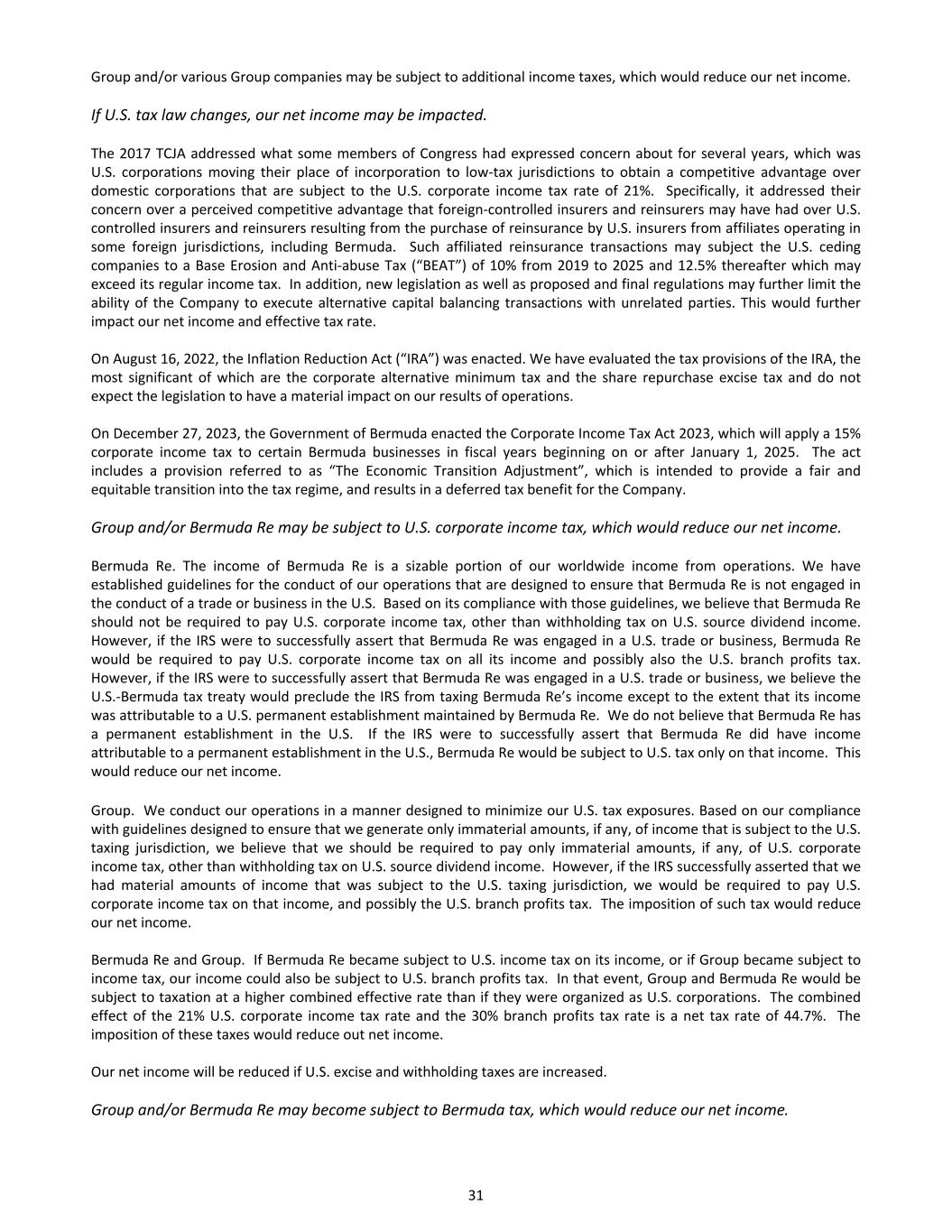
Group and/or various Group companies may be subject to additional income taxes, which would reduce our net income. If U.S. tax law changes, our net income may be impacted. The 2017 TCJA addressed what some members of Congress had expressed concern about for several years, which was U.S. corporations moving their place of incorporation to low-tax jurisdictions to obtain a competitive advantage over domestic corporations that are subject to the U.S. corporate income tax rate of 21%. Specifically, it addressed their concern over a perceived competitive advantage that foreign-controlled insurers and reinsurers may have had over U.S. controlled insurers and reinsurers resulting from the purchase of reinsurance by U.S. insurers from affiliates operating in some foreign jurisdictions, including Bermuda. Such affiliated reinsurance transactions may subject the U.S. ceding companies to a Base Erosion and Anti-abuse Tax (“BEAT”) of 10% from 2019 to 2025 and 12.5% thereafter which may exceed its regular income tax. In addition, new legislation as well as proposed and final regulations may further limit the ability of the Company to execute alternative capital balancing transactions with unrelated parties. This would further impact our net income and effective tax rate. On August 16, 2022, the Inflation Reduction Act (“IRA”) was enacted. We have evaluated the tax provisions of the IRA, the most significant of which are the corporate alternative minimum tax and the share repurchase excise tax and do not expect the legislation to have a material impact on our results of operations. On December 27, 2023, the Government of Bermuda enacted the Corporate Income Tax Act 2023, which will apply a 15% corporate income tax to certain Bermuda businesses in fiscal years beginning on or after January 1, 2025. The act includes a provision referred to as “The Economic Transition Adjustment”, which is intended to provide a fair and equitable transition into the tax regime, and results in a deferred tax benefit for the Company. Group and/or Bermuda Re may be subject to U.S. corporate income tax, which would reduce our net income. Bermuda Re. The income of Bermuda Re is a sizable portion of our worldwide income from operations. We have established guidelines for the conduct of our operations that are designed to ensure that Bermuda Re is not engaged in the conduct of a trade or business in the U.S. Based on its compliance with those guidelines, we believe that Bermuda Re should not be required to pay U.S. corporate income tax, other than withholding tax on U.S. source dividend income. However, if the IRS were to successfully assert that Bermuda Re was engaged in a U.S. trade or business, Bermuda Re would be required to pay U.S. corporate income tax on all its income and possibly also the U.S. branch profits tax. However, if the IRS were to successfully assert that Bermuda Re was engaged in a U.S. trade or business, we believe the U.S.-Bermuda tax treaty would preclude the IRS from taxing Bermuda Re’s income except to the extent that its income was attributable to a U.S. permanent establishment maintained by Bermuda Re. We do not believe that Bermuda Re has a permanent establishment in the U.S. If the IRS were to successfully assert that Bermuda Re did have income attributable to a permanent establishment in the U.S., Bermuda Re would be subject to U.S. tax only on that income. This would reduce our net income. Group. We conduct our operations in a manner designed to minimize our U.S. tax exposures. Based on our compliance with guidelines designed to ensure that we generate only immaterial amounts, if any, of income that is subject to the U.S. taxing jurisdiction, we believe that we should be required to pay only immaterial amounts, if any, of U.S. corporate income tax, other than withholding tax on U.S. source dividend income. However, if the IRS successfully asserted that we had material amounts of income that was subject to the U.S. taxing jurisdiction, we would be required to pay U.S. corporate income tax on that income, and possibly the U.S. branch profits tax. The imposition of such tax would reduce our net income. Bermuda Re and Group. If Bermuda Re became subject to U.S. income tax on its income, or if Group became subject to income tax, our income could also be subject to U.S. branch profits tax. In that event, Group and Bermuda Re would be subject to taxation at a higher combined effective rate than if they were organized as U.S. corporations. The combined effect of the 21% U.S. corporate income tax rate and the 30% branch profits tax rate is a net tax rate of 44.7%. The imposition of these taxes would reduce out net income. Our net income will be reduced if U.S. excise and withholding taxes are increased. Group and/or Bermuda Re may become subject to Bermuda tax, which would reduce our net income. 31
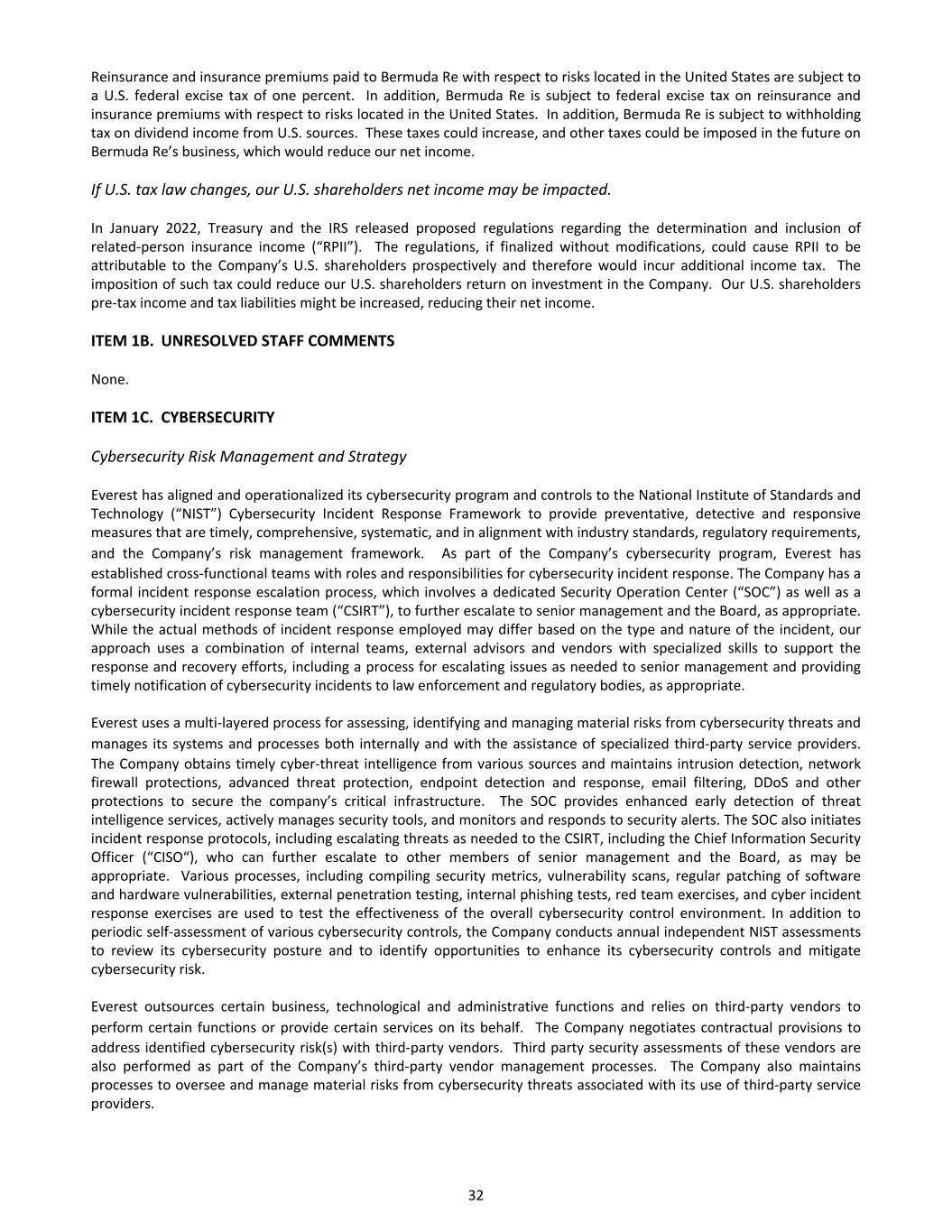
Reinsurance and insurance premiums paid to Bermuda Re with respect to risks located in the United States are subject to a U.S. federal excise tax of one percent. In addition, Bermuda Re is subject to federal excise tax on reinsurance and insurance premiums with respect to risks located in the United States. In addition, Bermuda Re is subject to withholding tax on dividend income from U.S. sources. These taxes could increase, and other taxes could be imposed in the future on Bermuda Re’s business, which would reduce our net income. If U.S. tax law changes, our U.S. shareholders net income may be impacted. In January 2022, Treasury and the IRS released proposed regulations regarding the determination and inclusion of related-person insurance income (“RPII”). The regulations, if finalized without modifications, could cause RPII to be attributable to the Company’s U.S. shareholders prospectively and therefore would incur additional income tax. The imposition of such tax could reduce our U.S. shareholders return on investment in the Company. Our U.S. shareholders pre-tax income and tax liabilities might be increased, reducing their net income. ITEM 1B. UNRESOLVED STAFF COMMENTS None. ITEM 1C. CYBERSECURITY Cybersecurity Risk Management and Strategy Everest has aligned and operationalized its cybersecurity program and controls to the National Institute of Standards and Technology (“NIST”) Cybersecurity Incident Response Framework to provide preventative, detective and responsive measures that are timely, comprehensive, systematic, and in alignment with industry standards, regulatory requirements, and the Company’s risk management framework. As part of the Company’s cybersecurity program, Everest has established cross-functional teams with roles and responsibilities for cybersecurity incident response. The Company has a formal incident response escalation process, which involves a dedicated Security Operation Center (“SOC”) as well as a cybersecurity incident response team (“CSIRT”), to further escalate to senior management and the Board, as appropriate. While the actual methods of incident response employed may differ based on the type and nature of the incident, our approach uses a combination of internal teams, external advisors and vendors with specialized skills to support the response and recovery efforts, including a process for escalating issues as needed to senior management and providing timely notification of cybersecurity incidents to law enforcement and regulatory bodies, as appropriate. Everest uses a multi-layered process for assessing, identifying and managing material risks from cybersecurity threats and manages its systems and processes both internally and with the assistance of specialized third-party service providers. The Company obtains timely cyber-threat intelligence from various sources and maintains intrusion detection, network firewall protections, advanced threat protection, endpoint detection and response, email filtering, DDoS and other protections to secure the company’s critical infrastructure. The SOC provides enhanced early detection of threat intelligence services, actively manages security tools, and monitors and responds to security alerts. The SOC also initiates incident response protocols, including escalating threats as needed to the CSIRT, including the Chief Information Security Officer (“CISO“), who can further escalate to other members of senior management and the Board, as may be appropriate. Various processes, including compiling security metrics, vulnerability scans, regular patching of software and hardware vulnerabilities, external penetration testing, internal phishing tests, red team exercises, and cyber incident response exercises are used to test the effectiveness of the overall cybersecurity control environment. In addition to periodic self-assessment of various cybersecurity controls, the Company conducts annual independent NIST assessments to review its cybersecurity posture and to identify opportunities to enhance its cybersecurity controls and mitigate cybersecurity risk. Everest outsources certain business, technological and administrative functions and relies on third-party vendors to perform certain functions or provide certain services on its behalf. The Company negotiates contractual provisions to address identified cybersecurity risk(s) with third-party vendors. Third party security assessments of these vendors are also performed as part of the Company’s third-party vendor management processes. The Company also maintains processes to oversee and manage material risks from cybersecurity threats associated with its use of third-party service providers. 32
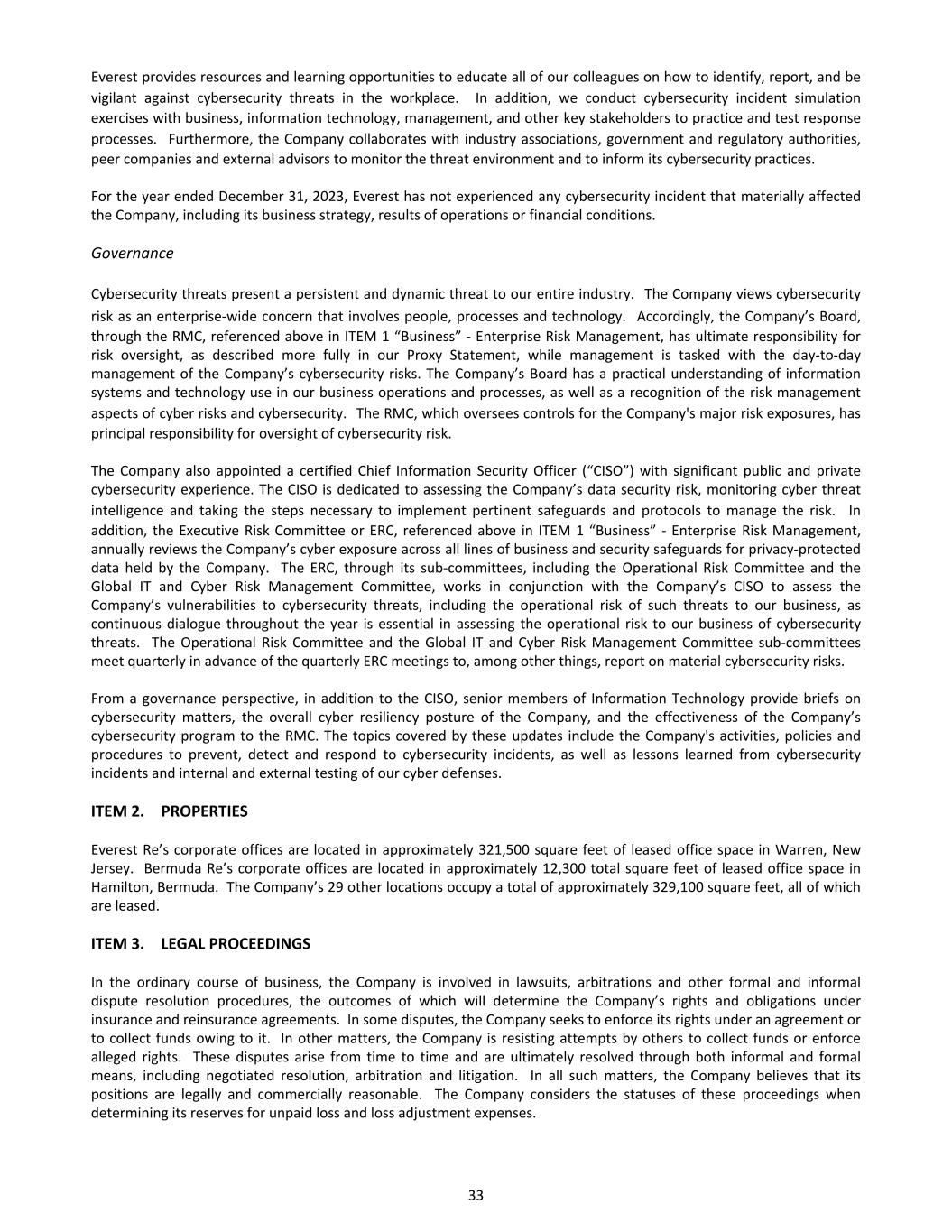
Everest provides resources and learning opportunities to educate all of our colleagues on how to identify, report, and be vigilant against cybersecurity threats in the workplace. In addition, we conduct cybersecurity incident simulation exercises with business, information technology, management, and other key stakeholders to practice and test response processes. Furthermore, the Company collaborates with industry associations, government and regulatory authorities, peer companies and external advisors to monitor the threat environment and to inform its cybersecurity practices. For the year ended December 31, 2023, Everest has not experienced any cybersecurity incident that materially affected the Company, including its business strategy, results of operations or financial conditions. Governance Cybersecurity threats present a persistent and dynamic threat to our entire industry. The Company views cybersecurity risk as an enterprise-wide concern that involves people, processes and technology. Accordingly, the Company’s Board, through the RMC, referenced above in ITEM 1 “Business” - Enterprise Risk Management, has ultimate responsibility for risk oversight, as described more fully in our Proxy Statement, while management is tasked with the day-to-day management of the Company’s cybersecurity risks. The Company’s Board has a practical understanding of information systems and technology use in our business operations and processes, as well as a recognition of the risk management aspects of cyber risks and cybersecurity. The RMC, which oversees controls for the Company's major risk exposures, has principal responsibility for oversight of cybersecurity risk. The Company also appointed a certified Chief Information Security Officer (“CISO”) with significant public and private cybersecurity experience. The CISO is dedicated to assessing the Company’s data security risk, monitoring cyber threat intelligence and taking the steps necessary to implement pertinent safeguards and protocols to manage the risk. In addition, the Executive Risk Committee or ERC, referenced above in ITEM 1 “Business” - Enterprise Risk Management, annually reviews the Company’s cyber exposure across all lines of business and security safeguards for privacy-protected data held by the Company. The ERC, through its sub-committees, including the Operational Risk Committee and the Global IT and Cyber Risk Management Committee, works in conjunction with the Company’s CISO to assess the Company’s vulnerabilities to cybersecurity threats, including the operational risk of such threats to our business, as continuous dialogue throughout the year is essential in assessing the operational risk to our business of cybersecurity threats. The Operational Risk Committee and the Global IT and Cyber Risk Management Committee sub-committees meet quarterly in advance of the quarterly ERC meetings to, among other things, report on material cybersecurity risks. From a governance perspective, in addition to the CISO, senior members of Information Technology provide briefs on cybersecurity matters, the overall cyber resiliency posture of the Company, and the effectiveness of the Company’s cybersecurity program to the RMC. The topics covered by these updates include the Company's activities, policies and procedures to prevent, detect and respond to cybersecurity incidents, as well as lessons learned from cybersecurity incidents and internal and external testing of our cyber defenses. ITEM 2. PROPERTIES Everest Re’s corporate offices are located in approximately 321,500 square feet of leased office space in Warren, New Jersey. Bermuda Re’s corporate offices are located in approximately 12,300 total square feet of leased office space in Hamilton, Bermuda. The Company’s 29 other locations occupy a total of approximately 329,100 square feet, all of which are leased. ITEM 3. LEGAL PROCEEDINGS In the ordinary course of business, the Company is involved in lawsuits, arbitrations and other formal and informal dispute resolution procedures, the outcomes of which will determine the Company’s rights and obligations under insurance and reinsurance agreements. In some disputes, the Company seeks to enforce its rights under an agreement or to collect funds owing to it. In other matters, the Company is resisting attempts by others to collect funds or enforce alleged rights. These disputes arise from time to time and are ultimately resolved through both informal and formal means, including negotiated resolution, arbitration and litigation. In all such matters, the Company believes that its positions are legally and commercially reasonable. The Company considers the statuses of these proceedings when determining its reserves for unpaid loss and loss adjustment expenses. 33
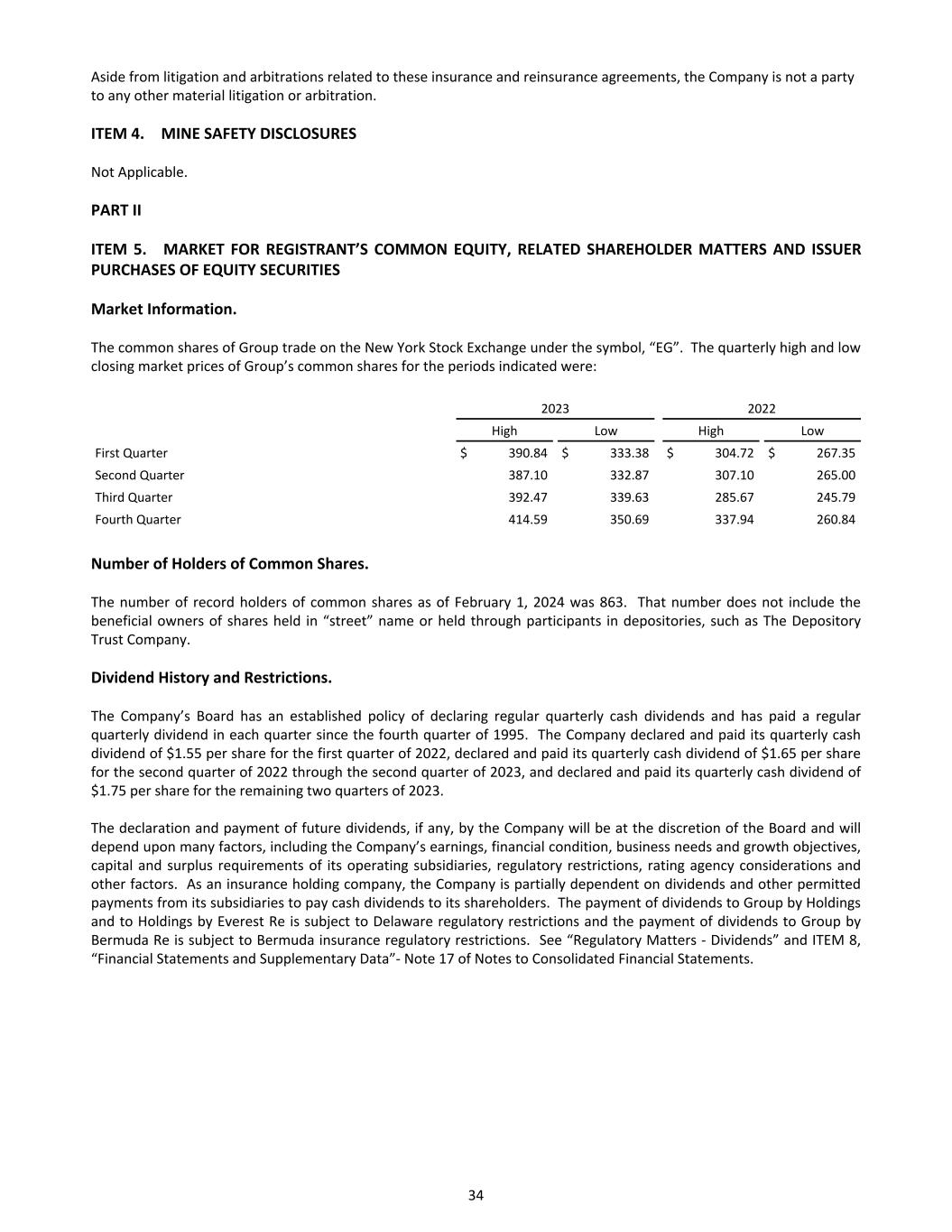
Aside from litigation and arbitrations related to these insurance and reinsurance agreements, the Company is not a party to any other material litigation or arbitration. ITEM 4. MINE SAFETY DISCLOSURES Not Applicable. PART II ITEM 5. MARKET FOR REGISTRANT’S COMMON EQUITY, RELATED SHAREHOLDER MATTERS AND ISSUER PURCHASES OF EQUITY SECURITIES Market Information. The common shares of Group trade on the New York Stock Exchange under the symbol, “EG”. The quarterly high and low closing market prices of Group’s common shares for the periods indicated were: 2023 2022 High Low High Low First Quarter $ 390.84 $ 333.38 $ 304.72 $ 267.35 Second Quarter 387.10 332.87 307.10 265.00 Third Quarter 392.47 339.63 285.67 245.79 Fourth Quarter 414.59 350.69 337.94 260.84 Number of Holders of Common Shares. The number of record holders of common shares as of February 1, 2024 was 863. That number does not include the beneficial owners of shares held in “street” name or held through participants in depositories, such as The Depository Trust Company. Dividend History and Restrictions. The Company’s Board has an established policy of declaring regular quarterly cash dividends and has paid a regular quarterly dividend in each quarter since the fourth quarter of 1995. The Company declared and paid its quarterly cash dividend of $1.55 per share for the first quarter of 2022, declared and paid its quarterly cash dividend of $1.65 per share for the second quarter of 2022 through the second quarter of 2023, and declared and paid its quarterly cash dividend of $1.75 per share for the remaining two quarters of 2023. The declaration and payment of future dividends, if any, by the Company will be at the discretion of the Board and will depend upon many factors, including the Company’s earnings, financial condition, business needs and growth objectives, capital and surplus requirements of its operating subsidiaries, regulatory restrictions, rating agency considerations and other factors. As an insurance holding company, the Company is partially dependent on dividends and other permitted payments from its subsidiaries to pay cash dividends to its shareholders. The payment of dividends to Group by Holdings and to Holdings by Everest Re is subject to Delaware regulatory restrictions and the payment of dividends to Group by Bermuda Re is subject to Bermuda insurance regulatory restrictions. See “Regulatory Matters - Dividends” and ITEM 8, “Financial Statements and Supplementary Data”- Note 17 of Notes to Consolidated Financial Statements. 34
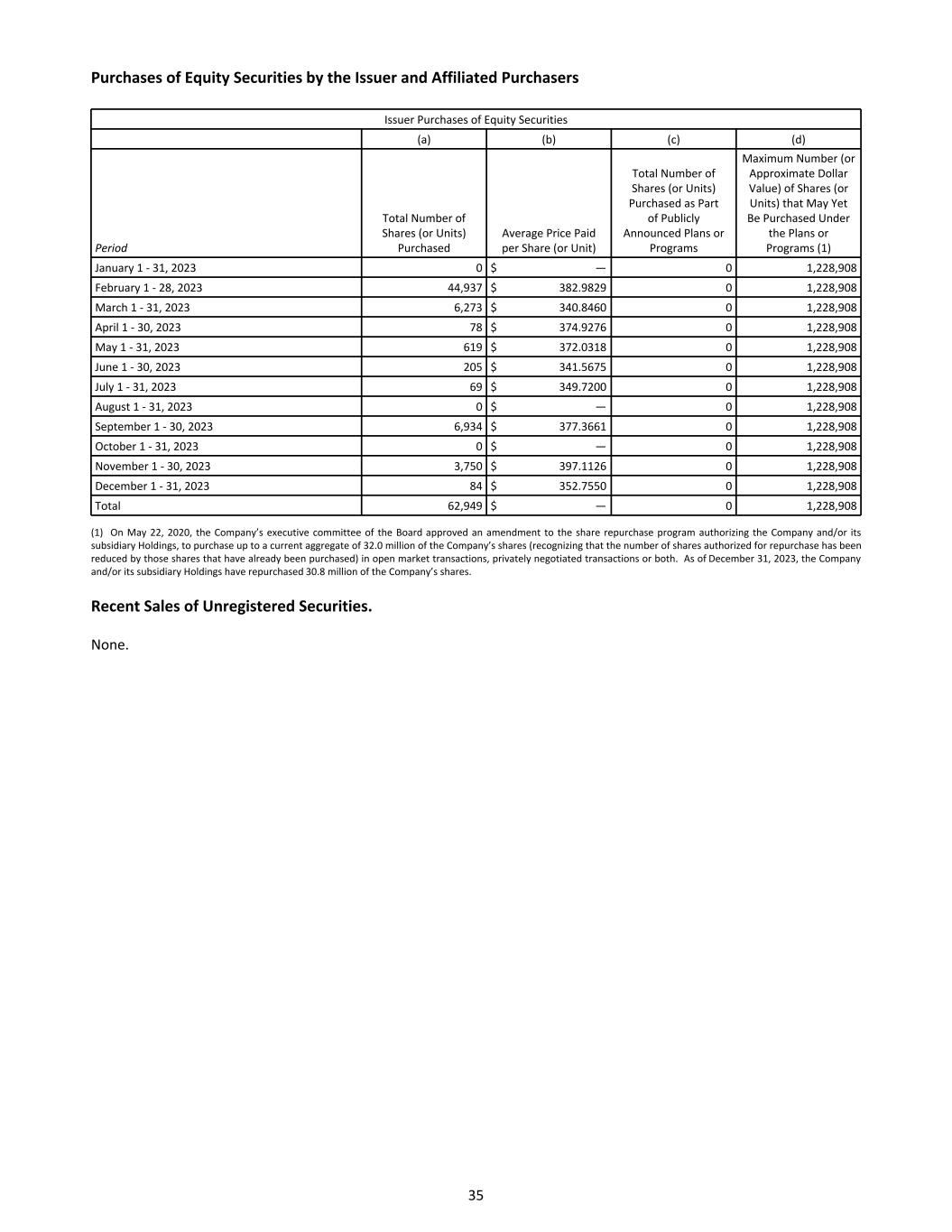
Purchases of Equity Securities by the Issuer and Affiliated Purchasers Issuer Purchases of Equity Securities (a) (b) (c) (d) Period Total Number of Shares (or Units) Purchased Average Price Paid per Share (or Unit) Total Number of Shares (or Units) Purchased as Part of Publicly Announced Plans or Programs Maximum Number (or Approximate Dollar Value) of Shares (or Units) that May Yet Be Purchased Under the Plans or Programs (1) January 1 - 31, 2023 0 $ — 0 1,228,908 February 1 - 28, 2023 44,937 $ 382.9829 0 1,228,908 March 1 - 31, 2023 6,273 $ 340.8460 0 1,228,908 April 1 - 30, 2023 78 $ 374.9276 0 1,228,908 May 1 - 31, 2023 619 $ 372.0318 0 1,228,908 June 1 - 30, 2023 205 $ 341.5675 0 1,228,908 July 1 - 31, 2023 69 $ 349.7200 0 1,228,908 August 1 - 31, 2023 0 $ — 0 1,228,908 September 1 - 30, 2023 6,934 $ 377.3661 0 1,228,908 October 1 - 31, 2023 0 $ — 0 1,228,908 November 1 - 30, 2023 3,750 $ 397.1126 0 1,228,908 December 1 - 31, 2023 84 $ 352.7550 0 1,228,908 Total 62,949 $ — 0 1,228,908 (1) On May 22, 2020, the Company’s executive committee of the Board approved an amendment to the share repurchase program authorizing the Company and/or its subsidiary Holdings, to purchase up to a current aggregate of 32.0 million of the Company’s shares (recognizing that the number of shares authorized for repurchase has been reduced by those shares that have already been purchased) in open market transactions, privately negotiated transactions or both. As of December 31, 2023, the Company and/or its subsidiary Holdings have repurchased 30.8 million of the Company’s shares. Recent Sales of Unregistered Securities. None. 35
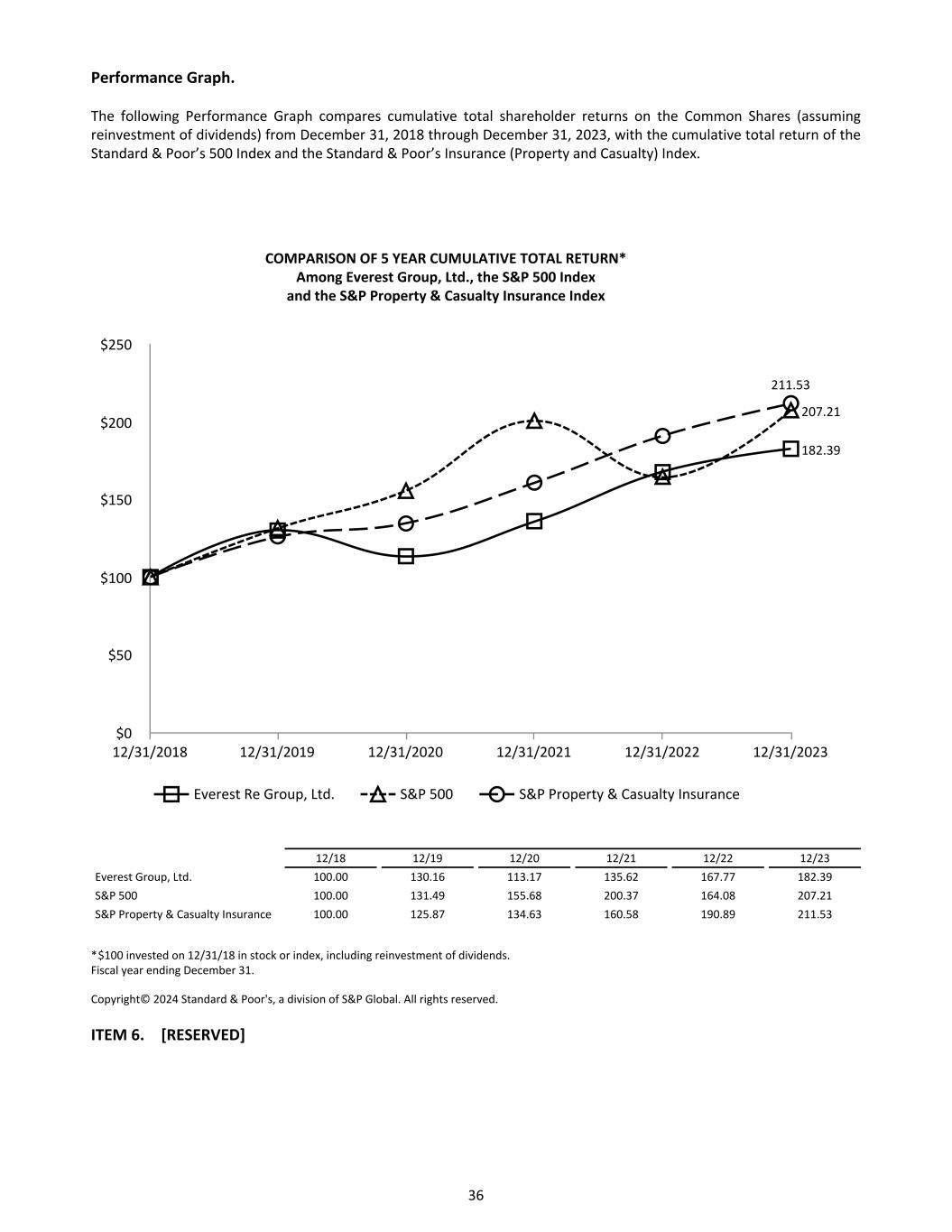
Performance Graph. The following Performance Graph compares cumulative total shareholder returns on the Common Shares (assuming reinvestment of dividends) from December 31, 2018 through December 31, 2023, with the cumulative total return of the Standard & Poor’s 500 Index and the Standard & Poor’s Insurance (Property and Casualty) Index. COMPARISON OF 5 YEAR CUMULATIVE TOTAL RETURN* Among Everest Group, Ltd., the S&P 500 Index and the S&P Property & Casualty Insurance Index 182.39 207.21 211.53 Everest Re Group, Ltd. S&P 500 S&P Property & Casualty Insurance 12/31/2018 12/31/2019 12/31/2020 12/31/2021 12/31/2022 12/31/2023 $0 $50 $100 $150 $200 $250 12/18 12/19 12/20 12/21 12/22 12/23 Everest Group, Ltd. 100.00 130.16 113.17 135.62 167.77 182.39 S&P 500 100.00 131.49 155.68 200.37 164.08 207.21 S&P Property & Casualty Insurance 100.00 125.87 134.63 160.58 190.89 211.53 *$100 invested on 12/31/18 in stock or index, including reinvestment of dividends. Fiscal year ending December 31. Copyright© 2024 Standard & Poor's, a division of S&P Global. All rights reserved. ITEM 6. [RESERVED] 36
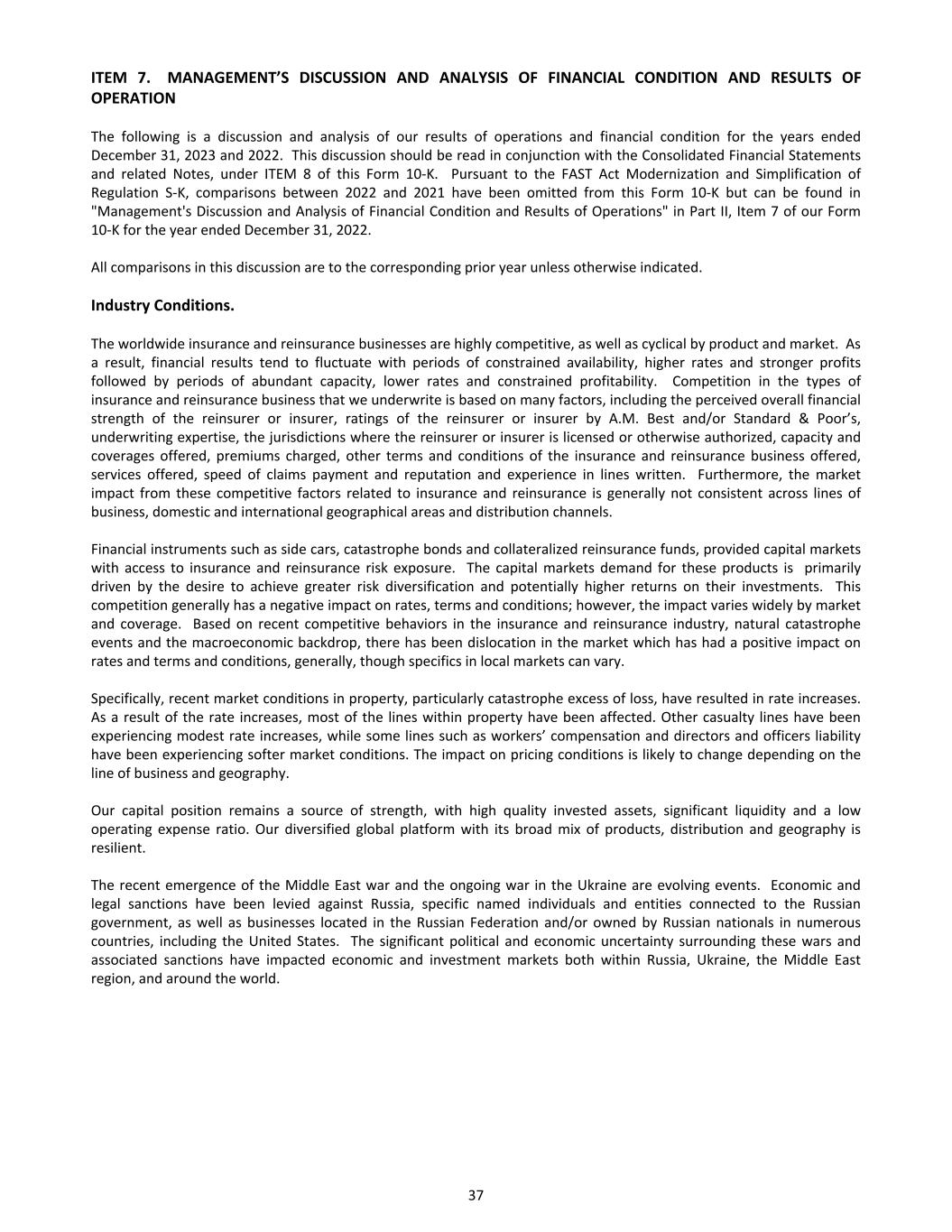
ITEM 7. MANAGEMENT’S DISCUSSION AND ANALYSIS OF FINANCIAL CONDITION AND RESULTS OF OPERATION The following is a discussion and analysis of our results of operations and financial condition for the years ended December 31, 2023 and 2022. This discussion should be read in conjunction with the Consolidated Financial Statements and related Notes, under ITEM 8 of this Form 10-K. Pursuant to the FAST Act Modernization and Simplification of Regulation S-K, comparisons between 2022 and 2021 have been omitted from this Form 10-K but can be found in "Management's Discussion and Analysis of Financial Condition and Results of Operations" in Part II, Item 7 of our Form 10-K for the year ended December 31, 2022. All comparisons in this discussion are to the corresponding prior year unless otherwise indicated. Industry Conditions. The worldwide insurance and reinsurance businesses are highly competitive, as well as cyclical by product and market. As a result, financial results tend to fluctuate with periods of constrained availability, higher rates and stronger profits followed by periods of abundant capacity, lower rates and constrained profitability. Competition in the types of insurance and reinsurance business that we underwrite is based on many factors, including the perceived overall financial strength of the reinsurer or insurer, ratings of the reinsurer or insurer by A.M. Best and/or Standard & Poor’s, underwriting expertise, the jurisdictions where the reinsurer or insurer is licensed or otherwise authorized, capacity and coverages offered, premiums charged, other terms and conditions of the insurance and reinsurance business offered, services offered, speed of claims payment and reputation and experience in lines written. Furthermore, the market impact from these competitive factors related to insurance and reinsurance is generally not consistent across lines of business, domestic and international geographical areas and distribution channels. Financial instruments such as side cars, catastrophe bonds and collateralized reinsurance funds, provided capital markets with access to insurance and reinsurance risk exposure. The capital markets demand for these products is primarily driven by the desire to achieve greater risk diversification and potentially higher returns on their investments. This competition generally has a negative impact on rates, terms and conditions; however, the impact varies widely by market and coverage. Based on recent competitive behaviors in the insurance and reinsurance industry, natural catastrophe events and the macroeconomic backdrop, there has been dislocation in the market which has had a positive impact on rates and terms and conditions, generally, though specifics in local markets can vary. Specifically, recent market conditions in property, particularly catastrophe excess of loss, have resulted in rate increases. As a result of the rate increases, most of the lines within property have been affected. Other casualty lines have been experiencing modest rate increases, while some lines such as workers’ compensation and directors and officers liability have been experiencing softer market conditions. The impact on pricing conditions is likely to change depending on the line of business and geography. Our capital position remains a source of strength, with high quality invested assets, significant liquidity and a low operating expense ratio. Our diversified global platform with its broad mix of products, distribution and geography is resilient. The recent emergence of the Middle East war and the ongoing war in the Ukraine are evolving events. Economic and legal sanctions have been levied against Russia, specific named individuals and entities connected to the Russian government, as well as businesses located in the Russian Federation and/or owned by Russian nationals in numerous countries, including the United States. The significant political and economic uncertainty surrounding these wars and associated sanctions have impacted economic and investment markets both within Russia, Ukraine, the Middle East region, and around the world. 37

Financial Summary. We monitor and evaluate our overall performance based upon financial results. The following table displays a summary of the consolidated net income (loss), ratios and shareholders’ equity for the periods indicated: Years Ended December 31, Percentage Increase/(Decrease) (Dollars in millions) 2023 2022 2021 2023/2022 2022/2021 Gross written premiums $ 16,637 $ 13,952 $ 13,050 19.2 % 6.9 % Net written premiums 14,730 12,344 11,446 19.3 % 7.9 % REVENUES: Premiums earned $ 13,443 $ 11,787 $ 10,406 14.0 % 13.3 % Net investment income 1,434 830 1,165 72.7 % (28.8) % Net gains (losses) on investments (276) (455) 258 (39.3) % NM Other income (expense) (14) (102) 37 (86.3) % NM Total revenues 14,587 12,060 11,866 20.9 % 1.6 % CLAIMS AND EXPENSES: Incurred losses and loss adjustment expenses 8,427 8,100 7,391 4.0 % 9.6 % Commission, brokerage, taxes and fees 2,952 2,528 2,209 16.7 % 14.5 % Other underwriting expenses 846 682 583 24.1 % 17.0 % Corporate expenses 73 61 68 19.9 % (10.1) % Interest, fees and bond issue cost amortization expense 134 101 70 33.2 % 43.9 % Total claims and expenses 12,432 11,472 10,321 8.4 % 11.2 % INCOME (LOSS) BEFORE TAXES 2,154 588 1,546 NM (62.0) % Income tax expense (benefit) (363) (9) 167 NM NM NET INCOME (LOSS) $ 2,517 $ 597 $ 1,379 NM (56.7) % RATIOS: Point Change Loss ratio 62.7 % 68.7 % 71.0 % (6.0) (2.3) Commission and brokerage ratio 22.0 % 21.4 % 21.2 % 0.6 0.2 Other underwriting expense ratio 6.3 % 5.8 % 5.6 % 0.5 0.2 Combined ratio 90.9 % 96.0 % 97.8 % (5.1) (1.8) At December 31, Percentage Increase/(Decrease) (Dollars in millions, except per share amounts) 2023 2022 2021 2023/2022 2022/2021 Balance sheet data: Total investments and cash $ 37,142 $ 29,872 $ 29,673 24.3 % 0.7 % Total assets 49,399 39,966 38,185 23.6 % 4.7 % Loss and loss adjustment expense reserves 24,604 22,065 19,009 11.5 % 16.1 % Total debt 3,385 3,084 3,089 9.8 % (0.2) % Total liabilities 36,197 31,525 28,046 14.8 % 12.4 % Shareholders' equity 13,202 8,441 10,139 56.4 % (16.8) % Book value per share 304.29 215.54 258.21 41.2 % (16.5) % (NM - not meaningful) (Some amounts may not reconcile due to rounding.) Revenues. Premiums. Gross written premiums increased by 19.2% to $16.6 billion in 2023, compared to $14.0 billion in 2022, reflecting a $2.2 billion, or 23.9% increase in our reinsurance business and a $473 million, or 10.0%, increase in our insurance business. The increase in reinsurance premiums reflects growth across all lines of business, particularly property pro rata, and property excess of loss business. The increase in insurance premiums reflects growth across multiple lines of business, particularly specialty casualty business, property/short tail business and other specialty business, driven by positive rate and exposure increases, new business and strong renewal retention. Net written premiums increased by 19.3% to $14.7 billion in 2023, compared to $12.3 billion in 2022. Premiums earned increased by 14.0% to $13.4 billion in 2023, compared to $11.8 billion in 2022, which is consistent with the percentage changes in gross written premiums. The change in premiums earned relative to net written premiums was primarily the result of 38
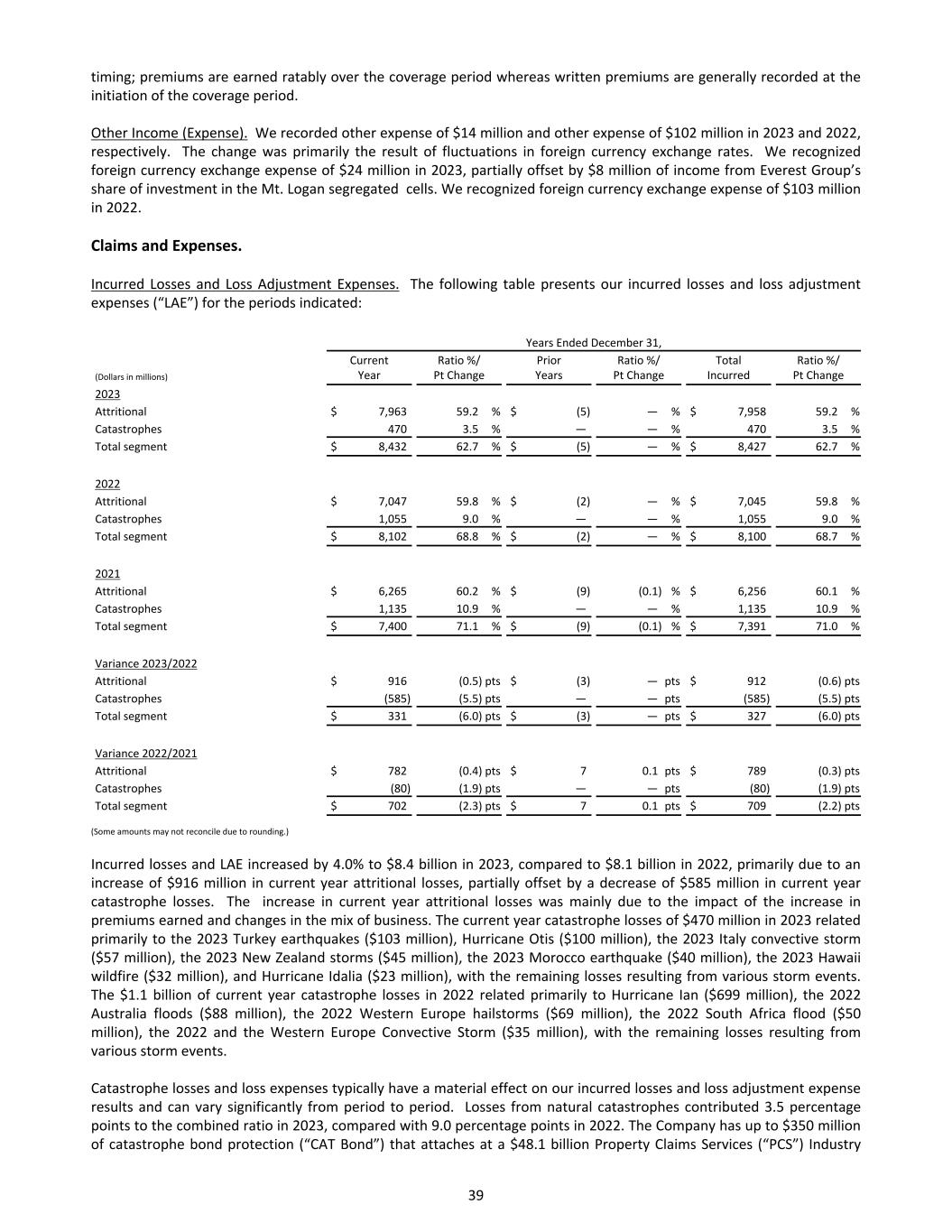
timing; premiums are earned ratably over the coverage period whereas written premiums are generally recorded at the initiation of the coverage period. Other Income (Expense). We recorded other expense of $14 million and other expense of $102 million in 2023 and 2022, respectively. The change was primarily the result of fluctuations in foreign currency exchange rates. We recognized foreign currency exchange expense of $24 million in 2023, partially offset by $8 million of income from Everest Group’s share of investment in the Mt. Logan segregated cells. We recognized foreign currency exchange expense of $103 million in 2022. Claims and Expenses. Incurred Losses and Loss Adjustment Expenses. The following table presents our incurred losses and loss adjustment expenses (“LAE”) for the periods indicated: Years Ended December 31, (Dollars in millions) Current Year Ratio %/ Pt Change Prior Years Ratio %/ Pt Change Total Incurred Ratio %/ Pt Change 2023 Attritional $ 7,963 59.2 % $ (5) — % $ 7,958 59.2 % Catastrophes 470 3.5 % — — % 470 3.5 % Total segment $ 8,432 62.7 % $ (5) — % $ 8,427 62.7 % 2022 Attritional $ 7,047 59.8 % $ (2) — % $ 7,045 59.8 % Catastrophes 1,055 9.0 % — — % 1,055 9.0 % Total segment $ 8,102 68.8 % $ (2) — % $ 8,100 68.7 % 2021 Attritional $ 6,265 60.2 % $ (9) (0.1) % $ 6,256 60.1 % Catastrophes 1,135 10.9 % — — % 1,135 10.9 % Total segment $ 7,400 71.1 % $ (9) (0.1) % $ 7,391 71.0 % Variance 2023/2022 Attritional $ 916 (0.5) pts $ (3) — pts $ 912 (0.6) pts Catastrophes (585) (5.5) pts — — pts (585) (5.5) pts Total segment $ 331 (6.0) pts $ (3) — pts $ 327 (6.0) pts Variance 2022/2021 Attritional $ 782 (0.4) pts $ 7 0.1 pts $ 789 (0.3) pts Catastrophes (80) (1.9) pts — — pts (80) (1.9) pts Total segment $ 702 (2.3) pts $ 7 0.1 pts $ 709 (2.2) pts (Some amounts may not reconcile due to rounding.) Incurred losses and LAE increased by 4.0% to $8.4 billion in 2023, compared to $8.1 billion in 2022, primarily due to an increase of $916 million in current year attritional losses, partially offset by a decrease of $585 million in current year catastrophe losses. The increase in current year attritional losses was mainly due to the impact of the increase in premiums earned and changes in the mix of business. The current year catastrophe losses of $470 million in 2023 related primarily to the 2023 Turkey earthquakes ($103 million), Hurricane Otis ($100 million), the 2023 Italy convective storm ($57 million), the 2023 New Zealand storms ($45 million), the 2023 Morocco earthquake ($40 million), the 2023 Hawaii wildfire ($32 million), and Hurricane Idalia ($23 million), with the remaining losses resulting from various storm events. The $1.1 billion of current year catastrophe losses in 2022 related primarily to Hurricane Ian ($699 million), the 2022 Australia floods ($88 million), the 2022 Western Europe hailstorms ($69 million), the 2022 South Africa flood ($50 million), the 2022 and the Western Europe Convective Storm ($35 million), with the remaining losses resulting from various storm events. Catastrophe losses and loss expenses typically have a material effect on our incurred losses and loss adjustment expense results and can vary significantly from period to period. Losses from natural catastrophes contributed 3.5 percentage points to the combined ratio in 2023, compared with 9.0 percentage points in 2022. The Company has up to $350 million of catastrophe bond protection (“CAT Bond”) that attaches at a $48.1 billion Property Claims Services (“PCS”) Industry 39
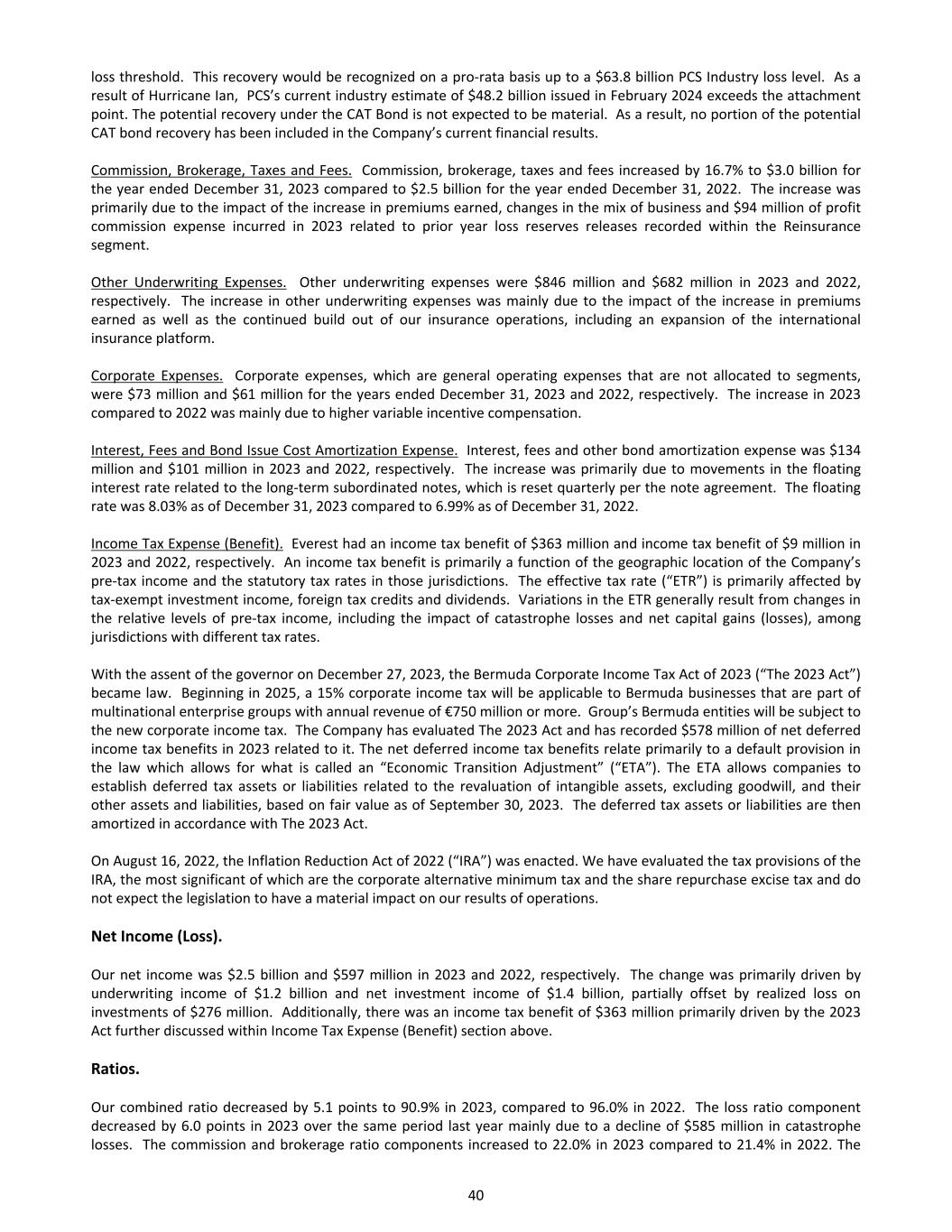
loss threshold. This recovery would be recognized on a pro-rata basis up to a $63.8 billion PCS Industry loss level. As a result of Hurricane Ian, PCS’s current industry estimate of $48.2 billion issued in February 2024 exceeds the attachment point. The potential recovery under the CAT Bond is not expected to be material. As a result, no portion of the potential CAT bond recovery has been included in the Company’s current financial results. Commission, Brokerage, Taxes and Fees. Commission, brokerage, taxes and fees increased by 16.7% to $3.0 billion for the year ended December 31, 2023 compared to $2.5 billion for the year ended December 31, 2022. The increase was primarily due to the impact of the increase in premiums earned, changes in the mix of business and $94 million of profit commission expense incurred in 2023 related to prior year loss reserves releases recorded within the Reinsurance segment. Other Underwriting Expenses. Other underwriting expenses were $846 million and $682 million in 2023 and 2022, respectively. The increase in other underwriting expenses was mainly due to the impact of the increase in premiums earned as well as the continued build out of our insurance operations, including an expansion of the international insurance platform. Corporate Expenses. Corporate expenses, which are general operating expenses that are not allocated to segments, were $73 million and $61 million for the years ended December 31, 2023 and 2022, respectively. The increase in 2023 compared to 2022 was mainly due to higher variable incentive compensation. Interest, Fees and Bond Issue Cost Amortization Expense. Interest, fees and other bond amortization expense was $134 million and $101 million in 2023 and 2022, respectively. The increase was primarily due to movements in the floating interest rate related to the long-term subordinated notes, which is reset quarterly per the note agreement. The floating rate was 8.03% as of December 31, 2023 compared to 6.99% as of December 31, 2022. Income Tax Expense (Benefit). Everest had an income tax benefit of $363 million and income tax benefit of $9 million in 2023 and 2022, respectively. An income tax benefit is primarily a function of the geographic location of the Company’s pre-tax income and the statutory tax rates in those jurisdictions. The effective tax rate (“ETR”) is primarily affected by tax-exempt investment income, foreign tax credits and dividends. Variations in the ETR generally result from changes in the relative levels of pre-tax income, including the impact of catastrophe losses and net capital gains (losses), among jurisdictions with different tax rates. With the assent of the governor on December 27, 2023, the Bermuda Corporate Income Tax Act of 2023 (“The 2023 Act”) became law. Beginning in 2025, a 15% corporate income tax will be applicable to Bermuda businesses that are part of multinational enterprise groups with annual revenue of €750 million or more. Group’s Bermuda entities will be subject to the new corporate income tax. The Company has evaluated The 2023 Act and has recorded $578 million of net deferred income tax benefits in 2023 related to it. The net deferred income tax benefits relate primarily to a default provision in the law which allows for what is called an “Economic Transition Adjustment” (“ETA”). The ETA allows companies to establish deferred tax assets or liabilities related to the revaluation of intangible assets, excluding goodwill, and their other assets and liabilities, based on fair value as of September 30, 2023. The deferred tax assets or liabilities are then amortized in accordance with The 2023 Act. On August 16, 2022, the Inflation Reduction Act of 2022 (“IRA”) was enacted. We have evaluated the tax provisions of the IRA, the most significant of which are the corporate alternative minimum tax and the share repurchase excise tax and do not expect the legislation to have a material impact on our results of operations. Net Income (Loss). Our net income was $2.5 billion and $597 million in 2023 and 2022, respectively. The change was primarily driven by underwriting income of $1.2 billion and net investment income of $1.4 billion, partially offset by realized loss on investments of $276 million. Additionally, there was an income tax benefit of $363 million primarily driven by the 2023 Act further discussed within Income Tax Expense (Benefit) section above. Ratios. Our combined ratio decreased by 5.1 points to 90.9% in 2023, compared to 96.0% in 2022. The loss ratio component decreased by 6.0 points in 2023 over the same period last year mainly due to a decline of $585 million in catastrophe losses. The commission and brokerage ratio components increased to 22.0% in 2023 compared to 21.4% in 2022. The 40
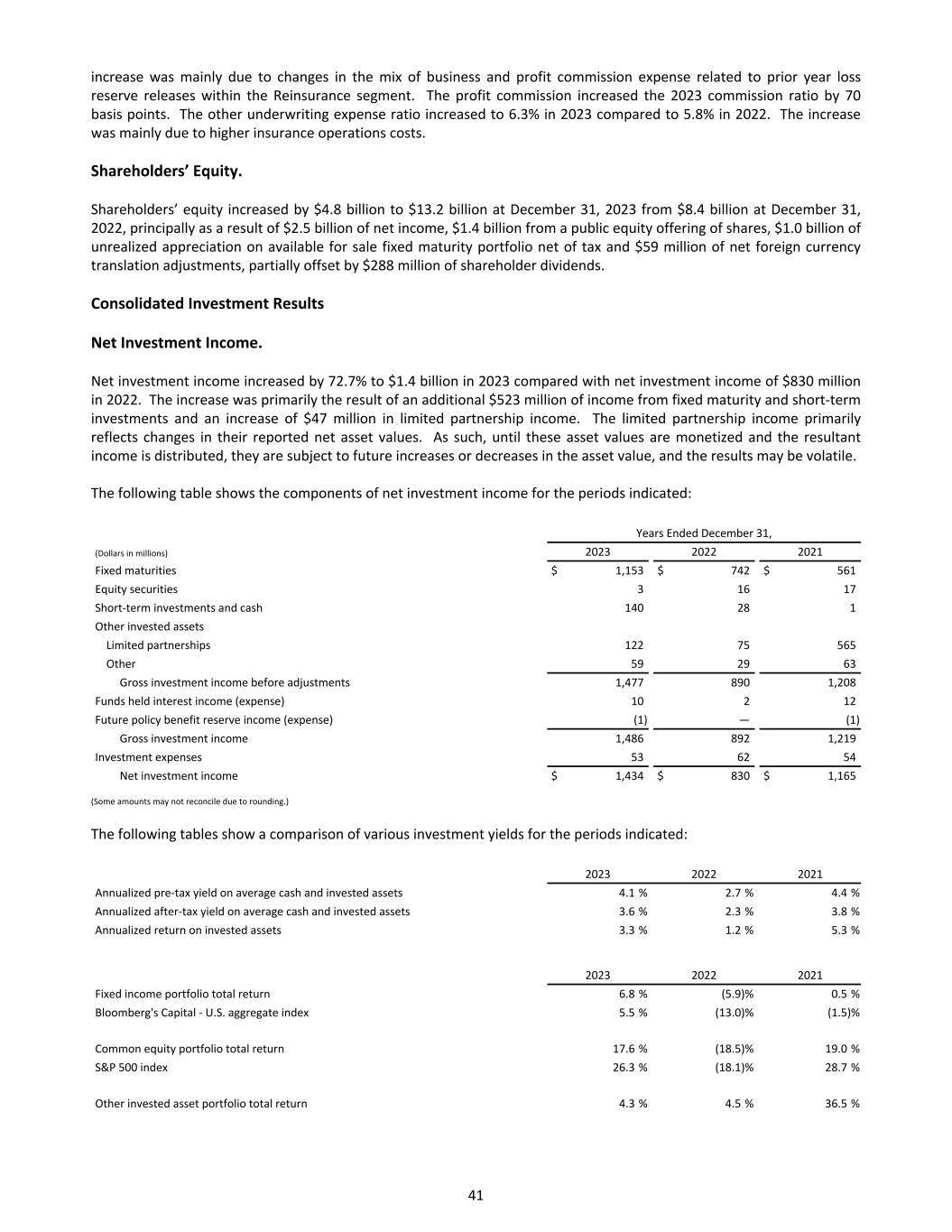
increase was mainly due to changes in the mix of business and profit commission expense related to prior year loss reserve releases within the Reinsurance segment. The profit commission increased the 2023 commission ratio by 70 basis points. The other underwriting expense ratio increased to 6.3% in 2023 compared to 5.8% in 2022. The increase was mainly due to higher insurance operations costs. Shareholders’ Equity. Shareholders’ equity increased by $4.8 billion to $13.2 billion at December 31, 2023 from $8.4 billion at December 31, 2022, principally as a result of $2.5 billion of net income, $1.4 billion from a public equity offering of shares, $1.0 billion of unrealized appreciation on available for sale fixed maturity portfolio net of tax and $59 million of net foreign currency translation adjustments, partially offset by $288 million of shareholder dividends. Consolidated Investment Results Net Investment Income. Net investment income increased by 72.7% to $1.4 billion in 2023 compared with net investment income of $830 million in 2022. The increase was primarily the result of an additional $523 million of income from fixed maturity and short-term investments and an increase of $47 million in limited partnership income. The limited partnership income primarily reflects changes in their reported net asset values. As such, until these asset values are monetized and the resultant income is distributed, they are subject to future increases or decreases in the asset value, and the results may be volatile. The following table shows the components of net investment income for the periods indicated: Years Ended December 31, (Dollars in millions) 2023 2022 2021 Fixed maturities $ 1,153 $ 742 $ 561 Equity securities 3 16 17 Short-term investments and cash 140 28 1 Other invested assets Limited partnerships 122 75 565 Other 59 29 63 Gross investment income before adjustments 1,477 890 1,208 Funds held interest income (expense) 10 2 12 Future policy benefit reserve income (expense) (1) — (1) Gross investment income 1,486 892 1,219 Investment expenses 53 62 54 Net investment income $ 1,434 $ 830 $ 1,165 (Some amounts may not reconcile due to rounding.) The following tables show a comparison of various investment yields for the periods indicated: 2023 2022 2021 Annualized pre-tax yield on average cash and invested assets 4.1 % 2.7 % 4.4 % Annualized after-tax yield on average cash and invested assets 3.6 % 2.3 % 3.8 % Annualized return on invested assets 3.3 % 1.2 % 5.3 % 2023 2022 2021 Fixed income portfolio total return 6.8 % (5.9) % 0.5 % Bloomberg's Capital - U.S. aggregate index 5.5 % (13.0) % (1.5) % Common equity portfolio total return 17.6 % (18.5) % 19.0 % S&P 500 index 26.3 % (18.1) % 28.7 % Other invested asset portfolio total return 4.3 % 4.5 % 36.5 % 41
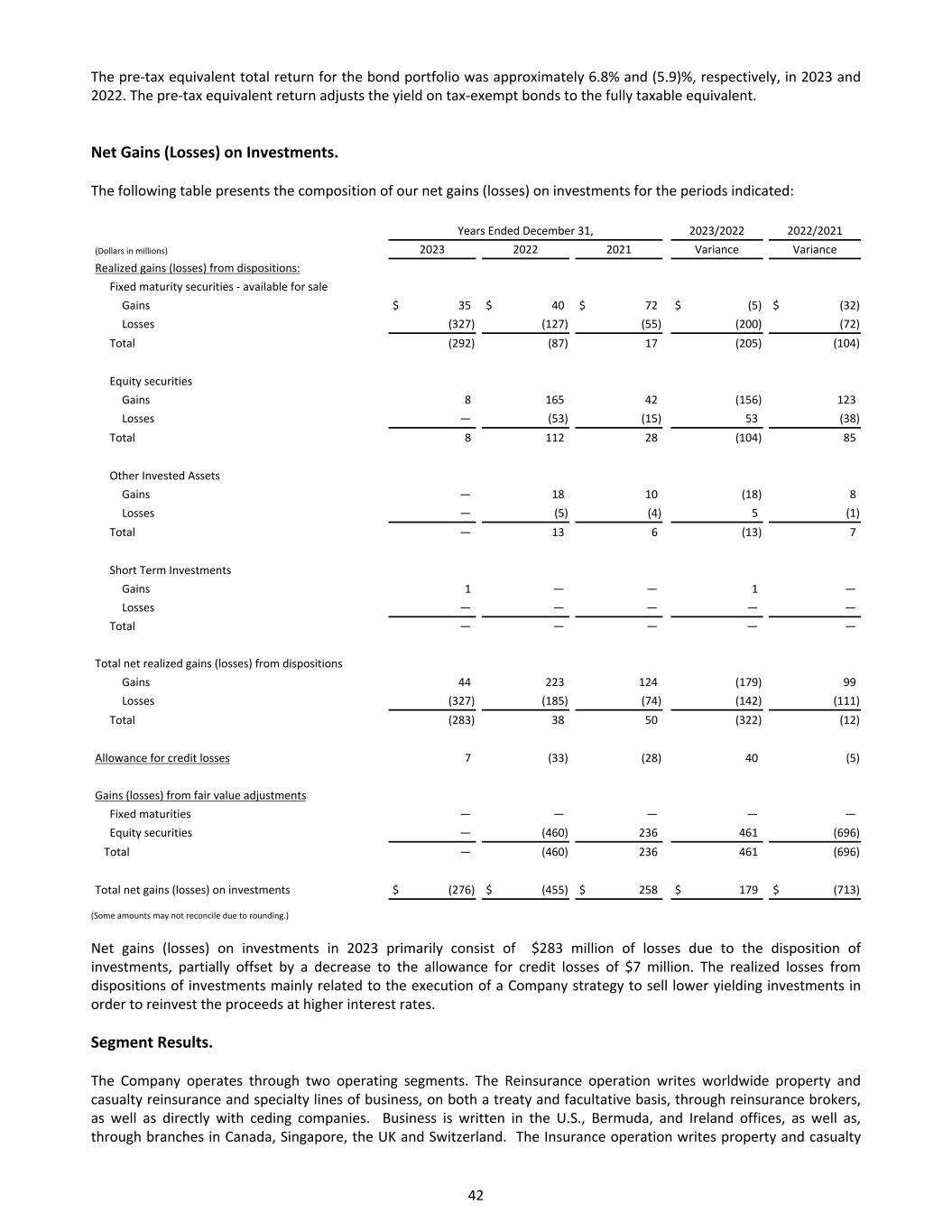
The pre-tax equivalent total return for the bond portfolio was approximately 6.8% and (5.9)%, respectively, in 2023 and 2022. The pre-tax equivalent return adjusts the yield on tax-exempt bonds to the fully taxable equivalent. Net Gains (Losses) on Investments. The following table presents the composition of our net gains (losses) on investments for the periods indicated: Years Ended December 31, 2023/2022 2022/2021 (Dollars in millions) 2023 2022 2021 Variance Variance Realized gains (losses) from dispositions: Fixed maturity securities - available for sale Gains $ 35 $ 40 $ 72 $ (5) $ (32) Losses (327) (127) (55) (200) (72) Total (292) (87) 17 (205) (104) Equity securities Gains 8 165 42 (156) 123 Losses — (53) (15) 53 (38) Total 8 112 28 (104) 85 Other Invested Assets Gains — 18 10 (18) 8 Losses — (5) (4) 5 (1) Total — 13 6 (13) 7 Short Term Investments Gains 1 — — 1 — Losses — — — — — Total — — — — — Total net realized gains (losses) from dispositions Gains 44 223 124 (179) 99 Losses (327) (185) (74) (142) (111) Total (283) 38 50 (322) (12) Allowance for credit losses 7 (33) (28) 40 (5) Gains (losses) from fair value adjustments Fixed maturities — — — — — Equity securities — (460) 236 461 (696) Total — (460) 236 461 (696) Total net gains (losses) on investments $ (276) $ (455) $ 258 $ 179 $ (713) (Some amounts may not reconcile due to rounding.) Net gains (losses) on investments in 2023 primarily consist of $283 million of losses due to the disposition of investments, partially offset by a decrease to the allowance for credit losses of $7 million. The realized losses from dispositions of investments mainly related to the execution of a Company strategy to sell lower yielding investments in order to reinvest the proceeds at higher interest rates. Segment Results. The Company operates through two operating segments. The Reinsurance operation writes worldwide property and casualty reinsurance and specialty lines of business, on both a treaty and facultative basis, through reinsurance brokers, as well as directly with ceding companies. Business is written in the U.S., Bermuda, and Ireland offices, as well as, through branches in Canada, Singapore, the UK and Switzerland. The Insurance operation writes property and casualty 42

insurance directly and through brokers, including for surplus lines, and general agents within the U.S., Bermuda, Canada, Europe, Singapore and South America through its offices in the U.S., Bermuda, Canada, Chile, Singapore, the UK, Ireland, and branches located in the UK, the Netherlands, France, Germany and Spain. The two segments are managed independently, but conform with corporate guidelines with respect to pricing, risk management, control of aggregate catastrophe exposures, capital, investments and support operations. Our two operating segments each have executive leadership who are responsible for the overall performance of their respective segments and who are directly accountable to our chief operating decision maker (“CODM”), the Chief Executive Officer of Everest Group, Ltd., who is ultimately responsible for reviewing the business to assess performance, make operating decisions and allocate resources. We report the results of our operations consistent with the manner in which our CODM reviews the business. During the fourth quarter of 2023, the Company revised the classification and presentation of certain products related to its accident and health business within the segment groupings. These products have been realigned from within the Reinsurance segment to the Insurance segment to appropriately reflect how the business segments are managed. These changes have been reflected retrospectively. The Company does not review and evaluate the financial results of its operating segments based upon balance sheet data. Management generally monitors and evaluates the financial performance of these operating segments based upon their underwriting results. Underwriting results include earned premium less losses and loss adjustment expenses (“LAE”) incurred, commission and brokerage expenses and other underwriting expenses. The Company measures its underwriting results using ratios, in particular, loss, commission and brokerage and other underwriting expense ratios, which, respectively, divide incurred losses, commissions and brokerage and other underwriting expenses by premiums earned. Management has determined that these measures are appropriate and align with how the business is managed. We continue to evaluate our segments as our business evolves and may further refine our segments and financial performance measures. The following discusses the underwriting results for each of our segments for the periods indicated. Reinsurance. The following table presents the underwriting results and ratios for the Reinsurance segment for the periods indicated: Years Ended December 31, 2023/2022 2022/2021 (Dollars in millions) 2023 2022 2021 Variance % Change Variance % Change Gross written premiums $ 11,460 $ 9,248 $ 9,018 $ 2,213 23.9 % $ 230 2.6 % Net written premiums 10,802 8,919 8,488 1,883 21.1 % 431 5.1 % Premiums earned $ 9,799 $ 8,598 $ 7,708 $ 1,201 14.0 % $ 890 11.5 % Incurred losses and LAE 5,696 5,966 5,543 (270) (4.5) % 423 7.6 % Commission and brokerage 2,520 2,116 1,833 404 19.1 % 283 15.4 % Other underwriting expenses 255 217 198 38 17.4 % 19 9.9 % Underwriting gain (loss) $ 1,328 $ 300 $ 135 $ 1,029 NM $ 165 NM Point Chg Point Chg Loss ratio 58.1 % 69.4 % 71.9 % (11.3) (2.5) Commission and brokerage ratio 25.7 % 24.6 % 23.8 % 1.1 0.8 Other underwriting expense ratio 2.6 % 2.5 % 2.6 % 0.1 (0.1) Combined ratio 86.4 % 96.5 % 98.3 % (10.1) (1.8) (NM, not meaningful) (Some amounts may not reconcile due to rounding.) Premiums. Gross written premiums increased by 23.9% to $11.5 billion in 2023 from $9.2 billion in 2022. The increase in gross written premiums reflects growth across all lines of business, particularly property pro rata, and property excess of loss business. Net written premiums increased by 21.1% to $10.8 billion in 2023 compared to $8.9 billion in 2022. Premiums earned increased by 14.0% to $9.8 billion in 2023, compared to $8.6 billion in 2022. The change in premiums earned relative to net written premiums is primarily the result of timing; premiums are earned ratably over the coverage period whereas written premiums are generally recorded at the initiation of the coverage period. 43
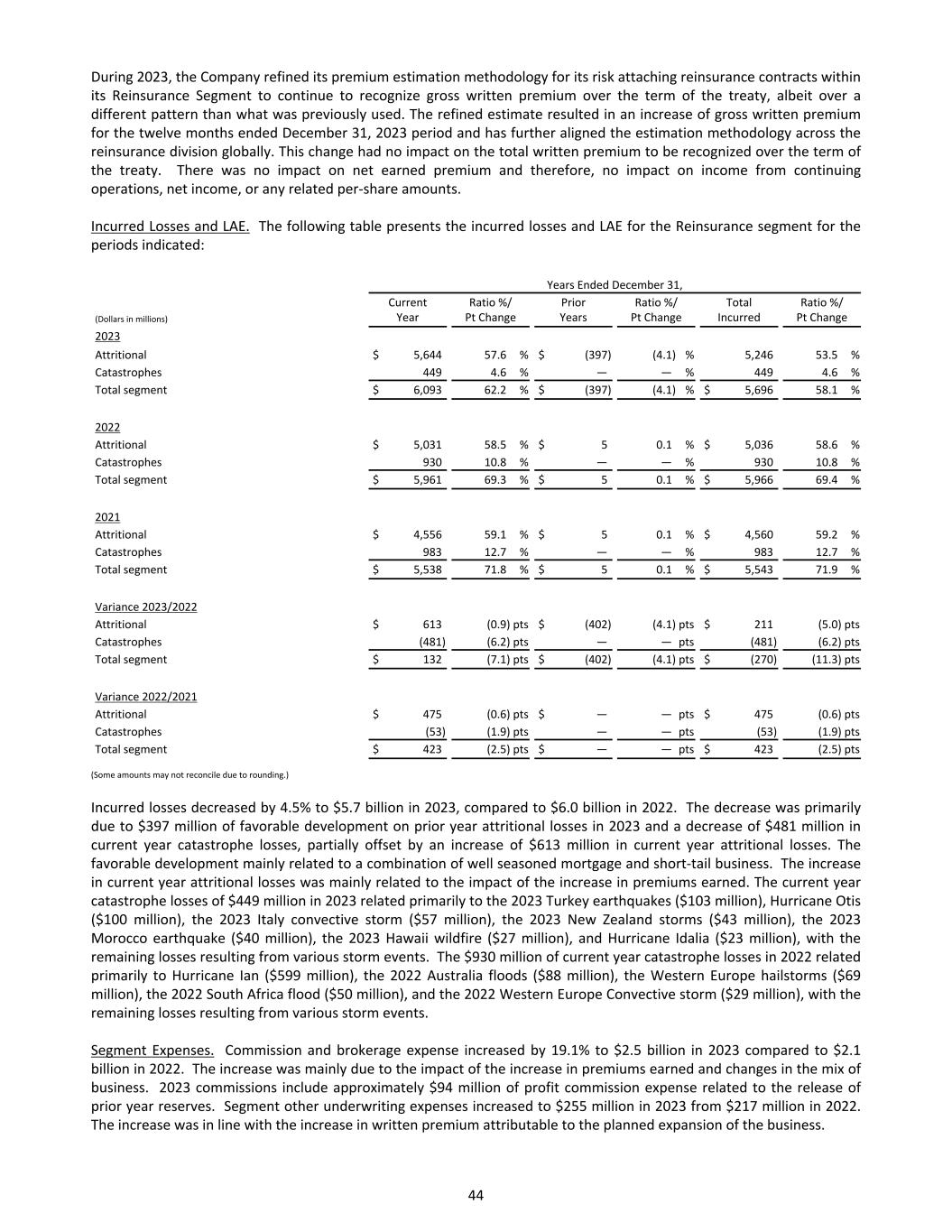
During 2023, the Company refined its premium estimation methodology for its risk attaching reinsurance contracts within its Reinsurance Segment to continue to recognize gross written premium over the term of the treaty, albeit over a different pattern than what was previously used. The refined estimate resulted in an increase of gross written premium for the twelve months ended December 31, 2023 period and has further aligned the estimation methodology across the reinsurance division globally. This change had no impact on the total written premium to be recognized over the term of the treaty. There was no impact on net earned premium and therefore, no impact on income from continuing operations, net income, or any related per-share amounts. Incurred Losses and LAE. The following table presents the incurred losses and LAE for the Reinsurance segment for the periods indicated: Years Ended December 31, (Dollars in millions) Current Year Ratio %/ Pt Change Prior Years Ratio %/ Pt Change Total Incurred Ratio %/ Pt Change 2023 Attritional $ 5,644 57.6 % $ (397) (4.1) % 5,246 53.5 % Catastrophes 449 4.6 % — — % 449 4.6 % Total segment $ 6,093 62.2 % $ (397) (4.1) % $ 5,696 58.1 % 2022 Attritional $ 5,031 58.5 % $ 5 0.1 % $ 5,036 58.6 % Catastrophes 930 10.8 % — — % 930 10.8 % Total segment $ 5,961 69.3 % $ 5 0.1 % $ 5,966 69.4 % 2021 Attritional $ 4,556 59.1 % $ 5 0.1 % $ 4,560 59.2 % Catastrophes 983 12.7 % — — % 983 12.7 % Total segment $ 5,538 71.8 % $ 5 0.1 % $ 5,543 71.9 % Variance 2023/2022 Attritional $ 613 (0.9) pts $ (402) (4.1) pts $ 211 (5.0) pts Catastrophes (481) (6.2) pts — — pts (481) (6.2) pts Total segment $ 132 (7.1) pts $ (402) (4.1) pts $ (270) (11.3) pts Variance 2022/2021 Attritional $ 475 (0.6) pts $ — — pts $ 475 (0.6) pts Catastrophes (53) (1.9) pts — — pts (53) (1.9) pts Total segment $ 423 (2.5) pts $ — — pts $ 423 (2.5) pts (Some amounts may not reconcile due to rounding.) Incurred losses decreased by 4.5% to $5.7 billion in 2023, compared to $6.0 billion in 2022. The decrease was primarily due to $397 million of favorable development on prior year attritional losses in 2023 and a decrease of $481 million in current year catastrophe losses, partially offset by an increase of $613 million in current year attritional losses. The favorable development mainly related to a combination of well seasoned mortgage and short-tail business. The increase in current year attritional losses was mainly related to the impact of the increase in premiums earned. The current year catastrophe losses of $449 million in 2023 related primarily to the 2023 Turkey earthquakes ($103 million), Hurricane Otis ($100 million), the 2023 Italy convective storm ($57 million), the 2023 New Zealand storms ($43 million), the 2023 Morocco earthquake ($40 million), the 2023 Hawaii wildfire ($27 million), and Hurricane Idalia ($23 million), with the remaining losses resulting from various storm events. The $930 million of current year catastrophe losses in 2022 related primarily to Hurricane Ian ($599 million), the 2022 Australia floods ($88 million), the Western Europe hailstorms ($69 million), the 2022 South Africa flood ($50 million), and the 2022 Western Europe Convective storm ($29 million), with the remaining losses resulting from various storm events. Segment Expenses. Commission and brokerage expense increased by 19.1% to $2.5 billion in 2023 compared to $2.1 billion in 2022. The increase was mainly due to the impact of the increase in premiums earned and changes in the mix of business. 2023 commissions include approximately $94 million of profit commission expense related to the release of prior year reserves. Segment other underwriting expenses increased to $255 million in 2023 from $217 million in 2022. The increase was in line with the increase in written premium attributable to the planned expansion of the business. 44
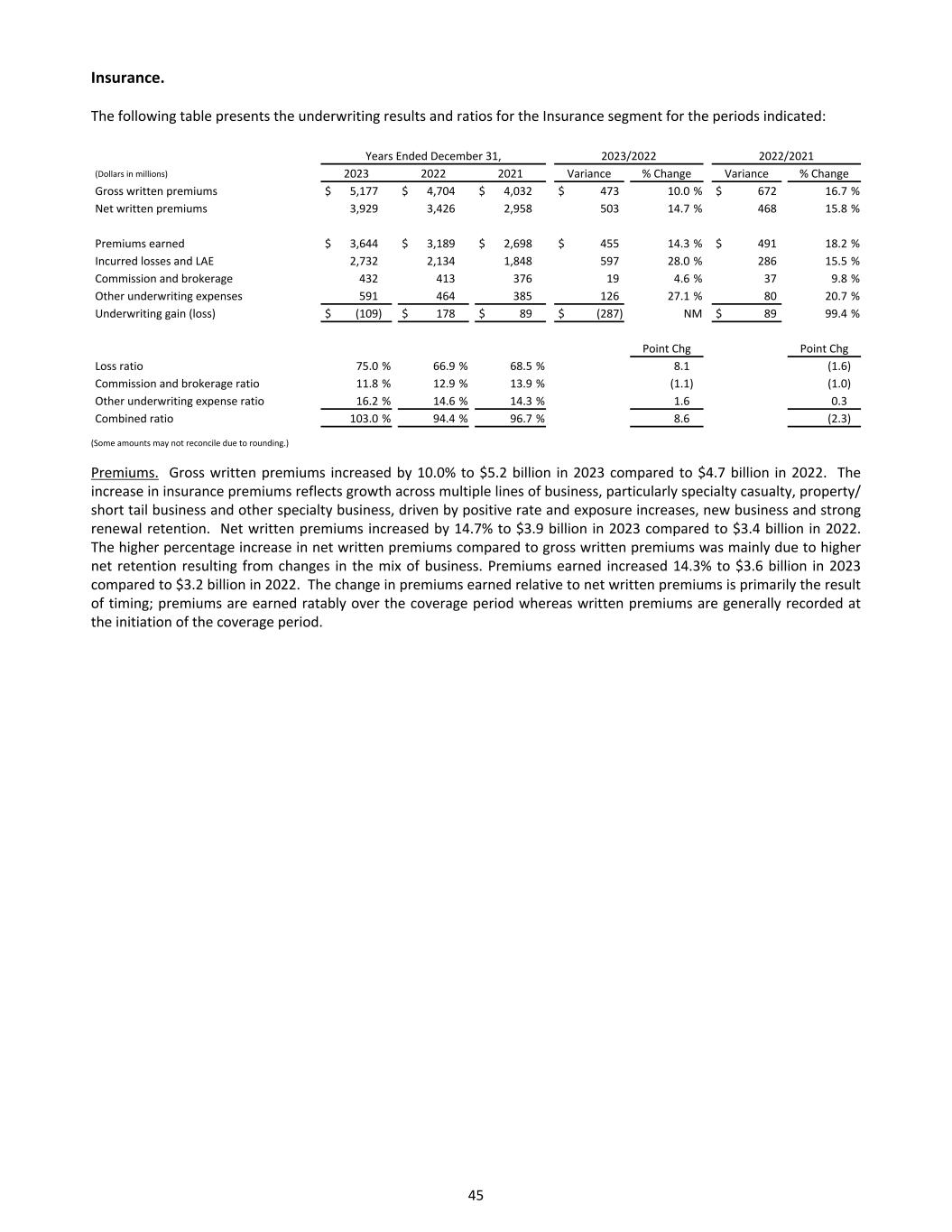
Insurance. The following table presents the underwriting results and ratios for the Insurance segment for the periods indicated: Years Ended December 31, 2023/2022 2022/2021 (Dollars in millions) 2023 2022 2021 Variance % Change Variance % Change Gross written premiums $ 5,177 $ 4,704 $ 4,032 $ 473 10.0 % $ 672 16.7 % Net written premiums 3,929 3,426 2,958 503 14.7 % 468 15.8 % Premiums earned $ 3,644 $ 3,189 $ 2,698 $ 455 14.3 % $ 491 18.2 % Incurred losses and LAE 2,732 2,134 1,848 597 28.0 % 286 15.5 % Commission and brokerage 432 413 376 19 4.6 % 37 9.8 % Other underwriting expenses 591 464 385 126 27.1 % 80 20.7 % Underwriting gain (loss) $ (109) $ 178 $ 89 $ (287) NM $ 89 99.4 % Point Chg Point Chg Loss ratio 75.0 % 66.9 % 68.5 % 8.1 (1.6) Commission and brokerage ratio 11.8 % 12.9 % 13.9 % (1.1) (1.0) Other underwriting expense ratio 16.2 % 14.6 % 14.3 % 1.6 0.3 Combined ratio 103.0 % 94.4 % 96.7 % 8.6 (2.3) (Some amounts may not reconcile due to rounding.) Premiums. Gross written premiums increased by 10.0% to $5.2 billion in 2023 compared to $4.7 billion in 2022. The increase in insurance premiums reflects growth across multiple lines of business, particularly specialty casualty, property/ short tail business and other specialty business, driven by positive rate and exposure increases, new business and strong renewal retention. Net written premiums increased by 14.7% to $3.9 billion in 2023 compared to $3.4 billion in 2022. The higher percentage increase in net written premiums compared to gross written premiums was mainly due to higher net retention resulting from changes in the mix of business. Premiums earned increased 14.3% to $3.6 billion in 2023 compared to $3.2 billion in 2022. The change in premiums earned relative to net written premiums is primarily the result of timing; premiums are earned ratably over the coverage period whereas written premiums are generally recorded at the initiation of the coverage period. 45
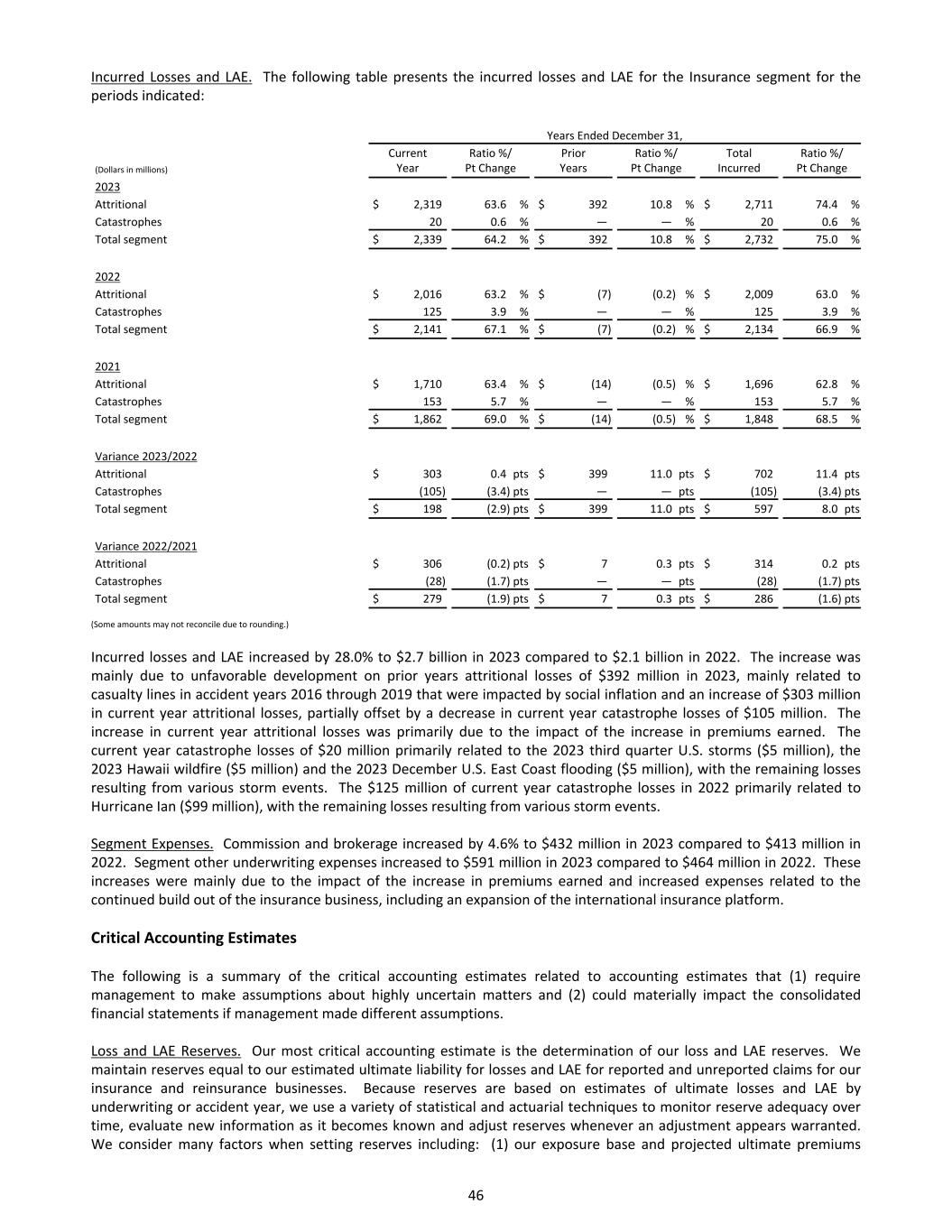
Incurred Losses and LAE. The following table presents the incurred losses and LAE for the Insurance segment for the periods indicated: Years Ended December 31, (Dollars in millions) Current Year Ratio %/ Pt Change Prior Years Ratio %/ Pt Change Total Incurred Ratio %/ Pt Change 2023 Attritional $ 2,319 63.6 % $ 392 10.8 % $ 2,711 74.4 % Catastrophes 20 0.6 % — — % 20 0.6 % Total segment $ 2,339 64.2 % $ 392 10.8 % $ 2,732 75.0 % 2022 Attritional $ 2,016 63.2 % $ (7) (0.2) % $ 2,009 63.0 % Catastrophes 125 3.9 % — — % 125 3.9 % Total segment $ 2,141 67.1 % $ (7) (0.2) % $ 2,134 66.9 % 2021 Attritional $ 1,710 63.4 % $ (14) (0.5) % $ 1,696 62.8 % Catastrophes 153 5.7 % — — % 153 5.7 % Total segment $ 1,862 69.0 % $ (14) (0.5) % $ 1,848 68.5 % Variance 2023/2022 Attritional $ 303 0.4 pts $ 399 11.0 pts $ 702 11.4 pts Catastrophes (105) (3.4) pts — — pts (105) (3.4) pts Total segment $ 198 (2.9) pts $ 399 11.0 pts $ 597 8.0 pts Variance 2022/2021 Attritional $ 306 (0.2) pts $ 7 0.3 pts $ 314 0.2 pts Catastrophes (28) (1.7) pts — — pts (28) (1.7) pts Total segment $ 279 (1.9) pts $ 7 0.3 pts $ 286 (1.6) pts (Some amounts may not reconcile due to rounding.) Incurred losses and LAE increased by 28.0% to $2.7 billion in 2023 compared to $2.1 billion in 2022. The increase was mainly due to unfavorable development on prior years attritional losses of $392 million in 2023, mainly related to casualty lines in accident years 2016 through 2019 that were impacted by social inflation and an increase of $303 million in current year attritional losses, partially offset by a decrease in current year catastrophe losses of $105 million. The increase in current year attritional losses was primarily due to the impact of the increase in premiums earned. The current year catastrophe losses of $20 million primarily related to the 2023 third quarter U.S. storms ($5 million), the 2023 Hawaii wildfire ($5 million) and the 2023 December U.S. East Coast flooding ($5 million), with the remaining losses resulting from various storm events. The $125 million of current year catastrophe losses in 2022 primarily related to Hurricane Ian ($99 million), with the remaining losses resulting from various storm events. Segment Expenses. Commission and brokerage increased by 4.6% to $432 million in 2023 compared to $413 million in 2022. Segment other underwriting expenses increased to $591 million in 2023 compared to $464 million in 2022. These increases were mainly due to the impact of the increase in premiums earned and increased expenses related to the continued build out of the insurance business, including an expansion of the international insurance platform. Critical Accounting Estimates The following is a summary of the critical accounting estimates related to accounting estimates that (1) require management to make assumptions about highly uncertain matters and (2) could materially impact the consolidated financial statements if management made different assumptions. Loss and LAE Reserves. Our most critical accounting estimate is the determination of our loss and LAE reserves. We maintain reserves equal to our estimated ultimate liability for losses and LAE for reported and unreported claims for our insurance and reinsurance businesses. Because reserves are based on estimates of ultimate losses and LAE by underwriting or accident year, we use a variety of statistical and actuarial techniques to monitor reserve adequacy over time, evaluate new information as it becomes known and adjust reserves whenever an adjustment appears warranted. We consider many factors when setting reserves including: (1) our exposure base and projected ultimate premiums 46
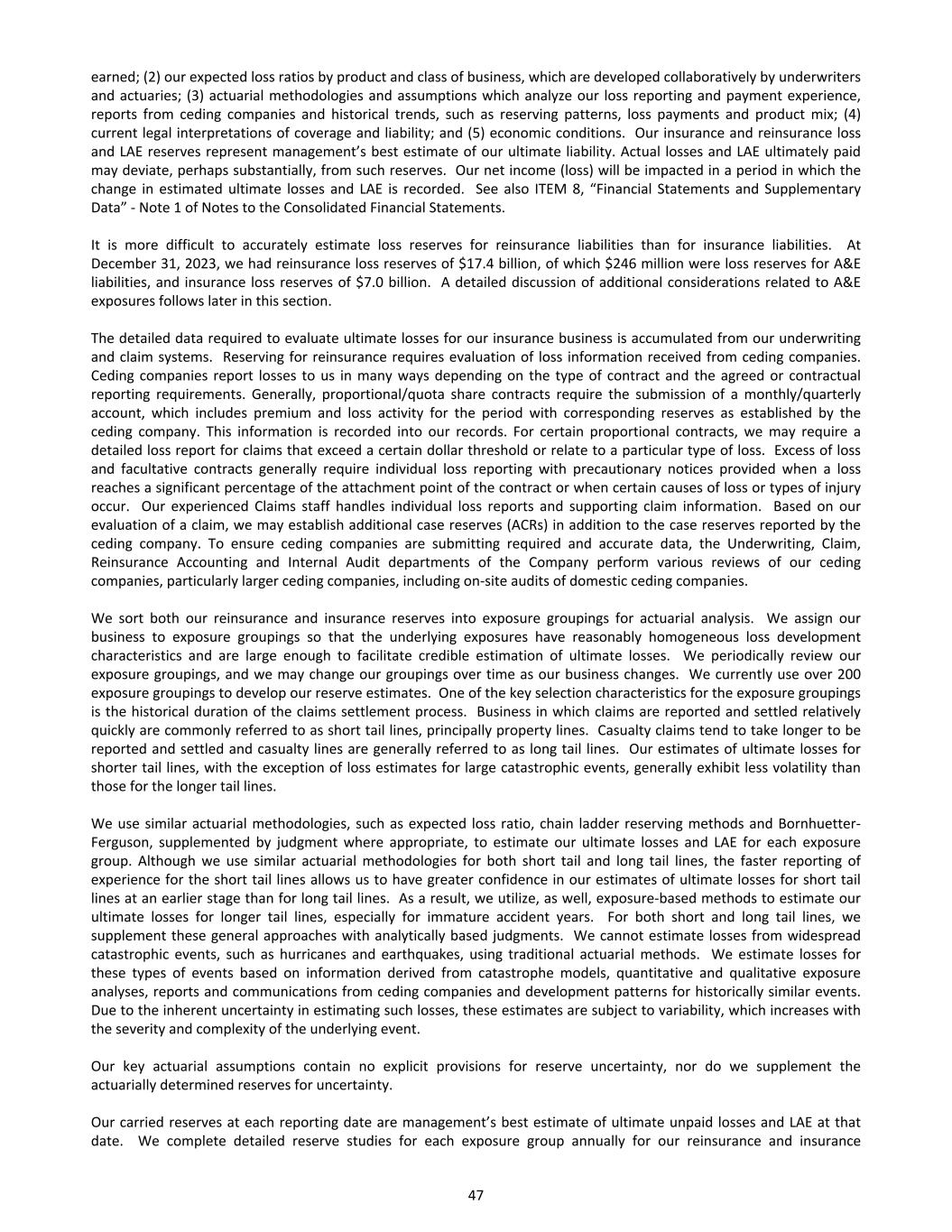
earned; (2) our expected loss ratios by product and class of business, which are developed collaboratively by underwriters and actuaries; (3) actuarial methodologies and assumptions which analyze our loss reporting and payment experience, reports from ceding companies and historical trends, such as reserving patterns, loss payments and product mix; (4) current legal interpretations of coverage and liability; and (5) economic conditions. Our insurance and reinsurance loss and LAE reserves represent management’s best estimate of our ultimate liability. Actual losses and LAE ultimately paid may deviate, perhaps substantially, from such reserves. Our net income (loss) will be impacted in a period in which the change in estimated ultimate losses and LAE is recorded. See also ITEM 8, “Financial Statements and Supplementary Data” - Note 1 of Notes to the Consolidated Financial Statements. It is more difficult to accurately estimate loss reserves for reinsurance liabilities than for insurance liabilities. At December 31, 2023, we had reinsurance loss reserves of $17.4 billion, of which $246 million were loss reserves for A&E liabilities, and insurance loss reserves of $7.0 billion. A detailed discussion of additional considerations related to A&E exposures follows later in this section. The detailed data required to evaluate ultimate losses for our insurance business is accumulated from our underwriting and claim systems. Reserving for reinsurance requires evaluation of loss information received from ceding companies. Ceding companies report losses to us in many ways depending on the type of contract and the agreed or contractual reporting requirements. Generally, proportional/quota share contracts require the submission of a monthly/quarterly account, which includes premium and loss activity for the period with corresponding reserves as established by the ceding company. This information is recorded into our records. For certain proportional contracts, we may require a detailed loss report for claims that exceed a certain dollar threshold or relate to a particular type of loss. Excess of loss and facultative contracts generally require individual loss reporting with precautionary notices provided when a loss reaches a significant percentage of the attachment point of the contract or when certain causes of loss or types of injury occur. Our experienced Claims staff handles individual loss reports and supporting claim information. Based on our evaluation of a claim, we may establish additional case reserves (ACRs) in addition to the case reserves reported by the ceding company. To ensure ceding companies are submitting required and accurate data, the Underwriting, Claim, Reinsurance Accounting and Internal Audit departments of the Company perform various reviews of our ceding companies, particularly larger ceding companies, including on-site audits of domestic ceding companies. We sort both our reinsurance and insurance reserves into exposure groupings for actuarial analysis. We assign our business to exposure groupings so that the underlying exposures have reasonably homogeneous loss development characteristics and are large enough to facilitate credible estimation of ultimate losses. We periodically review our exposure groupings, and we may change our groupings over time as our business changes. We currently use over 200 exposure groupings to develop our reserve estimates. One of the key selection characteristics for the exposure groupings is the historical duration of the claims settlement process. Business in which claims are reported and settled relatively quickly are commonly referred to as short tail lines, principally property lines. Casualty claims tend to take longer to be reported and settled and casualty lines are generally referred to as long tail lines. Our estimates of ultimate losses for shorter tail lines, with the exception of loss estimates for large catastrophic events, generally exhibit less volatility than those for the longer tail lines. We use similar actuarial methodologies, such as expected loss ratio, chain ladder reserving methods and Bornhuetter- Ferguson, supplemented by judgment where appropriate, to estimate our ultimate losses and LAE for each exposure group. Although we use similar actuarial methodologies for both short tail and long tail lines, the faster reporting of experience for the short tail lines allows us to have greater confidence in our estimates of ultimate losses for short tail lines at an earlier stage than for long tail lines. As a result, we utilize, as well, exposure-based methods to estimate our ultimate losses for longer tail lines, especially for immature accident years. For both short and long tail lines, we supplement these general approaches with analytically based judgments. We cannot estimate losses from widespread catastrophic events, such as hurricanes and earthquakes, using traditional actuarial methods. We estimate losses for these types of events based on information derived from catastrophe models, quantitative and qualitative exposure analyses, reports and communications from ceding companies and development patterns for historically similar events. Due to the inherent uncertainty in estimating such losses, these estimates are subject to variability, which increases with the severity and complexity of the underlying event. Our key actuarial assumptions contain no explicit provisions for reserve uncertainty, nor do we supplement the actuarially determined reserves for uncertainty. Our carried reserves at each reporting date are management’s best estimate of ultimate unpaid losses and LAE at that date. We complete detailed reserve studies for each exposure group annually for our reinsurance and insurance 47
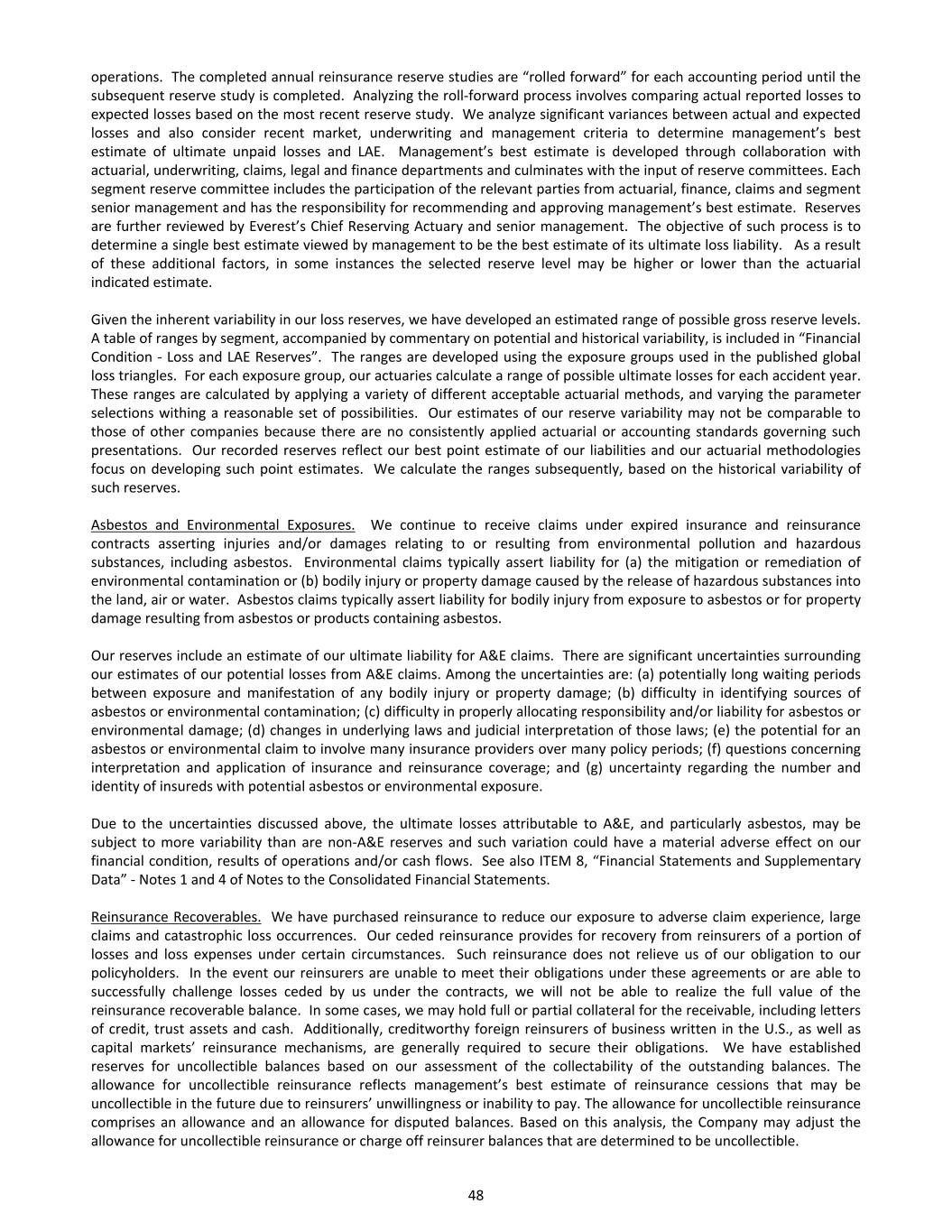
operations. The completed annual reinsurance reserve studies are “rolled forward” for each accounting period until the subsequent reserve study is completed. Analyzing the roll-forward process involves comparing actual reported losses to expected losses based on the most recent reserve study. We analyze significant variances between actual and expected losses and also consider recent market, underwriting and management criteria to determine management’s best estimate of ultimate unpaid losses and LAE. Management’s best estimate is developed through collaboration with actuarial, underwriting, claims, legal and finance departments and culminates with the input of reserve committees. Each segment reserve committee includes the participation of the relevant parties from actuarial, finance, claims and segment senior management and has the responsibility for recommending and approving management’s best estimate. Reserves are further reviewed by Everest’s Chief Reserving Actuary and senior management. The objective of such process is to determine a single best estimate viewed by management to be the best estimate of its ultimate loss liability. As a result of these additional factors, in some instances the selected reserve level may be higher or lower than the actuarial indicated estimate. Given the inherent variability in our loss reserves, we have developed an estimated range of possible gross reserve levels. A table of ranges by segment, accompanied by commentary on potential and historical variability, is included in “Financial Condition - Loss and LAE Reserves”. The ranges are developed using the exposure groups used in the published global loss triangles. For each exposure group, our actuaries calculate a range of possible ultimate losses for each accident year. These ranges are calculated by applying a variety of different acceptable actuarial methods, and varying the parameter selections withing a reasonable set of possibilities. Our estimates of our reserve variability may not be comparable to those of other companies because there are no consistently applied actuarial or accounting standards governing such presentations. Our recorded reserves reflect our best point estimate of our liabilities and our actuarial methodologies focus on developing such point estimates. We calculate the ranges subsequently, based on the historical variability of such reserves. Asbestos and Environmental Exposures. We continue to receive claims under expired insurance and reinsurance contracts asserting injuries and/or damages relating to or resulting from environmental pollution and hazardous substances, including asbestos. Environmental claims typically assert liability for (a) the mitigation or remediation of environmental contamination or (b) bodily injury or property damage caused by the release of hazardous substances into the land, air or water. Asbestos claims typically assert liability for bodily injury from exposure to asbestos or for property damage resulting from asbestos or products containing asbestos. Our reserves include an estimate of our ultimate liability for A&E claims. There are significant uncertainties surrounding our estimates of our potential losses from A&E claims. Among the uncertainties are: (a) potentially long waiting periods between exposure and manifestation of any bodily injury or property damage; (b) difficulty in identifying sources of asbestos or environmental contamination; (c) difficulty in properly allocating responsibility and/or liability for asbestos or environmental damage; (d) changes in underlying laws and judicial interpretation of those laws; (e) the potential for an asbestos or environmental claim to involve many insurance providers over many policy periods; (f) questions concerning interpretation and application of insurance and reinsurance coverage; and (g) uncertainty regarding the number and identity of insureds with potential asbestos or environmental exposure. Due to the uncertainties discussed above, the ultimate losses attributable to A&E, and particularly asbestos, may be subject to more variability than are non-A&E reserves and such variation could have a material adverse effect on our financial condition, results of operations and/or cash flows. See also ITEM 8, “Financial Statements and Supplementary Data” - Notes 1 and 4 of Notes to the Consolidated Financial Statements. Reinsurance Recoverables. We have purchased reinsurance to reduce our exposure to adverse claim experience, large claims and catastrophic loss occurrences. Our ceded reinsurance provides for recovery from reinsurers of a portion of losses and loss expenses under certain circumstances. Such reinsurance does not relieve us of our obligation to our policyholders. In the event our reinsurers are unable to meet their obligations under these agreements or are able to successfully challenge losses ceded by us under the contracts, we will not be able to realize the full value of the reinsurance recoverable balance. In some cases, we may hold full or partial collateral for the receivable, including letters of credit, trust assets and cash. Additionally, creditworthy foreign reinsurers of business written in the U.S., as well as capital markets’ reinsurance mechanisms, are generally required to secure their obligations. We have established reserves for uncollectible balances based on our assessment of the collectability of the outstanding balances. The allowance for uncollectible reinsurance reflects management’s best estimate of reinsurance cessions that may be uncollectible in the future due to reinsurers’ unwillingness or inability to pay. The allowance for uncollectible reinsurance comprises an allowance and an allowance for disputed balances. Based on this analysis, the Company may adjust the allowance for uncollectible reinsurance or charge off reinsurer balances that are determined to be uncollectible. 48
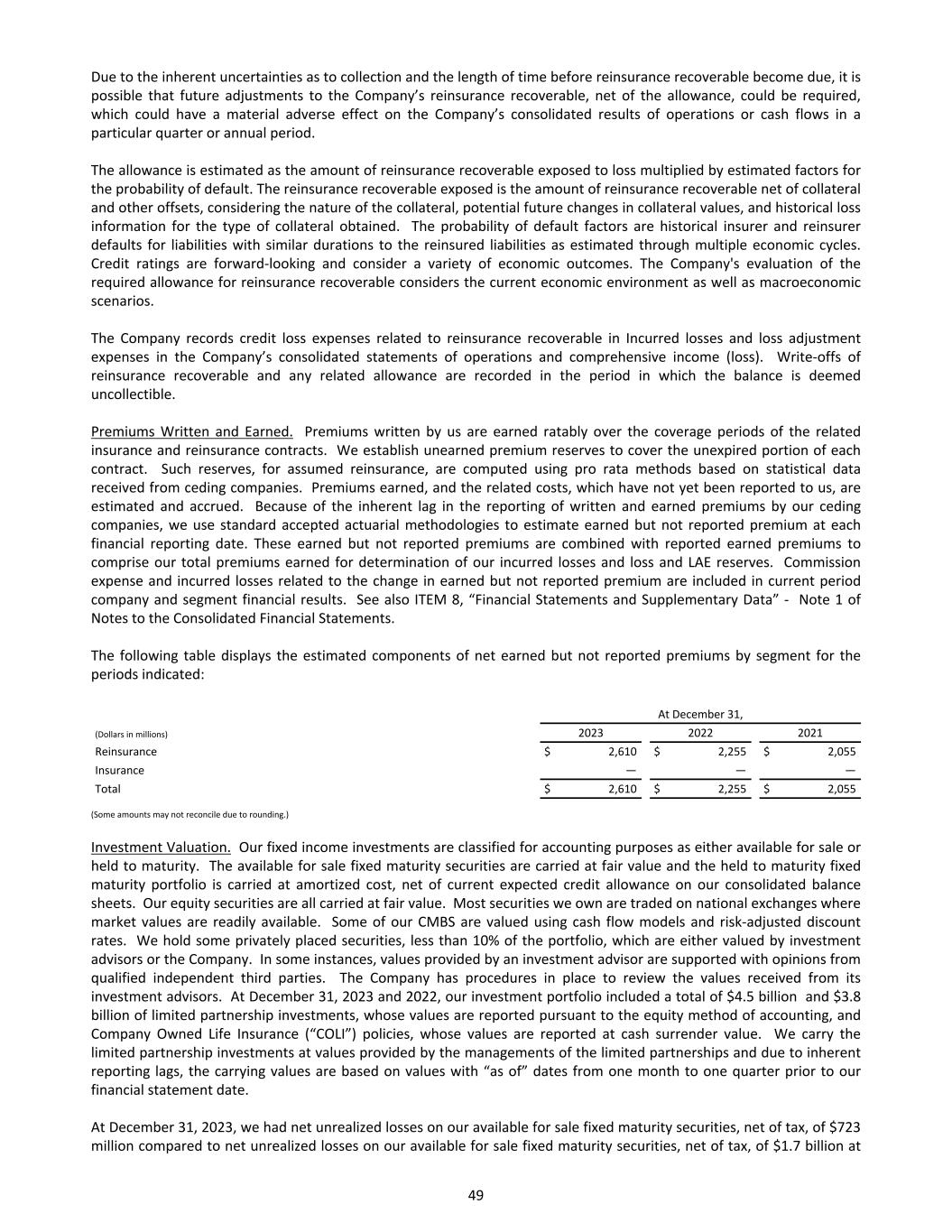
Due to the inherent uncertainties as to collection and the length of time before reinsurance recoverable become due, it is possible that future adjustments to the Company’s reinsurance recoverable, net of the allowance, could be required, which could have a material adverse effect on the Company’s consolidated results of operations or cash flows in a particular quarter or annual period. The allowance is estimated as the amount of reinsurance recoverable exposed to loss multiplied by estimated factors for the probability of default. The reinsurance recoverable exposed is the amount of reinsurance recoverable net of collateral and other offsets, considering the nature of the collateral, potential future changes in collateral values, and historical loss information for the type of collateral obtained. The probability of default factors are historical insurer and reinsurer defaults for liabilities with similar durations to the reinsured liabilities as estimated through multiple economic cycles. Credit ratings are forward-looking and consider a variety of economic outcomes. The Company's evaluation of the required allowance for reinsurance recoverable considers the current economic environment as well as macroeconomic scenarios. The Company records credit loss expenses related to reinsurance recoverable in Incurred losses and loss adjustment expenses in the Company’s consolidated statements of operations and comprehensive income (loss). Write-offs of reinsurance recoverable and any related allowance are recorded in the period in which the balance is deemed uncollectible. Premiums Written and Earned. Premiums written by us are earned ratably over the coverage periods of the related insurance and reinsurance contracts. We establish unearned premium reserves to cover the unexpired portion of each contract. Such reserves, for assumed reinsurance, are computed using pro rata methods based on statistical data received from ceding companies. Premiums earned, and the related costs, which have not yet been reported to us, are estimated and accrued. Because of the inherent lag in the reporting of written and earned premiums by our ceding companies, we use standard accepted actuarial methodologies to estimate earned but not reported premium at each financial reporting date. These earned but not reported premiums are combined with reported earned premiums to comprise our total premiums earned for determination of our incurred losses and loss and LAE reserves. Commission expense and incurred losses related to the change in earned but not reported premium are included in current period company and segment financial results. See also ITEM 8, “Financial Statements and Supplementary Data” - Note 1 of Notes to the Consolidated Financial Statements. The following table displays the estimated components of net earned but not reported premiums by segment for the periods indicated: At December 31, (Dollars in millions) 2023 2022 2021 Reinsurance $ 2,610 $ 2,255 $ 2,055 Insurance — — — Total $ 2,610 $ 2,255 $ 2,055 (Some amounts may not reconcile due to rounding.) Investment Valuation. Our fixed income investments are classified for accounting purposes as either available for sale or held to maturity. The available for sale fixed maturity securities are carried at fair value and the held to maturity fixed maturity portfolio is carried at amortized cost, net of current expected credit allowance on our consolidated balance sheets. Our equity securities are all carried at fair value. Most securities we own are traded on national exchanges where market values are readily available. Some of our CMBS are valued using cash flow models and risk-adjusted discount rates. We hold some privately placed securities, less than 10% of the portfolio, which are either valued by investment advisors or the Company. In some instances, values provided by an investment advisor are supported with opinions from qualified independent third parties. The Company has procedures in place to review the values received from its investment advisors. At December 31, 2023 and 2022, our investment portfolio included a total of $4.5 billion and $3.8 billion of limited partnership investments, whose values are reported pursuant to the equity method of accounting, and Company Owned Life Insurance (“COLI”) policies, whose values are reported at cash surrender value. We carry the limited partnership investments at values provided by the managements of the limited partnerships and due to inherent reporting lags, the carrying values are based on values with “as of” dates from one month to one quarter prior to our financial statement date. At December 31, 2023, we had net unrealized losses on our available for sale fixed maturity securities, net of tax, of $723 million compared to net unrealized losses on our available for sale fixed maturity securities, net of tax, of $1.7 billion at 49

December 31, 2022. Gains (losses) from market fluctuations on available for sale fixed maturity securities at fair value are reflected as accumulated other comprehensive income (loss) in the consolidated balance sheets. Market value declines for available for sale fixed income portfolio, which are considered credit related, are reflected in our consolidated statements of operations and comprehensive income (loss), as realized capital losses. We consider many factors when determining whether a market value decline is credit related, including: (1) we have no intent to sell and, more likely than not, will not be required to sell prior to recovery, (2) the credit strength of the issuer, (3) the issuer’s market sector, (4) the length of time to maturity and (5) for asset-backed securities, changes in prepayments, credit enhancements and underlying default rates. If management’s assessments change in the future, we may ultimately record a realized loss after management originally concluded that the decline in value was not attributed to credit related factors. Fixed maturity securities designated as held to maturity consist of debt securities for which the Company has both the positive intent and ability to hold to maturity or redemption and are reported at amortized cost, net of the current expected credit loss allowance. Interest income for fixed maturity securities held to maturity is determined in the same manner as interest income for fixed maturity securities available for sale. The Company evaluates fixed maturity securities classified as held to maturity for current expected credit losses utilizing risk characteristics of each security, including credit rating, remaining time to maturity, adjusted for prepayment considerations, and subordination level, and applying default and recovery rates, which include the incorporation of historical credit loss experience and macroeconomic forecasts, to develop an estimate of current expected credit losses. Tax. With the assent of the governor on December 27, 2023, the Bermuda Corporate Income Tax Act of 2023 (“The 2023 Act”) became law. Beginning in 2025, a 15% corporate income tax will be applicable to Bermuda businesses that are part of multinational enterprise groups with annual revenue of €750 million or more. Group’s Bermuda entities will be subject to the new corporate income tax. The Company has evaluated The 2023 Act and has recorded $578 million of net deferred income tax benefits in 2023 related to it. The net deferred income tax benefits relate primarily to a default provision in the law which allows for what is called an “Economic Transition Adjustment” (“ETA”). The ETA allows companies to establish deferred tax assets or liabilities related to the revaluation of intangible assets, excluding goodwill, and their other assets and liabilities, based on fair value as of September 30, 2023. The deferred tax assets or liabilities are then amortized in accordance with The 2023 Act. The net deferred tax assets principally relate to the identifiable intangible assets. We estimated the fair value of the identifiable intangible assets using discounted future cash flow models. The significant assumptions utilized in the discounted future cash flow models include the forecasted revenues and expected profits to be generated by the identifiable intangible assets and discount rates. See also ITEM 8, “Financial Statements and Supplementary Data” - Note 1 of Notes to the Consolidated Financial Statements. FINANCIAL CONDITION Investments. Total investments were $35.7 billion at December 31, 2023, an increase of $7.2 billion compared to $28.5 billion at December 31, 2022. The rise in investments was primarily related to an increase in fixed maturity securities, short-term investments and other invested assets. The increases in fixed maturity securities and short-term investments were primarily driven by reinvestment of the Company’s operating cash flow of $4.6 billion in 2023. The Company’s limited partnership investments are comprised of limited partnerships that invest in private equity, private credit and private real estate. Generally, the limited partnerships are reported on a month or quarter lag. We receive annual audited financial statements for all of the limited partnerships which are mostly prepared using fair value accounting in accordance with US GAAP guidance. For the quarterly reports, the Company reviews the financial reports for any unusual changes in carrying value. If the Company becomes aware of a significant decline in value during the lag reporting period, the loss will be recorded in the period in which the Company identifies the decline. The table below summarizes the composition and characteristics of our investment portfolio as of the dates indicated: At December 31, 2023 2022 Fixed income portfolio duration (years) 3.3 3.1 Fixed income composite credit quality AA- A+ 50
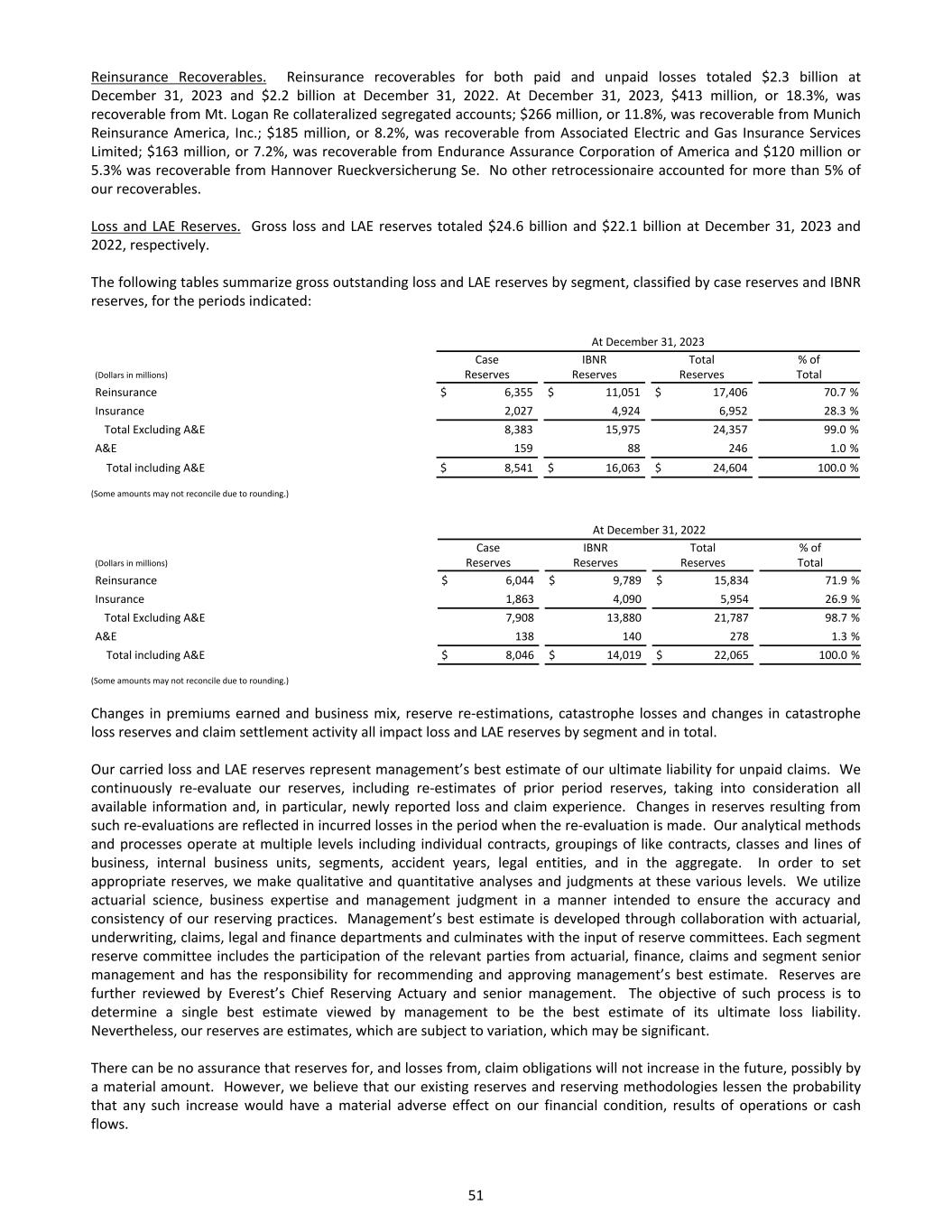
Reinsurance Recoverables. Reinsurance recoverables for both paid and unpaid losses totaled $2.3 billion at December 31, 2023 and $2.2 billion at December 31, 2022. At December 31, 2023, $413 million, or 18.3%, was recoverable from Mt. Logan Re collateralized segregated accounts; $266 million, or 11.8%, was recoverable from Munich Reinsurance America, Inc.; $185 million, or 8.2%, was recoverable from Associated Electric and Gas Insurance Services Limited; $163 million, or 7.2%, was recoverable from Endurance Assurance Corporation of America and $120 million or 5.3% was recoverable from Hannover Rueckversicherung Se. No other retrocessionaire accounted for more than 5% of our recoverables. Loss and LAE Reserves. Gross loss and LAE reserves totaled $24.6 billion and $22.1 billion at December 31, 2023 and 2022, respectively. The following tables summarize gross outstanding loss and LAE reserves by segment, classified by case reserves and IBNR reserves, for the periods indicated: At December 31, 2023 (Dollars in millions) Case Reserves IBNR Reserves Total Reserves % of Total Reinsurance $ 6,355 $ 11,051 $ 17,406 70.7 % Insurance 2,027 4,924 6,952 28.3 % Total Excluding A&E 8,383 15,975 24,357 99.0 % A&E 159 88 246 1.0 % Total including A&E $ 8,541 $ 16,063 $ 24,604 100.0 % (Some amounts may not reconcile due to rounding.) At December 31, 2022 (Dollars in millions) Case Reserves IBNR Reserves Total Reserves % of Total Reinsurance $ 6,044 $ 9,789 $ 15,834 71.9 % Insurance 1,863 4,090 5,954 26.9 % Total Excluding A&E 7,908 13,880 21,787 98.7 % A&E 138 140 278 1.3 % Total including A&E $ 8,046 $ 14,019 $ 22,065 100.0 % (Some amounts may not reconcile due to rounding.) Changes in premiums earned and business mix, reserve re-estimations, catastrophe losses and changes in catastrophe loss reserves and claim settlement activity all impact loss and LAE reserves by segment and in total. Our carried loss and LAE reserves represent management’s best estimate of our ultimate liability for unpaid claims. We continuously re-evaluate our reserves, including re-estimates of prior period reserves, taking into consideration all available information and, in particular, newly reported loss and claim experience. Changes in reserves resulting from such re-evaluations are reflected in incurred losses in the period when the re-evaluation is made. Our analytical methods and processes operate at multiple levels including individual contracts, groupings of like contracts, classes and lines of business, internal business units, segments, accident years, legal entities, and in the aggregate. In order to set appropriate reserves, we make qualitative and quantitative analyses and judgments at these various levels. We utilize actuarial science, business expertise and management judgment in a manner intended to ensure the accuracy and consistency of our reserving practices. Management’s best estimate is developed through collaboration with actuarial, underwriting, claims, legal and finance departments and culminates with the input of reserve committees. Each segment reserve committee includes the participation of the relevant parties from actuarial, finance, claims and segment senior management and has the responsibility for recommending and approving management’s best estimate. Reserves are further reviewed by Everest’s Chief Reserving Actuary and senior management. The objective of such process is to determine a single best estimate viewed by management to be the best estimate of its ultimate loss liability. Nevertheless, our reserves are estimates, which are subject to variation, which may be significant. There can be no assurance that reserves for, and losses from, claim obligations will not increase in the future, possibly by a material amount. However, we believe that our existing reserves and reserving methodologies lessen the probability that any such increase would have a material adverse effect on our financial condition, results of operations or cash flows. 51

We have included ranges for loss reserve estimates determined by our actuaries, which have been developed through a combination of objective and subjective criteria. Our presentation of this information may not be directly comparable to similar presentations of other companies as there are no consistently applied actuarial or accounting standards governing such presentations. Our recorded reserves are an aggregation of our best point estimates for approximately 200 reserve groups and reflect our best point estimate of our liabilities. Our actuarial methodologies develop point estimates rather than ranges and the ranges are developed subsequently based upon historical and prospective variability measures. The following table below represents the reserve levels and ranges for each of our business segments for the period indicated: Outstanding Reserves and Ranges By Segment (1) At December 31, 2023 (Dollars in millions) As Reported Low Range % Low Range High Range % High Range Gross Reserves By Segment Reinsurance $ 17,406 -9.0 % $ 15,841 9.0 % $ 18,971 Insurance 6,952 -13.6 % 6,004 13.6 % 7,899 Total Gross Reserves (excluding A&E) 24,357 -10.3 % 21,845 10.3 % 26,870 A&E (All segments) 246 -22.9 % 190 22.7 % 302 Total Gross Reserves $ 24,604 -10.4 % 22,035 10.4 % 27,173 (Some amounts may not reconcile due to rounding.) (1) There can be no assurance that reserves will not ultimately exceed the indicated ranges requiring additional income (loss) statement expense. Depending on the specific segment, the range derived for the loss reserves, excluding reserves for A&E exposures, ranges from minus 9.0% to minus 13.6% for the low range and from plus 9.0% to plus 13.6% for the high range. Both the higher and lower ranges are associated with the Insurance segment. The size of the range is dependent upon the level of confidence associated with the reserve estimates. Within each range, management’s best estimate of loss reserves is based upon the point estimate derived by our actuaries in detailed reserve studies. Such ranges are necessarily subjective due to the lack of generally accepted actuarial standards with respect to their development. There can be no assurance that our claim obligations will not vary outside of these ranges. Additional losses, including those relating to latent injuries, and other exposures, which are as yet unrecognized, the type or magnitude of which cannot be foreseen by us or the reinsurance and insurance industry generally, may emerge in the future. Such future emergence, to the extent not covered by existing retrocessional contracts, could have material adverse effects on our future financial condition, results of operations and cash flows. Asbestos and Environmental Exposures. A&E exposures represent a separate exposure group for monitoring and evaluating reserve adequacy. With respect to asbestos only, at December 31, 2023, we had net asbestos loss reserves of $209 million, or 90.4%, of total net A&E reserves, all of which was for assumed business. See Note 4 of Notes to Consolidated Financial Statements for a summary of Asbestos and Environmental Exposures. Ultimate loss projections for A&E liabilities cannot be accomplished using standard actuarial techniques. We believe that our A&E reserves represent management’s best estimate of the ultimate liability; however, there can be no assurance that ultimate loss payments will not exceed such reserves, perhaps by a significant amount. Industry analysts use the “survival ratio” to compare the A&E reserves among companies with such liabilities. The survival ratio is typically calculated by dividing a company’s current net reserves by the three year average of annual paid losses. Hence, the survival ratio equals the number of years that it would take to exhaust the current reserves if future loss payments were to continue at historical levels. Using this measurement, our net three year asbestos survival ratio was 6.5 years at December 31, 2023. These metrics can be skewed by individual large settlements occurring in the prior three years and therefore, may not be indicative of the timing of future payments. 52
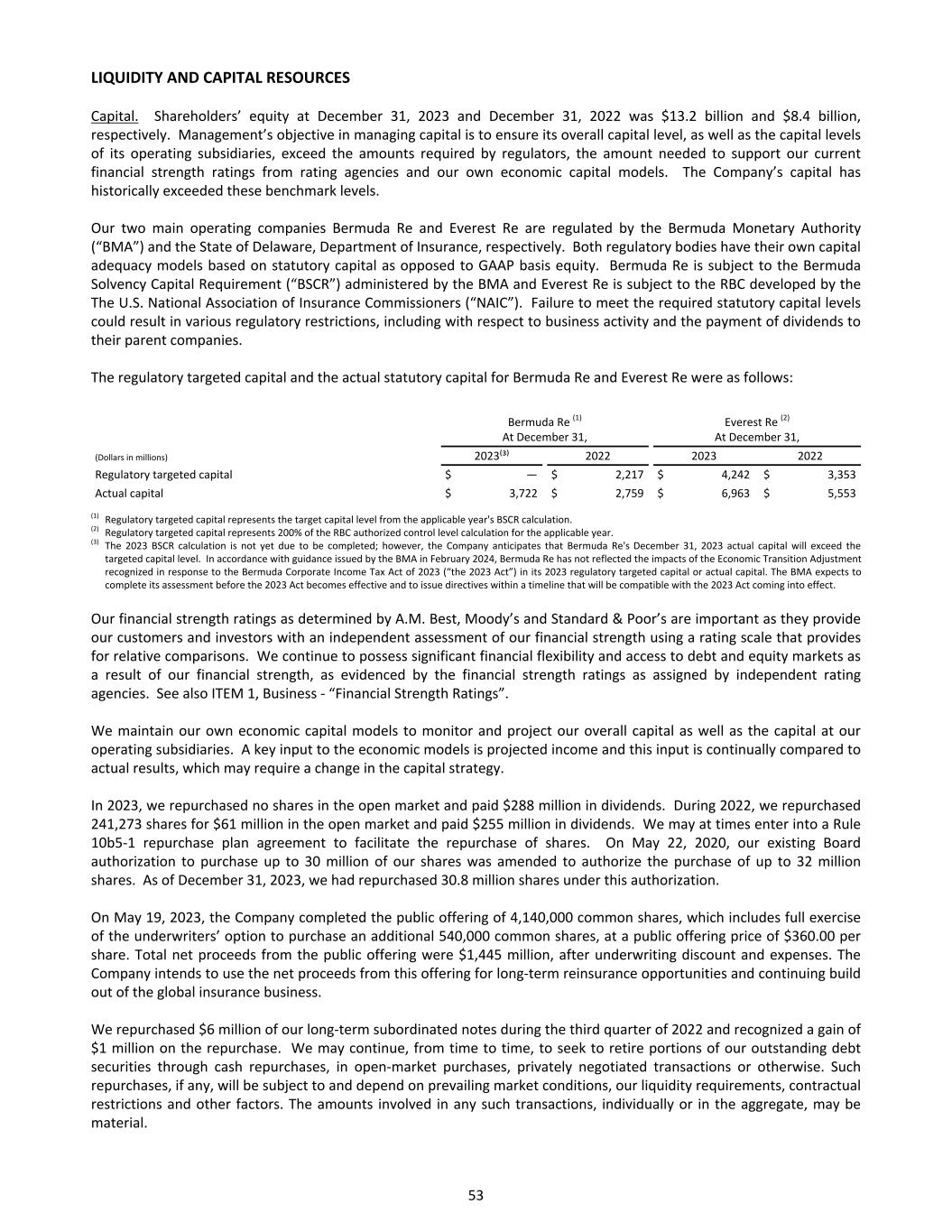
LIQUIDITY AND CAPITAL RESOURCES Capital. Shareholders’ equity at December 31, 2023 and December 31, 2022 was $13.2 billion and $8.4 billion, respectively. Management’s objective in managing capital is to ensure its overall capital level, as well as the capital levels of its operating subsidiaries, exceed the amounts required by regulators, the amount needed to support our current financial strength ratings from rating agencies and our own economic capital models. The Company’s capital has historically exceeded these benchmark levels. Our two main operating companies Bermuda Re and Everest Re are regulated by the Bermuda Monetary Authority (“BMA”) and the State of Delaware, Department of Insurance, respectively. Both regulatory bodies have their own capital adequacy models based on statutory capital as opposed to GAAP basis equity. Bermuda Re is subject to the Bermuda Solvency Capital Requirement (“BSCR”) administered by the BMA and Everest Re is subject to the RBC developed by the The U.S. National Association of Insurance Commissioners (“NAIC”). Failure to meet the required statutory capital levels could result in various regulatory restrictions, including with respect to business activity and the payment of dividends to their parent companies. The regulatory targeted capital and the actual statutory capital for Bermuda Re and Everest Re were as follows: Bermuda Re (1) At December 31, Everest Re (2) At December 31, (Dollars in millions) 2023⁽³⁾ 2022 2023 2022 Regulatory targeted capital $ — $ 2,217 $ 4,242 $ 3,353 Actual capital $ 3,722 $ 2,759 $ 6,963 $ 5,553 (1) Regulatory targeted capital represents the target capital level from the applicable year's BSCR calculation. (2) Regulatory targeted capital represents 200% of the RBC authorized control level calculation for the applicable year. (3) The 2023 BSCR calculation is not yet due to be completed; however, the Company anticipates that Bermuda Re's December 31, 2023 actual capital will exceed the targeted capital level. In accordance with guidance issued by the BMA in February 2024, Bermuda Re has not reflected the impacts of the Economic Transition Adjustment recognized in response to the Bermuda Corporate Income Tax Act of 2023 (“the 2023 Act”) in its 2023 regulatory targeted capital or actual capital. The BMA expects to complete its assessment before the 2023 Act becomes effective and to issue directives within a timeline that will be compatible with the 2023 Act coming into effect. Our financial strength ratings as determined by A.M. Best, Moody’s and Standard & Poor’s are important as they provide our customers and investors with an independent assessment of our financial strength using a rating scale that provides for relative comparisons. We continue to possess significant financial flexibility and access to debt and equity markets as a result of our financial strength, as evidenced by the financial strength ratings as assigned by independent rating agencies. See also ITEM 1, Business - “Financial Strength Ratings”. We maintain our own economic capital models to monitor and project our overall capital as well as the capital at our operating subsidiaries. A key input to the economic models is projected income and this input is continually compared to actual results, which may require a change in the capital strategy. In 2023, we repurchased no shares in the open market and paid $288 million in dividends. During 2022, we repurchased 241,273 shares for $61 million in the open market and paid $255 million in dividends. We may at times enter into a Rule 10b5-1 repurchase plan agreement to facilitate the repurchase of shares. On May 22, 2020, our existing Board authorization to purchase up to 30 million of our shares was amended to authorize the purchase of up to 32 million shares. As of December 31, 2023, we had repurchased 30.8 million shares under this authorization. On May 19, 2023, the Company completed the public offering of 4,140,000 common shares, which includes full exercise of the underwriters’ option to purchase an additional 540,000 common shares, at a public offering price of $360.00 per share. Total net proceeds from the public offering were $1,445 million, after underwriting discount and expenses. The Company intends to use the net proceeds from this offering for long-term reinsurance opportunities and continuing build out of the global insurance business. We repurchased $6 million of our long-term subordinated notes during the third quarter of 2022 and recognized a gain of $1 million on the repurchase. We may continue, from time to time, to seek to retire portions of our outstanding debt securities through cash repurchases, in open-market purchases, privately negotiated transactions or otherwise. Such repurchases, if any, will be subject to and depend on prevailing market conditions, our liquidity requirements, contractual restrictions and other factors. The amounts involved in any such transactions, individually or in the aggregate, may be material. 53
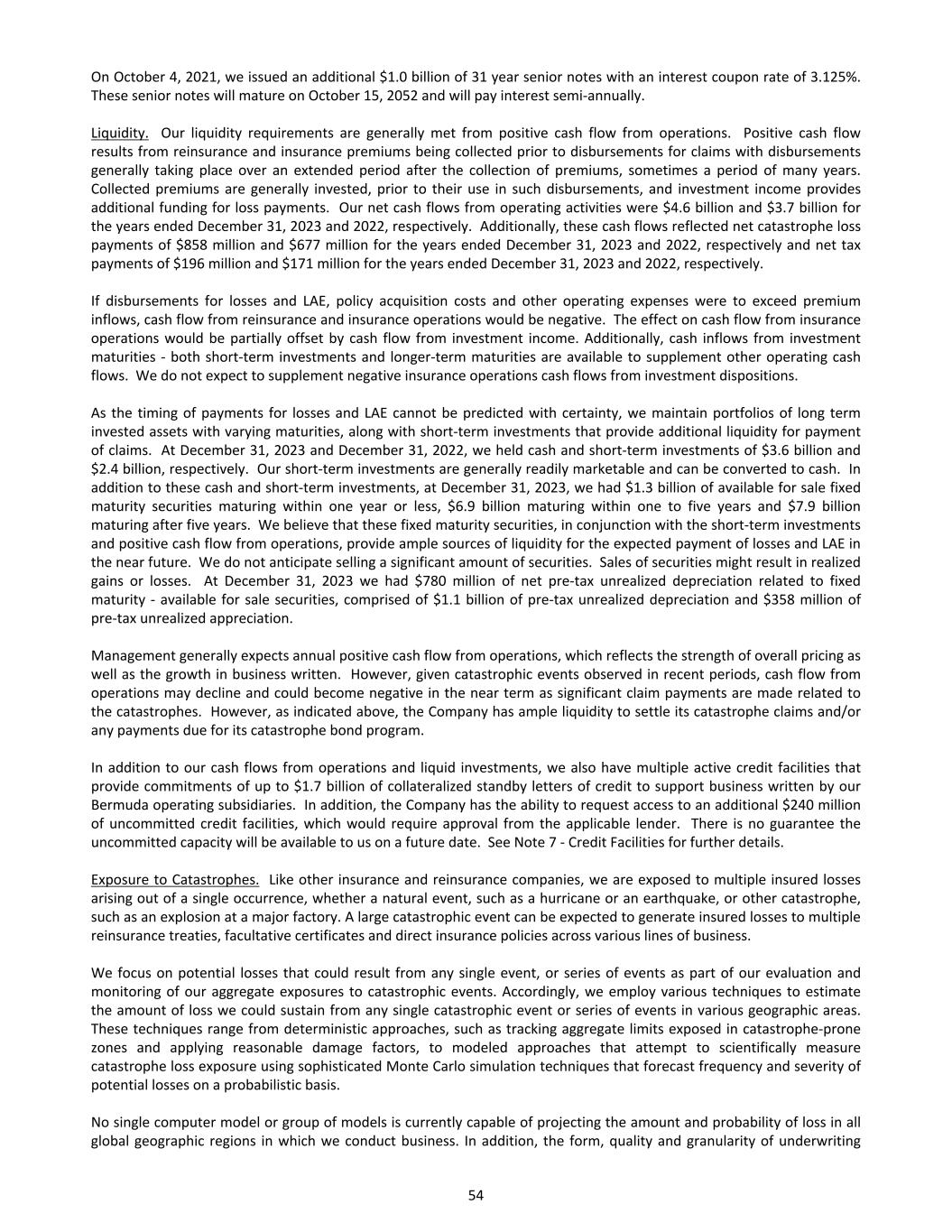
On October 4, 2021, we issued an additional $1.0 billion of 31 year senior notes with an interest coupon rate of 3.125%. These senior notes will mature on October 15, 2052 and will pay interest semi-annually. Liquidity. Our liquidity requirements are generally met from positive cash flow from operations. Positive cash flow results from reinsurance and insurance premiums being collected prior to disbursements for claims with disbursements generally taking place over an extended period after the collection of premiums, sometimes a period of many years. Collected premiums are generally invested, prior to their use in such disbursements, and investment income provides additional funding for loss payments. Our net cash flows from operating activities were $4.6 billion and $3.7 billion for the years ended December 31, 2023 and 2022, respectively. Additionally, these cash flows reflected net catastrophe loss payments of $858 million and $677 million for the years ended December 31, 2023 and 2022, respectively and net tax payments of $196 million and $171 million for the years ended December 31, 2023 and 2022, respectively. If disbursements for losses and LAE, policy acquisition costs and other operating expenses were to exceed premium inflows, cash flow from reinsurance and insurance operations would be negative. The effect on cash flow from insurance operations would be partially offset by cash flow from investment income. Additionally, cash inflows from investment maturities - both short-term investments and longer-term maturities are available to supplement other operating cash flows. We do not expect to supplement negative insurance operations cash flows from investment dispositions. As the timing of payments for losses and LAE cannot be predicted with certainty, we maintain portfolios of long term invested assets with varying maturities, along with short-term investments that provide additional liquidity for payment of claims. At December 31, 2023 and December 31, 2022, we held cash and short-term investments of $3.6 billion and $2.4 billion, respectively. Our short-term investments are generally readily marketable and can be converted to cash. In addition to these cash and short-term investments, at December 31, 2023, we had $1.3 billion of available for sale fixed maturity securities maturing within one year or less, $6.9 billion maturing within one to five years and $7.9 billion maturing after five years. We believe that these fixed maturity securities, in conjunction with the short-term investments and positive cash flow from operations, provide ample sources of liquidity for the expected payment of losses and LAE in the near future. We do not anticipate selling a significant amount of securities. Sales of securities might result in realized gains or losses. At December 31, 2023 we had $780 million of net pre-tax unrealized depreciation related to fixed maturity - available for sale securities, comprised of $1.1 billion of pre-tax unrealized depreciation and $358 million of pre-tax unrealized appreciation. Management generally expects annual positive cash flow from operations, which reflects the strength of overall pricing as well as the growth in business written. However, given catastrophic events observed in recent periods, cash flow from operations may decline and could become negative in the near term as significant claim payments are made related to the catastrophes. However, as indicated above, the Company has ample liquidity to settle its catastrophe claims and/or any payments due for its catastrophe bond program. In addition to our cash flows from operations and liquid investments, we also have multiple active credit facilities that provide commitments of up to $1.7 billion of collateralized standby letters of credit to support business written by our Bermuda operating subsidiaries. In addition, the Company has the ability to request access to an additional $240 million of uncommitted credit facilities, which would require approval from the applicable lender. There is no guarantee the uncommitted capacity will be available to us on a future date. See Note 7 - Credit Facilities for further details. Exposure to Catastrophes. Like other insurance and reinsurance companies, we are exposed to multiple insured losses arising out of a single occurrence, whether a natural event, such as a hurricane or an earthquake, or other catastrophe, such as an explosion at a major factory. A large catastrophic event can be expected to generate insured losses to multiple reinsurance treaties, facultative certificates and direct insurance policies across various lines of business. We focus on potential losses that could result from any single event, or series of events as part of our evaluation and monitoring of our aggregate exposures to catastrophic events. Accordingly, we employ various techniques to estimate the amount of loss we could sustain from any single catastrophic event or series of events in various geographic areas. These techniques range from deterministic approaches, such as tracking aggregate limits exposed in catastrophe-prone zones and applying reasonable damage factors, to modeled approaches that attempt to scientifically measure catastrophe loss exposure using sophisticated Monte Carlo simulation techniques that forecast frequency and severity of potential losses on a probabilistic basis. No single computer model or group of models is currently capable of projecting the amount and probability of loss in all global geographic regions in which we conduct business. In addition, the form, quality and granularity of underwriting 54
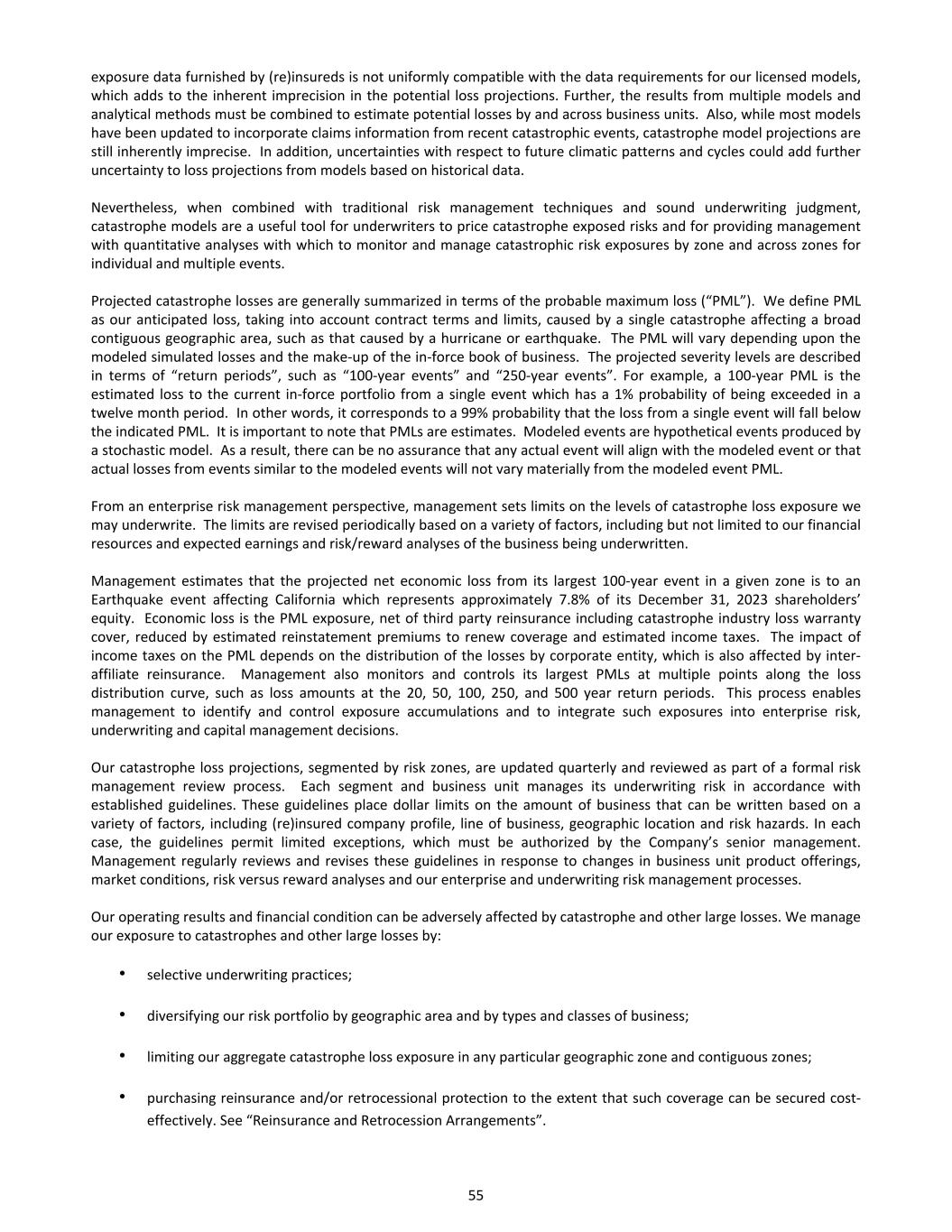
exposure data furnished by (re)insureds is not uniformly compatible with the data requirements for our licensed models, which adds to the inherent imprecision in the potential loss projections. Further, the results from multiple models and analytical methods must be combined to estimate potential losses by and across business units. Also, while most models have been updated to incorporate claims information from recent catastrophic events, catastrophe model projections are still inherently imprecise. In addition, uncertainties with respect to future climatic patterns and cycles could add further uncertainty to loss projections from models based on historical data. Nevertheless, when combined with traditional risk management techniques and sound underwriting judgment, catastrophe models are a useful tool for underwriters to price catastrophe exposed risks and for providing management with quantitative analyses with which to monitor and manage catastrophic risk exposures by zone and across zones for individual and multiple events. Projected catastrophe losses are generally summarized in terms of the probable maximum loss (“PML”). We define PML as our anticipated loss, taking into account contract terms and limits, caused by a single catastrophe affecting a broad contiguous geographic area, such as that caused by a hurricane or earthquake. The PML will vary depending upon the modeled simulated losses and the make-up of the in-force book of business. The projected severity levels are described in terms of “return periods”, such as “100-year events” and “250-year events”. For example, a 100-year PML is the estimated loss to the current in-force portfolio from a single event which has a 1% probability of being exceeded in a twelve month period. In other words, it corresponds to a 99% probability that the loss from a single event will fall below the indicated PML. It is important to note that PMLs are estimates. Modeled events are hypothetical events produced by a stochastic model. As a result, there can be no assurance that any actual event will align with the modeled event or that actual losses from events similar to the modeled events will not vary materially from the modeled event PML. From an enterprise risk management perspective, management sets limits on the levels of catastrophe loss exposure we may underwrite. The limits are revised periodically based on a variety of factors, including but not limited to our financial resources and expected earnings and risk/reward analyses of the business being underwritten. Management estimates that the projected net economic loss from its largest 100-year event in a given zone is to an Earthquake event affecting California which represents approximately 7.8% of its December 31, 2023 shareholders’ equity. Economic loss is the PML exposure, net of third party reinsurance including catastrophe industry loss warranty cover, reduced by estimated reinstatement premiums to renew coverage and estimated income taxes. The impact of income taxes on the PML depends on the distribution of the losses by corporate entity, which is also affected by inter- affiliate reinsurance. Management also monitors and controls its largest PMLs at multiple points along the loss distribution curve, such as loss amounts at the 20, 50, 100, 250, and 500 year return periods. This process enables management to identify and control exposure accumulations and to integrate such exposures into enterprise risk, underwriting and capital management decisions. Our catastrophe loss projections, segmented by risk zones, are updated quarterly and reviewed as part of a formal risk management review process. Each segment and business unit manages its underwriting risk in accordance with established guidelines. These guidelines place dollar limits on the amount of business that can be written based on a variety of factors, including (re)insured company profile, line of business, geographic location and risk hazards. In each case, the guidelines permit limited exceptions, which must be authorized by the Company’s senior management. Management regularly reviews and revises these guidelines in response to changes in business unit product offerings, market conditions, risk versus reward analyses and our enterprise and underwriting risk management processes. Our operating results and financial condition can be adversely affected by catastrophe and other large losses. We manage our exposure to catastrophes and other large losses by: • selective underwriting practices; • diversifying our risk portfolio by geographic area and by types and classes of business; • limiting our aggregate catastrophe loss exposure in any particular geographic zone and contiguous zones; • purchasing reinsurance and/or retrocessional protection to the extent that such coverage can be secured cost- effectively. See “Reinsurance and Retrocession Arrangements”. 55
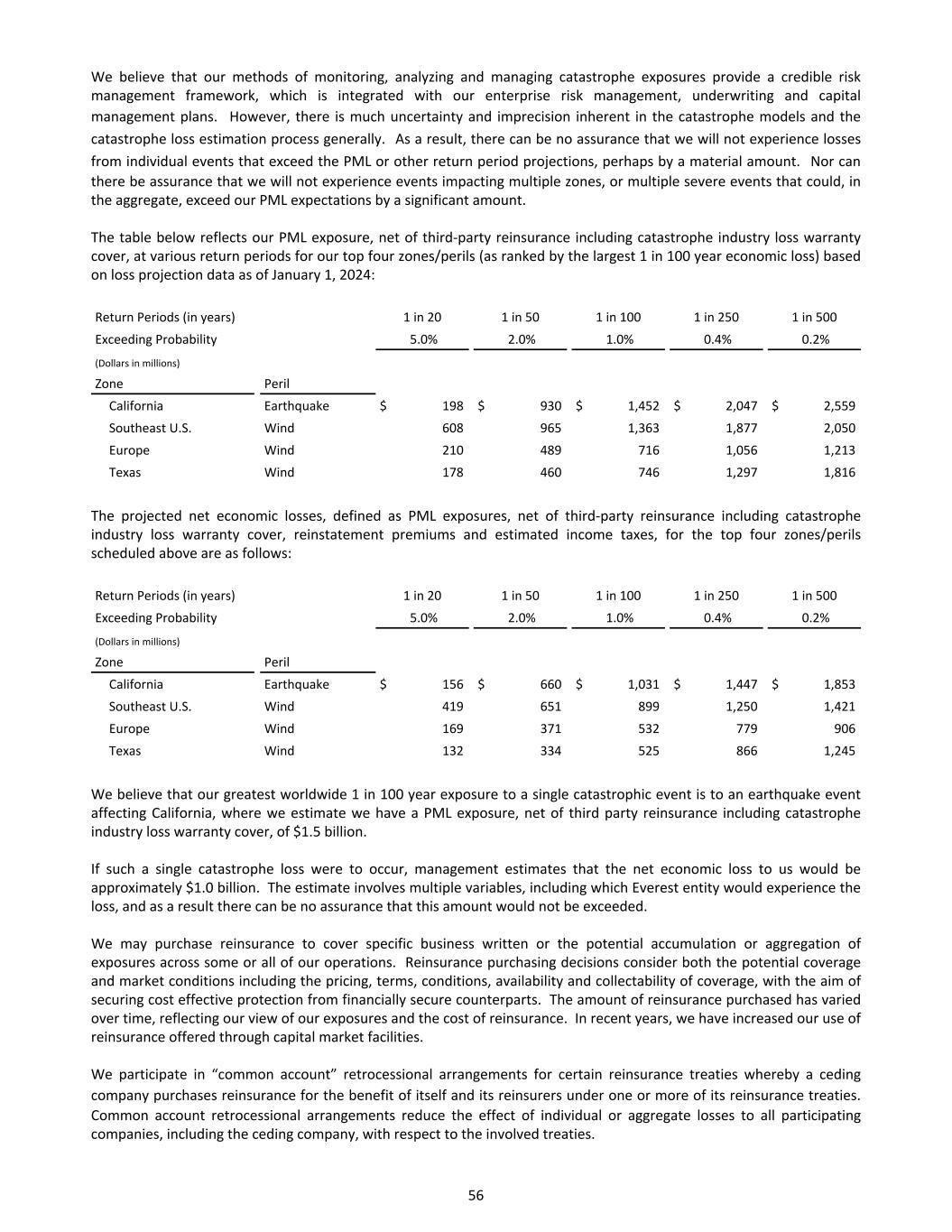
We believe that our methods of monitoring, analyzing and managing catastrophe exposures provide a credible risk management framework, which is integrated with our enterprise risk management, underwriting and capital management plans. However, there is much uncertainty and imprecision inherent in the catastrophe models and the catastrophe loss estimation process generally. As a result, there can be no assurance that we will not experience losses from individual events that exceed the PML or other return period projections, perhaps by a material amount. Nor can there be assurance that we will not experience events impacting multiple zones, or multiple severe events that could, in the aggregate, exceed our PML expectations by a significant amount. The table below reflects our PML exposure, net of third-party reinsurance including catastrophe industry loss warranty cover, at various return periods for our top four zones/perils (as ranked by the largest 1 in 100 year economic loss) based on loss projection data as of January 1, 2024: Return Periods (in years) 1 in 20 1 in 50 1 in 100 1 in 250 1 in 500 Exceeding Probability 5.0% 2.0% 1.0% 0.4% 0.2% (Dollars in millions) Zone Peril California Earthquake $ 198 $ 930 $ 1,452 $ 2,047 $ 2,559 Southeast U.S. Wind 608 965 1,363 1,877 2,050 Europe Wind 210 489 716 1,056 1,213 Texas Wind 178 460 746 1,297 1,816 The projected net economic losses, defined as PML exposures, net of third-party reinsurance including catastrophe industry loss warranty cover, reinstatement premiums and estimated income taxes, for the top four zones/perils scheduled above are as follows: Return Periods (in years) 1 in 20 1 in 50 1 in 100 1 in 250 1 in 500 Exceeding Probability 5.0% 2.0% 1.0% 0.4% 0.2% (Dollars in millions) Zone Peril California Earthquake $ 156 $ 660 $ 1,031 $ 1,447 $ 1,853 Southeast U.S. Wind 419 651 899 1,250 1,421 Europe Wind 169 371 532 779 906 Texas Wind 132 334 525 866 1,245 We believe that our greatest worldwide 1 in 100 year exposure to a single catastrophic event is to an earthquake event affecting California, where we estimate we have a PML exposure, net of third party reinsurance including catastrophe industry loss warranty cover, of $1.5 billion. If such a single catastrophe loss were to occur, management estimates that the net economic loss to us would be approximately $1.0 billion. The estimate involves multiple variables, including which Everest entity would experience the loss, and as a result there can be no assurance that this amount would not be exceeded. We may purchase reinsurance to cover specific business written or the potential accumulation or aggregation of exposures across some or all of our operations. Reinsurance purchasing decisions consider both the potential coverage and market conditions including the pricing, terms, conditions, availability and collectability of coverage, with the aim of securing cost effective protection from financially secure counterparts. The amount of reinsurance purchased has varied over time, reflecting our view of our exposures and the cost of reinsurance. In recent years, we have increased our use of reinsurance offered through capital market facilities. We participate in “common account” retrocessional arrangements for certain reinsurance treaties whereby a ceding company purchases reinsurance for the benefit of itself and its reinsurers under one or more of its reinsurance treaties. Common account retrocessional arrangements reduce the effect of individual or aggregate losses to all participating companies, including the ceding company, with respect to the involved treaties. 56
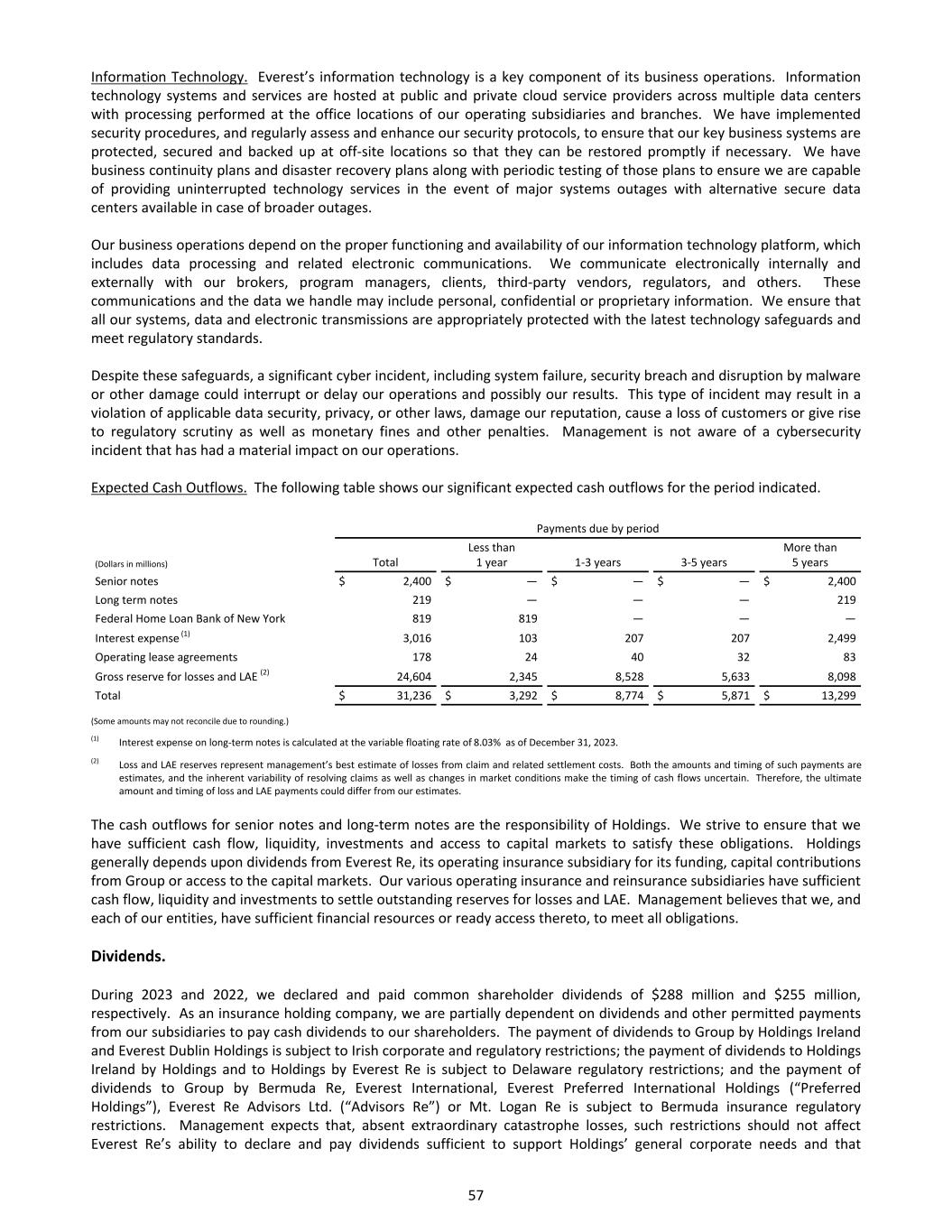
Information Technology. Everest’s information technology is a key component of its business operations. Information technology systems and services are hosted at public and private cloud service providers across multiple data centers with processing performed at the office locations of our operating subsidiaries and branches. We have implemented security procedures, and regularly assess and enhance our security protocols, to ensure that our key business systems are protected, secured and backed up at off-site locations so that they can be restored promptly if necessary. We have business continuity plans and disaster recovery plans along with periodic testing of those plans to ensure we are capable of providing uninterrupted technology services in the event of major systems outages with alternative secure data centers available in case of broader outages. Our business operations depend on the proper functioning and availability of our information technology platform, which includes data processing and related electronic communications. We communicate electronically internally and externally with our brokers, program managers, clients, third-party vendors, regulators, and others. These communications and the data we handle may include personal, confidential or proprietary information. We ensure that all our systems, data and electronic transmissions are appropriately protected with the latest technology safeguards and meet regulatory standards. Despite these safeguards, a significant cyber incident, including system failure, security breach and disruption by malware or other damage could interrupt or delay our operations and possibly our results. This type of incident may result in a violation of applicable data security, privacy, or other laws, damage our reputation, cause a loss of customers or give rise to regulatory scrutiny as well as monetary fines and other penalties. Management is not aware of a cybersecurity incident that has had a material impact on our operations. Expected Cash Outflows. The following table shows our significant expected cash outflows for the period indicated. Payments due by period (Dollars in millions) Total Less than 1 year 1-3 years 3-5 years More than 5 years Senior notes $ 2,400 $ — $ — $ — $ 2,400 Long term notes 219 — — — 219 Federal Home Loan Bank of New York 819 819 — — — Interest expense (1) 3,016 103 207 207 2,499 Operating lease agreements 178 24 40 32 83 Gross reserve for losses and LAE (2) 24,604 2,345 8,528 5,633 8,098 Total $ 31,236 $ 3,292 $ 8,774 $ 5,871 $ 13,299 (Some amounts may not reconcile due to rounding.) (1) Interest expense on long-term notes is calculated at the variable floating rate of 8.03% as of December 31, 2023. (2) Loss and LAE reserves represent management’s best estimate of losses from claim and related settlement costs. Both the amounts and timing of such payments are estimates, and the inherent variability of resolving claims as well as changes in market conditions make the timing of cash flows uncertain. Therefore, the ultimate amount and timing of loss and LAE payments could differ from our estimates. The cash outflows for senior notes and long-term notes are the responsibility of Holdings. We strive to ensure that we have sufficient cash flow, liquidity, investments and access to capital markets to satisfy these obligations. Holdings generally depends upon dividends from Everest Re, its operating insurance subsidiary for its funding, capital contributions from Group or access to the capital markets. Our various operating insurance and reinsurance subsidiaries have sufficient cash flow, liquidity and investments to settle outstanding reserves for losses and LAE. Management believes that we, and each of our entities, have sufficient financial resources or ready access thereto, to meet all obligations. Dividends. During 2023 and 2022, we declared and paid common shareholder dividends of $288 million and $255 million, respectively. As an insurance holding company, we are partially dependent on dividends and other permitted payments from our subsidiaries to pay cash dividends to our shareholders. The payment of dividends to Group by Holdings Ireland and Everest Dublin Holdings is subject to Irish corporate and regulatory restrictions; the payment of dividends to Holdings Ireland by Holdings and to Holdings by Everest Re is subject to Delaware regulatory restrictions; and the payment of dividends to Group by Bermuda Re, Everest International, Everest Preferred International Holdings (“Preferred Holdings”), Everest Re Advisors Ltd. (“Advisors Re”) or Mt. Logan Re is subject to Bermuda insurance regulatory restrictions. Management expects that, absent extraordinary catastrophe losses, such restrictions should not affect Everest Re’s ability to declare and pay dividends sufficient to support Holdings’ general corporate needs and that 57
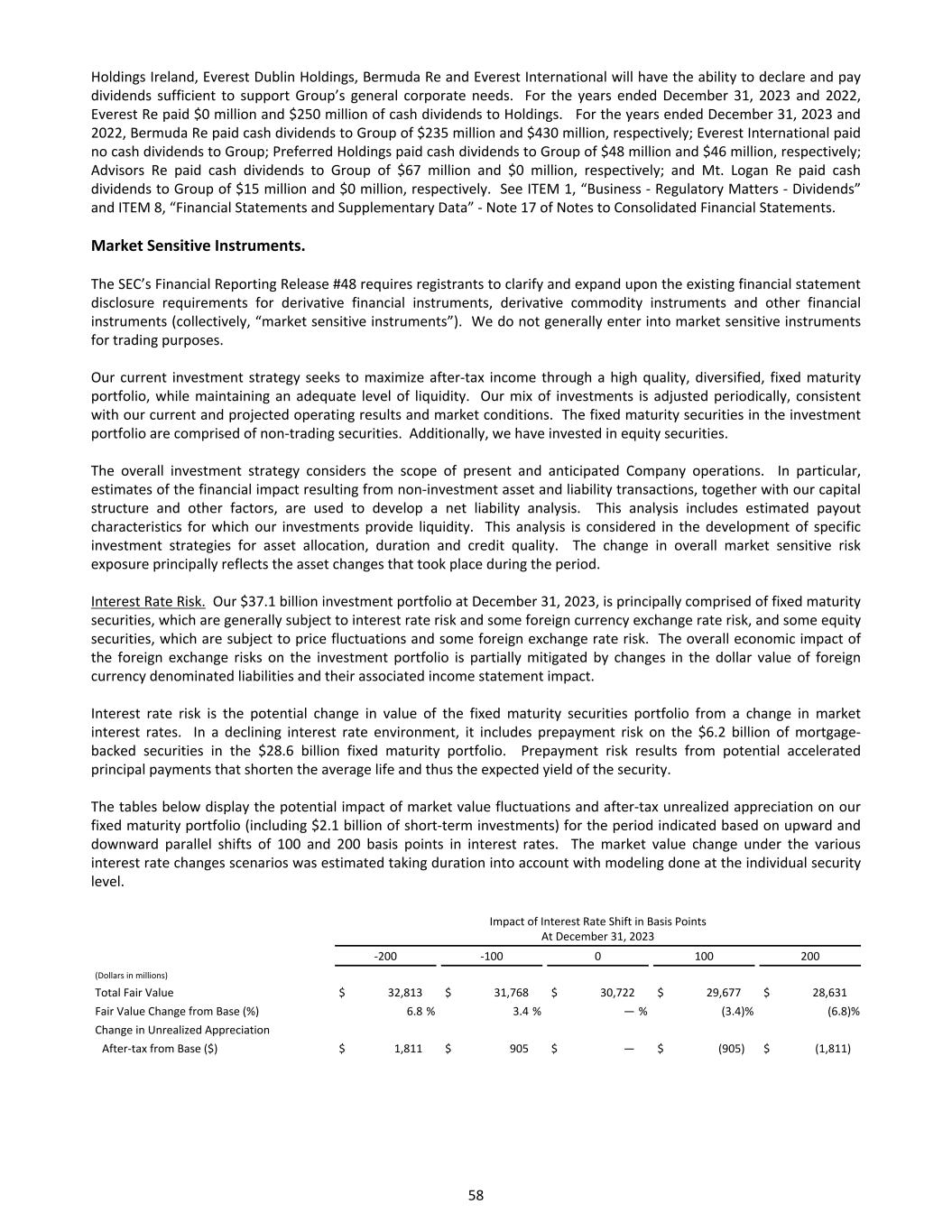
Holdings Ireland, Everest Dublin Holdings, Bermuda Re and Everest International will have the ability to declare and pay dividends sufficient to support Group’s general corporate needs. For the years ended December 31, 2023 and 2022, Everest Re paid $0 million and $250 million of cash dividends to Holdings. For the years ended December 31, 2023 and 2022, Bermuda Re paid cash dividends to Group of $235 million and $430 million, respectively; Everest International paid no cash dividends to Group; Preferred Holdings paid cash dividends to Group of $48 million and $46 million, respectively; Advisors Re paid cash dividends to Group of $67 million and $0 million, respectively; and Mt. Logan Re paid cash dividends to Group of $15 million and $0 million, respectively. See ITEM 1, “Business - Regulatory Matters - Dividends” and ITEM 8, “Financial Statements and Supplementary Data” - Note 17 of Notes to Consolidated Financial Statements. Market Sensitive Instruments. The SEC’s Financial Reporting Release #48 requires registrants to clarify and expand upon the existing financial statement disclosure requirements for derivative financial instruments, derivative commodity instruments and other financial instruments (collectively, “market sensitive instruments”). We do not generally enter into market sensitive instruments for trading purposes. Our current investment strategy seeks to maximize after-tax income through a high quality, diversified, fixed maturity portfolio, while maintaining an adequate level of liquidity. Our mix of investments is adjusted periodically, consistent with our current and projected operating results and market conditions. The fixed maturity securities in the investment portfolio are comprised of non-trading securities. Additionally, we have invested in equity securities. The overall investment strategy considers the scope of present and anticipated Company operations. In particular, estimates of the financial impact resulting from non-investment asset and liability transactions, together with our capital structure and other factors, are used to develop a net liability analysis. This analysis includes estimated payout characteristics for which our investments provide liquidity. This analysis is considered in the development of specific investment strategies for asset allocation, duration and credit quality. The change in overall market sensitive risk exposure principally reflects the asset changes that took place during the period. Interest Rate Risk. Our $37.1 billion investment portfolio at December 31, 2023, is principally comprised of fixed maturity securities, which are generally subject to interest rate risk and some foreign currency exchange rate risk, and some equity securities, which are subject to price fluctuations and some foreign exchange rate risk. The overall economic impact of the foreign exchange risks on the investment portfolio is partially mitigated by changes in the dollar value of foreign currency denominated liabilities and their associated income statement impact. Interest rate risk is the potential change in value of the fixed maturity securities portfolio from a change in market interest rates. In a declining interest rate environment, it includes prepayment risk on the $6.2 billion of mortgage- backed securities in the $28.6 billion fixed maturity portfolio. Prepayment risk results from potential accelerated principal payments that shorten the average life and thus the expected yield of the security. The tables below display the potential impact of market value fluctuations and after-tax unrealized appreciation on our fixed maturity portfolio (including $2.1 billion of short-term investments) for the period indicated based on upward and downward parallel shifts of 100 and 200 basis points in interest rates. The market value change under the various interest rate changes scenarios was estimated taking duration into account with modeling done at the individual security level. Impact of Interest Rate Shift in Basis Points At December 31, 2023 -200 -100 0 100 200 (Dollars in millions) Total Fair Value $ 32,813 $ 31,768 $ 30,722 $ 29,677 $ 28,631 Fair Value Change from Base (%) 6.8 % 3.4 % — % (3.4) % (6.8) % Change in Unrealized Appreciation After-tax from Base ($) $ 1,811 $ 905 $ — $ (905) $ (1,811) 58
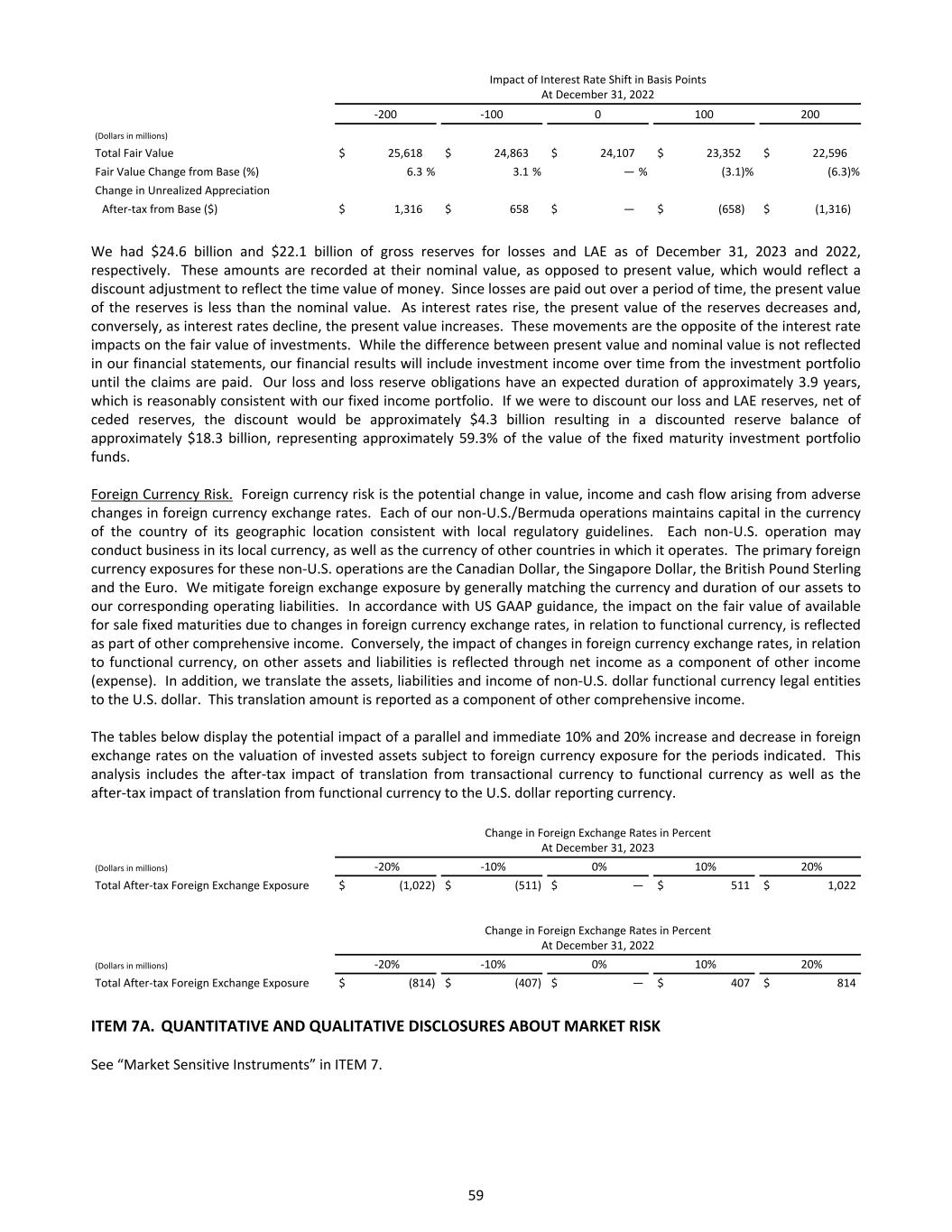
Impact of Interest Rate Shift in Basis Points At December 31, 2022 -200 -100 0 100 200 (Dollars in millions) Total Fair Value $ 25,618 $ 24,863 $ 24,107 $ 23,352 $ 22,596 Fair Value Change from Base (%) 6.3 % 3.1 % — % (3.1) % (6.3) % Change in Unrealized Appreciation After-tax from Base ($) $ 1,316 $ 658 $ — $ (658) $ (1,316) We had $24.6 billion and $22.1 billion of gross reserves for losses and LAE as of December 31, 2023 and 2022, respectively. These amounts are recorded at their nominal value, as opposed to present value, which would reflect a discount adjustment to reflect the time value of money. Since losses are paid out over a period of time, the present value of the reserves is less than the nominal value. As interest rates rise, the present value of the reserves decreases and, conversely, as interest rates decline, the present value increases. These movements are the opposite of the interest rate impacts on the fair value of investments. While the difference between present value and nominal value is not reflected in our financial statements, our financial results will include investment income over time from the investment portfolio until the claims are paid. Our loss and loss reserve obligations have an expected duration of approximately 3.9 years, which is reasonably consistent with our fixed income portfolio. If we were to discount our loss and LAE reserves, net of ceded reserves, the discount would be approximately $4.3 billion resulting in a discounted reserve balance of approximately $18.3 billion, representing approximately 59.3% of the value of the fixed maturity investment portfolio funds. Foreign Currency Risk. Foreign currency risk is the potential change in value, income and cash flow arising from adverse changes in foreign currency exchange rates. Each of our non-U.S./Bermuda operations maintains capital in the currency of the country of its geographic location consistent with local regulatory guidelines. Each non-U.S. operation may conduct business in its local currency, as well as the currency of other countries in which it operates. The primary foreign currency exposures for these non-U.S. operations are the Canadian Dollar, the Singapore Dollar, the British Pound Sterling and the Euro. We mitigate foreign exchange exposure by generally matching the currency and duration of our assets to our corresponding operating liabilities. In accordance with US GAAP guidance, the impact on the fair value of available for sale fixed maturities due to changes in foreign currency exchange rates, in relation to functional currency, is reflected as part of other comprehensive income. Conversely, the impact of changes in foreign currency exchange rates, in relation to functional currency, on other assets and liabilities is reflected through net income as a component of other income (expense). In addition, we translate the assets, liabilities and income of non-U.S. dollar functional currency legal entities to the U.S. dollar. This translation amount is reported as a component of other comprehensive income. The tables below display the potential impact of a parallel and immediate 10% and 20% increase and decrease in foreign exchange rates on the valuation of invested assets subject to foreign currency exposure for the periods indicated. This analysis includes the after-tax impact of translation from transactional currency to functional currency as well as the after-tax impact of translation from functional currency to the U.S. dollar reporting currency. Change in Foreign Exchange Rates in Percent At December 31, 2023 (Dollars in millions) -20% -10% 0% 10% 20% Total After-tax Foreign Exchange Exposure $ (1,022) $ (511) $ — $ 511 $ 1,022 Change in Foreign Exchange Rates in Percent At December 31, 2022 (Dollars in millions) -20% -10% 0% 10% 20% Total After-tax Foreign Exchange Exposure $ (814) $ (407) $ — $ 407 $ 814 ITEM 7A. QUANTITATIVE AND QUALITATIVE DISCLOSURES ABOUT MARKET RISK See “Market Sensitive Instruments” in ITEM 7. 59
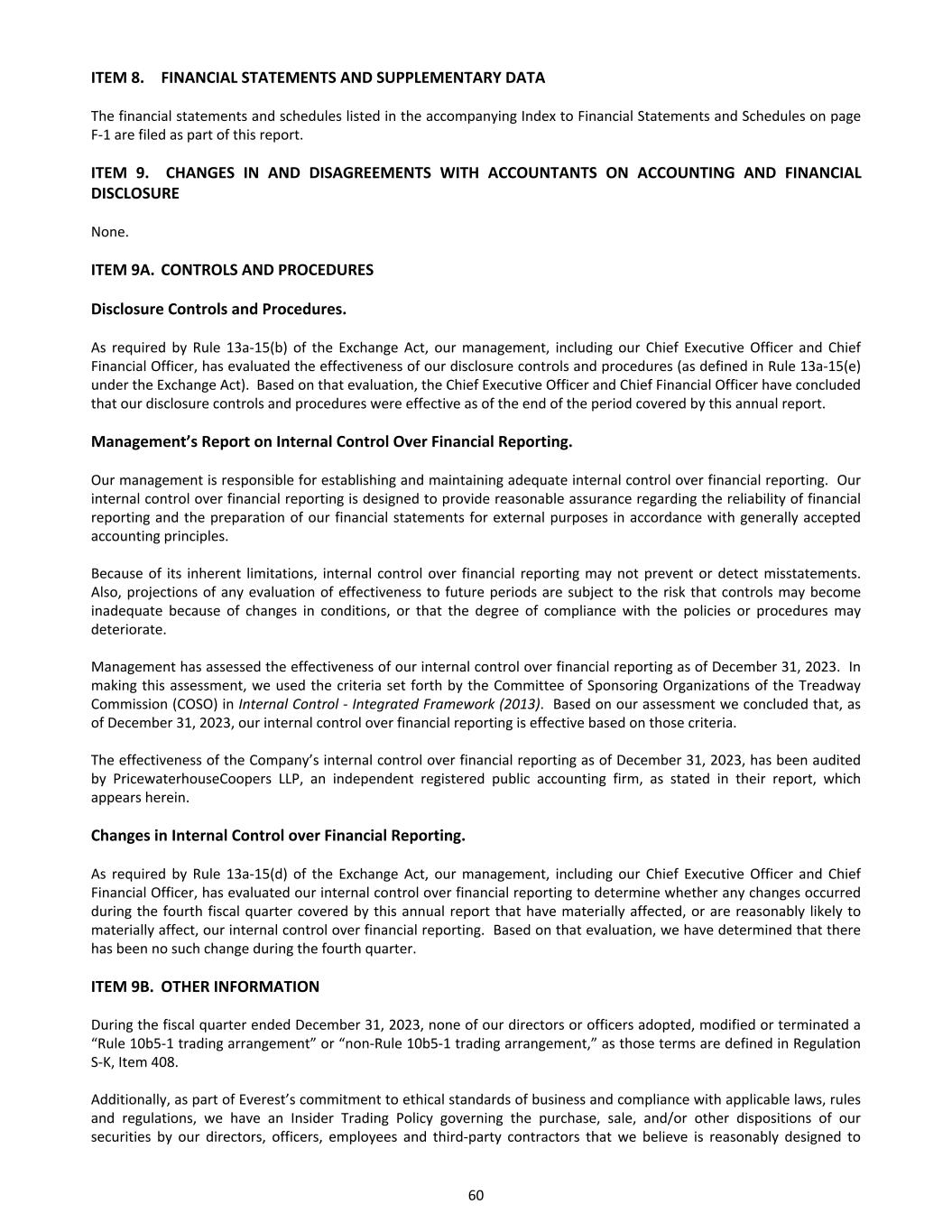
ITEM 8. FINANCIAL STATEMENTS AND SUPPLEMENTARY DATA The financial statements and schedules listed in the accompanying Index to Financial Statements and Schedules on page F-1 are filed as part of this report. ITEM 9. CHANGES IN AND DISAGREEMENTS WITH ACCOUNTANTS ON ACCOUNTING AND FINANCIAL DISCLOSURE None. ITEM 9A. CONTROLS AND PROCEDURES Disclosure Controls and Procedures. As required by Rule 13a-15(b) of the Exchange Act, our management, including our Chief Executive Officer and Chief Financial Officer, has evaluated the effectiveness of our disclosure controls and procedures (as defined in Rule 13a-15(e) under the Exchange Act). Based on that evaluation, the Chief Executive Officer and Chief Financial Officer have concluded that our disclosure controls and procedures were effective as of the end of the period covered by this annual report. Management’s Report on Internal Control Over Financial Reporting. Our management is responsible for establishing and maintaining adequate internal control over financial reporting. Our internal control over financial reporting is designed to provide reasonable assurance regarding the reliability of financial reporting and the preparation of our financial statements for external purposes in accordance with generally accepted accounting principles. Because of its inherent limitations, internal control over financial reporting may not prevent or detect misstatements. Also, projections of any evaluation of effectiveness to future periods are subject to the risk that controls may become inadequate because of changes in conditions, or that the degree of compliance with the policies or procedures may deteriorate. Management has assessed the effectiveness of our internal control over financial reporting as of December 31, 2023. In making this assessment, we used the criteria set forth by the Committee of Sponsoring Organizations of the Treadway Commission (COSO) in Internal Control - Integrated Framework (2013). Based on our assessment we concluded that, as of December 31, 2023, our internal control over financial reporting is effective based on those criteria. The effectiveness of the Company’s internal control over financial reporting as of December 31, 2023, has been audited by PricewaterhouseCoopers LLP, an independent registered public accounting firm, as stated in their report, which appears herein. Changes in Internal Control over Financial Reporting. As required by Rule 13a-15(d) of the Exchange Act, our management, including our Chief Executive Officer and Chief Financial Officer, has evaluated our internal control over financial reporting to determine whether any changes occurred during the fourth fiscal quarter covered by this annual report that have materially affected, or are reasonably likely to materially affect, our internal control over financial reporting. Based on that evaluation, we have determined that there has been no such change during the fourth quarter. ITEM 9B. OTHER INFORMATION During the fiscal quarter ended December 31, 2023, none of our directors or officers adopted, modified or terminated a “Rule 10b5-1 trading arrangement” or “non-Rule 10b5-1 trading arrangement,” as those terms are defined in Regulation S-K, Item 408. Additionally, as part of Everest’s commitment to ethical standards of business and compliance with applicable laws, rules and regulations, we have an Insider Trading Policy governing the purchase, sale, and/or other dispositions of our securities by our directors, officers, employees and third-party contractors that we believe is reasonably designed to 60
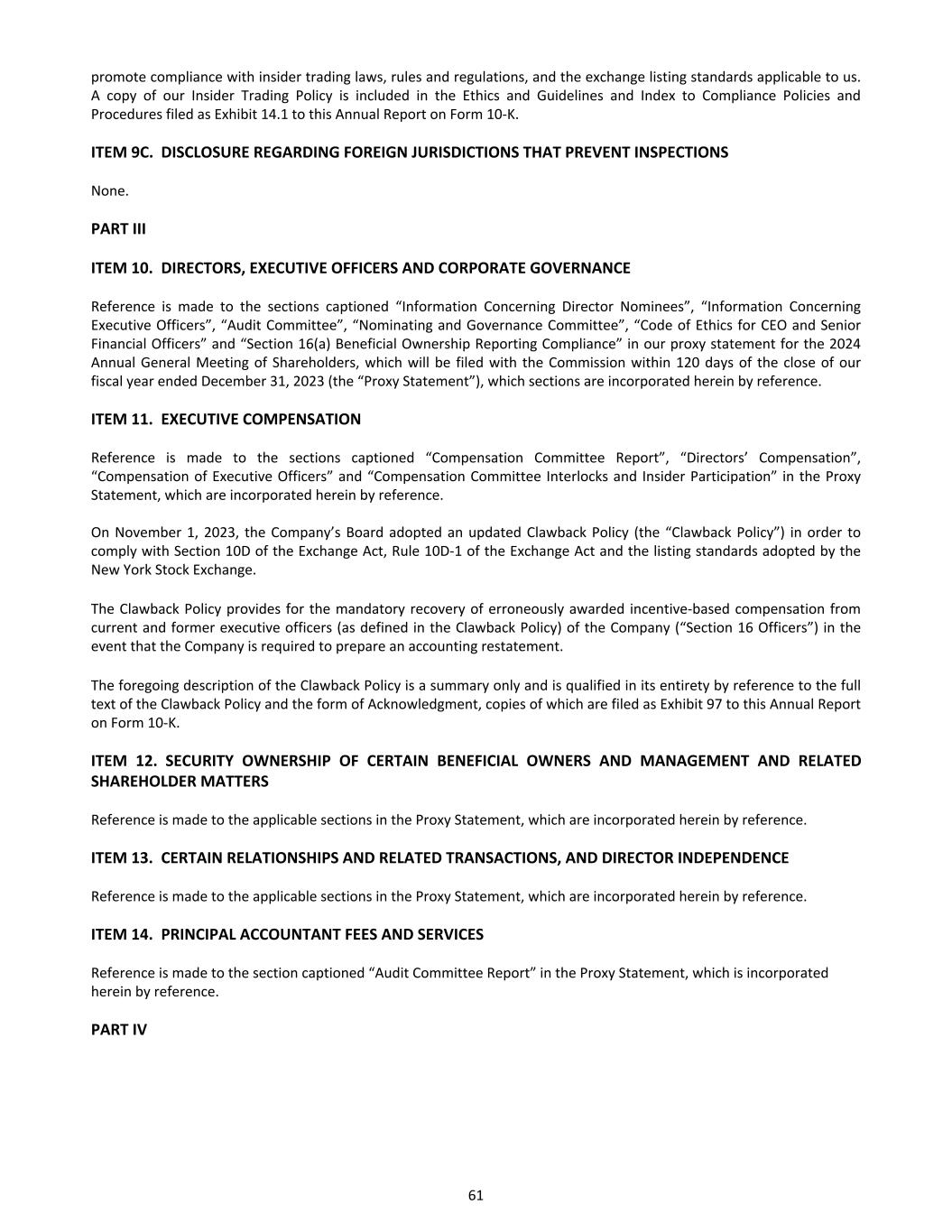
promote compliance with insider trading laws, rules and regulations, and the exchange listing standards applicable to us. A copy of our Insider Trading Policy is included in the Ethics and Guidelines and Index to Compliance Policies and Procedures filed as Exhibit 14.1 to this Annual Report on Form 10-K. ITEM 9C. DISCLOSURE REGARDING FOREIGN JURISDICTIONS THAT PREVENT INSPECTIONS None. PART III ITEM 10. DIRECTORS, EXECUTIVE OFFICERS AND CORPORATE GOVERNANCE Reference is made to the sections captioned “Information Concerning Director Nominees”, “Information Concerning Executive Officers”, “Audit Committee”, “Nominating and Governance Committee”, “Code of Ethics for CEO and Senior Financial Officers” and “Section 16(a) Beneficial Ownership Reporting Compliance” in our proxy statement for the 2024 Annual General Meeting of Shareholders, which will be filed with the Commission within 120 days of the close of our fiscal year ended December 31, 2023 (the “Proxy Statement”), which sections are incorporated herein by reference. ITEM 11. EXECUTIVE COMPENSATION Reference is made to the sections captioned “Compensation Committee Report”, “Directors’ Compensation”, “Compensation of Executive Officers” and “Compensation Committee Interlocks and Insider Participation” in the Proxy Statement, which are incorporated herein by reference. On November 1, 2023, the Company’s Board adopted an updated Clawback Policy (the “Clawback Policy”) in order to comply with Section 10D of the Exchange Act, Rule 10D-1 of the Exchange Act and the listing standards adopted by the New York Stock Exchange. The Clawback Policy provides for the mandatory recovery of erroneously awarded incentive-based compensation from current and former executive officers (as defined in the Clawback Policy) of the Company (“Section 16 Officers”) in the event that the Company is required to prepare an accounting restatement. The foregoing description of the Clawback Policy is a summary only and is qualified in its entirety by reference to the full text of the Clawback Policy and the form of Acknowledgment, copies of which are filed as Exhibit 97 to this Annual Report on Form 10-K. ITEM 12. SECURITY OWNERSHIP OF CERTAIN BENEFICIAL OWNERS AND MANAGEMENT AND RELATED SHAREHOLDER MATTERS Reference is made to the applicable sections in the Proxy Statement, which are incorporated herein by reference. ITEM 13. CERTAIN RELATIONSHIPS AND RELATED TRANSACTIONS, AND DIRECTOR INDEPENDENCE Reference is made to the applicable sections in the Proxy Statement, which are incorporated herein by reference. ITEM 14. PRINCIPAL ACCOUNTANT FEES AND SERVICES Reference is made to the section captioned “Audit Committee Report” in the Proxy Statement, which is incorporated herein by reference. PART IV 61
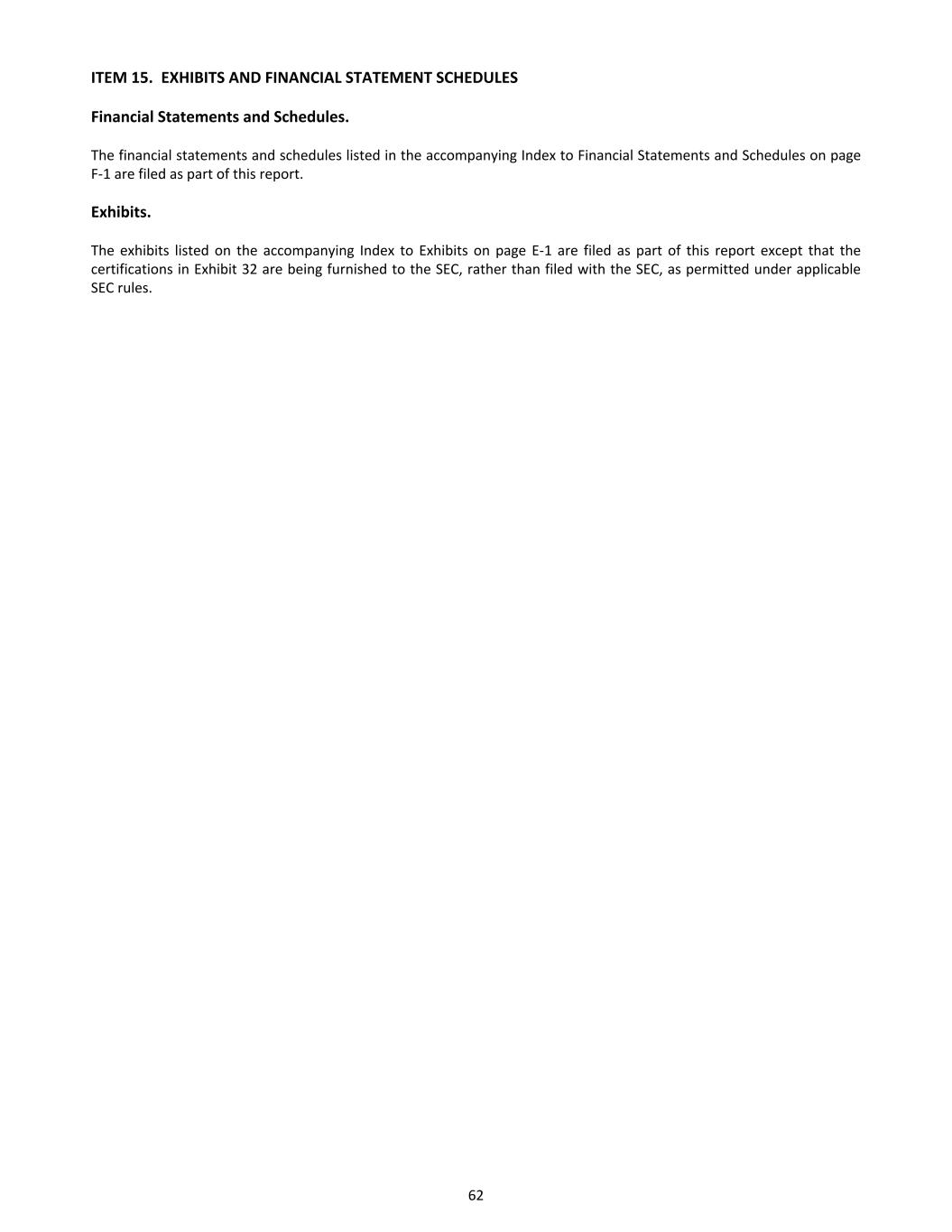
ITEM 15. EXHIBITS AND FINANCIAL STATEMENT SCHEDULES Financial Statements and Schedules. The financial statements and schedules listed in the accompanying Index to Financial Statements and Schedules on page F-1 are filed as part of this report. Exhibits. The exhibits listed on the accompanying Index to Exhibits on page E-1 are filed as part of this report except that the certifications in Exhibit 32 are being furnished to the SEC, rather than filed with the SEC, as permitted under applicable SEC rules. 62
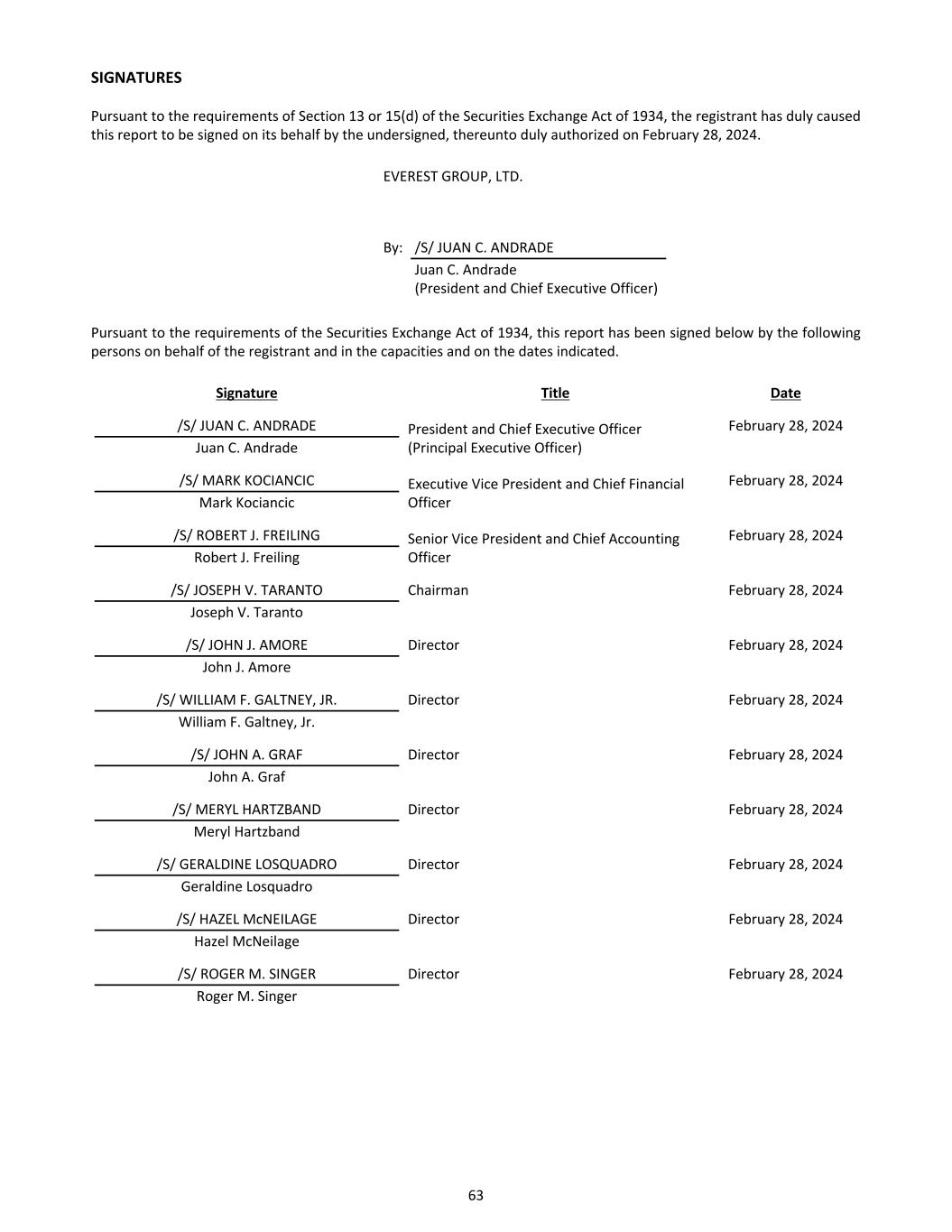
SIGNATURES Pursuant to the requirements of Section 13 or 15(d) of the Securities Exchange Act of 1934, the registrant has duly caused this report to be signed on its behalf by the undersigned, thereunto duly authorized on February 28, 2024. EVEREST GROUP, LTD. By: /S/ JUAN C. ANDRADE Juan C. Andrade (President and Chief Executive Officer) Pursuant to the requirements of the Securities Exchange Act of 1934, this report has been signed below by the following persons on behalf of the registrant and in the capacities and on the dates indicated. Signature Title Date /S/ JUAN C. ANDRADE President and Chief Executive Officer (Principal Executive Officer) February 28, 2024 Juan C. Andrade /S/ MARK KOCIANCIC Executive Vice President and Chief Financial Officer February 28, 2024 Mark Kociancic /S/ ROBERT J. FREILING Senior Vice President and Chief Accounting Officer February 28, 2024 Robert J. Freiling /S/ JOSEPH V. TARANTO Chairman February 28, 2024 Joseph V. Taranto /S/ JOHN J. AMORE Director February 28, 2024 John J. Amore /S/ WILLIAM F. GALTNEY, JR. Director February 28, 2024 William F. Galtney, Jr. /S/ JOHN A. GRAF Director February 28, 2024 John A. Graf /S/ MERYL HARTZBAND Director February 28, 2024 Meryl Hartzband /S/ GERALDINE LOSQUADRO Director February 28, 2024 Geraldine Losquadro /S/ HAZEL McNEILAGE Director February 28, 2024 Hazel McNeilage /S/ ROGER M. SINGER Director February 28, 2024 Roger M. Singer 63
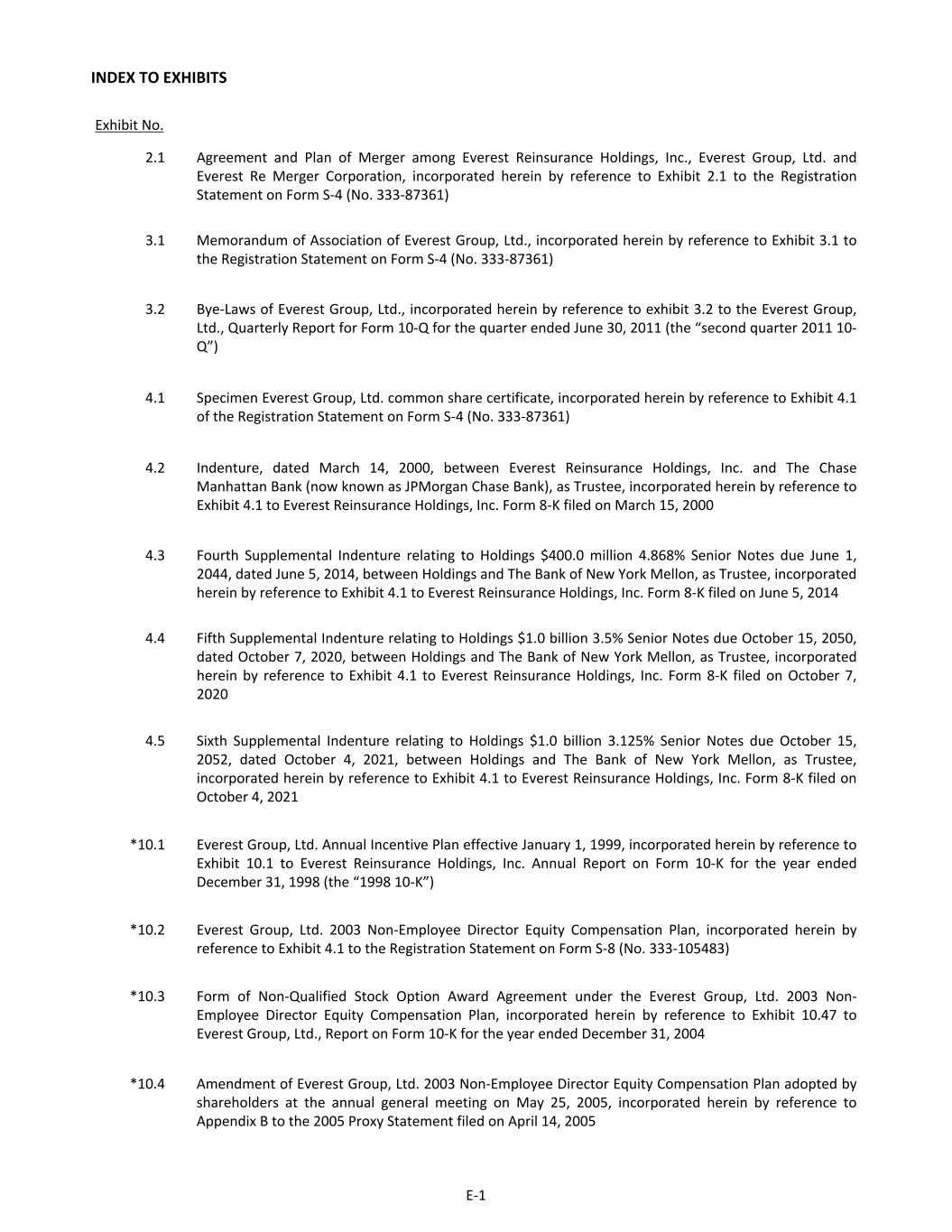
INDEX TO EXHIBITS Exhibit No. 2.1 Agreement and Plan of Merger among Everest Reinsurance Holdings, Inc., Everest Group, Ltd. and Everest Re Merger Corporation, incorporated herein by reference to Exhibit 2.1 to the Registration Statement on Form S-4 (No. 333-87361) 3.1 Memorandum of Association of Everest Group, Ltd., incorporated herein by reference to Exhibit 3.1 to the Registration Statement on Form S-4 (No. 333-87361) 3.2 Bye-Laws of Everest Group, Ltd., incorporated herein by reference to exhibit 3.2 to the Everest Group, Ltd., Quarterly Report for Form 10-Q for the quarter ended June 30, 2011 (the “second quarter 2011 10- Q”) 4.1 Specimen Everest Group, Ltd. common share certificate, incorporated herein by reference to Exhibit 4.1 of the Registration Statement on Form S-4 (No. 333-87361) 4.2 Indenture, dated March 14, 2000, between Everest Reinsurance Holdings, Inc. and The Chase Manhattan Bank (now known as JPMorgan Chase Bank), as Trustee, incorporated herein by reference to Exhibit 4.1 to Everest Reinsurance Holdings, Inc. Form 8-K filed on March 15, 2000 4.3 Fourth Supplemental Indenture relating to Holdings $400.0 million 4.868% Senior Notes due June 1, 2044, dated June 5, 2014, between Holdings and The Bank of New York Mellon, as Trustee, incorporated herein by reference to Exhibit 4.1 to Everest Reinsurance Holdings, Inc. Form 8-K filed on June 5, 2014 4.4 Fifth Supplemental Indenture relating to Holdings $1.0 billion 3.5% Senior Notes due October 15, 2050, dated October 7, 2020, between Holdings and The Bank of New York Mellon, as Trustee, incorporated herein by reference to Exhibit 4.1 to Everest Reinsurance Holdings, Inc. Form 8-K filed on October 7, 2020 4.5 Sixth Supplemental Indenture relating to Holdings $1.0 billion 3.125% Senior Notes due October 15, 2052, dated October 4, 2021, between Holdings and The Bank of New York Mellon, as Trustee, incorporated herein by reference to Exhibit 4.1 to Everest Reinsurance Holdings, Inc. Form 8-K filed on October 4, 2021 *10.1 Everest Group, Ltd. Annual Incentive Plan effective January 1, 1999, incorporated herein by reference to Exhibit 10.1 to Everest Reinsurance Holdings, Inc. Annual Report on Form 10-K for the year ended December 31, 1998 (the “1998 10-K”) *10.2 Everest Group, Ltd. 2003 Non-Employee Director Equity Compensation Plan, incorporated herein by reference to Exhibit 4.1 to the Registration Statement on Form S-8 (No. 333-105483) *10.3 Form of Non-Qualified Stock Option Award Agreement under the Everest Group, Ltd. 2003 Non- Employee Director Equity Compensation Plan, incorporated herein by reference to Exhibit 10.47 to Everest Group, Ltd., Report on Form 10-K for the year ended December 31, 2004 *10.4 Amendment of Everest Group, Ltd. 2003 Non-Employee Director Equity Compensation Plan adopted by shareholders at the annual general meeting on May 25, 2005, incorporated herein by reference to Appendix B to the 2005 Proxy Statement filed on April 14, 2005 E-1
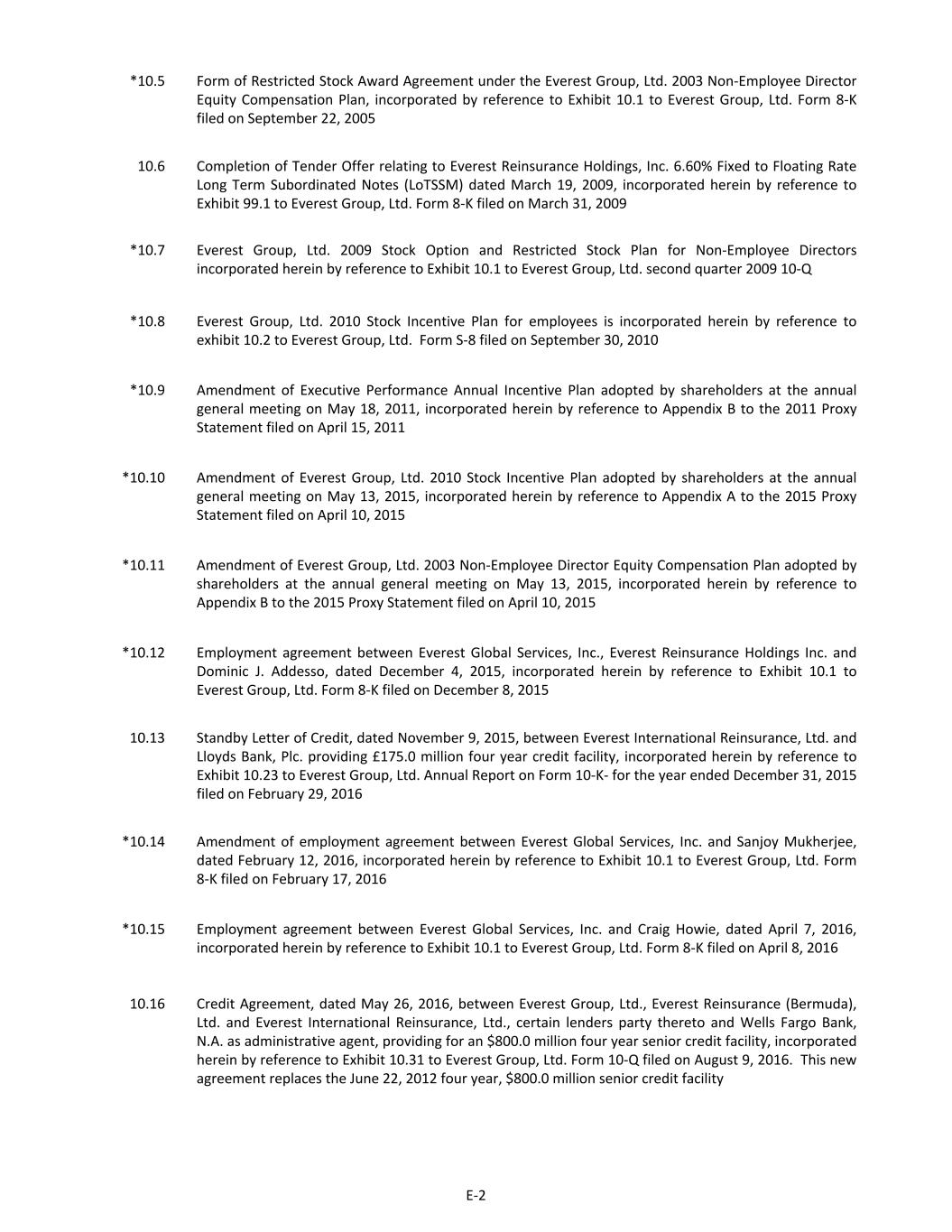
*10.5 Form of Restricted Stock Award Agreement under the Everest Group, Ltd. 2003 Non-Employee Director Equity Compensation Plan, incorporated by reference to Exhibit 10.1 to Everest Group, Ltd. Form 8-K filed on September 22, 2005 10.6 Completion of Tender Offer relating to Everest Reinsurance Holdings, Inc. 6.60% Fixed to Floating Rate Long Term Subordinated Notes (LoTSSM) dated March 19, 2009, incorporated herein by reference to Exhibit 99.1 to Everest Group, Ltd. Form 8-K filed on March 31, 2009 *10.7 Everest Group, Ltd. 2009 Stock Option and Restricted Stock Plan for Non-Employee Directors incorporated herein by reference to Exhibit 10.1 to Everest Group, Ltd. second quarter 2009 10-Q *10.8 Everest Group, Ltd. 2010 Stock Incentive Plan for employees is incorporated herein by reference to exhibit 10.2 to Everest Group, Ltd. Form S-8 filed on September 30, 2010 *10.9 Amendment of Executive Performance Annual Incentive Plan adopted by shareholders at the annual general meeting on May 18, 2011, incorporated herein by reference to Appendix B to the 2011 Proxy Statement filed on April 15, 2011 *10.10 Amendment of Everest Group, Ltd. 2010 Stock Incentive Plan adopted by shareholders at the annual general meeting on May 13, 2015, incorporated herein by reference to Appendix A to the 2015 Proxy Statement filed on April 10, 2015 *10.11 Amendment of Everest Group, Ltd. 2003 Non-Employee Director Equity Compensation Plan adopted by shareholders at the annual general meeting on May 13, 2015, incorporated herein by reference to Appendix B to the 2015 Proxy Statement filed on April 10, 2015 *10.12 Employment agreement between Everest Global Services, Inc., Everest Reinsurance Holdings Inc. and Dominic J. Addesso, dated December 4, 2015, incorporated herein by reference to Exhibit 10.1 to Everest Group, Ltd. Form 8-K filed on December 8, 2015 10.13 Standby Letter of Credit, dated November 9, 2015, between Everest International Reinsurance, Ltd. and Lloyds Bank, Plc. providing £175.0 million four year credit facility, incorporated herein by reference to Exhibit 10.23 to Everest Group, Ltd. Annual Report on Form 10-K- for the year ended December 31, 2015 filed on February 29, 2016 *10.14 Amendment of employment agreement between Everest Global Services, Inc. and Sanjoy Mukherjee, dated February 12, 2016, incorporated herein by reference to Exhibit 10.1 to Everest Group, Ltd. Form 8-K filed on February 17, 2016 *10.15 Employment agreement between Everest Global Services, Inc. and Craig Howie, dated April 7, 2016, incorporated herein by reference to Exhibit 10.1 to Everest Group, Ltd. Form 8-K filed on April 8, 2016 10.16 Credit Agreement, dated May 26, 2016, between Everest Group, Ltd., Everest Reinsurance (Bermuda), Ltd. and Everest International Reinsurance, Ltd., certain lenders party thereto and Wells Fargo Bank, N.A. as administrative agent, providing for an $800.0 million four year senior credit facility, incorporated herein by reference to Exhibit 10.31 to Everest Group, Ltd. Form 10-Q filed on August 9, 2016. This new agreement replaces the June 22, 2012 four year, $800.0 million senior credit facility E-2
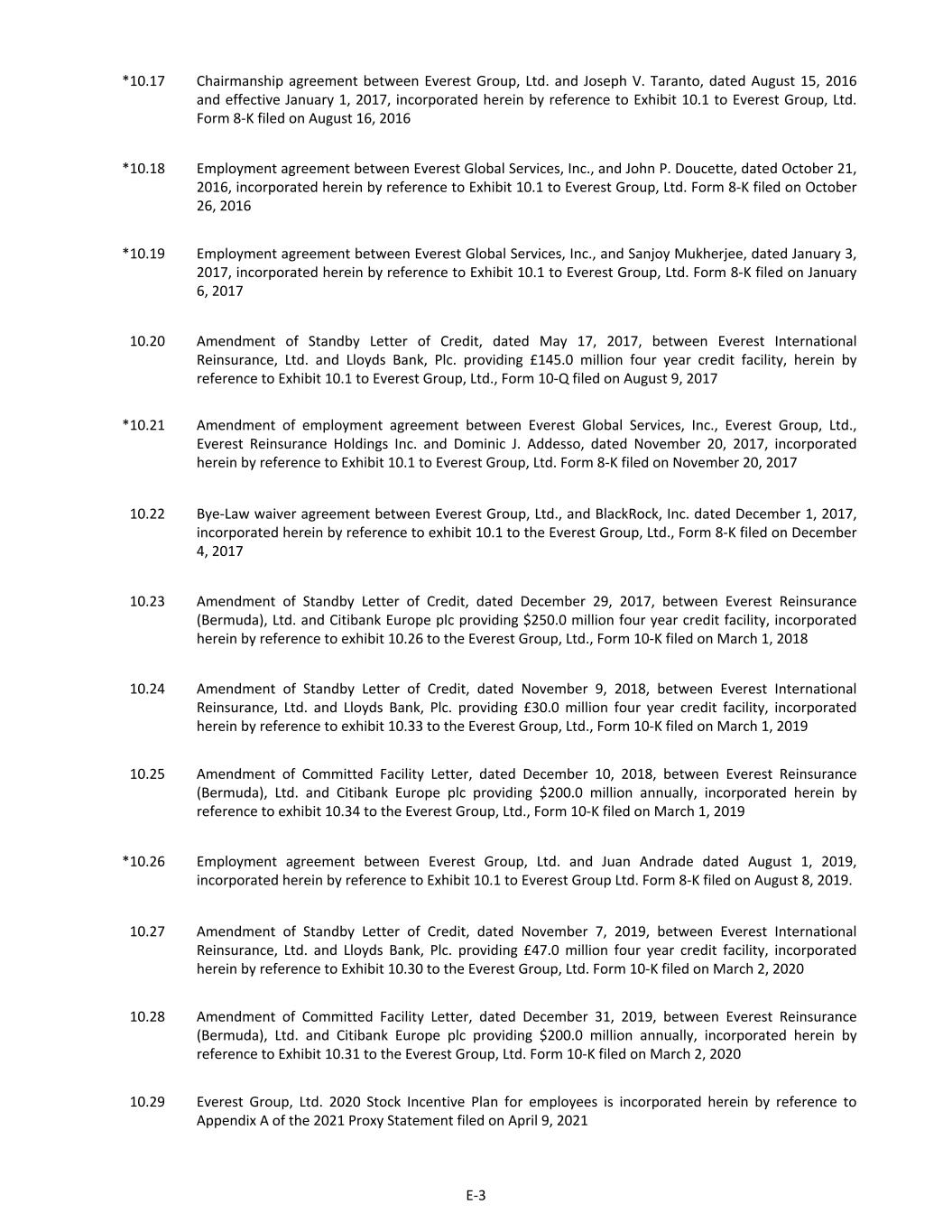
*10.17 Chairmanship agreement between Everest Group, Ltd. and Joseph V. Taranto, dated August 15, 2016 and effective January 1, 2017, incorporated herein by reference to Exhibit 10.1 to Everest Group, Ltd. Form 8-K filed on August 16, 2016 *10.18 Employment agreement between Everest Global Services, Inc., and John P. Doucette, dated October 21, 2016, incorporated herein by reference to Exhibit 10.1 to Everest Group, Ltd. Form 8-K filed on October 26, 2016 *10.19 Employment agreement between Everest Global Services, Inc., and Sanjoy Mukherjee, dated January 3, 2017, incorporated herein by reference to Exhibit 10.1 to Everest Group, Ltd. Form 8-K filed on January 6, 2017 10.20 Amendment of Standby Letter of Credit, dated May 17, 2017, between Everest International Reinsurance, Ltd. and Lloyds Bank, Plc. providing £145.0 million four year credit facility, herein by reference to Exhibit 10.1 to Everest Group, Ltd., Form 10-Q filed on August 9, 2017 *10.21 Amendment of employment agreement between Everest Global Services, Inc., Everest Group, Ltd., Everest Reinsurance Holdings Inc. and Dominic J. Addesso, dated November 20, 2017, incorporated herein by reference to Exhibit 10.1 to Everest Group, Ltd. Form 8-K filed on November 20, 2017 10.22 Bye-Law waiver agreement between Everest Group, Ltd., and BlackRock, Inc. dated December 1, 2017, incorporated herein by reference to exhibit 10.1 to the Everest Group, Ltd., Form 8-K filed on December 4, 2017 10.23 Amendment of Standby Letter of Credit, dated December 29, 2017, between Everest Reinsurance (Bermuda), Ltd. and Citibank Europe plc providing $250.0 million four year credit facility, incorporated herein by reference to exhibit 10.26 to the Everest Group, Ltd., Form 10-K filed on March 1, 2018 10.24 Amendment of Standby Letter of Credit, dated November 9, 2018, between Everest International Reinsurance, Ltd. and Lloyds Bank, Plc. providing £30.0 million four year credit facility, incorporated herein by reference to exhibit 10.33 to the Everest Group, Ltd., Form 10-K filed on March 1, 2019 10.25 Amendment of Committed Facility Letter, dated December 10, 2018, between Everest Reinsurance (Bermuda), Ltd. and Citibank Europe plc providing $200.0 million annually, incorporated herein by reference to exhibit 10.34 to the Everest Group, Ltd., Form 10-K filed on March 1, 2019 *10.26 Employment agreement between Everest Group, Ltd. and Juan Andrade dated August 1, 2019, incorporated herein by reference to Exhibit 10.1 to Everest Group Ltd. Form 8-K filed on August 8, 2019. 10.27 Amendment of Standby Letter of Credit, dated November 7, 2019, between Everest International Reinsurance, Ltd. and Lloyds Bank, Plc. providing £47.0 million four year credit facility, incorporated herein by reference to Exhibit 10.30 to the Everest Group, Ltd. Form 10-K filed on March 2, 2020 10.28 Amendment of Committed Facility Letter, dated December 31, 2019, between Everest Reinsurance (Bermuda), Ltd. and Citibank Europe plc providing $200.0 million annually, incorporated herein by reference to Exhibit 10.31 to the Everest Group, Ltd. Form 10-K filed on March 2, 2020 10.29 Everest Group, Ltd. 2020 Stock Incentive Plan for employees is incorporated herein by reference to Appendix A of the 2021 Proxy Statement filed on April 9, 2021 E-3
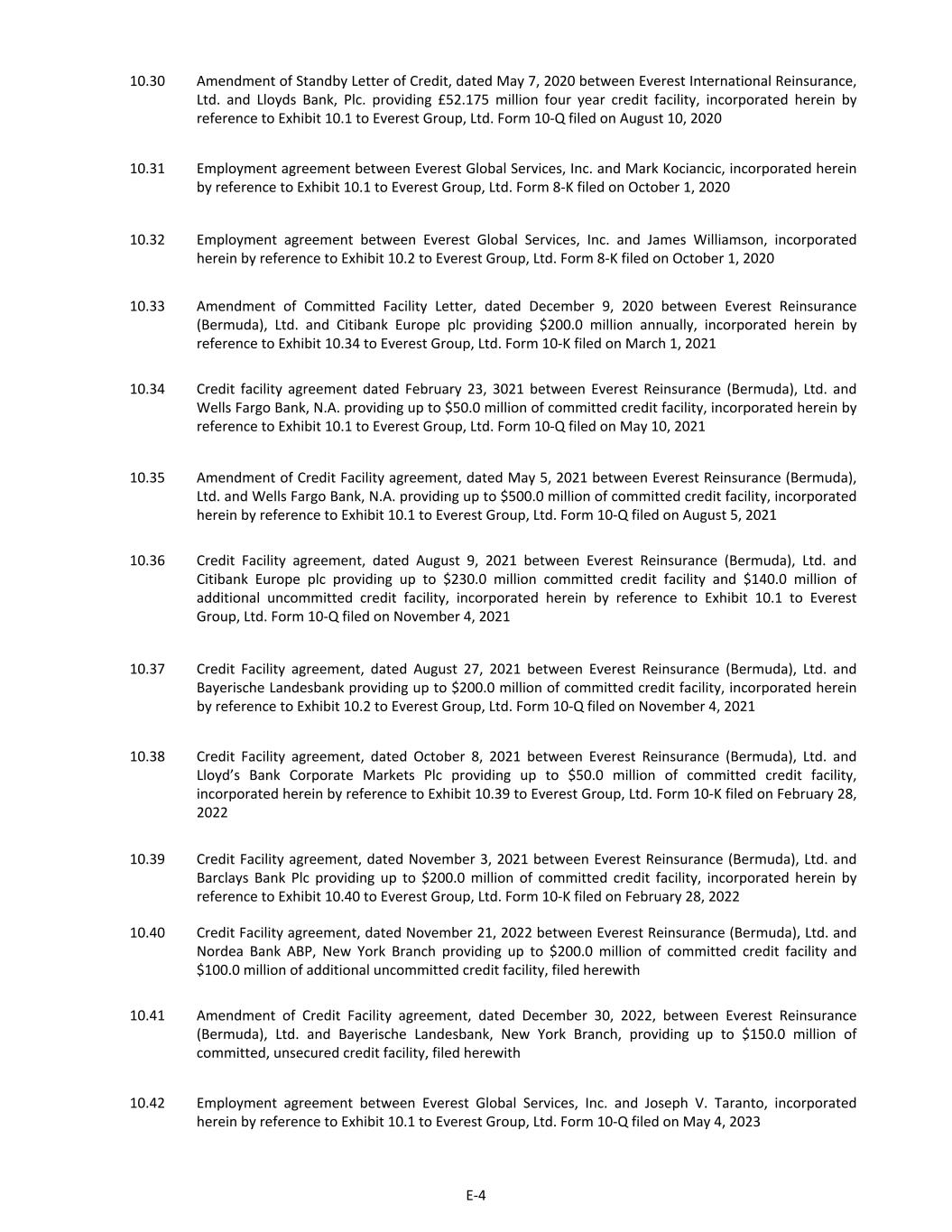
10.30 Amendment of Standby Letter of Credit, dated May 7, 2020 between Everest International Reinsurance, Ltd. and Lloyds Bank, Plc. providing £52.175 million four year credit facility, incorporated herein by reference to Exhibit 10.1 to Everest Group, Ltd. Form 10-Q filed on August 10, 2020 10.31 Employment agreement between Everest Global Services, Inc. and Mark Kociancic, incorporated herein by reference to Exhibit 10.1 to Everest Group, Ltd. Form 8-K filed on October 1, 2020 10.32 Employment agreement between Everest Global Services, Inc. and James Williamson, incorporated herein by reference to Exhibit 10.2 to Everest Group, Ltd. Form 8-K filed on October 1, 2020 10.33 Amendment of Committed Facility Letter, dated December 9, 2020 between Everest Reinsurance (Bermuda), Ltd. and Citibank Europe plc providing $200.0 million annually, incorporated herein by reference to Exhibit 10.34 to Everest Group, Ltd. Form 10-K filed on March 1, 2021 10.34 Credit facility agreement dated February 23, 3021 between Everest Reinsurance (Bermuda), Ltd. and Wells Fargo Bank, N.A. providing up to $50.0 million of committed credit facility, incorporated herein by reference to Exhibit 10.1 to Everest Group, Ltd. Form 10-Q filed on May 10, 2021 10.35 Amendment of Credit Facility agreement, dated May 5, 2021 between Everest Reinsurance (Bermuda), Ltd. and Wells Fargo Bank, N.A. providing up to $500.0 million of committed credit facility, incorporated herein by reference to Exhibit 10.1 to Everest Group, Ltd. Form 10-Q filed on August 5, 2021 10.36 Credit Facility agreement, dated August 9, 2021 between Everest Reinsurance (Bermuda), Ltd. and Citibank Europe plc providing up to $230.0 million committed credit facility and $140.0 million of additional uncommitted credit facility, incorporated herein by reference to Exhibit 10.1 to Everest Group, Ltd. Form 10-Q filed on November 4, 2021 10.37 Credit Facility agreement, dated August 27, 2021 between Everest Reinsurance (Bermuda), Ltd. and Bayerische Landesbank providing up to $200.0 million of committed credit facility, incorporated herein by reference to Exhibit 10.2 to Everest Group, Ltd. Form 10-Q filed on November 4, 2021 10.38 Credit Facility agreement, dated October 8, 2021 between Everest Reinsurance (Bermuda), Ltd. and Lloyd’s Bank Corporate Markets Plc providing up to $50.0 million of committed credit facility, incorporated herein by reference to Exhibit 10.39 to Everest Group, Ltd. Form 10-K filed on February 28, 2022 10.39 Credit Facility agreement, dated November 3, 2021 between Everest Reinsurance (Bermuda), Ltd. and Barclays Bank Plc providing up to $200.0 million of committed credit facility, incorporated herein by reference to Exhibit 10.40 to Everest Group, Ltd. Form 10-K filed on February 28, 2022 10.40 Credit Facility agreement, dated November 21, 2022 between Everest Reinsurance (Bermuda), Ltd. and Nordea Bank ABP, New York Branch providing up to $200.0 million of committed credit facility and $100.0 million of additional uncommitted credit facility, filed herewith 10.41 Amendment of Credit Facility agreement, dated December 30, 2022, between Everest Reinsurance (Bermuda), Ltd. and Bayerische Landesbank, New York Branch, providing up to $150.0 million of committed, unsecured credit facility, filed herewith 10.42 Employment agreement between Everest Global Services, Inc. and Joseph V. Taranto, incorporated herein by reference to Exhibit 10.1 to Everest Group, Ltd. Form 10-Q filed on May 4, 2023 E-4
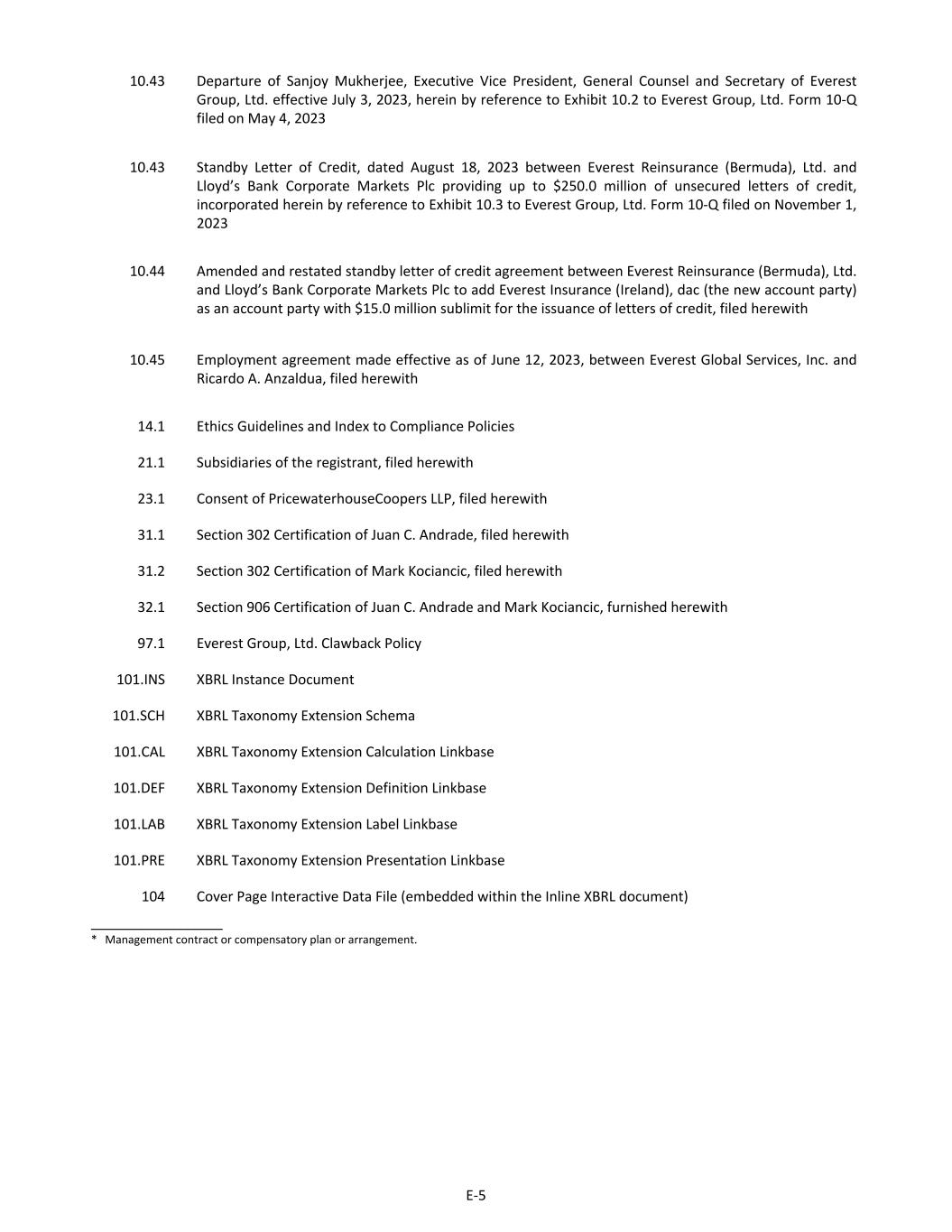
10.43 Departure of Sanjoy Mukherjee, Executive Vice President, General Counsel and Secretary of Everest Group, Ltd. effective July 3, 2023, herein by reference to Exhibit 10.2 to Everest Group, Ltd. Form 10-Q filed on May 4, 2023 10.43 Standby Letter of Credit, dated August 18, 2023 between Everest Reinsurance (Bermuda), Ltd. and Lloyd’s Bank Corporate Markets Plc providing up to $250.0 million of unsecured letters of credit, incorporated herein by reference to Exhibit 10.3 to Everest Group, Ltd. Form 10-Q filed on November 1, 2023 10.44 Amended and restated standby letter of credit agreement between Everest Reinsurance (Bermuda), Ltd. and Lloyd’s Bank Corporate Markets Plc to add Everest Insurance (Ireland), dac (the new account party) as an account party with $15.0 million sublimit for the issuance of letters of credit, filed herewith 10.45 Employment agreement made effective as of June 12, 2023, between Everest Global Services, Inc. and Ricardo A. Anzaldua, filed herewith 14.1 Ethics Guidelines and Index to Compliance Policies 21.1 Subsidiaries of the registrant, filed herewith 23.1 Consent of PricewaterhouseCoopers LLP, filed herewith 31.1 Section 302 Certification of Juan C. Andrade, filed herewith 31.2 Section 302 Certification of Mark Kociancic, filed herewith 32.1 Section 906 Certification of Juan C. Andrade and Mark Kociancic, furnished herewith 97.1 Everest Group, Ltd. Clawback Policy 101.INS XBRL Instance Document 101.SCH XBRL Taxonomy Extension Schema 101.CAL XBRL Taxonomy Extension Calculation Linkbase 101.DEF XBRL Taxonomy Extension Definition Linkbase 101.LAB XBRL Taxonomy Extension Label Linkbase 101.PRE XBRL Taxonomy Extension Presentation Linkbase 104 Cover Page Interactive Data File (embedded within the Inline XBRL document) _________________ * Management contract or compensatory plan or arrangement. E-5
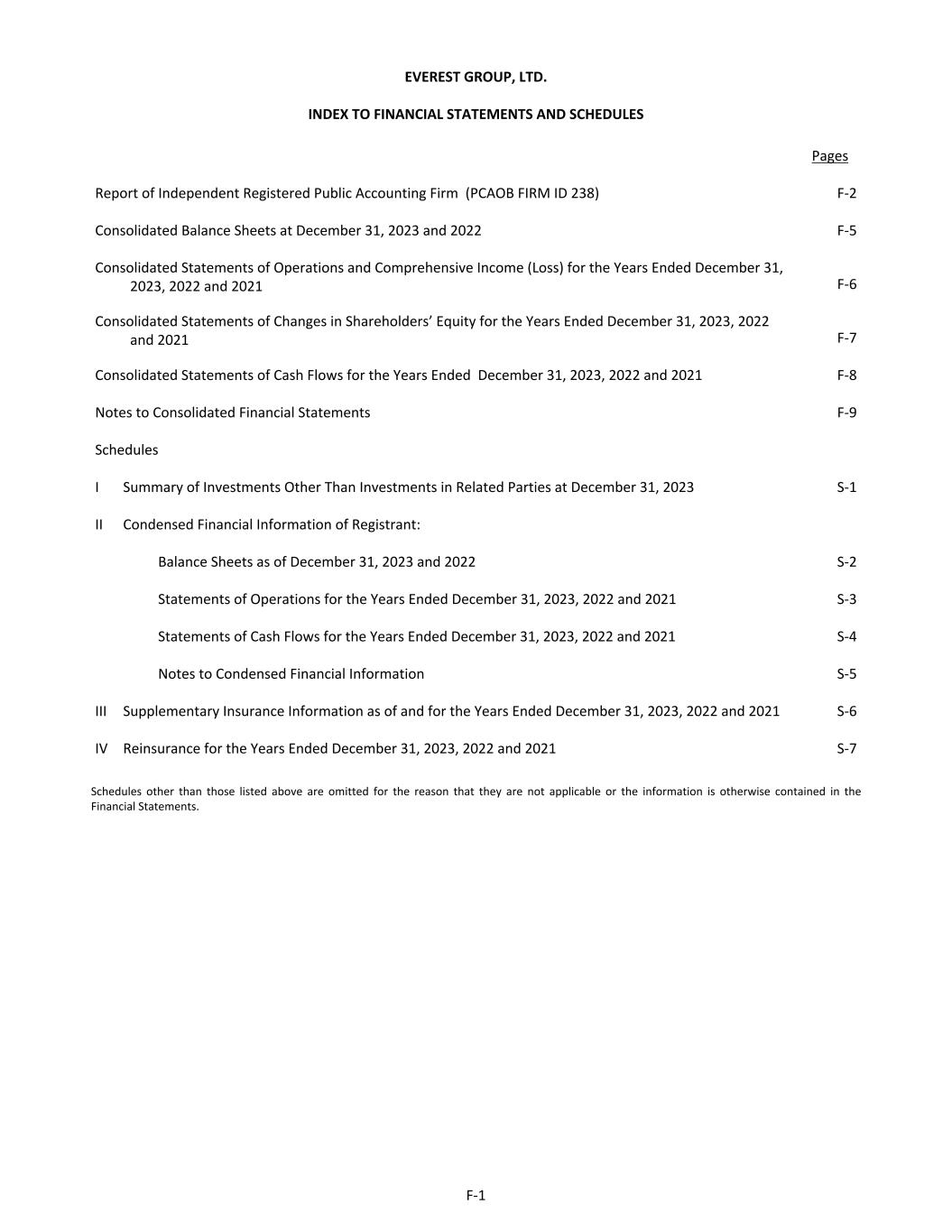
EVEREST GROUP, LTD. INDEX TO FINANCIAL STATEMENTS AND SCHEDULES Pages Report of Independent Registered Public Accounting Firm (PCAOB FIRM ID 238) F-2 Consolidated Balance Sheets at December 31, 2023 and 2022 F-5 Consolidated Statements of Operations and Comprehensive Income (Loss) for the Years Ended December 31, 2023, 2022 and 2021 F-6 Consolidated Statements of Changes in Shareholders’ Equity for the Years Ended December 31, 2023, 2022 and 2021 F-7 Consolidated Statements of Cash Flows for the Years Ended December 31, 2023, 2022 and 2021 F-8 Notes to Consolidated Financial Statements F-9 Schedules I Summary of Investments Other Than Investments in Related Parties at December 31, 2023 S-1 II Condensed Financial Information of Registrant: Balance Sheets as of December 31, 2023 and 2022 S-2 Statements of Operations for the Years Ended December 31, 2023, 2022 and 2021 S-3 Statements of Cash Flows for the Years Ended December 31, 2023, 2022 and 2021 S-4 Notes to Condensed Financial Information S-5 III Supplementary Insurance Information as of and for the Years Ended December 31, 2023, 2022 and 2021 S-6 IV Reinsurance for the Years Ended December 31, 2023, 2022 and 2021 S-7 Schedules other than those listed above are omitted for the reason that they are not applicable or the information is otherwise contained in the Financial Statements. F-1
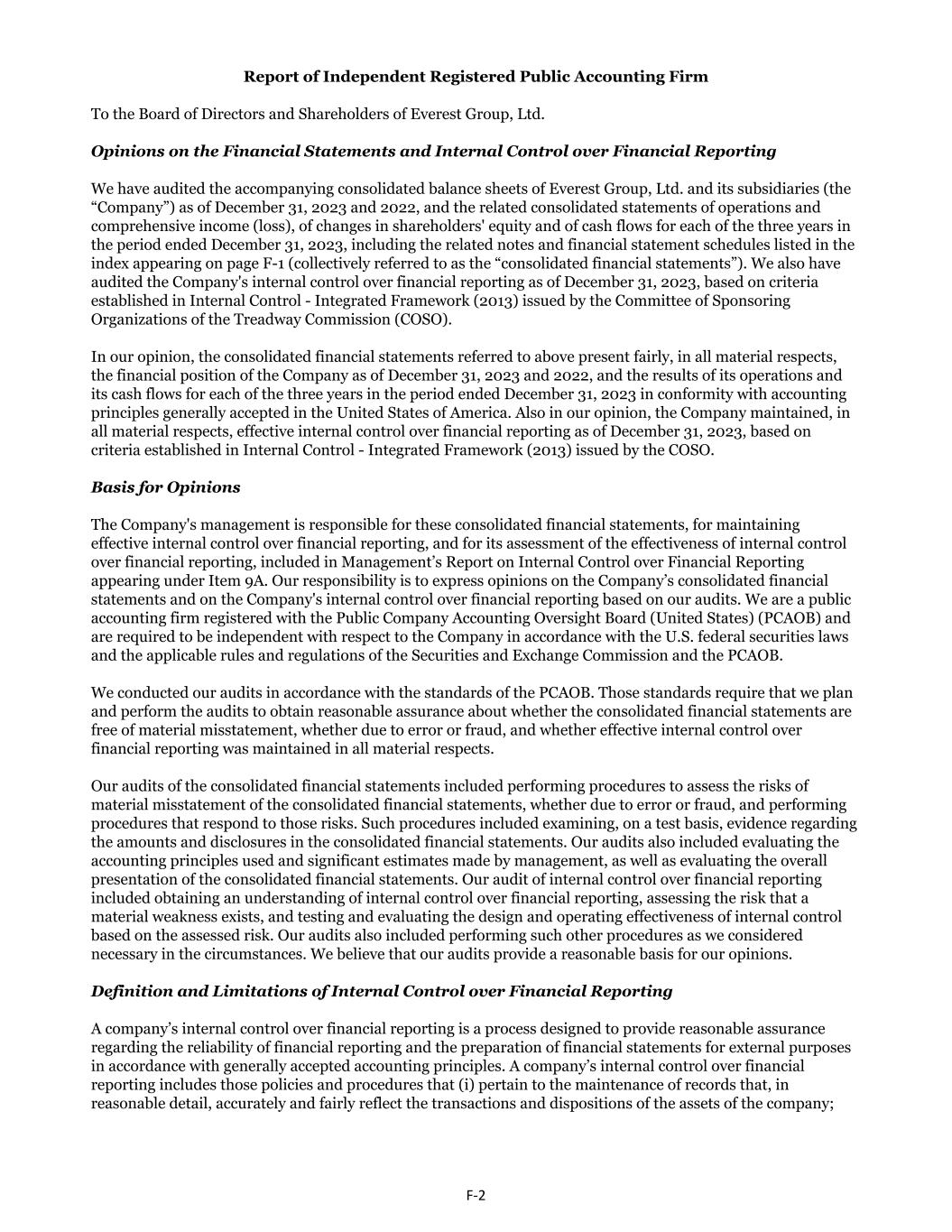
Report of Independent Registered Public Accounting Firm To the Board of Directors and Shareholders of Everest Group, Ltd. Opinions on the Financial Statements and Internal Control over Financial Reporting We have audited the accompanying consolidated balance sheets of Everest Group, Ltd. and its subsidiaries (the “Company”) as of December 31, 2023 and 2022, and the related consolidated statements of operations and comprehensive income (loss), of changes in shareholders' equity and of cash flows for each of the three years in the period ended December 31, 2023, including the related notes and financial statement schedules listed in the index appearing on page F-1 (collectively referred to as the “consolidated financial statements”). We also have audited the Company's internal control over financial reporting as of December 31, 2023, based on criteria established in Internal Control - Integrated Framework (2013) issued by the Committee of Sponsoring Organizations of the Treadway Commission (COSO). In our opinion, the consolidated financial statements referred to above present fairly, in all material respects, the financial position of the Company as of December 31, 2023 and 2022, and the results of its operations and its cash flows for each of the three years in the period ended December 31, 2023 in conformity with accounting principles generally accepted in the United States of America. Also in our opinion, the Company maintained, in all material respects, effective internal control over financial reporting as of December 31, 2023, based on criteria established in Internal Control - Integrated Framework (2013) issued by the COSO. Basis for Opinions The Company's management is responsible for these consolidated financial statements, for maintaining effective internal control over financial reporting, and for its assessment of the effectiveness of internal control over financial reporting, included in Management’s Report on Internal Control over Financial Reporting appearing under Item 9A. Our responsibility is to express opinions on the Company’s consolidated financial statements and on the Company's internal control over financial reporting based on our audits. We are a public accounting firm registered with the Public Company Accounting Oversight Board (United States) (PCAOB) and are required to be independent with respect to the Company in accordance with the U.S. federal securities laws and the applicable rules and regulations of the Securities and Exchange Commission and the PCAOB. We conducted our audits in accordance with the standards of the PCAOB. Those standards require that we plan and perform the audits to obtain reasonable assurance about whether the consolidated financial statements are free of material misstatement, whether due to error or fraud, and whether effective internal control over financial reporting was maintained in all material respects. Our audits of the consolidated financial statements included performing procedures to assess the risks of material misstatement of the consolidated financial statements, whether due to error or fraud, and performing procedures that respond to those risks. Such procedures included examining, on a test basis, evidence regarding the amounts and disclosures in the consolidated financial statements. Our audits also included evaluating the accounting principles used and significant estimates made by management, as well as evaluating the overall presentation of the consolidated financial statements. Our audit of internal control over financial reporting included obtaining an understanding of internal control over financial reporting, assessing the risk that a material weakness exists, and testing and evaluating the design and operating effectiveness of internal control based on the assessed risk. Our audits also included performing such other procedures as we considered necessary in the circumstances. We believe that our audits provide a reasonable basis for our opinions. Definition and Limitations of Internal Control over Financial Reporting A company’s internal control over financial reporting is a process designed to provide reasonable assurance regarding the reliability of financial reporting and the preparation of financial statements for external purposes in accordance with generally accepted accounting principles. A company’s internal control over financial reporting includes those policies and procedures that (i) pertain to the maintenance of records that, in reasonable detail, accurately and fairly reflect the transactions and dispositions of the assets of the company; F-2
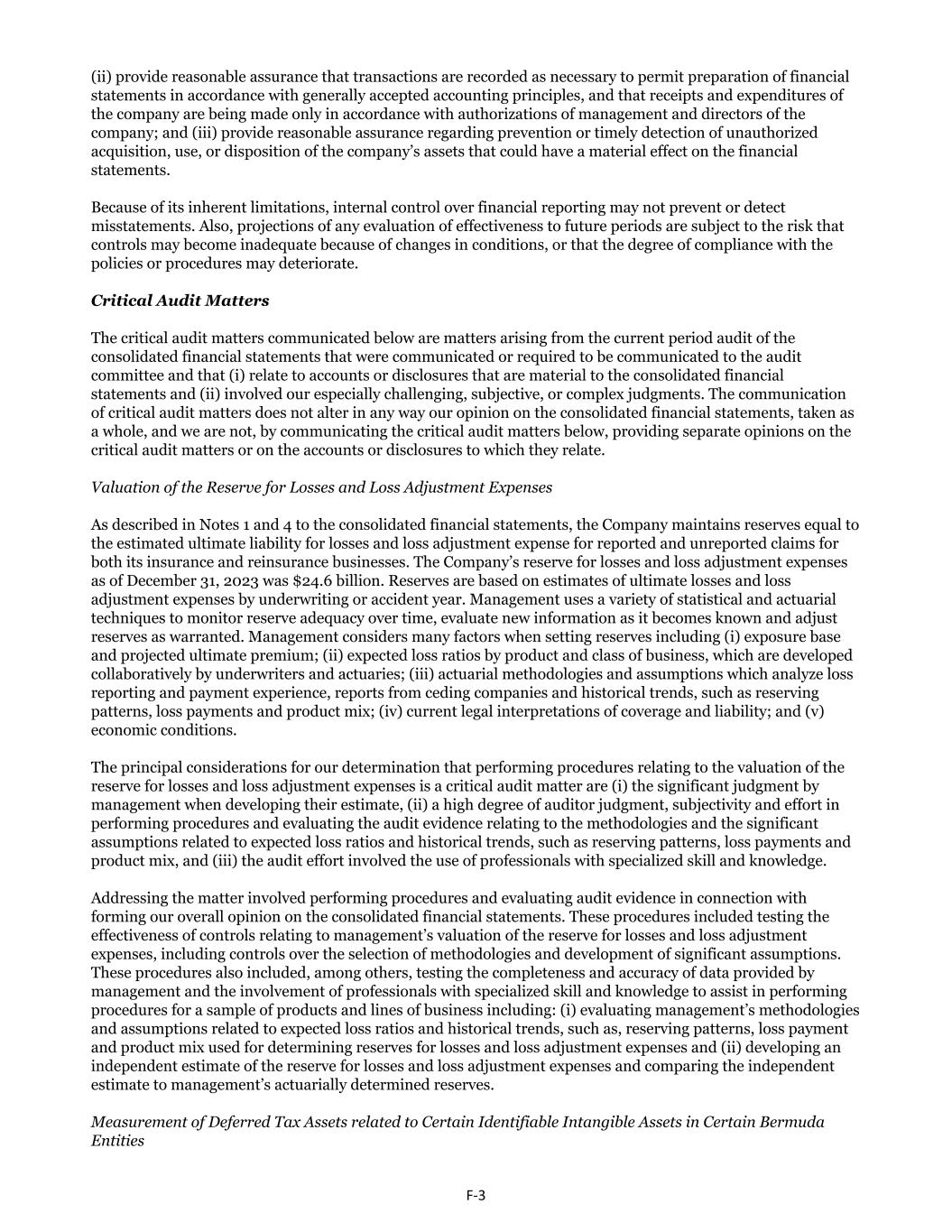
(ii) provide reasonable assurance that transactions are recorded as necessary to permit preparation of financial statements in accordance with generally accepted accounting principles, and that receipts and expenditures of the company are being made only in accordance with authorizations of management and directors of the company; and (iii) provide reasonable assurance regarding prevention or timely detection of unauthorized acquisition, use, or disposition of the company’s assets that could have a material effect on the financial statements. Because of its inherent limitations, internal control over financial reporting may not prevent or detect misstatements. Also, projections of any evaluation of effectiveness to future periods are subject to the risk that controls may become inadequate because of changes in conditions, or that the degree of compliance with the policies or procedures may deteriorate. Critical Audit Matters The critical audit matters communicated below are matters arising from the current period audit of the consolidated financial statements that were communicated or required to be communicated to the audit committee and that (i) relate to accounts or disclosures that are material to the consolidated financial statements and (ii) involved our especially challenging, subjective, or complex judgments. The communication of critical audit matters does not alter in any way our opinion on the consolidated financial statements, taken as a whole, and we are not, by communicating the critical audit matters below, providing separate opinions on the critical audit matters or on the accounts or disclosures to which they relate. Valuation of the Reserve for Losses and Loss Adjustment Expenses As described in Notes 1 and 4 to the consolidated financial statements, the Company maintains reserves equal to the estimated ultimate liability for losses and loss adjustment expense for reported and unreported claims for both its insurance and reinsurance businesses. The Company’s reserve for losses and loss adjustment expenses as of December 31, 2023 was $24.6 billion. Reserves are based on estimates of ultimate losses and loss adjustment expenses by underwriting or accident year. Management uses a variety of statistical and actuarial techniques to monitor reserve adequacy over time, evaluate new information as it becomes known and adjust reserves as warranted. Management considers many factors when setting reserves including (i) exposure base and projected ultimate premium; (ii) expected loss ratios by product and class of business, which are developed collaboratively by underwriters and actuaries; (iii) actuarial methodologies and assumptions which analyze loss reporting and payment experience, reports from ceding companies and historical trends, such as reserving patterns, loss payments and product mix; (iv) current legal interpretations of coverage and liability; and (v) economic conditions. The principal considerations for our determination that performing procedures relating to the valuation of the reserve for losses and loss adjustment expenses is a critical audit matter are (i) the significant judgment by management when developing their estimate, (ii) a high degree of auditor judgment, subjectivity and effort in performing procedures and evaluating the audit evidence relating to the methodologies and the significant assumptions related to expected loss ratios and historical trends, such as reserving patterns, loss payments and product mix, and (iii) the audit effort involved the use of professionals with specialized skill and knowledge. Addressing the matter involved performing procedures and evaluating audit evidence in connection with forming our overall opinion on the consolidated financial statements. These procedures included testing the effectiveness of controls relating to management’s valuation of the reserve for losses and loss adjustment expenses, including controls over the selection of methodologies and development of significant assumptions. These procedures also included, among others, testing the completeness and accuracy of data provided by management and the involvement of professionals with specialized skill and knowledge to assist in performing procedures for a sample of products and lines of business including: (i) evaluating management’s methodologies and assumptions related to expected loss ratios and historical trends, such as, reserving patterns, loss payment and product mix used for determining reserves for losses and loss adjustment expenses and (ii) developing an independent estimate of the reserve for losses and loss adjustment expenses and comparing the independent estimate to management’s actuarially determined reserves. Measurement of Deferred Tax Assets related to Certain Identifiable Intangible Assets in Certain Bermuda Entities F-3
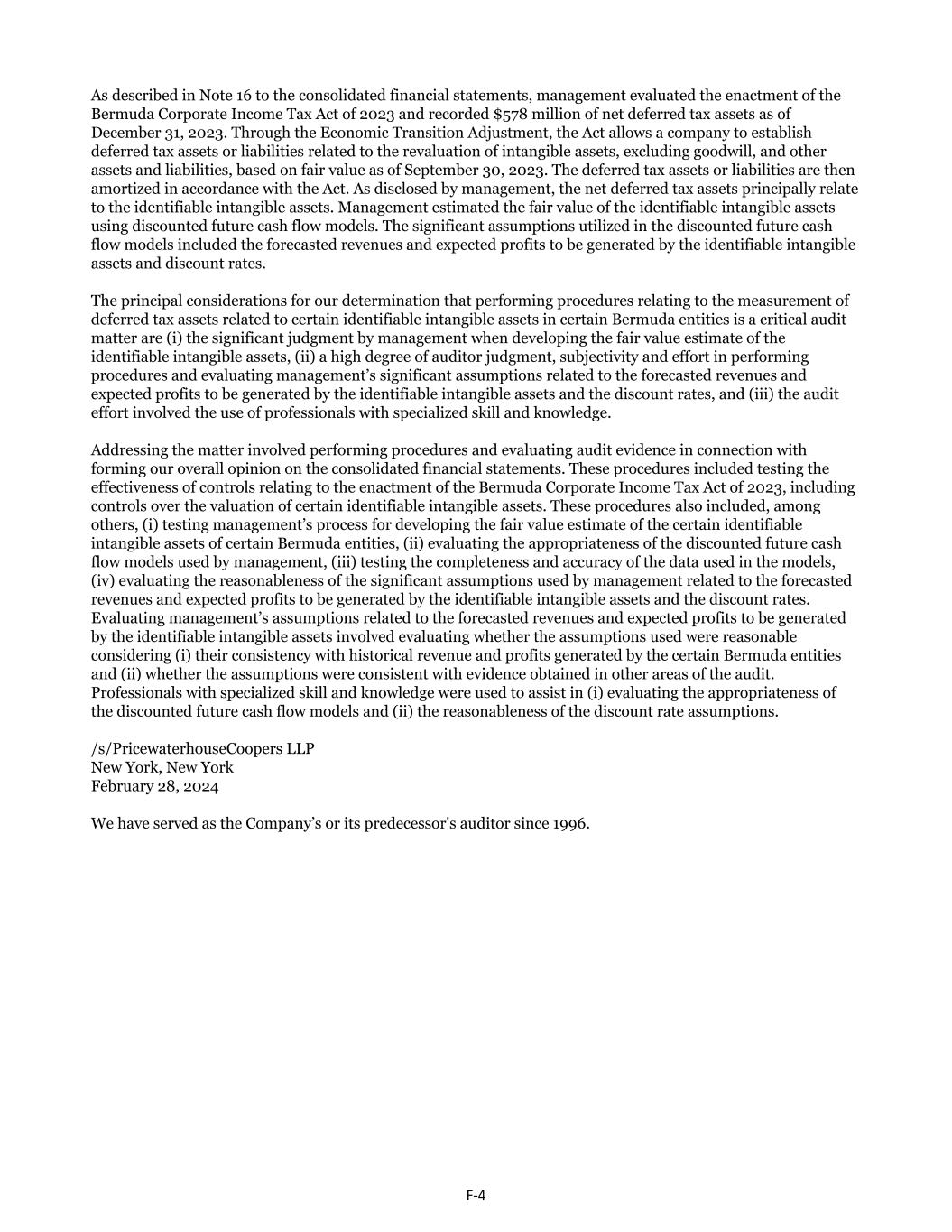
As described in Note 16 to the consolidated financial statements, management evaluated the enactment of the Bermuda Corporate Income Tax Act of 2023 and recorded $578 million of net deferred tax assets as of December 31, 2023. Through the Economic Transition Adjustment, the Act allows a company to establish deferred tax assets or liabilities related to the revaluation of intangible assets, excluding goodwill, and other assets and liabilities, based on fair value as of September 30, 2023. The deferred tax assets or liabilities are then amortized in accordance with the Act. As disclosed by management, the net deferred tax assets principally relate to the identifiable intangible assets. Management estimated the fair value of the identifiable intangible assets using discounted future cash flow models. The significant assumptions utilized in the discounted future cash flow models included the forecasted revenues and expected profits to be generated by the identifiable intangible assets and discount rates. The principal considerations for our determination that performing procedures relating to the measurement of deferred tax assets related to certain identifiable intangible assets in certain Bermuda entities is a critical audit matter are (i) the significant judgment by management when developing the fair value estimate of the identifiable intangible assets, (ii) a high degree of auditor judgment, subjectivity and effort in performing procedures and evaluating management’s significant assumptions related to the forecasted revenues and expected profits to be generated by the identifiable intangible assets and the discount rates, and (iii) the audit effort involved the use of professionals with specialized skill and knowledge. Addressing the matter involved performing procedures and evaluating audit evidence in connection with forming our overall opinion on the consolidated financial statements. These procedures included testing the effectiveness of controls relating to the enactment of the Bermuda Corporate Income Tax Act of 2023, including controls over the valuation of certain identifiable intangible assets. These procedures also included, among others, (i) testing management’s process for developing the fair value estimate of the certain identifiable intangible assets of certain Bermuda entities, (ii) evaluating the appropriateness of the discounted future cash flow models used by management, (iii) testing the completeness and accuracy of the data used in the models, (iv) evaluating the reasonableness of the significant assumptions used by management related to the forecasted revenues and expected profits to be generated by the identifiable intangible assets and the discount rates. Evaluating management’s assumptions related to the forecasted revenues and expected profits to be generated by the identifiable intangible assets involved evaluating whether the assumptions used were reasonable considering (i) their consistency with historical revenue and profits generated by the certain Bermuda entities and (ii) whether the assumptions were consistent with evidence obtained in other areas of the audit. Professionals with specialized skill and knowledge were used to assist in (i) evaluating the appropriateness of the discounted future cash flow models and (ii) the reasonableness of the discount rate assumptions. /s/PricewaterhouseCoopers LLP New York, New York February 28, 2024 We have served as the Company’s or its predecessor's auditor since 1996. F-4
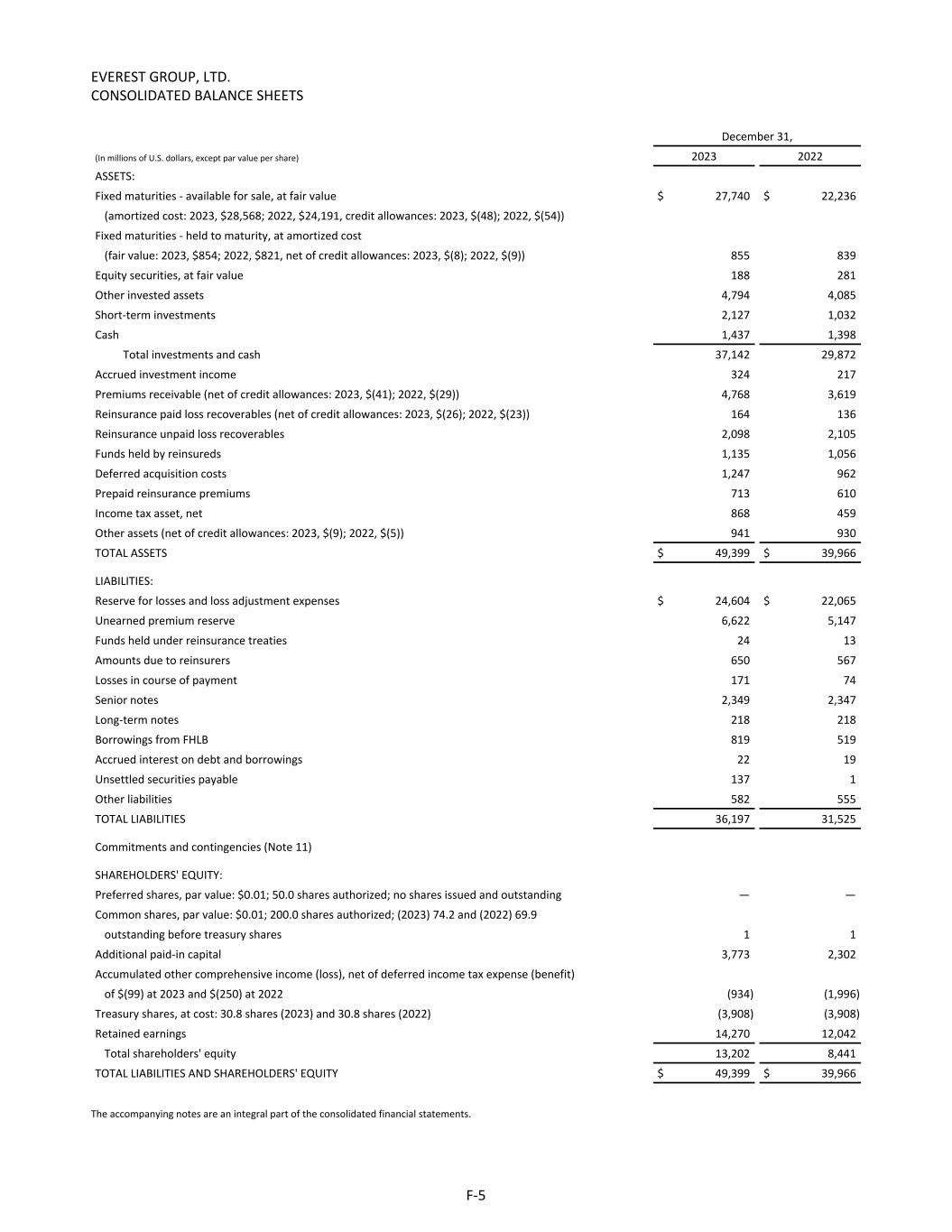
EVEREST GROUP, LTD. CONSOLIDATED BALANCE SHEETS December 31, (In millions of U.S. dollars, except par value per share) 2023 2022 ASSETS: Fixed maturities - available for sale, at fair value $ 27,740 $ 22,236 (amortized cost: 2023, $28,568; 2022, $24,191, credit allowances: 2023, $(48); 2022, $(54)) Fixed maturities - held to maturity, at amortized cost (fair value: 2023, $854; 2022, $821, net of credit allowances: 2023, $(8); 2022, $(9)) 855 839 Equity securities, at fair value 188 281 Other invested assets 4,794 4,085 Short-term investments 2,127 1,032 Cash 1,437 1,398 Total investments and cash 37,142 29,872 Accrued investment income 324 217 Premiums receivable (net of credit allowances: 2023, $(41); 2022, $(29)) 4,768 3,619 Reinsurance paid loss recoverables (net of credit allowances: 2023, $(26); 2022, $(23)) 164 136 Reinsurance unpaid loss recoverables 2,098 2,105 Funds held by reinsureds 1,135 1,056 Deferred acquisition costs 1,247 962 Prepaid reinsurance premiums 713 610 Income tax asset, net 868 459 Other assets (net of credit allowances: 2023, $(9); 2022, $(5)) 941 930 TOTAL ASSETS $ 49,399 $ 39,966 LIABILITIES: Reserve for losses and loss adjustment expenses $ 24,604 $ 22,065 Unearned premium reserve 6,622 5,147 Funds held under reinsurance treaties 24 13 Amounts due to reinsurers 650 567 Losses in course of payment 171 74 Senior notes 2,349 2,347 Long-term notes 218 218 Borrowings from FHLB 819 519 Accrued interest on debt and borrowings 22 19 Unsettled securities payable 137 1 Other liabilities 582 555 TOTAL LIABILITIES 36,197 31,525 Commitments and contingencies (Note 11) SHAREHOLDERS' EQUITY: Preferred shares, par value: $0.01; 50.0 shares authorized; no shares issued and outstanding — — Common shares, par value: $0.01; 200.0 shares authorized; (2023) 74.2 and (2022) 69.9 outstanding before treasury shares 1 1 Additional paid-in capital 3,773 2,302 Accumulated other comprehensive income (loss), net of deferred income tax expense (benefit) of $(99) at 2023 and $(250) at 2022 (934) (1,996) Treasury shares, at cost: 30.8 shares (2023) and 30.8 shares (2022) (3,908) (3,908) Retained earnings 14,270 12,042 Total shareholders' equity 13,202 8,441 TOTAL LIABILITIES AND SHAREHOLDERS' EQUITY $ 49,399 $ 39,966 The accompanying notes are an integral part of the consolidated financial statements. F-5
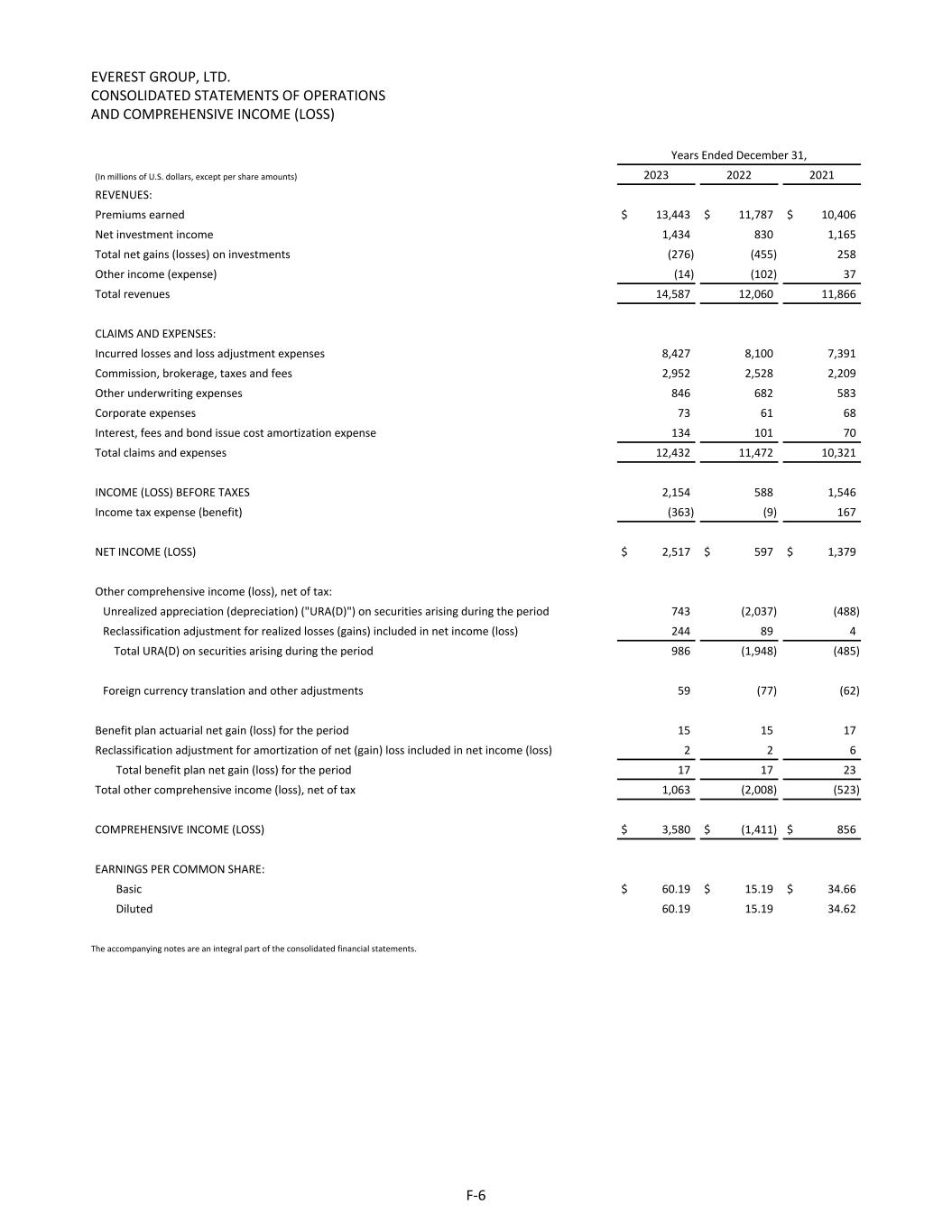
EVEREST GROUP, LTD. CONSOLIDATED STATEMENTS OF OPERATIONS AND COMPREHENSIVE INCOME (LOSS) Years Ended December 31, (In millions of U.S. dollars, except per share amounts) 2023 2022 2021 REVENUES: Premiums earned $ 13,443 $ 11,787 $ 10,406 Net investment income 1,434 830 1,165 Total net gains (losses) on investments (276) (455) 258 Other income (expense) (14) (102) 37 Total revenues 14,587 12,060 11,866 CLAIMS AND EXPENSES: Incurred losses and loss adjustment expenses 8,427 8,100 7,391 Commission, brokerage, taxes and fees 2,952 2,528 2,209 Other underwriting expenses 846 682 583 Corporate expenses 73 61 68 Interest, fees and bond issue cost amortization expense 134 101 70 Total claims and expenses 12,432 11,472 10,321 INCOME (LOSS) BEFORE TAXES 2,154 588 1,546 Income tax expense (benefit) (363) (9) 167 NET INCOME (LOSS) $ 2,517 $ 597 $ 1,379 Other comprehensive income (loss), net of tax: Unrealized appreciation (depreciation) ("URA(D)") on securities arising during the period 743 (2,037) (488) Reclassification adjustment for realized losses (gains) included in net income (loss) 244 89 4 Total URA(D) on securities arising during the period 986 (1,948) (485) Foreign currency translation and other adjustments 59 (77) (62) Benefit plan actuarial net gain (loss) for the period 15 15 17 Reclassification adjustment for amortization of net (gain) loss included in net income (loss) 2 2 6 Total benefit plan net gain (loss) for the period 17 17 23 Total other comprehensive income (loss), net of tax 1,063 (2,008) (523) COMPREHENSIVE INCOME (LOSS) $ 3,580 $ (1,411) $ 856 EARNINGS PER COMMON SHARE: Basic $ 60.19 $ 15.19 $ 34.66 Diluted 60.19 15.19 34.62 The accompanying notes are an integral part of the consolidated financial statements. F-6
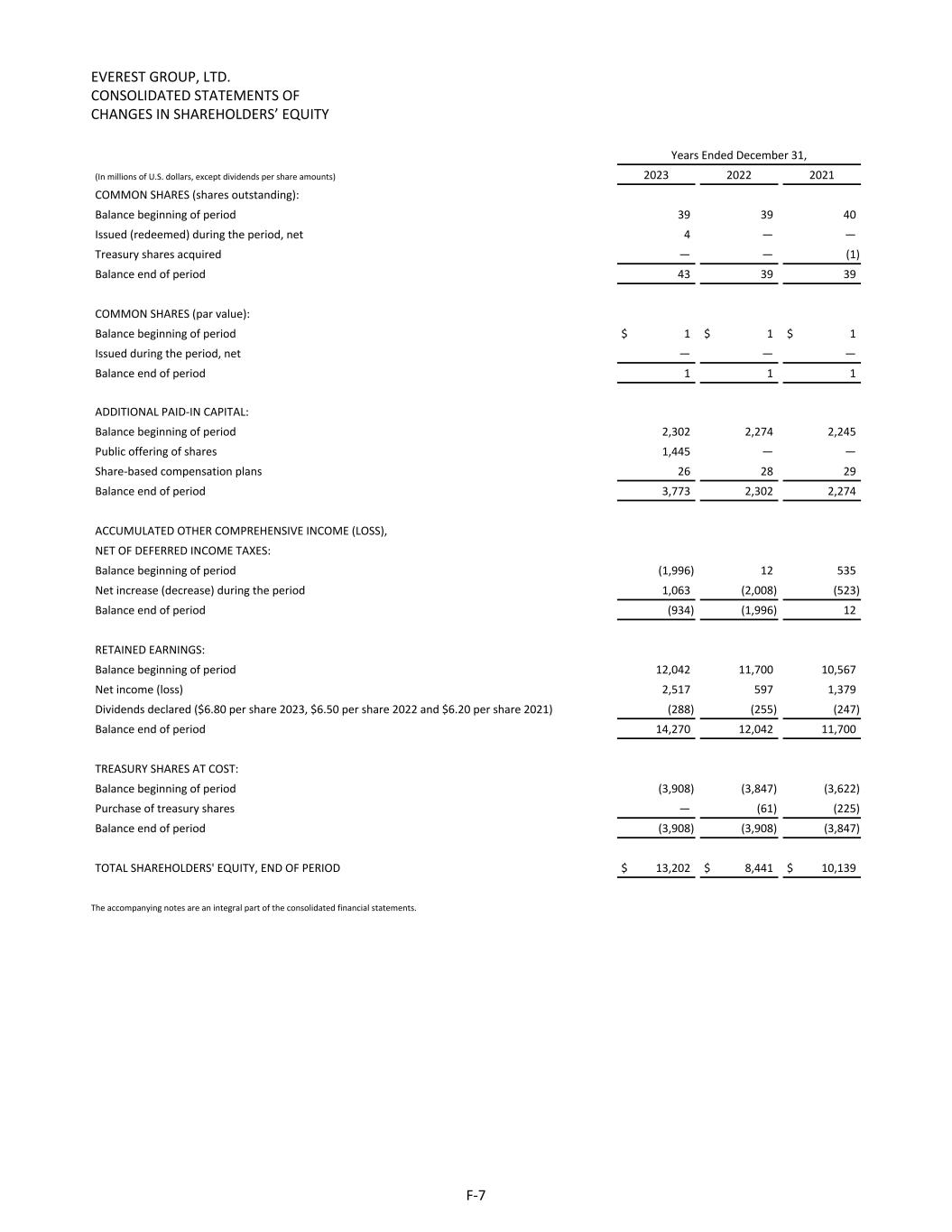
EVEREST GROUP, LTD. CONSOLIDATED STATEMENTS OF CHANGES IN SHAREHOLDERS’ EQUITY Years Ended December 31, (In millions of U.S. dollars, except dividends per share amounts) 2023 2022 2021 COMMON SHARES (shares outstanding): Balance beginning of period 39 39 40 Issued (redeemed) during the period, net 4 — — Treasury shares acquired — — (1) Balance end of period 43 39 39 COMMON SHARES (par value): Balance beginning of period $ 1 $ 1 $ 1 Issued during the period, net — — — Balance end of period 1 1 1 ADDITIONAL PAID-IN CAPITAL: Balance beginning of period 2,302 2,274 2,245 Public offering of shares 1,445 — — Share-based compensation plans 26 28 29 Balance end of period 3,773 2,302 2,274 ACCUMULATED OTHER COMPREHENSIVE INCOME (LOSS), NET OF DEFERRED INCOME TAXES: Balance beginning of period (1,996) 12 535 Net increase (decrease) during the period 1,063 (2,008) (523) Balance end of period (934) (1,996) 12 RETAINED EARNINGS: Balance beginning of period 12,042 11,700 10,567 Net income (loss) 2,517 597 1,379 Dividends declared ($6.80 per share 2023, $6.50 per share 2022 and $6.20 per share 2021) (288) (255) (247) Balance end of period 14,270 12,042 11,700 TREASURY SHARES AT COST: Balance beginning of period (3,908) (3,847) (3,622) Purchase of treasury shares — (61) (225) Balance end of period (3,908) (3,908) (3,847) TOTAL SHAREHOLDERS' EQUITY, END OF PERIOD $ 13,202 $ 8,441 $ 10,139 The accompanying notes are an integral part of the consolidated financial statements. F-7
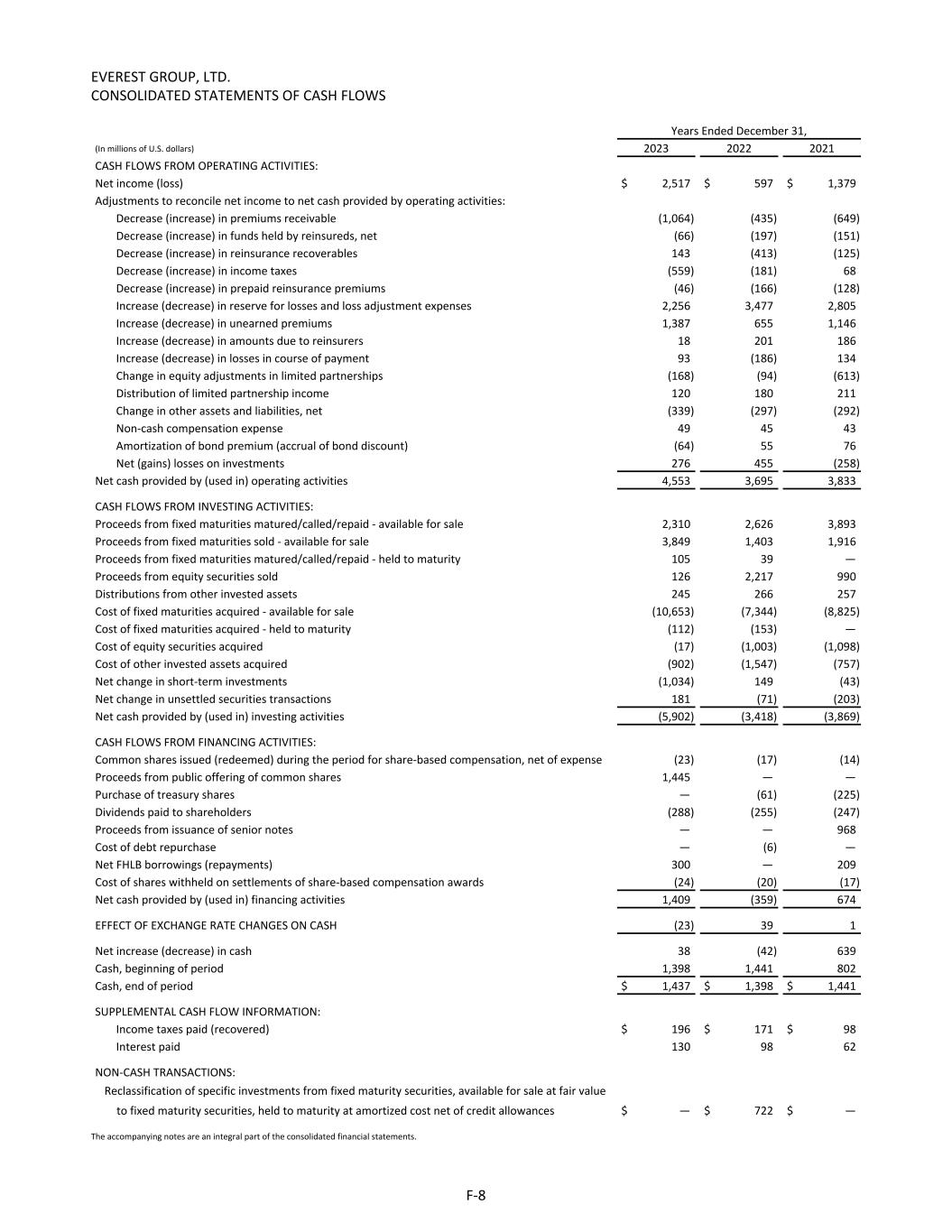
EVEREST GROUP, LTD. CONSOLIDATED STATEMENTS OF CASH FLOWS Years Ended December 31, (In millions of U.S. dollars) 2023 2022 2021 CASH FLOWS FROM OPERATING ACTIVITIES: Net income (loss) $ 2,517 $ 597 $ 1,379 Adjustments to reconcile net income to net cash provided by operating activities: Decrease (increase) in premiums receivable (1,064) (435) (649) Decrease (increase) in funds held by reinsureds, net (66) (197) (151) Decrease (increase) in reinsurance recoverables 143 (413) (125) Decrease (increase) in income taxes (559) (181) 68 Decrease (increase) in prepaid reinsurance premiums (46) (166) (128) Increase (decrease) in reserve for losses and loss adjustment expenses 2,256 3,477 2,805 Increase (decrease) in unearned premiums 1,387 655 1,146 Increase (decrease) in amounts due to reinsurers 18 201 186 Increase (decrease) in losses in course of payment 93 (186) 134 Change in equity adjustments in limited partnerships (168) (94) (613) Distribution of limited partnership income 120 180 211 Change in other assets and liabilities, net (339) (297) (292) Non-cash compensation expense 49 45 43 Amortization of bond premium (accrual of bond discount) (64) 55 76 Net (gains) losses on investments 276 455 (258) Net cash provided by (used in) operating activities 4,553 3,695 3,833 CASH FLOWS FROM INVESTING ACTIVITIES: Proceeds from fixed maturities matured/called/repaid - available for sale 2,310 2,626 3,893 Proceeds from fixed maturities sold - available for sale 3,849 1,403 1,916 Proceeds from fixed maturities matured/called/repaid - held to maturity 105 39 — Proceeds from equity securities sold 126 2,217 990 Distributions from other invested assets 245 266 257 Cost of fixed maturities acquired - available for sale (10,653) (7,344) (8,825) Cost of fixed maturities acquired - held to maturity (112) (153) — Cost of equity securities acquired (17) (1,003) (1,098) Cost of other invested assets acquired (902) (1,547) (757) Net change in short-term investments (1,034) 149 (43) Net change in unsettled securities transactions 181 (71) (203) Net cash provided by (used in) investing activities (5,902) (3,418) (3,869) CASH FLOWS FROM FINANCING ACTIVITIES: Common shares issued (redeemed) during the period for share-based compensation, net of expense (23) (17) (14) Proceeds from public offering of common shares 1,445 — — Purchase of treasury shares — (61) (225) Dividends paid to shareholders (288) (255) (247) Proceeds from issuance of senior notes — — 968 Cost of debt repurchase — (6) — Net FHLB borrowings (repayments) 300 — 209 Cost of shares withheld on settlements of share-based compensation awards (24) (20) (17) Net cash provided by (used in) financing activities 1,409 (359) 674 EFFECT OF EXCHANGE RATE CHANGES ON CASH (23) 39 1 Net increase (decrease) in cash 38 (42) 639 Cash, beginning of period 1,398 1,441 802 Cash, end of period $ 1,437 $ 1,398 $ 1,441 SUPPLEMENTAL CASH FLOW INFORMATION: Income taxes paid (recovered) $ 196 $ 171 $ 98 Interest paid 130 98 62 NON-CASH TRANSACTIONS: Reclassification of specific investments from fixed maturity securities, available for sale at fair value to fixed maturity securities, held to maturity at amortized cost net of credit allowances $ — $ 722 $ — The accompanying notes are an integral part of the consolidated financial statements. F-8
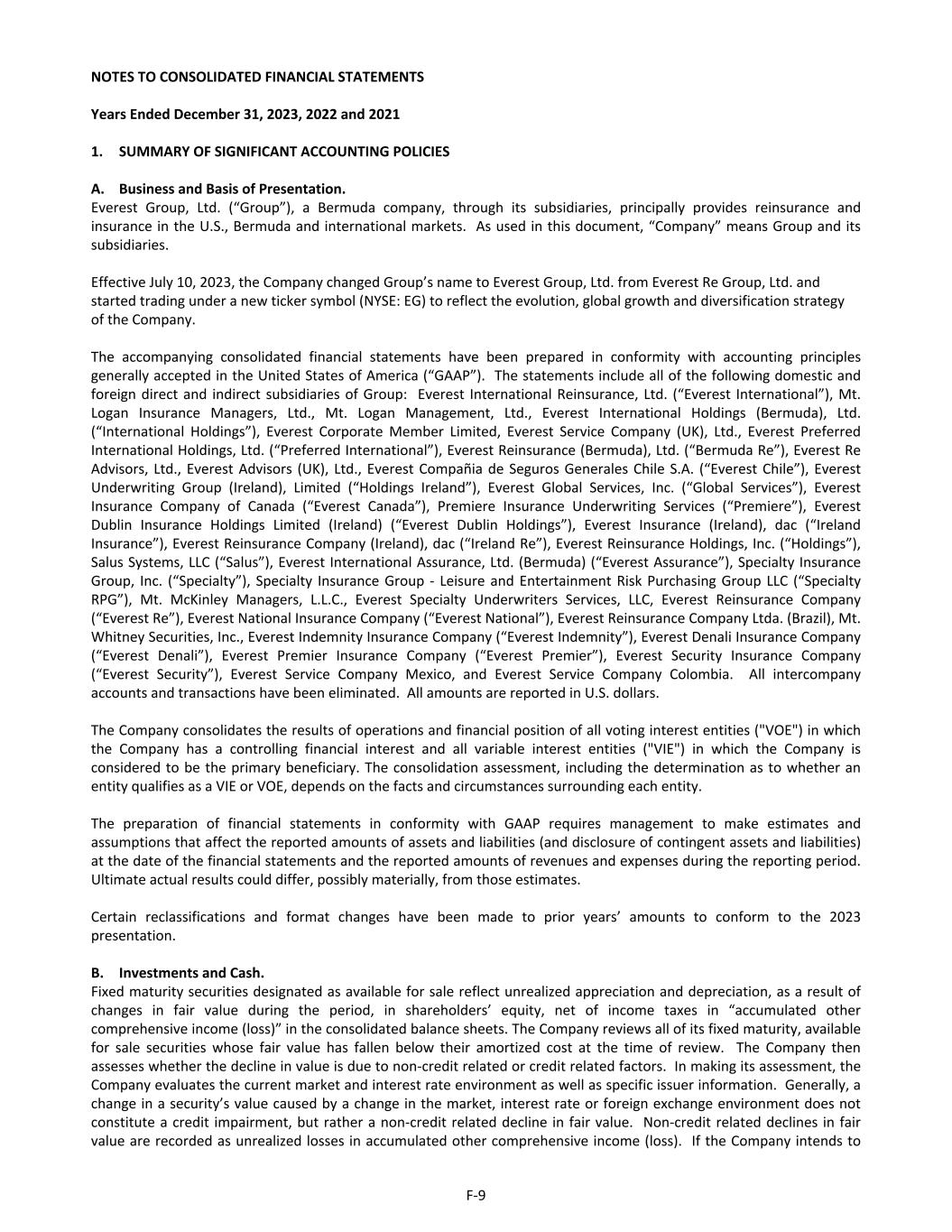
NOTES TO CONSOLIDATED FINANCIAL STATEMENTS Years Ended December 31, 2023, 2022 and 2021 1. SUMMARY OF SIGNIFICANT ACCOUNTING POLICIES A. Business and Basis of Presentation. Everest Group, Ltd. (“Group”), a Bermuda company, through its subsidiaries, principally provides reinsurance and insurance in the U.S., Bermuda and international markets. As used in this document, “Company” means Group and its subsidiaries. Effective July 10, 2023, the Company changed Group’s name to Everest Group, Ltd. from Everest Re Group, Ltd. and started trading under a new ticker symbol (NYSE: EG) to reflect the evolution, global growth and diversification strategy of the Company. The accompanying consolidated financial statements have been prepared in conformity with accounting principles generally accepted in the United States of America (“GAAP”). The statements include all of the following domestic and foreign direct and indirect subsidiaries of Group: Everest International Reinsurance, Ltd. (“Everest International”), Mt. Logan Insurance Managers, Ltd., Mt. Logan Management, Ltd., Everest International Holdings (Bermuda), Ltd. (“International Holdings”), Everest Corporate Member Limited, Everest Service Company (UK), Ltd., Everest Preferred International Holdings, Ltd. (“Preferred International”), Everest Reinsurance (Bermuda), Ltd. (“Bermuda Re”), Everest Re Advisors, Ltd., Everest Advisors (UK), Ltd., Everest Compañia de Seguros Generales Chile S.A. (“Everest Chile”), Everest Underwriting Group (Ireland), Limited (“Holdings Ireland”), Everest Global Services, Inc. (“Global Services”), Everest Insurance Company of Canada (“Everest Canada”), Premiere Insurance Underwriting Services (“Premiere”), Everest Dublin Insurance Holdings Limited (Ireland) (“Everest Dublin Holdings”), Everest Insurance (Ireland), dac (“Ireland Insurance”), Everest Reinsurance Company (Ireland), dac (“Ireland Re”), Everest Reinsurance Holdings, Inc. (“Holdings”), Salus Systems, LLC (“Salus”), Everest International Assurance, Ltd. (Bermuda) (“Everest Assurance”), Specialty Insurance Group, Inc. (“Specialty”), Specialty Insurance Group - Leisure and Entertainment Risk Purchasing Group LLC (“Specialty RPG”), Mt. McKinley Managers, L.L.C., Everest Specialty Underwriters Services, LLC, Everest Reinsurance Company (“Everest Re”), Everest National Insurance Company (“Everest National”), Everest Reinsurance Company Ltda. (Brazil), Mt. Whitney Securities, Inc., Everest Indemnity Insurance Company (“Everest Indemnity”), Everest Denali Insurance Company (“Everest Denali”), Everest Premier Insurance Company (“Everest Premier”), Everest Security Insurance Company (“Everest Security”), Everest Service Company Mexico, and Everest Service Company Colombia. All intercompany accounts and transactions have been eliminated. All amounts are reported in U.S. dollars. The Company consolidates the results of operations and financial position of all voting interest entities ("VOE") in which the Company has a controlling financial interest and all variable interest entities ("VIE") in which the Company is considered to be the primary beneficiary. The consolidation assessment, including the determination as to whether an entity qualifies as a VIE or VOE, depends on the facts and circumstances surrounding each entity. The preparation of financial statements in conformity with GAAP requires management to make estimates and assumptions that affect the reported amounts of assets and liabilities (and disclosure of contingent assets and liabilities) at the date of the financial statements and the reported amounts of revenues and expenses during the reporting period. Ultimate actual results could differ, possibly materially, from those estimates. Certain reclassifications and format changes have been made to prior years’ amounts to conform to the 2023 presentation. B. Investments and Cash. Fixed maturity securities designated as available for sale reflect unrealized appreciation and depreciation, as a result of changes in fair value during the period, in shareholders’ equity, net of income taxes in “accumulated other comprehensive income (loss)” in the consolidated balance sheets. The Company reviews all of its fixed maturity, available for sale securities whose fair value has fallen below their amortized cost at the time of review. The Company then assesses whether the decline in value is due to non-credit related or credit related factors. In making its assessment, the Company evaluates the current market and interest rate environment as well as specific issuer information. Generally, a change in a security’s value caused by a change in the market, interest rate or foreign exchange environment does not constitute a credit impairment, but rather a non-credit related decline in fair value. Non-credit related declines in fair value are recorded as unrealized losses in accumulated other comprehensive income (loss). If the Company intends to F-9
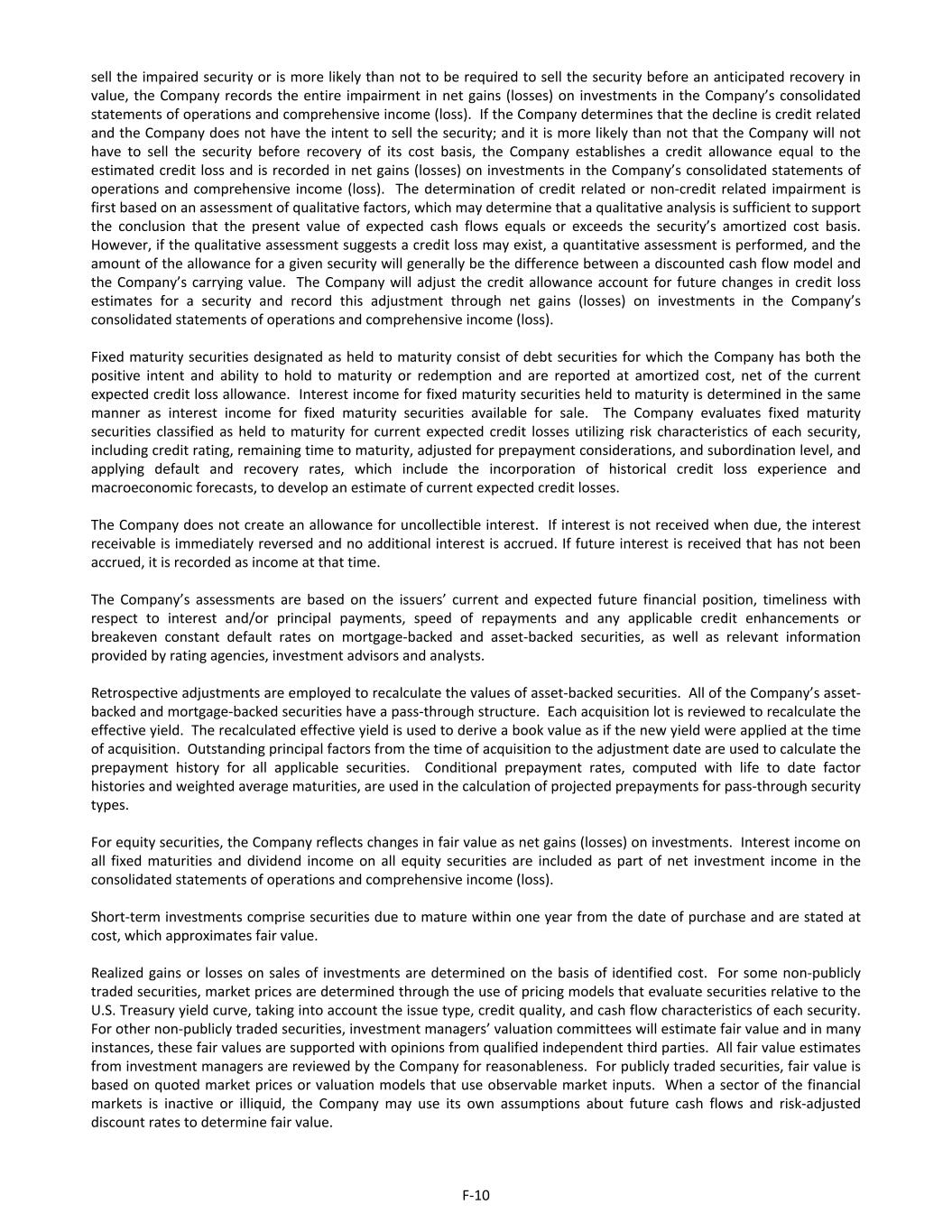
sell the impaired security or is more likely than not to be required to sell the security before an anticipated recovery in value, the Company records the entire impairment in net gains (losses) on investments in the Company’s consolidated statements of operations and comprehensive income (loss). If the Company determines that the decline is credit related and the Company does not have the intent to sell the security; and it is more likely than not that the Company will not have to sell the security before recovery of its cost basis, the Company establishes a credit allowance equal to the estimated credit loss and is recorded in net gains (losses) on investments in the Company’s consolidated statements of operations and comprehensive income (loss). The determination of credit related or non-credit related impairment is first based on an assessment of qualitative factors, which may determine that a qualitative analysis is sufficient to support the conclusion that the present value of expected cash flows equals or exceeds the security’s amortized cost basis. However, if the qualitative assessment suggests a credit loss may exist, a quantitative assessment is performed, and the amount of the allowance for a given security will generally be the difference between a discounted cash flow model and the Company’s carrying value. The Company will adjust the credit allowance account for future changes in credit loss estimates for a security and record this adjustment through net gains (losses) on investments in the Company’s consolidated statements of operations and comprehensive income (loss). Fixed maturity securities designated as held to maturity consist of debt securities for which the Company has both the positive intent and ability to hold to maturity or redemption and are reported at amortized cost, net of the current expected credit loss allowance. Interest income for fixed maturity securities held to maturity is determined in the same manner as interest income for fixed maturity securities available for sale. The Company evaluates fixed maturity securities classified as held to maturity for current expected credit losses utilizing risk characteristics of each security, including credit rating, remaining time to maturity, adjusted for prepayment considerations, and subordination level, and applying default and recovery rates, which include the incorporation of historical credit loss experience and macroeconomic forecasts, to develop an estimate of current expected credit losses. The Company does not create an allowance for uncollectible interest. If interest is not received when due, the interest receivable is immediately reversed and no additional interest is accrued. If future interest is received that has not been accrued, it is recorded as income at that time. The Company’s assessments are based on the issuers’ current and expected future financial position, timeliness with respect to interest and/or principal payments, speed of repayments and any applicable credit enhancements or breakeven constant default rates on mortgage-backed and asset-backed securities, as well as relevant information provided by rating agencies, investment advisors and analysts. Retrospective adjustments are employed to recalculate the values of asset-backed securities. All of the Company’s asset- backed and mortgage-backed securities have a pass-through structure. Each acquisition lot is reviewed to recalculate the effective yield. The recalculated effective yield is used to derive a book value as if the new yield were applied at the time of acquisition. Outstanding principal factors from the time of acquisition to the adjustment date are used to calculate the prepayment history for all applicable securities. Conditional prepayment rates, computed with life to date factor histories and weighted average maturities, are used in the calculation of projected prepayments for pass-through security types. For equity securities, the Company reflects changes in fair value as net gains (losses) on investments. Interest income on all fixed maturities and dividend income on all equity securities are included as part of net investment income in the consolidated statements of operations and comprehensive income (loss). Short-term investments comprise securities due to mature within one year from the date of purchase and are stated at cost, which approximates fair value. Realized gains or losses on sales of investments are determined on the basis of identified cost. For some non-publicly traded securities, market prices are determined through the use of pricing models that evaluate securities relative to the U.S. Treasury yield curve, taking into account the issue type, credit quality, and cash flow characteristics of each security. For other non-publicly traded securities, investment managers’ valuation committees will estimate fair value and in many instances, these fair values are supported with opinions from qualified independent third parties. All fair value estimates from investment managers are reviewed by the Company for reasonableness. For publicly traded securities, fair value is based on quoted market prices or valuation models that use observable market inputs. When a sector of the financial markets is inactive or illiquid, the Company may use its own assumptions about future cash flows and risk-adjusted discount rates to determine fair value. F-10
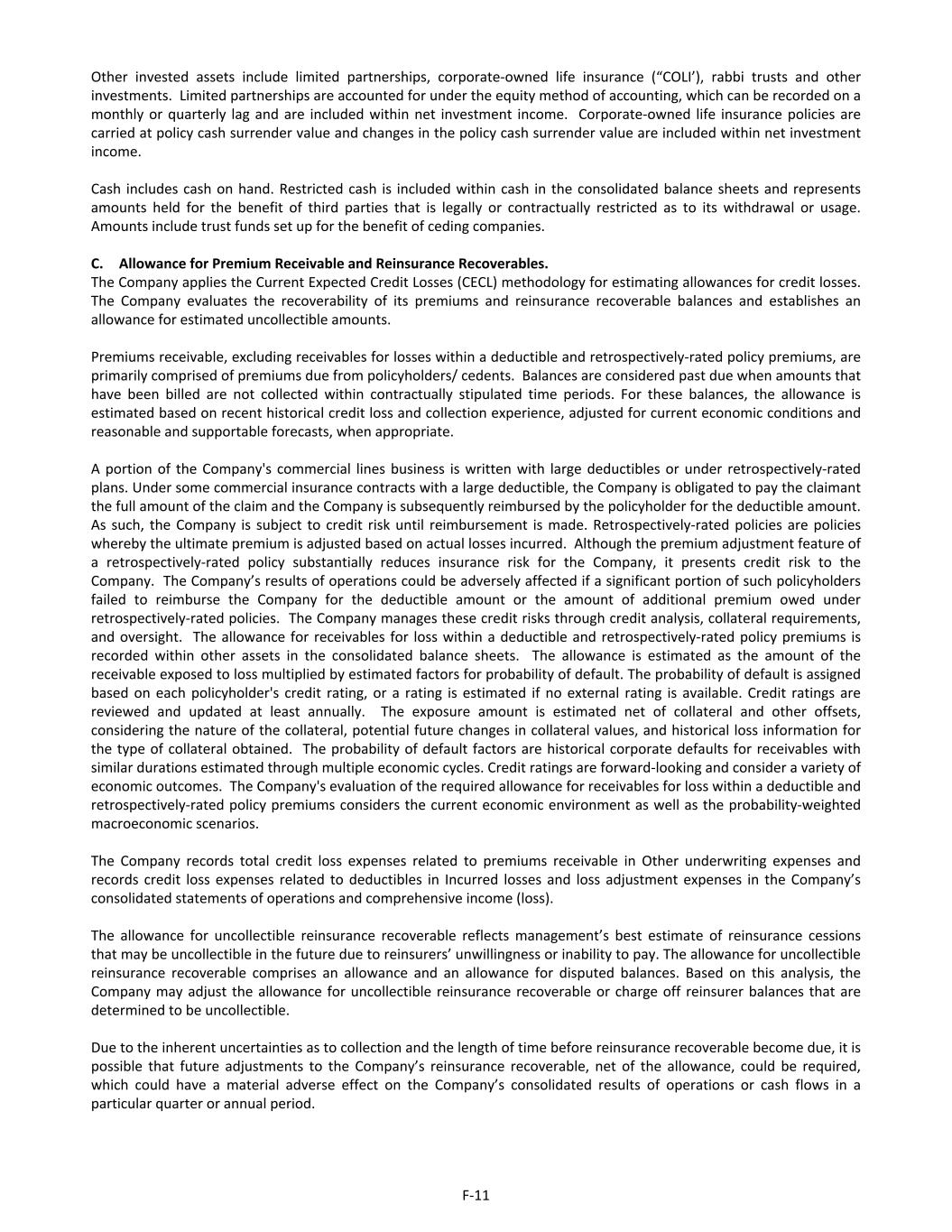
Other invested assets include limited partnerships, corporate-owned life insurance (“COLI’), rabbi trusts and other investments. Limited partnerships are accounted for under the equity method of accounting, which can be recorded on a monthly or quarterly lag and are included within net investment income. Corporate-owned life insurance policies are carried at policy cash surrender value and changes in the policy cash surrender value are included within net investment income. Cash includes cash on hand. Restricted cash is included within cash in the consolidated balance sheets and represents amounts held for the benefit of third parties that is legally or contractually restricted as to its withdrawal or usage. Amounts include trust funds set up for the benefit of ceding companies. C. Allowance for Premium Receivable and Reinsurance Recoverables. The Company applies the Current Expected Credit Losses (CECL) methodology for estimating allowances for credit losses. The Company evaluates the recoverability of its premiums and reinsurance recoverable balances and establishes an allowance for estimated uncollectible amounts. Premiums receivable, excluding receivables for losses within a deductible and retrospectively-rated policy premiums, are primarily comprised of premiums due from policyholders/ cedents. Balances are considered past due when amounts that have been billed are not collected within contractually stipulated time periods. For these balances, the allowance is estimated based on recent historical credit loss and collection experience, adjusted for current economic conditions and reasonable and supportable forecasts, when appropriate. A portion of the Company's commercial lines business is written with large deductibles or under retrospectively-rated plans. Under some commercial insurance contracts with a large deductible, the Company is obligated to pay the claimant the full amount of the claim and the Company is subsequently reimbursed by the policyholder for the deductible amount. As such, the Company is subject to credit risk until reimbursement is made. Retrospectively-rated policies are policies whereby the ultimate premium is adjusted based on actual losses incurred. Although the premium adjustment feature of a retrospectively-rated policy substantially reduces insurance risk for the Company, it presents credit risk to the Company. The Company’s results of operations could be adversely affected if a significant portion of such policyholders failed to reimburse the Company for the deductible amount or the amount of additional premium owed under retrospectively-rated policies. The Company manages these credit risks through credit analysis, collateral requirements, and oversight. The allowance for receivables for loss within a deductible and retrospectively-rated policy premiums is recorded within other assets in the consolidated balance sheets. The allowance is estimated as the amount of the receivable exposed to loss multiplied by estimated factors for probability of default. The probability of default is assigned based on each policyholder's credit rating, or a rating is estimated if no external rating is available. Credit ratings are reviewed and updated at least annually. The exposure amount is estimated net of collateral and other offsets, considering the nature of the collateral, potential future changes in collateral values, and historical loss information for the type of collateral obtained. The probability of default factors are historical corporate defaults for receivables with similar durations estimated through multiple economic cycles. Credit ratings are forward-looking and consider a variety of economic outcomes. The Company's evaluation of the required allowance for receivables for loss within a deductible and retrospectively-rated policy premiums considers the current economic environment as well as the probability-weighted macroeconomic scenarios. The Company records total credit loss expenses related to premiums receivable in Other underwriting expenses and records credit loss expenses related to deductibles in Incurred losses and loss adjustment expenses in the Company’s consolidated statements of operations and comprehensive income (loss). The allowance for uncollectible reinsurance recoverable reflects management’s best estimate of reinsurance cessions that may be uncollectible in the future due to reinsurers’ unwillingness or inability to pay. The allowance for uncollectible reinsurance recoverable comprises an allowance and an allowance for disputed balances. Based on this analysis, the Company may adjust the allowance for uncollectible reinsurance recoverable or charge off reinsurer balances that are determined to be uncollectible. Due to the inherent uncertainties as to collection and the length of time before reinsurance recoverable become due, it is possible that future adjustments to the Company’s reinsurance recoverable, net of the allowance, could be required, which could have a material adverse effect on the Company’s consolidated results of operations or cash flows in a particular quarter or annual period. F-11
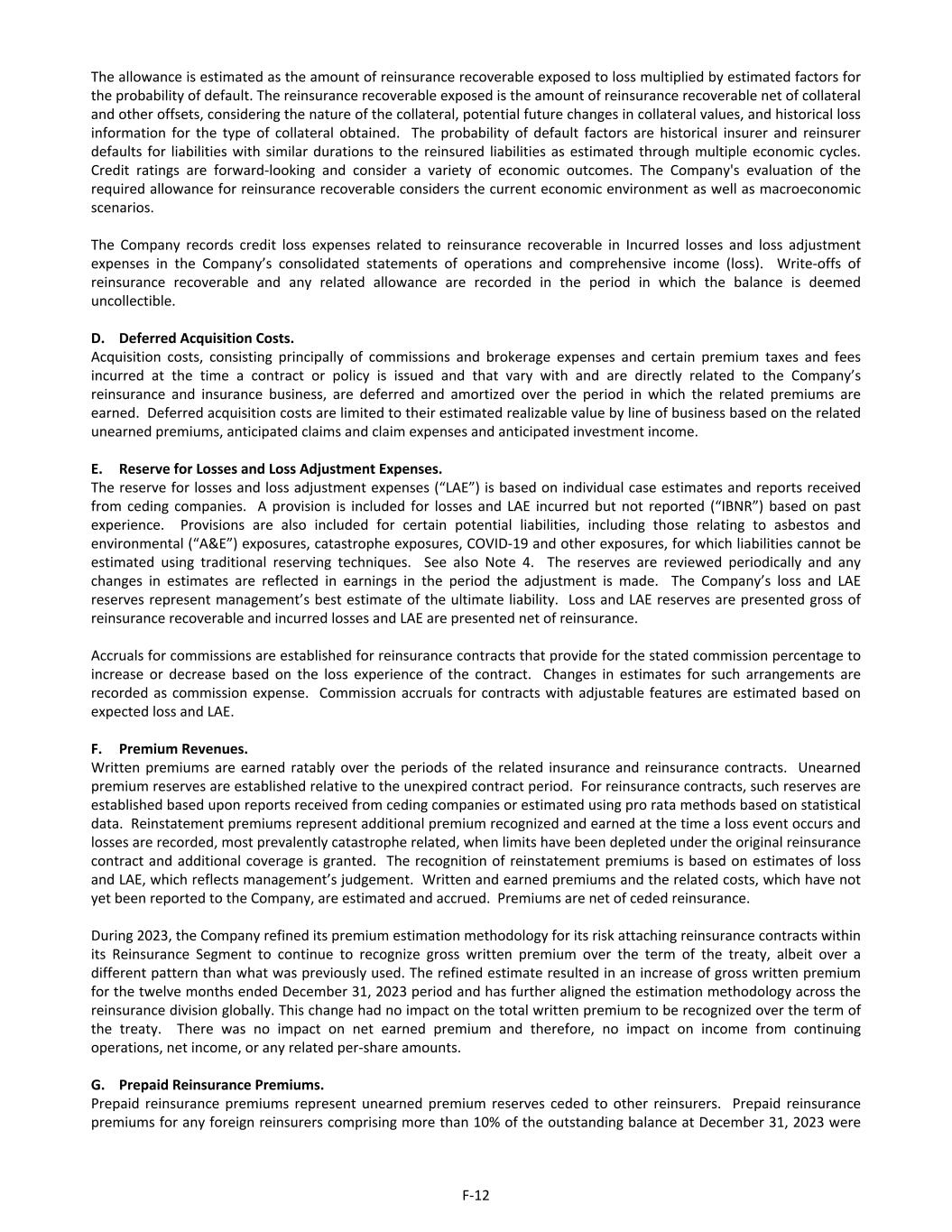
The allowance is estimated as the amount of reinsurance recoverable exposed to loss multiplied by estimated factors for the probability of default. The reinsurance recoverable exposed is the amount of reinsurance recoverable net of collateral and other offsets, considering the nature of the collateral, potential future changes in collateral values, and historical loss information for the type of collateral obtained. The probability of default factors are historical insurer and reinsurer defaults for liabilities with similar durations to the reinsured liabilities as estimated through multiple economic cycles. Credit ratings are forward-looking and consider a variety of economic outcomes. The Company's evaluation of the required allowance for reinsurance recoverable considers the current economic environment as well as macroeconomic scenarios. The Company records credit loss expenses related to reinsurance recoverable in Incurred losses and loss adjustment expenses in the Company’s consolidated statements of operations and comprehensive income (loss). Write-offs of reinsurance recoverable and any related allowance are recorded in the period in which the balance is deemed uncollectible. D. Deferred Acquisition Costs. Acquisition costs, consisting principally of commissions and brokerage expenses and certain premium taxes and fees incurred at the time a contract or policy is issued and that vary with and are directly related to the Company’s reinsurance and insurance business, are deferred and amortized over the period in which the related premiums are earned. Deferred acquisition costs are limited to their estimated realizable value by line of business based on the related unearned premiums, anticipated claims and claim expenses and anticipated investment income. E. Reserve for Losses and Loss Adjustment Expenses. The reserve for losses and loss adjustment expenses (“LAE”) is based on individual case estimates and reports received from ceding companies. A provision is included for losses and LAE incurred but not reported (“IBNR”) based on past experience. Provisions are also included for certain potential liabilities, including those relating to asbestos and environmental (“A&E”) exposures, catastrophe exposures, COVID-19 and other exposures, for which liabilities cannot be estimated using traditional reserving techniques. See also Note 4. The reserves are reviewed periodically and any changes in estimates are reflected in earnings in the period the adjustment is made. The Company’s loss and LAE reserves represent management’s best estimate of the ultimate liability. Loss and LAE reserves are presented gross of reinsurance recoverable and incurred losses and LAE are presented net of reinsurance. Accruals for commissions are established for reinsurance contracts that provide for the stated commission percentage to increase or decrease based on the loss experience of the contract. Changes in estimates for such arrangements are recorded as commission expense. Commission accruals for contracts with adjustable features are estimated based on expected loss and LAE. F. Premium Revenues. Written premiums are earned ratably over the periods of the related insurance and reinsurance contracts. Unearned premium reserves are established relative to the unexpired contract period. For reinsurance contracts, such reserves are established based upon reports received from ceding companies or estimated using pro rata methods based on statistical data. Reinstatement premiums represent additional premium recognized and earned at the time a loss event occurs and losses are recorded, most prevalently catastrophe related, when limits have been depleted under the original reinsurance contract and additional coverage is granted. The recognition of reinstatement premiums is based on estimates of loss and LAE, which reflects management’s judgement. Written and earned premiums and the related costs, which have not yet been reported to the Company, are estimated and accrued. Premiums are net of ceded reinsurance. During 2023, the Company refined its premium estimation methodology for its risk attaching reinsurance contracts within its Reinsurance Segment to continue to recognize gross written premium over the term of the treaty, albeit over a different pattern than what was previously used. The refined estimate resulted in an increase of gross written premium for the twelve months ended December 31, 2023 period and has further aligned the estimation methodology across the reinsurance division globally. This change had no impact on the total written premium to be recognized over the term of the treaty. There was no impact on net earned premium and therefore, no impact on income from continuing operations, net income, or any related per-share amounts. G. Prepaid Reinsurance Premiums. Prepaid reinsurance premiums represent unearned premium reserves ceded to other reinsurers. Prepaid reinsurance premiums for any foreign reinsurers comprising more than 10% of the outstanding balance at December 31, 2023 were F-12
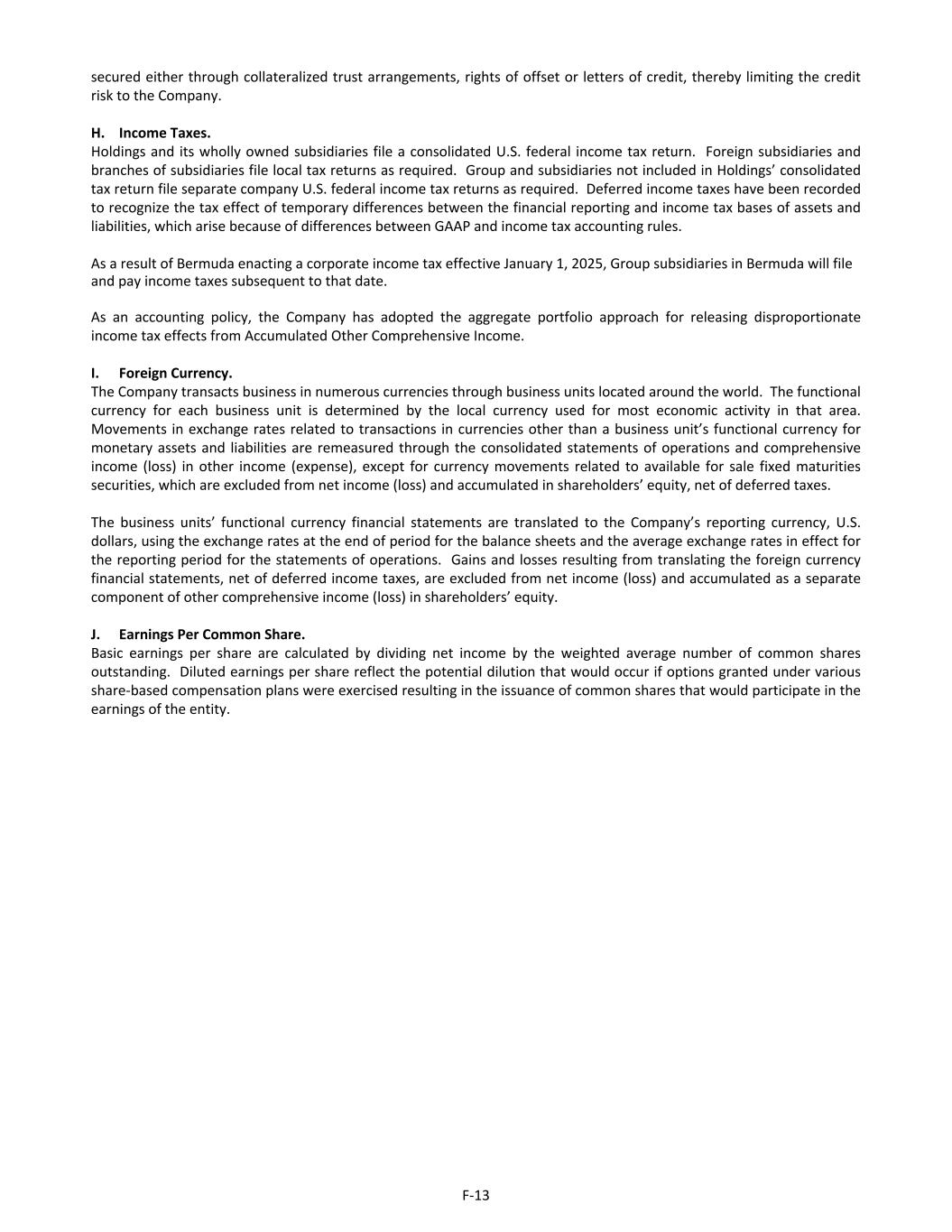
secured either through collateralized trust arrangements, rights of offset or letters of credit, thereby limiting the credit risk to the Company. H. Income Taxes. Holdings and its wholly owned subsidiaries file a consolidated U.S. federal income tax return. Foreign subsidiaries and branches of subsidiaries file local tax returns as required. Group and subsidiaries not included in Holdings’ consolidated tax return file separate company U.S. federal income tax returns as required. Deferred income taxes have been recorded to recognize the tax effect of temporary differences between the financial reporting and income tax bases of assets and liabilities, which arise because of differences between GAAP and income tax accounting rules. As a result of Bermuda enacting a corporate income tax effective January 1, 2025, Group subsidiaries in Bermuda will file and pay income taxes subsequent to that date. As an accounting policy, the Company has adopted the aggregate portfolio approach for releasing disproportionate income tax effects from Accumulated Other Comprehensive Income. I. Foreign Currency. The Company transacts business in numerous currencies through business units located around the world. The functional currency for each business unit is determined by the local currency used for most economic activity in that area. Movements in exchange rates related to transactions in currencies other than a business unit’s functional currency for monetary assets and liabilities are remeasured through the consolidated statements of operations and comprehensive income (loss) in other income (expense), except for currency movements related to available for sale fixed maturities securities, which are excluded from net income (loss) and accumulated in shareholders’ equity, net of deferred taxes. The business units’ functional currency financial statements are translated to the Company’s reporting currency, U.S. dollars, using the exchange rates at the end of period for the balance sheets and the average exchange rates in effect for the reporting period for the statements of operations. Gains and losses resulting from translating the foreign currency financial statements, net of deferred income taxes, are excluded from net income (loss) and accumulated as a separate component of other comprehensive income (loss) in shareholders’ equity. J. Earnings Per Common Share. Basic earnings per share are calculated by dividing net income by the weighted average number of common shares outstanding. Diluted earnings per share reflect the potential dilution that would occur if options granted under various share-based compensation plans were exercised resulting in the issuance of common shares that would participate in the earnings of the entity. F-13
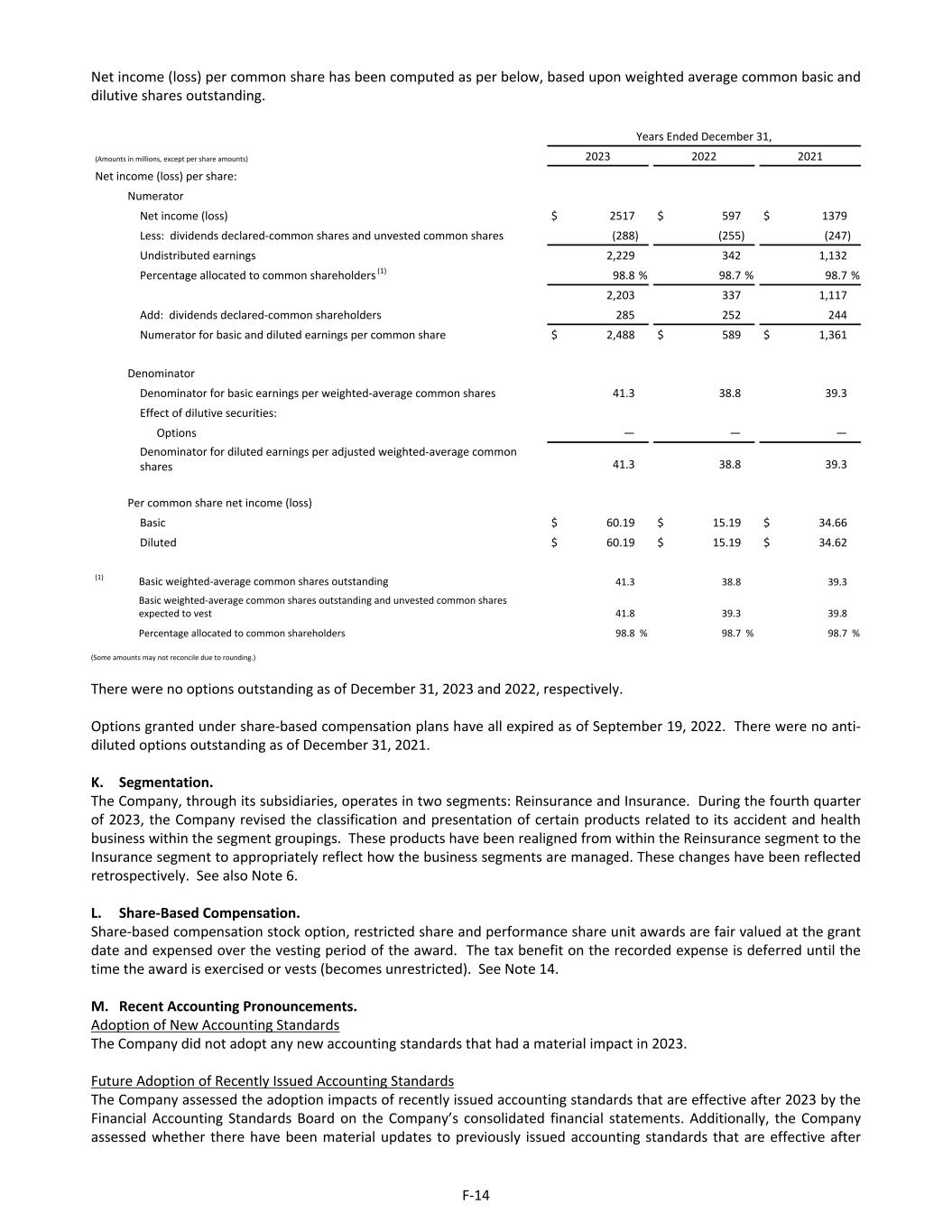
Net income (loss) per common share has been computed as per below, based upon weighted average common basic and dilutive shares outstanding. Years Ended December 31, (Amounts in millions, except per share amounts) 2023 2022 2021 Net income (loss) per share: Numerator Net income (loss) $ 2517 $ 597 $ 1379 Less: dividends declared-common shares and unvested common shares (288) (255) (247) Undistributed earnings 2,229 342 1,132 Percentage allocated to common shareholders (1) 98.8 % 98.7 % 98.7 % 2,203 337 1,117 Add: dividends declared-common shareholders 285 252 244 Numerator for basic and diluted earnings per common share $ 2,488 $ 589 $ 1,361 Denominator Denominator for basic earnings per weighted-average common shares 41.3 38.8 39.3 Effect of dilutive securities: Options — — — Denominator for diluted earnings per adjusted weighted-average common shares 41.3 38.8 39.3 Per common share net income (loss) Basic $ 60.19 $ 15.19 $ 34.66 Diluted $ 60.19 $ 15.19 $ 34.62 (1) Basic weighted-average common shares outstanding 41.3 38.8 39.3 Basic weighted-average common shares outstanding and unvested common shares expected to vest 41.8 39.3 39.8 Percentage allocated to common shareholders 98.8 % 98.7 % 98.7 % (Some amounts may not reconcile due to rounding.) There were no options outstanding as of December 31, 2023 and 2022, respectively. Options granted under share-based compensation plans have all expired as of September 19, 2022. There were no anti- diluted options outstanding as of December 31, 2021. K. Segmentation. The Company, through its subsidiaries, operates in two segments: Reinsurance and Insurance. During the fourth quarter of 2023, the Company revised the classification and presentation of certain products related to its accident and health business within the segment groupings. These products have been realigned from within the Reinsurance segment to the Insurance segment to appropriately reflect how the business segments are managed. These changes have been reflected retrospectively. See also Note 6. L. Share-Based Compensation. Share-based compensation stock option, restricted share and performance share unit awards are fair valued at the grant date and expensed over the vesting period of the award. The tax benefit on the recorded expense is deferred until the time the award is exercised or vests (becomes unrestricted). See Note 14. M. Recent Accounting Pronouncements. Adoption of New Accounting Standards The Company did not adopt any new accounting standards that had a material impact in 2023. Future Adoption of Recently Issued Accounting Standards The Company assessed the adoption impacts of recently issued accounting standards that are effective after 2023 by the Financial Accounting Standards Board on the Company’s consolidated financial statements. Additionally, the Company assessed whether there have been material updates to previously issued accounting standards that are effective after F-14
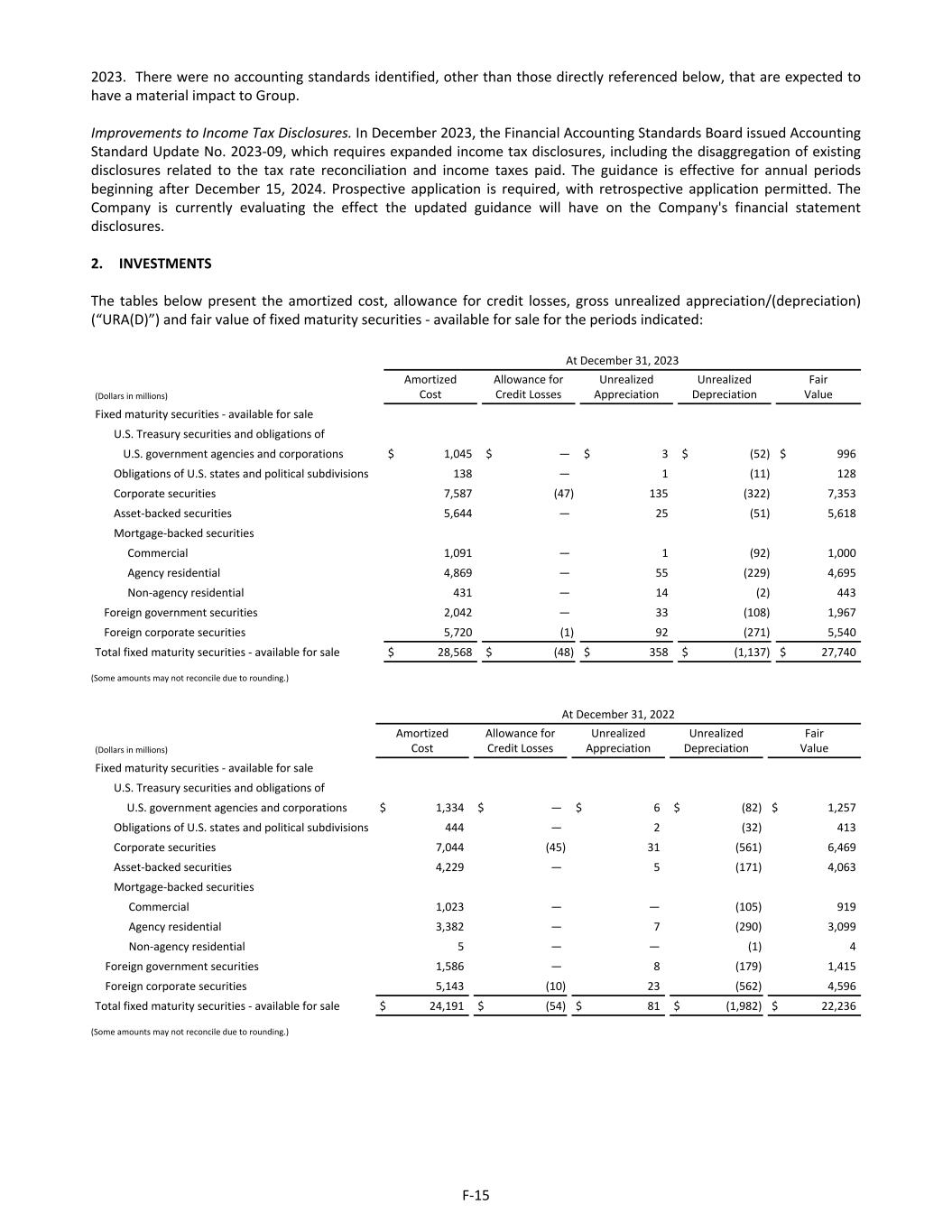
2023. There were no accounting standards identified, other than those directly referenced below, that are expected to have a material impact to Group. Improvements to Income Tax Disclosures. In December 2023, the Financial Accounting Standards Board issued Accounting Standard Update No. 2023-09, which requires expanded income tax disclosures, including the disaggregation of existing disclosures related to the tax rate reconciliation and income taxes paid. The guidance is effective for annual periods beginning after December 15, 2024. Prospective application is required, with retrospective application permitted. The Company is currently evaluating the effect the updated guidance will have on the Company's financial statement disclosures. 2. INVESTMENTS The tables below present the amortized cost, allowance for credit losses, gross unrealized appreciation/(depreciation) (“URA(D)”) and fair value of fixed maturity securities - available for sale for the periods indicated: At December 31, 2023 (Dollars in millions) Amortized Cost Allowance for Credit Losses Unrealized Appreciation Unrealized Depreciation Fair Value Fixed maturity securities - available for sale U.S. Treasury securities and obligations of U.S. government agencies and corporations $ 1,045 $ — $ 3 $ (52) $ 996 Obligations of U.S. states and political subdivisions 138 — 1 (11) 128 Corporate securities 7,587 (47) 135 (322) 7,353 Asset-backed securities 5,644 — 25 (51) 5,618 Mortgage-backed securities Commercial 1,091 — 1 (92) 1,000 Agency residential 4,869 — 55 (229) 4,695 Non-agency residential 431 — 14 (2) 443 Foreign government securities 2,042 — 33 (108) 1,967 Foreign corporate securities 5,720 (1) 92 (271) 5,540 Total fixed maturity securities - available for sale $ 28,568 $ (48) $ 358 $ (1,137) $ 27,740 (Some amounts may not reconcile due to rounding.) At December 31, 2022 (Dollars in millions) Amortized Cost Allowance for Credit Losses Unrealized Appreciation Unrealized Depreciation Fair Value Fixed maturity securities - available for sale U.S. Treasury securities and obligations of U.S. government agencies and corporations $ 1,334 $ — $ 6 $ (82) $ 1,257 Obligations of U.S. states and political subdivisions 444 — 2 (32) 413 Corporate securities 7,044 (45) 31 (561) 6,469 Asset-backed securities 4,229 — 5 (171) 4,063 Mortgage-backed securities Commercial 1,023 — — (105) 919 Agency residential 3,382 — 7 (290) 3,099 Non-agency residential 5 — — (1) 4 Foreign government securities 1,586 — 8 (179) 1,415 Foreign corporate securities 5,143 (10) 23 (562) 4,596 Total fixed maturity securities - available for sale $ 24,191 $ (54) $ 81 $ (1,982) $ 22,236 (Some amounts may not reconcile due to rounding.) F-15
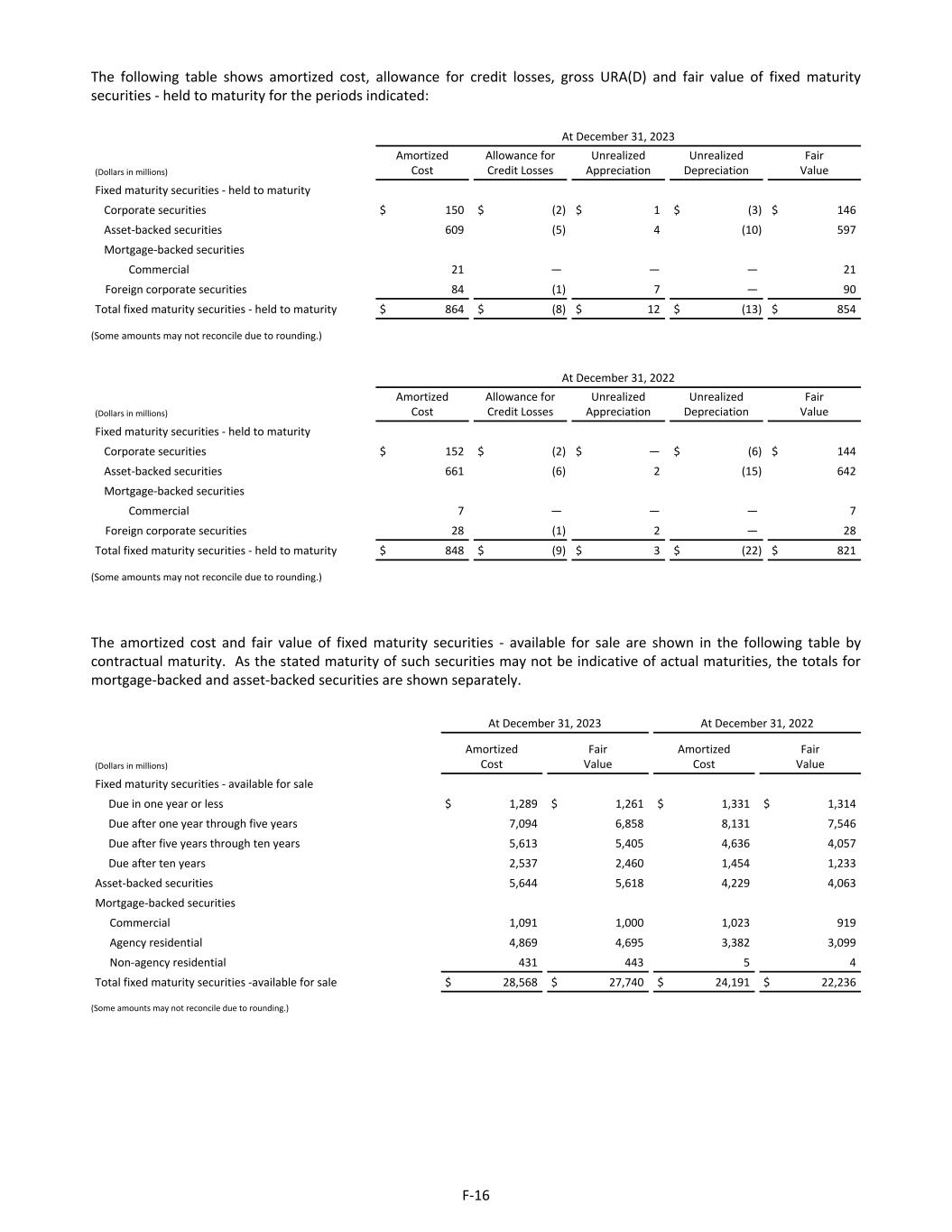
The following table shows amortized cost, allowance for credit losses, gross URA(D) and fair value of fixed maturity securities - held to maturity for the periods indicated: At December 31, 2023 (Dollars in millions) Amortized Cost Allowance for Credit Losses Unrealized Appreciation Unrealized Depreciation Fair Value Fixed maturity securities - held to maturity Corporate securities $ 150 $ (2) $ 1 $ (3) $ 146 Asset-backed securities 609 (5) 4 (10) 597 Mortgage-backed securities Commercial 21 — — — 21 Foreign corporate securities 84 (1) 7 — 90 Total fixed maturity securities - held to maturity $ 864 $ (8) $ 12 $ (13) $ 854 (Some amounts may not reconcile due to rounding.) At December 31, 2022 (Dollars in millions) Amortized Cost Allowance for Credit Losses Unrealized Appreciation Unrealized Depreciation Fair Value Fixed maturity securities - held to maturity Corporate securities $ 152 $ (2) $ — $ (6) $ 144 Asset-backed securities 661 (6) 2 (15) 642 Mortgage-backed securities Commercial 7 — — — 7 Foreign corporate securities 28 (1) 2 — 28 Total fixed maturity securities - held to maturity $ 848 $ (9) $ 3 $ (22) $ 821 (Some amounts may not reconcile due to rounding.) The amortized cost and fair value of fixed maturity securities - available for sale are shown in the following table by contractual maturity. As the stated maturity of such securities may not be indicative of actual maturities, the totals for mortgage-backed and asset-backed securities are shown separately. At December 31, 2023 At December 31, 2022 (Dollars in millions) Amortized Cost Fair Value Amortized Cost Fair Value Fixed maturity securities - available for sale Due in one year or less $ 1,289 $ 1,261 $ 1,331 $ 1,314 Due after one year through five years 7,094 6,858 8,131 7,546 Due after five years through ten years 5,613 5,405 4,636 4,057 Due after ten years 2,537 2,460 1,454 1,233 Asset-backed securities 5,644 5,618 4,229 4,063 Mortgage-backed securities Commercial 1,091 1,000 1,023 919 Agency residential 4,869 4,695 3,382 3,099 Non-agency residential 431 443 5 4 Total fixed maturity securities -available for sale $ 28,568 $ 27,740 $ 24,191 $ 22,236 (Some amounts may not reconcile due to rounding.) F-16
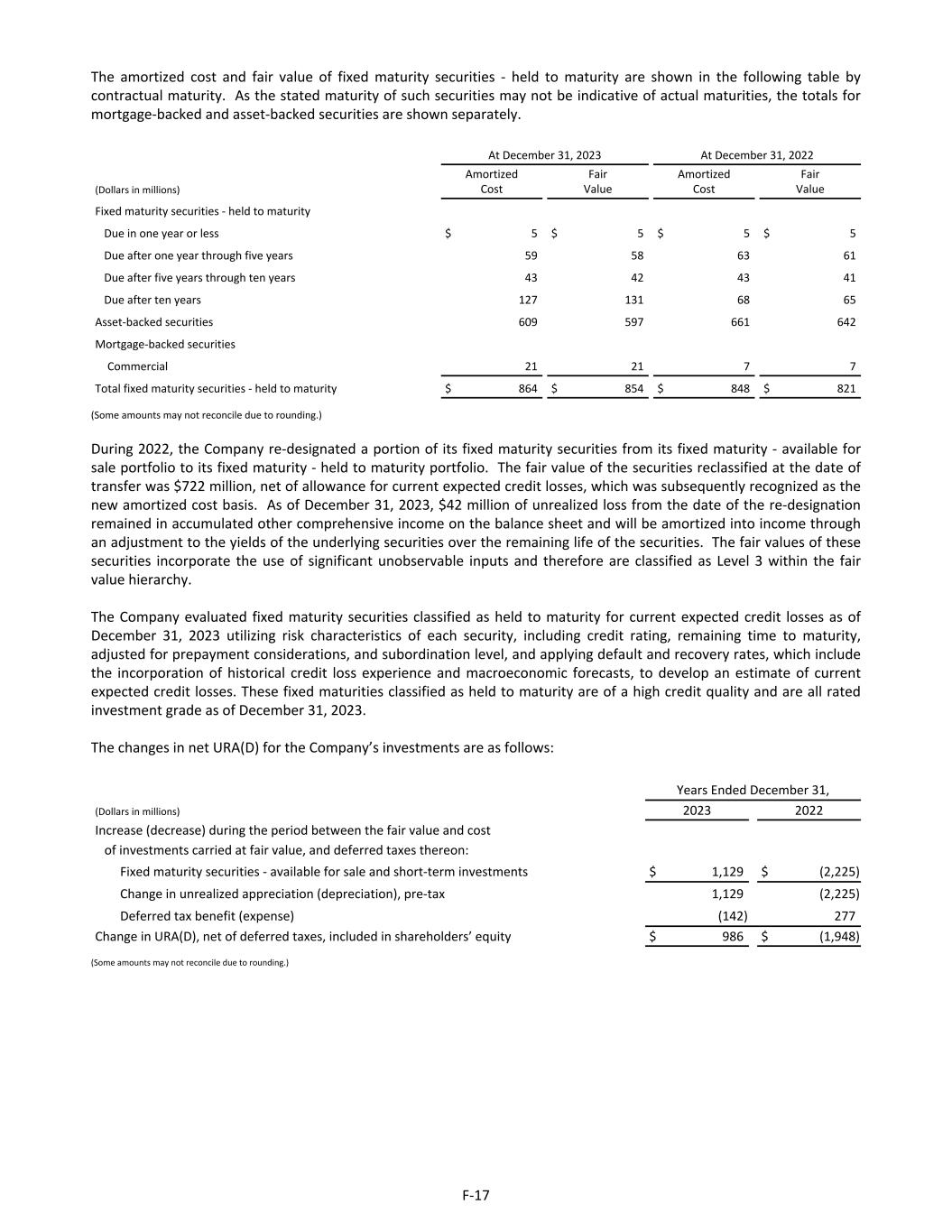
The amortized cost and fair value of fixed maturity securities - held to maturity are shown in the following table by contractual maturity. As the stated maturity of such securities may not be indicative of actual maturities, the totals for mortgage-backed and asset-backed securities are shown separately. At December 31, 2023 At December 31, 2022 (Dollars in millions) Amortized Cost Fair Value Amortized Cost Fair Value Fixed maturity securities - held to maturity Due in one year or less $ 5 $ 5 $ 5 $ 5 Due after one year through five years 59 58 63 61 Due after five years through ten years 43 42 43 41 Due after ten years 127 131 68 65 Asset-backed securities 609 597 661 642 Mortgage-backed securities Commercial 21 21 7 7 Total fixed maturity securities - held to maturity $ 864 $ 854 $ 848 $ 821 (Some amounts may not reconcile due to rounding.) During 2022, the Company re-designated a portion of its fixed maturity securities from its fixed maturity - available for sale portfolio to its fixed maturity - held to maturity portfolio. The fair value of the securities reclassified at the date of transfer was $722 million, net of allowance for current expected credit losses, which was subsequently recognized as the new amortized cost basis. As of December 31, 2023, $42 million of unrealized loss from the date of the re-designation remained in accumulated other comprehensive income on the balance sheet and will be amortized into income through an adjustment to the yields of the underlying securities over the remaining life of the securities. The fair values of these securities incorporate the use of significant unobservable inputs and therefore are classified as Level 3 within the fair value hierarchy. The Company evaluated fixed maturity securities classified as held to maturity for current expected credit losses as of December 31, 2023 utilizing risk characteristics of each security, including credit rating, remaining time to maturity, adjusted for prepayment considerations, and subordination level, and applying default and recovery rates, which include the incorporation of historical credit loss experience and macroeconomic forecasts, to develop an estimate of current expected credit losses. These fixed maturities classified as held to maturity are of a high credit quality and are all rated investment grade as of December 31, 2023. The changes in net URA(D) for the Company’s investments are as follows: Years Ended December 31, (Dollars in millions) 2023 2022 Increase (decrease) during the period between the fair value and cost of investments carried at fair value, and deferred taxes thereon: Fixed maturity securities - available for sale and short-term investments $ 1,129 $ (2,225) Change in unrealized appreciation (depreciation), pre-tax 1,129 (2,225) Deferred tax benefit (expense) (142) 277 Change in URA(D), net of deferred taxes, included in shareholders’ equity $ 986 $ (1,948) (Some amounts may not reconcile due to rounding.) F-17
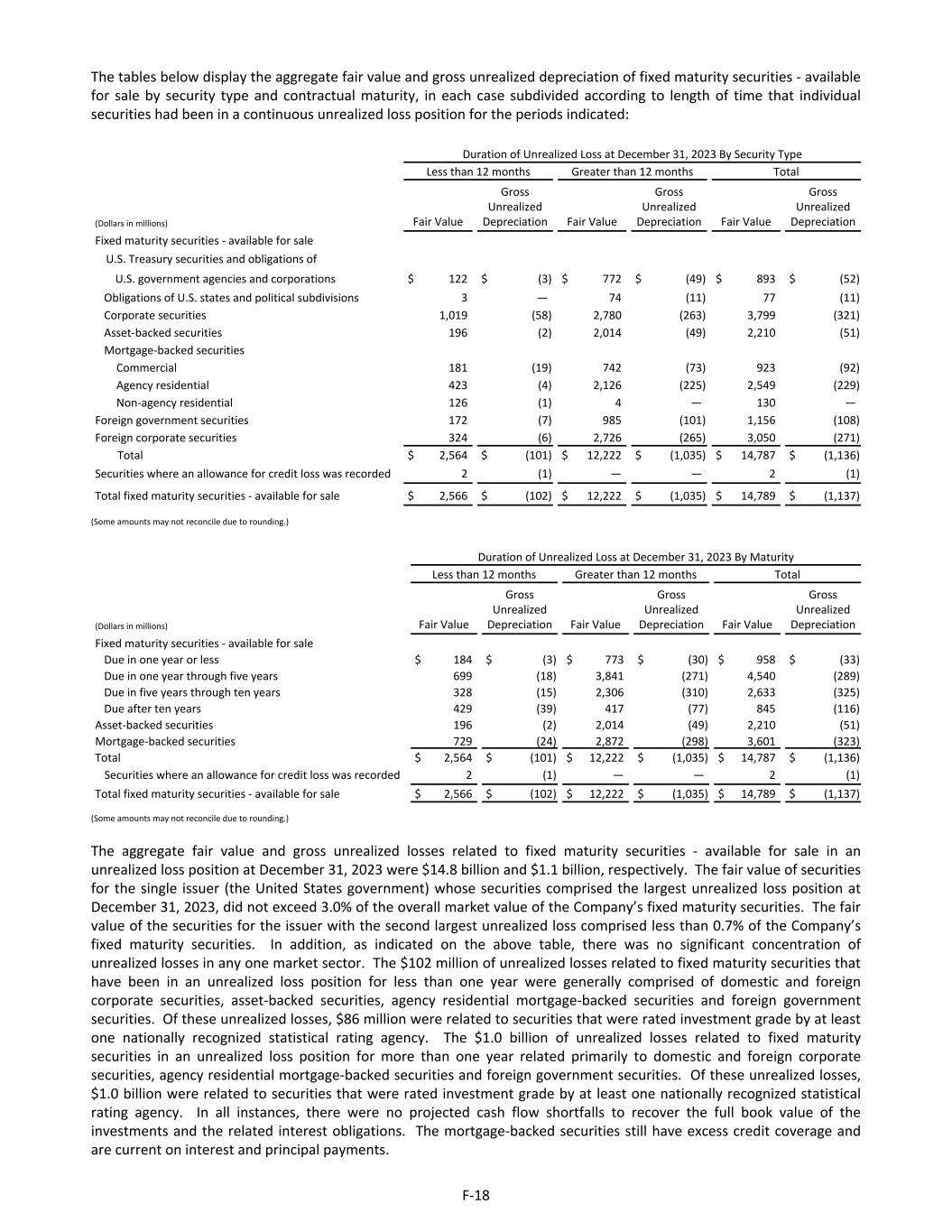
The tables below display the aggregate fair value and gross unrealized depreciation of fixed maturity securities - available for sale by security type and contractual maturity, in each case subdivided according to length of time that individual securities had been in a continuous unrealized loss position for the periods indicated: Duration of Unrealized Loss at December 31, 2023 By Security Type Less than 12 months Greater than 12 months Total (Dollars in millions) Fair Value Gross Unrealized Depreciation Fair Value Gross Unrealized Depreciation Fair Value Gross Unrealized Depreciation Fixed maturity securities - available for sale U.S. Treasury securities and obligations of U.S. government agencies and corporations $ 122 $ (3) $ 772 $ (49) $ 893 $ (52) Obligations of U.S. states and political subdivisions 3 — 74 (11) 77 (11) Corporate securities 1,019 (58) 2,780 (263) 3,799 (321) Asset-backed securities 196 (2) 2,014 (49) 2,210 (51) Mortgage-backed securities Commercial 181 (19) 742 (73) 923 (92) Agency residential 423 (4) 2,126 (225) 2,549 (229) Non-agency residential 126 (1) 4 — 130 — Foreign government securities 172 (7) 985 (101) 1,156 (108) Foreign corporate securities 324 (6) 2,726 (265) 3,050 (271) Total $ 2,564 $ (101) $ 12,222 $ (1,035) $ 14,787 $ (1,136) Securities where an allowance for credit loss was recorded 2 (1) — — 2 (1) Total fixed maturity securities - available for sale $ 2,566 $ (102) $ 12,222 $ (1,035) $ 14,789 $ (1,137) (Some amounts may not reconcile due to rounding.) Duration of Unrealized Loss at December 31, 2023 By Maturity Less than 12 months Greater than 12 months Total (Dollars in millions) Fair Value Gross Unrealized Depreciation Fair Value Gross Unrealized Depreciation Fair Value Gross Unrealized Depreciation Fixed maturity securities - available for sale Due in one year or less $ 184 $ (3) $ 773 $ (30) $ 958 $ (33) Due in one year through five years 699 (18) 3,841 (271) 4,540 (289) Due in five years through ten years 328 (15) 2,306 (310) 2,633 (325) Due after ten years 429 (39) 417 (77) 845 (116) Asset-backed securities 196 (2) 2,014 (49) 2,210 (51) Mortgage-backed securities 729 (24) 2,872 (298) 3,601 (323) Total $ 2,564 $ (101) $ 12,222 $ (1,035) $ 14,787 $ (1,136) Securities where an allowance for credit loss was recorded 2 (1) — — 2 (1) Total fixed maturity securities - available for sale $ 2,566 $ (102) $ 12,222 $ (1,035) $ 14,789 $ (1,137) (Some amounts may not reconcile due to rounding.) The aggregate fair value and gross unrealized losses related to fixed maturity securities - available for sale in an unrealized loss position at December 31, 2023 were $14.8 billion and $1.1 billion, respectively. The fair value of securities for the single issuer (the United States government) whose securities comprised the largest unrealized loss position at December 31, 2023, did not exceed 3.0% of the overall market value of the Company’s fixed maturity securities. The fair value of the securities for the issuer with the second largest unrealized loss comprised less than 0.7% of the Company’s fixed maturity securities. In addition, as indicated on the above table, there was no significant concentration of unrealized losses in any one market sector. The $102 million of unrealized losses related to fixed maturity securities that have been in an unrealized loss position for less than one year were generally comprised of domestic and foreign corporate securities, asset-backed securities, agency residential mortgage-backed securities and foreign government securities. Of these unrealized losses, $86 million were related to securities that were rated investment grade by at least one nationally recognized statistical rating agency. The $1.0 billion of unrealized losses related to fixed maturity securities in an unrealized loss position for more than one year related primarily to domestic and foreign corporate securities, agency residential mortgage-backed securities and foreign government securities. Of these unrealized losses, $1.0 billion were related to securities that were rated investment grade by at least one nationally recognized statistical rating agency. In all instances, there were no projected cash flow shortfalls to recover the full book value of the investments and the related interest obligations. The mortgage-backed securities still have excess credit coverage and are current on interest and principal payments. F-18
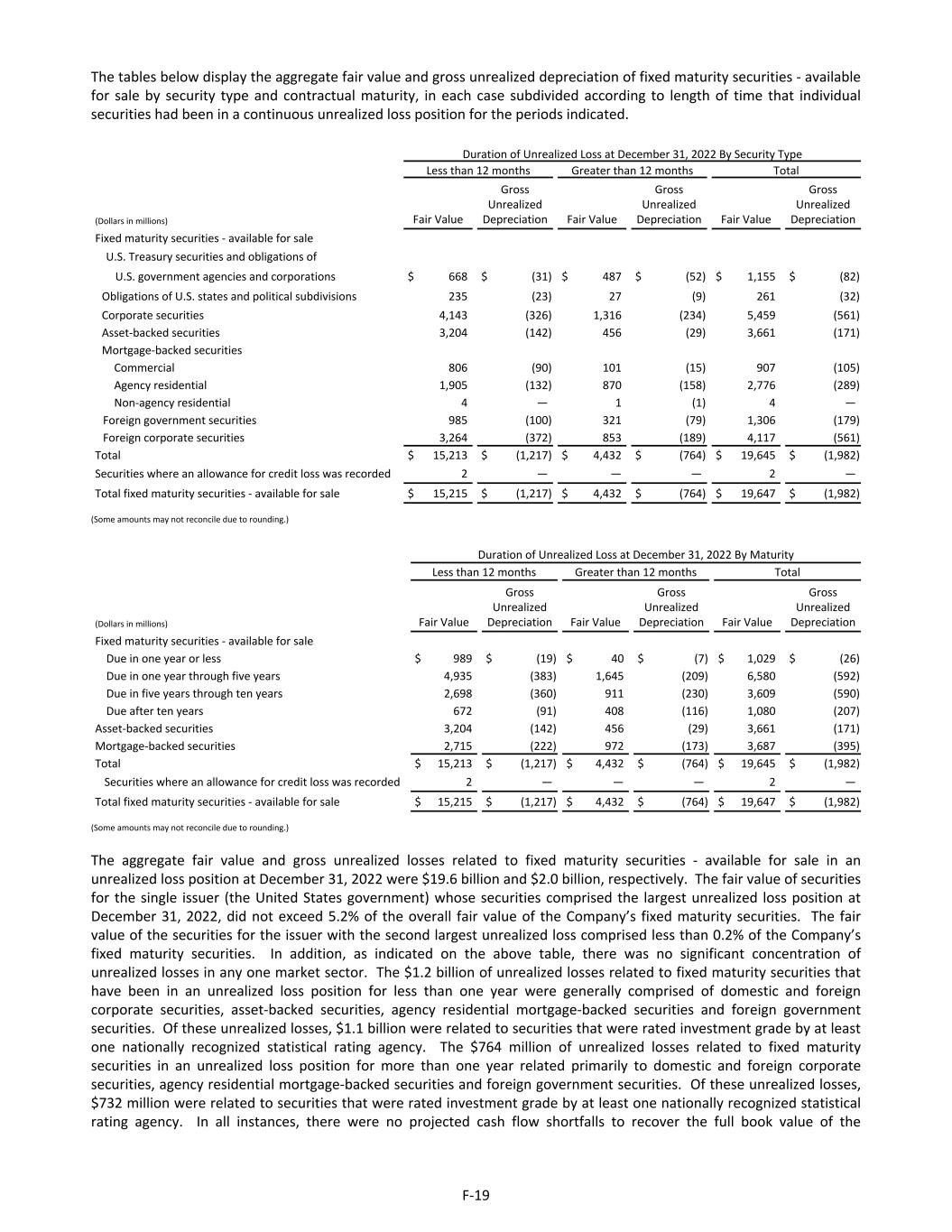
The tables below display the aggregate fair value and gross unrealized depreciation of fixed maturity securities - available for sale by security type and contractual maturity, in each case subdivided according to length of time that individual securities had been in a continuous unrealized loss position for the periods indicated. Duration of Unrealized Loss at December 31, 2022 By Security Type Less than 12 months Greater than 12 months Total (Dollars in millions) Fair Value Gross Unrealized Depreciation Fair Value Gross Unrealized Depreciation Fair Value Gross Unrealized Depreciation Fixed maturity securities - available for sale U.S. Treasury securities and obligations of U.S. government agencies and corporations $ 668 $ (31) $ 487 $ (52) $ 1,155 $ (82) Obligations of U.S. states and political subdivisions 235 (23) 27 (9) 261 (32) Corporate securities 4,143 (326) 1,316 (234) 5,459 (561) Asset-backed securities 3,204 (142) 456 (29) 3,661 (171) Mortgage-backed securities Commercial 806 (90) 101 (15) 907 (105) Agency residential 1,905 (132) 870 (158) 2,776 (289) Non-agency residential 4 — 1 (1) 4 — Foreign government securities 985 (100) 321 (79) 1,306 (179) Foreign corporate securities 3,264 (372) 853 (189) 4,117 (561) Total $ 15,213 $ (1,217) $ 4,432 $ (764) $ 19,645 $ (1,982) Securities where an allowance for credit loss was recorded 2 — — — 2 — Total fixed maturity securities - available for sale $ 15,215 $ (1,217) $ 4,432 $ (764) $ 19,647 $ (1,982) (Some amounts may not reconcile due to rounding.) Duration of Unrealized Loss at December 31, 2022 By Maturity Less than 12 months Greater than 12 months Total (Dollars in millions) Fair Value Gross Unrealized Depreciation Fair Value Gross Unrealized Depreciation Fair Value Gross Unrealized Depreciation Fixed maturity securities - available for sale Due in one year or less $ 989 $ (19) $ 40 $ (7) $ 1,029 $ (26) Due in one year through five years 4,935 (383) 1,645 (209) 6,580 (592) Due in five years through ten years 2,698 (360) 911 (230) 3,609 (590) Due after ten years 672 (91) 408 (116) 1,080 (207) Asset-backed securities 3,204 (142) 456 (29) 3,661 (171) Mortgage-backed securities 2,715 (222) 972 (173) 3,687 (395) Total $ 15,213 $ (1,217) $ 4,432 $ (764) $ 19,645 $ (1,982) Securities where an allowance for credit loss was recorded 2 — — — 2 — Total fixed maturity securities - available for sale $ 15,215 $ (1,217) $ 4,432 $ (764) $ 19,647 $ (1,982) (Some amounts may not reconcile due to rounding.) The aggregate fair value and gross unrealized losses related to fixed maturity securities - available for sale in an unrealized loss position at December 31, 2022 were $19.6 billion and $2.0 billion, respectively. The fair value of securities for the single issuer (the United States government) whose securities comprised the largest unrealized loss position at December 31, 2022, did not exceed 5.2% of the overall fair value of the Company’s fixed maturity securities. The fair value of the securities for the issuer with the second largest unrealized loss comprised less than 0.2% of the Company’s fixed maturity securities. In addition, as indicated on the above table, there was no significant concentration of unrealized losses in any one market sector. The $1.2 billion of unrealized losses related to fixed maturity securities that have been in an unrealized loss position for less than one year were generally comprised of domestic and foreign corporate securities, asset-backed securities, agency residential mortgage-backed securities and foreign government securities. Of these unrealized losses, $1.1 billion were related to securities that were rated investment grade by at least one nationally recognized statistical rating agency. The $764 million of unrealized losses related to fixed maturity securities in an unrealized loss position for more than one year related primarily to domestic and foreign corporate securities, agency residential mortgage-backed securities and foreign government securities. Of these unrealized losses, $732 million were related to securities that were rated investment grade by at least one nationally recognized statistical rating agency. In all instances, there were no projected cash flow shortfalls to recover the full book value of the F-19
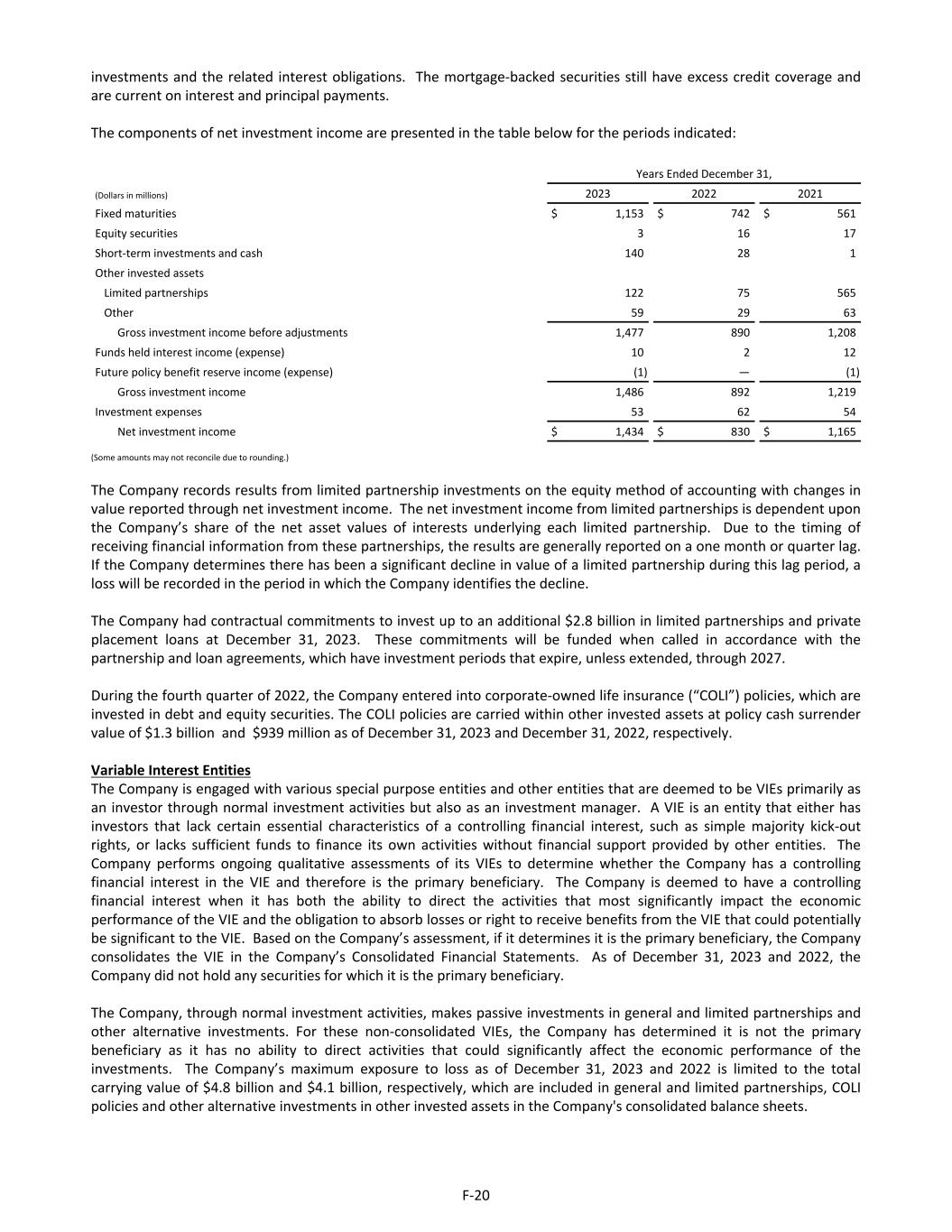
investments and the related interest obligations. The mortgage-backed securities still have excess credit coverage and are current on interest and principal payments. The components of net investment income are presented in the table below for the periods indicated: Years Ended December 31, (Dollars in millions) 2023 2022 2021 Fixed maturities $ 1,153 $ 742 $ 561 Equity securities 3 16 17 Short-term investments and cash 140 28 1 Other invested assets Limited partnerships 122 75 565 Other 59 29 63 Gross investment income before adjustments 1,477 890 1,208 Funds held interest income (expense) 10 2 12 Future policy benefit reserve income (expense) (1) — (1) Gross investment income 1,486 892 1,219 Investment expenses 53 62 54 Net investment income $ 1,434 $ 830 $ 1,165 (Some amounts may not reconcile due to rounding.) The Company records results from limited partnership investments on the equity method of accounting with changes in value reported through net investment income. The net investment income from limited partnerships is dependent upon the Company’s share of the net asset values of interests underlying each limited partnership. Due to the timing of receiving financial information from these partnerships, the results are generally reported on a one month or quarter lag. If the Company determines there has been a significant decline in value of a limited partnership during this lag period, a loss will be recorded in the period in which the Company identifies the decline. The Company had contractual commitments to invest up to an additional $2.8 billion in limited partnerships and private placement loans at December 31, 2023. These commitments will be funded when called in accordance with the partnership and loan agreements, which have investment periods that expire, unless extended, through 2027. During the fourth quarter of 2022, the Company entered into corporate-owned life insurance (“COLI”) policies, which are invested in debt and equity securities. The COLI policies are carried within other invested assets at policy cash surrender value of $1.3 billion and $939 million as of December 31, 2023 and December 31, 2022, respectively. Variable Interest Entities The Company is engaged with various special purpose entities and other entities that are deemed to be VIEs primarily as an investor through normal investment activities but also as an investment manager. A VIE is an entity that either has investors that lack certain essential characteristics of a controlling financial interest, such as simple majority kick-out rights, or lacks sufficient funds to finance its own activities without financial support provided by other entities. The Company performs ongoing qualitative assessments of its VIEs to determine whether the Company has a controlling financial interest in the VIE and therefore is the primary beneficiary. The Company is deemed to have a controlling financial interest when it has both the ability to direct the activities that most significantly impact the economic performance of the VIE and the obligation to absorb losses or right to receive benefits from the VIE that could potentially be significant to the VIE. Based on the Company’s assessment, if it determines it is the primary beneficiary, the Company consolidates the VIE in the Company’s Consolidated Financial Statements. As of December 31, 2023 and 2022, the Company did not hold any securities for which it is the primary beneficiary. The Company, through normal investment activities, makes passive investments in general and limited partnerships and other alternative investments. For these non-consolidated VIEs, the Company has determined it is not the primary beneficiary as it has no ability to direct activities that could significantly affect the economic performance of the investments. The Company’s maximum exposure to loss as of December 31, 2023 and 2022 is limited to the total carrying value of $4.8 billion and $4.1 billion, respectively, which are included in general and limited partnerships, COLI policies and other alternative investments in other invested assets in the Company's consolidated balance sheets. F-20
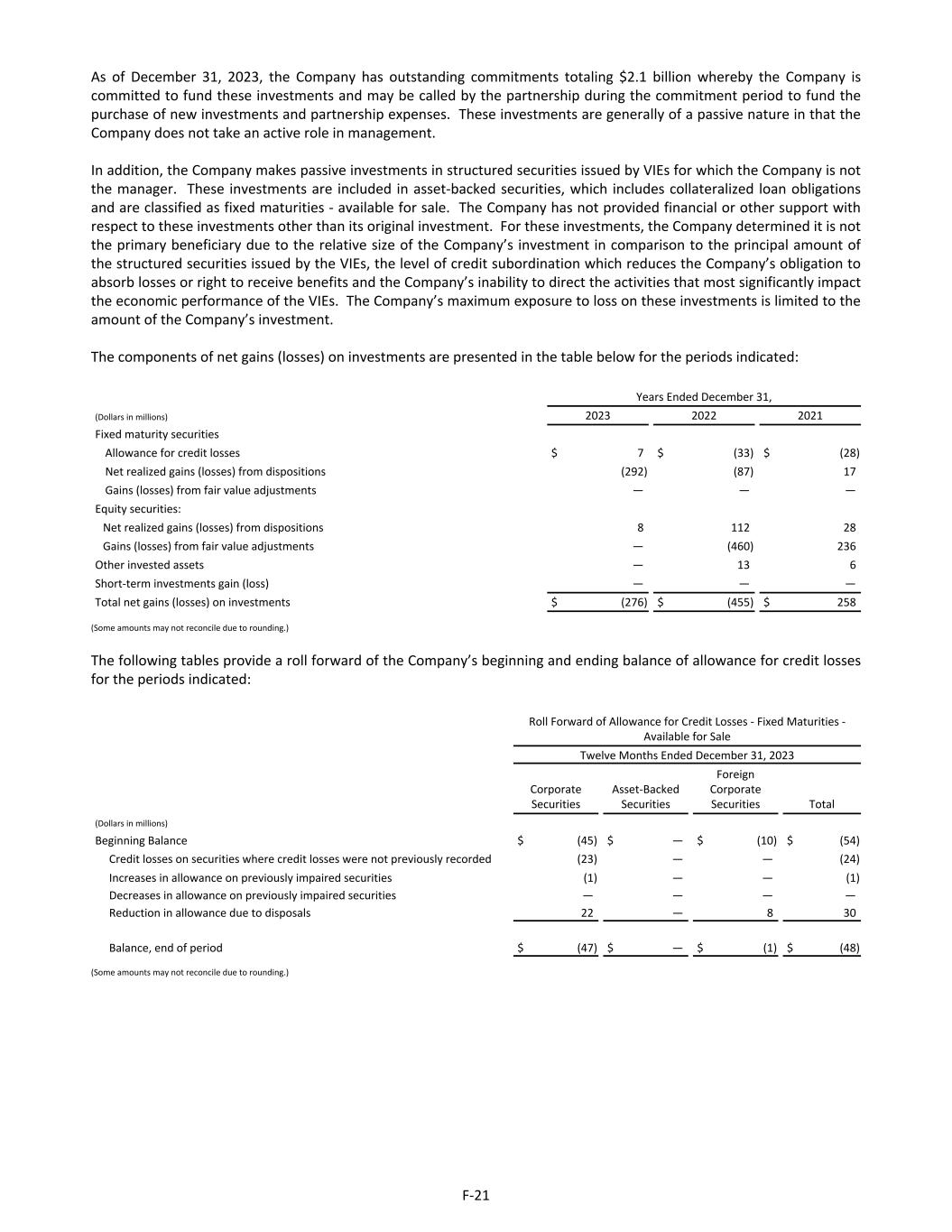
As of December 31, 2023, the Company has outstanding commitments totaling $2.1 billion whereby the Company is committed to fund these investments and may be called by the partnership during the commitment period to fund the purchase of new investments and partnership expenses. These investments are generally of a passive nature in that the Company does not take an active role in management. In addition, the Company makes passive investments in structured securities issued by VIEs for which the Company is not the manager. These investments are included in asset-backed securities, which includes collateralized loan obligations and are classified as fixed maturities - available for sale. The Company has not provided financial or other support with respect to these investments other than its original investment. For these investments, the Company determined it is not the primary beneficiary due to the relative size of the Company’s investment in comparison to the principal amount of the structured securities issued by the VIEs, the level of credit subordination which reduces the Company’s obligation to absorb losses or right to receive benefits and the Company’s inability to direct the activities that most significantly impact the economic performance of the VIEs. The Company’s maximum exposure to loss on these investments is limited to the amount of the Company’s investment. The components of net gains (losses) on investments are presented in the table below for the periods indicated: Years Ended December 31, (Dollars in millions) 2023 2022 2021 Fixed maturity securities Allowance for credit losses $ 7 $ (33) $ (28) Net realized gains (losses) from dispositions (292) (87) 17 Gains (losses) from fair value adjustments — — — Equity securities: Net realized gains (losses) from dispositions 8 112 28 Gains (losses) from fair value adjustments — (460) 236 Other invested assets — 13 6 Short-term investments gain (loss) — — — Total net gains (losses) on investments $ (276) $ (455) $ 258 (Some amounts may not reconcile due to rounding.) The following tables provide a roll forward of the Company’s beginning and ending balance of allowance for credit losses for the periods indicated: Roll Forward of Allowance for Credit Losses - Fixed Maturities - Available for Sale Twelve Months Ended December 31, 2023 Corporate Securities Asset-Backed Securities Foreign Corporate Securities Total (Dollars in millions) Beginning Balance $ (45) $ — $ (10) $ (54) Credit losses on securities where credit losses were not previously recorded (23) — — (24) Increases in allowance on previously impaired securities (1) — — (1) Decreases in allowance on previously impaired securities — — — — Reduction in allowance due to disposals 22 — 8 30 Balance, end of period $ (47) $ — $ (1) $ (48) (Some amounts may not reconcile due to rounding.) F-21
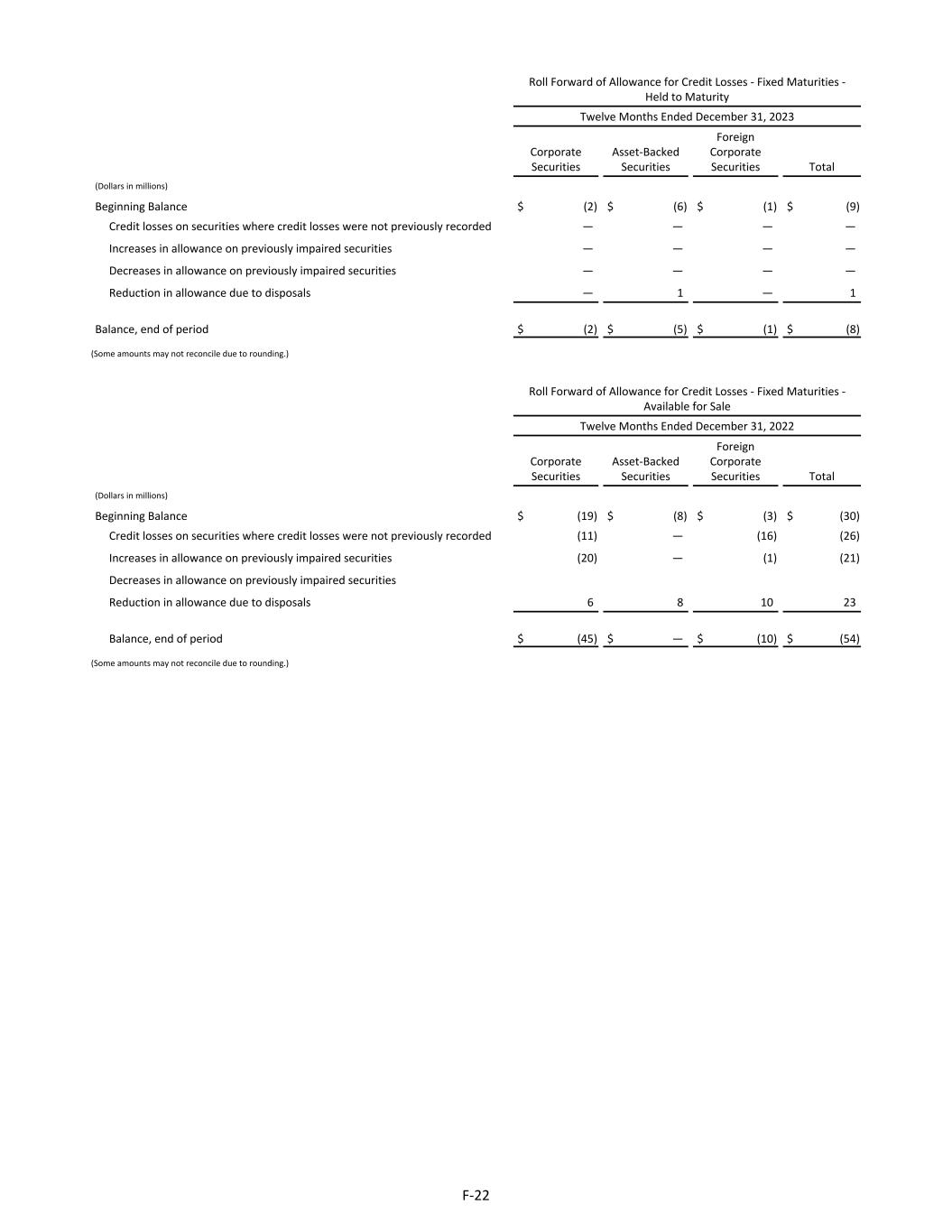
Roll Forward of Allowance for Credit Losses - Fixed Maturities - Held to Maturity Twelve Months Ended December 31, 2023 Corporate Securities Asset-Backed Securities Foreign Corporate Securities Total (Dollars in millions) Beginning Balance $ (2) $ (6) $ (1) $ (9) Credit losses on securities where credit losses were not previously recorded — — — — Increases in allowance on previously impaired securities — — — — Decreases in allowance on previously impaired securities — — — — Reduction in allowance due to disposals — 1 — 1 Balance, end of period $ (2) $ (5) $ (1) $ (8) (Some amounts may not reconcile due to rounding.) Roll Forward of Allowance for Credit Losses - Fixed Maturities - Available for Sale Twelve Months Ended December 31, 2022 Corporate Securities Asset-Backed Securities Foreign Corporate Securities Total (Dollars in millions) Beginning Balance $ (19) $ (8) $ (3) $ (30) Credit losses on securities where credit losses were not previously recorded (11) — (16) (26) Increases in allowance on previously impaired securities (20) — (1) (21) Decreases in allowance on previously impaired securities Reduction in allowance due to disposals 6 8 10 23 Balance, end of period $ (45) $ — $ (10) $ (54) (Some amounts may not reconcile due to rounding.) F-22
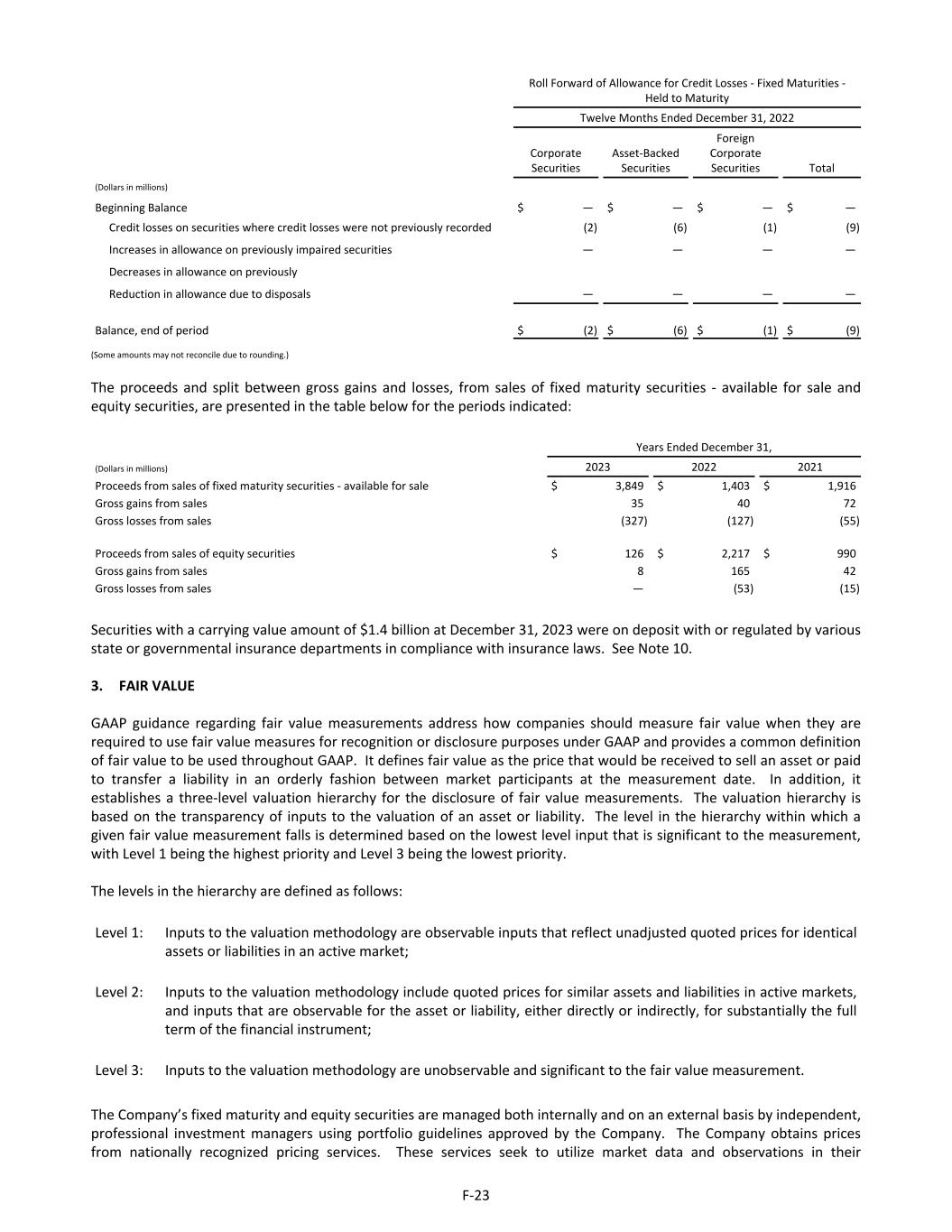
Roll Forward of Allowance for Credit Losses - Fixed Maturities - Held to Maturity Twelve Months Ended December 31, 2022 Corporate Securities Asset-Backed Securities Foreign Corporate Securities Total (Dollars in millions) Beginning Balance $ — $ — $ — $ — Credit losses on securities where credit losses were not previously recorded (2) (6) (1) (9) Increases in allowance on previously impaired securities — — — — Decreases in allowance on previously Reduction in allowance due to disposals — — — — Balance, end of period $ (2) $ (6) $ (1) $ (9) (Some amounts may not reconcile due to rounding.) The proceeds and split between gross gains and losses, from sales of fixed maturity securities - available for sale and equity securities, are presented in the table below for the periods indicated: Years Ended December 31, (Dollars in millions) 2023 2022 2021 Proceeds from sales of fixed maturity securities - available for sale $ 3,849 $ 1,403 $ 1,916 Gross gains from sales 35 40 72 Gross losses from sales (327) (127) (55) Proceeds from sales of equity securities $ 126 $ 2,217 $ 990 Gross gains from sales 8 165 42 Gross losses from sales — (53) (15) Securities with a carrying value amount of $1.4 billion at December 31, 2023 were on deposit with or regulated by various state or governmental insurance departments in compliance with insurance laws. See Note 10. 3. FAIR VALUE GAAP guidance regarding fair value measurements address how companies should measure fair value when they are required to use fair value measures for recognition or disclosure purposes under GAAP and provides a common definition of fair value to be used throughout GAAP. It defines fair value as the price that would be received to sell an asset or paid to transfer a liability in an orderly fashion between market participants at the measurement date. In addition, it establishes a three-level valuation hierarchy for the disclosure of fair value measurements. The valuation hierarchy is based on the transparency of inputs to the valuation of an asset or liability. The level in the hierarchy within which a given fair value measurement falls is determined based on the lowest level input that is significant to the measurement, with Level 1 being the highest priority and Level 3 being the lowest priority. The levels in the hierarchy are defined as follows: Level 1: Inputs to the valuation methodology are observable inputs that reflect unadjusted quoted prices for identical assets or liabilities in an active market; Level 2: Inputs to the valuation methodology include quoted prices for similar assets and liabilities in active markets, and inputs that are observable for the asset or liability, either directly or indirectly, for substantially the full term of the financial instrument; Level 3: Inputs to the valuation methodology are unobservable and significant to the fair value measurement. The Company’s fixed maturity and equity securities are managed both internally and on an external basis by independent, professional investment managers using portfolio guidelines approved by the Company. The Company obtains prices from nationally recognized pricing services. These services seek to utilize market data and observations in their F-23
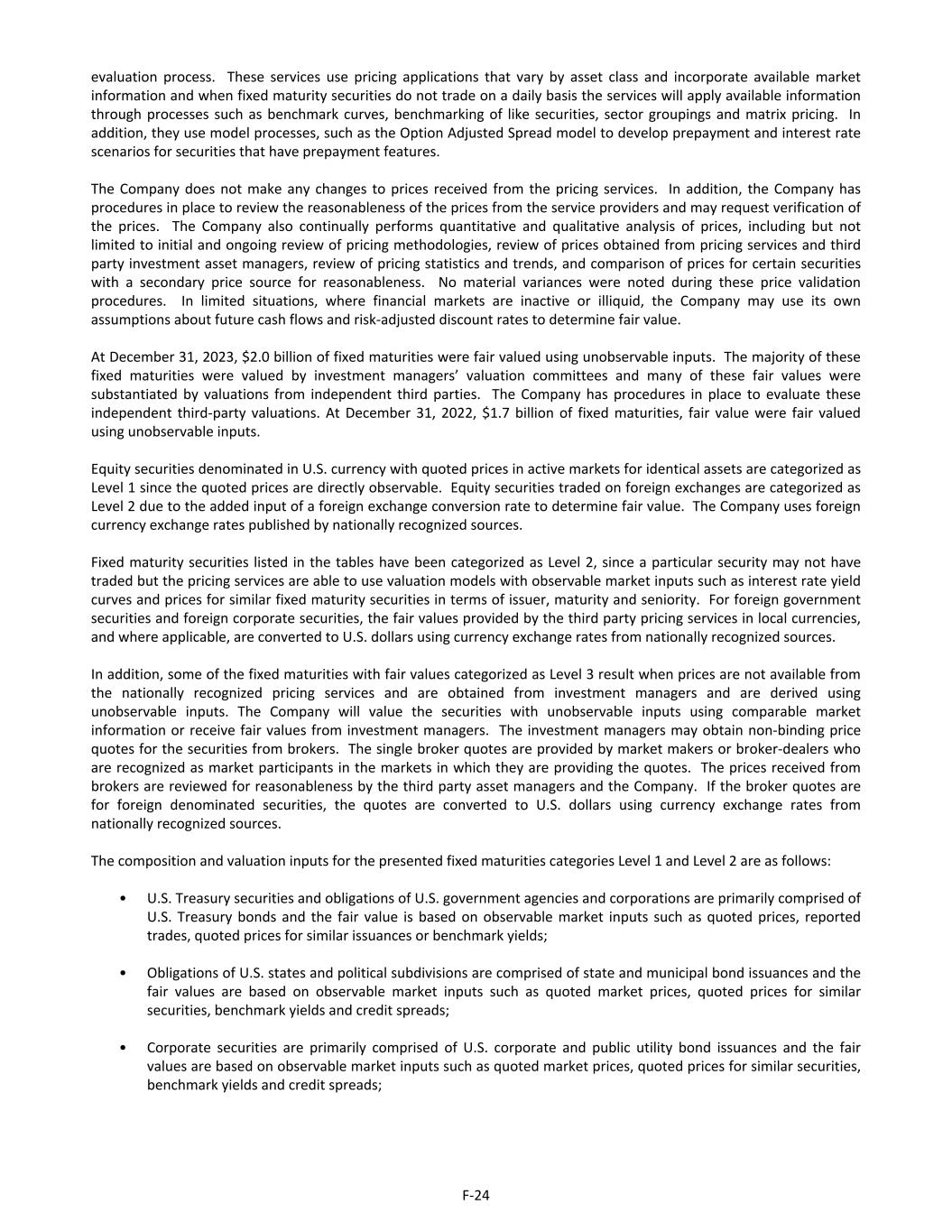
evaluation process. These services use pricing applications that vary by asset class and incorporate available market information and when fixed maturity securities do not trade on a daily basis the services will apply available information through processes such as benchmark curves, benchmarking of like securities, sector groupings and matrix pricing. In addition, they use model processes, such as the Option Adjusted Spread model to develop prepayment and interest rate scenarios for securities that have prepayment features. The Company does not make any changes to prices received from the pricing services. In addition, the Company has procedures in place to review the reasonableness of the prices from the service providers and may request verification of the prices. The Company also continually performs quantitative and qualitative analysis of prices, including but not limited to initial and ongoing review of pricing methodologies, review of prices obtained from pricing services and third party investment asset managers, review of pricing statistics and trends, and comparison of prices for certain securities with a secondary price source for reasonableness. No material variances were noted during these price validation procedures. In limited situations, where financial markets are inactive or illiquid, the Company may use its own assumptions about future cash flows and risk-adjusted discount rates to determine fair value. At December 31, 2023, $2.0 billion of fixed maturities were fair valued using unobservable inputs. The majority of these fixed maturities were valued by investment managers’ valuation committees and many of these fair values were substantiated by valuations from independent third parties. The Company has procedures in place to evaluate these independent third-party valuations. At December 31, 2022, $1.7 billion of fixed maturities, fair value were fair valued using unobservable inputs. Equity securities denominated in U.S. currency with quoted prices in active markets for identical assets are categorized as Level 1 since the quoted prices are directly observable. Equity securities traded on foreign exchanges are categorized as Level 2 due to the added input of a foreign exchange conversion rate to determine fair value. The Company uses foreign currency exchange rates published by nationally recognized sources. Fixed maturity securities listed in the tables have been categorized as Level 2, since a particular security may not have traded but the pricing services are able to use valuation models with observable market inputs such as interest rate yield curves and prices for similar fixed maturity securities in terms of issuer, maturity and seniority. For foreign government securities and foreign corporate securities, the fair values provided by the third party pricing services in local currencies, and where applicable, are converted to U.S. dollars using currency exchange rates from nationally recognized sources. In addition, some of the fixed maturities with fair values categorized as Level 3 result when prices are not available from the nationally recognized pricing services and are obtained from investment managers and are derived using unobservable inputs. The Company will value the securities with unobservable inputs using comparable market information or receive fair values from investment managers. The investment managers may obtain non-binding price quotes for the securities from brokers. The single broker quotes are provided by market makers or broker-dealers who are recognized as market participants in the markets in which they are providing the quotes. The prices received from brokers are reviewed for reasonableness by the third party asset managers and the Company. If the broker quotes are for foreign denominated securities, the quotes are converted to U.S. dollars using currency exchange rates from nationally recognized sources. The composition and valuation inputs for the presented fixed maturities categories Level 1 and Level 2 are as follows: • U.S. Treasury securities and obligations of U.S. government agencies and corporations are primarily comprised of U.S. Treasury bonds and the fair value is based on observable market inputs such as quoted prices, reported trades, quoted prices for similar issuances or benchmark yields; • Obligations of U.S. states and political subdivisions are comprised of state and municipal bond issuances and the fair values are based on observable market inputs such as quoted market prices, quoted prices for similar securities, benchmark yields and credit spreads; • Corporate securities are primarily comprised of U.S. corporate and public utility bond issuances and the fair values are based on observable market inputs such as quoted market prices, quoted prices for similar securities, benchmark yields and credit spreads; F-24
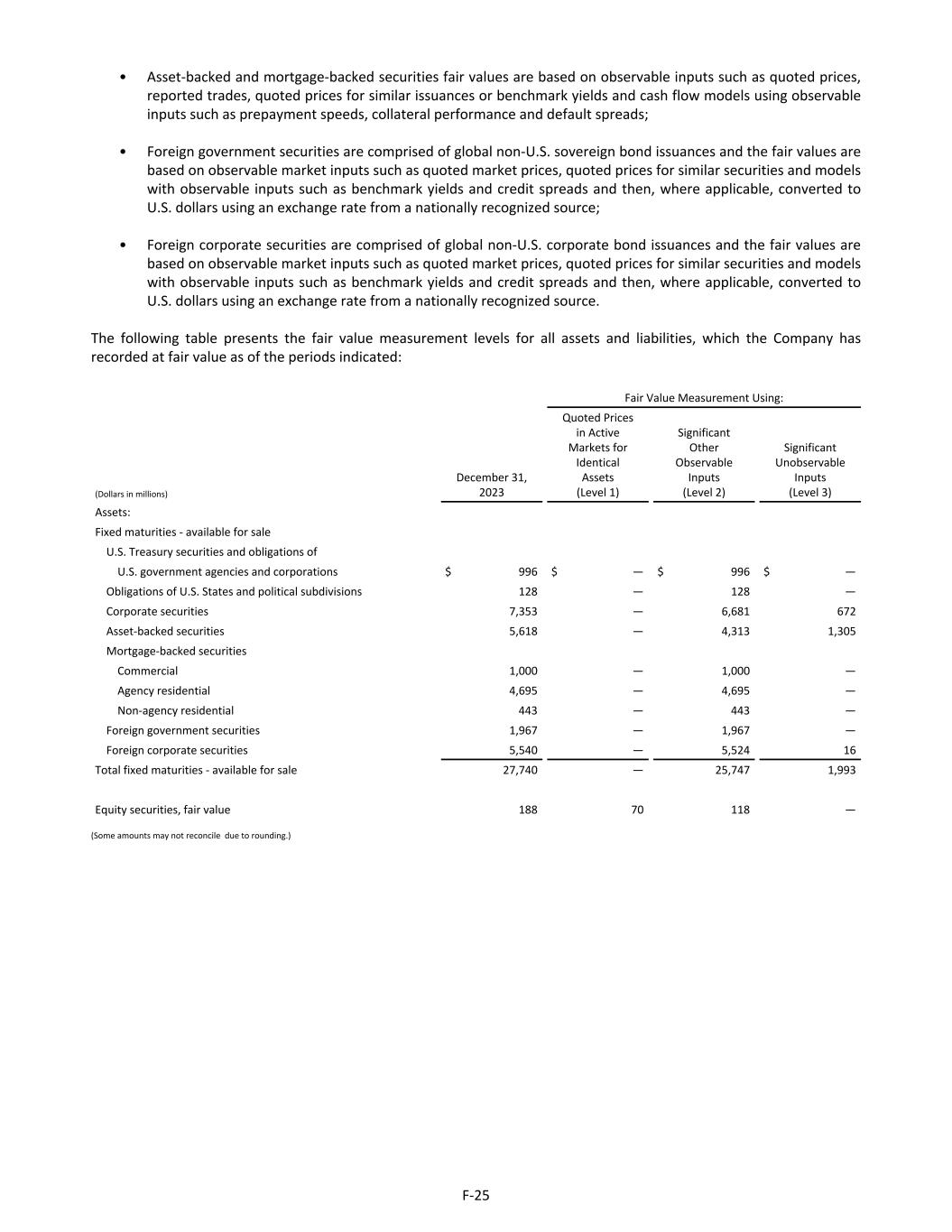
• Asset-backed and mortgage-backed securities fair values are based on observable inputs such as quoted prices, reported trades, quoted prices for similar issuances or benchmark yields and cash flow models using observable inputs such as prepayment speeds, collateral performance and default spreads; • Foreign government securities are comprised of global non-U.S. sovereign bond issuances and the fair values are based on observable market inputs such as quoted market prices, quoted prices for similar securities and models with observable inputs such as benchmark yields and credit spreads and then, where applicable, converted to U.S. dollars using an exchange rate from a nationally recognized source; • Foreign corporate securities are comprised of global non-U.S. corporate bond issuances and the fair values are based on observable market inputs such as quoted market prices, quoted prices for similar securities and models with observable inputs such as benchmark yields and credit spreads and then, where applicable, converted to U.S. dollars using an exchange rate from a nationally recognized source. The following table presents the fair value measurement levels for all assets and liabilities, which the Company has recorded at fair value as of the periods indicated: Fair Value Measurement Using: (Dollars in millions) December 31, 2023 Quoted Prices in Active Markets for Identical Assets (Level 1) Significant Other Observable Inputs (Level 2) Significant Unobservable Inputs (Level 3) Assets: Fixed maturities - available for sale U.S. Treasury securities and obligations of U.S. government agencies and corporations $ 996 $ — $ 996 $ — Obligations of U.S. States and political subdivisions 128 — 128 — Corporate securities 7,353 — 6,681 672 Asset-backed securities 5,618 — 4,313 1,305 Mortgage-backed securities Commercial 1,000 — 1,000 — Agency residential 4,695 — 4,695 — Non-agency residential 443 — 443 — Foreign government securities 1,967 — 1,967 — Foreign corporate securities 5,540 — 5,524 16 Total fixed maturities - available for sale 27,740 — 25,747 1,993 Equity securities, fair value 188 70 118 — (Some amounts may not reconcile due to rounding.) F-25

The following table presents the fair value measurement levels for all assets and liabilities, which the Company has recorded at fair value as of the periods indicated: Fair Value Measurement Using: (Dollars in millions) December 31, 2022 Quoted Prices in Active Markets for Identical Assets (Level 1) Significant Other Observable Inputs (Level 2) Significant Unobservable Inputs (Level 3) Assets: Fixed maturities - available for sale U.S. Treasury securities and obligations of U.S. government agencies and corporations $ 1,257 $ — $ 1,257 $ — Obligations of U.S. States and political subdivisions 413 — 413 — Corporate securities 6,469 — 5,754 715 Asset-backed securities 4,063 — 3,069 994 Mortgage-backed securities Commercial 919 — 919 — Agency residential 3,099 — 3,099 — Non-agency residential 4 — 4 — Foreign government securities 1,415 — 1,415 — Foreign corporate securities 4,596 — 4,579 16 Total fixed maturities - available for sale 22,236 — 20,511 1,725 Equity securities, fair value 281 132 150 — (Some amounts may not reconcile due to rounding.) The following table presents the activity under Level 3, fair value measurements using significant unobservable inputs for fixed maturities - available for sale, for the periods indicated: Total Fixed Maturities - Available for Sale December 31, 2023 December 31, 2022 (Dollars in millions) Corporate Securities Asset- Backed Securities CMBS Foreign Corporate Total Corporate Securities Asset- Backed Securities CMBS Foreign Corporate Total Beginning balance fixed maturities $ 715 $ 994 $ — $ 16 $ 1,725 $ 801 $ 1,251 $ — $ 16 $ 2,068 Total gains or (losses) (realized/unrealized) Included in earnings (or changes in net assets) 4 — — — 4 (10) — — — (10) Included in other comprehensive income (loss) (2) 6 — — 4 3 (35) — (4) (36) Purchases, issuances and settlements (45) 305 — — 260 (45) 513 6 8 481 Transfers in and/or (out) of Level 3 — — — — — (35) (735) (6) (4) (779) Ending balance $ 672 $ 1,305 $ — $ 16 $ 1,993 $ 715 $ 994 $ — $ 16 $ 1,725 The amount of total gains or losses for the period included in earnings (or changes in net assets) attributable to the change in unrealized gains or losses relating to assets still held at the reporting date $ 9 $ — $ — $ — $ 9 $ (23) $ 8 $ — $ — $ (15) (Some amounts may not reconcile due to rounding.) There were no transfers of assets in/(out) of Level 3 during 2023. The $779 million shown as transfers in/(out) of Level 3 and reclassification of securities in/(out) of investment categories for the year ended December 31, 2022 related mainly to previously designated Level 3 securities that the Company had reclassified from “fixed maturities - available for sale” to “fixed maturities - held to maturity” during 2022. As “fixed maturities - held to maturity" are carried at amortized cost, net of credit allowances rather than at fair value as “fixed maturities - available for sale”, these securities are no longer included within the fair value hierarchy table or in the roll forward of Level 3 securities. The fair values of these securities are determined in a similar manner as the Company’s F-26
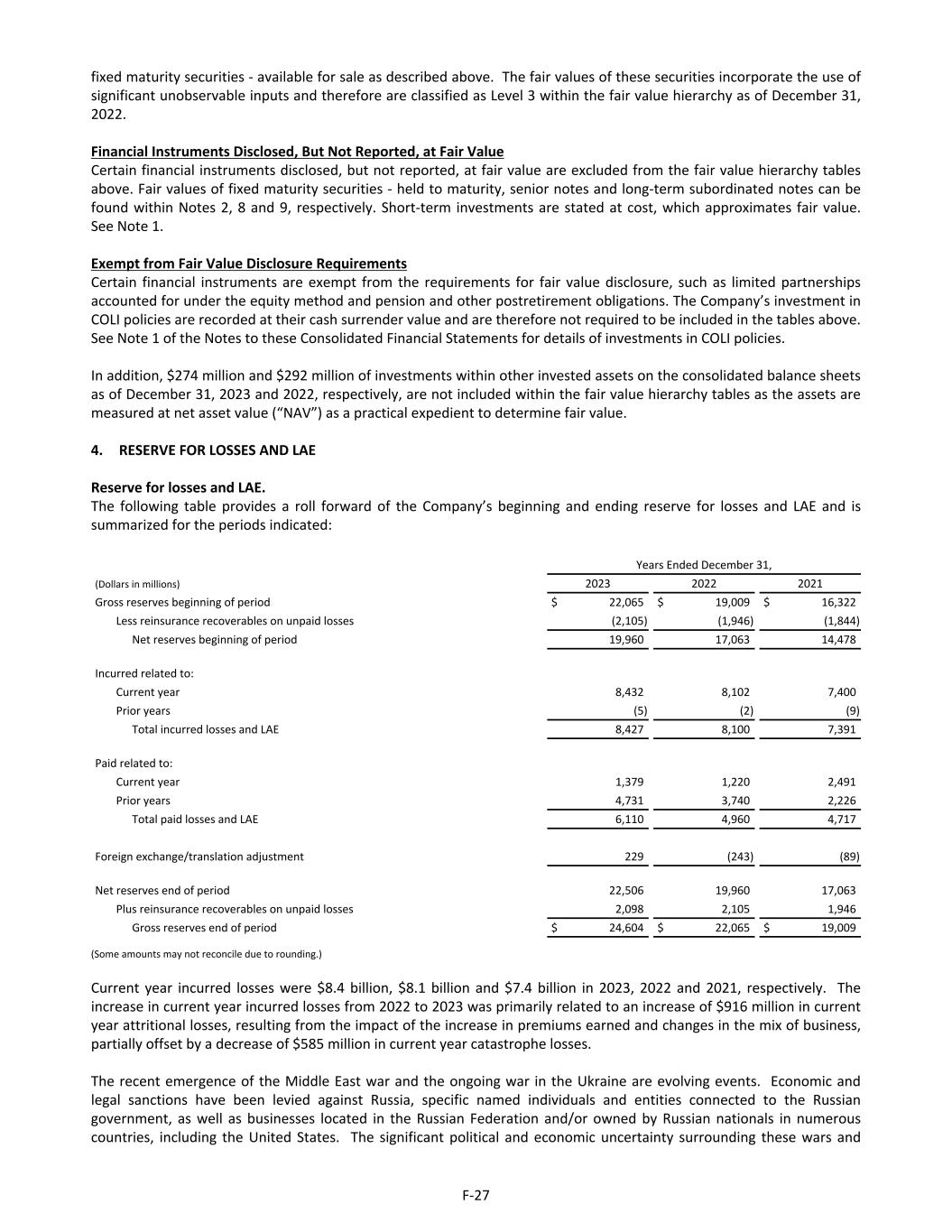
fixed maturity securities - available for sale as described above. The fair values of these securities incorporate the use of significant unobservable inputs and therefore are classified as Level 3 within the fair value hierarchy as of December 31, 2022. Financial Instruments Disclosed, But Not Reported, at Fair Value Certain financial instruments disclosed, but not reported, at fair value are excluded from the fair value hierarchy tables above. Fair values of fixed maturity securities - held to maturity, senior notes and long-term subordinated notes can be found within Notes 2, 8 and 9, respectively. Short-term investments are stated at cost, which approximates fair value. See Note 1. Exempt from Fair Value Disclosure Requirements Certain financial instruments are exempt from the requirements for fair value disclosure, such as limited partnerships accounted for under the equity method and pension and other postretirement obligations. The Company’s investment in COLI policies are recorded at their cash surrender value and are therefore not required to be included in the tables above. See Note 1 of the Notes to these Consolidated Financial Statements for details of investments in COLI policies. In addition, $274 million and $292 million of investments within other invested assets on the consolidated balance sheets as of December 31, 2023 and 2022, respectively, are not included within the fair value hierarchy tables as the assets are measured at net asset value (“NAV”) as a practical expedient to determine fair value. 4. RESERVE FOR LOSSES AND LAE Reserve for losses and LAE. The following table provides a roll forward of the Company’s beginning and ending reserve for losses and LAE and is summarized for the periods indicated: Years Ended December 31, (Dollars in millions) 2023 2022 2021 Gross reserves beginning of period $ 22,065 $ 19,009 $ 16,322 Less reinsurance recoverables on unpaid losses (2,105) (1,946) (1,844) Net reserves beginning of period 19,960 17,063 14,478 Incurred related to: Current year 8,432 8,102 7,400 Prior years (5) (2) (9) Total incurred losses and LAE 8,427 8,100 7,391 Paid related to: Current year 1,379 1,220 2,491 Prior years 4,731 3,740 2,226 Total paid losses and LAE 6,110 4,960 4,717 Foreign exchange/translation adjustment 229 (243) (89) Net reserves end of period 22,506 19,960 17,063 Plus reinsurance recoverables on unpaid losses 2,098 2,105 1,946 Gross reserves end of period $ 24,604 $ 22,065 $ 19,009 (Some amounts may not reconcile due to rounding.) Current year incurred losses were $8.4 billion, $8.1 billion and $7.4 billion in 2023, 2022 and 2021, respectively. The increase in current year incurred losses from 2022 to 2023 was primarily related to an increase of $916 million in current year attritional losses, resulting from the impact of the increase in premiums earned and changes in the mix of business, partially offset by a decrease of $585 million in current year catastrophe losses. The recent emergence of the Middle East war and the ongoing war in the Ukraine are evolving events. Economic and legal sanctions have been levied against Russia, specific named individuals and entities connected to the Russian government, as well as businesses located in the Russian Federation and/or owned by Russian nationals in numerous countries, including the United States. The significant political and economic uncertainty surrounding these wars and F-27

associated sanctions have impacted economic and investment markets both within Russia, Ukraine, the Middle East region, and around the world. Gross and net reserves increased in 2022, reflecting an increase in underlying exposure due to earned premium growth, year over year, the impact of $45 million of incurred losses related to the Ukraine/Russia war, partially offset by a decrease of $80 million in 2022 current year catastrophe losses compared to 2021. Incurred prior years favorable development in losses were $5 million in 2023, $2 million in 2022 and $9 million in 2021. The net favorable development on prior year reserves of $5 million in 2023 is comprised of $397 million of favorable development on prior years attritional losses for reinsurance lines, mainly related to mortgage and short-tail lines of business, mostly offset by $392 million of unfavorable development on prior years attritional losses for insurance lines, mainly related to casualty lines for accident years from 2016 through 2019. The favorable development on prior year reserves of $2 million in 2022 is primarily driven by better than expected loss emergence in workers’ compensation and surety lines of business, as well as attritional property. The favorable development on prior year reserves of $9 million in 2021 is primarily driven by a commutation and reserve releases within the Reinsurance segment. The following is information about incurred and paid claims development as of December 31, 2023, net of reinsurance, as well as cumulative claim frequency and the total of incurred but not reported liabilities (IBNR) plus expected development on reported claims included within the net incurred claims amounts. Each of the Company’s financial reporting segments has been disaggregated into casualty and property business. The casualty and property segregation results in groups that have homogeneous loss development characteristics and are large enough to represent credible trends. Generally, casualty claims take longer to be reported and settled, resulting in longer payout patterns and increased volatility. Property claims on the other hand, tend to be reported and settled quicker and therefore tend to exhibit less volatility. The property business is more exposed to catastrophe losses, which can result in year over year fluctuations in incurred claims depending on the frequency and severity of catastrophes claims in any one accident year. The information about incurred and paid claims development for the years ended December 31, 2014 to December 31, 2022 is presented as supplementary information. The Cumulative Number of Reported Claims is shown only for Insurance Casualty as it is impractical to provide the information for the remaining groups. The reinsurance groups each include pro rata contracts for which ceding companies provide only summary information via a bordereau. This summary information does not include the number of reported claims underlying the paid and reported losses. Therefore, it is not possible to provide this information. The Insurance Property group includes Accident and Health insurance business. This business is written via a master contract and individual claim counts are not provided. This business represents a significant enough portion of the business in the Insurance Property group so that including the number of reported claims for the remaining business would distort any analytics performed on the group. The Cumulative Number of Reported Claims shown for the Insurance Casualty is determined by claim and line of business. For example, a claim event with three claimants in the same line of business is a single claim. However, a claim event with a single claimant that spans two lines of business contributes two claims. F-28
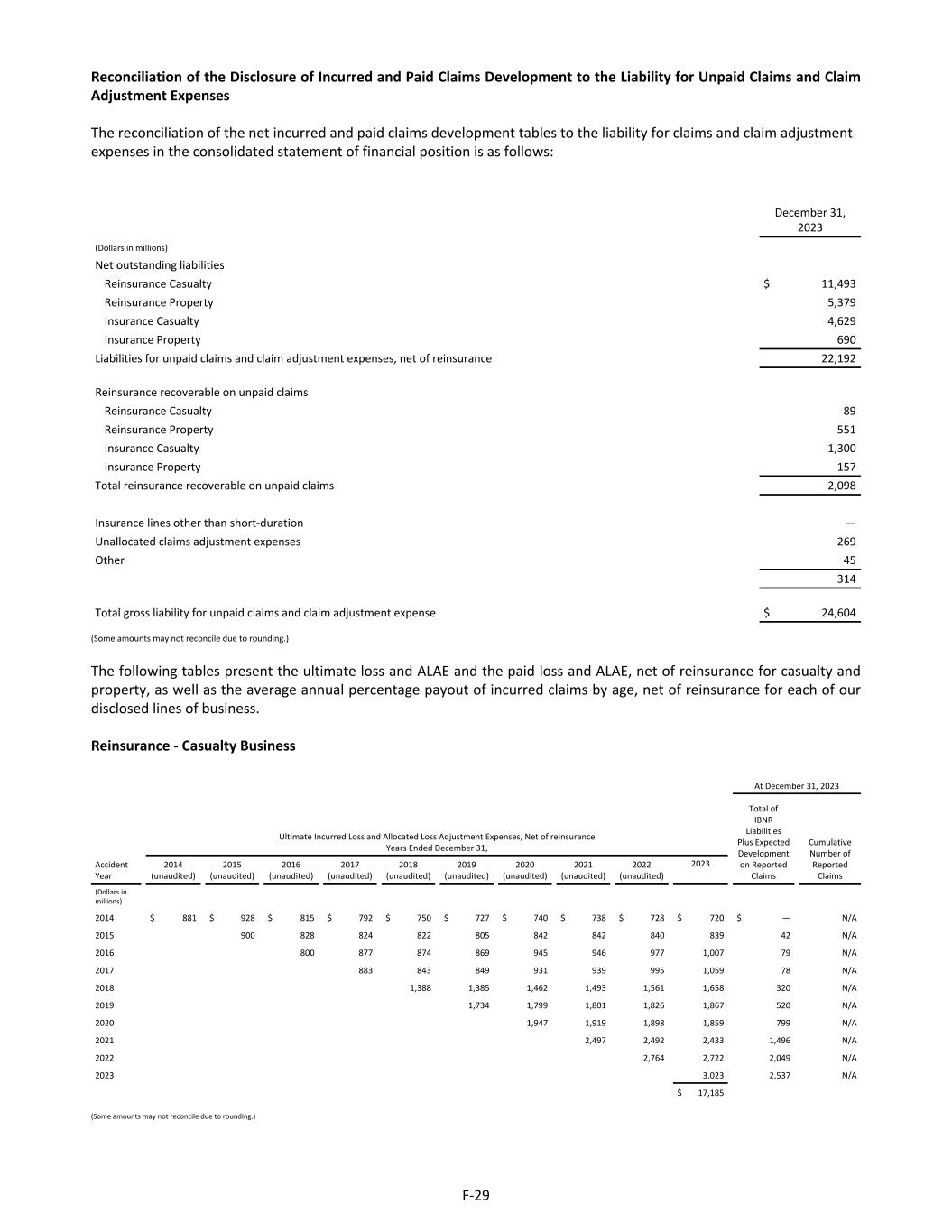
Reconciliation of the Disclosure of Incurred and Paid Claims Development to the Liability for Unpaid Claims and Claim Adjustment Expenses The reconciliation of the net incurred and paid claims development tables to the liability for claims and claim adjustment expenses in the consolidated statement of financial position is as follows: December 31, 2023 (Dollars in millions) Net outstanding liabilities Reinsurance Casualty $ 11,493 Reinsurance Property 5,379 Insurance Casualty 4,629 Insurance Property 690 Liabilities for unpaid claims and claim adjustment expenses, net of reinsurance 22,192 Reinsurance recoverable on unpaid claims Reinsurance Casualty 89 Reinsurance Property 551 Insurance Casualty 1,300 Insurance Property 157 Total reinsurance recoverable on unpaid claims 2,098 Insurance lines other than short-duration — Unallocated claims adjustment expenses 269 Other 45 314 Total gross liability for unpaid claims and claim adjustment expense $ 24,604 (Some amounts may not reconcile due to rounding.) The following tables present the ultimate loss and ALAE and the paid loss and ALAE, net of reinsurance for casualty and property, as well as the average annual percentage payout of incurred claims by age, net of reinsurance for each of our disclosed lines of business. Reinsurance - Casualty Business At December 31, 2023 Ultimate Incurred Loss and Allocated Loss Adjustment Expenses, Net of reinsurance Years Ended December 31, Total of IBNR Liabilities Plus Expected Development on Reported Claims Cumulative Number of Reported Claims Accident Year 2014 (unaudited) 2015 (unaudited) 2016 (unaudited) 2017 (unaudited) 2018 (unaudited) 2019 (unaudited) 2020 (unaudited) 2021 (unaudited) 2022 (unaudited) 2023 (Dollars in millions) 2014 $ 881 $ 928 $ 815 $ 792 $ 750 $ 727 $ 740 $ 738 $ 728 $ 720 $ — N/A 2015 900 828 824 822 805 842 842 840 839 42 N/A 2016 800 877 874 869 945 946 977 1,007 79 N/A 2017 883 843 849 931 939 995 1,059 78 N/A 2018 1,388 1,385 1,462 1,493 1,561 1,658 320 N/A 2019 1,734 1,799 1,801 1,826 1,867 520 N/A 2020 1,947 1,919 1,898 1,859 799 N/A 2021 2,497 2,492 2,433 1,496 N/A 2022 2,764 2,722 2,049 N/A 2023 3,023 2,537 N/A $ 17,185 (Some amounts may not reconcile due to rounding.) F-29
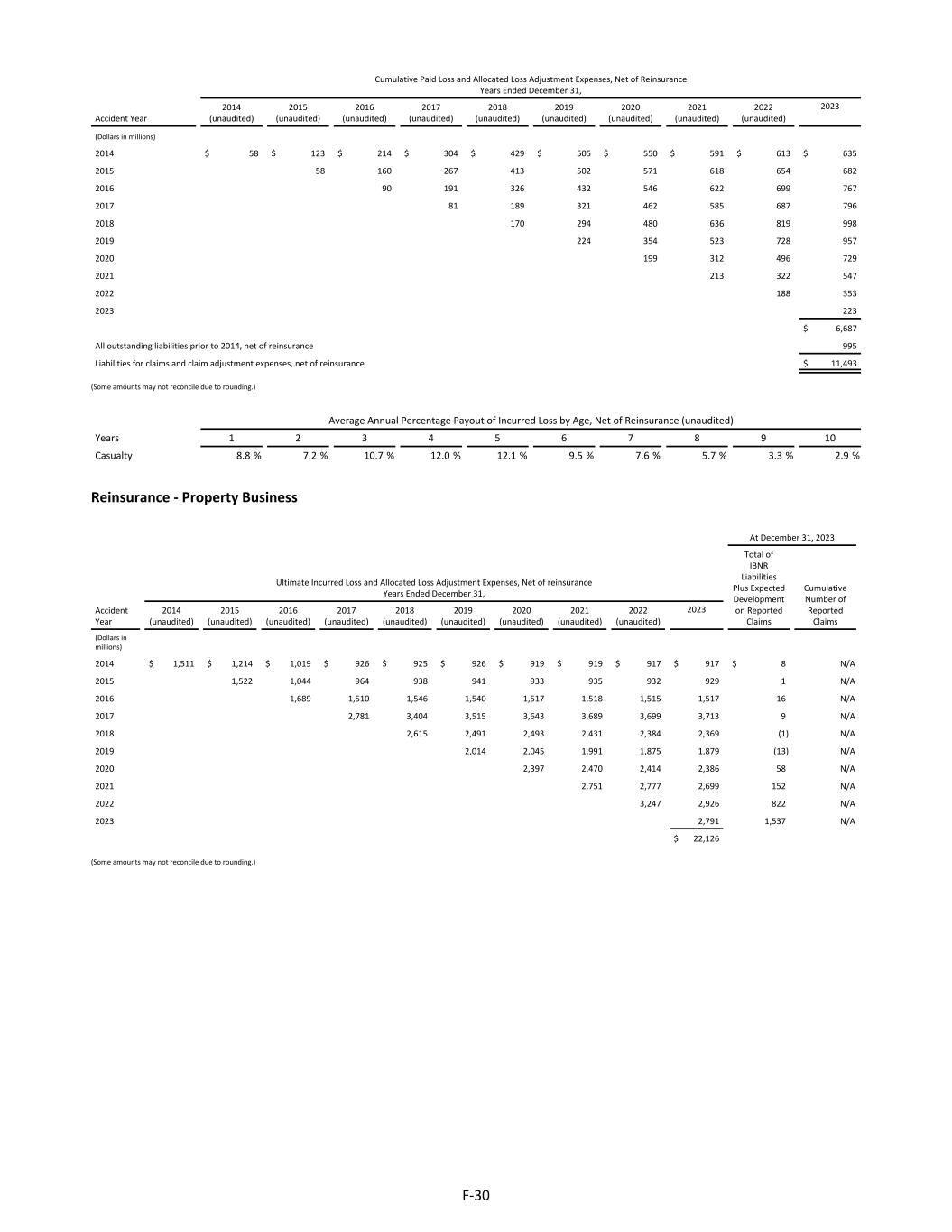
Cumulative Paid Loss and Allocated Loss Adjustment Expenses, Net of Reinsurance Years Ended December 31, Accident Year 2014 (unaudited) 2015 (unaudited) 2016 (unaudited) 2017 (unaudited) 2018 (unaudited) 2019 (unaudited) 2020 (unaudited) 2021 (unaudited) 2022 (unaudited) 2023 (Dollars in millions) 2014 $ 58 $ 123 $ 214 $ 304 $ 429 $ 505 $ 550 $ 591 $ 613 $ 635 2015 58 160 267 413 502 571 618 654 682 2016 90 191 326 432 546 622 699 767 2017 81 189 321 462 585 687 796 2018 170 294 480 636 819 998 2019 224 354 523 728 957 2020 199 312 496 729 2021 213 322 547 2022 188 353 2023 223 $ 6,687 All outstanding liabilities prior to 2014, net of reinsurance 995 Liabilities for claims and claim adjustment expenses, net of reinsurance $ 11,493 (Some amounts may not reconcile due to rounding.) Average Annual Percentage Payout of Incurred Loss by Age, Net of Reinsurance (unaudited) Years 1 2 3 4 5 6 7 8 9 10 Casualty 8.8 % 7.2 % 10.7 % 12.0 % 12.1 % 9.5 % 7.6 % 5.7 % 3.3 % 2.9 % Reinsurance - Property Business At December 31, 2023 Ultimate Incurred Loss and Allocated Loss Adjustment Expenses, Net of reinsurance Years Ended December 31, Total of IBNR Liabilities Plus Expected Development on Reported Claims Cumulative Number of Reported Claims Accident Year 2014 (unaudited) 2015 (unaudited) 2016 (unaudited) 2017 (unaudited) 2018 (unaudited) 2019 (unaudited) 2020 (unaudited) 2021 (unaudited) 2022 (unaudited) 2023 (Dollars in millions) 2014 $ 1,511 $ 1,214 $ 1,019 $ 926 $ 925 $ 926 $ 919 $ 919 $ 917 $ 917 $ 8 N/A 2015 1,522 1,044 964 938 941 933 935 932 929 1 N/A 2016 1,689 1,510 1,546 1,540 1,517 1,518 1,515 1,517 16 N/A 2017 2,781 3,404 3,515 3,643 3,689 3,699 3,713 9 N/A 2018 2,615 2,491 2,493 2,431 2,384 2,369 (1) N/A 2019 2,014 2,045 1,991 1,875 1,879 (13) N/A 2020 2,397 2,470 2,414 2,386 58 N/A 2021 2,751 2,777 2,699 152 N/A 2022 3,247 2,926 822 N/A 2023 2,791 1,537 N/A $ 22,126 (Some amounts may not reconcile due to rounding.) F-30
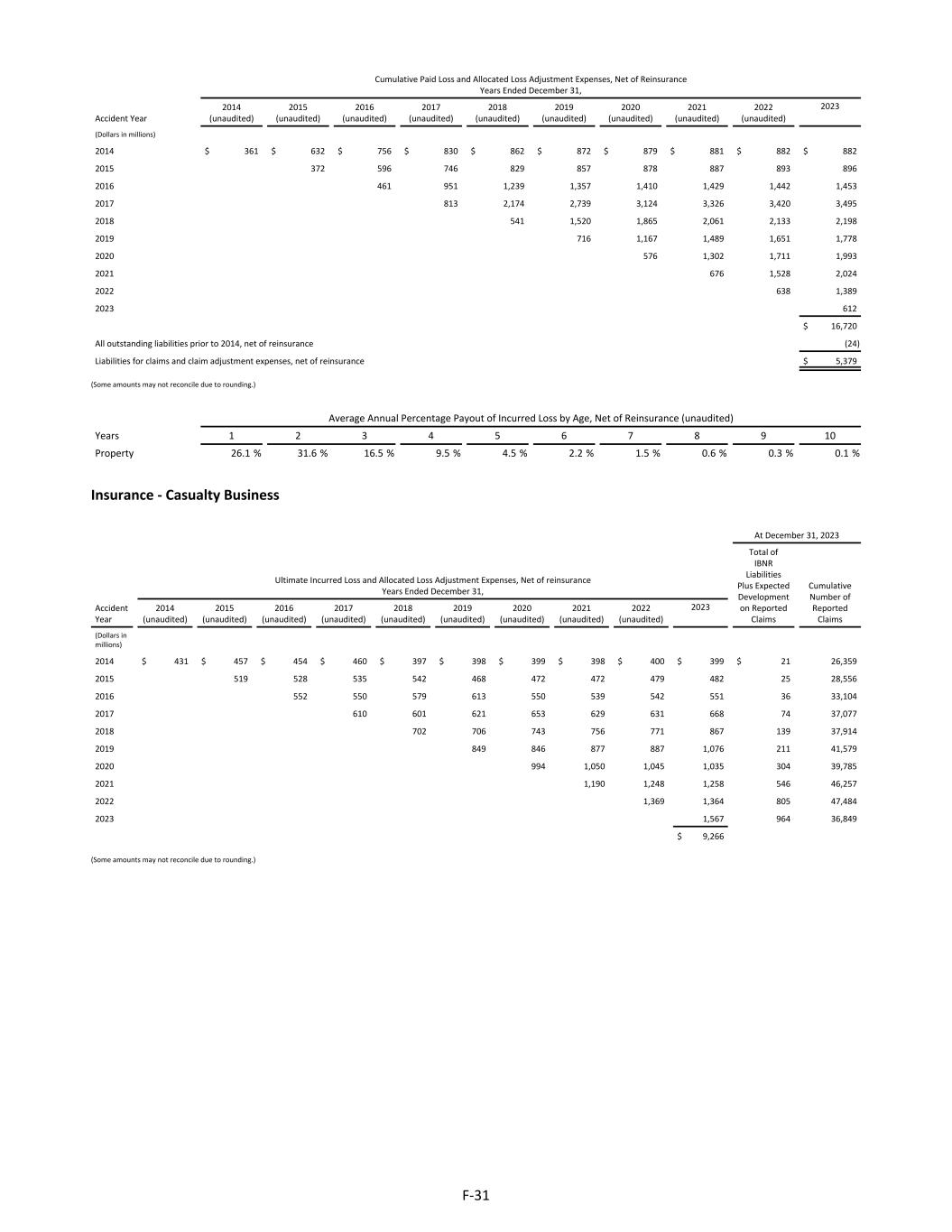
Cumulative Paid Loss and Allocated Loss Adjustment Expenses, Net of Reinsurance Years Ended December 31, Accident Year 2014 (unaudited) 2015 (unaudited) 2016 (unaudited) 2017 (unaudited) 2018 (unaudited) 2019 (unaudited) 2020 (unaudited) 2021 (unaudited) 2022 (unaudited) 2023 (Dollars in millions) 2014 $ 361 $ 632 $ 756 $ 830 $ 862 $ 872 $ 879 $ 881 $ 882 $ 882 2015 372 596 746 829 857 878 887 893 896 2016 461 951 1,239 1,357 1,410 1,429 1,442 1,453 2017 813 2,174 2,739 3,124 3,326 3,420 3,495 2018 541 1,520 1,865 2,061 2,133 2,198 2019 716 1,167 1,489 1,651 1,778 2020 576 1,302 1,711 1,993 2021 676 1,528 2,024 2022 638 1,389 2023 612 $ 16,720 All outstanding liabilities prior to 2014, net of reinsurance (24) Liabilities for claims and claim adjustment expenses, net of reinsurance $ 5,379 (Some amounts may not reconcile due to rounding.) Average Annual Percentage Payout of Incurred Loss by Age, Net of Reinsurance (unaudited) Years 1 2 3 4 5 6 7 8 9 10 Property 26.1 % 31.6 % 16.5 % 9.5 % 4.5 % 2.2 % 1.5 % 0.6 % 0.3 % 0.1 % Insurance - Casualty Business At December 31, 2023 Ultimate Incurred Loss and Allocated Loss Adjustment Expenses, Net of reinsurance Years Ended December 31, Total of IBNR Liabilities Plus Expected Development on Reported Claims Cumulative Number of Reported Claims Accident Year 2014 (unaudited) 2015 (unaudited) 2016 (unaudited) 2017 (unaudited) 2018 (unaudited) 2019 (unaudited) 2020 (unaudited) 2021 (unaudited) 2022 (unaudited) 2023 (Dollars in millions) 2014 $ 431 $ 457 $ 454 $ 460 $ 397 $ 398 $ 399 $ 398 $ 400 $ 399 $ 21 26,359 2015 519 528 535 542 468 472 472 479 482 25 28,556 2016 552 550 579 613 550 539 542 551 36 33,104 2017 610 601 621 653 629 631 668 74 37,077 2018 702 706 743 756 771 867 139 37,914 2019 849 846 877 887 1,076 211 41,579 2020 994 1,050 1,045 1,035 304 39,785 2021 1,190 1,248 1,258 546 46,257 2022 1,369 1,364 805 47,484 2023 1,567 964 36,849 $ 9,266 (Some amounts may not reconcile due to rounding.) F-31
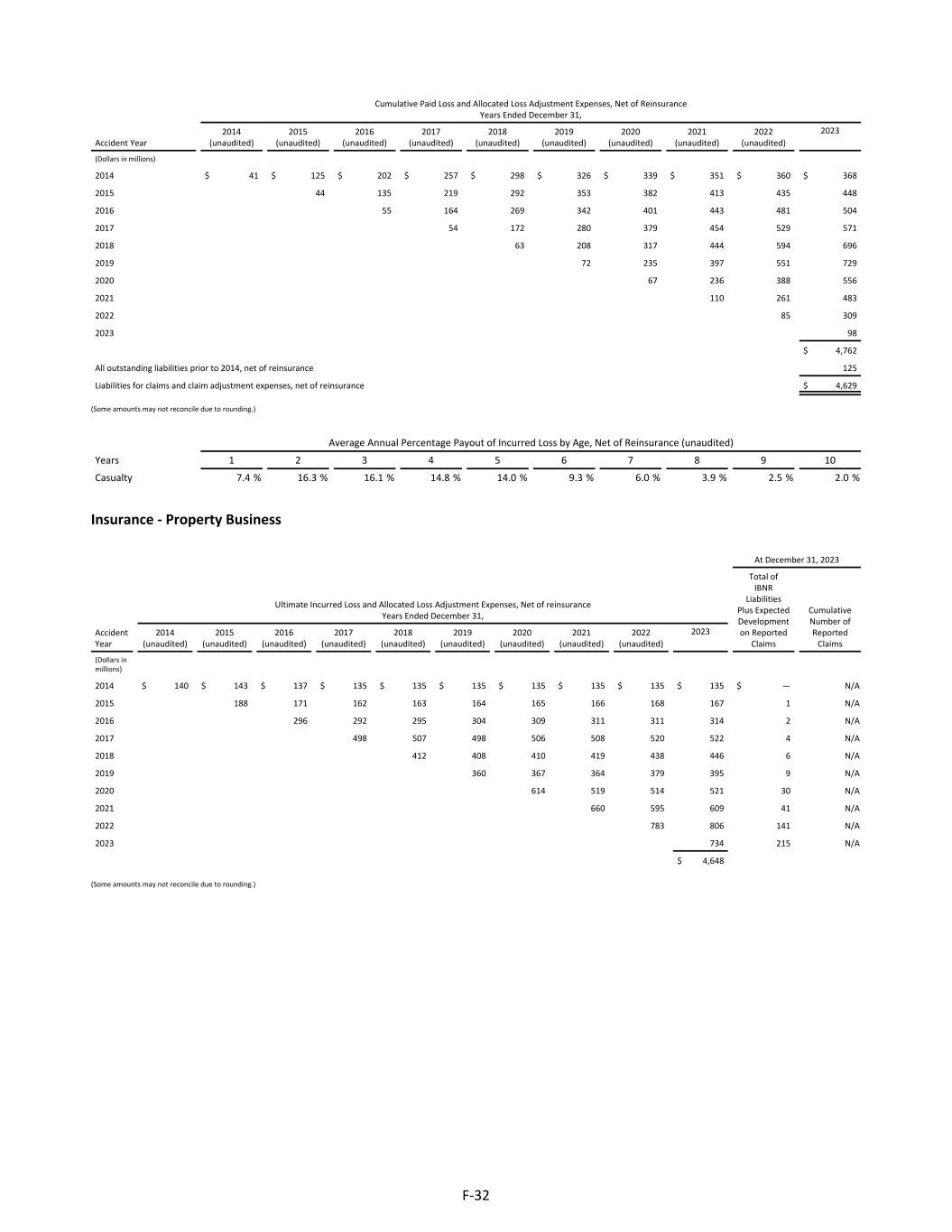
Cumulative Paid Loss and Allocated Loss Adjustment Expenses, Net of Reinsurance Years Ended December 31, Accident Year 2014 (unaudited) 2015 (unaudited) 2016 (unaudited) 2017 (unaudited) 2018 (unaudited) 2019 (unaudited) 2020 (unaudited) 2021 (unaudited) 2022 (unaudited) 2023 (Dollars in millions) 2014 $ 41 $ 125 $ 202 $ 257 $ 298 $ 326 $ 339 $ 351 $ 360 $ 368 2015 44 135 219 292 353 382 413 435 448 2016 55 164 269 342 401 443 481 504 2017 54 172 280 379 454 529 571 2018 63 208 317 444 594 696 2019 72 235 397 551 729 2020 67 236 388 556 2021 110 261 483 2022 85 309 2023 98 $ 4,762 All outstanding liabilities prior to 2014, net of reinsurance 125 Liabilities for claims and claim adjustment expenses, net of reinsurance $ 4,629 (Some amounts may not reconcile due to rounding.) Average Annual Percentage Payout of Incurred Loss by Age, Net of Reinsurance (unaudited) Years 1 2 3 4 5 6 7 8 9 10 Casualty 7.4 % 16.3 % 16.1 % 14.8 % 14.0 % 9.3 % 6.0 % 3.9 % 2.5 % 2.0 % Insurance - Property Business At December 31, 2023 Ultimate Incurred Loss and Allocated Loss Adjustment Expenses, Net of reinsurance Years Ended December 31, Total of IBNR Liabilities Plus Expected Development on Reported Claims Cumulative Number of Reported Claims Accident Year 2014 (unaudited) 2015 (unaudited) 2016 (unaudited) 2017 (unaudited) 2018 (unaudited) 2019 (unaudited) 2020 (unaudited) 2021 (unaudited) 2022 (unaudited) 2023 (Dollars in millions) 2014 $ 140 $ 143 $ 137 $ 135 $ 135 $ 135 $ 135 $ 135 $ 135 $ 135 $ — N/A 2015 188 171 162 163 164 165 166 168 167 1 N/A 2016 296 292 295 304 309 311 311 314 2 N/A 2017 498 507 498 506 508 520 522 4 N/A 2018 412 408 410 419 438 446 6 N/A 2019 360 367 364 379 395 9 N/A 2020 614 519 514 521 30 N/A 2021 660 595 609 41 N/A 2022 783 806 141 N/A 2023 734 215 N/A $ 4,648 (Some amounts may not reconcile due to rounding.) F-32

Cumulative Paid Loss and Allocated Loss Adjustment Expenses, Net of Reinsurance Years Ended December 31, Accident Year 2014 (unaudited) 2015 (unaudited) 2016 (unaudited) 2017 (unaudited) 2018 (unaudited) 2019 (unaudited) 2020 (unaudited) 2021 (unaudited) 2022 (unaudited) 2023 (Dollars in millions) 2014 $ 86 $ 127 $ 133 $ 134 $ 134 $ 134 $ 134 $ 134 $ 134 $ 134 2015 108 153 158 161 163 164 165 166 166 2016 168 259 283 302 308 310 310 311 2017 181 429 465 489 507 516 517 2018 246 364 385 418 433 439 2019 233 325 350 369 378 2020 301 427 467 483 2021 332 488 550 2022 381 576 2023 405 $ 3,959 All outstanding liabilities prior to 2014, net of reinsurance — Liabilities for claims and claim adjustment expenses, net of reinsurance 690 (Some amounts may not reconcile due to rounding.) Average Annual Percentage Payout of Incurred Loss by Age, Net of Reinsurance (unaudited) Years 1 2 3 4 5 6 7 8 9 10 Property 52.5 % 31.6 % 7.1 % 4.6 % 2.5 % 1.2 % 0.2 % 0.2 % 0.1 % — % Reserving Methodology The Company maintains reserves equal to our estimated ultimate liability for losses and loss adjustment expense (LAE) for reported and unreported claims for our insurance and reinsurance businesses. Because reserves are based on estimates of ultimate losses and LAE by underwriting or accident year, the Company uses a variety of statistical and actuarial techniques to monitor reserve adequacy over time, evaluate new information as it becomes known, and adjust reserves whenever an adjustment appears warranted. The Company considers many factors when setting reserves including: (1) exposure base and projected ultimate premium; (2) expected loss ratios by product and class of business, which are developed collaboratively by underwriters and actuaries; (3) actuarial methodologies and assumptions which analyze loss reporting and payment experience, reports from ceding companies and historical trends, such as reserving patterns, loss payments, and product mix; (4) current legal interpretations of coverage and liability; and (5) economic conditions. Management’s best estimate is developed through collaboration with actuarial, underwriting, claims, legal and finance departments and culminates with the input of reserve committees. Each segment reserve committee includes the participation of the relevant parties from actuarial, finance, claims and segment senior management and has the responsibility for recommending and approving management’s best estimate. Reserves are further reviewed by Everest’s Chief Reserving Actuary and senior management. The objective of such process is to determine a single best estimate viewed by management to be the best estimate of its ultimate loss liability. Actual loss and LAE ultimately paid may deviate, perhaps substantially, from such reserves. Net income will be impacted in a period in which the change in estimated ultimate loss and LAE is recorded. The detailed data required to evaluate ultimate losses for the Company’s insurance business is accumulated from its underwriting and claim systems. Reserving for reinsurance requires evaluation of loss information received from ceding companies. Ceding companies report losses in many forms depending on the type of contract and the agreed or contractual reporting requirements. Generally, pro rata contracts require the submission of a monthly/quarterly account, which includes premium and loss activity for the period with corresponding reserves as established by the ceding company. This information is recorded in the Company’s records. For certain pro rata contracts, the Company may require a detailed loss report for claims that exceed a certain dollar threshold or relate to a particular type of loss. Excess of loss and facultative contracts generally require individual loss reporting with precautionary notices provided when a loss reaches a significant percentage of the attachment point of the contract or when certain causes of loss or types of injury occur. Experienced Claims staff handle individual loss reports and supporting claim information. Based on evaluation of a claim, the Company may establish additional case reserves in addition to the case reserves reported by the ceding company. To ensure ceding companies are submitting required and accurate data, Everest’s Underwriting, Claim, Reinsurance Accounting, and Internal Audit Departments perform various reviews of ceding companies, particularly larger ceding companies, including on-site audits. F-33
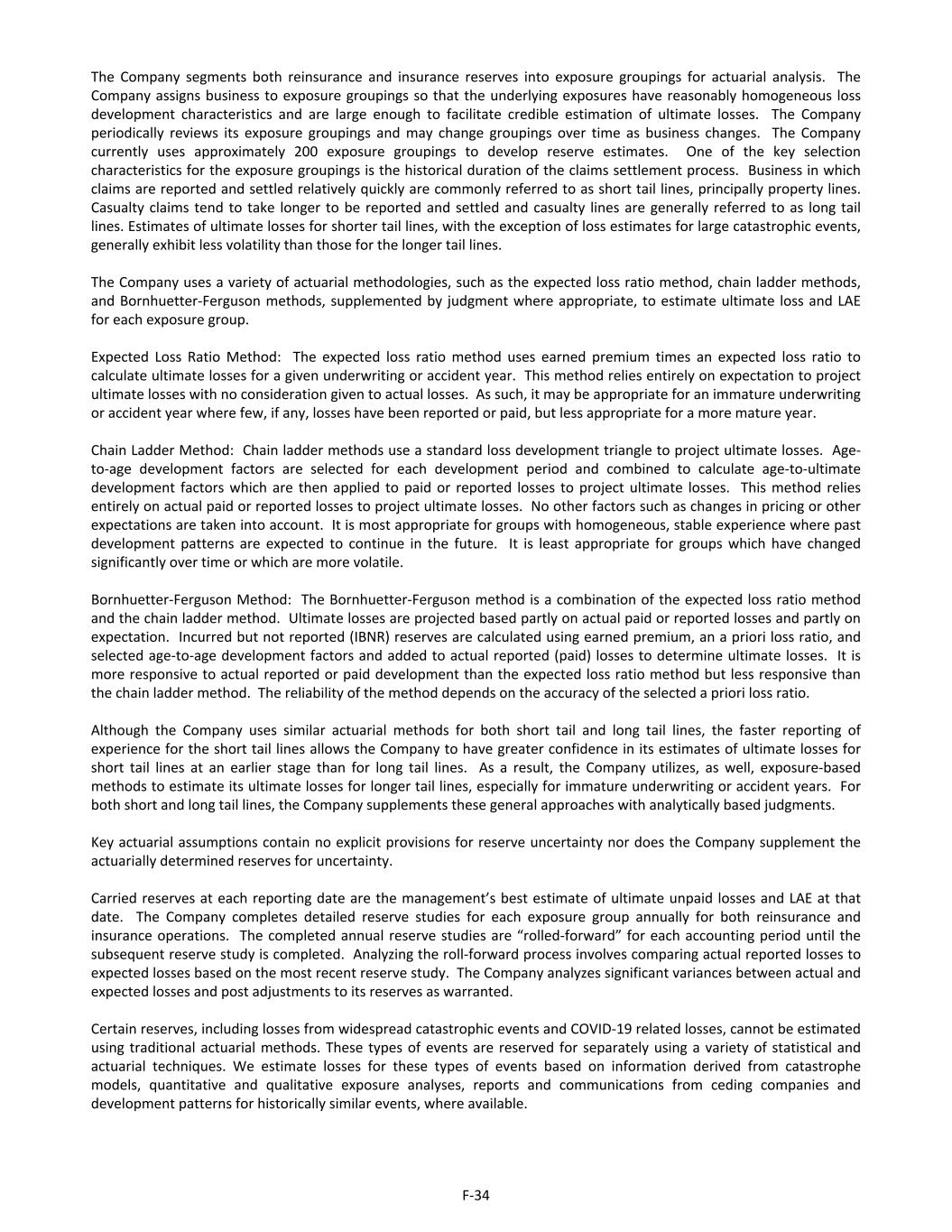
The Company segments both reinsurance and insurance reserves into exposure groupings for actuarial analysis. The Company assigns business to exposure groupings so that the underlying exposures have reasonably homogeneous loss development characteristics and are large enough to facilitate credible estimation of ultimate losses. The Company periodically reviews its exposure groupings and may change groupings over time as business changes. The Company currently uses approximately 200 exposure groupings to develop reserve estimates. One of the key selection characteristics for the exposure groupings is the historical duration of the claims settlement process. Business in which claims are reported and settled relatively quickly are commonly referred to as short tail lines, principally property lines. Casualty claims tend to take longer to be reported and settled and casualty lines are generally referred to as long tail lines. Estimates of ultimate losses for shorter tail lines, with the exception of loss estimates for large catastrophic events, generally exhibit less volatility than those for the longer tail lines. The Company uses a variety of actuarial methodologies, such as the expected loss ratio method, chain ladder methods, and Bornhuetter-Ferguson methods, supplemented by judgment where appropriate, to estimate ultimate loss and LAE for each exposure group. Expected Loss Ratio Method: The expected loss ratio method uses earned premium times an expected loss ratio to calculate ultimate losses for a given underwriting or accident year. This method relies entirely on expectation to project ultimate losses with no consideration given to actual losses. As such, it may be appropriate for an immature underwriting or accident year where few, if any, losses have been reported or paid, but less appropriate for a more mature year. Chain Ladder Method: Chain ladder methods use a standard loss development triangle to project ultimate losses. Age- to-age development factors are selected for each development period and combined to calculate age-to-ultimate development factors which are then applied to paid or reported losses to project ultimate losses. This method relies entirely on actual paid or reported losses to project ultimate losses. No other factors such as changes in pricing or other expectations are taken into account. It is most appropriate for groups with homogeneous, stable experience where past development patterns are expected to continue in the future. It is least appropriate for groups which have changed significantly over time or which are more volatile. Bornhuetter-Ferguson Method: The Bornhuetter-Ferguson method is a combination of the expected loss ratio method and the chain ladder method. Ultimate losses are projected based partly on actual paid or reported losses and partly on expectation. Incurred but not reported (IBNR) reserves are calculated using earned premium, an a priori loss ratio, and selected age-to-age development factors and added to actual reported (paid) losses to determine ultimate losses. It is more responsive to actual reported or paid development than the expected loss ratio method but less responsive than the chain ladder method. The reliability of the method depends on the accuracy of the selected a priori loss ratio. Although the Company uses similar actuarial methods for both short tail and long tail lines, the faster reporting of experience for the short tail lines allows the Company to have greater confidence in its estimates of ultimate losses for short tail lines at an earlier stage than for long tail lines. As a result, the Company utilizes, as well, exposure-based methods to estimate its ultimate losses for longer tail lines, especially for immature underwriting or accident years. For both short and long tail lines, the Company supplements these general approaches with analytically based judgments. Key actuarial assumptions contain no explicit provisions for reserve uncertainty nor does the Company supplement the actuarially determined reserves for uncertainty. Carried reserves at each reporting date are the management’s best estimate of ultimate unpaid losses and LAE at that date. The Company completes detailed reserve studies for each exposure group annually for both reinsurance and insurance operations. The completed annual reserve studies are “rolled-forward” for each accounting period until the subsequent reserve study is completed. Analyzing the roll-forward process involves comparing actual reported losses to expected losses based on the most recent reserve study. The Company analyzes significant variances between actual and expected losses and post adjustments to its reserves as warranted. Certain reserves, including losses from widespread catastrophic events and COVID-19 related losses, cannot be estimated using traditional actuarial methods. These types of events are reserved for separately using a variety of statistical and actuarial techniques. We estimate losses for these types of events based on information derived from catastrophe models, quantitative and qualitative exposure analyses, reports and communications from ceding companies and development patterns for historically similar events, where available. F-34
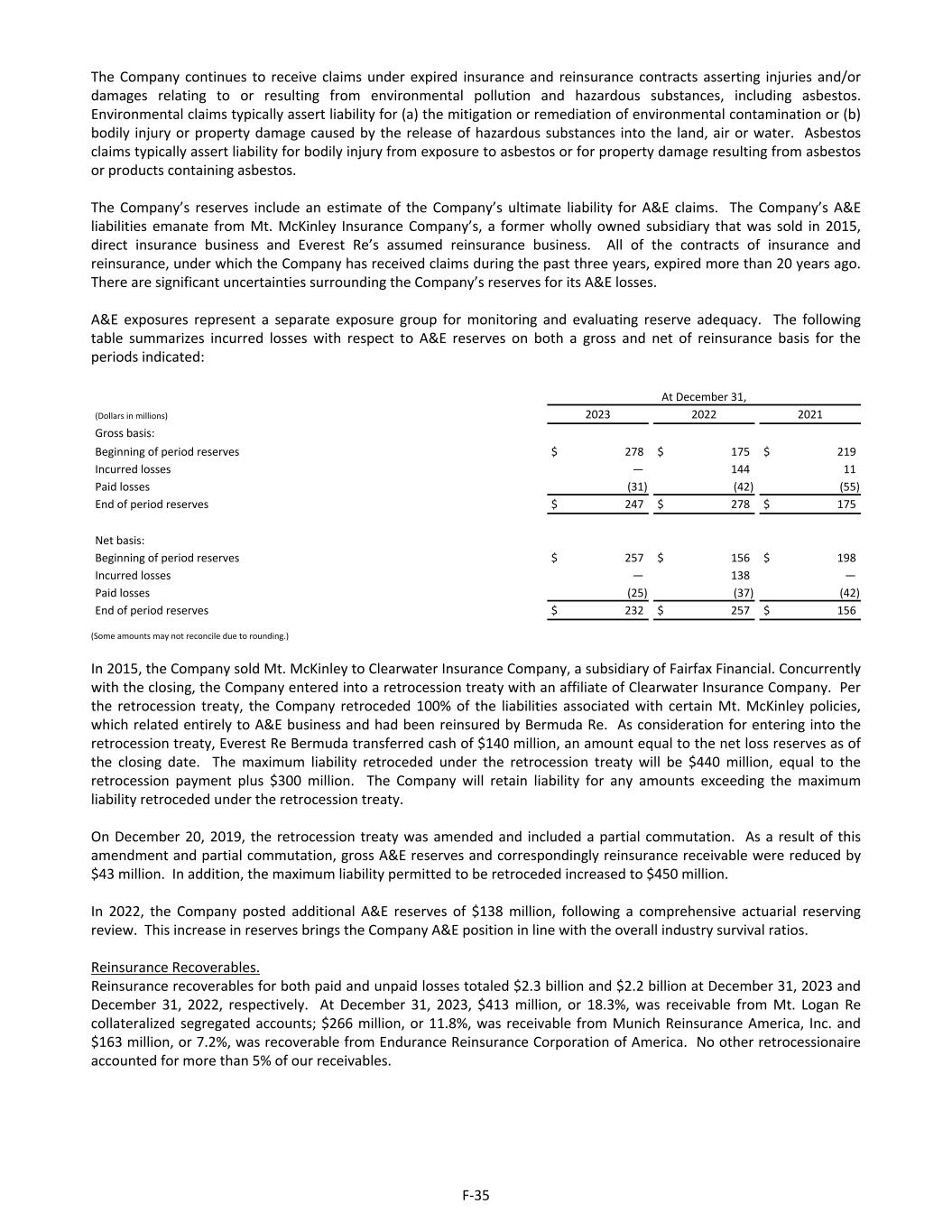
The Company continues to receive claims under expired insurance and reinsurance contracts asserting injuries and/or damages relating to or resulting from environmental pollution and hazardous substances, including asbestos. Environmental claims typically assert liability for (a) the mitigation or remediation of environmental contamination or (b) bodily injury or property damage caused by the release of hazardous substances into the land, air or water. Asbestos claims typically assert liability for bodily injury from exposure to asbestos or for property damage resulting from asbestos or products containing asbestos. The Company’s reserves include an estimate of the Company’s ultimate liability for A&E claims. The Company’s A&E liabilities emanate from Mt. McKinley Insurance Company’s, a former wholly owned subsidiary that was sold in 2015, direct insurance business and Everest Re’s assumed reinsurance business. All of the contracts of insurance and reinsurance, under which the Company has received claims during the past three years, expired more than 20 years ago. There are significant uncertainties surrounding the Company’s reserves for its A&E losses. A&E exposures represent a separate exposure group for monitoring and evaluating reserve adequacy. The following table summarizes incurred losses with respect to A&E reserves on both a gross and net of reinsurance basis for the periods indicated: At December 31, (Dollars in millions) 2023 2022 2021 Gross basis: Beginning of period reserves $ 278 $ 175 $ 219 Incurred losses — 144 11 Paid losses (31) (42) (55) End of period reserves $ 247 $ 278 $ 175 Net basis: Beginning of period reserves $ 257 $ 156 $ 198 Incurred losses — 138 — Paid losses (25) (37) (42) End of period reserves $ 232 $ 257 $ 156 (Some amounts may not reconcile due to rounding.) In 2015, the Company sold Mt. McKinley to Clearwater Insurance Company, a subsidiary of Fairfax Financial. Concurrently with the closing, the Company entered into a retrocession treaty with an affiliate of Clearwater Insurance Company. Per the retrocession treaty, the Company retroceded 100% of the liabilities associated with certain Mt. McKinley policies, which related entirely to A&E business and had been reinsured by Bermuda Re. As consideration for entering into the retrocession treaty, Everest Re Bermuda transferred cash of $140 million, an amount equal to the net loss reserves as of the closing date. The maximum liability retroceded under the retrocession treaty will be $440 million, equal to the retrocession payment plus $300 million. The Company will retain liability for any amounts exceeding the maximum liability retroceded under the retrocession treaty. On December 20, 2019, the retrocession treaty was amended and included a partial commutation. As a result of this amendment and partial commutation, gross A&E reserves and correspondingly reinsurance receivable were reduced by $43 million. In addition, the maximum liability permitted to be retroceded increased to $450 million. In 2022, the Company posted additional A&E reserves of $138 million, following a comprehensive actuarial reserving review. This increase in reserves brings the Company A&E position in line with the overall industry survival ratios. Reinsurance Recoverables. Reinsurance recoverables for both paid and unpaid losses totaled $2.3 billion and $2.2 billion at December 31, 2023 and December 31, 2022, respectively. At December 31, 2023, $413 million, or 18.3%, was receivable from Mt. Logan Re collateralized segregated accounts; $266 million, or 11.8%, was receivable from Munich Reinsurance America, Inc. and $163 million, or 7.2%, was recoverable from Endurance Reinsurance Corporation of America. No other retrocessionaire accounted for more than 5% of our receivables. F-35
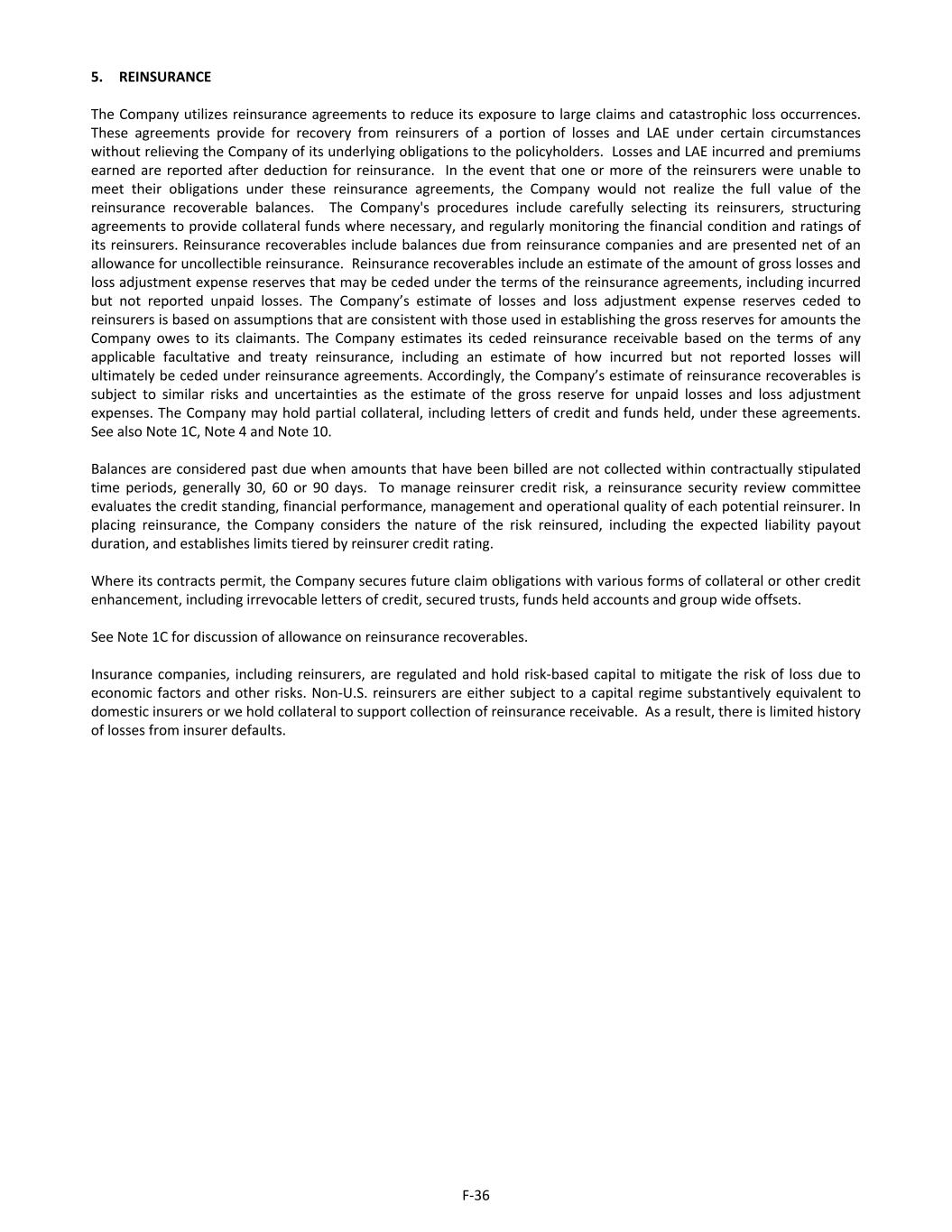
5. REINSURANCE The Company utilizes reinsurance agreements to reduce its exposure to large claims and catastrophic loss occurrences. These agreements provide for recovery from reinsurers of a portion of losses and LAE under certain circumstances without relieving the Company of its underlying obligations to the policyholders. Losses and LAE incurred and premiums earned are reported after deduction for reinsurance. In the event that one or more of the reinsurers were unable to meet their obligations under these reinsurance agreements, the Company would not realize the full value of the reinsurance recoverable balances. The Company's procedures include carefully selecting its reinsurers, structuring agreements to provide collateral funds where necessary, and regularly monitoring the financial condition and ratings of its reinsurers. Reinsurance recoverables include balances due from reinsurance companies and are presented net of an allowance for uncollectible reinsurance. Reinsurance recoverables include an estimate of the amount of gross losses and loss adjustment expense reserves that may be ceded under the terms of the reinsurance agreements, including incurred but not reported unpaid losses. The Company’s estimate of losses and loss adjustment expense reserves ceded to reinsurers is based on assumptions that are consistent with those used in establishing the gross reserves for amounts the Company owes to its claimants. The Company estimates its ceded reinsurance receivable based on the terms of any applicable facultative and treaty reinsurance, including an estimate of how incurred but not reported losses will ultimately be ceded under reinsurance agreements. Accordingly, the Company’s estimate of reinsurance recoverables is subject to similar risks and uncertainties as the estimate of the gross reserve for unpaid losses and loss adjustment expenses. The Company may hold partial collateral, including letters of credit and funds held, under these agreements. See also Note 1C, Note 4 and Note 10. Balances are considered past due when amounts that have been billed are not collected within contractually stipulated time periods, generally 30, 60 or 90 days. To manage reinsurer credit risk, a reinsurance security review committee evaluates the credit standing, financial performance, management and operational quality of each potential reinsurer. In placing reinsurance, the Company considers the nature of the risk reinsured, including the expected liability payout duration, and establishes limits tiered by reinsurer credit rating. Where its contracts permit, the Company secures future claim obligations with various forms of collateral or other credit enhancement, including irrevocable letters of credit, secured trusts, funds held accounts and group wide offsets. See Note 1C for discussion of allowance on reinsurance recoverables. Insurance companies, including reinsurers, are regulated and hold risk-based capital to mitigate the risk of loss due to economic factors and other risks. Non-U.S. reinsurers are either subject to a capital regime substantively equivalent to domestic insurers or we hold collateral to support collection of reinsurance receivable. As a result, there is limited history of losses from insurer defaults. F-36

Premiums written and earned and incurred losses and LAE are comprised of the following for the periods indicated: Years Ended December 31, (Dollars in millions) 2023 2022 2021 Written premiums: Direct $ 5,031 $ 4,602 $ 3,988 Assumed 11,606 9,350 9,062 Ceded (1,907) (1,608) (1,604) Net written premiums $ 14,730 $ 12,344 $ 11,446 Premiums earned: Direct $ 4,733 $ 4,218 $ 3,589 Assumed 10,518 9,082 8,315 Ceded (1,807) (1,513) (1,498) Net premiums earned $ 13,443 $ 11,787 $ 10,406 Incurred losses and LAE: Direct $ 3,209 $ 2,804 $ 2,385 Assumed 5,870 6,285 5,741 Ceded (651) (988) (735) Net incurred losses and LAE $ 8,427 $ 8,100 $ 7,391 6. SEGMENT REPORTING The Company operates through two operating segments. The Reinsurance operation writes worldwide property and casualty reinsurance and specialty lines of business, on both a treaty and facultative basis, through reinsurance brokers, as well as directly with ceding companies. Business is written in the U.S., Bermuda, and Ireland offices, as well as, through branches in Canada, Singapore, the UK and Switzerland. The Insurance operation writes property and casualty insurance directly and through brokers, including for surplus lines, and general agents within the U.S., Bermuda, Canada, Europe, Singapore and South America through its offices in the U.S., Bermuda, Canada, Chile, Singapore, the UK, Ireland, and branches located in the UK, the Netherlands, France, Germany and Spain. The two segments are managed independently, but conform with corporate guidelines with respect to pricing, risk management, control of aggregate catastrophe exposures, capital, investments and support operations. Our two operating segments each have executive leadership who are responsible for the overall performance of their respective segments and who are directly accountable to our chief operating decision maker (“CODM”), the Chief Executive Officer of Everest Group, Ltd., who is ultimately responsible for reviewing the business to assess performance, make operating decisions and allocate resources. We report the results of our operations consistent with the manner in which our CODM reviews the business. During the fourth quarter of 2023, the Company revised the classification and presentation of certain products related to its accident and health business within the segment groupings. These products have been realigned from within the Reinsurance segment to the Insurance segment to appropriately reflect how the business segments are managed. These changes have been reflected retrospectively. The Company does not review and evaluate the financial results of its operating segments based upon balance sheet data. Management generally monitors and evaluates the financial performance of these operating segments based upon their underwriting results. Underwriting results include earned premium less losses and loss adjustment expenses (“LAE”) incurred, commission and brokerage expenses and other underwriting expenses. The Company measures its underwriting results using ratios, in particular, loss, commission and brokerage and other underwriting expense ratios, which, respectively, divide incurred losses, commissions and brokerage and other underwriting expenses by premiums earned. Management has determined that these measures are appropriate and align with how the business is managed. We continue to evaluate our segments as our business evolves and may further refine our segments and financial performance measures. F-37
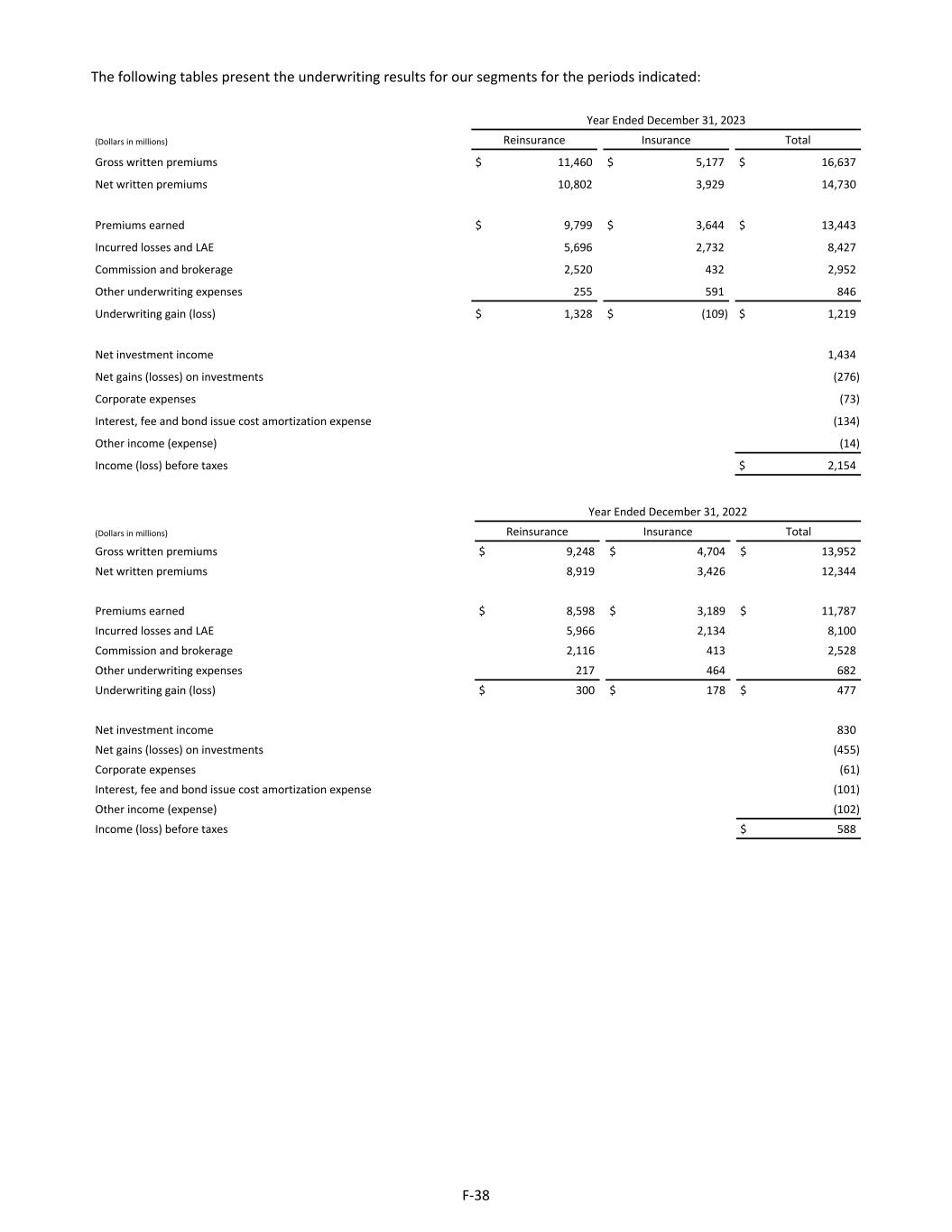
The following tables present the underwriting results for our segments for the periods indicated: Year Ended December 31, 2023 (Dollars in millions) Reinsurance Insurance Total Gross written premiums $ 11,460 $ 5,177 $ 16,637 Net written premiums 10,802 3,929 14,730 Premiums earned $ 9,799 $ 3,644 $ 13,443 Incurred losses and LAE 5,696 2,732 8,427 Commission and brokerage 2,520 432 2,952 Other underwriting expenses 255 591 846 Underwriting gain (loss) $ 1,328 $ (109) $ 1,219 Net investment income 1,434 Net gains (losses) on investments (276) Corporate expenses (73) Interest, fee and bond issue cost amortization expense (134) Other income (expense) (14) Income (loss) before taxes $ 2,154 Year Ended December 31, 2022 (Dollars in millions) Reinsurance Insurance Total Gross written premiums $ 9,248 $ 4,704 $ 13,952 Net written premiums 8,919 3,426 12,344 Premiums earned $ 8,598 $ 3,189 $ 11,787 Incurred losses and LAE 5,966 2,134 8,100 Commission and brokerage 2,116 413 2,528 Other underwriting expenses 217 464 682 Underwriting gain (loss) $ 300 $ 178 $ 477 Net investment income 830 Net gains (losses) on investments (455) Corporate expenses (61) Interest, fee and bond issue cost amortization expense (101) Other income (expense) (102) Income (loss) before taxes $ 588 F-38
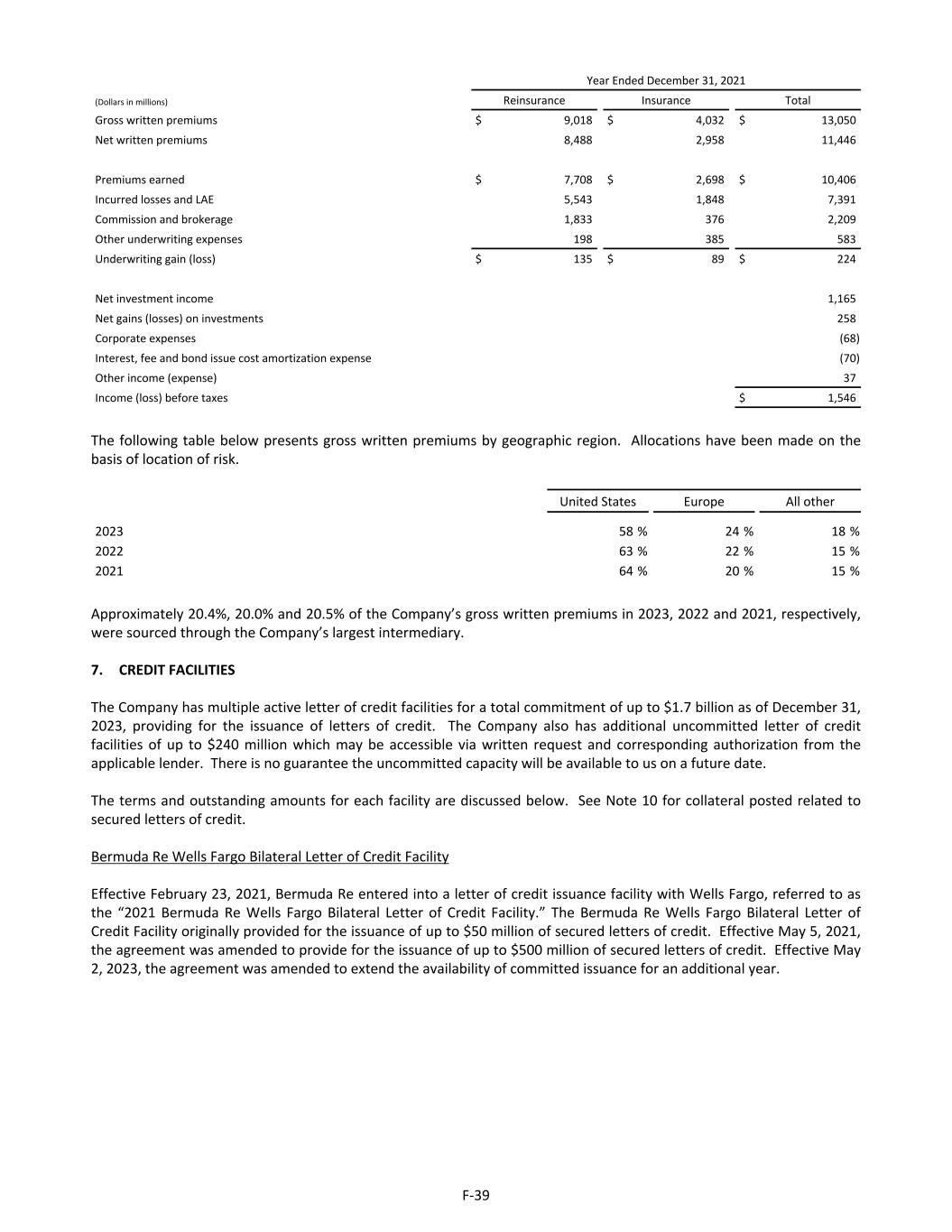
Year Ended December 31, 2021 (Dollars in millions) Reinsurance Insurance Total Gross written premiums $ 9,018 $ 4,032 $ 13,050 Net written premiums 8,488 2,958 11,446 Premiums earned $ 7,708 $ 2,698 $ 10,406 Incurred losses and LAE 5,543 1,848 7,391 Commission and brokerage 1,833 376 2,209 Other underwriting expenses 198 385 583 Underwriting gain (loss) $ 135 $ 89 $ 224 Net investment income 1,165 Net gains (losses) on investments 258 Corporate expenses (68) Interest, fee and bond issue cost amortization expense (70) Other income (expense) 37 Income (loss) before taxes $ 1,546 The following table below presents gross written premiums by geographic region. Allocations have been made on the basis of location of risk. United States Europe All other 2023 58 % 24 % 18 % 2022 63 % 22 % 15 % 2021 64 % 20 % 15 % Approximately 20.4%, 20.0% and 20.5% of the Company’s gross written premiums in 2023, 2022 and 2021, respectively, were sourced through the Company’s largest intermediary. 7. CREDIT FACILITIES The Company has multiple active letter of credit facilities for a total commitment of up to $1.7 billion as of December 31, 2023, providing for the issuance of letters of credit. The Company also has additional uncommitted letter of credit facilities of up to $240 million which may be accessible via written request and corresponding authorization from the applicable lender. There is no guarantee the uncommitted capacity will be available to us on a future date. The terms and outstanding amounts for each facility are discussed below. See Note 10 for collateral posted related to secured letters of credit. Bermuda Re Wells Fargo Bilateral Letter of Credit Facility Effective February 23, 2021, Bermuda Re entered into a letter of credit issuance facility with Wells Fargo, referred to as the “2021 Bermuda Re Wells Fargo Bilateral Letter of Credit Facility.” The Bermuda Re Wells Fargo Bilateral Letter of Credit Facility originally provided for the issuance of up to $50 million of secured letters of credit. Effective May 5, 2021, the agreement was amended to provide for the issuance of up to $500 million of secured letters of credit. Effective May 2, 2023, the agreement was amended to extend the availability of committed issuance for an additional year. F-39
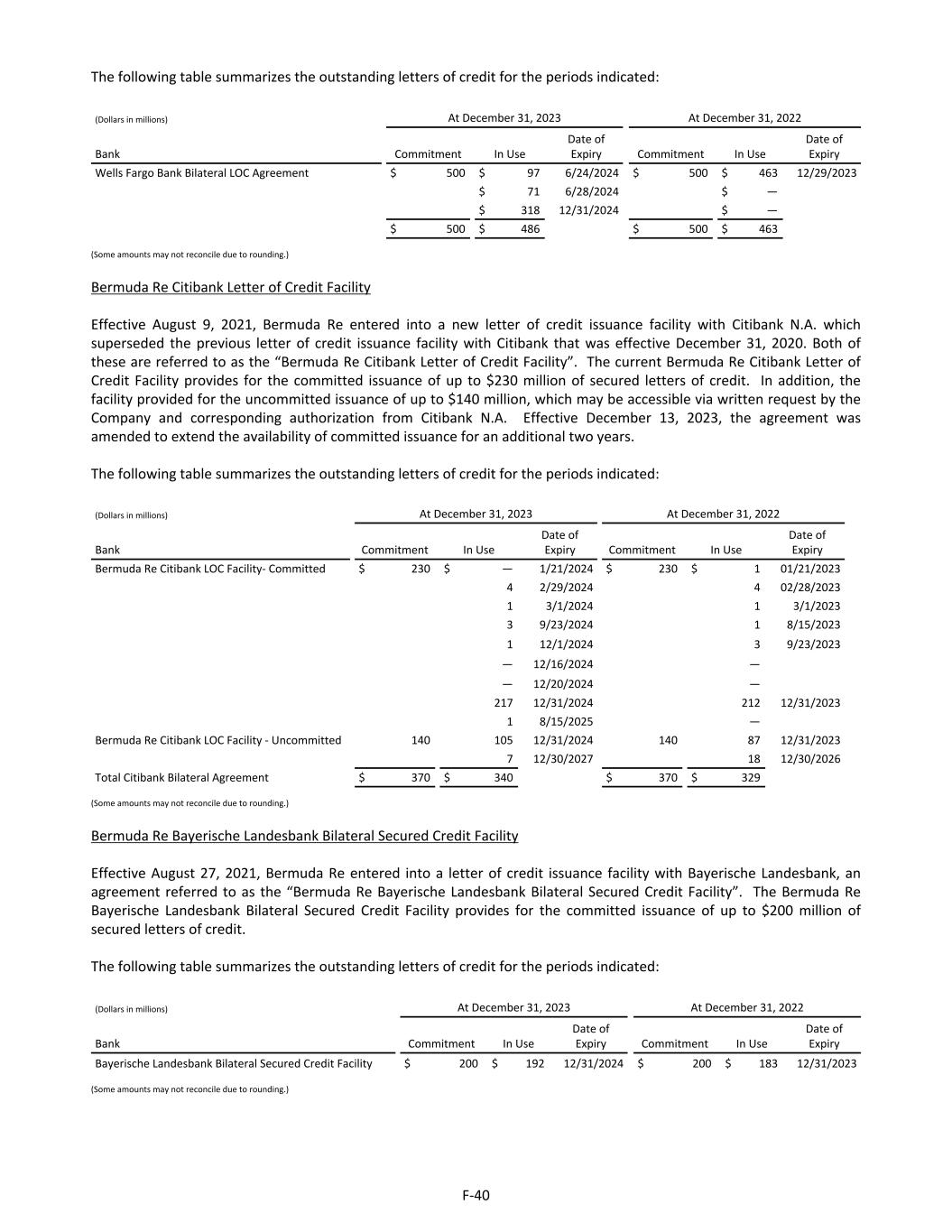
The following table summarizes the outstanding letters of credit for the periods indicated: (Dollars in millions) At December 31, 2023 At December 31, 2022 Bank Commitment In Use Date of Expiry Commitment In Use Date of Expiry Wells Fargo Bank Bilateral LOC Agreement $ 500 $ 97 6/24/2024 $ 500 $ 463 12/29/2023 $ 71 6/28/2024 $ — $ 318 12/31/2024 $ — $ 500 $ 486 $ 500 $ 463 (Some amounts may not reconcile due to rounding.) Bermuda Re Citibank Letter of Credit Facility Effective August 9, 2021, Bermuda Re entered into a new letter of credit issuance facility with Citibank N.A. which superseded the previous letter of credit issuance facility with Citibank that was effective December 31, 2020. Both of these are referred to as the “Bermuda Re Citibank Letter of Credit Facility”. The current Bermuda Re Citibank Letter of Credit Facility provides for the committed issuance of up to $230 million of secured letters of credit. In addition, the facility provided for the uncommitted issuance of up to $140 million, which may be accessible via written request by the Company and corresponding authorization from Citibank N.A. Effective December 13, 2023, the agreement was amended to extend the availability of committed issuance for an additional two years. The following table summarizes the outstanding letters of credit for the periods indicated: (Dollars in millions) At December 31, 2023 At December 31, 2022 Bank Commitment In Use Date of Expiry Commitment In Use Date of Expiry Bermuda Re Citibank LOC Facility- Committed $ 230 $ — 1/21/2024 $ 230 $ 1 01/21/2023 4 2/29/2024 4 02/28/2023 1 3/1/2024 1 3/1/2023 3 9/23/2024 1 8/15/2023 1 12/1/2024 3 9/23/2023 — 12/16/2024 — — 12/20/2024 — 217 12/31/2024 212 12/31/2023 1 8/15/2025 — Bermuda Re Citibank LOC Facility - Uncommitted 140 105 12/31/2024 140 87 12/31/2023 7 12/30/2027 18 12/30/2026 Total Citibank Bilateral Agreement $ 370 $ 340 $ 370 $ 329 (Some amounts may not reconcile due to rounding.) Bermuda Re Bayerische Landesbank Bilateral Secured Credit Facility Effective August 27, 2021, Bermuda Re entered into a letter of credit issuance facility with Bayerische Landesbank, an agreement referred to as the “Bermuda Re Bayerische Landesbank Bilateral Secured Credit Facility”. The Bermuda Re Bayerische Landesbank Bilateral Secured Credit Facility provides for the committed issuance of up to $200 million of secured letters of credit. The following table summarizes the outstanding letters of credit for the periods indicated: (Dollars in millions) At December 31, 2023 At December 31, 2022 Bank Commitment In Use Date of Expiry Commitment In Use Date of Expiry Bayerische Landesbank Bilateral Secured Credit Facility $ 200 $ 192 12/31/2024 $ 200 $ 183 12/31/2023 (Some amounts may not reconcile due to rounding.) F-40
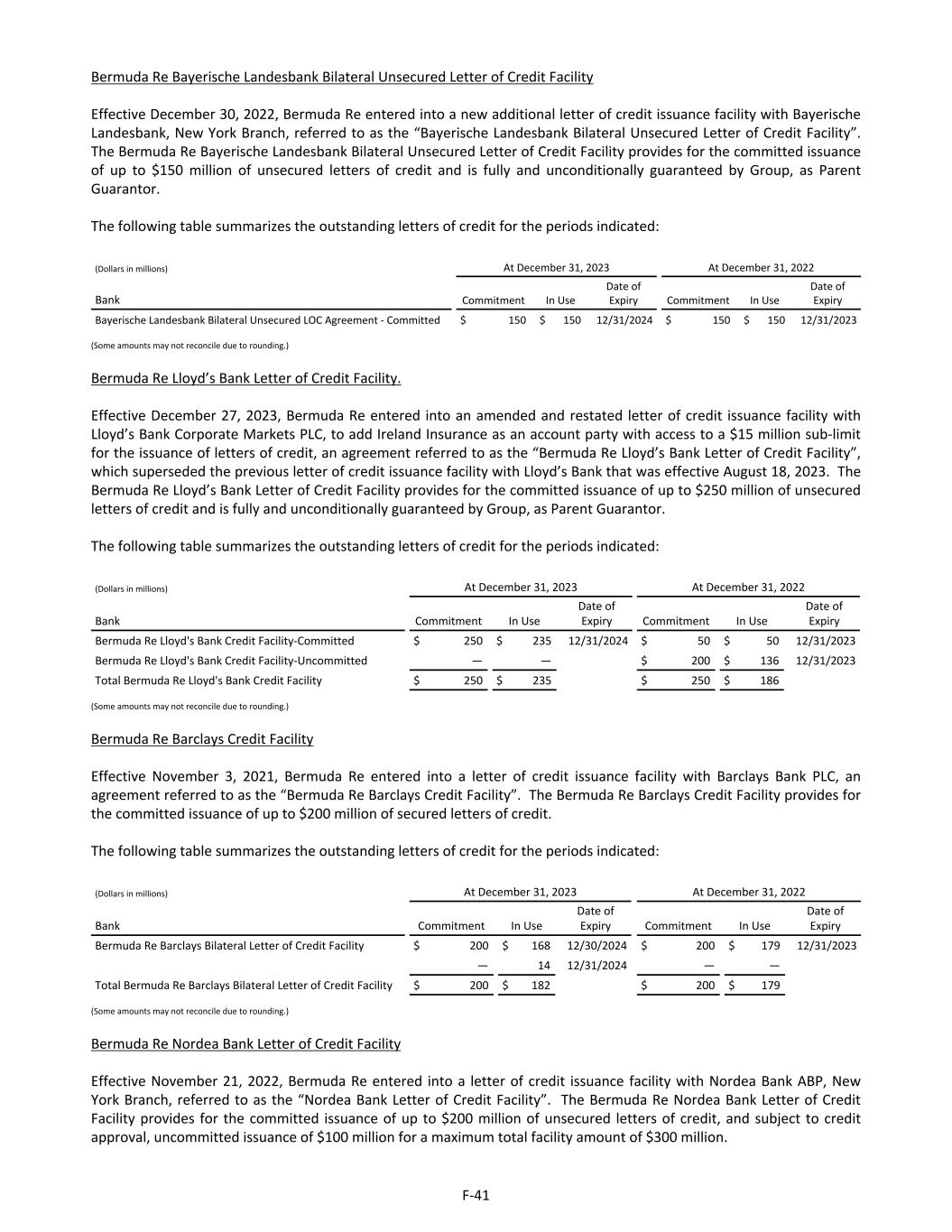
Bermuda Re Bayerische Landesbank Bilateral Unsecured Letter of Credit Facility Effective December 30, 2022, Bermuda Re entered into a new additional letter of credit issuance facility with Bayerische Landesbank, New York Branch, referred to as the “Bayerische Landesbank Bilateral Unsecured Letter of Credit Facility”. The Bermuda Re Bayerische Landesbank Bilateral Unsecured Letter of Credit Facility provides for the committed issuance of up to $150 million of unsecured letters of credit and is fully and unconditionally guaranteed by Group, as Parent Guarantor. The following table summarizes the outstanding letters of credit for the periods indicated: (Dollars in millions) At December 31, 2023 At December 31, 2022 Bank Commitment In Use Date of Expiry Commitment In Use Date of Expiry Bayerische Landesbank Bilateral Unsecured LOC Agreement - Committed $ 150 $ 150 12/31/2024 $ 150 $ 150 12/31/2023 (Some amounts may not reconcile due to rounding.) Bermuda Re Lloyd’s Bank Letter of Credit Facility. Effective December 27, 2023, Bermuda Re entered into an amended and restated letter of credit issuance facility with Lloyd’s Bank Corporate Markets PLC, to add Ireland Insurance as an account party with access to a $15 million sub-limit for the issuance of letters of credit, an agreement referred to as the “Bermuda Re Lloyd’s Bank Letter of Credit Facility”, which superseded the previous letter of credit issuance facility with Lloyd’s Bank that was effective August 18, 2023. The Bermuda Re Lloyd’s Bank Letter of Credit Facility provides for the committed issuance of up to $250 million of unsecured letters of credit and is fully and unconditionally guaranteed by Group, as Parent Guarantor. The following table summarizes the outstanding letters of credit for the periods indicated: (Dollars in millions) At December 31, 2023 At December 31, 2022 Bank Commitment In Use Date of Expiry Commitment In Use Date of Expiry Bermuda Re Lloyd's Bank Credit Facility-Committed $ 250 $ 235 12/31/2024 $ 50 $ 50 12/31/2023 Bermuda Re Lloyd's Bank Credit Facility-Uncommitted — — $ 200 $ 136 12/31/2023 Total Bermuda Re Lloyd's Bank Credit Facility $ 250 $ 235 $ 250 $ 186 (Some amounts may not reconcile due to rounding.) Bermuda Re Barclays Credit Facility Effective November 3, 2021, Bermuda Re entered into a letter of credit issuance facility with Barclays Bank PLC, an agreement referred to as the “Bermuda Re Barclays Credit Facility”. The Bermuda Re Barclays Credit Facility provides for the committed issuance of up to $200 million of secured letters of credit. The following table summarizes the outstanding letters of credit for the periods indicated: (Dollars in millions) At December 31, 2023 At December 31, 2022 Bank Commitment In Use Date of Expiry Commitment In Use Date of Expiry Bermuda Re Barclays Bilateral Letter of Credit Facility $ 200 $ 168 12/30/2024 $ 200 $ 179 12/31/2023 — 14 12/31/2024 — — Total Bermuda Re Barclays Bilateral Letter of Credit Facility $ 200 $ 182 $ 200 $ 179 (Some amounts may not reconcile due to rounding.) Bermuda Re Nordea Bank Letter of Credit Facility Effective November 21, 2022, Bermuda Re entered into a letter of credit issuance facility with Nordea Bank ABP, New York Branch, referred to as the “Nordea Bank Letter of Credit Facility”. The Bermuda Re Nordea Bank Letter of Credit Facility provides for the committed issuance of up to $200 million of unsecured letters of credit, and subject to credit approval, uncommitted issuance of $100 million for a maximum total facility amount of $300 million. F-41
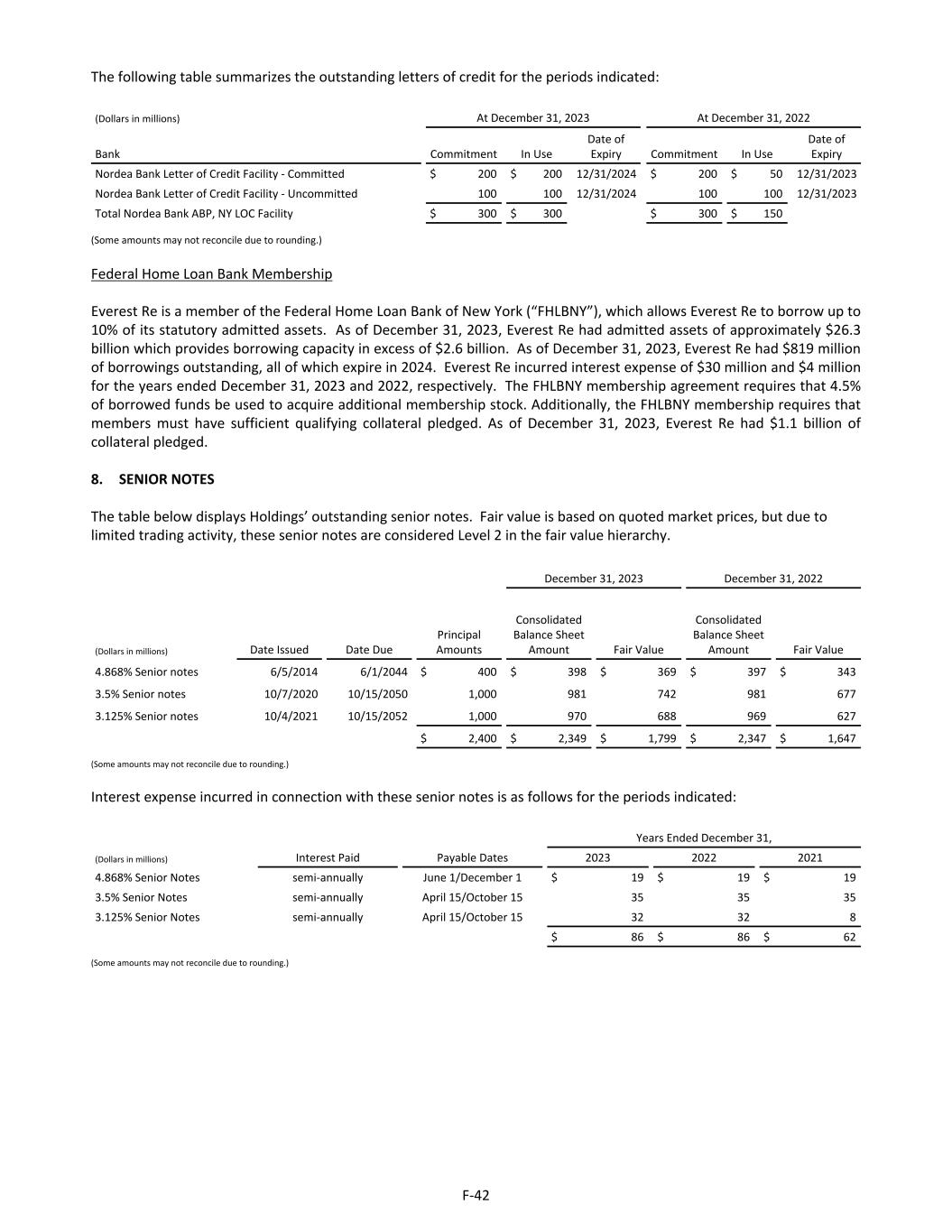
The following table summarizes the outstanding letters of credit for the periods indicated: (Dollars in millions) At December 31, 2023 At December 31, 2022 Bank Commitment In Use Date of Expiry Commitment In Use Date of Expiry Nordea Bank Letter of Credit Facility - Committed $ 200 $ 200 12/31/2024 $ 200 $ 50 12/31/2023 Nordea Bank Letter of Credit Facility - Uncommitted 100 100 12/31/2024 100 100 12/31/2023 Total Nordea Bank ABP, NY LOC Facility $ 300 $ 300 $ 300 $ 150 (Some amounts may not reconcile due to rounding.) Federal Home Loan Bank Membership Everest Re is a member of the Federal Home Loan Bank of New York (“FHLBNY”), which allows Everest Re to borrow up to 10% of its statutory admitted assets. As of December 31, 2023, Everest Re had admitted assets of approximately $26.3 billion which provides borrowing capacity in excess of $2.6 billion. As of December 31, 2023, Everest Re had $819 million of borrowings outstanding, all of which expire in 2024. Everest Re incurred interest expense of $30 million and $4 million for the years ended December 31, 2023 and 2022, respectively. The FHLBNY membership agreement requires that 4.5% of borrowed funds be used to acquire additional membership stock. Additionally, the FHLBNY membership requires that members must have sufficient qualifying collateral pledged. As of December 31, 2023, Everest Re had $1.1 billion of collateral pledged. 8. SENIOR NOTES The table below displays Holdings’ outstanding senior notes. Fair value is based on quoted market prices, but due to limited trading activity, these senior notes are considered Level 2 in the fair value hierarchy. December 31, 2023 December 31, 2022 (Dollars in millions) Date Issued Date Due Principal Amounts Consolidated Balance Sheet Amount Fair Value Consolidated Balance Sheet Amount Fair Value 4.868% Senior notes 6/5/2014 6/1/2044 $ 400 $ 398 $ 369 $ 397 $ 343 3.5% Senior notes 10/7/2020 10/15/2050 1,000 981 742 981 677 3.125% Senior notes 10/4/2021 10/15/2052 1,000 970 688 969 627 $ 2,400 $ 2,349 $ 1,799 $ 2,347 $ 1,647 (Some amounts may not reconcile due to rounding.) Interest expense incurred in connection with these senior notes is as follows for the periods indicated: Years Ended December 31, (Dollars in millions) Interest Paid Payable Dates 2023 2022 2021 4.868% Senior Notes semi-annually June 1/December 1 $ 19 $ 19 $ 19 3.5% Senior Notes semi-annually April 15/October 15 35 35 35 3.125% Senior Notes semi-annually April 15/October 15 32 32 8 $ 86 $ 86 $ 62 (Some amounts may not reconcile due to rounding.) F-42
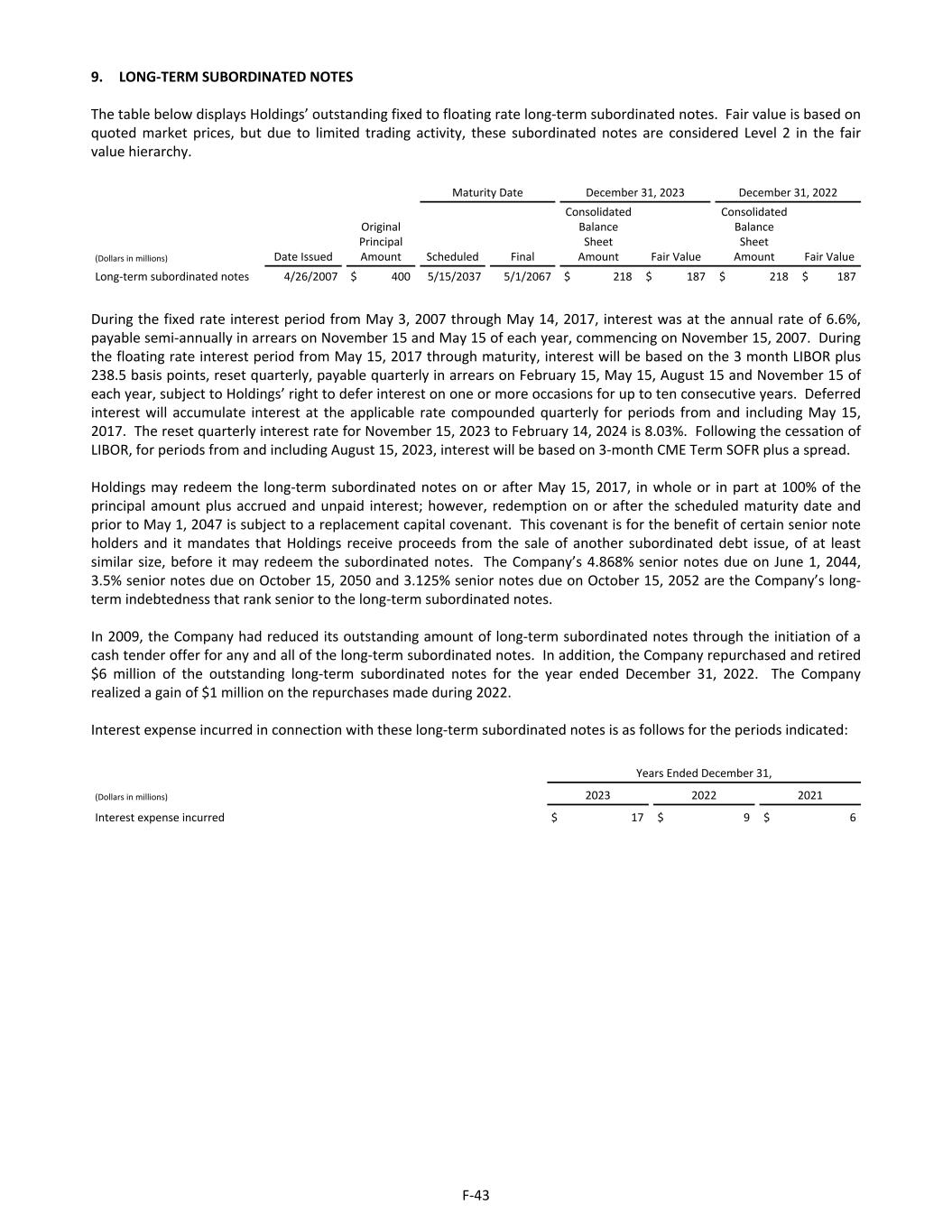
9. LONG-TERM SUBORDINATED NOTES The table below displays Holdings’ outstanding fixed to floating rate long-term subordinated notes. Fair value is based on quoted market prices, but due to limited trading activity, these subordinated notes are considered Level 2 in the fair value hierarchy. Maturity Date December 31, 2023 December 31, 2022 (Dollars in millions) Date Issued Original Principal Amount Scheduled Final Consolidated Balance Sheet Amount Fair Value Consolidated Balance Sheet Amount Fair Value Long-term subordinated notes 4/26/2007 $ 400 5/15/2037 5/1/2067 $ 218 $ 187 $ 218 $ 187 During the fixed rate interest period from May 3, 2007 through May 14, 2017, interest was at the annual rate of 6.6%, payable semi-annually in arrears on November 15 and May 15 of each year, commencing on November 15, 2007. During the floating rate interest period from May 15, 2017 through maturity, interest will be based on the 3 month LIBOR plus 238.5 basis points, reset quarterly, payable quarterly in arrears on February 15, May 15, August 15 and November 15 of each year, subject to Holdings’ right to defer interest on one or more occasions for up to ten consecutive years. Deferred interest will accumulate interest at the applicable rate compounded quarterly for periods from and including May 15, 2017. The reset quarterly interest rate for November 15, 2023 to February 14, 2024 is 8.03%. Following the cessation of LIBOR, for periods from and including August 15, 2023, interest will be based on 3-month CME Term SOFR plus a spread. Holdings may redeem the long-term subordinated notes on or after May 15, 2017, in whole or in part at 100% of the principal amount plus accrued and unpaid interest; however, redemption on or after the scheduled maturity date and prior to May 1, 2047 is subject to a replacement capital covenant. This covenant is for the benefit of certain senior note holders and it mandates that Holdings receive proceeds from the sale of another subordinated debt issue, of at least similar size, before it may redeem the subordinated notes. The Company’s 4.868% senior notes due on June 1, 2044, 3.5% senior notes due on October 15, 2050 and 3.125% senior notes due on October 15, 2052 are the Company’s long- term indebtedness that rank senior to the long-term subordinated notes. In 2009, the Company had reduced its outstanding amount of long-term subordinated notes through the initiation of a cash tender offer for any and all of the long-term subordinated notes. In addition, the Company repurchased and retired $6 million of the outstanding long-term subordinated notes for the year ended December 31, 2022. The Company realized a gain of $1 million on the repurchases made during 2022. Interest expense incurred in connection with these long-term subordinated notes is as follows for the periods indicated: Years Ended December 31, (Dollars in millions) 2023 2022 2021 Interest expense incurred $ 17 $ 9 $ 6 F-43
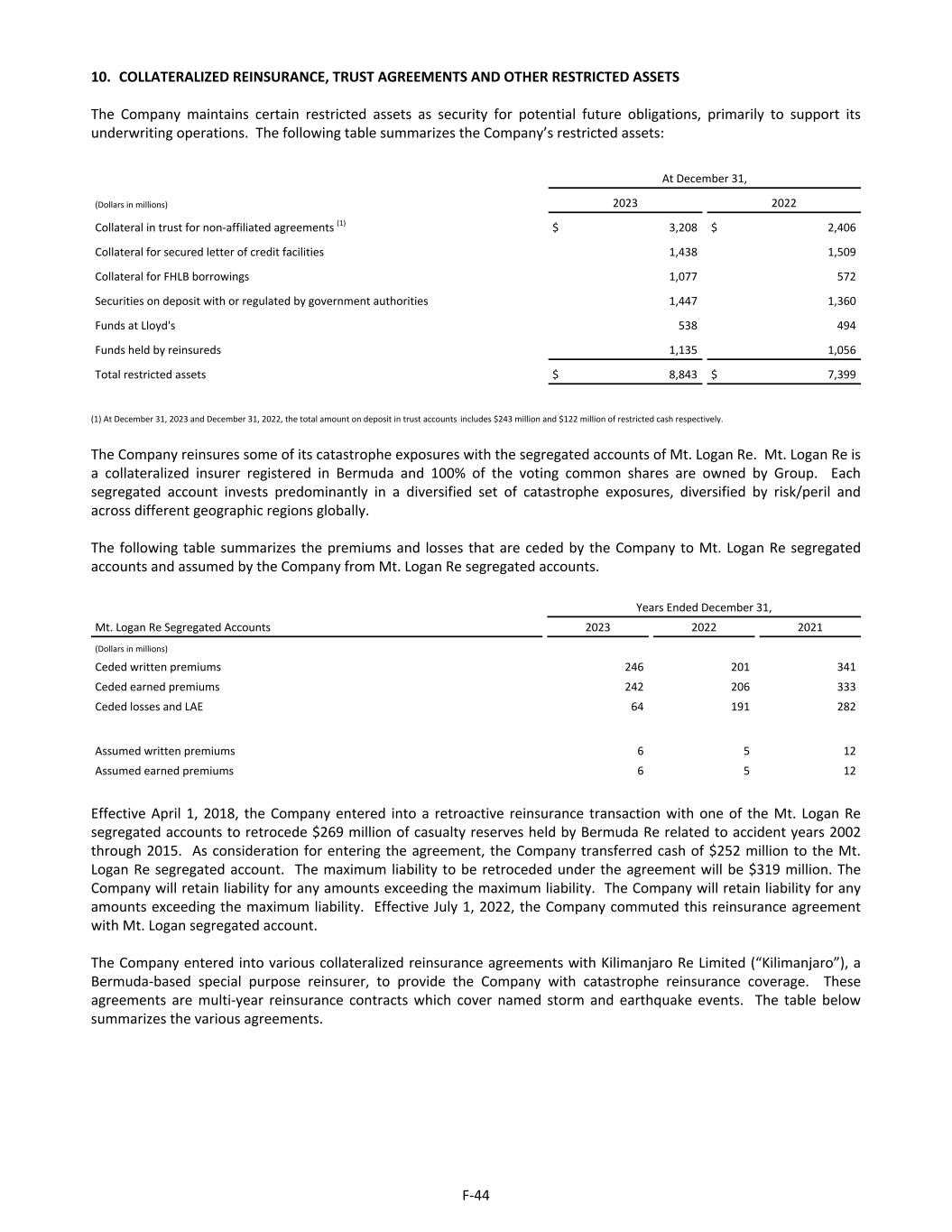
10. COLLATERALIZED REINSURANCE, TRUST AGREEMENTS AND OTHER RESTRICTED ASSETS The Company maintains certain restricted assets as security for potential future obligations, primarily to support its underwriting operations. The following table summarizes the Company’s restricted assets: At December 31, (Dollars in millions) 2023 2022 Collateral in trust for non-affiliated agreements (1) $ 3,208 $ 2,406 Collateral for secured letter of credit facilities 1,438 1,509 Collateral for FHLB borrowings 1,077 572 Securities on deposit with or regulated by government authorities 1,447 1,360 Funds at Lloyd's 538 494 Funds held by reinsureds 1,135 1,056 Total restricted assets $ 8,843 $ 7,399 (1) At December 31, 2023 and December 31, 2022, the total amount on deposit in trust accounts includes $243 million and $122 million of restricted cash respectively. The Company reinsures some of its catastrophe exposures with the segregated accounts of Mt. Logan Re. Mt. Logan Re is a collateralized insurer registered in Bermuda and 100% of the voting common shares are owned by Group. Each segregated account invests predominantly in a diversified set of catastrophe exposures, diversified by risk/peril and across different geographic regions globally. The following table summarizes the premiums and losses that are ceded by the Company to Mt. Logan Re segregated accounts and assumed by the Company from Mt. Logan Re segregated accounts. Years Ended December 31, Mt. Logan Re Segregated Accounts 2023 2022 2021 (Dollars in millions) Ceded written premiums 246 201 341 Ceded earned premiums 242 206 333 Ceded losses and LAE 64 191 282 Assumed written premiums 6 5 12 Assumed earned premiums 6 5 12 Effective April 1, 2018, the Company entered into a retroactive reinsurance transaction with one of the Mt. Logan Re segregated accounts to retrocede $269 million of casualty reserves held by Bermuda Re related to accident years 2002 through 2015. As consideration for entering the agreement, the Company transferred cash of $252 million to the Mt. Logan Re segregated account. The maximum liability to be retroceded under the agreement will be $319 million. The Company will retain liability for any amounts exceeding the maximum liability. The Company will retain liability for any amounts exceeding the maximum liability. Effective July 1, 2022, the Company commuted this reinsurance agreement with Mt. Logan segregated account. The Company entered into various collateralized reinsurance agreements with Kilimanjaro Re Limited (“Kilimanjaro”), a Bermuda-based special purpose reinsurer, to provide the Company with catastrophe reinsurance coverage. These agreements are multi-year reinsurance contracts which cover named storm and earthquake events. The table below summarizes the various agreements. F-44
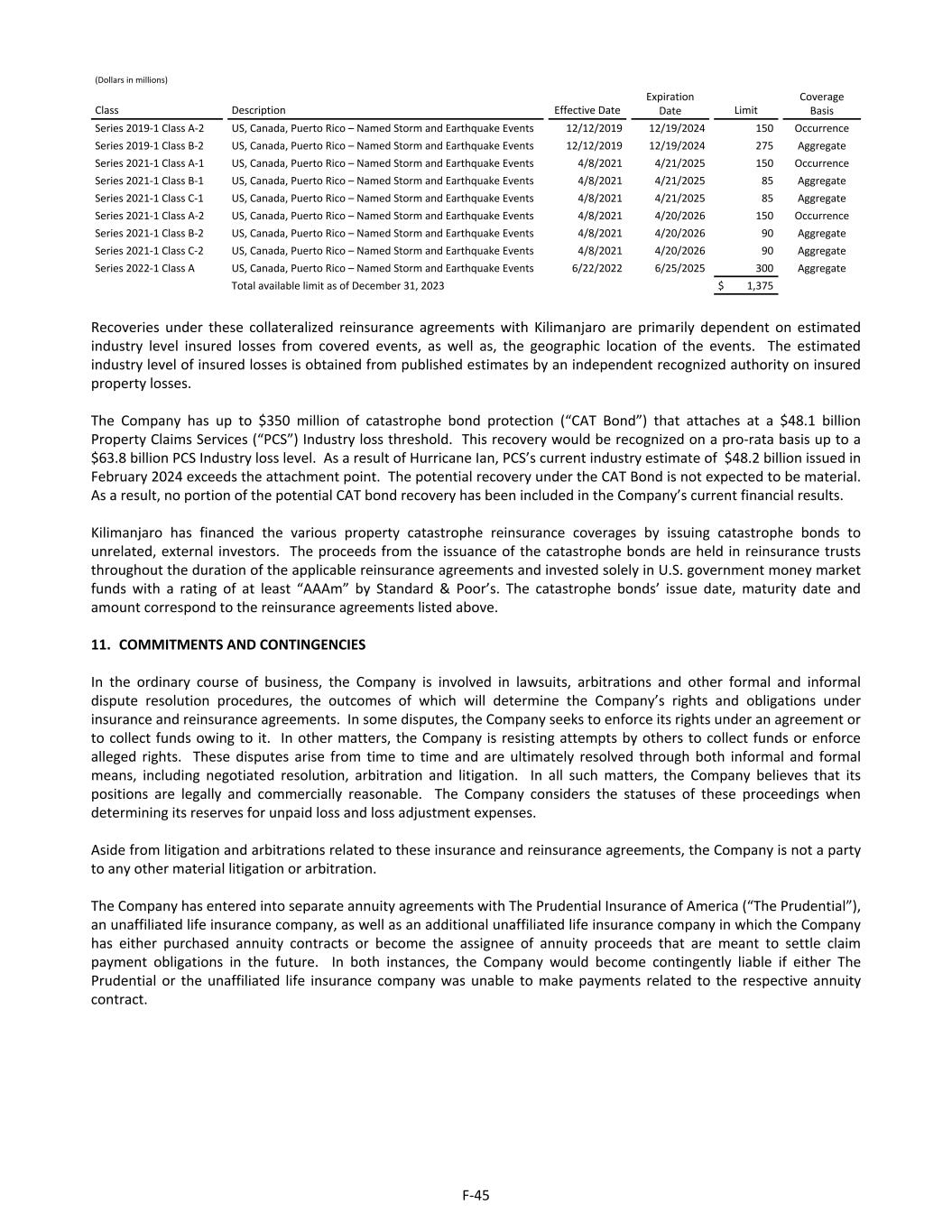
(Dollars in millions) Class Description Effective Date Expiration Date Limit Coverage Basis Series 2019-1 Class A-2 US, Canada, Puerto Rico – Named Storm and Earthquake Events 12/12/2019 12/19/2024 150 Occurrence Series 2019-1 Class B-2 US, Canada, Puerto Rico – Named Storm and Earthquake Events 12/12/2019 12/19/2024 275 Aggregate Series 2021-1 Class A-1 US, Canada, Puerto Rico – Named Storm and Earthquake Events 4/8/2021 4/21/2025 150 Occurrence Series 2021-1 Class B-1 US, Canada, Puerto Rico – Named Storm and Earthquake Events 4/8/2021 4/21/2025 85 Aggregate Series 2021-1 Class C-1 US, Canada, Puerto Rico – Named Storm and Earthquake Events 4/8/2021 4/21/2025 85 Aggregate Series 2021-1 Class A-2 US, Canada, Puerto Rico – Named Storm and Earthquake Events 4/8/2021 4/20/2026 150 Occurrence Series 2021-1 Class B-2 US, Canada, Puerto Rico – Named Storm and Earthquake Events 4/8/2021 4/20/2026 90 Aggregate Series 2021-1 Class C-2 US, Canada, Puerto Rico – Named Storm and Earthquake Events 4/8/2021 4/20/2026 90 Aggregate Series 2022-1 Class A US, Canada, Puerto Rico – Named Storm and Earthquake Events 6/22/2022 6/25/2025 300 Aggregate Total available limit as of December 31, 2023 $ 1,375 Recoveries under these collateralized reinsurance agreements with Kilimanjaro are primarily dependent on estimated industry level insured losses from covered events, as well as, the geographic location of the events. The estimated industry level of insured losses is obtained from published estimates by an independent recognized authority on insured property losses. The Company has up to $350 million of catastrophe bond protection (“CAT Bond”) that attaches at a $48.1 billion Property Claims Services (“PCS”) Industry loss threshold. This recovery would be recognized on a pro-rata basis up to a $63.8 billion PCS Industry loss level. As a result of Hurricane Ian, PCS’s current industry estimate of $48.2 billion issued in February 2024 exceeds the attachment point. The potential recovery under the CAT Bond is not expected to be material. As a result, no portion of the potential CAT bond recovery has been included in the Company’s current financial results. Kilimanjaro has financed the various property catastrophe reinsurance coverages by issuing catastrophe bonds to unrelated, external investors. The proceeds from the issuance of the catastrophe bonds are held in reinsurance trusts throughout the duration of the applicable reinsurance agreements and invested solely in U.S. government money market funds with a rating of at least “AAAm” by Standard & Poor’s. The catastrophe bonds’ issue date, maturity date and amount correspond to the reinsurance agreements listed above. 11. COMMITMENTS AND CONTINGENCIES In the ordinary course of business, the Company is involved in lawsuits, arbitrations and other formal and informal dispute resolution procedures, the outcomes of which will determine the Company’s rights and obligations under insurance and reinsurance agreements. In some disputes, the Company seeks to enforce its rights under an agreement or to collect funds owing to it. In other matters, the Company is resisting attempts by others to collect funds or enforce alleged rights. These disputes arise from time to time and are ultimately resolved through both informal and formal means, including negotiated resolution, arbitration and litigation. In all such matters, the Company believes that its positions are legally and commercially reasonable. The Company considers the statuses of these proceedings when determining its reserves for unpaid loss and loss adjustment expenses. Aside from litigation and arbitrations related to these insurance and reinsurance agreements, the Company is not a party to any other material litigation or arbitration. The Company has entered into separate annuity agreements with The Prudential Insurance of America (“The Prudential”), an unaffiliated life insurance company, as well as an additional unaffiliated life insurance company in which the Company has either purchased annuity contracts or become the assignee of annuity proceeds that are meant to settle claim payment obligations in the future. In both instances, the Company would become contingently liable if either The Prudential or the unaffiliated life insurance company was unable to make payments related to the respective annuity contract. F-45

The table below presents the estimated cost to replace all such annuities for which the Company was contingently liable for the periods indicated: At December 31, (Dollars in millions) 2023 2022 The Prudential $ 136 $ 137 Other unaffiliated life insurance company $ 34 $ 34 12. LEASES The Company enters into lease agreements for real estate that is primarily used for office space in the ordinary course of business. These leases are accounted for as operating leases, whereby lease expense is recognized on a straight-line basis over the term of the lease. Most leases include an option to extend or renew the lease term. The exercise of the renewal is at the Company’s discretion. The operating lease liability includes lease payments related to options to extend or renew the lease term if the Company is reasonably certain of exercise those options. The Company, in determining the present value of lease payments utilizes either the rate implicit in the lease if that rate is readily determinable or the Company’s incremental secured borrowing rate commensurate with terms of the underlying lease. Supplemental information related to operating leases is as follows for the periods indicated: Year Ended December 31, (Dollars in millions) 2023 2022 Lease expense incurred: Operating lease cost $ 30 $ 28 At December 31, (Dollars in millions) 2023 2022 Operating lease right of use assets (1) $ 123 $ 128 Operating lease liabilities (1) 143 147 (1) Operating lease right of use assets and operating lease liabilities are included within other assets and other liabilities on the Company’s consolidated balance sheets, respectively. Year Ended December 31, (Dollars in millions) 2023 2022 Operating cash flows from operating leases $ (22) $ (20) At December 31, 2023 2022 Weighted average remaining operating lease term 9.8 years 10.8 years Weighted average discount rate on operating leases 4.03 % 4.08 % Maturities of the existing lease liabilities are expected to occur as follows: (Dollars in millions) 2024 $ 24 2025 21 2026 19 2027 17 2028 15 Thereafter 83 Undiscounted lease payments 178 Less: present value adjustment 36 Total operating lease liability $ 143 F-46
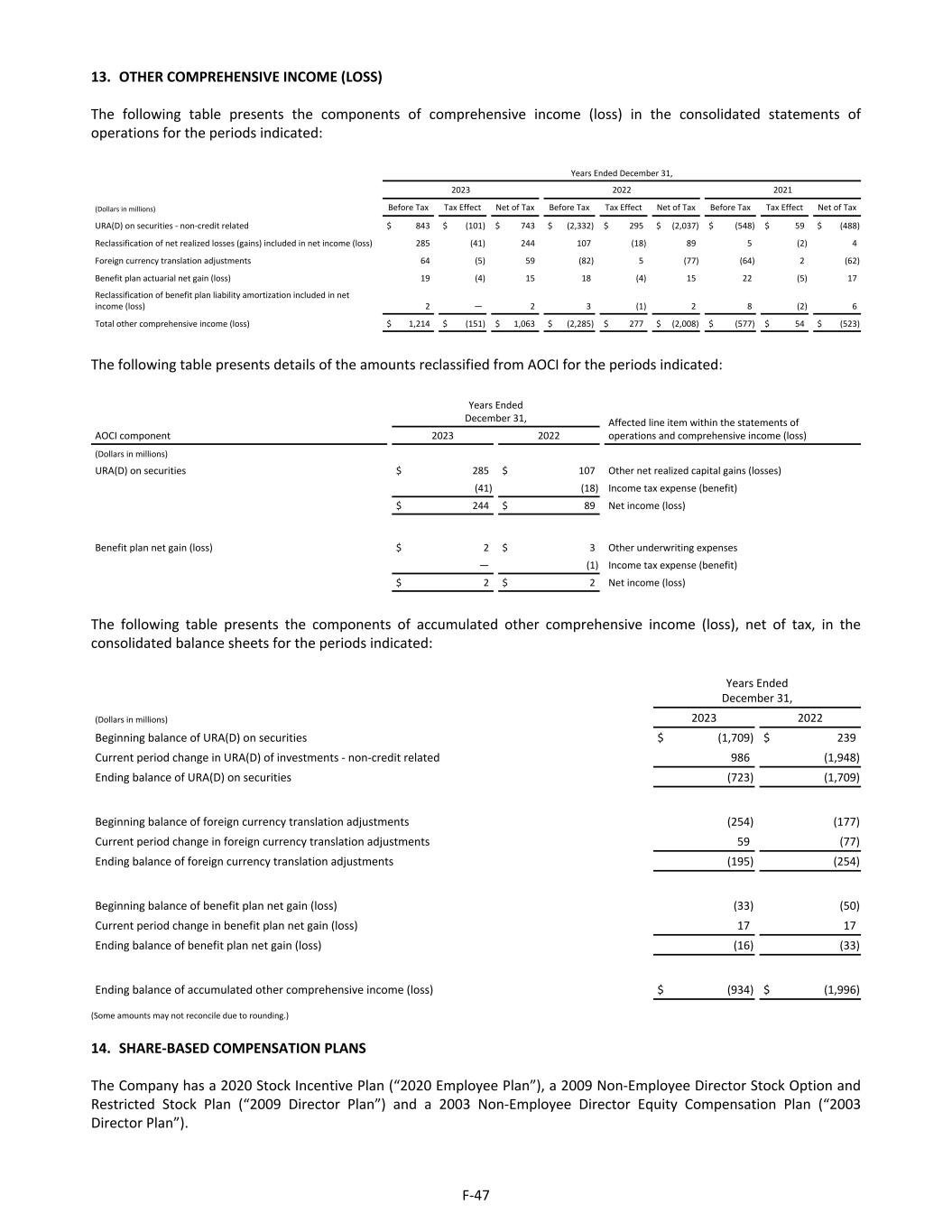
13. OTHER COMPREHENSIVE INCOME (LOSS) The following table presents the components of comprehensive income (loss) in the consolidated statements of operations for the periods indicated: Years Ended December 31, 2023 2022 2021 (Dollars in millions) Before Tax Tax Effect Net of Tax Before Tax Tax Effect Net of Tax Before Tax Tax Effect Net of Tax URA(D) on securities - non-credit related $ 843 $ (101) $ 743 $ (2,332) $ 295 $ (2,037) $ (548) $ 59 $ (488) Reclassification of net realized losses (gains) included in net income (loss) 285 (41) 244 107 (18) 89 5 (2) 4 Foreign currency translation adjustments 64 (5) 59 (82) 5 (77) (64) 2 (62) Benefit plan actuarial net gain (loss) 19 (4) 15 18 (4) 15 22 (5) 17 Reclassification of benefit plan liability amortization included in net income (loss) 2 — 2 3 (1) 2 8 (2) 6 Total other comprehensive income (loss) $ 1,214 $ (151) $ 1,063 $ (2,285) $ 277 $ (2,008) $ (577) $ 54 $ (523) The following table presents details of the amounts reclassified from AOCI for the periods indicated: Years Ended December 31, Affected line item within the statements of operations and comprehensive income (loss)AOCI component 2023 2022 (Dollars in millions) URA(D) on securities $ 285 $ 107 Other net realized capital gains (losses) (41) (18) Income tax expense (benefit) $ 244 $ 89 Net income (loss) Benefit plan net gain (loss) $ 2 $ 3 Other underwriting expenses — (1) Income tax expense (benefit) $ 2 $ 2 Net income (loss) The following table presents the components of accumulated other comprehensive income (loss), net of tax, in the consolidated balance sheets for the periods indicated: Years Ended December 31, (Dollars in millions) 2023 2022 Beginning balance of URA(D) on securities $ (1,709) $ 239 Current period change in URA(D) of investments - non-credit related 986 (1,948) Ending balance of URA(D) on securities (723) (1,709) Beginning balance of foreign currency translation adjustments (254) (177) Current period change in foreign currency translation adjustments 59 (77) Ending balance of foreign currency translation adjustments (195) (254) Beginning balance of benefit plan net gain (loss) (33) (50) Current period change in benefit plan net gain (loss) 17 17 Ending balance of benefit plan net gain (loss) (16) (33) Ending balance of accumulated other comprehensive income (loss) $ (934) $ (1,996) (Some amounts may not reconcile due to rounding.) 14. SHARE-BASED COMPENSATION PLANS The Company has a 2020 Stock Incentive Plan (“2020 Employee Plan”), a 2009 Non-Employee Director Stock Option and Restricted Stock Plan (“2009 Director Plan”) and a 2003 Non-Employee Director Equity Compensation Plan (“2003 Director Plan”). F-47
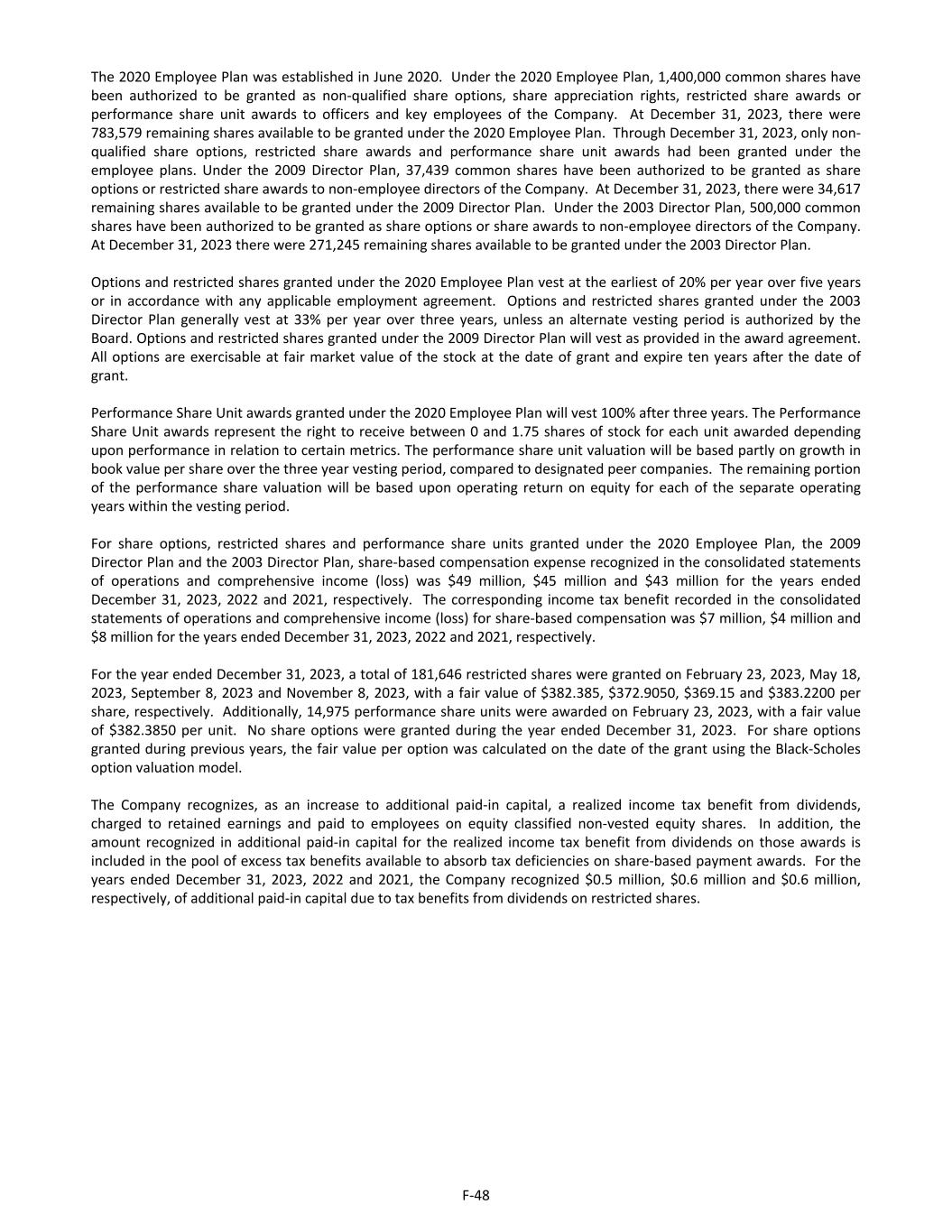
The 2020 Employee Plan was established in June 2020. Under the 2020 Employee Plan, 1,400,000 common shares have been authorized to be granted as non-qualified share options, share appreciation rights, restricted share awards or performance share unit awards to officers and key employees of the Company. At December 31, 2023, there were 783,579 remaining shares available to be granted under the 2020 Employee Plan. Through December 31, 2023, only non- qualified share options, restricted share awards and performance share unit awards had been granted under the employee plans. Under the 2009 Director Plan, 37,439 common shares have been authorized to be granted as share options or restricted share awards to non-employee directors of the Company. At December 31, 2023, there were 34,617 remaining shares available to be granted under the 2009 Director Plan. Under the 2003 Director Plan, 500,000 common shares have been authorized to be granted as share options or share awards to non-employee directors of the Company. At December 31, 2023 there were 271,245 remaining shares available to be granted under the 2003 Director Plan. Options and restricted shares granted under the 2020 Employee Plan vest at the earliest of 20% per year over five years or in accordance with any applicable employment agreement. Options and restricted shares granted under the 2003 Director Plan generally vest at 33% per year over three years, unless an alternate vesting period is authorized by the Board. Options and restricted shares granted under the 2009 Director Plan will vest as provided in the award agreement. All options are exercisable at fair market value of the stock at the date of grant and expire ten years after the date of grant. Performance Share Unit awards granted under the 2020 Employee Plan will vest 100% after three years. The Performance Share Unit awards represent the right to receive between 0 and 1.75 shares of stock for each unit awarded depending upon performance in relation to certain metrics. The performance share unit valuation will be based partly on growth in book value per share over the three year vesting period, compared to designated peer companies. The remaining portion of the performance share valuation will be based upon operating return on equity for each of the separate operating years within the vesting period. For share options, restricted shares and performance share units granted under the 2020 Employee Plan, the 2009 Director Plan and the 2003 Director Plan, share-based compensation expense recognized in the consolidated statements of operations and comprehensive income (loss) was $49 million, $45 million and $43 million for the years ended December 31, 2023, 2022 and 2021, respectively. The corresponding income tax benefit recorded in the consolidated statements of operations and comprehensive income (loss) for share-based compensation was $7 million, $4 million and $8 million for the years ended December 31, 2023, 2022 and 2021, respectively. For the year ended December 31, 2023, a total of 181,646 restricted shares were granted on February 23, 2023, May 18, 2023, September 8, 2023 and November 8, 2023, with a fair value of $382.385, $372.9050, $369.15 and $383.2200 per share, respectively. Additionally, 14,975 performance share units were awarded on February 23, 2023, with a fair value of $382.3850 per unit. No share options were granted during the year ended December 31, 2023. For share options granted during previous years, the fair value per option was calculated on the date of the grant using the Black-Scholes option valuation model. The Company recognizes, as an increase to additional paid-in capital, a realized income tax benefit from dividends, charged to retained earnings and paid to employees on equity classified non-vested equity shares. In addition, the amount recognized in additional paid-in capital for the realized income tax benefit from dividends on those awards is included in the pool of excess tax benefits available to absorb tax deficiencies on share-based payment awards. For the years ended December 31, 2023, 2022 and 2021, the Company recognized $0.5 million, $0.6 million and $0.6 million, respectively, of additional paid-in capital due to tax benefits from dividends on restricted shares. F-48
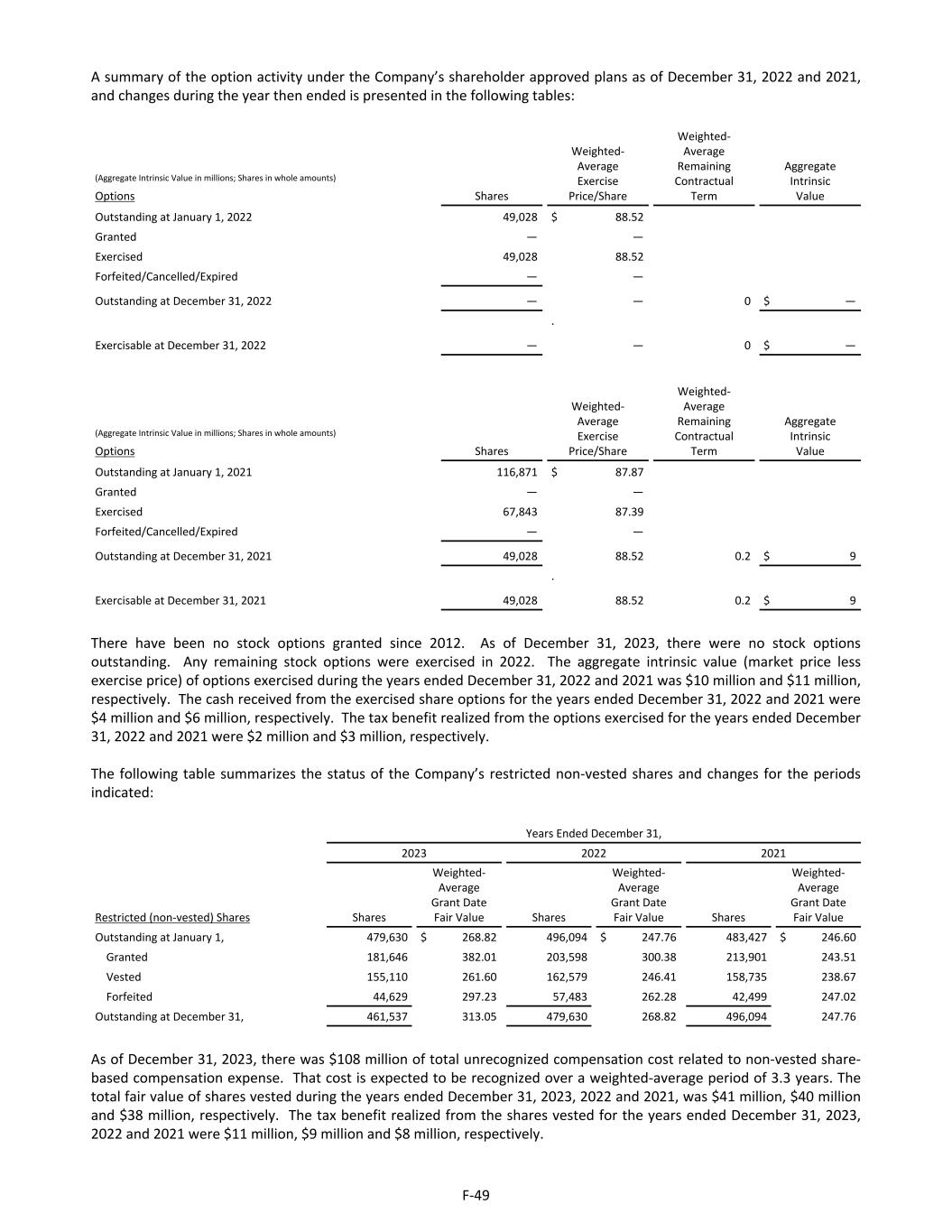
A summary of the option activity under the Company’s shareholder approved plans as of December 31, 2022 and 2021, and changes during the year then ended is presented in the following tables: (Aggregate Intrinsic Value in millions; Shares in whole amounts) Shares Weighted- Average Exercise Price/Share Weighted- Average Remaining Contractual Term Aggregate Intrinsic ValueOptions Outstanding at January 1, 2022 49,028 $ 88.52 Granted — — Exercised 49,028 88.52 Forfeited/Cancelled/Expired — — Outstanding at December 31, 2022 — — 0 $ — . Exercisable at December 31, 2022 — — 0 $ — (Aggregate Intrinsic Value in millions; Shares in whole amounts) Shares Weighted- Average Exercise Price/Share Weighted- Average Remaining Contractual Term Aggregate Intrinsic ValueOptions Outstanding at January 1, 2021 116,871 $ 87.87 Granted — — Exercised 67,843 87.39 Forfeited/Cancelled/Expired — — Outstanding at December 31, 2021 49,028 88.52 0.2 $ 9 . Exercisable at December 31, 2021 49,028 88.52 0.2 $ 9 There have been no stock options granted since 2012. As of December 31, 2023, there were no stock options outstanding. Any remaining stock options were exercised in 2022. The aggregate intrinsic value (market price less exercise price) of options exercised during the years ended December 31, 2022 and 2021 was $10 million and $11 million, respectively. The cash received from the exercised share options for the years ended December 31, 2022 and 2021 were $4 million and $6 million, respectively. The tax benefit realized from the options exercised for the years ended December 31, 2022 and 2021 were $2 million and $3 million, respectively. The following table summarizes the status of the Company’s restricted non-vested shares and changes for the periods indicated: Years Ended December 31, 2023 2022 2021 Restricted (non-vested) Shares Shares Weighted- Average Grant Date Fair Value Shares Weighted- Average Grant Date Fair Value Shares Weighted- Average Grant Date Fair Value Outstanding at January 1, 479,630 $ 268.82 496,094 $ 247.76 483,427 $ 246.60 Granted 181,646 382.01 203,598 300.38 213,901 243.51 Vested 155,110 261.60 162,579 246.41 158,735 238.67 Forfeited 44,629 297.23 57,483 262.28 42,499 247.02 Outstanding at December 31, 461,537 313.05 479,630 268.82 496,094 247.76 As of December 31, 2023, there was $108 million of total unrecognized compensation cost related to non-vested share- based compensation expense. That cost is expected to be recognized over a weighted-average period of 3.3 years. The total fair value of shares vested during the years ended December 31, 2023, 2022 and 2021, was $41 million, $40 million and $38 million, respectively. The tax benefit realized from the shares vested for the years ended December 31, 2023, 2022 and 2021 were $11 million, $9 million and $8 million, respectively. F-49
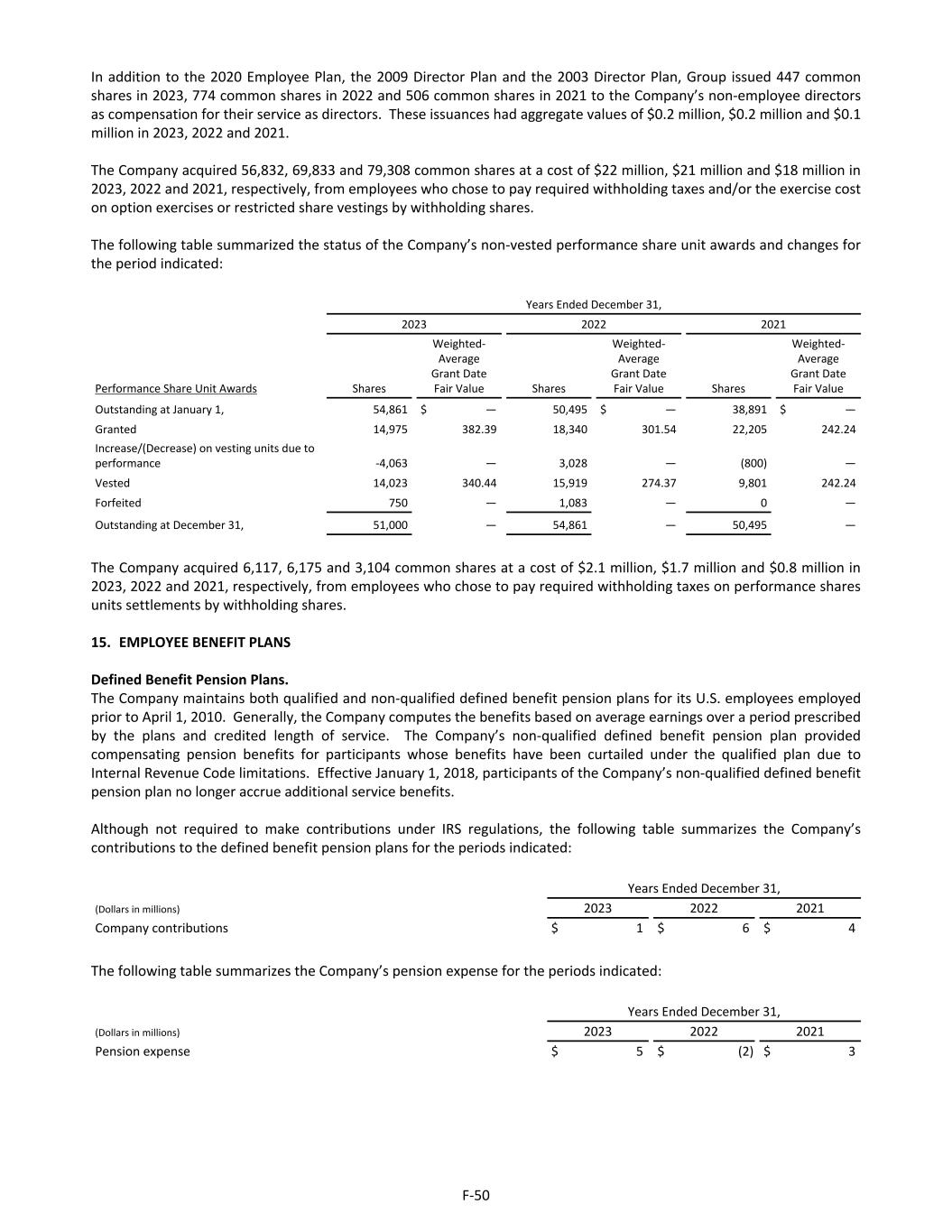
In addition to the 2020 Employee Plan, the 2009 Director Plan and the 2003 Director Plan, Group issued 447 common shares in 2023, 774 common shares in 2022 and 506 common shares in 2021 to the Company’s non-employee directors as compensation for their service as directors. These issuances had aggregate values of $0.2 million, $0.2 million and $0.1 million in 2023, 2022 and 2021. The Company acquired 56,832, 69,833 and 79,308 common shares at a cost of $22 million, $21 million and $18 million in 2023, 2022 and 2021, respectively, from employees who chose to pay required withholding taxes and/or the exercise cost on option exercises or restricted share vestings by withholding shares. The following table summarized the status of the Company’s non-vested performance share unit awards and changes for the period indicated: Years Ended December 31, 2023 2022 2021 Performance Share Unit Awards Shares Weighted- Average Grant Date Fair Value Shares Weighted- Average Grant Date Fair Value Shares Weighted- Average Grant Date Fair Value Outstanding at January 1, 54,861 $ — 50,495 $ — 38,891 $ — Granted 14,975 382.39 18,340 301.54 22,205 242.24 Increase/(Decrease) on vesting units due to performance -4,063 — 3,028 — (800) — Vested 14,023 340.44 15,919 274.37 9,801 242.24 Forfeited 750 — 1,083 — 0 — Outstanding at December 31, 51,000 — 54,861 — 50,495 — The Company acquired 6,117, 6,175 and 3,104 common shares at a cost of $2.1 million, $1.7 million and $0.8 million in 2023, 2022 and 2021, respectively, from employees who chose to pay required withholding taxes on performance shares units settlements by withholding shares. 15. EMPLOYEE BENEFIT PLANS Defined Benefit Pension Plans. The Company maintains both qualified and non-qualified defined benefit pension plans for its U.S. employees employed prior to April 1, 2010. Generally, the Company computes the benefits based on average earnings over a period prescribed by the plans and credited length of service. The Company’s non-qualified defined benefit pension plan provided compensating pension benefits for participants whose benefits have been curtailed under the qualified plan due to Internal Revenue Code limitations. Effective January 1, 2018, participants of the Company’s non-qualified defined benefit pension plan no longer accrue additional service benefits. Although not required to make contributions under IRS regulations, the following table summarizes the Company’s contributions to the defined benefit pension plans for the periods indicated: Years Ended December 31, (Dollars in millions) 2023 2022 2021 Company contributions $ 1 $ 6 $ 4 The following table summarizes the Company’s pension expense for the periods indicated: Years Ended December 31, (Dollars in millions) 2023 2022 2021 Pension expense $ 5 $ (2) $ 3 F-50
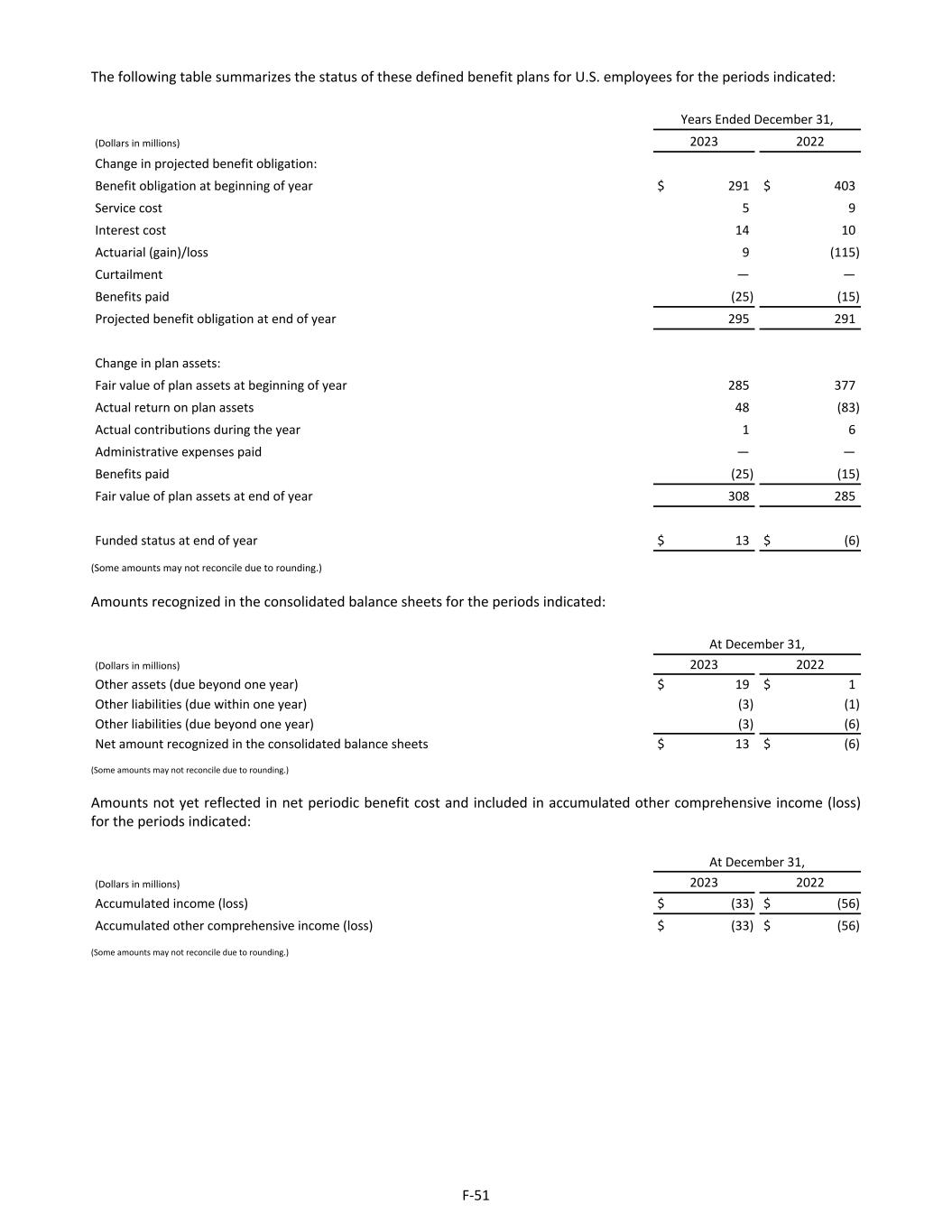
The following table summarizes the status of these defined benefit plans for U.S. employees for the periods indicated: Years Ended December 31, (Dollars in millions) 2023 2022 Change in projected benefit obligation: Benefit obligation at beginning of year $ 291 $ 403 Service cost 5 9 Interest cost 14 10 Actuarial (gain)/loss 9 (115) Curtailment — — Benefits paid (25) (15) Projected benefit obligation at end of year 295 291 Change in plan assets: Fair value of plan assets at beginning of year 285 377 Actual return on plan assets 48 (83) Actual contributions during the year 1 6 Administrative expenses paid — — Benefits paid (25) (15) Fair value of plan assets at end of year 308 285 Funded status at end of year $ 13 $ (6) (Some amounts may not reconcile due to rounding.) Amounts recognized in the consolidated balance sheets for the periods indicated: At December 31, (Dollars in millions) 2023 2022 Other assets (due beyond one year) $ 19 $ 1 Other liabilities (due within one year) (3) (1) Other liabilities (due beyond one year) (3) (6) Net amount recognized in the consolidated balance sheets $ 13 $ (6) (Some amounts may not reconcile due to rounding.) Amounts not yet reflected in net periodic benefit cost and included in accumulated other comprehensive income (loss) for the periods indicated: At December 31, (Dollars in millions) 2023 2022 Accumulated income (loss) $ (33) $ (56) Accumulated other comprehensive income (loss) $ (33) $ (56) (Some amounts may not reconcile due to rounding.) F-51
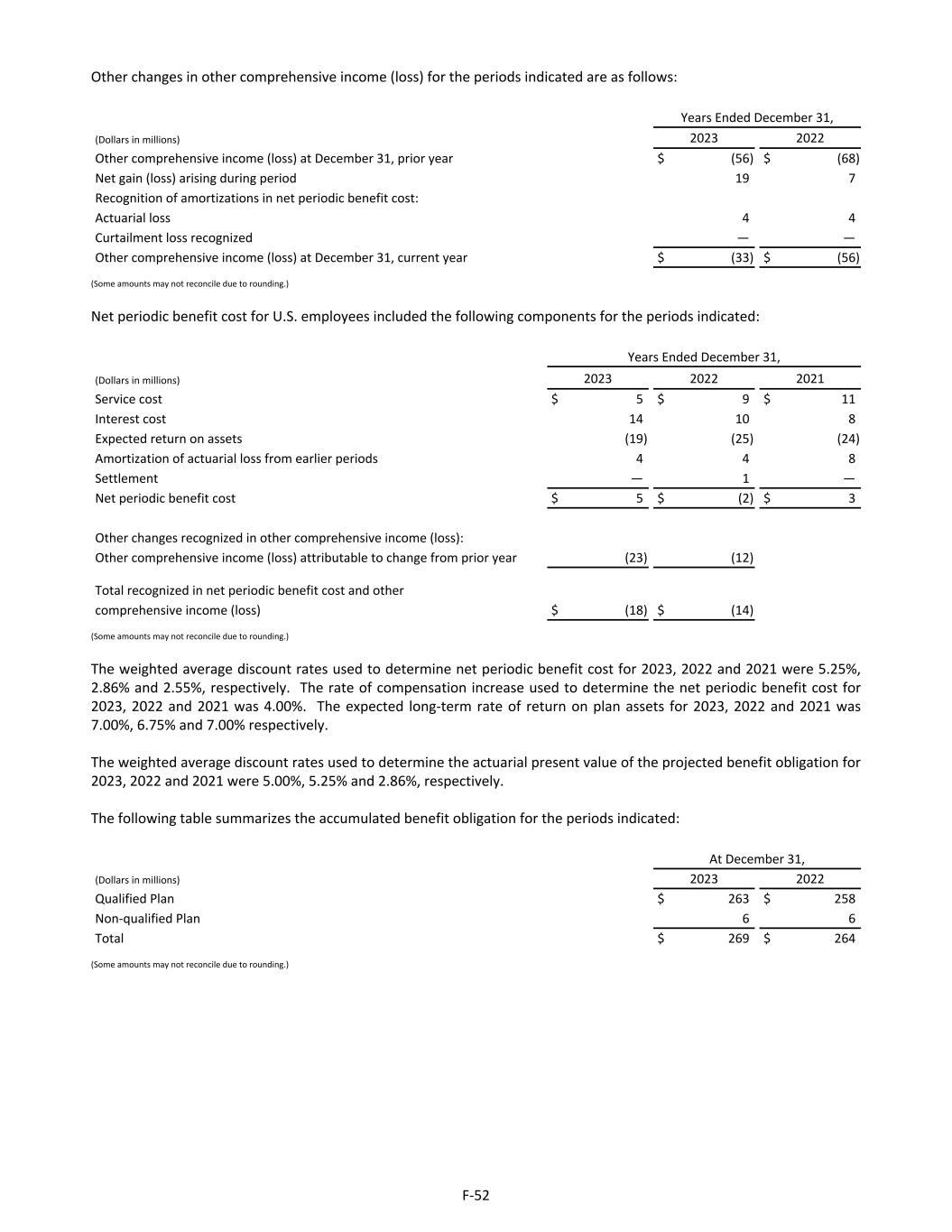
Other changes in other comprehensive income (loss) for the periods indicated are as follows: Years Ended December 31, (Dollars in millions) 2023 2022 Other comprehensive income (loss) at December 31, prior year $ (56) $ (68) Net gain (loss) arising during period 19 7 Recognition of amortizations in net periodic benefit cost: Actuarial loss 4 4 Curtailment loss recognized — — Other comprehensive income (loss) at December 31, current year $ (33) $ (56) (Some amounts may not reconcile due to rounding.) Net periodic benefit cost for U.S. employees included the following components for the periods indicated: Years Ended December 31, (Dollars in millions) 2023 2022 2021 Service cost $ 5 $ 9 $ 11 Interest cost 14 10 8 Expected return on assets (19) (25) (24) Amortization of actuarial loss from earlier periods 4 4 8 Settlement — 1 — Net periodic benefit cost $ 5 $ (2) $ 3 Other changes recognized in other comprehensive income (loss): Other comprehensive income (loss) attributable to change from prior year (23) (12) Total recognized in net periodic benefit cost and other comprehensive income (loss) $ (18) $ (14) (Some amounts may not reconcile due to rounding.) The weighted average discount rates used to determine net periodic benefit cost for 2023, 2022 and 2021 were 5.25%, 2.86% and 2.55%, respectively. The rate of compensation increase used to determine the net periodic benefit cost for 2023, 2022 and 2021 was 4.00%. The expected long-term rate of return on plan assets for 2023, 2022 and 2021 was 7.00%, 6.75% and 7.00% respectively. The weighted average discount rates used to determine the actuarial present value of the projected benefit obligation for 2023, 2022 and 2021 were 5.00%, 5.25% and 2.86%, respectively. The following table summarizes the accumulated benefit obligation for the periods indicated: At December 31, (Dollars in millions) 2023 2022 Qualified Plan $ 263 $ 258 Non-qualified Plan 6 6 Total $ 269 $ 264 (Some amounts may not reconcile due to rounding.) F-52
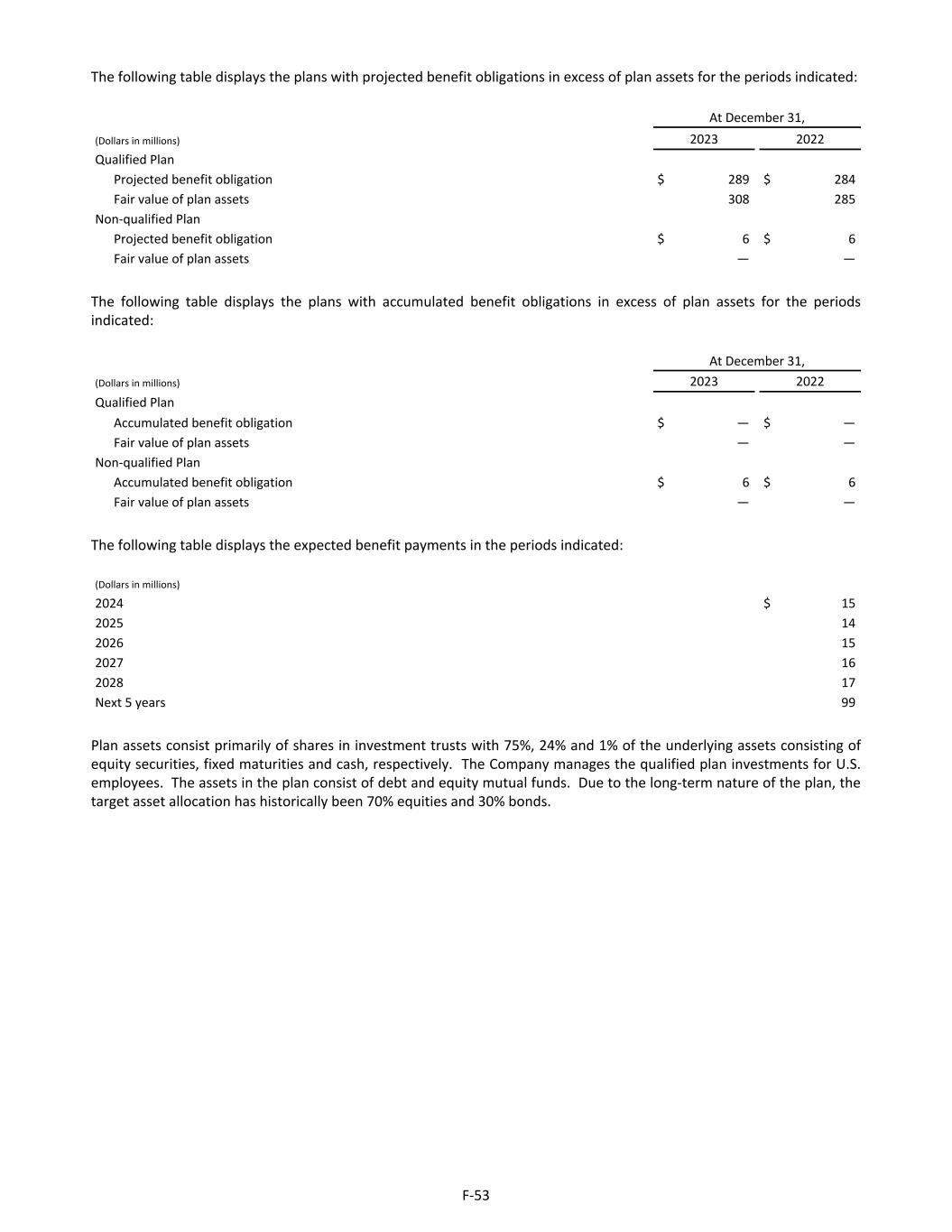
The following table displays the plans with projected benefit obligations in excess of plan assets for the periods indicated: At December 31, (Dollars in millions) 2023 2022 Qualified Plan Projected benefit obligation $ 289 $ 284 Fair value of plan assets 308 285 Non-qualified Plan Projected benefit obligation $ 6 $ 6 Fair value of plan assets — — The following table displays the plans with accumulated benefit obligations in excess of plan assets for the periods indicated: At December 31, (Dollars in millions) 2023 2022 Qualified Plan Accumulated benefit obligation $ — $ — Fair value of plan assets — — Non-qualified Plan Accumulated benefit obligation $ 6 $ 6 Fair value of plan assets — — The following table displays the expected benefit payments in the periods indicated: (Dollars in millions) 2024 $ 15 2025 14 2026 15 2027 16 2028 17 Next 5 years 99 Plan assets consist primarily of shares in investment trusts with 75%, 24% and 1% of the underlying assets consisting of equity securities, fixed maturities and cash, respectively. The Company manages the qualified plan investments for U.S. employees. The assets in the plan consist of debt and equity mutual funds. Due to the long-term nature of the plan, the target asset allocation has historically been 70% equities and 30% bonds. F-53
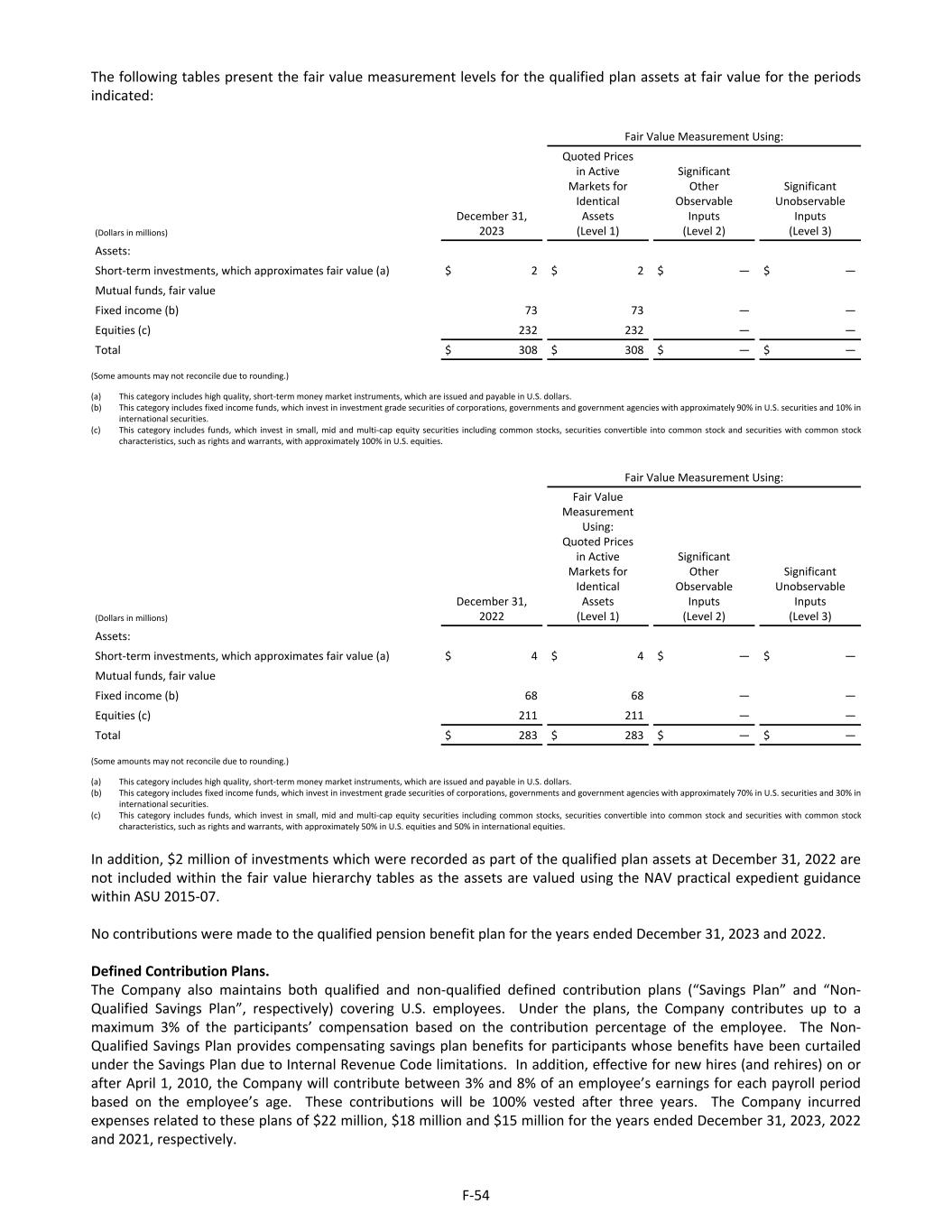
The following tables present the fair value measurement levels for the qualified plan assets at fair value for the periods indicated: Fair Value Measurement Using: (Dollars in millions) December 31, 2023 Quoted Prices in Active Markets for Identical Assets (Level 1) Significant Other Observable Inputs (Level 2) Significant Unobservable Inputs (Level 3) Assets: Short-term investments, which approximates fair value (a) $ 2 $ 2 $ — $ — Mutual funds, fair value Fixed income (b) 73 73 — — Equities (c) 232 232 — — Total $ 308 $ 308 $ — $ — (Some amounts may not reconcile due to rounding.) (a) This category includes high quality, short-term money market instruments, which are issued and payable in U.S. dollars. (b) This category includes fixed income funds, which invest in investment grade securities of corporations, governments and government agencies with approximately 90% in U.S. securities and 10% in international securities. (c) This category includes funds, which invest in small, mid and multi-cap equity securities including common stocks, securities convertible into common stock and securities with common stock characteristics, such as rights and warrants, with approximately 100% in U.S. equities. Fair Value Measurement Using: (Dollars in millions) December 31, 2022 Fair Value Measurement Using: Quoted Prices in Active Markets for Identical Assets (Level 1) Significant Other Observable Inputs (Level 2) Significant Unobservable Inputs (Level 3) Assets: Short-term investments, which approximates fair value (a) $ 4 $ 4 $ — $ — Mutual funds, fair value Fixed income (b) 68 68 — — Equities (c) 211 211 — — Total $ 283 $ 283 $ — $ — (Some amounts may not reconcile due to rounding.) (a) This category includes high quality, short-term money market instruments, which are issued and payable in U.S. dollars. (b) This category includes fixed income funds, which invest in investment grade securities of corporations, governments and government agencies with approximately 70% in U.S. securities and 30% in international securities. (c) This category includes funds, which invest in small, mid and multi-cap equity securities including common stocks, securities convertible into common stock and securities with common stock characteristics, such as rights and warrants, with approximately 50% in U.S. equities and 50% in international equities. In addition, $2 million of investments which were recorded as part of the qualified plan assets at December 31, 2022 are not included within the fair value hierarchy tables as the assets are valued using the NAV practical expedient guidance within ASU 2015-07. No contributions were made to the qualified pension benefit plan for the years ended December 31, 2023 and 2022. Defined Contribution Plans. The Company also maintains both qualified and non-qualified defined contribution plans (“Savings Plan” and “Non- Qualified Savings Plan”, respectively) covering U.S. employees. Under the plans, the Company contributes up to a maximum 3% of the participants’ compensation based on the contribution percentage of the employee. The Non- Qualified Savings Plan provides compensating savings plan benefits for participants whose benefits have been curtailed under the Savings Plan due to Internal Revenue Code limitations. In addition, effective for new hires (and rehires) on or after April 1, 2010, the Company will contribute between 3% and 8% of an employee’s earnings for each payroll period based on the employee’s age. These contributions will be 100% vested after three years. The Company incurred expenses related to these plans of $22 million, $18 million and $15 million for the years ended December 31, 2023, 2022 and 2021, respectively. F-54
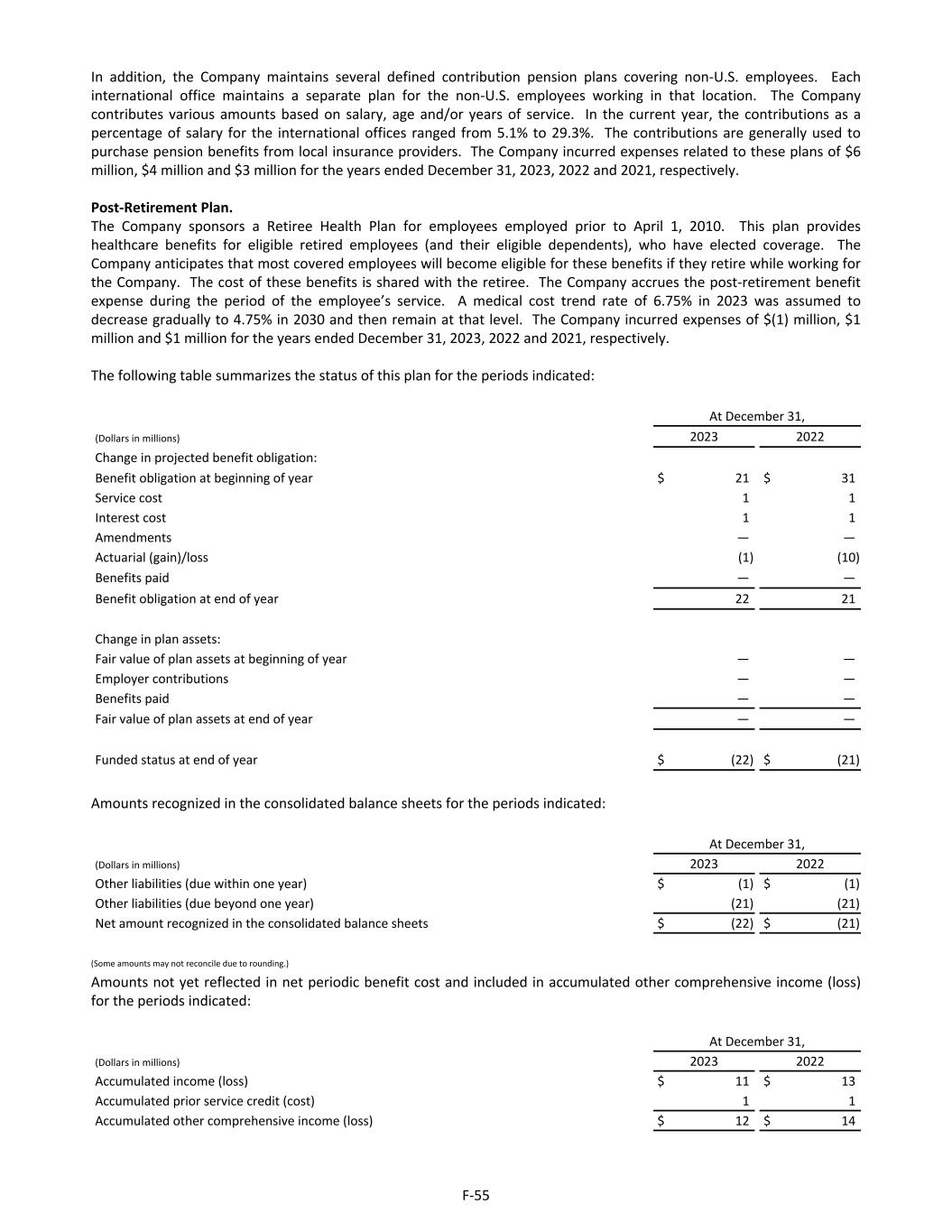
In addition, the Company maintains several defined contribution pension plans covering non-U.S. employees. Each international office maintains a separate plan for the non-U.S. employees working in that location. The Company contributes various amounts based on salary, age and/or years of service. In the current year, the contributions as a percentage of salary for the international offices ranged from 5.1% to 29.3%. The contributions are generally used to purchase pension benefits from local insurance providers. The Company incurred expenses related to these plans of $6 million, $4 million and $3 million for the years ended December 31, 2023, 2022 and 2021, respectively. Post-Retirement Plan. The Company sponsors a Retiree Health Plan for employees employed prior to April 1, 2010. This plan provides healthcare benefits for eligible retired employees (and their eligible dependents), who have elected coverage. The Company anticipates that most covered employees will become eligible for these benefits if they retire while working for the Company. The cost of these benefits is shared with the retiree. The Company accrues the post-retirement benefit expense during the period of the employee’s service. A medical cost trend rate of 6.75% in 2023 was assumed to decrease gradually to 4.75% in 2030 and then remain at that level. The Company incurred expenses of $(1) million, $1 million and $1 million for the years ended December 31, 2023, 2022 and 2021, respectively. The following table summarizes the status of this plan for the periods indicated: At December 31, (Dollars in millions) 2023 2022 Change in projected benefit obligation: Benefit obligation at beginning of year $ 21 $ 31 Service cost 1 1 Interest cost 1 1 Amendments — — Actuarial (gain)/loss (1) (10) Benefits paid — — Benefit obligation at end of year 22 21 Change in plan assets: Fair value of plan assets at beginning of year — — Employer contributions — — Benefits paid — — Fair value of plan assets at end of year — — Funded status at end of year $ (22) $ (21) Amounts recognized in the consolidated balance sheets for the periods indicated: At December 31, (Dollars in millions) 2023 2022 Other liabilities (due within one year) $ (1) $ (1) Other liabilities (due beyond one year) (21) (21) Net amount recognized in the consolidated balance sheets $ (22) $ (21) (Some amounts may not reconcile due to rounding.) Amounts not yet reflected in net periodic benefit cost and included in accumulated other comprehensive income (loss) for the periods indicated: At December 31, (Dollars in millions) 2023 2022 Accumulated income (loss) $ 11 $ 13 Accumulated prior service credit (cost) 1 1 Accumulated other comprehensive income (loss) $ 12 $ 14 F-55
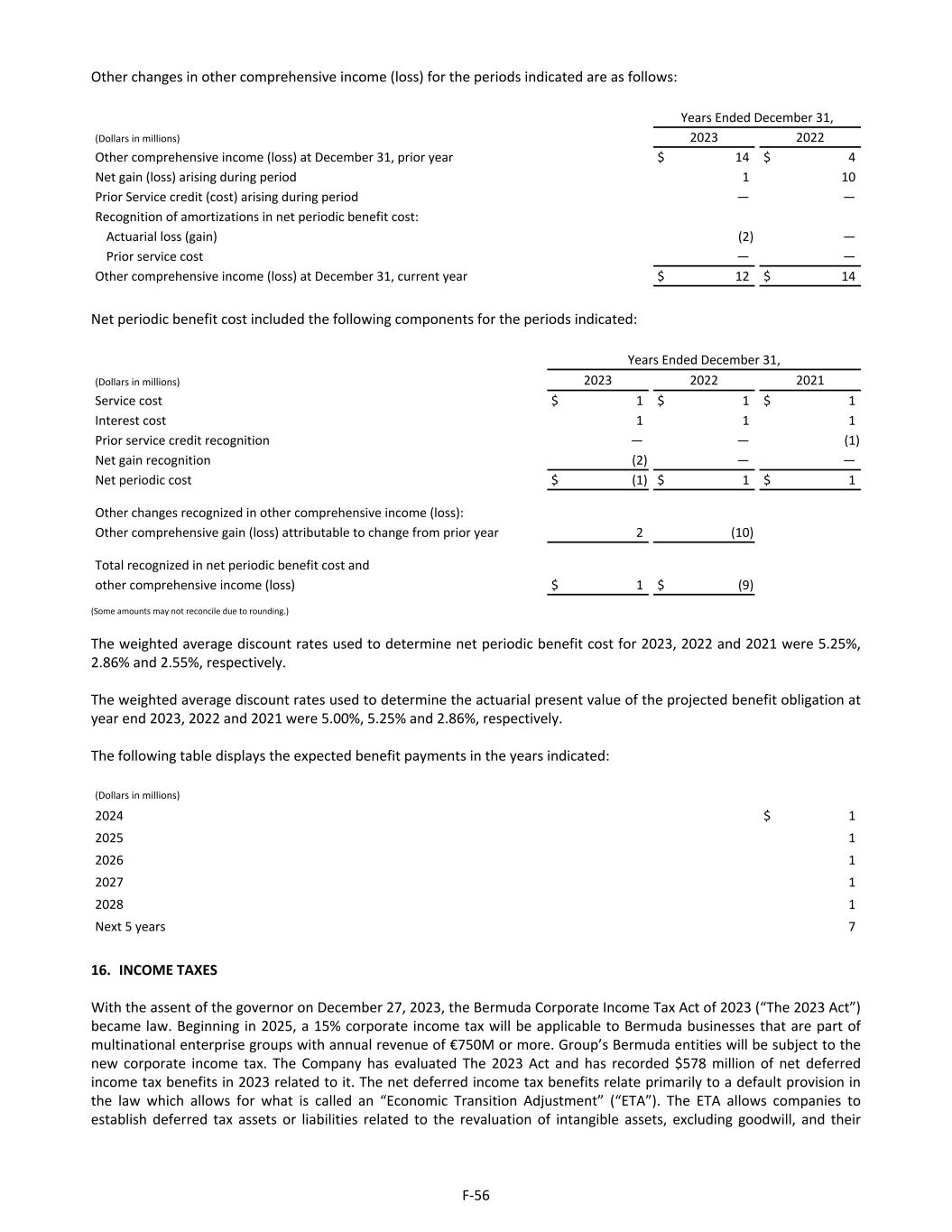
Other changes in other comprehensive income (loss) for the periods indicated are as follows: Years Ended December 31, (Dollars in millions) 2023 2022 Other comprehensive income (loss) at December 31, prior year $ 14 $ 4 Net gain (loss) arising during period 1 10 Prior Service credit (cost) arising during period — — Recognition of amortizations in net periodic benefit cost: Actuarial loss (gain) (2) — Prior service cost — — Other comprehensive income (loss) at December 31, current year $ 12 $ 14 Net periodic benefit cost included the following components for the periods indicated: Years Ended December 31, (Dollars in millions) 2023 2022 2021 Service cost $ 1 $ 1 $ 1 Interest cost 1 1 1 Prior service credit recognition — — (1) Net gain recognition (2) — — Net periodic cost $ (1) $ 1 $ 1 Other changes recognized in other comprehensive income (loss): Other comprehensive gain (loss) attributable to change from prior year 2 (10) Total recognized in net periodic benefit cost and other comprehensive income (loss) $ 1 $ (9) (Some amounts may not reconcile due to rounding.) The weighted average discount rates used to determine net periodic benefit cost for 2023, 2022 and 2021 were 5.25%, 2.86% and 2.55%, respectively. The weighted average discount rates used to determine the actuarial present value of the projected benefit obligation at year end 2023, 2022 and 2021 were 5.00%, 5.25% and 2.86%, respectively. The following table displays the expected benefit payments in the years indicated: (Dollars in millions) 2024 $ 1 2025 1 2026 1 2027 1 2028 1 Next 5 years 7 16. INCOME TAXES With the assent of the governor on December 27, 2023, the Bermuda Corporate Income Tax Act of 2023 (“The 2023 Act”) became law. Beginning in 2025, a 15% corporate income tax will be applicable to Bermuda businesses that are part of multinational enterprise groups with annual revenue of €750M or more. Group’s Bermuda entities will be subject to the new corporate income tax. The Company has evaluated The 2023 Act and has recorded $578 million of net deferred income tax benefits in 2023 related to it. The net deferred income tax benefits relate primarily to a default provision in the law which allows for what is called an “Economic Transition Adjustment” (“ETA”). The ETA allows companies to establish deferred tax assets or liabilities related to the revaluation of intangible assets, excluding goodwill, and their F-56
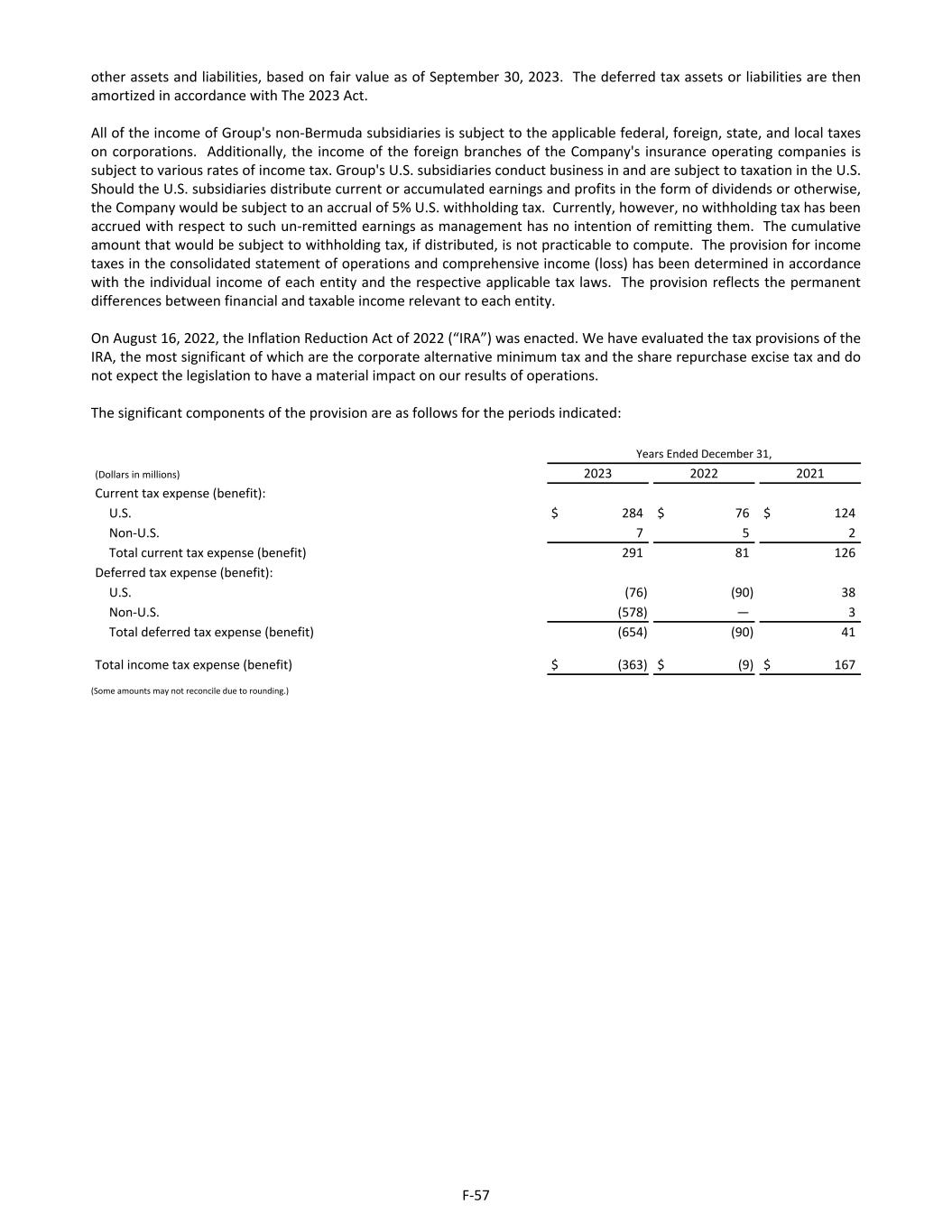
other assets and liabilities, based on fair value as of September 30, 2023. The deferred tax assets or liabilities are then amortized in accordance with The 2023 Act. All of the income of Group's non-Bermuda subsidiaries is subject to the applicable federal, foreign, state, and local taxes on corporations. Additionally, the income of the foreign branches of the Company's insurance operating companies is subject to various rates of income tax. Group's U.S. subsidiaries conduct business in and are subject to taxation in the U.S. Should the U.S. subsidiaries distribute current or accumulated earnings and profits in the form of dividends or otherwise, the Company would be subject to an accrual of 5% U.S. withholding tax. Currently, however, no withholding tax has been accrued with respect to such un-remitted earnings as management has no intention of remitting them. The cumulative amount that would be subject to withholding tax, if distributed, is not practicable to compute. The provision for income taxes in the consolidated statement of operations and comprehensive income (loss) has been determined in accordance with the individual income of each entity and the respective applicable tax laws. The provision reflects the permanent differences between financial and taxable income relevant to each entity. On August 16, 2022, the Inflation Reduction Act of 2022 (“IRA”) was enacted. We have evaluated the tax provisions of the IRA, the most significant of which are the corporate alternative minimum tax and the share repurchase excise tax and do not expect the legislation to have a material impact on our results of operations. The significant components of the provision are as follows for the periods indicated: Years Ended December 31, (Dollars in millions) 2023 2022 2021 Current tax expense (benefit): U.S. $ 284 $ 76 $ 124 Non-U.S. 7 5 2 Total current tax expense (benefit) 291 81 126 Deferred tax expense (benefit): U.S. (76) (90) 38 Non-U.S. (578) — 3 Total deferred tax expense (benefit) (654) (90) 41 Total income tax expense (benefit) $ (363) $ (9) $ 167 (Some amounts may not reconcile due to rounding.) F-57

The weighted average expected tax provision has been calculated using the pre-tax income (loss) in each jurisdiction multiplied by that jurisdiction's applicable statutory tax rate. Reconciliation of the difference between the provision for income taxes and the expected tax provision at the weighted average tax rate for the periods indicated is provided below: Years Ended December 31, 2023 2022 2021 (Dollars in millions) U.S. Non-U.S. U.S. Non-U.S. U.S. Non-U.S. Underwriting gain (loss) $ 533 $ 686 $ (81) $ 558 $ (83) $ 307 Net investment income 954 479 607 223 708 457 Net realized capital gains (losses) (190) (86) (426) (29) 266 (8) Net derivative gain (loss) — 1 — — — 3 Corporate expenses (18) (55) (26) (35) (33) (34) Interest, fee and bond issue cost amortization expense (134) — (101) — (70) — Other income (expense) (13) (3) (6) (96) 23 11 Pre-tax income (loss) $ 1,132 $ 1,022 $ (32) $ 620 $ 811 $ 735 Expected tax provision at the applicable statutory rate(s) 238 26 (9) — 170 14 Increase (decrease) in taxes resulting from: Tax exempt income (3) — (4) — (4) — Dividend received deduction (2) — (3) — (1) — Proration 1 — 1 — 1 — Affiliated preferred stock dividends 7 — 7 — 7 — Creditable foreign premium tax (14) — (11) — (13) — Tax audit settlement — — — — — — Share-based compensation tax benefits formerly in APIC (3) — (3) — (2) — Valuation allowance — (13) — 5 — (10) Bermuda corporate income tax — (578) — 5 — — Insurance company-owned life insurance (13) — (1) — — — Other (3) (6) 6 — 3 1 Total income tax provision $ 208 $ (571) $ (14) $ 5 $ 161 $ 5 (Some amounts may not reconcile due to rounding.) At December 31, 2023, 2022 and 2021, the Company had no uncertain tax positions. The Company’s 2014 through 2018 U.S. Federal tax returns are under audit by the IRS. Over several years, the Company had received and responded to a substantial number of Information Document Requests (“IDRs”). In 2023, the IRS issued several insignificant Notice(s) of Proposed Adjustment. The Company had filed amended tax returns requesting refunds for 2015 and 2016 for $2 million and $5 million, respectively. In the fall of 2023, the IRS issued a final Revenue Agent Report (“RAR”) which is under review by the Company. We have asked for and received an extension from the IRS to complete our review. Note that the IRS requested, and we have signed, an extension of the audit to June 30, 2025. For tax year 2019, the Statute of Limitations has expired and, thus, the Federal income tax return for the year is no longer subject to IRS examination except to the extent the Company files an amended return. Tax years 2020, 2021 and 2022 are open for examination by the U.S. Federal income tax jurisdiction. F-58
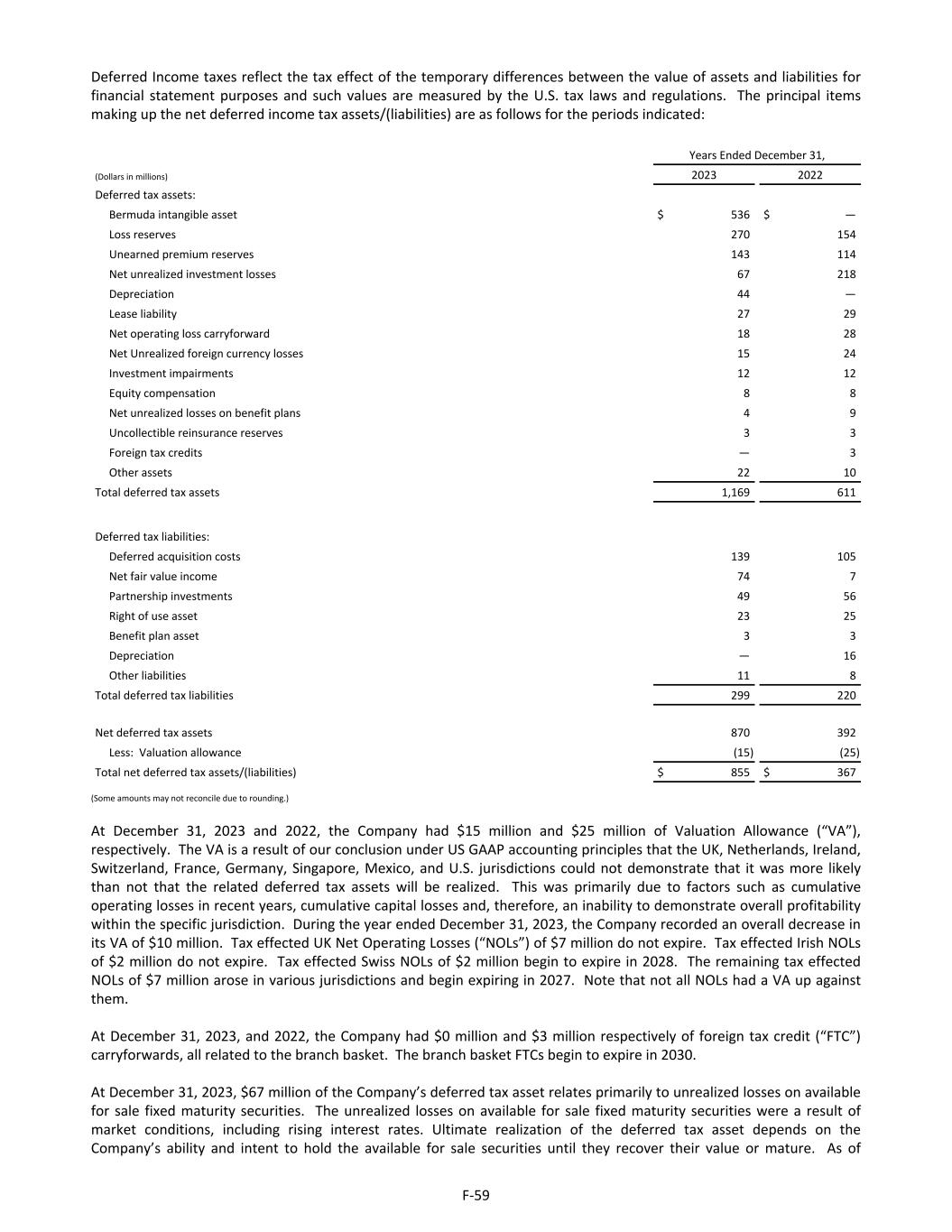
Deferred Income taxes reflect the tax effect of the temporary differences between the value of assets and liabilities for financial statement purposes and such values are measured by the U.S. tax laws and regulations. The principal items making up the net deferred income tax assets/(liabilities) are as follows for the periods indicated: Years Ended December 31, (Dollars in millions) 2023 2022 Deferred tax assets: Bermuda intangible asset $ 536 $ — Loss reserves 270 154 Unearned premium reserves 143 114 Net unrealized investment losses 67 218 Depreciation 44 — Lease liability 27 29 Net operating loss carryforward 18 28 Net Unrealized foreign currency losses 15 24 Investment impairments 12 12 Equity compensation 8 8 Net unrealized losses on benefit plans 4 9 Uncollectible reinsurance reserves 3 3 Foreign tax credits — 3 Other assets 22 10 Total deferred tax assets 1,169 611 Deferred tax liabilities: Deferred acquisition costs 139 105 Net fair value income 74 7 Partnership investments 49 56 Right of use asset 23 25 Benefit plan asset 3 3 Depreciation — 16 Other liabilities 11 8 Total deferred tax liabilities 299 220 Net deferred tax assets 870 392 Less: Valuation allowance (15) (25) Total net deferred tax assets/(liabilities) $ 855 $ 367 (Some amounts may not reconcile due to rounding.) At December 31, 2023 and 2022, the Company had $15 million and $25 million of Valuation Allowance (“VA”), respectively. The VA is a result of our conclusion under US GAAP accounting principles that the UK, Netherlands, Ireland, Switzerland, France, Germany, Singapore, Mexico, and U.S. jurisdictions could not demonstrate that it was more likely than not that the related deferred tax assets will be realized. This was primarily due to factors such as cumulative operating losses in recent years, cumulative capital losses and, therefore, an inability to demonstrate overall profitability within the specific jurisdiction. During the year ended December 31, 2023, the Company recorded an overall decrease in its VA of $10 million. Tax effected UK Net Operating Losses (“NOLs”) of $7 million do not expire. Tax effected Irish NOLs of $2 million do not expire. Tax effected Swiss NOLs of $2 million begin to expire in 2028. The remaining tax effected NOLs of $7 million arose in various jurisdictions and begin expiring in 2027. Note that not all NOLs had a VA up against them. At December 31, 2023, and 2022, the Company had $0 million and $3 million respectively of foreign tax credit (“FTC”) carryforwards, all related to the branch basket. The branch basket FTCs begin to expire in 2030. At December 31, 2023, $67 million of the Company’s deferred tax asset relates primarily to unrealized losses on available for sale fixed maturity securities. The unrealized losses on available for sale fixed maturity securities were a result of market conditions, including rising interest rates. Ultimate realization of the deferred tax asset depends on the Company’s ability and intent to hold the available for sale securities until they recover their value or mature. As of F-59
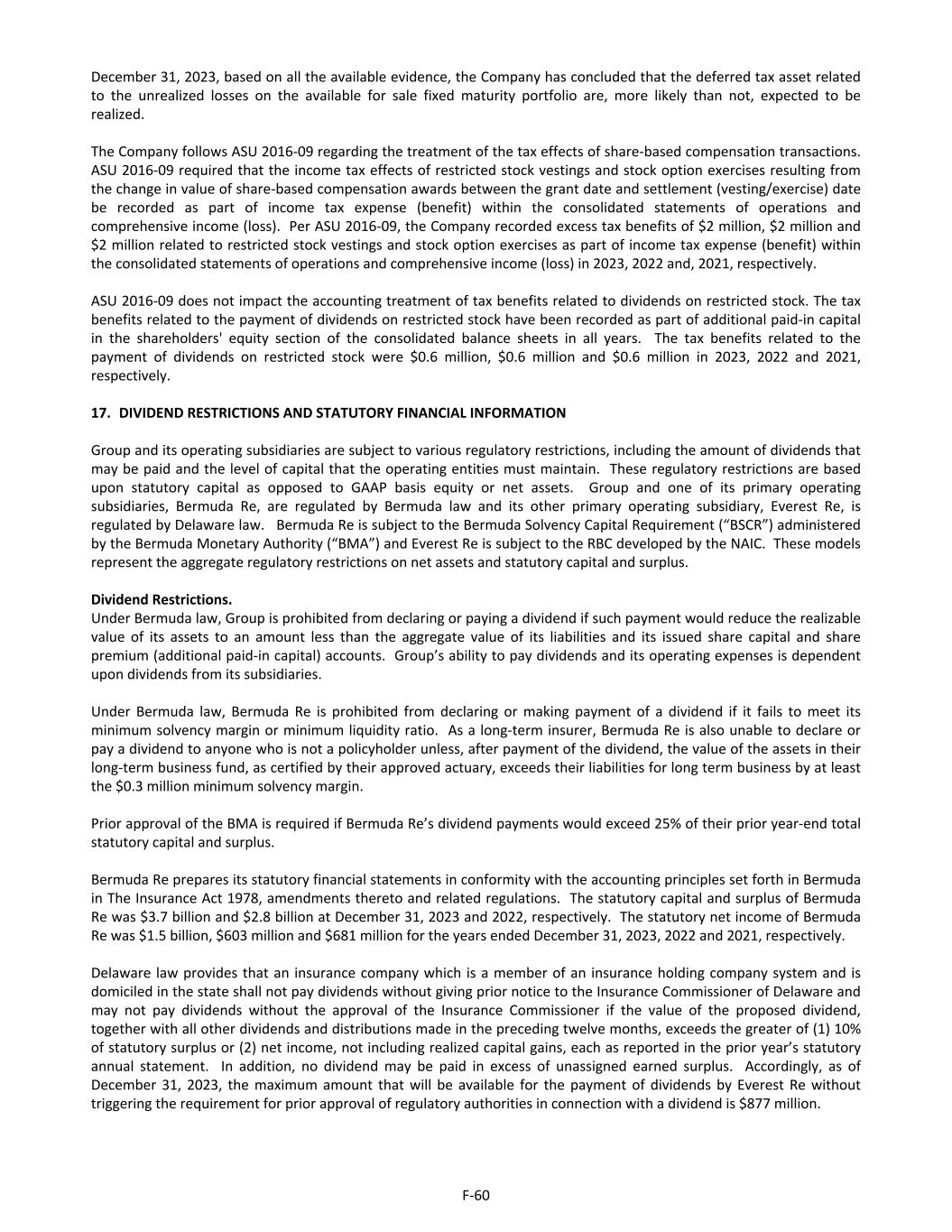
December 31, 2023, based on all the available evidence, the Company has concluded that the deferred tax asset related to the unrealized losses on the available for sale fixed maturity portfolio are, more likely than not, expected to be realized. The Company follows ASU 2016-09 regarding the treatment of the tax effects of share-based compensation transactions. ASU 2016-09 required that the income tax effects of restricted stock vestings and stock option exercises resulting from the change in value of share-based compensation awards between the grant date and settlement (vesting/exercise) date be recorded as part of income tax expense (benefit) within the consolidated statements of operations and comprehensive income (loss). Per ASU 2016-09, the Company recorded excess tax benefits of $2 million, $2 million and $2 million related to restricted stock vestings and stock option exercises as part of income tax expense (benefit) within the consolidated statements of operations and comprehensive income (loss) in 2023, 2022 and, 2021, respectively. ASU 2016-09 does not impact the accounting treatment of tax benefits related to dividends on restricted stock. The tax benefits related to the payment of dividends on restricted stock have been recorded as part of additional paid-in capital in the shareholders' equity section of the consolidated balance sheets in all years. The tax benefits related to the payment of dividends on restricted stock were $0.6 million, $0.6 million and $0.6 million in 2023, 2022 and 2021, respectively. 17. DIVIDEND RESTRICTIONS AND STATUTORY FINANCIAL INFORMATION Group and its operating subsidiaries are subject to various regulatory restrictions, including the amount of dividends that may be paid and the level of capital that the operating entities must maintain. These regulatory restrictions are based upon statutory capital as opposed to GAAP basis equity or net assets. Group and one of its primary operating subsidiaries, Bermuda Re, are regulated by Bermuda law and its other primary operating subsidiary, Everest Re, is regulated by Delaware law. Bermuda Re is subject to the Bermuda Solvency Capital Requirement (“BSCR”) administered by the Bermuda Monetary Authority (“BMA”) and Everest Re is subject to the RBC developed by the NAIC. These models represent the aggregate regulatory restrictions on net assets and statutory capital and surplus. Dividend Restrictions. Under Bermuda law, Group is prohibited from declaring or paying a dividend if such payment would reduce the realizable value of its assets to an amount less than the aggregate value of its liabilities and its issued share capital and share premium (additional paid-in capital) accounts. Group’s ability to pay dividends and its operating expenses is dependent upon dividends from its subsidiaries. Under Bermuda law, Bermuda Re is prohibited from declaring or making payment of a dividend if it fails to meet its minimum solvency margin or minimum liquidity ratio. As a long-term insurer, Bermuda Re is also unable to declare or pay a dividend to anyone who is not a policyholder unless, after payment of the dividend, the value of the assets in their long-term business fund, as certified by their approved actuary, exceeds their liabilities for long term business by at least the $0.3 million minimum solvency margin. Prior approval of the BMA is required if Bermuda Re’s dividend payments would exceed 25% of their prior year-end total statutory capital and surplus. Bermuda Re prepares its statutory financial statements in conformity with the accounting principles set forth in Bermuda in The Insurance Act 1978, amendments thereto and related regulations. The statutory capital and surplus of Bermuda Re was $3.7 billion and $2.8 billion at December 31, 2023 and 2022, respectively. The statutory net income of Bermuda Re was $1.5 billion, $603 million and $681 million for the years ended December 31, 2023, 2022 and 2021, respectively. Delaware law provides that an insurance company which is a member of an insurance holding company system and is domiciled in the state shall not pay dividends without giving prior notice to the Insurance Commissioner of Delaware and may not pay dividends without the approval of the Insurance Commissioner if the value of the proposed dividend, together with all other dividends and distributions made in the preceding twelve months, exceeds the greater of (1) 10% of statutory surplus or (2) net income, not including realized capital gains, each as reported in the prior year’s statutory annual statement. In addition, no dividend may be paid in excess of unassigned earned surplus. Accordingly, as of December 31, 2023, the maximum amount that will be available for the payment of dividends by Everest Re without triggering the requirement for prior approval of regulatory authorities in connection with a dividend is $877 million. F-60
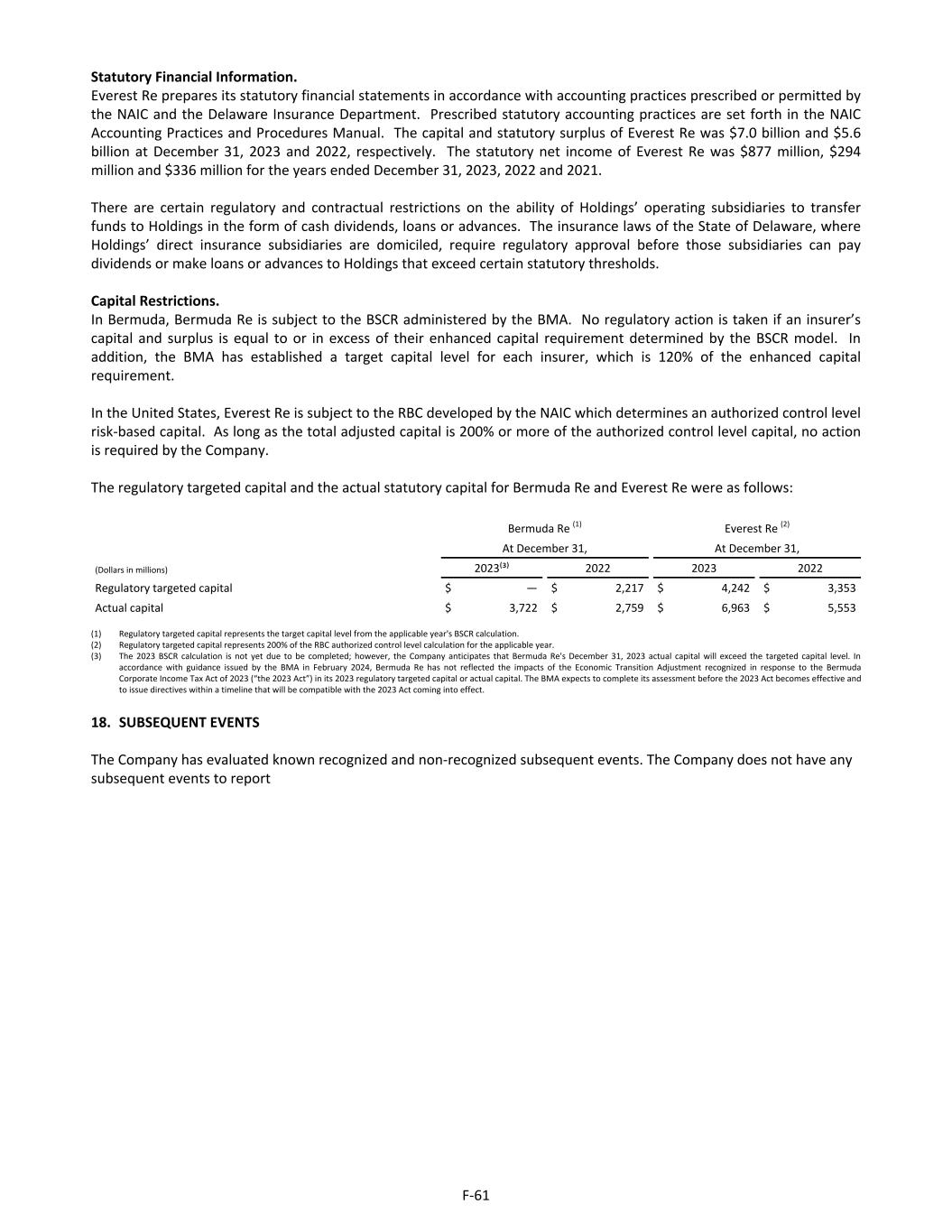
Statutory Financial Information. Everest Re prepares its statutory financial statements in accordance with accounting practices prescribed or permitted by the NAIC and the Delaware Insurance Department. Prescribed statutory accounting practices are set forth in the NAIC Accounting Practices and Procedures Manual. The capital and statutory surplus of Everest Re was $7.0 billion and $5.6 billion at December 31, 2023 and 2022, respectively. The statutory net income of Everest Re was $877 million, $294 million and $336 million for the years ended December 31, 2023, 2022 and 2021. There are certain regulatory and contractual restrictions on the ability of Holdings’ operating subsidiaries to transfer funds to Holdings in the form of cash dividends, loans or advances. The insurance laws of the State of Delaware, where Holdings’ direct insurance subsidiaries are domiciled, require regulatory approval before those subsidiaries can pay dividends or make loans or advances to Holdings that exceed certain statutory thresholds. Capital Restrictions. In Bermuda, Bermuda Re is subject to the BSCR administered by the BMA. No regulatory action is taken if an insurer’s capital and surplus is equal to or in excess of their enhanced capital requirement determined by the BSCR model. In addition, the BMA has established a target capital level for each insurer, which is 120% of the enhanced capital requirement. In the United States, Everest Re is subject to the RBC developed by the NAIC which determines an authorized control level risk-based capital. As long as the total adjusted capital is 200% or more of the authorized control level capital, no action is required by the Company. The regulatory targeted capital and the actual statutory capital for Bermuda Re and Everest Re were as follows: Bermuda Re (1) Everest Re (2) At December 31, At December 31, (Dollars in millions) 2023⁽³⁾ 2022 2023 2022 Regulatory targeted capital $ — $ 2,217 $ 4,242 $ 3,353 Actual capital $ 3,722 $ 2,759 $ 6,963 $ 5,553 (1) Regulatory targeted capital represents the target capital level from the applicable year's BSCR calculation. (2) Regulatory targeted capital represents 200% of the RBC authorized control level calculation for the applicable year. (3) The 2023 BSCR calculation is not yet due to be completed; however, the Company anticipates that Bermuda Re's December 31, 2023 actual capital will exceed the targeted capital level. In accordance with guidance issued by the BMA in February 2024, Bermuda Re has not reflected the impacts of the Economic Transition Adjustment recognized in response to the Bermuda Corporate Income Tax Act of 2023 (“the 2023 Act”) in its 2023 regulatory targeted capital or actual capital. The BMA expects to complete its assessment before the 2023 Act becomes effective and to issue directives within a timeline that will be compatible with the 2023 Act coming into effect. 18. SUBSEQUENT EVENTS The Company has evaluated known recognized and non-recognized subsequent events. The Company does not have any subsequent events to report F-61
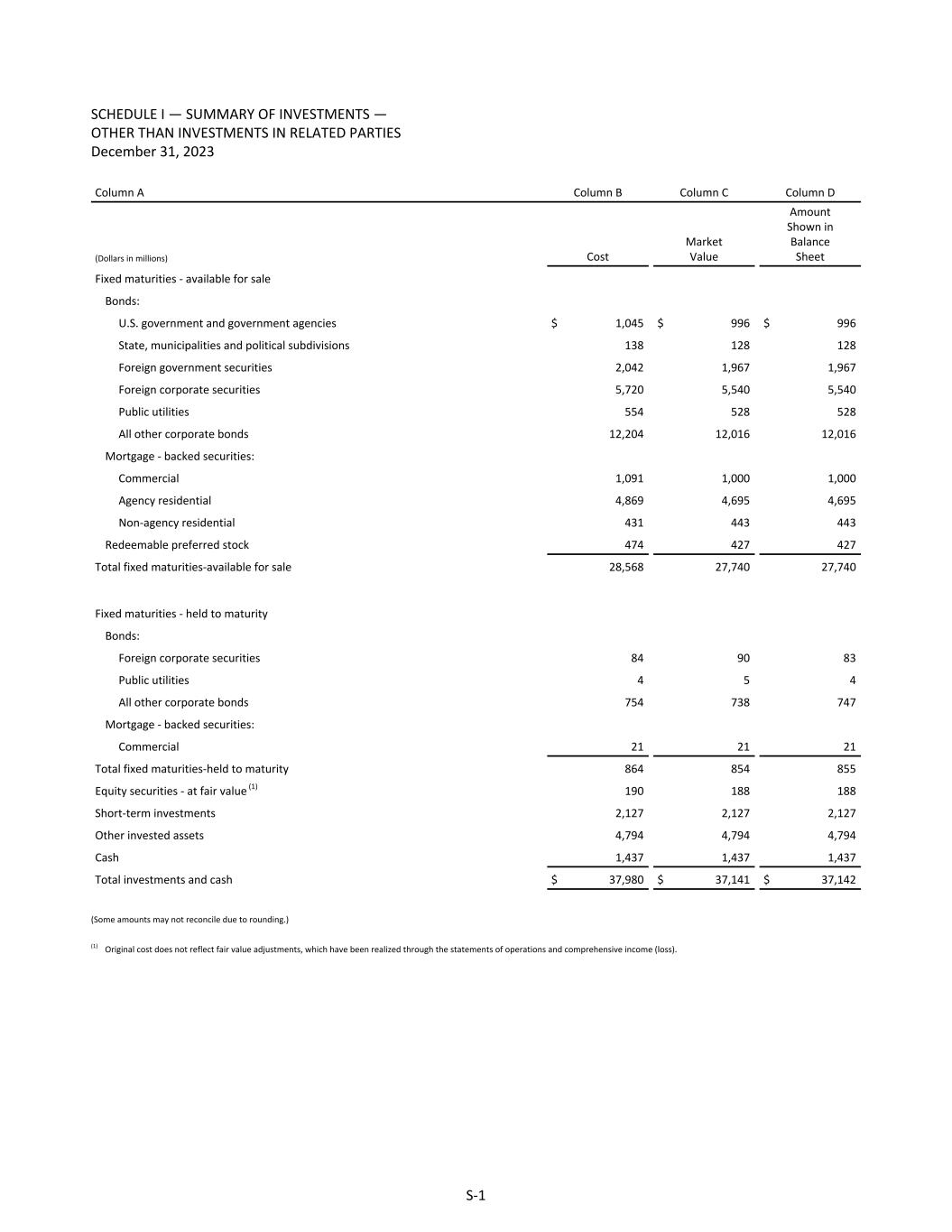
SCHEDULE I — SUMMARY OF INVESTMENTS — OTHER THAN INVESTMENTS IN RELATED PARTIES December 31, 2023 Column A Column B Column C Column D (Dollars in millions) Cost Market Value Amount Shown in Balance Sheet Fixed maturities - available for sale Bonds: U.S. government and government agencies $ 1,045 $ 996 $ 996 State, municipalities and political subdivisions 138 128 128 Foreign government securities 2,042 1,967 1,967 Foreign corporate securities 5,720 5,540 5,540 Public utilities 554 528 528 All other corporate bonds 12,204 12,016 12,016 Mortgage - backed securities: Commercial 1,091 1,000 1,000 Agency residential 4,869 4,695 4,695 Non-agency residential 431 443 443 Redeemable preferred stock 474 427 427 Total fixed maturities-available for sale 28,568 27,740 27,740 Fixed maturities - held to maturity Bonds: Foreign corporate securities 84 90 83 Public utilities 4 5 4 All other corporate bonds 754 738 747 Mortgage - backed securities: Commercial 21 21 21 Total fixed maturities-held to maturity 864 854 855 Equity securities - at fair value (1) 190 188 188 Short-term investments 2,127 2,127 2,127 Other invested assets 4,794 4,794 4,794 Cash 1,437 1,437 1,437 Total investments and cash $ 37,980 $ 37,141 $ 37,142 (Some amounts may not reconcile due to rounding.) (1) Original cost does not reflect fair value adjustments, which have been realized through the statements of operations and comprehensive income (loss). S-1
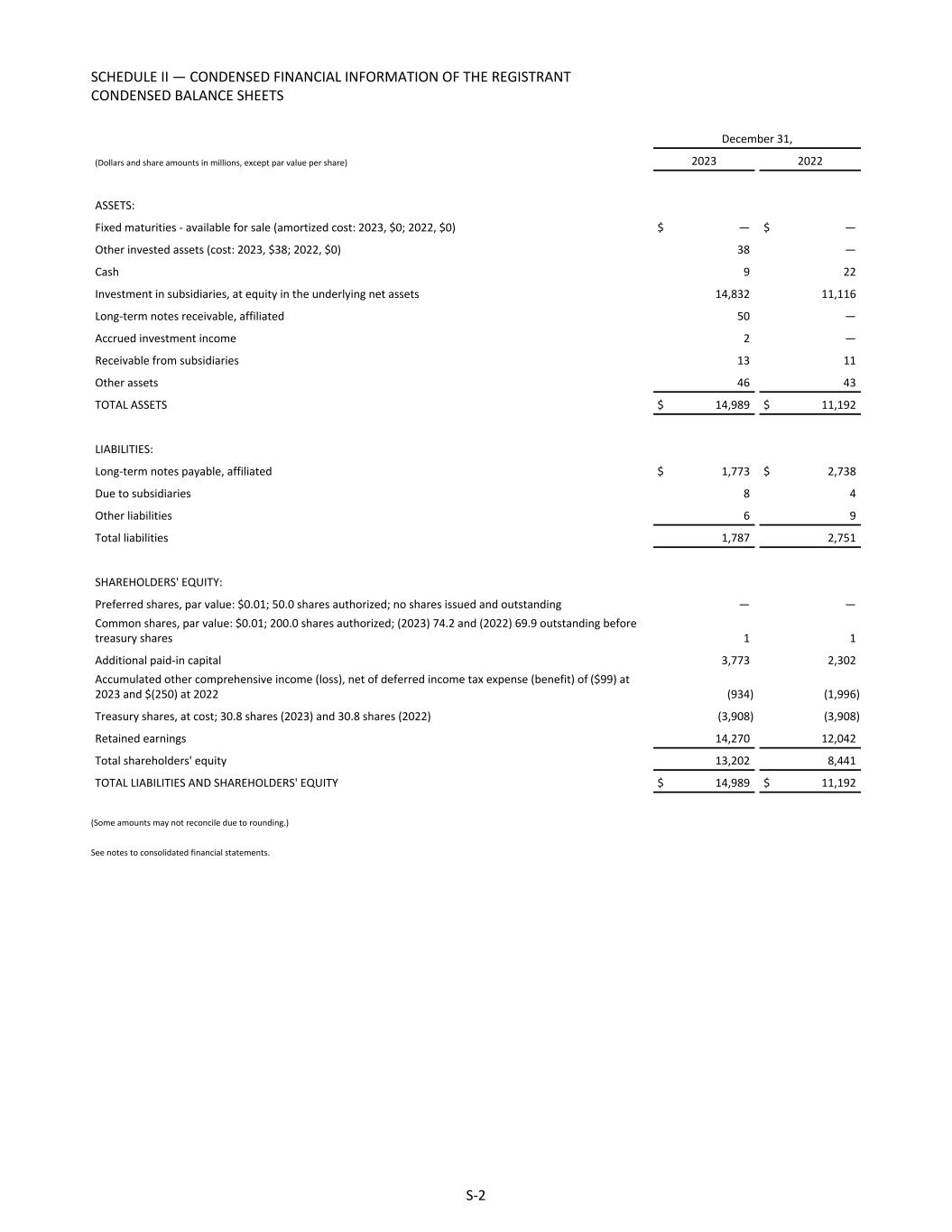
SCHEDULE II — CONDENSED FINANCIAL INFORMATION OF THE REGISTRANT CONDENSED BALANCE SHEETS December 31, (Dollars and share amounts in millions, except par value per share) 2023 2022 ASSETS: Fixed maturities - available for sale (amortized cost: 2023, $0; 2022, $0) $ — $ — Other invested assets (cost: 2023, $38; 2022, $0) 38 — Cash 9 22 Investment in subsidiaries, at equity in the underlying net assets 14,832 11,116 Long-term notes receivable, affiliated 50 — Accrued investment income 2 — Receivable from subsidiaries 13 11 Other assets 46 43 TOTAL ASSETS $ 14,989 $ 11,192 LIABILITIES: Long-term notes payable, affiliated $ 1,773 $ 2,738 Due to subsidiaries 8 4 Other liabilities 6 9 Total liabilities 1,787 2,751 SHAREHOLDERS' EQUITY: Preferred shares, par value: $0.01; 50.0 shares authorized; no shares issued and outstanding — — Common shares, par value: $0.01; 200.0 shares authorized; (2023) 74.2 and (2022) 69.9 outstanding before treasury shares 1 1 Additional paid-in capital 3,773 2,302 Accumulated other comprehensive income (loss), net of deferred income tax expense (benefit) of ($99) at 2023 and $(250) at 2022 (934) (1,996) Treasury shares, at cost; 30.8 shares (2023) and 30.8 shares (2022) (3,908) (3,908) Retained earnings 14,270 12,042 Total shareholders' equity 13,202 8,441 TOTAL LIABILITIES AND SHAREHOLDERS' EQUITY $ 14,989 $ 11,192 (Some amounts may not reconcile due to rounding.) See notes to consolidated financial statements. S-2
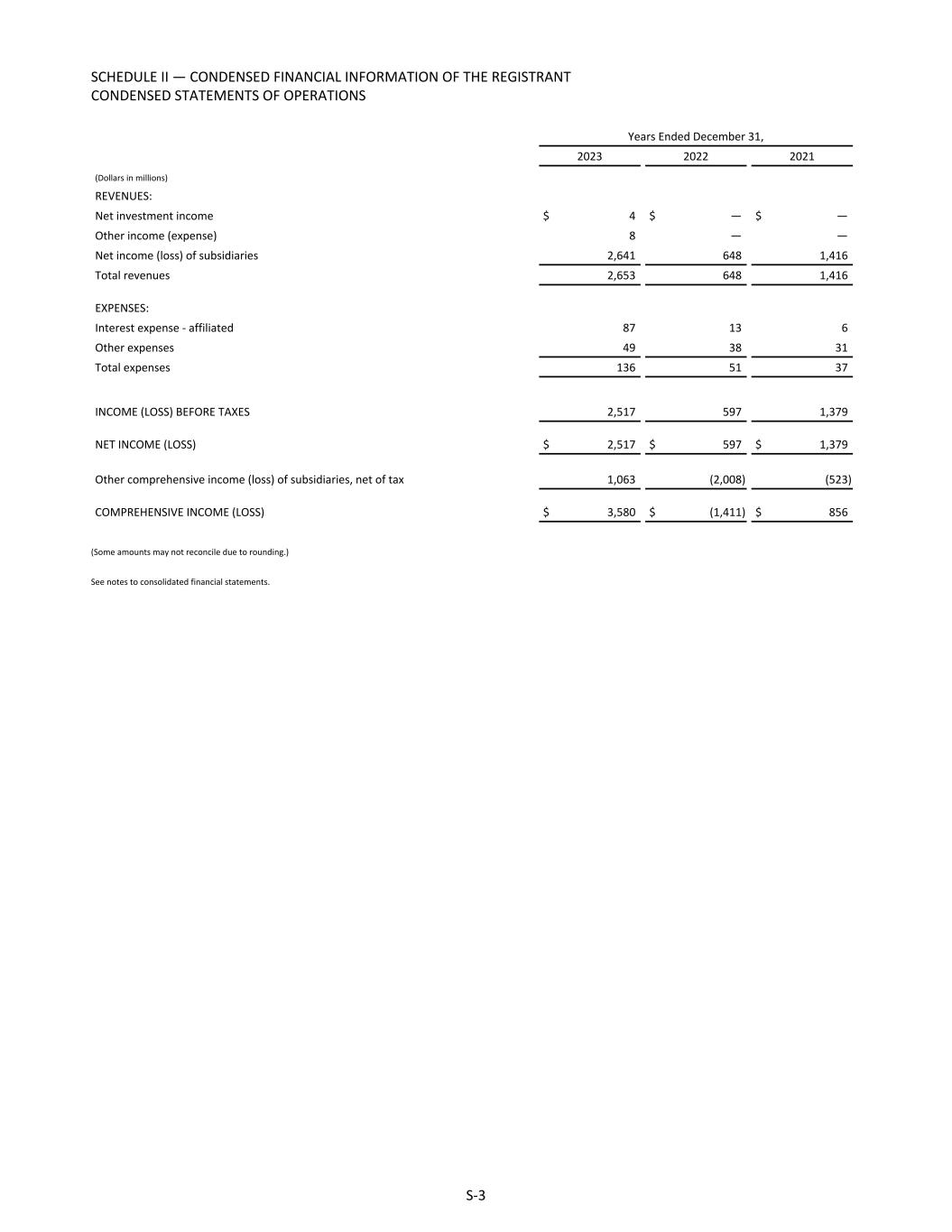
SCHEDULE II — CONDENSED FINANCIAL INFORMATION OF THE REGISTRANT CONDENSED STATEMENTS OF OPERATIONS Years Ended December 31, 2023 2022 2021 (Dollars in millions) REVENUES: Net investment income $ 4 $ — $ — Other income (expense) 8 — — Net income (loss) of subsidiaries 2,641 648 1,416 Total revenues 2,653 648 1,416 EXPENSES: Interest expense - affiliated 87 13 6 Other expenses 49 38 31 Total expenses 136 51 37 INCOME (LOSS) BEFORE TAXES 2,517 597 1,379 NET INCOME (LOSS) $ 2,517 $ 597 $ 1,379 Other comprehensive income (loss) of subsidiaries, net of tax 1,063 (2,008) (523) COMPREHENSIVE INCOME (LOSS) $ 3,580 $ (1,411) $ 856 (Some amounts may not reconcile due to rounding.) See notes to consolidated financial statements. S-3
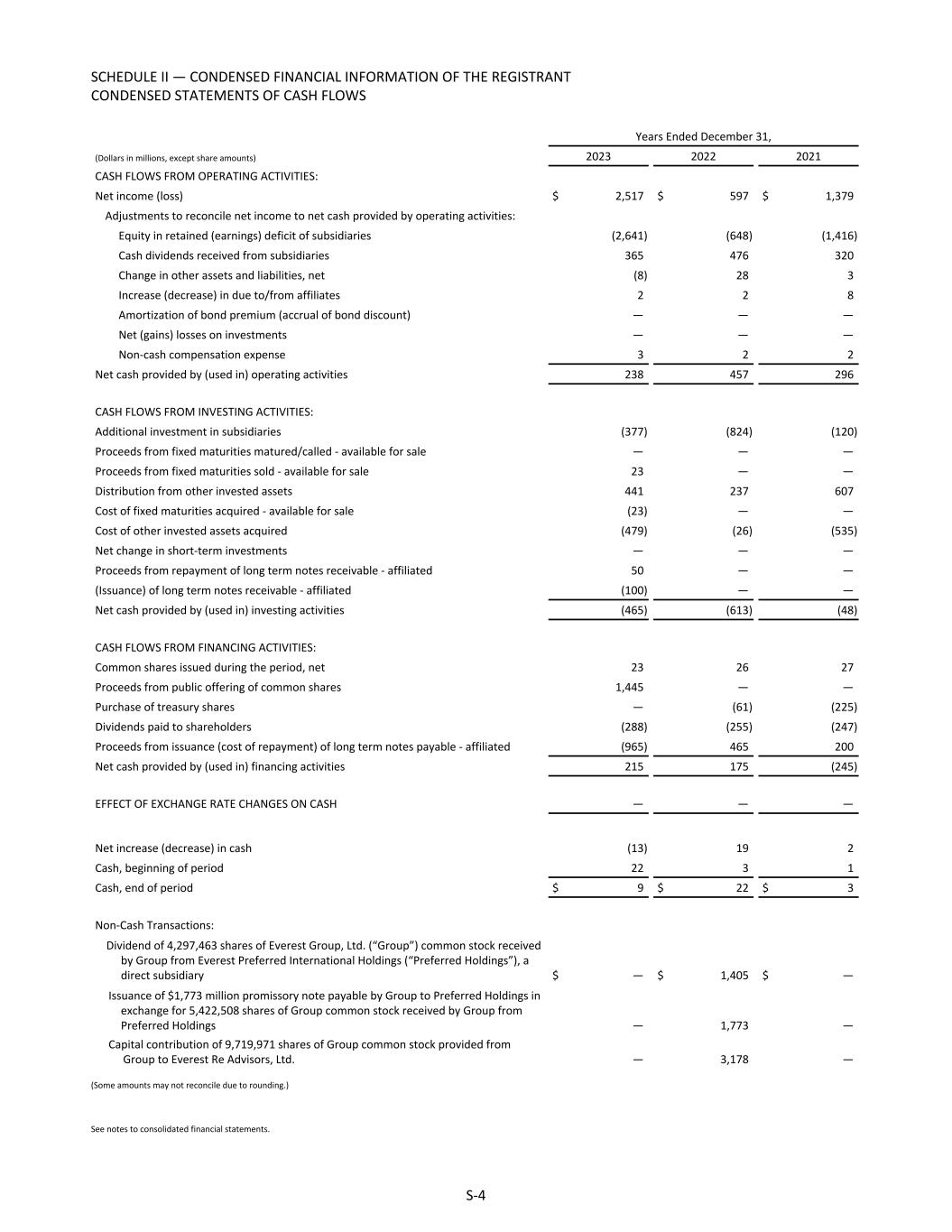
SCHEDULE II — CONDENSED FINANCIAL INFORMATION OF THE REGISTRANT CONDENSED STATEMENTS OF CASH FLOWS Years Ended December 31, (Dollars in millions, except share amounts) 2023 2022 2021 CASH FLOWS FROM OPERATING ACTIVITIES: Net income (loss) $ 2,517 $ 597 $ 1,379 Adjustments to reconcile net income to net cash provided by operating activities: Equity in retained (earnings) deficit of subsidiaries (2,641) (648) (1,416) Cash dividends received from subsidiaries 365 476 320 Change in other assets and liabilities, net (8) 28 3 Increase (decrease) in due to/from affiliates 2 2 8 Amortization of bond premium (accrual of bond discount) — — — Net (gains) losses on investments — — — Non-cash compensation expense 3 2 2 Net cash provided by (used in) operating activities 238 457 296 CASH FLOWS FROM INVESTING ACTIVITIES: Additional investment in subsidiaries (377) (824) (120) Proceeds from fixed maturities matured/called - available for sale — — — Proceeds from fixed maturities sold - available for sale 23 — — Distribution from other invested assets 441 237 607 Cost of fixed maturities acquired - available for sale (23) — — Cost of other invested assets acquired (479) (26) (535) Net change in short-term investments — — — Proceeds from repayment of long term notes receivable - affiliated 50 — — (Issuance) of long term notes receivable - affiliated (100) — — Net cash provided by (used in) investing activities (465) (613) (48) CASH FLOWS FROM FINANCING ACTIVITIES: Common shares issued during the period, net 23 26 27 Proceeds from public offering of common shares 1,445 — — Purchase of treasury shares — (61) (225) Dividends paid to shareholders (288) (255) (247) Proceeds from issuance (cost of repayment) of long term notes payable - affiliated (965) 465 200 Net cash provided by (used in) financing activities 215 175 (245) EFFECT OF EXCHANGE RATE CHANGES ON CASH — — — Net increase (decrease) in cash (13) 19 2 Cash, beginning of period 22 3 1 Cash, end of period $ 9 $ 22 $ 3 Non-Cash Transactions: Dividend of 4,297,463 shares of Everest Group, Ltd. (“Group”) common stock received by Group from Everest Preferred International Holdings (“Preferred Holdings”), a direct subsidiary $ — $ 1,405 $ — Issuance of $1,773 million promissory note payable by Group to Preferred Holdings in exchange for 5,422,508 shares of Group common stock received by Group from Preferred Holdings — 1,773 — Capital contribution of 9,719,971 shares of Group common stock provided from Group to Everest Re Advisors, Ltd. — 3,178 — (Some amounts may not reconcile due to rounding.) See notes to consolidated financial statements. S-4
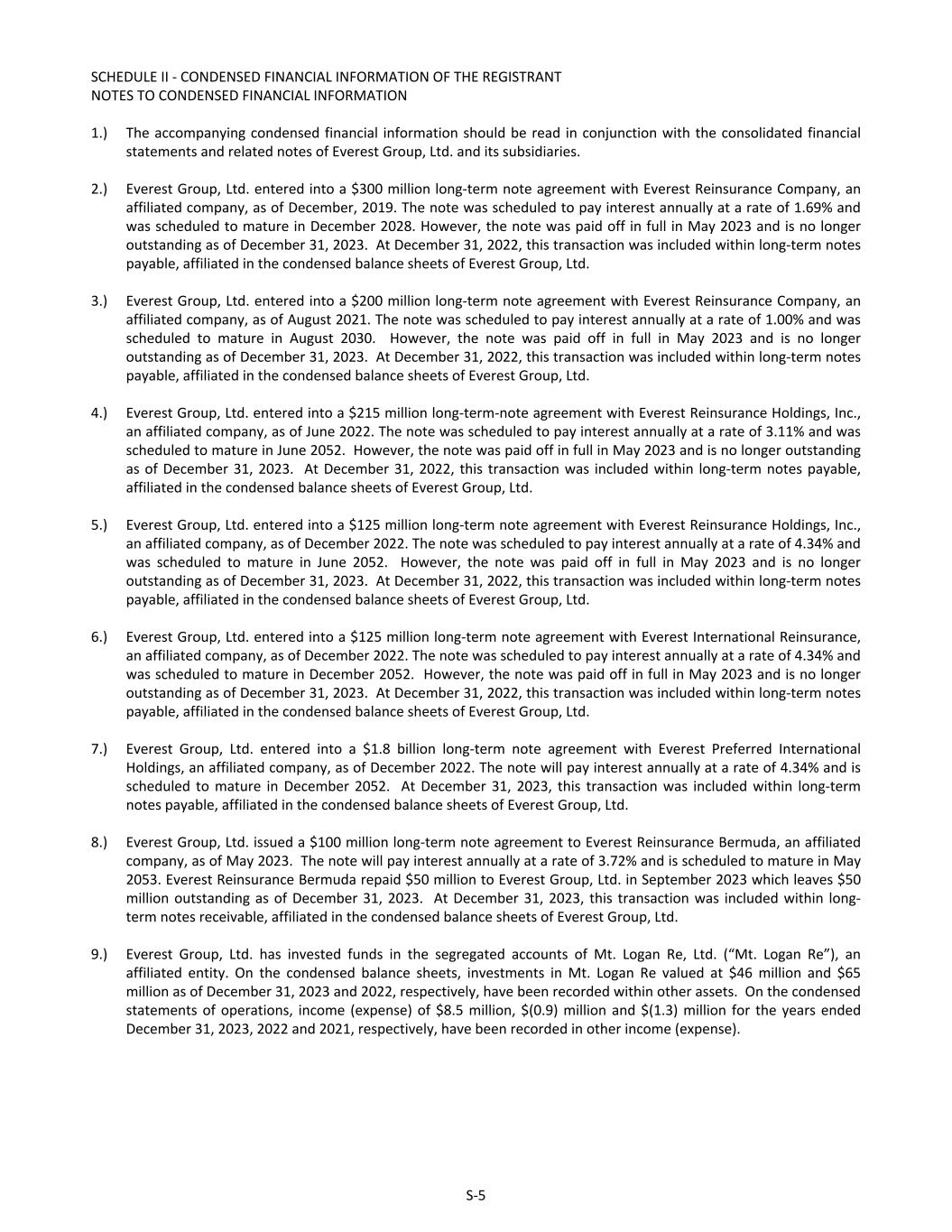
SCHEDULE II - CONDENSED FINANCIAL INFORMATION OF THE REGISTRANT NOTES TO CONDENSED FINANCIAL INFORMATION 1.) The accompanying condensed financial information should be read in conjunction with the consolidated financial statements and related notes of Everest Group, Ltd. and its subsidiaries. 2.) Everest Group, Ltd. entered into a $300 million long-term note agreement with Everest Reinsurance Company, an affiliated company, as of December, 2019. The note was scheduled to pay interest annually at a rate of 1.69% and was scheduled to mature in December 2028. However, the note was paid off in full in May 2023 and is no longer outstanding as of December 31, 2023. At December 31, 2022, this transaction was included within long-term notes payable, affiliated in the condensed balance sheets of Everest Group, Ltd. 3.) Everest Group, Ltd. entered into a $200 million long-term note agreement with Everest Reinsurance Company, an affiliated company, as of August 2021. The note was scheduled to pay interest annually at a rate of 1.00% and was scheduled to mature in August 2030. However, the note was paid off in full in May 2023 and is no longer outstanding as of December 31, 2023. At December 31, 2022, this transaction was included within long-term notes payable, affiliated in the condensed balance sheets of Everest Group, Ltd. 4.) Everest Group, Ltd. entered into a $215 million long-term-note agreement with Everest Reinsurance Holdings, Inc., an affiliated company, as of June 2022. The note was scheduled to pay interest annually at a rate of 3.11% and was scheduled to mature in June 2052. However, the note was paid off in full in May 2023 and is no longer outstanding as of December 31, 2023. At December 31, 2022, this transaction was included within long-term notes payable, affiliated in the condensed balance sheets of Everest Group, Ltd. 5.) Everest Group, Ltd. entered into a $125 million long-term note agreement with Everest Reinsurance Holdings, Inc., an affiliated company, as of December 2022. The note was scheduled to pay interest annually at a rate of 4.34% and was scheduled to mature in June 2052. However, the note was paid off in full in May 2023 and is no longer outstanding as of December 31, 2023. At December 31, 2022, this transaction was included within long-term notes payable, affiliated in the condensed balance sheets of Everest Group, Ltd. 6.) Everest Group, Ltd. entered into a $125 million long-term note agreement with Everest International Reinsurance, an affiliated company, as of December 2022. The note was scheduled to pay interest annually at a rate of 4.34% and was scheduled to mature in December 2052. However, the note was paid off in full in May 2023 and is no longer outstanding as of December 31, 2023. At December 31, 2022, this transaction was included within long-term notes payable, affiliated in the condensed balance sheets of Everest Group, Ltd. 7.) Everest Group, Ltd. entered into a $1.8 billion long-term note agreement with Everest Preferred International Holdings, an affiliated company, as of December 2022. The note will pay interest annually at a rate of 4.34% and is scheduled to mature in December 2052. At December 31, 2023, this transaction was included within long-term notes payable, affiliated in the condensed balance sheets of Everest Group, Ltd. 8.) Everest Group, Ltd. issued a $100 million long-term note agreement to Everest Reinsurance Bermuda, an affiliated company, as of May 2023. The note will pay interest annually at a rate of 3.72% and is scheduled to mature in May 2053. Everest Reinsurance Bermuda repaid $50 million to Everest Group, Ltd. in September 2023 which leaves $50 million outstanding as of December 31, 2023. At December 31, 2023, this transaction was included within long- term notes receivable, affiliated in the condensed balance sheets of Everest Group, Ltd. 9.) Everest Group, Ltd. has invested funds in the segregated accounts of Mt. Logan Re, Ltd. (“Mt. Logan Re”), an affiliated entity. On the condensed balance sheets, investments in Mt. Logan Re valued at $46 million and $65 million as of December 31, 2023 and 2022, respectively, have been recorded within other assets. On the condensed statements of operations, income (expense) of $8.5 million, $(0.9) million and $(1.3) million for the years ended December 31, 2023, 2022 and 2021, respectively, have been recorded in other income (expense). S-5

SCHEDULE III — SUPPLEMENTARY INSURANCE INFORMATION Column A Column B Column C Column D Column E Column F Column G Column H Column I Column J Deferred Acquisition Costs Reserve for Losses and Loss Adjustment Expenses Unearned Premium Reserves Premiums Earned Net Investment Income Incurred Loss and Loss Adjustment Expenses Amortization of Deferred Acquisition Costs Other Operating Expenses Net Written Premium Segment (Dollars in millions) As of and Year Ended December 31, 2023 Reinsurance $ 968 $ 17,659 $ 4,018 $ 9,799 $ 1,004 $ 5,696 $ 2,520 $ 255 $ 10,802 Insurance 279 6,945 2,605 3,644 429 2,732 432 591 3,929 Total $ 1,247 $ 24,604 $ 6,622 $ 13,443 $ 1,434 $ 8,427 $ 2,952 $ 846 $ 14,730 As of and Year Ended December 31, 2022 Reinsurance $ 710 $ 16,111 $ 2,894 $ 8,598 $ 590 $ 5,966 $ 2,116 $ 217 $ 8,919 Insurance 252 5,954 2,253 3,189 240 2,134 413 464 3,426 Total $ 962 $ 22,065 $ 5,147 $ 11,787 $ 830 $ 8,100 $ 2,528 $ 682 $ 12,344 As of and Year Ended December 31, 2021 Reinsurance $ 654 $ 13,872 $ 2,723 $ 7,708 $ 823 $ 5,543 $ 1,833 $ 198 $ 8,488 Insurance 218 5,137 1,887 2,698 342 1,848 376 385 2,958 Total $ 872 $ 19,009 $ 4,610 $ 10,406 $ 1,165 $ 7,391 $ 2,209 $ 583 $ 11,446 (Some amounts may not reconcile due to rounding.) S-6
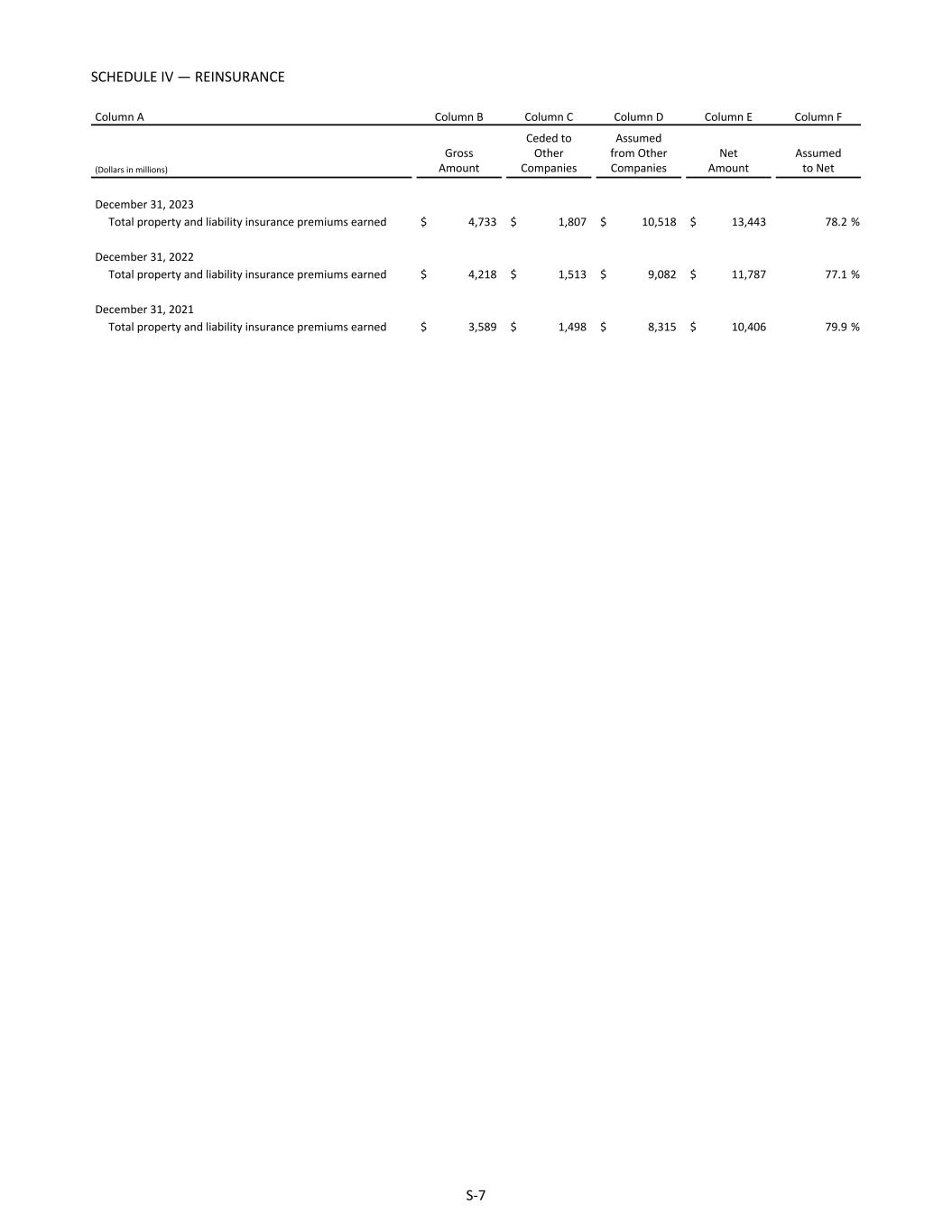
SCHEDULE IV — REINSURANCE Column A Column B Column C Column D Column E Column F (Dollars in millions) Gross Amount Ceded to Other Companies Assumed from Other Companies Net Amount Assumed to Net December 31, 2023 Total property and liability insurance premiums earned $ 4,733 $ 1,807 $ 10,518 $ 13,443 78.2 % December 31, 2022 Total property and liability insurance premiums earned $ 4,218 $ 1,513 $ 9,082 $ 11,787 77.1 % December 31, 2021 Total property and liability insurance premiums earned $ 3,589 $ 1,498 $ 8,315 $ 10,406 79.9 % S-7
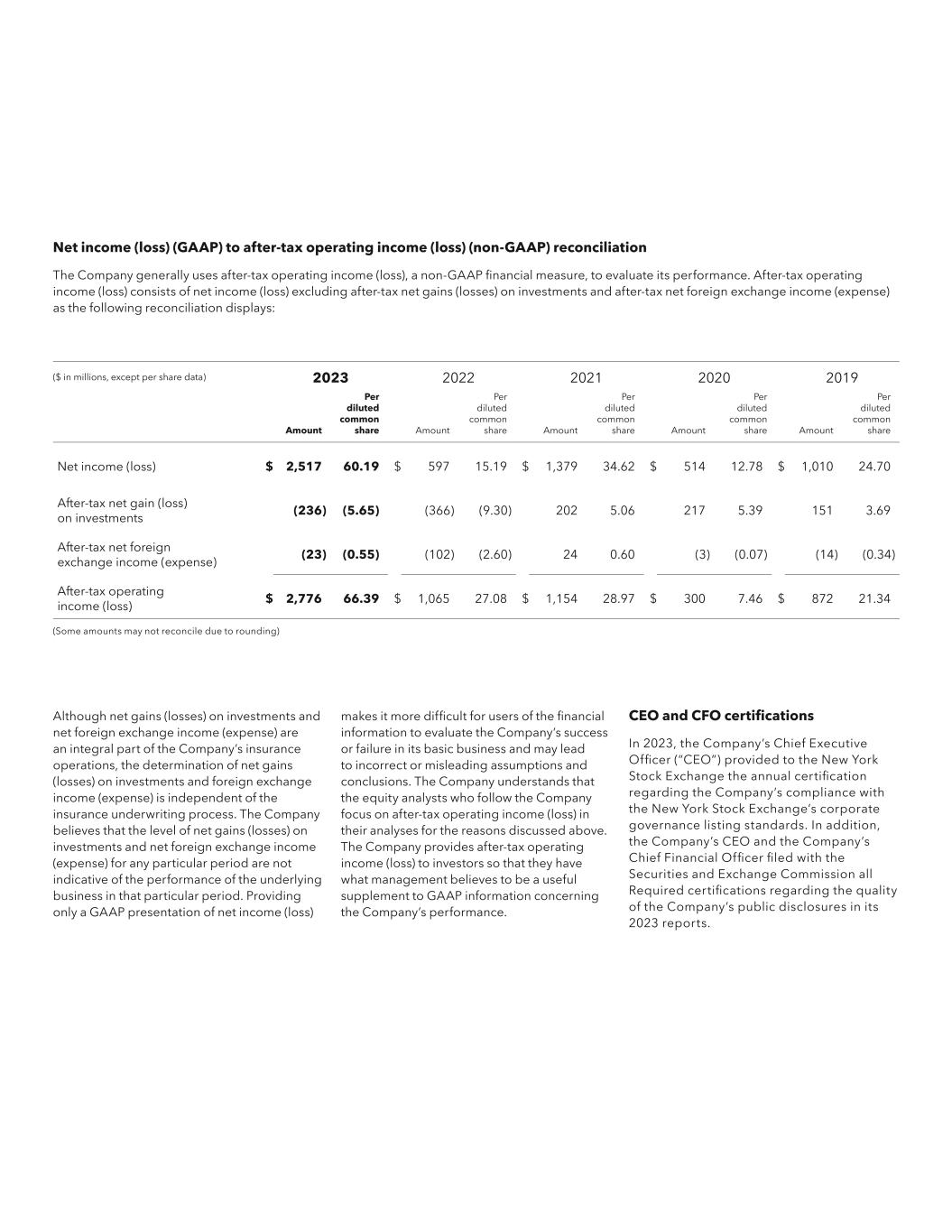
Net income (loss) (GAAP) to after-tax operating income (loss) (non-GAAP) reconciliation The Company generally uses after-tax operating income (loss), a non-GAAP financial measure, to evaluate its performance. After-tax operating income (loss) consists of net income (loss) excluding after-tax net gains (losses) on investments and after-tax net foreign exchange income (expense) as the following reconciliation displays: Although net gains (losses) on investments and net foreign exchange income (expense) are an integral part of the Company’s insurance operations, the determination of net gains (losses) on investments and foreign exchange income (expense) is independent of the insurance underwriting process. The Company believes that the level of net gains (losses) on investments and net foreign exchange income (expense) for any particular period are not indicative of the performance of the underlying business in that particular period. Providing only a GAAP presentation of net income (loss) ($ in millions, except per share data) 2023 2022 2021 2020 2019 Amount Per diluted common share Amount Per diluted common share Amount Per diluted common share Amount Per diluted common share Amount Per diluted common share Net income (loss) $ 2,517 60.19 $ 597 15.19 $ 1,379 34.62 $ 514 12.78 $ 1,010 24.70 After-tax net gain (loss) on investments (236) (5.65) (366) (9.30) 202 5.06 217 5.39 151 3.69 After-tax net foreign exchange income (expense) (23) (0.55) (102) (2.60) 24 0.60 (3) (0.07) (14) (0.34) After-tax operating income (loss) $ 2,776 66.39 $ 1,065 27.08 $ 1,154 28.97 $ 300 7.46 $ 872 21.34 makes it more difficult for users of the financial information to evaluate the Company’s success or failure in its basic business and may lead to incorrect or misleading assumptions and conclusions. The Company understands that the equity analysts who follow the Company focus on after-tax operating income (loss) in their analyses for the reasons discussed above. The Company provides after-tax operating income (loss) to investors so that they have what management believes to be a useful supplement to GAAP information concerning the Company’s performance. CEO and CFO certifications In 2023, the Company’s Chief Executive Officer (“CEO”) provided to the New York Stock Exchange the annual certification regarding the Company’s compliance with the New York Stock Exchange’s corporate governance listing standards. In addition, the Company’s CEO and the Company’s Chief Financial Officer filed with the Securities and Exchange Commission all Required certifications regarding the quality of the Company’s public disclosures in its 2023 reports. (Some amounts may not reconcile due to rounding)
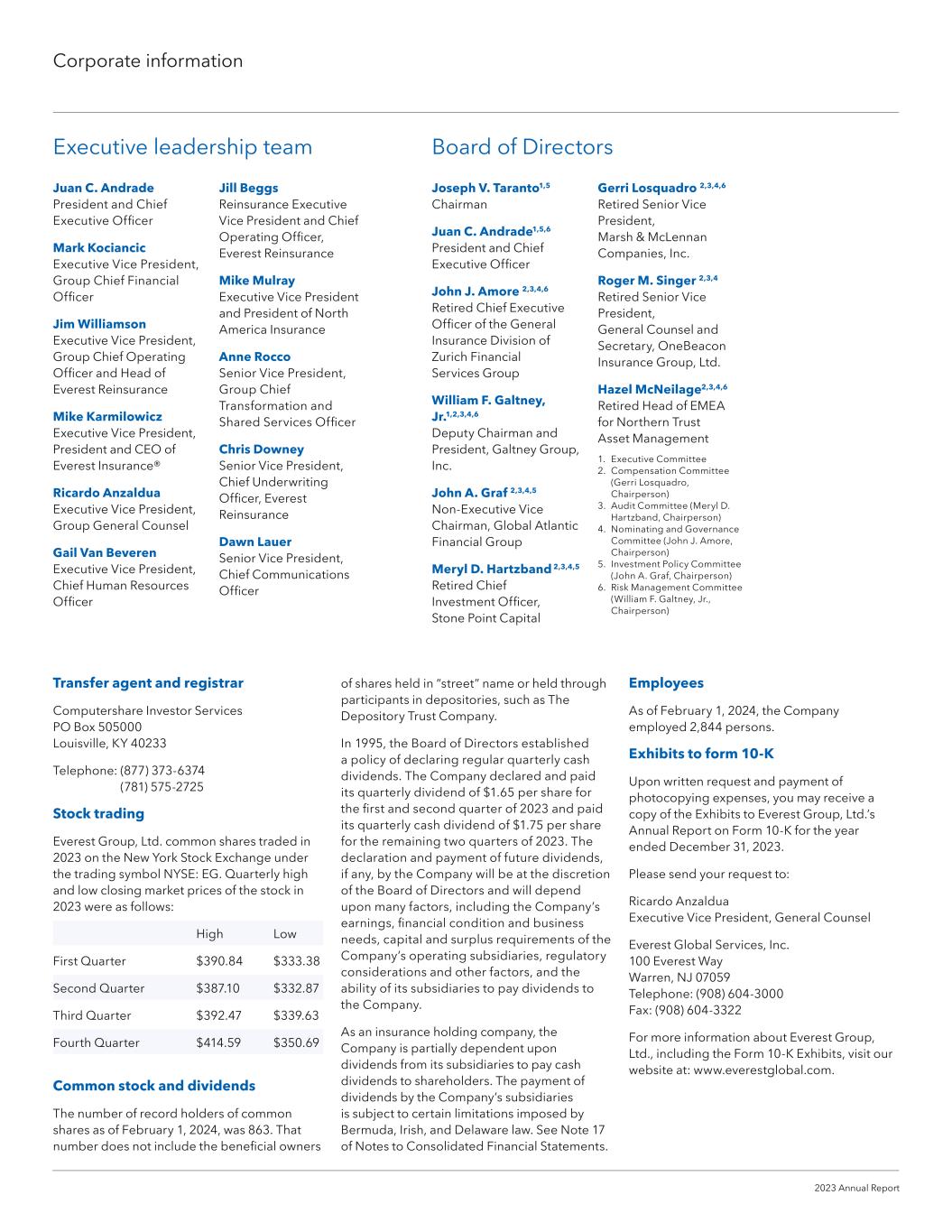
Corporate information Juan C. Andrade President and Chief Executive Officer Mark Kociancic Executive Vice President, Group Chief Financial Officer Jim Williamson Executive Vice President, Group Chief Operating Officer and Head of Everest Reinsurance Mike Karmilowicz Executive Vice President, President and CEO of Everest Insurance® Ricardo Anzaldua Executive Vice President, Group General Counsel Gail Van Beveren Executive Vice President, Chief Human Resources Officer Jill Beggs Reinsurance Executive Vice President and Chief Operating Officer, Everest Reinsurance Mike Mulray Executive Vice President and President of North America Insurance Anne Rocco Senior Vice President, Group Chief Transformation and Shared Services Officer Chris Downey Senior Vice President, Chief Underwriting Officer, Everest Reinsurance Dawn Lauer Senior Vice President, Chief Communications Officer Transfer agent and registrar Computershare Investor Services PO Box 505000 Louisville, KY 40233 Telephone: (877) 373-6374 (781) 575-2725 Stock trading Everest Group, Ltd. common shares traded in 2023 on the New York Stock Exchange under the trading symbol NYSE: EG. Quarterly high and low closing market prices of the stock in 2023 were as follows: High Low First Quarter $390.84 $333.38 Second Quarter $387.10 $332.87 Third Quarter $392.47 $339.63 Fourth Quarter $414.59 $350.69 Common stock and dividends The number of record holders of common shares as of February 1, 2024, was 863. That number does not include the beneficial owners Joseph V. Taranto1,5 Chairman Juan C. Andrade1,5,6 President and Chief Executive Officer John J. Amore 2,3,4,6 Retired Chief Executive Officer of the General Insurance Division of Zurich Financial Services Group William F. Galtney, Jr.1,2,3,4,6 Deputy Chairman and President, Galtney Group, Inc. John A. Graf 2,3,4,5 Non-Executive Vice Chairman, Global Atlantic Financial Group Meryl D. Hartzband 2,3,4,5 Retired Chief Investment Officer, Stone Point Capital Gerri Losquadro 2,3,4,6 Retired Senior Vice President, Marsh & McLennan Companies, Inc. Roger M. Singer 2,3,4 Retired Senior Vice President, General Counsel and Secretary, OneBeacon Insurance Group, Ltd. Hazel McNeilage2,3,4,6 Retired Head of EMEA for Northern Trust Asset Management 1. Executive Committee 2. Compensation Committee (Gerri Losquadro, Chairperson) 3. Audit Committee (Meryl D. Hartzband, Chairperson) 4. Nominating and Governance Committee (John J. Amore, Chairperson) 5. Investment Policy Committee (John A. Graf, Chairperson) 6. Risk Management Committee (William F. Galtney, Jr., Chairperson) Executive leadership team Board of Directors of shares held in “street” name or held through participants in depositories, such as The Depository Trust Company. In 1995, the Board of Directors established a policy of declaring regular quarterly cash dividends. The Company declared and paid its quarterly dividend of $1.65 per share for the first and second quarter of 2023 and paid its quarterly cash dividend of $1.75 per share for the remaining two quarters of 2023. The declaration and payment of future dividends, if any, by the Company will be at the discretion of the Board of Directors and will depend upon many factors, including the Company’s earnings, financial condition and business needs, capital and surplus requirements of the Company’s operating subsidiaries, regulatory considerations and other factors, and the ability of its subsidiaries to pay dividends to the Company. As an insurance holding company, the Company is partially dependent upon dividends from its subsidiaries to pay cash dividends to shareholders. The payment of dividends by the Company’s subsidiaries is subject to certain limitations imposed by Bermuda, Irish, and Delaware law. See Note 17 of Notes to Consolidated Financial Statements. Employees As of February 1, 2024, the Company employed 2,844 persons. Exhibits to form 10-K Upon written request and payment of photocopying expenses, you may receive a copy of the Exhibits to Everest Group, Ltd.’s Annual Report on Form 10-K for the year ended December 31, 2023. Please send your request to: Ricardo Anzaldua Executive Vice President, General Counsel Everest Global Services, Inc. 100 Everest Way Warren, NJ 07059 Telephone: (908) 604-3000 Fax: (908) 604-3322 For more information about Everest Group, Ltd., including the Form 10-K Exhibits, visit our website at: www.everestglobal.com. 2023 Annual Report
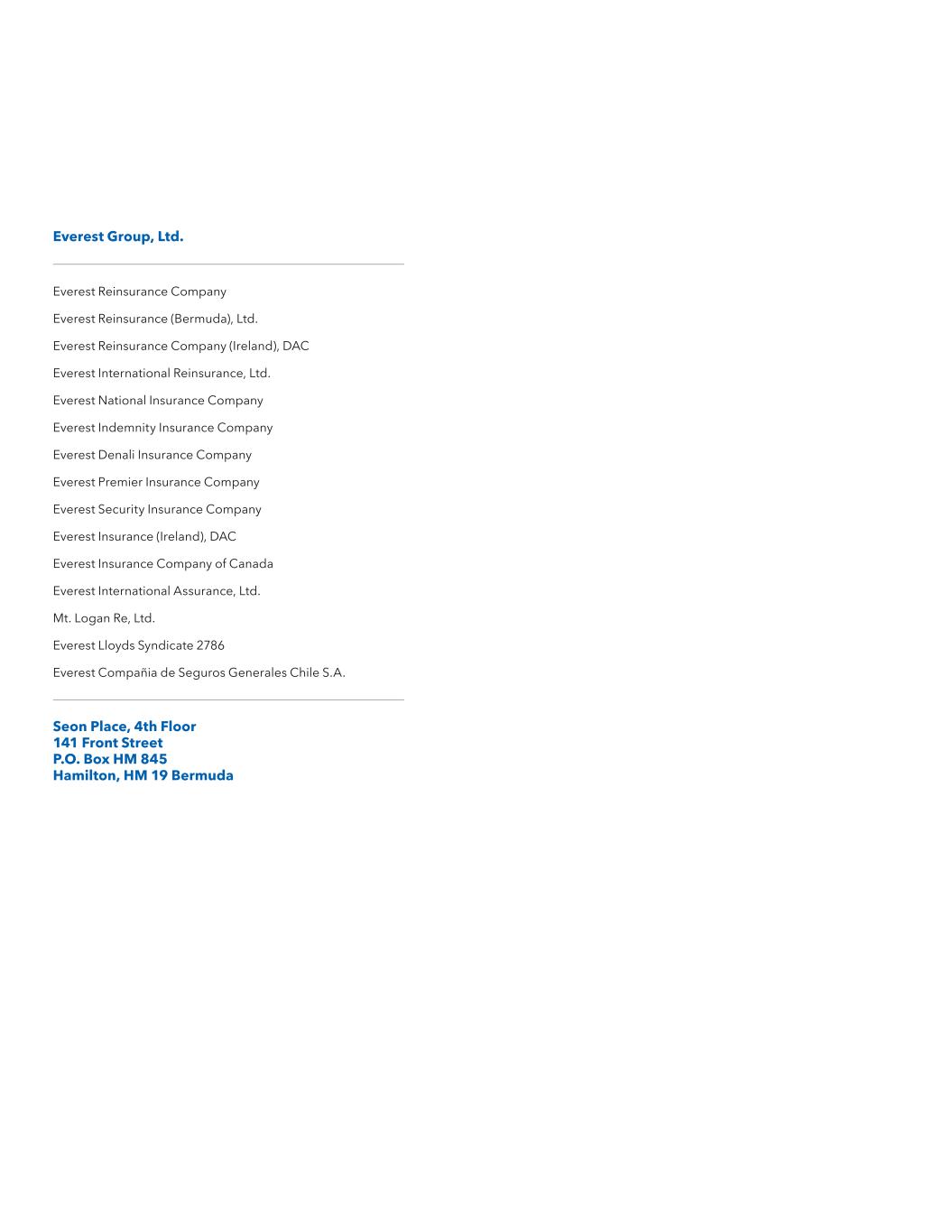
Everest Group, Ltd. Everest Reinsurance Company Everest Reinsurance (Bermuda), Ltd. Everest Reinsurance Company (Ireland), DAC Everest International Reinsurance, Ltd. Everest National Insurance Company Everest Indemnity Insurance Company Everest Denali Insurance Company Everest Premier Insurance Company Everest Security Insurance Company Everest Insurance (Ireland), DAC Everest Insurance Company of Canada Everest International Assurance, Ltd. Mt. Logan Re, Ltd. Everest Lloyds Syndicate 2786 Everest Compañia de Seguros Generales Chile S.A. Seon Place, 4th Floor 141 Front Street P.O. Box HM 845 Hamilton, HM 19 Bermuda